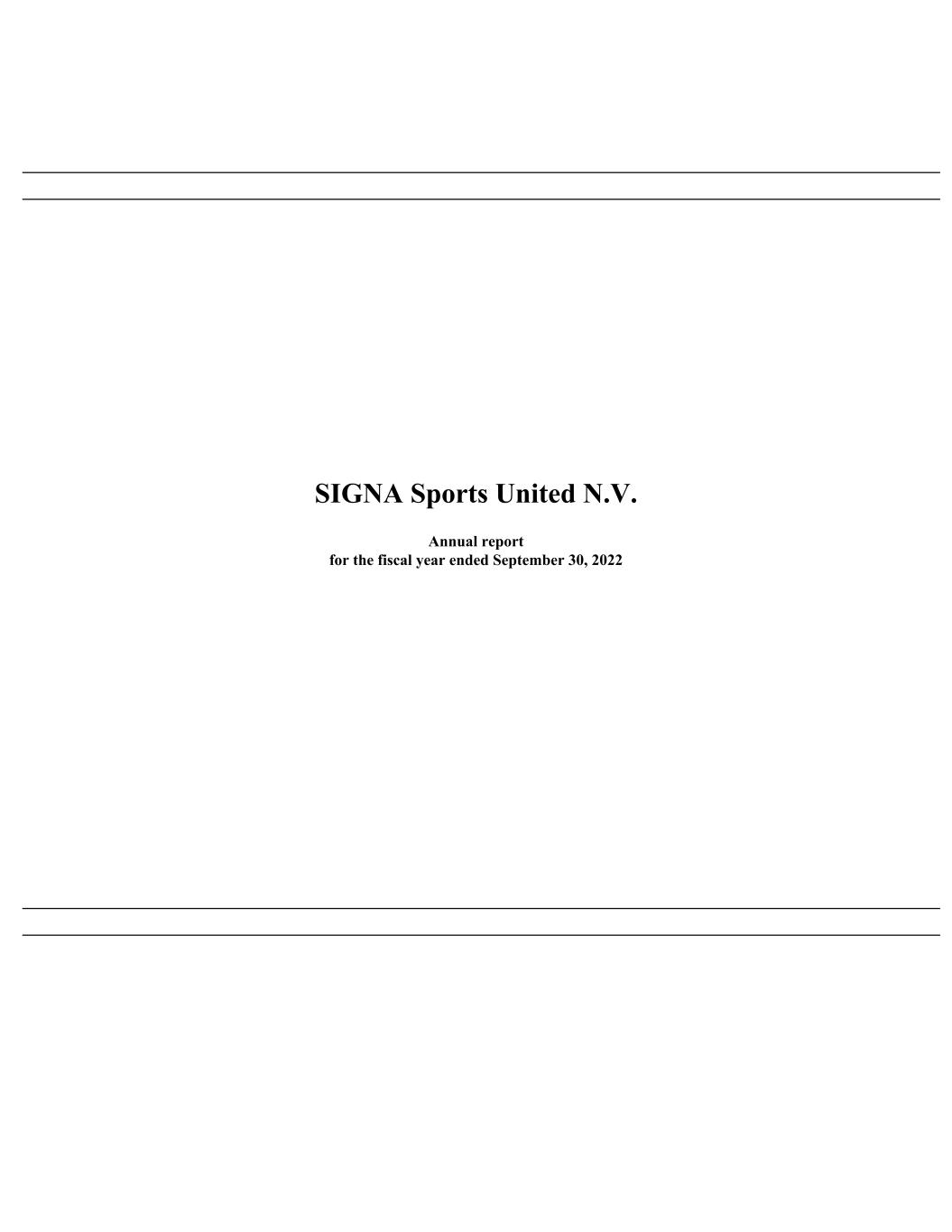
SIGNA Sports United N.V. Annual report for the fiscal year ended September 30, 2022
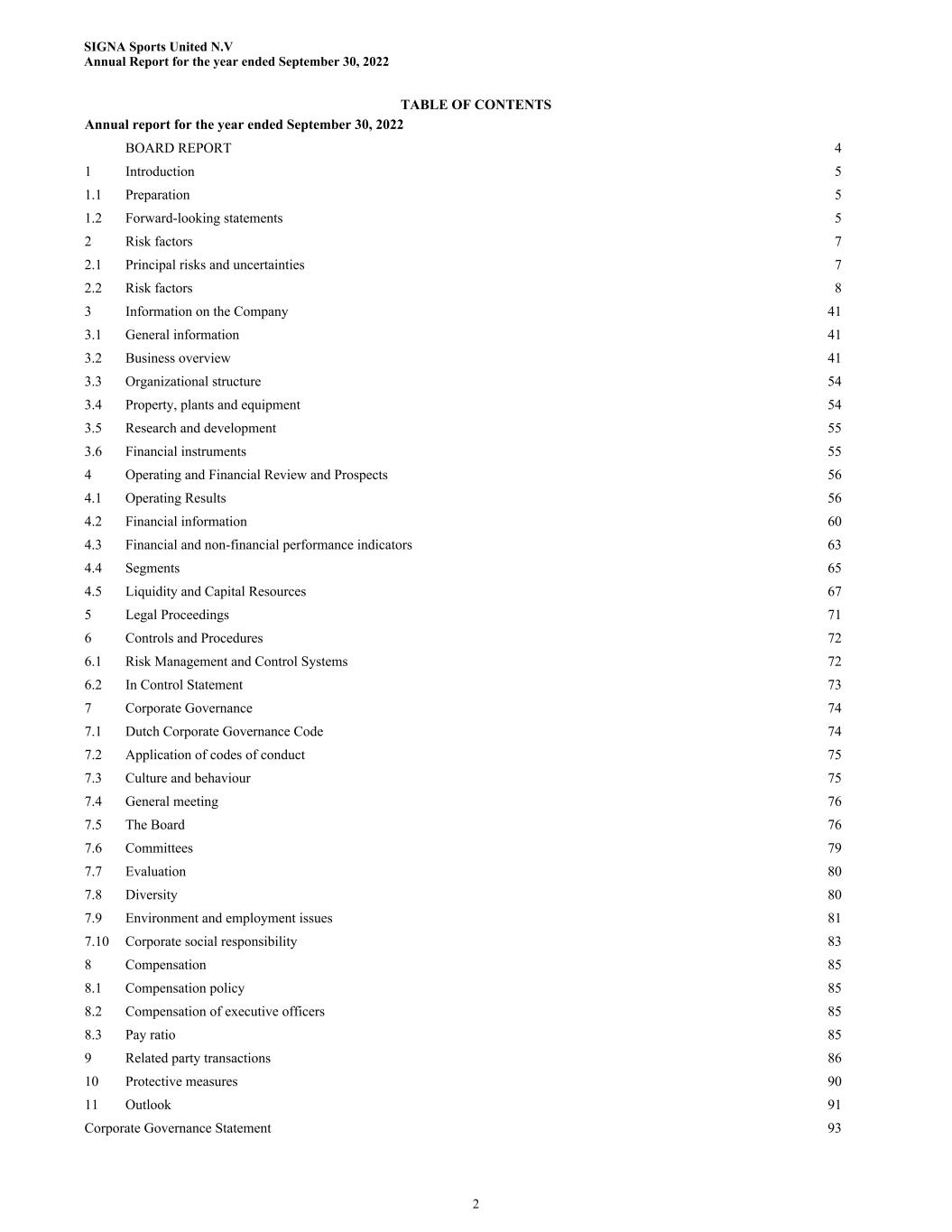
TABLE OF CONTENTS Annual report for the year ended September 30, 2022 BOARD REPORT 4 1 Introduction 5 1.1 Preparation 5 1.2 Forward-looking statements 5 2 Risk factors 7 2.1 Principal risks and uncertainties 7 2.2 Risk factors 8 3 Information on the Company 41 3.1 General information 41 3.2 Business overview 41 3.3 Organizational structure 54 3.4 Property, plants and equipment 54 3.5 Research and development 55 3.6 Financial instruments 55 4 Operating and Financial Review and Prospects 56 4.1 Operating Results 56 4.2 Financial information 60 4.3 Financial and non-financial performance indicators 63 4.4 Segments 65 4.5 Liquidity and Capital Resources 67 5 Legal Proceedings 71 6 Controls and Procedures 72 6.1 Risk Management and Control Systems 72 6.2 In Control Statement 73 7 Corporate Governance 74 7.1 Dutch Corporate Governance Code 74 7.2 Application of codes of conduct 75 7.3 Culture and behaviour 75 7.4 General meeting 76 7.5 The Board 76 7.6 Committees 79 7.7 Evaluation 80 7.8 Diversity 80 7.9 Environment and employment issues 81 7.10 Corporate social responsibility 83 8 Compensation 85 8.1 Compensation policy 85 8.2 Compensation of executive officers 85 8.3 Pay ratio 85 9 Related party transactions 86 10 Protective measures 90 11 Outlook 91 Corporate Governance Statement 93 SIGNA Sports United N.V Annual Report for the year ended September 30, 2022 2
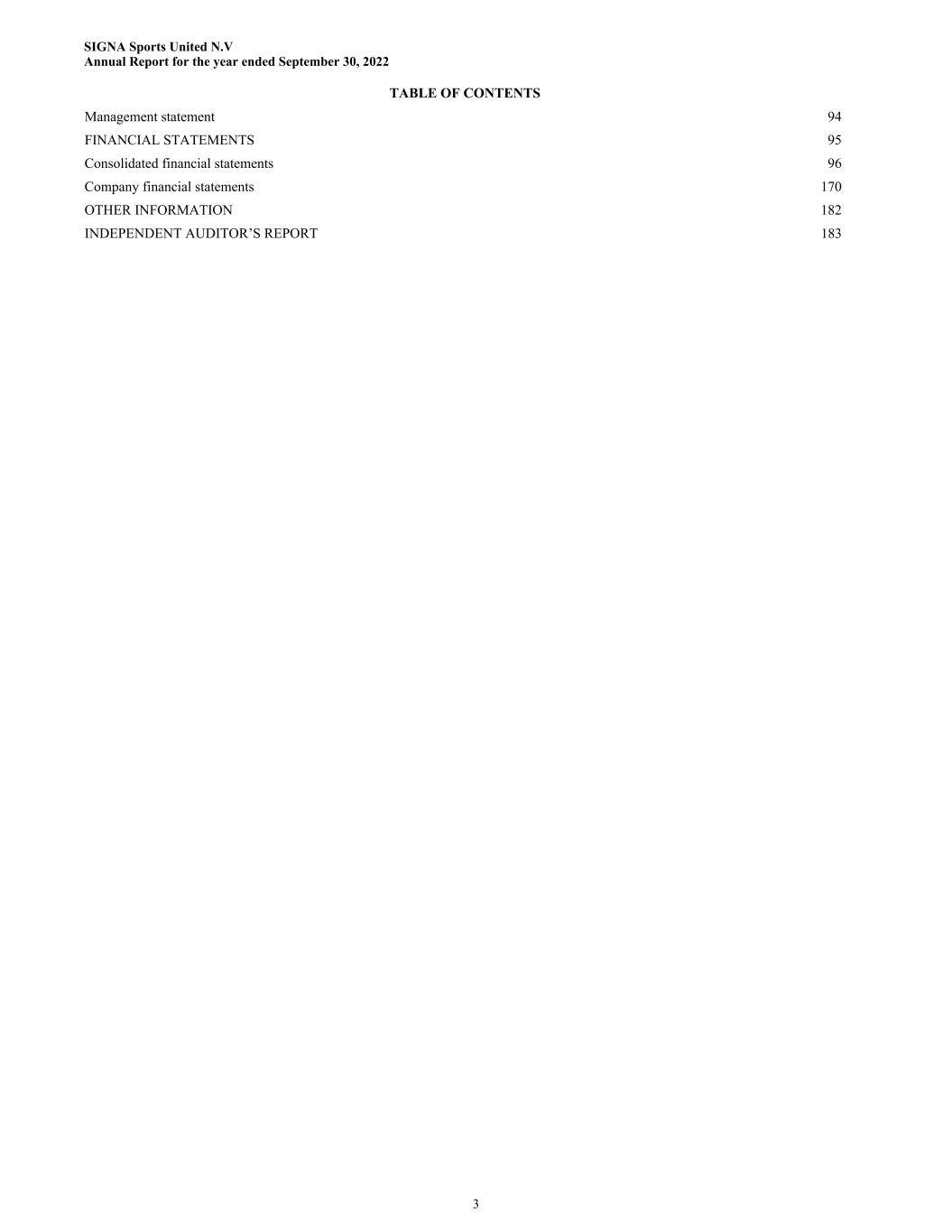
TABLE OF CONTENTS Management statement 94 FINANCIAL STATEMENTS 95 Consolidated financial statements 96 Company financial statements 170 OTHER INFORMATION 182 INDEPENDENT AUDITOR’S REPORT 183 SIGNA Sports United N.V Annual Report for the year ended September 30, 2022 3

BOARD REPORT SIGNA Sports United N.V Annual Report for the year ended September 30, 2022 4
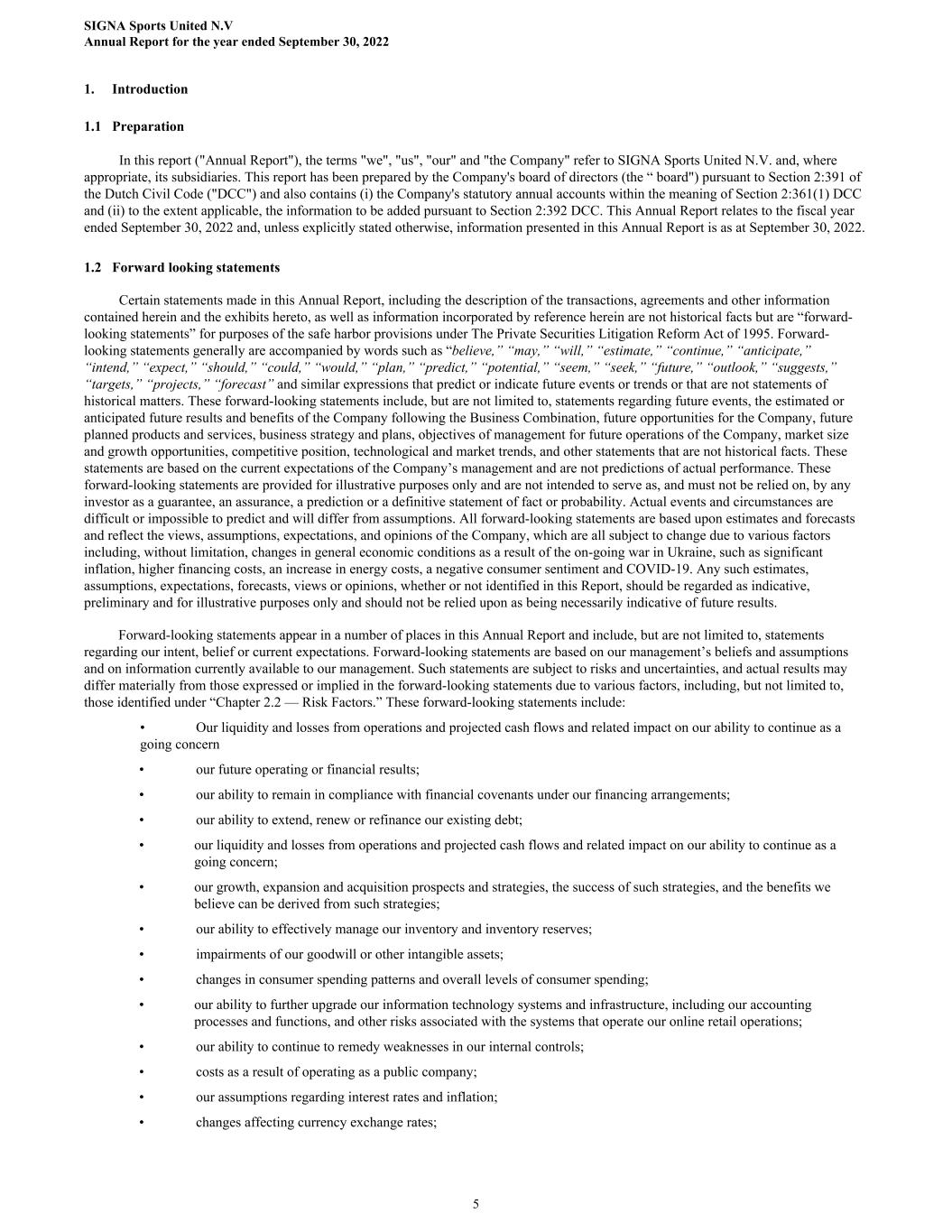
1. Introduction 1.1 Preparation In this report ("Annual Report"), the terms "we", "us", "our" and "the Company" refer to SIGNA Sports United N.V. and, where appropriate, its subsidiaries. This report has been prepared by the Company's board of directors (the “ board") pursuant to Section 2:391 of the Dutch Civil Code ("DCC") and also contains (i) the Company's statutory annual accounts within the meaning of Section 2:361(1) DCC and (ii) to the extent applicable, the information to be added pursuant to Section 2:392 DCC. This Annual Report relates to the fiscal year ended September 30, 2022 and, unless explicitly stated otherwise, information presented in this Annual Report is as at September 30, 2022. 1.2 Forward looking statements Certain statements made in this Annual Report, including the description of the transactions, agreements and other information contained herein and the exhibits hereto, as well as information incorporated by reference herein are not historical facts but are “forward- looking statements” for purposes of the safe harbor provisions under The Private Securities Litigation Reform Act of 1995. Forward- looking statements generally are accompanied by words such as “believe,” “may,” “will,” “estimate,” “continue,” “anticipate,” “intend,” “expect,” “should,” “could,” “would,” “plan,” “predict,” “potential,” “seem,” “seek,” “future,” “outlook,” “suggests,” “targets,” “projects,” “forecast” and similar expressions that predict or indicate future events or trends or that are not statements of historical matters. These forward-looking statements include, but are not limited to, statements regarding future events, the estimated or anticipated future results and benefits of the Company following the Business Combination, future opportunities for the Company, future planned products and services, business strategy and plans, objectives of management for future operations of the Company, market size and growth opportunities, competitive position, technological and market trends, and other statements that are not historical facts. These statements are based on the current expectations of the Company’s management and are not predictions of actual performance. These forward-looking statements are provided for illustrative purposes only and are not intended to serve as, and must not be relied on, by any investor as a guarantee, an assurance, a prediction or a definitive statement of fact or probability. Actual events and circumstances are difficult or impossible to predict and will differ from assumptions. All forward-looking statements are based upon estimates and forecasts and reflect the views, assumptions, expectations, and opinions of the Company, which are all subject to change due to various factors including, without limitation, changes in general economic conditions as a result of the on-going war in Ukraine, such as significant inflation, higher financing costs, an increase in energy costs, a negative consumer sentiment and COVID-19. Any such estimates, assumptions, expectations, forecasts, views or opinions, whether or not identified in this Report, should be regarded as indicative, preliminary and for illustrative purposes only and should not be relied upon as being necessarily indicative of future results. Forward-looking statements appear in a number of places in this Annual Report and include, but are not limited to, statements regarding our intent, belief or current expectations. Forward-looking statements are based on our management’s beliefs and assumptions and on information currently available to our management. Such statements are subject to risks and uncertainties, and actual results may differ materially from those expressed or implied in the forward-looking statements due to various factors, including, but not limited to, those identified under “Chapter 2.2 — Risk Factors.” These forward-looking statements include: • Our liquidity and losses from operations and projected cash flows and related impact on our ability to continue as a going concern • our future operating or financial results; • our ability to remain in compliance with financial covenants under our financing arrangements; • our ability to extend, renew or refinance our existing debt; • our liquidity and losses from operations and projected cash flows and related impact on our ability to continue as a going concern; • our growth, expansion and acquisition prospects and strategies, the success of such strategies, and the benefits we believe can be derived from such strategies; • our ability to effectively manage our inventory and inventory reserves; • impairments of our goodwill or other intangible assets; • changes in consumer spending patterns and overall levels of consumer spending; • our ability to further upgrade our information technology systems and infrastructure, including our accounting processes and functions, and other risks associated with the systems that operate our online retail operations; • our ability to continue to remedy weaknesses in our internal controls; • costs as a result of operating as a public company; • our assumptions regarding interest rates and inflation; • changes affecting currency exchange rates; SIGNA Sports United N.V Annual Report for the year ended September 30, 2022 5
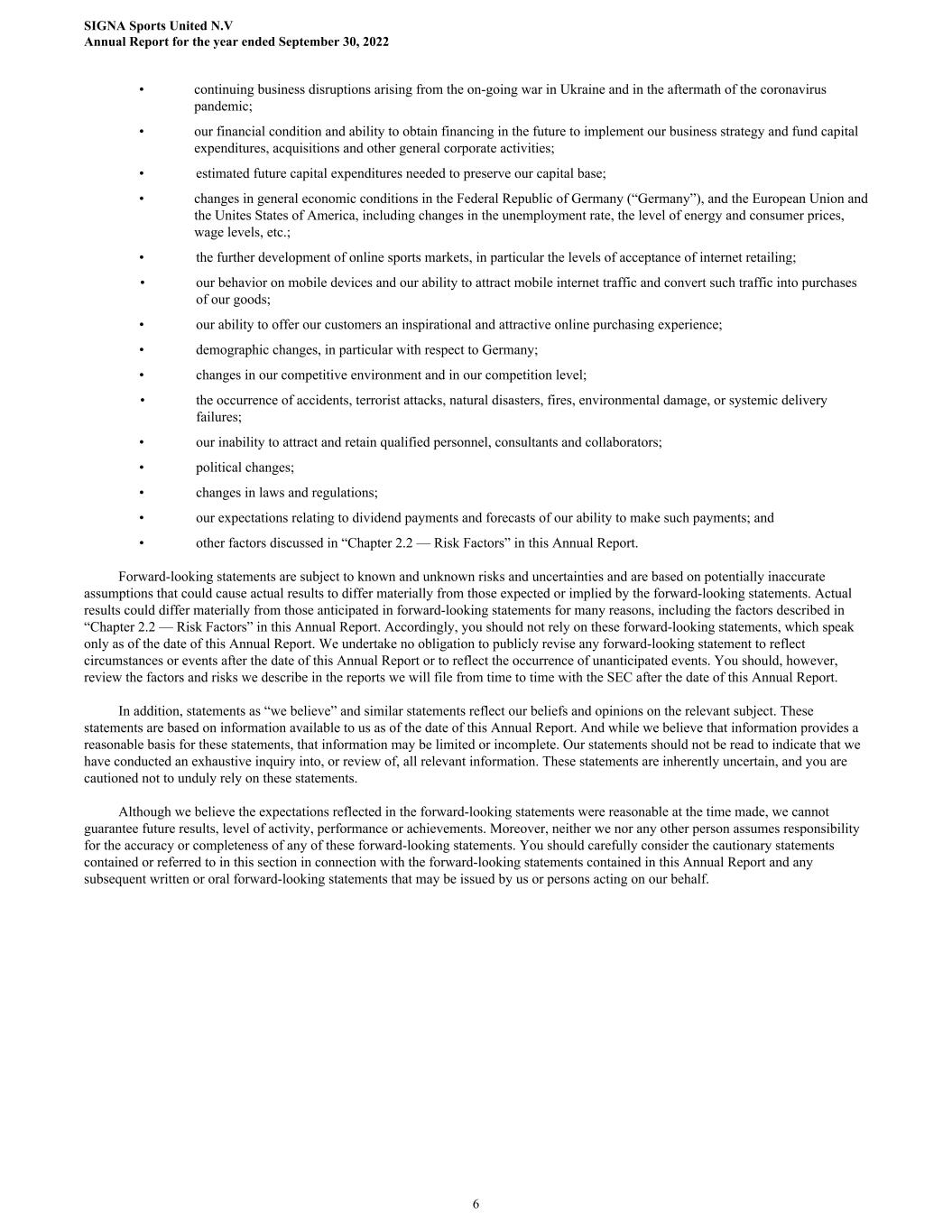
• continuing business disruptions arising from the on-going war in Ukraine and in the aftermath of the coronavirus pandemic; • our financial condition and ability to obtain financing in the future to implement our business strategy and fund capital expenditures, acquisitions and other general corporate activities; • estimated future capital expenditures needed to preserve our capital base; • changes in general economic conditions in the Federal Republic of Germany (“Germany”), and the European Union and the Unites States of America, including changes in the unemployment rate, the level of energy and consumer prices, wage levels, etc.; • the further development of online sports markets, in particular the levels of acceptance of internet retailing; • our behavior on mobile devices and our ability to attract mobile internet traffic and convert such traffic into purchases of our goods; • our ability to offer our customers an inspirational and attractive online purchasing experience; • demographic changes, in particular with respect to Germany; • changes in our competitive environment and in our competition level; • the occurrence of accidents, terrorist attacks, natural disasters, fires, environmental damage, or systemic delivery failures; • our inability to attract and retain qualified personnel, consultants and collaborators; • political changes; • changes in laws and regulations; • our expectations relating to dividend payments and forecasts of our ability to make such payments; and • other factors discussed in “Chapter 2.2 — Risk Factors” in this Annual Report. Forward-looking statements are subject to known and unknown risks and uncertainties and are based on potentially inaccurate assumptions that could cause actual results to differ materially from those expected or implied by the forward-looking statements. Actual results could differ materially from those anticipated in forward-looking statements for many reasons, including the factors described in “Chapter 2.2 — Risk Factors” in this Annual Report. Accordingly, you should not rely on these forward-looking statements, which speak only as of the date of this Annual Report. We undertake no obligation to publicly revise any forward-looking statement to reflect circumstances or events after the date of this Annual Report or to reflect the occurrence of unanticipated events. You should, however, review the factors and risks we describe in the reports we will file from time to time with the SEC after the date of this Annual Report. In addition, statements as “we believe” and similar statements reflect our beliefs and opinions on the relevant subject. These statements are based on information available to us as of the date of this Annual Report. And while we believe that information provides a reasonable basis for these statements, that information may be limited or incomplete. Our statements should not be read to indicate that we have conducted an exhaustive inquiry into, or review of, all relevant information. These statements are inherently uncertain, and you are cautioned not to unduly rely on these statements. Although we believe the expectations reflected in the forward-looking statements were reasonable at the time made, we cannot guarantee future results, level of activity, performance or achievements. Moreover, neither we nor any other person assumes responsibility for the accuracy or completeness of any of these forward-looking statements. You should carefully consider the cautionary statements contained or referred to in this section in connection with the forward-looking statements contained in this Annual Report and any subsequent written or oral forward-looking statements that may be issued by us or persons acting on our behalf. SIGNA Sports United N.V Annual Report for the year ended September 30, 2022 6
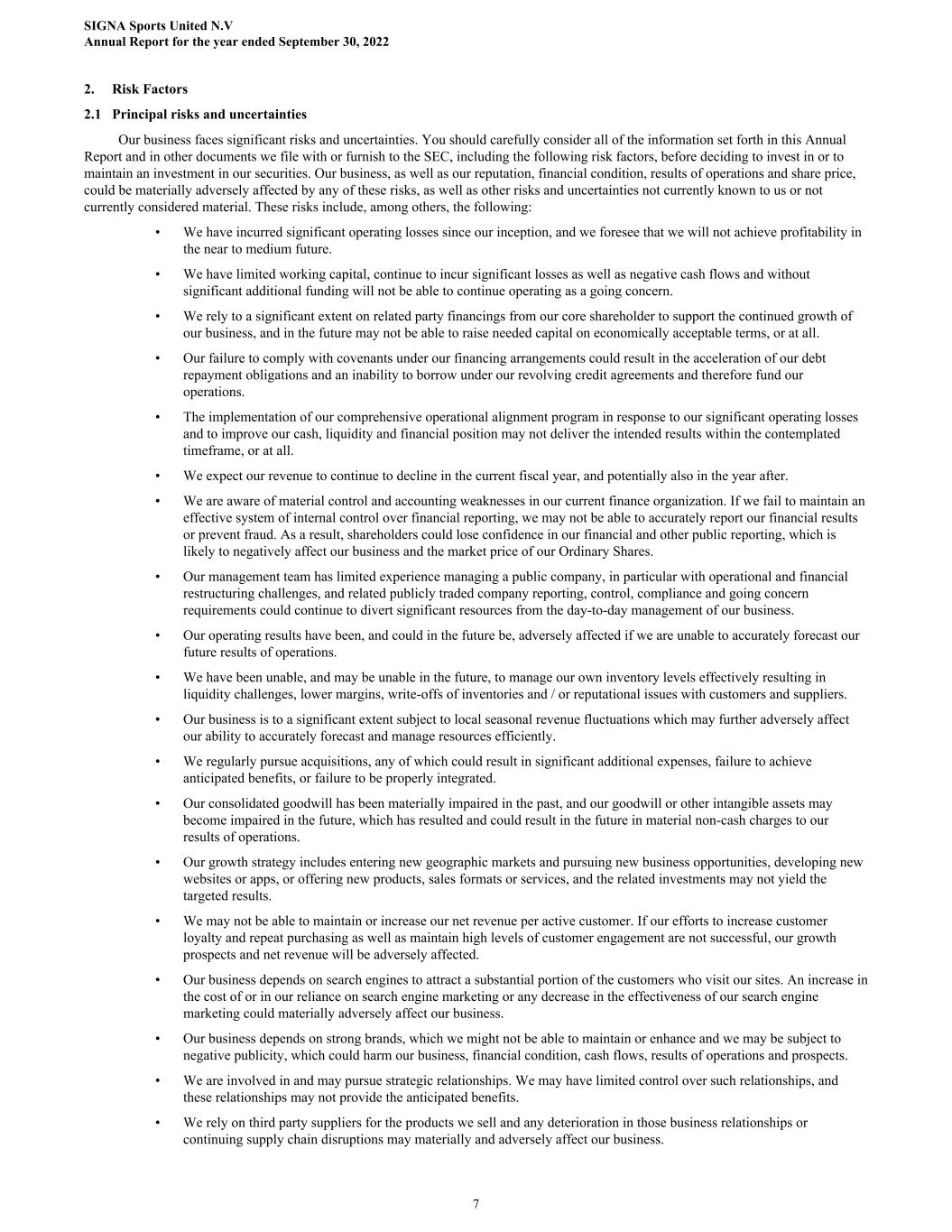
2. Risk Factors 2.1 Principal risks and uncertainties Our business faces significant risks and uncertainties. You should carefully consider all of the information set forth in this Annual Report and in other documents we file with or furnish to the SEC, including the following risk factors, before deciding to invest in or to maintain an investment in our securities. Our business, as well as our reputation, financial condition, results of operations and share price, could be materially adversely affected by any of these risks, as well as other risks and uncertainties not currently known to us or not currently considered material. These risks include, among others, the following: • We have incurred significant operating losses since our inception, and we foresee that we will not achieve profitability in the near to medium future. • We have limited working capital, continue to incur significant losses as well as negative cash flows and without significant additional funding will not be able to continue operating as a going concern. • We rely to a significant extent on related party financings from our core shareholder to support the continued growth of our business, and in the future may not be able to raise needed capital on economically acceptable terms, or at all. • Our failure to comply with covenants under our financing arrangements could result in the acceleration of our debt repayment obligations and an inability to borrow under our revolving credit agreements and therefore fund our operations. • The implementation of our comprehensive operational alignment program in response to our significant operating losses and to improve our cash, liquidity and financial position may not deliver the intended results within the contemplated timeframe, or at all. • We expect our revenue to continue to decline in the current fiscal year, and potentially also in the year after. • We are aware of material control and accounting weaknesses in our current finance organization. If we fail to maintain an effective system of internal control over financial reporting, we may not be able to accurately report our financial results or prevent fraud. As a result, shareholders could lose confidence in our financial and other public reporting, which is likely to negatively affect our business and the market price of our Ordinary Shares. • Our management team has limited experience managing a public company, in particular with operational and financial restructuring challenges, and related publicly traded company reporting, control, compliance and going concern requirements could continue to divert significant resources from the day-to-day management of our business. • Our operating results have been, and could in the future be, adversely affected if we are unable to accurately forecast our future results of operations. • We have been unable, and may be unable in the future, to manage our own inventory levels effectively resulting in liquidity challenges, lower margins, write-offs of inventories and / or reputational issues with customers and suppliers. • Our business is to a significant extent subject to local seasonal revenue fluctuations which may further adversely affect our ability to accurately forecast and manage resources efficiently. • We regularly pursue acquisitions, any of which could result in significant additional expenses, failure to achieve anticipated benefits, or failure to be properly integrated. • Our consolidated goodwill has been materially impaired in the past, and our goodwill or other intangible assets may become impaired in the future, which has resulted and could result in the future in material non-cash charges to our results of operations. • Our growth strategy includes entering new geographic markets and pursuing new business opportunities, developing new websites or apps, or offering new products, sales formats or services, and the related investments may not yield the targeted results. • We may not be able to maintain or increase our net revenue per active customer. If our efforts to increase customer loyalty and repeat purchasing as well as maintain high levels of customer engagement are not successful, our growth prospects and net revenue will be adversely affected. • Our business depends on search engines to attract a substantial portion of the customers who visit our sites. An increase in the cost of or in our reliance on search engine marketing or any decrease in the effectiveness of our search engine marketing could materially adversely affect our business. • Our business depends on strong brands, which we might not be able to maintain or enhance and we may be subject to negative publicity, which could harm our business, financial condition, cash flows, results of operations and prospects. • We are involved in and may pursue strategic relationships. We may have limited control over such relationships, and these relationships may not provide the anticipated benefits. • We rely on third party suppliers for the products we sell and any deterioration in those business relationships or continuing supply chain disruptions may materially and adversely affect our business. SIGNA Sports United N.V Annual Report for the year ended September 30, 2022 7
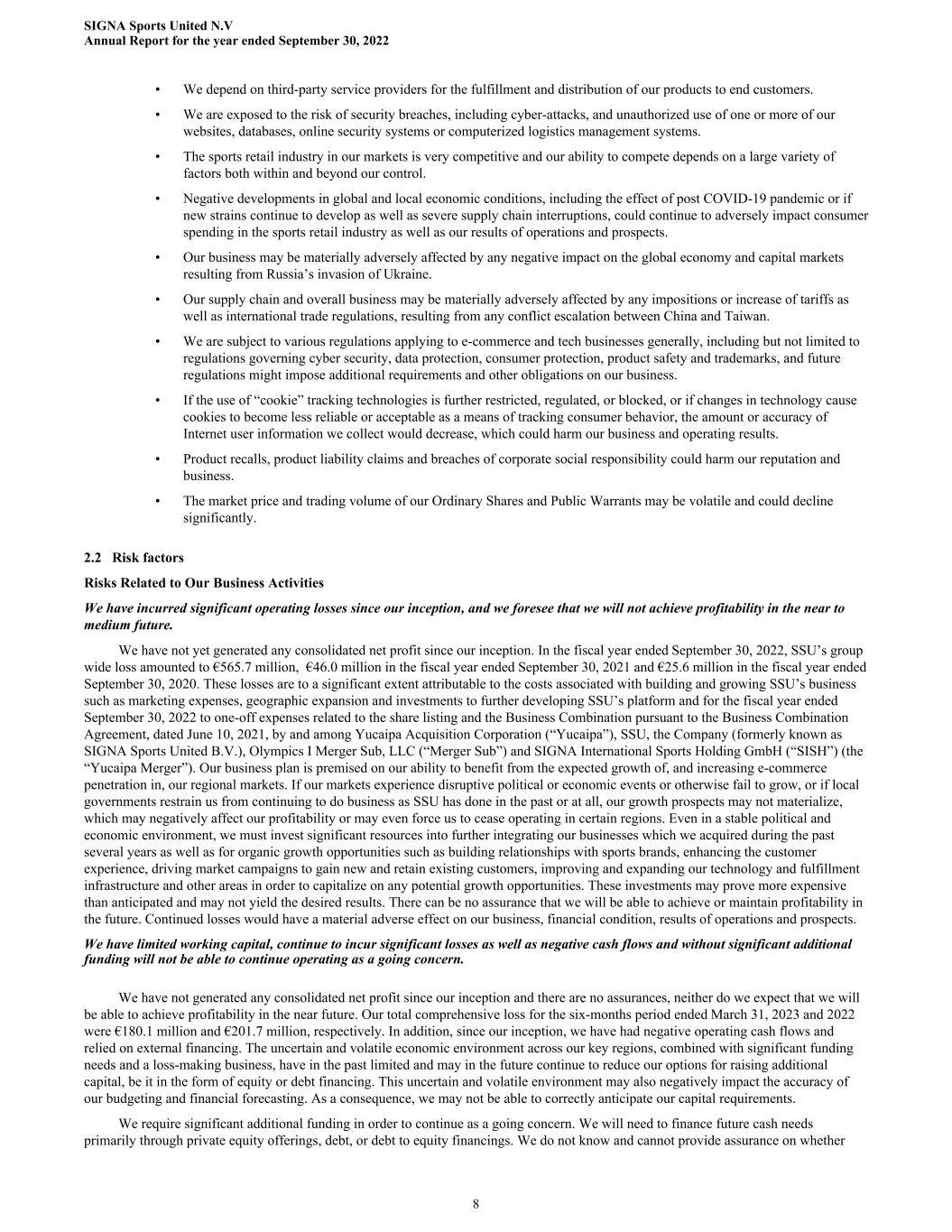
• We depend on third-party service providers for the fulfillment and distribution of our products to end customers. • We are exposed to the risk of security breaches, including cyber-attacks, and unauthorized use of one or more of our websites, databases, online security systems or computerized logistics management systems. • The sports retail industry in our markets is very competitive and our ability to compete depends on a large variety of factors both within and beyond our control. • Negative developments in global and local economic conditions, including the effect of post COVID-19 pandemic or if new strains continue to develop as well as severe supply chain interruptions, could continue to adversely impact consumer spending in the sports retail industry as well as our results of operations and prospects. • Our business may be materially adversely affected by any negative impact on the global economy and capital markets resulting from Russia’s invasion of Ukraine. • Our supply chain and overall business may be materially adversely affected by any impositions or increase of tariffs as well as international trade regulations, resulting from any conflict escalation between China and Taiwan. • We are subject to various regulations applying to e-commerce and tech businesses generally, including but not limited to regulations governing cyber security, data protection, consumer protection, product safety and trademarks, and future regulations might impose additional requirements and other obligations on our business. • If the use of “cookie” tracking technologies is further restricted, regulated, or blocked, or if changes in technology cause cookies to become less reliable or acceptable as a means of tracking consumer behavior, the amount or accuracy of Internet user information we collect would decrease, which could harm our business and operating results. • Product recalls, product liability claims and breaches of corporate social responsibility could harm our reputation and business. • The market price and trading volume of our Ordinary Shares and Public Warrants may be volatile and could decline significantly. 2.2 Risk factors Risks Related to Our Business Activities We have incurred significant operating losses since our inception, and we foresee that we will not achieve profitability in the near to medium future. We have not yet generated any consolidated net profit since our inception. In the fiscal year ended September 30, 2022, SSU’s group wide loss amounted to €565.7 million, €46.0 million in the fiscal year ended September 30, 2021 and €25.6 million in the fiscal year ended September 30, 2020. These losses are to a significant extent attributable to the costs associated with building and growing SSU’s business such as marketing expenses, geographic expansion and investments to further developing SSU’s platform and for the fiscal year ended September 30, 2022 to one-off expenses related to the share listing and the Business Combination pursuant to the Business Combination Agreement, dated June 10, 2021, by and among Yucaipa Acquisition Corporation (“Yucaipa”), SSU, the Company (formerly known as SIGNA Sports United B.V.), Olympics I Merger Sub, LLC (“Merger Sub”) and SIGNA International Sports Holding GmbH (“SISH”) (the “Yucaipa Merger”). Our business plan is premised on our ability to benefit from the expected growth of, and increasing e-commerce penetration in, our regional markets. If our markets experience disruptive political or economic events or otherwise fail to grow, or if local governments restrain us from continuing to do business as SSU has done in the past or at all, our growth prospects may not materialize, which may negatively affect our profitability or may even force us to cease operating in certain regions. Even in a stable political and economic environment, we must invest significant resources into further integrating our businesses which we acquired during the past several years as well as for organic growth opportunities such as building relationships with sports brands, enhancing the customer experience, driving market campaigns to gain new and retain existing customers, improving and expanding our technology and fulfillment infrastructure and other areas in order to capitalize on any potential growth opportunities. These investments may prove more expensive than anticipated and may not yield the desired results. There can be no assurance that we will be able to achieve or maintain profitability in the future. Continued losses would have a material adverse effect on our business, financial condition, results of operations and prospects. We have limited working capital, continue to incur significant losses as well as negative cash flows and without significant additional funding will not be able to continue operating as a going concern. We have not generated any consolidated net profit since our inception and there are no assurances, neither do we expect that we will be able to achieve profitability in the near future. Our total comprehensive loss for the six-months period ended March 31, 2023 and 2022 were €180.1 million and €201.7 million, respectively. In addition, since our inception, we have had negative operating cash flows and relied on external financing. The uncertain and volatile economic environment across our key regions, combined with significant funding needs and a loss-making business, have in the past limited and may in the future continue to reduce our options for raising additional capital, be it in the form of equity or debt financing. This uncertain and volatile environment may also negatively impact the accuracy of our budgeting and financial forecasting. As a consequence, we may not be able to correctly anticipate our capital requirements. We require significant additional funding in order to continue as a going concern. We will need to finance future cash needs primarily through private equity offerings, debt, or debt to equity financings. We do not know and cannot provide assurance on whether SIGNA Sports United N.V Annual Report for the year ended September 30, 2022 8
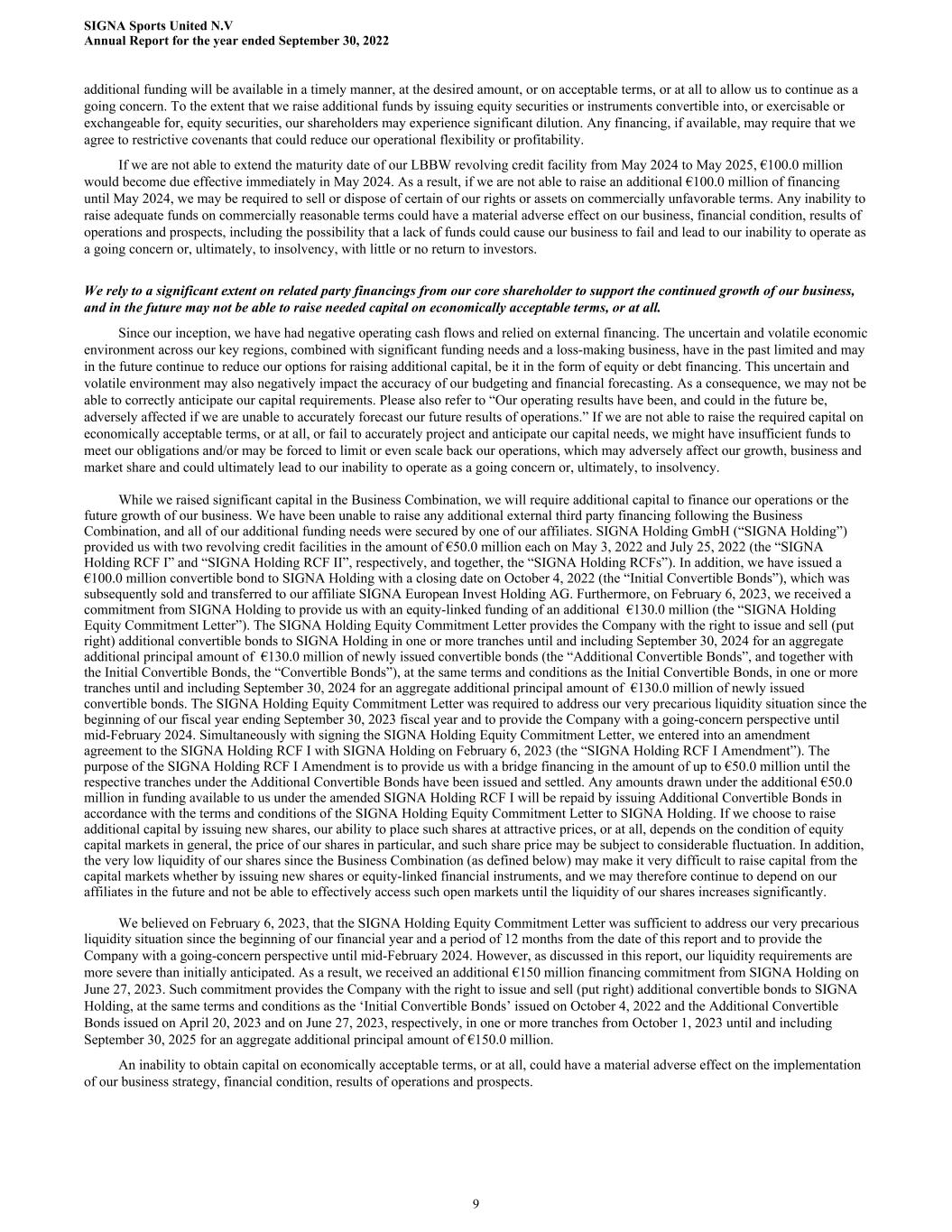
additional funding will be available in a timely manner, at the desired amount, or on acceptable terms, or at all to allow us to continue as a going concern. To the extent that we raise additional funds by issuing equity securities or instruments convertible into, or exercisable or exchangeable for, equity securities, our shareholders may experience significant dilution. Any financing, if available, may require that we agree to restrictive covenants that could reduce our operational flexibility or profitability. If we are not able to extend the maturity date of our LBBW revolving credit facility from May 2024 to May 2025, €100.0 million would become due effective immediately in May 2024. As a result, if we are not able to raise an additional €100.0 million of financing until May 2024, we may be required to sell or dispose of certain of our rights or assets on commercially unfavorable terms. Any inability to raise adequate funds on commercially reasonable terms could have a material adverse effect on our business, financial condition, results of operations and prospects, including the possibility that a lack of funds could cause our business to fail and lead to our inability to operate as a going concern or, ultimately, to insolvency, with little or no return to investors. We rely to a significant extent on related party financings from our core shareholder to support the continued growth of our business, and in the future may not be able to raise needed capital on economically acceptable terms, or at all. Since our inception, we have had negative operating cash flows and relied on external financing. The uncertain and volatile economic environment across our key regions, combined with significant funding needs and a loss-making business, have in the past limited and may in the future continue to reduce our options for raising additional capital, be it in the form of equity or debt financing. This uncertain and volatile environment may also negatively impact the accuracy of our budgeting and financial forecasting. As a consequence, we may not be able to correctly anticipate our capital requirements. Please also refer to “Our operating results have been, and could in the future be, adversely affected if we are unable to accurately forecast our future results of operations.” If we are not able to raise the required capital on economically acceptable terms, or at all, or fail to accurately project and anticipate our capital needs, we might have insufficient funds to meet our obligations and/or may be forced to limit or even scale back our operations, which may adversely affect our growth, business and market share and could ultimately lead to our inability to operate as a going concern or, ultimately, to insolvency. While we raised significant capital in the Business Combination, we will require additional capital to finance our operations or the future growth of our business. We have been unable to raise any additional external third party financing following the Business Combination, and all of our additional funding needs were secured by one of our affiliates. SIGNA Holding GmbH (“SIGNA Holding”) provided us with two revolving credit facilities in the amount of €50.0 million each on May 3, 2022 and July 25, 2022 (the “SIGNA Holding RCF I” and “SIGNA Holding RCF II”, respectively, and together, the “SIGNA Holding RCFs”). In addition, we have issued a €100.0 million convertible bond to SIGNA Holding with a closing date on October 4, 2022 (the “Initial Convertible Bonds”), which was subsequently sold and transferred to our affiliate SIGNA European Invest Holding AG. Furthermore, on February 6, 2023, we received a commitment from SIGNA Holding to provide us with an equity-linked funding of an additional €130.0 million (the “SIGNA Holding Equity Commitment Letter”). The SIGNA Holding Equity Commitment Letter provides the Company with the right to issue and sell (put right) additional convertible bonds to SIGNA Holding in one or more tranches until and including September 30, 2024 for an aggregate additional principal amount of €130.0 million of newly issued convertible bonds (the “Additional Convertible Bonds”, and together with the Initial Convertible Bonds, the “Convertible Bonds”), at the same terms and conditions as the Initial Convertible Bonds, in one or more tranches until and including September 30, 2024 for an aggregate additional principal amount of €130.0 million of newly issued convertible bonds. The SIGNA Holding Equity Commitment Letter was required to address our very precarious liquidity situation since the beginning of our fiscal year ending September 30, 2023 fiscal year and to provide the Company with a going-concern perspective until mid-February 2024. Simultaneously with signing the SIGNA Holding Equity Commitment Letter, we entered into an amendment agreement to the SIGNA Holding RCF I with SIGNA Holding on February 6, 2023 (the “SIGNA Holding RCF I Amendment”). The purpose of the SIGNA Holding RCF I Amendment is to provide us with a bridge financing in the amount of up to €50.0 million until the respective tranches under the Additional Convertible Bonds have been issued and settled. Any amounts drawn under the additional €50.0 million in funding available to us under the amended SIGNA Holding RCF I will be repaid by issuing Additional Convertible Bonds in accordance with the terms and conditions of the SIGNA Holding Equity Commitment Letter to SIGNA Holding. If we choose to raise additional capital by issuing new shares, our ability to place such shares at attractive prices, or at all, depends on the condition of equity capital markets in general, the price of our shares in particular, and such share price may be subject to considerable fluctuation. In addition, the very low liquidity of our shares since the Business Combination (as defined below) may make it very difficult to raise capital from the capital markets whether by issuing new shares or equity-linked financial instruments, and we may therefore continue to depend on our affiliates in the future and not be able to effectively access such open markets until the liquidity of our shares increases significantly. We believed on February 6, 2023, that the SIGNA Holding Equity Commitment Letter was sufficient to address our very precarious liquidity situation since the beginning of our financial year and a period of 12 months from the date of this report and to provide the Company with a going-concern perspective until mid-February 2024. However, as discussed in this report, our liquidity requirements are more severe than initially anticipated. As a result, we received an additional €150 million financing commitment from SIGNA Holding on June 27, 2023. Such commitment provides the Company with the right to issue and sell (put right) additional convertible bonds to SIGNA Holding, at the same terms and conditions as the ‘Initial Convertible Bonds’ issued on October 4, 2022 and the Additional Convertible Bonds issued on April 20, 2023 and on June 27, 2023, respectively, in one or more tranches from October 1, 2023 until and including September 30, 2025 for an aggregate additional principal amount of €150.0 million. An inability to obtain capital on economically acceptable terms, or at all, could have a material adverse effect on the implementation of our business strategy, financial condition, results of operations and prospects. SIGNA Sports United N.V Annual Report for the year ended September 30, 2022 9
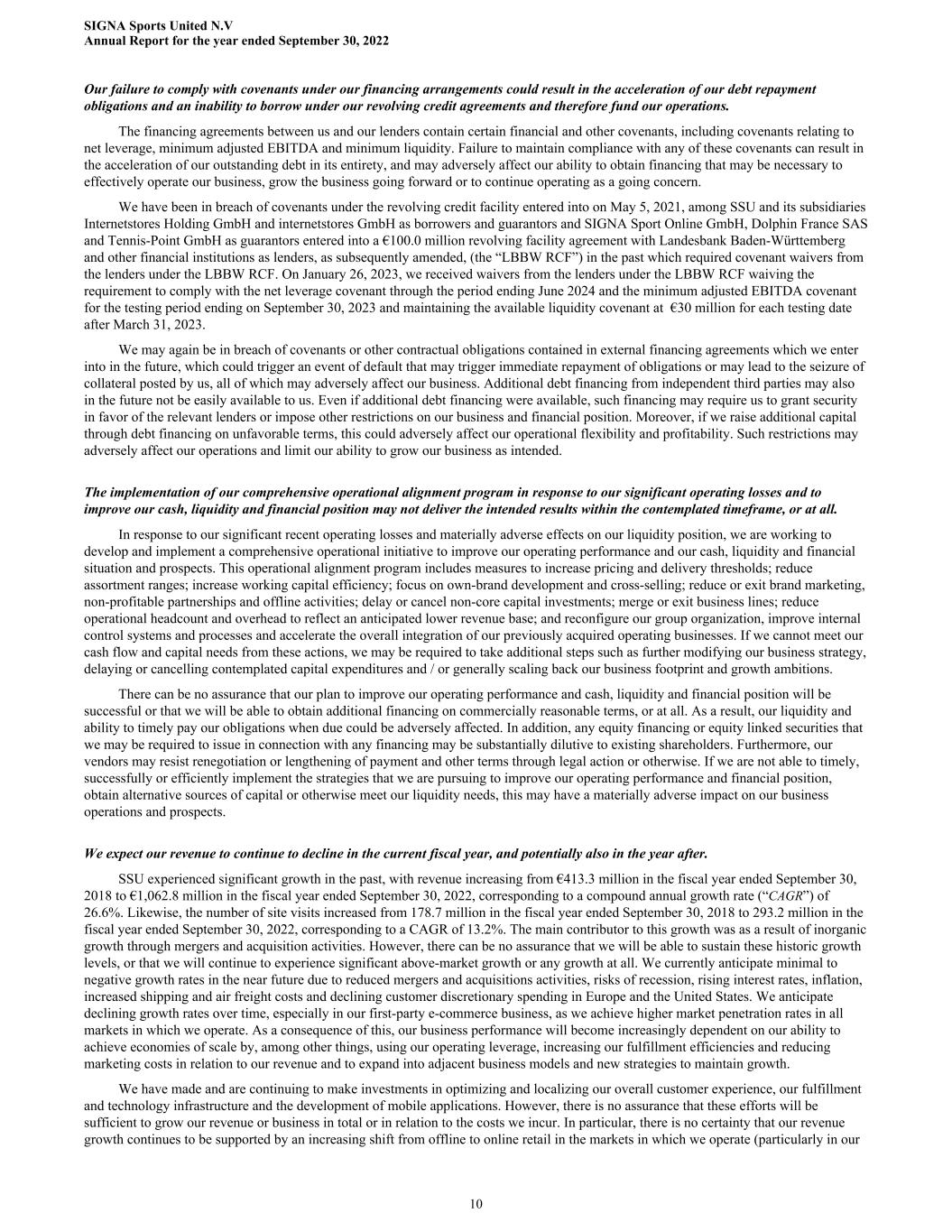
Our failure to comply with covenants under our financing arrangements could result in the acceleration of our debt repayment obligations and an inability to borrow under our revolving credit agreements and therefore fund our operations. The financing agreements between us and our lenders contain certain financial and other covenants, including covenants relating to net leverage, minimum adjusted EBITDA and minimum liquidity. Failure to maintain compliance with any of these covenants can result in the acceleration of our outstanding debt in its entirety, and may adversely affect our ability to obtain financing that may be necessary to effectively operate our business, grow the business going forward or to continue operating as a going concern. We have been in breach of covenants under the revolving credit facility entered into on May 5, 2021, among SSU and its subsidiaries Internetstores Holding GmbH and internetstores GmbH as borrowers and guarantors and SIGNA Sport Online GmbH, Dolphin France SAS and Tennis-Point GmbH as guarantors entered into a €100.0 million revolving facility agreement with Landesbank Baden-Württemberg and other financial institutions as lenders, as subsequently amended, (the “LBBW RCF”) in the past which required covenant waivers from the lenders under the LBBW RCF. On January 26, 2023, we received waivers from the lenders under the LBBW RCF waiving the requirement to comply with the net leverage covenant through the period ending June 2024 and the minimum adjusted EBITDA covenant for the testing period ending on September 30, 2023 and maintaining the available liquidity covenant at €30 million for each testing date after March 31, 2023. We may again be in breach of covenants or other contractual obligations contained in external financing agreements which we enter into in the future, which could trigger an event of default that may trigger immediate repayment of obligations or may lead to the seizure of collateral posted by us, all of which may adversely affect our business. Additional debt financing from independent third parties may also in the future not be easily available to us. Even if additional debt financing were available, such financing may require us to grant security in favor of the relevant lenders or impose other restrictions on our business and financial position. Moreover, if we raise additional capital through debt financing on unfavorable terms, this could adversely affect our operational flexibility and profitability. Such restrictions may adversely affect our operations and limit our ability to grow our business as intended. The implementation of our comprehensive operational alignment program in response to our significant operating losses and to improve our cash, liquidity and financial position may not deliver the intended results within the contemplated timeframe, or at all. In response to our significant recent operating losses and materially adverse effects on our liquidity position, we are working to develop and implement a comprehensive operational initiative to improve our operating performance and our cash, liquidity and financial situation and prospects. This operational alignment program includes measures to increase pricing and delivery thresholds; reduce assortment ranges; increase working capital efficiency; focus on own-brand development and cross-selling; reduce or exit brand marketing, non-profitable partnerships and offline activities; delay or cancel non-core capital investments; merge or exit business lines; reduce operational headcount and overhead to reflect an anticipated lower revenue base; and reconfigure our group organization, improve internal control systems and processes and accelerate the overall integration of our previously acquired operating businesses. If we cannot meet our cash flow and capital needs from these actions, we may be required to take additional steps such as further modifying our business strategy, delaying or cancelling contemplated capital expenditures and / or generally scaling back our business footprint and growth ambitions. There can be no assurance that our plan to improve our operating performance and cash, liquidity and financial position will be successful or that we will be able to obtain additional financing on commercially reasonable terms, or at all. As a result, our liquidity and ability to timely pay our obligations when due could be adversely affected. In addition, any equity financing or equity linked securities that we may be required to issue in connection with any financing may be substantially dilutive to existing shareholders. Furthermore, our vendors may resist renegotiation or lengthening of payment and other terms through legal action or otherwise. If we are not able to timely, successfully or efficiently implement the strategies that we are pursuing to improve our operating performance and financial position, obtain alternative sources of capital or otherwise meet our liquidity needs, this may have a materially adverse impact on our business operations and prospects. We expect our revenue to continue to decline in the current fiscal year, and potentially also in the year after. SSU experienced significant growth in the past, with revenue increasing from €413.3 million in the fiscal year ended September 30, 2018 to €1,062.8 million in the fiscal year ended September 30, 2022, corresponding to a compound annual growth rate (“CAGR”) of 26.6%. Likewise, the number of site visits increased from 178.7 million in the fiscal year ended September 30, 2018 to 293.2 million in the fiscal year ended September 30, 2022, corresponding to a CAGR of 13.2%. The main contributor to this growth was as a result of inorganic growth through mergers and acquisition activities. However, there can be no assurance that we will be able to sustain these historic growth levels, or that we will continue to experience significant above-market growth or any growth at all. We currently anticipate minimal to negative growth rates in the near future due to reduced mergers and acquisitions activities, risks of recession, rising interest rates, inflation, increased shipping and air freight costs and declining customer discretionary spending in Europe and the United States. We anticipate declining growth rates over time, especially in our first-party e-commerce business, as we achieve higher market penetration rates in all markets in which we operate. As a consequence of this, our business performance will become increasingly dependent on our ability to achieve economies of scale by, among other things, using our operating leverage, increasing our fulfillment efficiencies and reducing marketing costs in relation to our revenue and to expand into adjacent business models and new strategies to maintain growth. We have made and are continuing to make investments in optimizing and localizing our overall customer experience, our fulfillment and technology infrastructure and the development of mobile applications. However, there is no assurance that these efforts will be sufficient to grow our revenue or business in total or in relation to the costs we incur. In particular, there is no certainty that our revenue growth continues to be supported by an increasing shift from offline to online retail in the markets in which we operate (particularly in our SIGNA Sports United N.V Annual Report for the year ended September 30, 2022 10
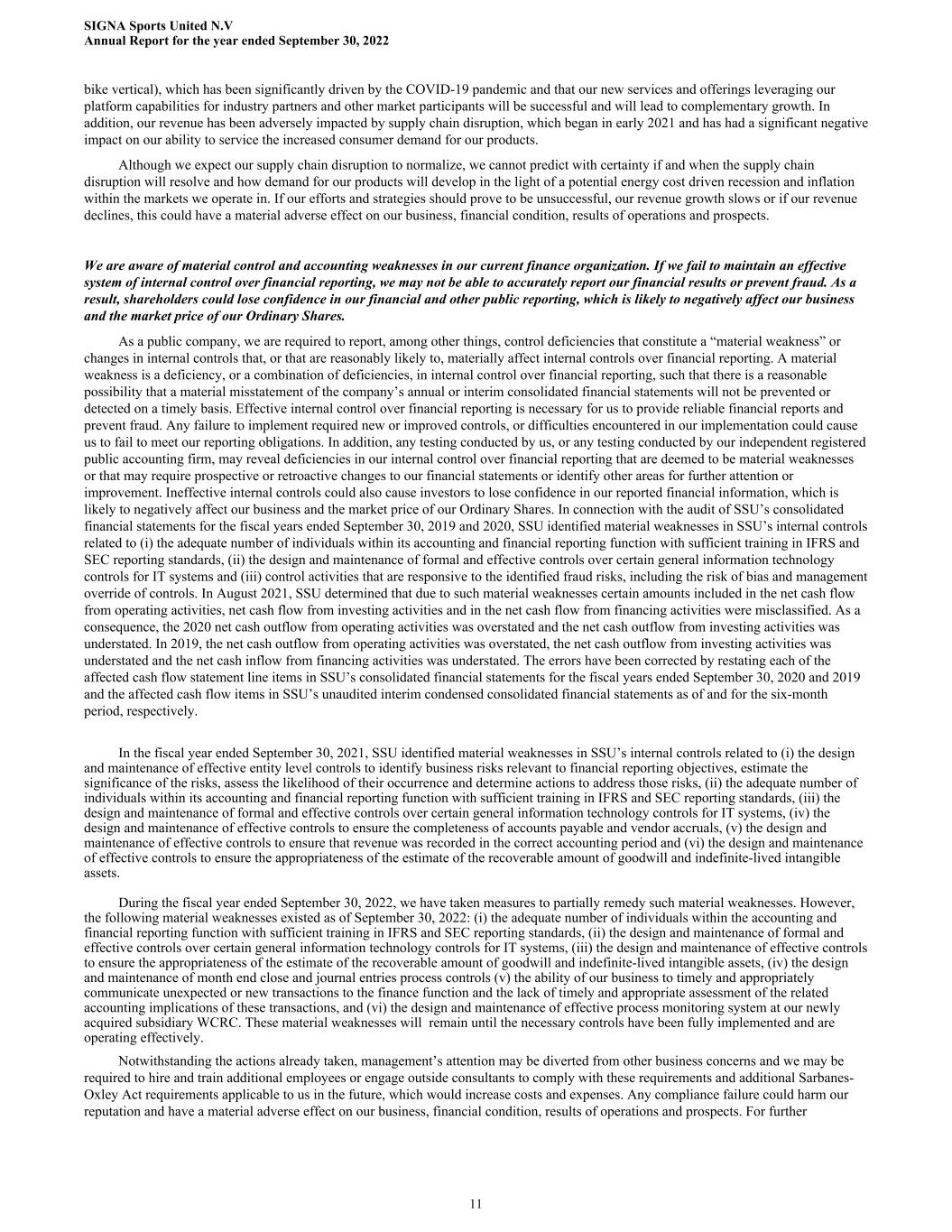
bike vertical), which has been significantly driven by the COVID-19 pandemic and that our new services and offerings leveraging our platform capabilities for industry partners and other market participants will be successful and will lead to complementary growth. In addition, our revenue has been adversely impacted by supply chain disruption, which began in early 2021 and has had a significant negative impact on our ability to service the increased consumer demand for our products. Although we expect our supply chain disruption to normalize, we cannot predict with certainty if and when the supply chain disruption will resolve and how demand for our products will develop in the light of a potential energy cost driven recession and inflation within the markets we operate in. If our efforts and strategies should prove to be unsuccessful, our revenue growth slows or if our revenue declines, this could have a material adverse effect on our business, financial condition, results of operations and prospects. We are aware of material control and accounting weaknesses in our current finance organization. If we fail to maintain an effective system of internal control over financial reporting, we may not be able to accurately report our financial results or prevent fraud. As a result, shareholders could lose confidence in our financial and other public reporting, which is likely to negatively affect our business and the market price of our Ordinary Shares. As a public company, we are required to report, among other things, control deficiencies that constitute a “material weakness” or changes in internal controls that, or that are reasonably likely to, materially affect internal controls over financial reporting. A material weakness is a deficiency, or a combination of deficiencies, in internal control over financial reporting, such that there is a reasonable possibility that a material misstatement of the company’s annual or interim consolidated financial statements will not be prevented or detected on a timely basis. Effective internal control over financial reporting is necessary for us to provide reliable financial reports and prevent fraud. Any failure to implement required new or improved controls, or difficulties encountered in our implementation could cause us to fail to meet our reporting obligations. In addition, any testing conducted by us, or any testing conducted by our independent registered public accounting firm, may reveal deficiencies in our internal control over financial reporting that are deemed to be material weaknesses or that may require prospective or retroactive changes to our financial statements or identify other areas for further attention or improvement. Ineffective internal controls could also cause investors to lose confidence in our reported financial information, which is likely to negatively affect our business and the market price of our Ordinary Shares. In connection with the audit of SSU’s consolidated financial statements for the fiscal years ended September 30, 2019 and 2020, SSU identified material weaknesses in SSU’s internal controls related to (i) the adequate number of individuals within its accounting and financial reporting function with sufficient training in IFRS and SEC reporting standards, (ii) the design and maintenance of formal and effective controls over certain general information technology controls for IT systems and (iii) control activities that are responsive to the identified fraud risks, including the risk of bias and management override of controls. In August 2021, SSU determined that due to such material weaknesses certain amounts included in the net cash flow from operating activities, net cash flow from investing activities and in the net cash flow from financing activities were misclassified. As a consequence, the 2020 net cash outflow from operating activities was overstated and the net cash outflow from investing activities was understated. In 2019, the net cash outflow from operating activities was overstated, the net cash outflow from investing activities was understated and the net cash inflow from financing activities was understated. The errors have been corrected by restating each of the affected cash flow statement line items in SSU’s consolidated financial statements for the fiscal years ended September 30, 2020 and 2019 and the affected cash flow items in SSU’s unaudited interim condensed consolidated financial statements as of and for the six-month period, respectively. In the fiscal year ended September 30, 2021, SSU identified material weaknesses in SSU’s internal controls related to (i) the design and maintenance of effective entity level controls to identify business risks relevant to financial reporting objectives, estimate the significance of the risks, assess the likelihood of their occurrence and determine actions to address those risks, (ii) the adequate number of individuals within its accounting and financial reporting function with sufficient training in IFRS and SEC reporting standards, (iii) the design and maintenance of formal and effective controls over certain general information technology controls for IT systems, (iv) the design and maintenance of effective controls to ensure the completeness of accounts payable and vendor accruals, (v) the design and maintenance of effective controls to ensure that revenue was recorded in the correct accounting period and (vi) the design and maintenance of effective controls to ensure the appropriateness of the estimate of the recoverable amount of goodwill and indefinite-lived intangible assets. During the fiscal year ended September 30, 2022, we have taken measures to partially remedy such material weaknesses. However, the following material weaknesses existed as of September 30, 2022: (i) the adequate number of individuals within the accounting and financial reporting function with sufficient training in IFRS and SEC reporting standards, (ii) the design and maintenance of formal and effective controls over certain general information technology controls for IT systems, (iii) the design and maintenance of effective controls to ensure the appropriateness of the estimate of the recoverable amount of goodwill and indefinite-lived intangible assets, (iv) the design and maintenance of month end close and journal entries process controls (v) the ability of our business to timely and appropriately communicate unexpected or new transactions to the finance function and the lack of timely and appropriate assessment of the related accounting implications of these transactions, and (vi) the design and maintenance of effective process monitoring system at our newly acquired subsidiary WCRC. These material weaknesses will remain until the necessary controls have been fully implemented and are operating effectively. Notwithstanding the actions already taken, management’s attention may be diverted from other business concerns and we may be required to hire and train additional employees or engage outside consultants to comply with these requirements and additional Sarbanes- Oxley Act requirements applicable to us in the future, which would increase costs and expenses. Any compliance failure could harm our reputation and have a material adverse effect on our business, financial condition, results of operations and prospects. For further SIGNA Sports United N.V Annual Report for the year ended September 30, 2022 11
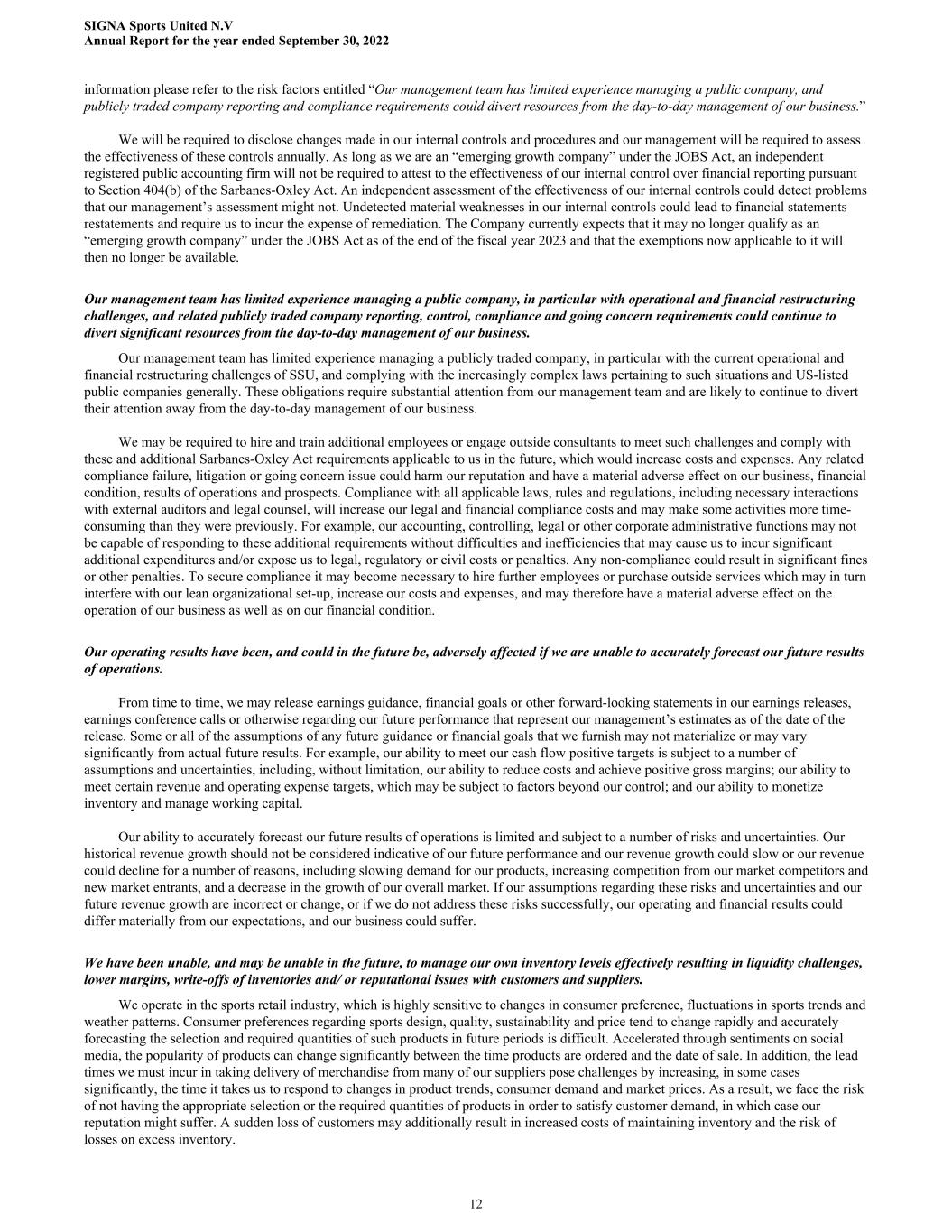
information please refer to the risk factors entitled “Our management team has limited experience managing a public company, and publicly traded company reporting and compliance requirements could divert resources from the day-to-day management of our business.” We will be required to disclose changes made in our internal controls and procedures and our management will be required to assess the effectiveness of these controls annually. As long as we are an “emerging growth company” under the JOBS Act, an independent registered public accounting firm will not be required to attest to the effectiveness of our internal control over financial reporting pursuant to Section 404(b) of the Sarbanes-Oxley Act. An independent assessment of the effectiveness of our internal controls could detect problems that our management’s assessment might not. Undetected material weaknesses in our internal controls could lead to financial statements restatements and require us to incur the expense of remediation. The Company currently expects that it may no longer qualify as an “emerging growth company” under the JOBS Act as of the end of the fiscal year 2023 and that the exemptions now applicable to it will then no longer be available. Our management team has limited experience managing a public company, in particular with operational and financial restructuring challenges, and related publicly traded company reporting, control, compliance and going concern requirements could continue to divert significant resources from the day-to-day management of our business. Our management team has limited experience managing a publicly traded company, in particular with the current operational and financial restructuring challenges of SSU, and complying with the increasingly complex laws pertaining to such situations and US-listed public companies generally. These obligations require substantial attention from our management team and are likely to continue to divert their attention away from the day-to-day management of our business. We may be required to hire and train additional employees or engage outside consultants to meet such challenges and comply with these and additional Sarbanes-Oxley Act requirements applicable to us in the future, which would increase costs and expenses. Any related compliance failure, litigation or going concern issue could harm our reputation and have a material adverse effect on our business, financial condition, results of operations and prospects. Compliance with all applicable laws, rules and regulations, including necessary interactions with external auditors and legal counsel, will increase our legal and financial compliance costs and may make some activities more time- consuming than they were previously. For example, our accounting, controlling, legal or other corporate administrative functions may not be capable of responding to these additional requirements without difficulties and inefficiencies that may cause us to incur significant additional expenditures and/or expose us to legal, regulatory or civil costs or penalties. Any non-compliance could result in significant fines or other penalties. To secure compliance it may become necessary to hire further employees or purchase outside services which may in turn interfere with our lean organizational set-up, increase our costs and expenses, and may therefore have a material adverse effect on the operation of our business as well as on our financial condition. Our operating results have been, and could in the future be, adversely affected if we are unable to accurately forecast our future results of operations. From time to time, we may release earnings guidance, financial goals or other forward-looking statements in our earnings releases, earnings conference calls or otherwise regarding our future performance that represent our management’s estimates as of the date of the release. Some or all of the assumptions of any future guidance or financial goals that we furnish may not materialize or may vary significantly from actual future results. For example, our ability to meet our cash flow positive targets is subject to a number of assumptions and uncertainties, including, without limitation, our ability to reduce costs and achieve positive gross margins; our ability to meet certain revenue and operating expense targets, which may be subject to factors beyond our control; and our ability to monetize inventory and manage working capital. Our ability to accurately forecast our future results of operations is limited and subject to a number of risks and uncertainties. Our historical revenue growth should not be considered indicative of our future performance and our revenue growth could slow or our revenue could decline for a number of reasons, including slowing demand for our products, increasing competition from our market competitors and new market entrants, and a decrease in the growth of our overall market. If our assumptions regarding these risks and uncertainties and our future revenue growth are incorrect or change, or if we do not address these risks successfully, our operating and financial results could differ materially from our expectations, and our business could suffer. We have been unable, and may be unable in the future, to manage our own inventory levels effectively resulting in liquidity challenges, lower margins, write-offs of inventories and/ or reputational issues with customers and suppliers. We operate in the sports retail industry, which is highly sensitive to changes in consumer preference, fluctuations in sports trends and weather patterns. Consumer preferences regarding sports design, quality, sustainability and price tend to change rapidly and accurately forecasting the selection and required quantities of such products in future periods is difficult. Accelerated through sentiments on social media, the popularity of products can change significantly between the time products are ordered and the date of sale. In addition, the lead times we must incur in taking delivery of merchandise from many of our suppliers pose challenges by increasing, in some cases significantly, the time it takes us to respond to changes in product trends, consumer demand and market prices. As a result, we face the risk of not having the appropriate selection or the required quantities of products in order to satisfy customer demand, in which case our reputation might suffer. A sudden loss of customers may additionally result in increased costs of maintaining inventory and the risk of losses on excess inventory. SIGNA Sports United N.V Annual Report for the year ended September 30, 2022 12
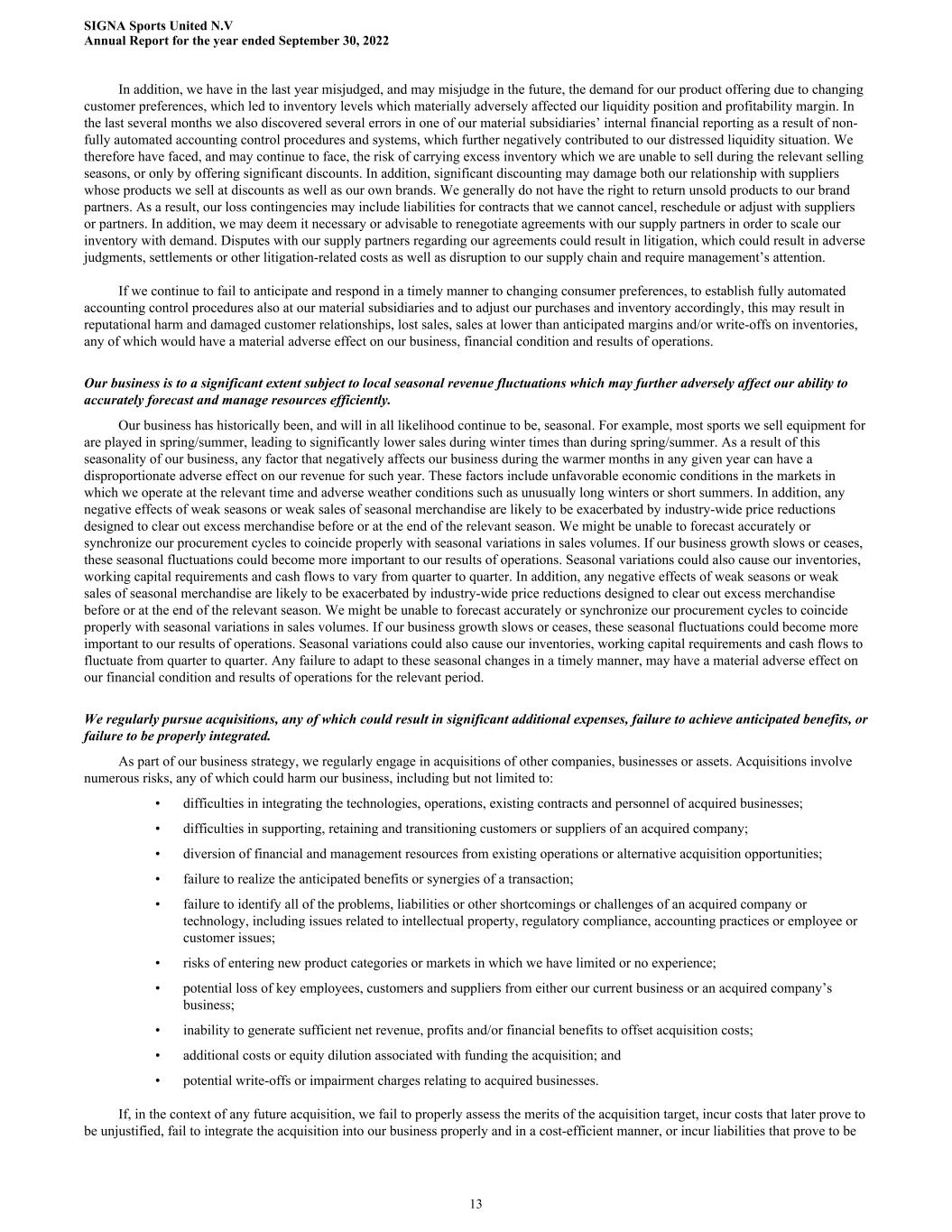
In addition, we have in the last year misjudged, and may misjudge in the future, the demand for our product offering due to changing customer preferences, which led to inventory levels which materially adversely affected our liquidity position and profitability margin. In the last several months we also discovered several errors in one of our material subsidiaries’ internal financial reporting as a result of non- fully automated accounting control procedures and systems, which further negatively contributed to our distressed liquidity situation. We therefore have faced, and may continue to face, the risk of carrying excess inventory which we are unable to sell during the relevant selling seasons, or only by offering significant discounts. In addition, significant discounting may damage both our relationship with suppliers whose products we sell at discounts as well as our own brands. We generally do not have the right to return unsold products to our brand partners. As a result, our loss contingencies may include liabilities for contracts that we cannot cancel, reschedule or adjust with suppliers or partners. In addition, we may deem it necessary or advisable to renegotiate agreements with our supply partners in order to scale our inventory with demand. Disputes with our supply partners regarding our agreements could result in litigation, which could result in adverse judgments, settlements or other litigation-related costs as well as disruption to our supply chain and require management’s attention. If we continue to fail to anticipate and respond in a timely manner to changing consumer preferences, to establish fully automated accounting control procedures also at our material subsidiaries and to adjust our purchases and inventory accordingly, this may result in reputational harm and damaged customer relationships, lost sales, sales at lower than anticipated margins and/or write-offs on inventories, any of which would have a material adverse effect on our business, financial condition and results of operations. Our business is to a significant extent subject to local seasonal revenue fluctuations which may further adversely affect our ability to accurately forecast and manage resources efficiently. Our business has historically been, and will in all likelihood continue to be, seasonal. For example, most sports we sell equipment for are played in spring/summer, leading to significantly lower sales during winter times than during spring/summer. As a result of this seasonality of our business, any factor that negatively affects our business during the warmer months in any given year can have a disproportionate adverse effect on our revenue for such year. These factors include unfavorable economic conditions in the markets in which we operate at the relevant time and adverse weather conditions such as unusually long winters or short summers. In addition, any negative effects of weak seasons or weak sales of seasonal merchandise are likely to be exacerbated by industry-wide price reductions designed to clear out excess merchandise before or at the end of the relevant season. We might be unable to forecast accurately or synchronize our procurement cycles to coincide properly with seasonal variations in sales volumes. If our business growth slows or ceases, these seasonal fluctuations could become more important to our results of operations. Seasonal variations could also cause our inventories, working capital requirements and cash flows to vary from quarter to quarter. In addition, any negative effects of weak seasons or weak sales of seasonal merchandise are likely to be exacerbated by industry-wide price reductions designed to clear out excess merchandise before or at the end of the relevant season. We might be unable to forecast accurately or synchronize our procurement cycles to coincide properly with seasonal variations in sales volumes. If our business growth slows or ceases, these seasonal fluctuations could become more important to our results of operations. Seasonal variations could also cause our inventories, working capital requirements and cash flows to fluctuate from quarter to quarter. Any failure to adapt to these seasonal changes in a timely manner, may have a material adverse effect on our financial condition and results of operations for the relevant period. We regularly pursue acquisitions, any of which could result in significant additional expenses, failure to achieve anticipated benefits, or failure to be properly integrated. As part of our business strategy, we regularly engage in acquisitions of other companies, businesses or assets. Acquisitions involve numerous risks, any of which could harm our business, including but not limited to: • difficulties in integrating the technologies, operations, existing contracts and personnel of acquired businesses; • difficulties in supporting, retaining and transitioning customers or suppliers of an acquired company; • diversion of financial and management resources from existing operations or alternative acquisition opportunities; • failure to realize the anticipated benefits or synergies of a transaction; • failure to identify all of the problems, liabilities or other shortcomings or challenges of an acquired company or technology, including issues related to intellectual property, regulatory compliance, accounting practices or employee or customer issues; • risks of entering new product categories or markets in which we have limited or no experience; • potential loss of key employees, customers and suppliers from either our current business or an acquired company’s business; • inability to generate sufficient net revenue, profits and/or financial benefits to offset acquisition costs; • additional costs or equity dilution associated with funding the acquisition; and • potential write-offs or impairment charges relating to acquired businesses. If, in the context of any future acquisition, we fail to properly assess the merits of the acquisition target, incur costs that later prove to be unjustified, fail to integrate the acquisition into our business properly and in a cost-efficient manner, or incur liabilities that prove to be SIGNA Sports United N.V Annual Report for the year ended September 30, 2022 13
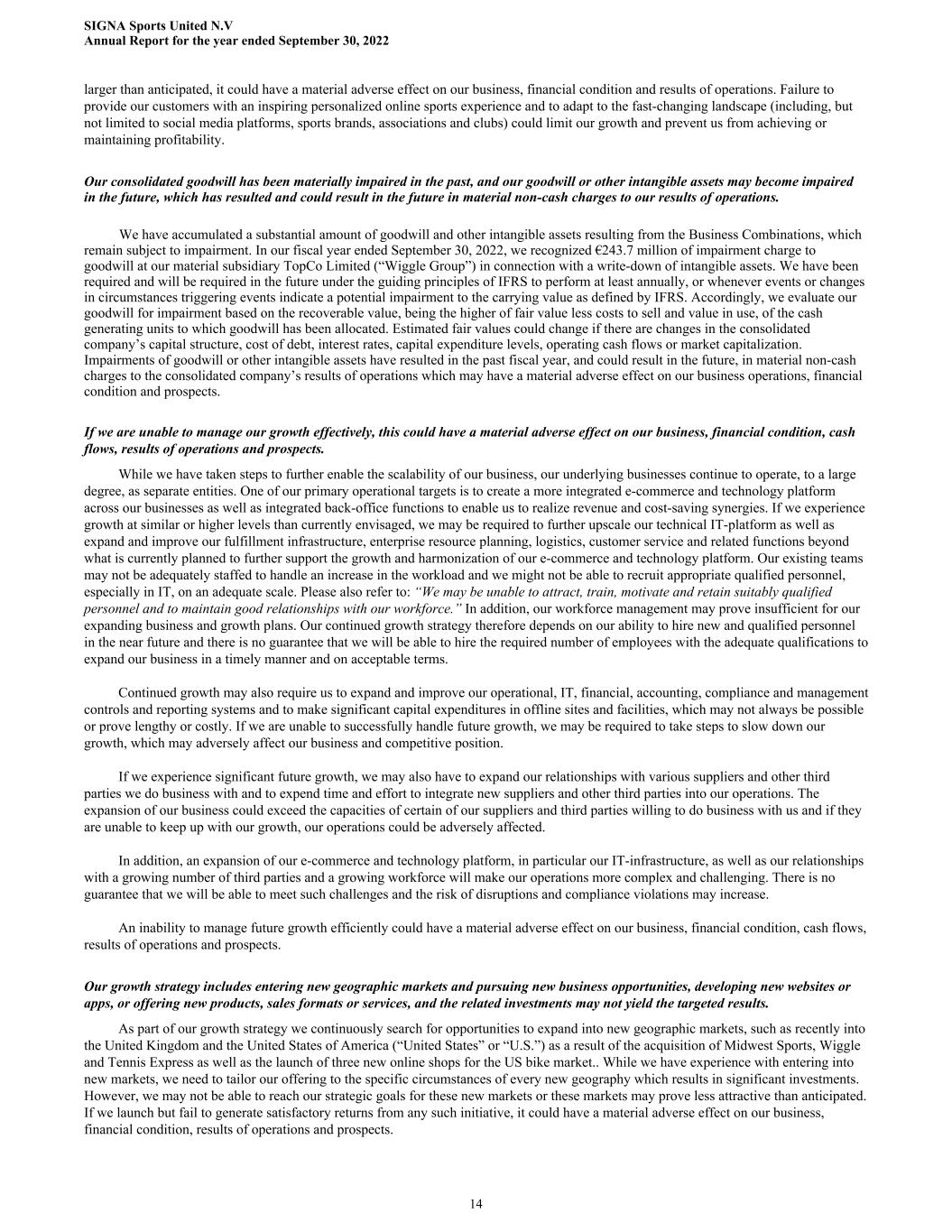
larger than anticipated, it could have a material adverse effect on our business, financial condition and results of operations. Failure to provide our customers with an inspiring personalized online sports experience and to adapt to the fast-changing landscape (including, but not limited to social media platforms, sports brands, associations and clubs) could limit our growth and prevent us from achieving or maintaining profitability. Our consolidated goodwill has been materially impaired in the past, and our goodwill or other intangible assets may become impaired in the future, which has resulted and could result in the future in material non-cash charges to our results of operations. We have accumulated a substantial amount of goodwill and other intangible assets resulting from the Business Combinations, which remain subject to impairment. In our fiscal year ended September 30, 2022, we recognized €243.7 million of impairment charge to goodwill at our material subsidiary TopCo Limited (“Wiggle Group”) in connection with a write-down of intangible assets. We have been required and will be required in the future under the guiding principles of IFRS to perform at least annually, or whenever events or changes in circumstances triggering events indicate a potential impairment to the carrying value as defined by IFRS. Accordingly, we evaluate our goodwill for impairment based on the recoverable value, being the higher of fair value less costs to sell and value in use, of the cash generating units to which goodwill has been allocated. Estimated fair values could change if there are changes in the consolidated company’s capital structure, cost of debt, interest rates, capital expenditure levels, operating cash flows or market capitalization. Impairments of goodwill or other intangible assets have resulted in the past fiscal year, and could result in the future, in material non-cash charges to the consolidated company’s results of operations which may have a material adverse effect on our business operations, financial condition and prospects. If we are unable to manage our growth effectively, this could have a material adverse effect on our business, financial condition, cash flows, results of operations and prospects. While we have taken steps to further enable the scalability of our business, our underlying businesses continue to operate, to a large degree, as separate entities. One of our primary operational targets is to create a more integrated e-commerce and technology platform across our businesses as well as integrated back-office functions to enable us to realize revenue and cost-saving synergies. If we experience growth at similar or higher levels than currently envisaged, we may be required to further upscale our technical IT-platform as well as expand and improve our fulfillment infrastructure, enterprise resource planning, logistics, customer service and related functions beyond what is currently planned to further support the growth and harmonization of our e-commerce and technology platform. Our existing teams may not be adequately staffed to handle an increase in the workload and we might not be able to recruit appropriate qualified personnel, especially in IT, on an adequate scale. Please also refer to: “We may be unable to attract, train, motivate and retain suitably qualified personnel and to maintain good relationships with our workforce.” In addition, our workforce management may prove insufficient for our expanding business and growth plans. Our continued growth strategy therefore depends on our ability to hire new and qualified personnel in the near future and there is no guarantee that we will be able to hire the required number of employees with the adequate qualifications to expand our business in a timely manner and on acceptable terms. Continued growth may also require us to expand and improve our operational, IT, financial, accounting, compliance and management controls and reporting systems and to make significant capital expenditures in offline sites and facilities, which may not always be possible or prove lengthy or costly. If we are unable to successfully handle future growth, we may be required to take steps to slow down our growth, which may adversely affect our business and competitive position. If we experience significant future growth, we may also have to expand our relationships with various suppliers and other third parties we do business with and to expend time and effort to integrate new suppliers and other third parties into our operations. The expansion of our business could exceed the capacities of certain of our suppliers and third parties willing to do business with us and if they are unable to keep up with our growth, our operations could be adversely affected. In addition, an expansion of our e-commerce and technology platform, in particular our IT-infrastructure, as well as our relationships with a growing number of third parties and a growing workforce will make our operations more complex and challenging. There is no guarantee that we will be able to meet such challenges and the risk of disruptions and compliance violations may increase. An inability to manage future growth efficiently could have a material adverse effect on our business, financial condition, cash flows, results of operations and prospects. Our growth strategy includes entering new geographic markets and pursuing new business opportunities, developing new websites or apps, or offering new products, sales formats or services, and the related investments may not yield the targeted results. As part of our growth strategy we continuously search for opportunities to expand into new geographic markets, such as recently into the United Kingdom and the United States of America (“United States” or “U.S.”) as a result of the acquisition of Midwest Sports, Wiggle and Tennis Express as well as the launch of three new online shops for the US bike market.. While we have experience with entering into new markets, we need to tailor our offering to the specific circumstances of every new geography which results in significant investments. However, we may not be able to reach our strategic goals for these new markets or these markets may prove less attractive than anticipated. If we launch but fail to generate satisfactory returns from any such initiative, it could have a material adverse effect on our business, financial condition, results of operations and prospects. SIGNA Sports United N.V Annual Report for the year ended September 30, 2022 14
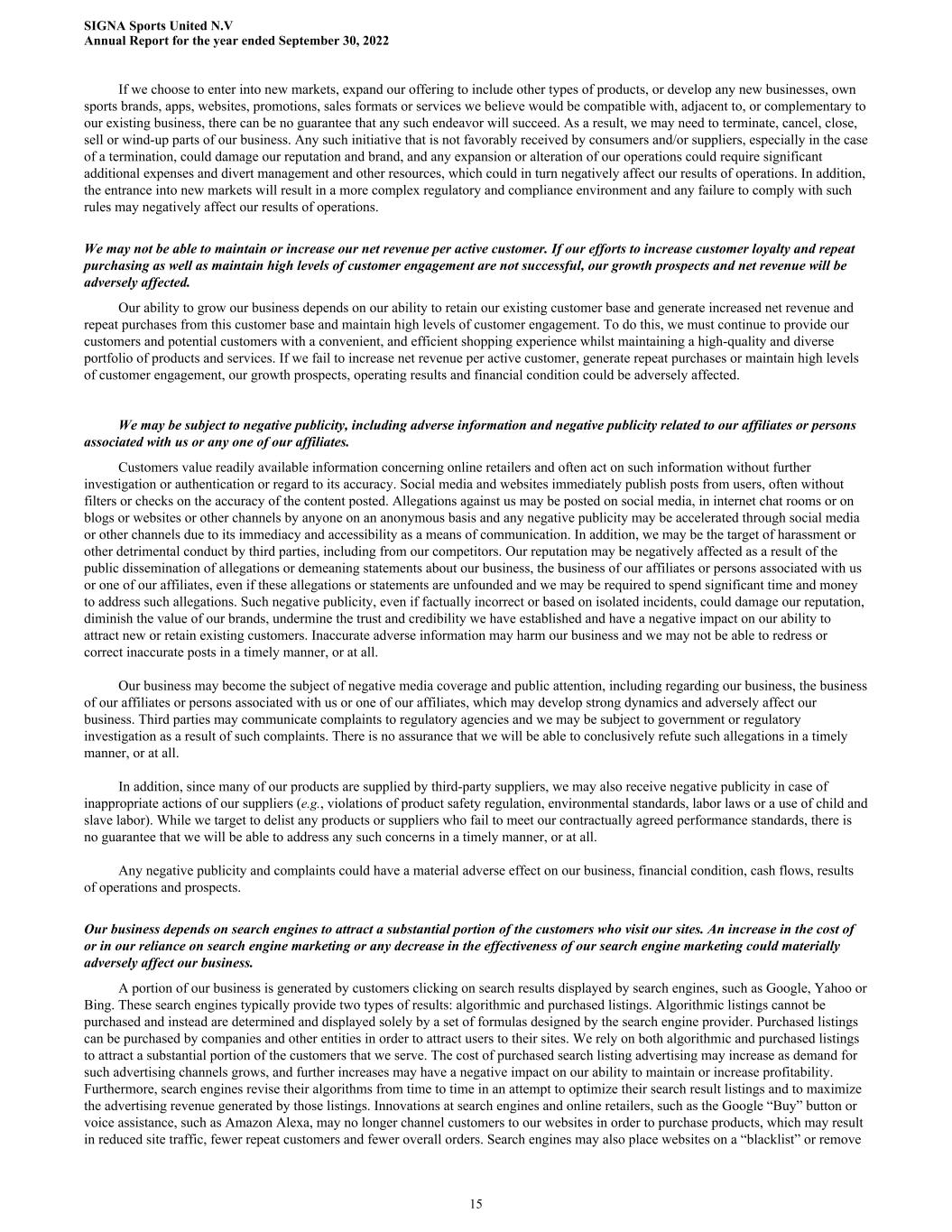
If we choose to enter into new markets, expand our offering to include other types of products, or develop any new businesses, own sports brands, apps, websites, promotions, sales formats or services we believe would be compatible with, adjacent to, or complementary to our existing business, there can be no guarantee that any such endeavor will succeed. As a result, we may need to terminate, cancel, close, sell or wind-up parts of our business. Any such initiative that is not favorably received by consumers and/or suppliers, especially in the case of a termination, could damage our reputation and brand, and any expansion or alteration of our operations could require significant additional expenses and divert management and other resources, which could in turn negatively affect our results of operations. In addition, the entrance into new markets will result in a more complex regulatory and compliance environment and any failure to comply with such rules may negatively affect our results of operations. We may not be able to maintain or increase our net revenue per active customer. If our efforts to increase customer loyalty and repeat purchasing as well as maintain high levels of customer engagement are not successful, our growth prospects and net revenue will be adversely affected. Our ability to grow our business depends on our ability to retain our existing customer base and generate increased net revenue and repeat purchases from this customer base and maintain high levels of customer engagement. To do this, we must continue to provide our customers and potential customers with a convenient, and efficient shopping experience whilst maintaining a high-quality and diverse portfolio of products and services. If we fail to increase net revenue per active customer, generate repeat purchases or maintain high levels of customer engagement, our growth prospects, operating results and financial condition could be adversely affected. We may be subject to negative publicity, including adverse information and negative publicity related to our affiliates or persons associated with us or any one of our affiliates. Customers value readily available information concerning online retailers and often act on such information without further investigation or authentication or regard to its accuracy. Social media and websites immediately publish posts from users, often without filters or checks on the accuracy of the content posted. Allegations against us may be posted on social media, in internet chat rooms or on blogs or websites or other channels by anyone on an anonymous basis and any negative publicity may be accelerated through social media or other channels due to its immediacy and accessibility as a means of communication. In addition, we may be the target of harassment or other detrimental conduct by third parties, including from our competitors. Our reputation may be negatively affected as a result of the public dissemination of allegations or demeaning statements about our business, the business of our affiliates or persons associated with us or one of our affiliates, even if these allegations or statements are unfounded and we may be required to spend significant time and money to address such allegations. Such negative publicity, even if factually incorrect or based on isolated incidents, could damage our reputation, diminish the value of our brands, undermine the trust and credibility we have established and have a negative impact on our ability to attract new or retain existing customers. Inaccurate adverse information may harm our business and we may not be able to redress or correct inaccurate posts in a timely manner, or at all. Our business may become the subject of negative media coverage and public attention, including regarding our business, the business of our affiliates or persons associated with us or one of our affiliates, which may develop strong dynamics and adversely affect our business. Third parties may communicate complaints to regulatory agencies and we may be subject to government or regulatory investigation as a result of such complaints. There is no assurance that we will be able to conclusively refute such allegations in a timely manner, or at all. In addition, since many of our products are supplied by third-party suppliers, we may also receive negative publicity in case of inappropriate actions of our suppliers (e.g., violations of product safety regulation, environmental standards, labor laws or a use of child and slave labor). While we target to delist any products or suppliers who fail to meet our contractually agreed performance standards, there is no guarantee that we will be able to address any such concerns in a timely manner, or at all. Any negative publicity and complaints could have a material adverse effect on our business, financial condition, cash flows, results of operations and prospects. Our business depends on search engines to attract a substantial portion of the customers who visit our sites. An increase in the cost of or in our reliance on search engine marketing or any decrease in the effectiveness of our search engine marketing could materially adversely affect our business. A portion of our business is generated by customers clicking on search results displayed by search engines, such as Google, Yahoo or Bing. These search engines typically provide two types of results: algorithmic and purchased listings. Algorithmic listings cannot be purchased and instead are determined and displayed solely by a set of formulas designed by the search engine provider. Purchased listings can be purchased by companies and other entities in order to attract users to their sites. We rely on both algorithmic and purchased listings to attract a substantial portion of the customers that we serve. The cost of purchased search listing advertising may increase as demand for such advertising channels grows, and further increases may have a negative impact on our ability to maintain or increase profitability. Furthermore, search engines revise their algorithms from time to time in an attempt to optimize their search result listings and to maximize the advertising revenue generated by those listings. Innovations at search engines and online retailers, such as the Google “Buy” button or voice assistance, such as Amazon Alexa, may no longer channel customers to our websites in order to purchase products, which may result in reduced site traffic, fewer repeat customers and fewer overall orders. Search engines may also place websites on a “blacklist” or remove SIGNA Sports United N.V Annual Report for the year ended September 30, 2022 15
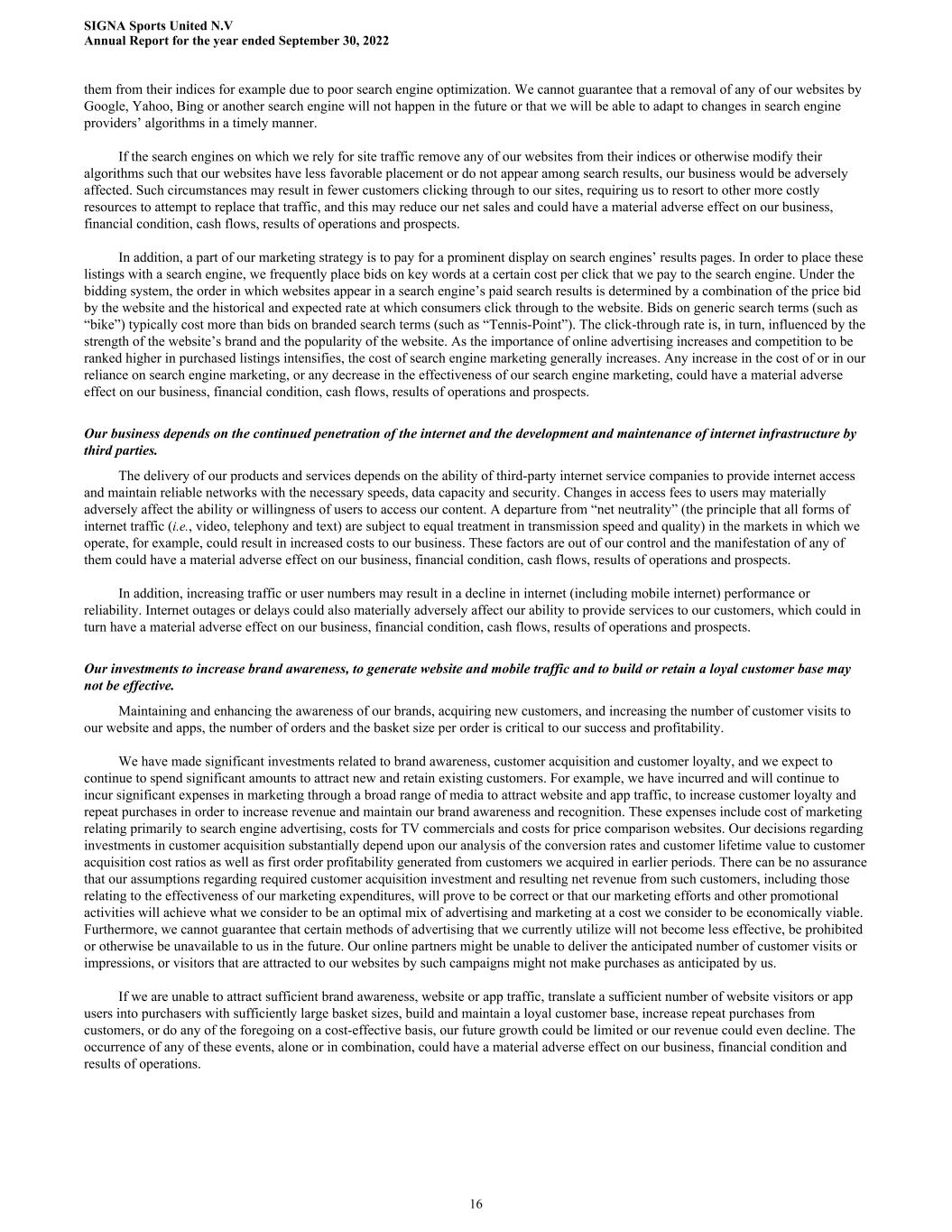
them from their indices for example due to poor search engine optimization. We cannot guarantee that a removal of any of our websites by Google, Yahoo, Bing or another search engine will not happen in the future or that we will be able to adapt to changes in search engine providers’ algorithms in a timely manner. If the search engines on which we rely for site traffic remove any of our websites from their indices or otherwise modify their algorithms such that our websites have less favorable placement or do not appear among search results, our business would be adversely affected. Such circumstances may result in fewer customers clicking through to our sites, requiring us to resort to other more costly resources to attempt to replace that traffic, and this may reduce our net sales and could have a material adverse effect on our business, financial condition, cash flows, results of operations and prospects. In addition, a part of our marketing strategy is to pay for a prominent display on search engines’ results pages. In order to place these listings with a search engine, we frequently place bids on key words at a certain cost per click that we pay to the search engine. Under the bidding system, the order in which websites appear in a search engine’s paid search results is determined by a combination of the price bid by the website and the historical and expected rate at which consumers click through to the website. Bids on generic search terms (such as “bike”) typically cost more than bids on branded search terms (such as “Tennis-Point”). The click-through rate is, in turn, influenced by the strength of the website’s brand and the popularity of the website. As the importance of online advertising increases and competition to be ranked higher in purchased listings intensifies, the cost of search engine marketing generally increases. Any increase in the cost of or in our reliance on search engine marketing, or any decrease in the effectiveness of our search engine marketing, could have a material adverse effect on our business, financial condition, cash flows, results of operations and prospects. Our business depends on the continued penetration of the internet and the development and maintenance of internet infrastructure by third parties. The delivery of our products and services depends on the ability of third-party internet service companies to provide internet access and maintain reliable networks with the necessary speeds, data capacity and security. Changes in access fees to users may materially adversely affect the ability or willingness of users to access our content. A departure from “net neutrality” (the principle that all forms of internet traffic (i.e., video, telephony and text) are subject to equal treatment in transmission speed and quality) in the markets in which we operate, for example, could result in increased costs to our business. These factors are out of our control and the manifestation of any of them could have a material adverse effect on our business, financial condition, cash flows, results of operations and prospects. In addition, increasing traffic or user numbers may result in a decline in internet (including mobile internet) performance or reliability. Internet outages or delays could also materially adversely affect our ability to provide services to our customers, which could in turn have a material adverse effect on our business, financial condition, cash flows, results of operations and prospects. Our investments to increase brand awareness, to generate website and mobile traffic and to build or retain a loyal customer base may not be effective. Maintaining and enhancing the awareness of our brands, acquiring new customers, and increasing the number of customer visits to our website and apps, the number of orders and the basket size per order is critical to our success and profitability. We have made significant investments related to brand awareness, customer acquisition and customer loyalty, and we expect to continue to spend significant amounts to attract new and retain existing customers. For example, we have incurred and will continue to incur significant expenses in marketing through a broad range of media to attract website and app traffic, to increase customer loyalty and repeat purchases in order to increase revenue and maintain our brand awareness and recognition. These expenses include cost of marketing relating primarily to search engine advertising, costs for TV commercials and costs for price comparison websites. Our decisions regarding investments in customer acquisition substantially depend upon our analysis of the conversion rates and customer lifetime value to customer acquisition cost ratios as well as first order profitability generated from customers we acquired in earlier periods. There can be no assurance that our assumptions regarding required customer acquisition investment and resulting net revenue from such customers, including those relating to the effectiveness of our marketing expenditures, will prove to be correct or that our marketing efforts and other promotional activities will achieve what we consider to be an optimal mix of advertising and marketing at a cost we consider to be economically viable. Furthermore, we cannot guarantee that certain methods of advertising that we currently utilize will not become less effective, be prohibited or otherwise be unavailable to us in the future. Our online partners might be unable to deliver the anticipated number of customer visits or impressions, or visitors that are attracted to our websites by such campaigns might not make purchases as anticipated by us. If we are unable to attract sufficient brand awareness, website or app traffic, translate a sufficient number of website visitors or app users into purchasers with sufficiently large basket sizes, build and maintain a loyal customer base, increase repeat purchases from customers, or do any of the foregoing on a cost-effective basis, our future growth could be limited or our revenue could even decline. The occurrence of any of these events, alone or in combination, could have a material adverse effect on our business, financial condition and results of operations. SIGNA Sports United N.V Annual Report for the year ended September 30, 2022 16
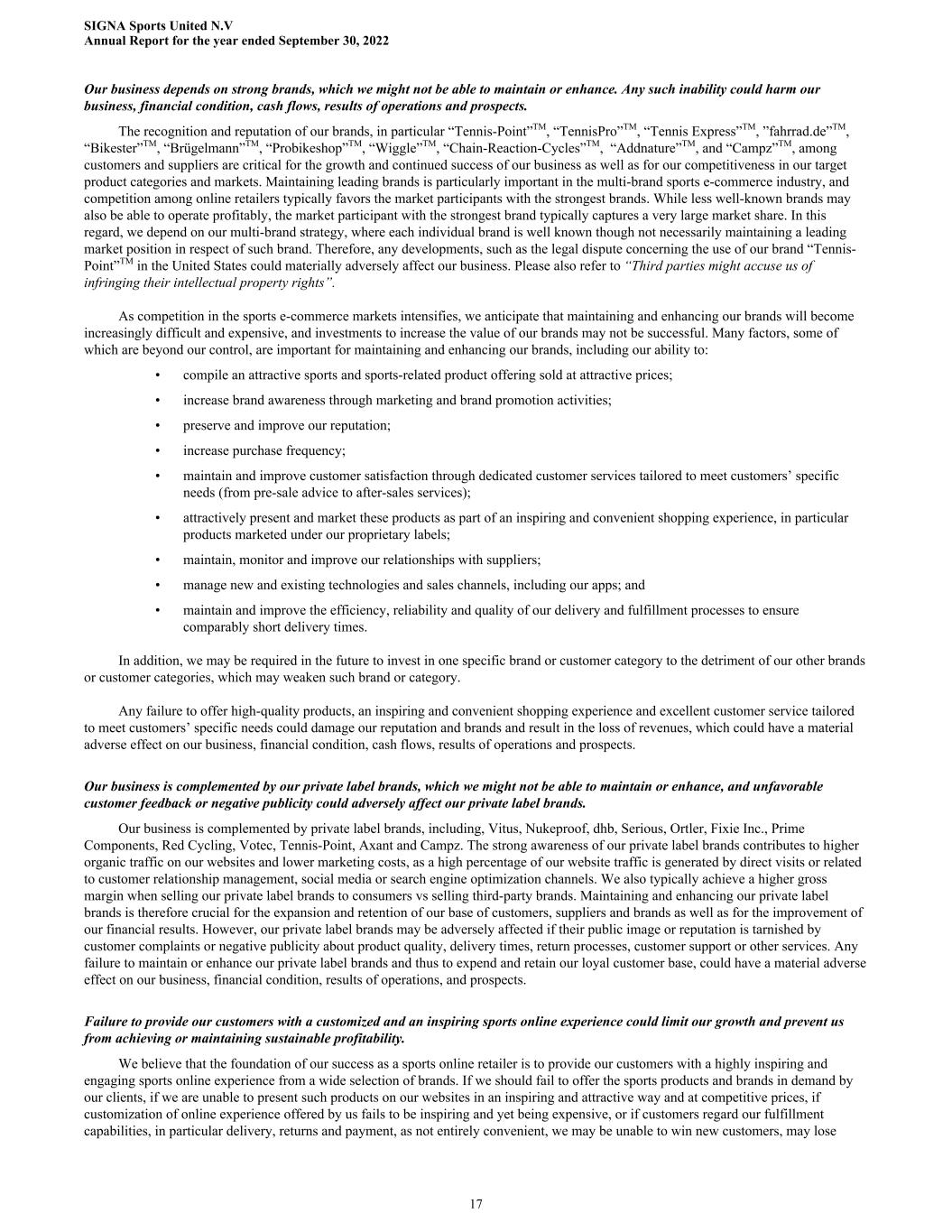
Our business depends on strong brands, which we might not be able to maintain or enhance. Any such inability could harm our business, financial condition, cash flows, results of operations and prospects. The recognition and reputation of our brands, in particular “Tennis-Point”TM, “TennisPro”TM, “Tennis Express”TM, ”fahrrad.de”TM, “Bikester”TM, “Brügelmann”TM, “Probikeshop”TM, “Wiggle”TM, “Chain-Reaction-Cycles”TM, “Addnature”TM, and “Campz”TM, among customers and suppliers are critical for the growth and continued success of our business as well as for our competitiveness in our target product categories and markets. Maintaining leading brands is particularly important in the multi-brand sports e-commerce industry, and competition among online retailers typically favors the market participants with the strongest brands. While less well-known brands may also be able to operate profitably, the market participant with the strongest brand typically captures a very large market share. In this regard, we depend on our multi-brand strategy, where each individual brand is well known though not necessarily maintaining a leading market position in respect of such brand. Therefore, any developments, such as the legal dispute concerning the use of our brand “Tennis- Point”TM in the United States could materially adversely affect our business. Please also refer to “Third parties might accuse us of infringing their intellectual property rights”. As competition in the sports e-commerce markets intensifies, we anticipate that maintaining and enhancing our brands will become increasingly difficult and expensive, and investments to increase the value of our brands may not be successful. Many factors, some of which are beyond our control, are important for maintaining and enhancing our brands, including our ability to: • compile an attractive sports and sports-related product offering sold at attractive prices; • increase brand awareness through marketing and brand promotion activities; • preserve and improve our reputation; • increase purchase frequency; • maintain and improve customer satisfaction through dedicated customer services tailored to meet customers’ specific needs (from pre-sale advice to after-sales services); • attractively present and market these products as part of an inspiring and convenient shopping experience, in particular products marketed under our proprietary labels; • maintain, monitor and improve our relationships with suppliers; • manage new and existing technologies and sales channels, including our apps; and • maintain and improve the efficiency, reliability and quality of our delivery and fulfillment processes to ensure comparably short delivery times. In addition, we may be required in the future to invest in one specific brand or customer category to the detriment of our other brands or customer categories, which may weaken such brand or category. Any failure to offer high-quality products, an inspiring and convenient shopping experience and excellent customer service tailored to meet customers’ specific needs could damage our reputation and brands and result in the loss of revenues, which could have a material adverse effect on our business, financial condition, cash flows, results of operations and prospects. Our business is complemented by our private label brands, which we might not be able to maintain or enhance, and unfavorable customer feedback or negative publicity could adversely affect our private label brands. Our business is complemented by private label brands, including, Vitus, Nukeproof, dhb, Serious, Ortler, Fixie Inc., Prime Components, Red Cycling, Votec, Tennis-Point, Axant and Campz. The strong awareness of our private label brands contributes to higher organic traffic on our websites and lower marketing costs, as a high percentage of our website traffic is generated by direct visits or related to customer relationship management, social media or search engine optimization channels. We also typically achieve a higher gross margin when selling our private label brands to consumers vs selling third-party brands. Maintaining and enhancing our private label brands is therefore crucial for the expansion and retention of our base of customers, suppliers and brands as well as for the improvement of our financial results. However, our private label brands may be adversely affected if their public image or reputation is tarnished by customer complaints or negative publicity about product quality, delivery times, return processes, customer support or other services. Any failure to maintain or enhance our private label brands and thus to expend and retain our loyal customer base, could have a material adverse effect on our business, financial condition, results of operations, and prospects. Failure to provide our customers with a customized and an inspiring sports online experience could limit our growth and prevent us from achieving or maintaining sustainable profitability. We believe that the foundation of our success as a sports online retailer is to provide our customers with a highly inspiring and engaging sports online experience from a wide selection of brands. If we should fail to offer the sports products and brands in demand by our clients, if we are unable to present such products on our websites in an inspiring and attractive way and at competitive prices, if customization of online experience offered by us fails to be inspiring and yet being expensive, or if customers regard our fulfillment capabilities, in particular delivery, returns and payment, as not entirely convenient, we may be unable to win new customers, may lose SIGNA Sports United N.V Annual Report for the year ended September 30, 2022 17
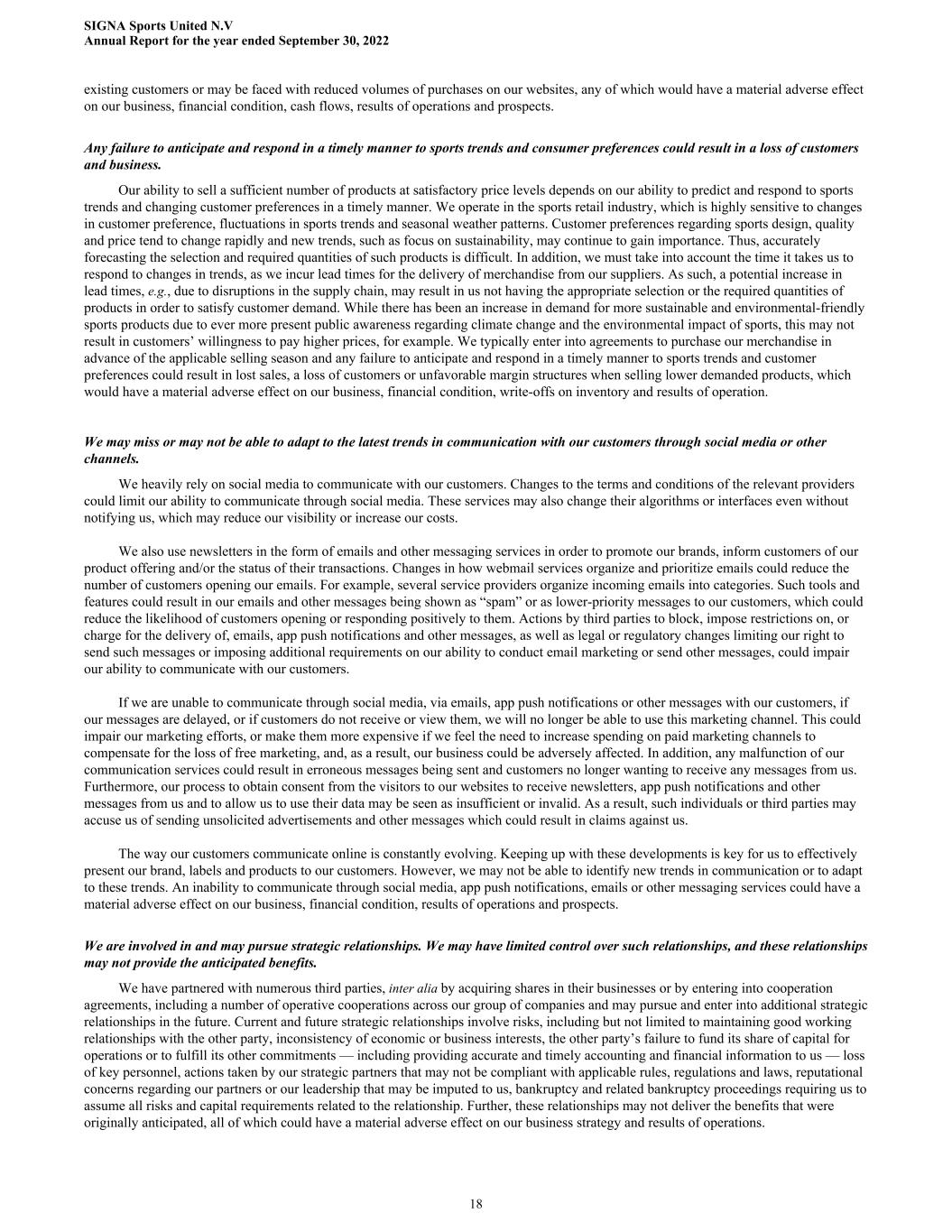
existing customers or may be faced with reduced volumes of purchases on our websites, any of which would have a material adverse effect on our business, financial condition, cash flows, results of operations and prospects. Any failure to anticipate and respond in a timely manner to sports trends and consumer preferences could result in a loss of customers and business. Our ability to sell a sufficient number of products at satisfactory price levels depends on our ability to predict and respond to sports trends and changing customer preferences in a timely manner. We operate in the sports retail industry, which is highly sensitive to changes in customer preference, fluctuations in sports trends and seasonal weather patterns. Customer preferences regarding sports design, quality and price tend to change rapidly and new trends, such as focus on sustainability, may continue to gain importance. Thus, accurately forecasting the selection and required quantities of such products is difficult. In addition, we must take into account the time it takes us to respond to changes in trends, as we incur lead times for the delivery of merchandise from our suppliers. As such, a potential increase in lead times, e.g., due to disruptions in the supply chain, may result in us not having the appropriate selection or the required quantities of products in order to satisfy customer demand. While there has been an increase in demand for more sustainable and environmental-friendly sports products due to ever more present public awareness regarding climate change and the environmental impact of sports, this may not result in customers’ willingness to pay higher prices, for example. We typically enter into agreements to purchase our merchandise in advance of the applicable selling season and any failure to anticipate and respond in a timely manner to sports trends and customer preferences could result in lost sales, a loss of customers or unfavorable margin structures when selling lower demanded products, which would have a material adverse effect on our business, financial condition, write-offs on inventory and results of operation. We may miss or may not be able to adapt to the latest trends in communication with our customers through social media or other channels. We heavily rely on social media to communicate with our customers. Changes to the terms and conditions of the relevant providers could limit our ability to communicate through social media. These services may also change their algorithms or interfaces even without notifying us, which may reduce our visibility or increase our costs. We also use newsletters in the form of emails and other messaging services in order to promote our brands, inform customers of our product offering and/or the status of their transactions. Changes in how webmail services organize and prioritize emails could reduce the number of customers opening our emails. For example, several service providers organize incoming emails into categories. Such tools and features could result in our emails and other messages being shown as “spam” or as lower-priority messages to our customers, which could reduce the likelihood of customers opening or responding positively to them. Actions by third parties to block, impose restrictions on, or charge for the delivery of, emails, app push notifications and other messages, as well as legal or regulatory changes limiting our right to send such messages or imposing additional requirements on our ability to conduct email marketing or send other messages, could impair our ability to communicate with our customers. If we are unable to communicate through social media, via emails, app push notifications or other messages with our customers, if our messages are delayed, or if customers do not receive or view them, we will no longer be able to use this marketing channel. This could impair our marketing efforts, or make them more expensive if we feel the need to increase spending on paid marketing channels to compensate for the loss of free marketing, and, as a result, our business could be adversely affected. In addition, any malfunction of our communication services could result in erroneous messages being sent and customers no longer wanting to receive any messages from us. Furthermore, our process to obtain consent from the visitors to our websites to receive newsletters, app push notifications and other messages from us and to allow us to use their data may be seen as insufficient or invalid. As a result, such individuals or third parties may accuse us of sending unsolicited advertisements and other messages which could result in claims against us. The way our customers communicate online is constantly evolving. Keeping up with these developments is key for us to effectively present our brand, labels and products to our customers. However, we may not be able to identify new trends in communication or to adapt to these trends. An inability to communicate through social media, app push notifications, emails or other messaging services could have a material adverse effect on our business, financial condition, results of operations and prospects. We are involved in and may pursue strategic relationships. We may have limited control over such relationships, and these relationships may not provide the anticipated benefits. We have partnered with numerous third parties, inter alia by acquiring shares in their businesses or by entering into cooperation agreements, including a number of operative cooperations across our group of companies and may pursue and enter into additional strategic relationships in the future. Current and future strategic relationships involve risks, including but not limited to maintaining good working relationships with the other party, inconsistency of economic or business interests, the other party’s failure to fund its share of capital for operations or to fulfill its other commitments — including providing accurate and timely accounting and financial information to us — loss of key personnel, actions taken by our strategic partners that may not be compliant with applicable rules, regulations and laws, reputational concerns regarding our partners or our leadership that may be imputed to us, bankruptcy and related bankruptcy proceedings requiring us to assume all risks and capital requirements related to the relationship. Further, these relationships may not deliver the benefits that were originally anticipated, all of which could have a material adverse effect on our business strategy and results of operations. SIGNA Sports United N.V Annual Report for the year ended September 30, 2022 18
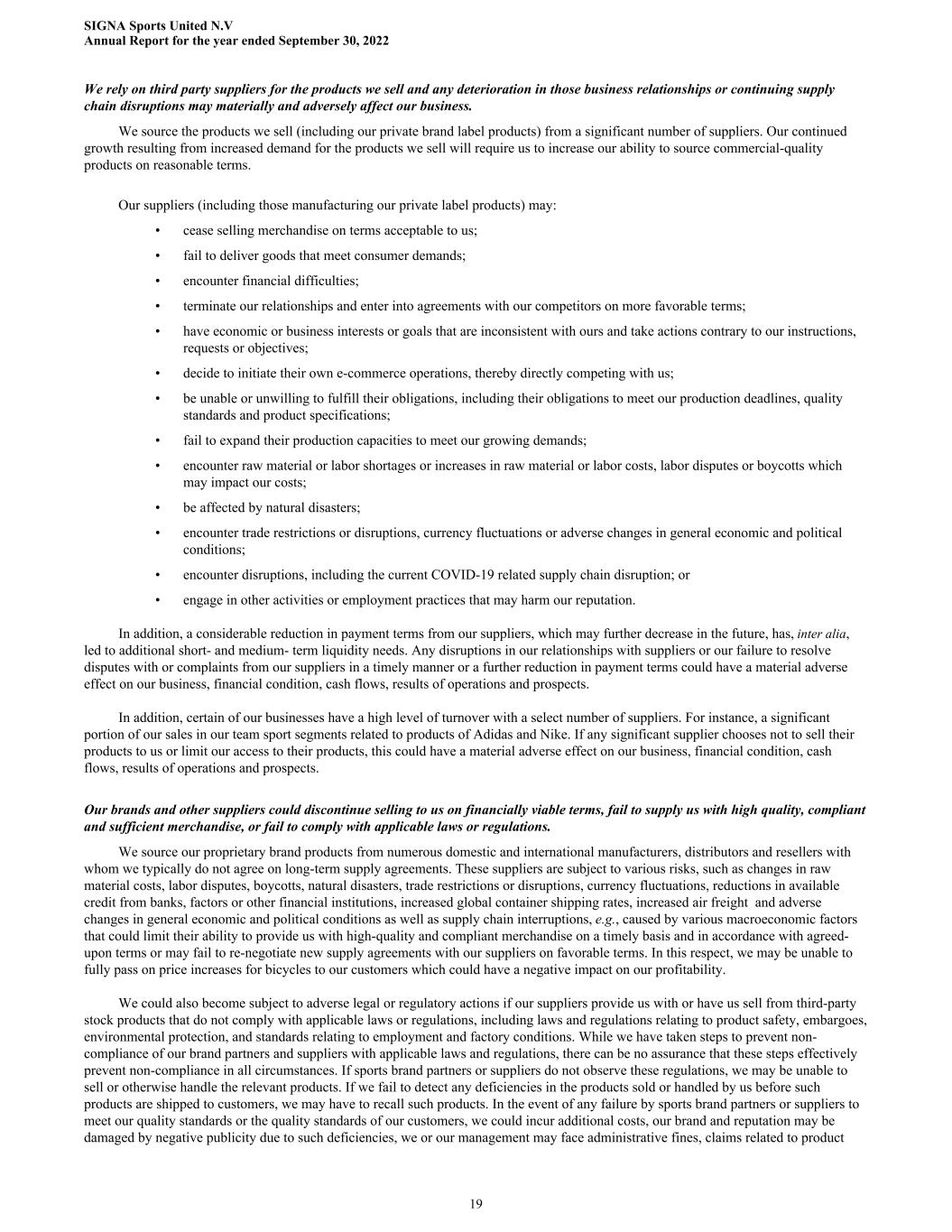
We rely on third party suppliers for the products we sell and any deterioration in those business relationships or continuing supply chain disruptions may materially and adversely affect our business. We source the products we sell (including our private brand label products) from a significant number of suppliers. Our continued growth resulting from increased demand for the products we sell will require us to increase our ability to source commercial-quality products on reasonable terms. Our suppliers (including those manufacturing our private label products) may: • cease selling merchandise on terms acceptable to us; • fail to deliver goods that meet consumer demands; • encounter financial difficulties; • terminate our relationships and enter into agreements with our competitors on more favorable terms; • have economic or business interests or goals that are inconsistent with ours and take actions contrary to our instructions, requests or objectives; • decide to initiate their own e-commerce operations, thereby directly competing with us; • be unable or unwilling to fulfill their obligations, including their obligations to meet our production deadlines, quality standards and product specifications; • fail to expand their production capacities to meet our growing demands; • encounter raw material or labor shortages or increases in raw material or labor costs, labor disputes or boycotts which may impact our costs; • be affected by natural disasters; • encounter trade restrictions or disruptions, currency fluctuations or adverse changes in general economic and political conditions; • encounter disruptions, including the current COVID-19 related supply chain disruption; or • engage in other activities or employment practices that may harm our reputation. In addition, a considerable reduction in payment terms from our suppliers, which may further decrease in the future, has, inter alia, led to additional short- and medium- term liquidity needs. Any disruptions in our relationships with suppliers or our failure to resolve disputes with or complaints from our suppliers in a timely manner or a further reduction in payment terms could have a material adverse effect on our business, financial condition, cash flows, results of operations and prospects. In addition, certain of our businesses have a high level of turnover with a select number of suppliers. For instance, a significant portion of our sales in our team sport segments related to products of Adidas and Nike. If any significant supplier chooses not to sell their products to us or limit our access to their products, this could have a material adverse effect on our business, financial condition, cash flows, results of operations and prospects. Our brands and other suppliers could discontinue selling to us on financially viable terms, fail to supply us with high quality, compliant and sufficient merchandise, or fail to comply with applicable laws or regulations. We source our proprietary brand products from numerous domestic and international manufacturers, distributors and resellers with whom we typically do not agree on long-term supply agreements. These suppliers are subject to various risks, such as changes in raw material costs, labor disputes, boycotts, natural disasters, trade restrictions or disruptions, currency fluctuations, reductions in available credit from banks, factors or other financial institutions, increased global container shipping rates, increased air freight and adverse changes in general economic and political conditions as well as supply chain interruptions, e.g., caused by various macroeconomic factors that could limit their ability to provide us with high-quality and compliant merchandise on a timely basis and in accordance with agreed- upon terms or may fail to re-negotiate new supply agreements with our suppliers on favorable terms. In this respect, we may be unable to fully pass on price increases for bicycles to our customers which could have a negative impact on our profitability. We could also become subject to adverse legal or regulatory actions if our suppliers provide us with or have us sell from third-party stock products that do not comply with applicable laws or regulations, including laws and regulations relating to product safety, embargoes, environmental protection, and standards relating to employment and factory conditions. While we have taken steps to prevent non- compliance of our brand partners and suppliers with applicable laws and regulations, there can be no assurance that these steps effectively prevent non-compliance in all circumstances. If sports brand partners or suppliers do not observe these regulations, we may be unable to sell or otherwise handle the relevant products. If we fail to detect any deficiencies in the products sold or handled by us before such products are shipped to customers, we may have to recall such products. In the event of any failure by sports brand partners or suppliers to meet our quality standards or the quality standards of our customers, we could incur additional costs, our brand and reputation may be damaged by negative publicity due to such deficiencies, we or our management may face administrative fines, claims related to product SIGNA Sports United N.V Annual Report for the year ended September 30, 2022 19
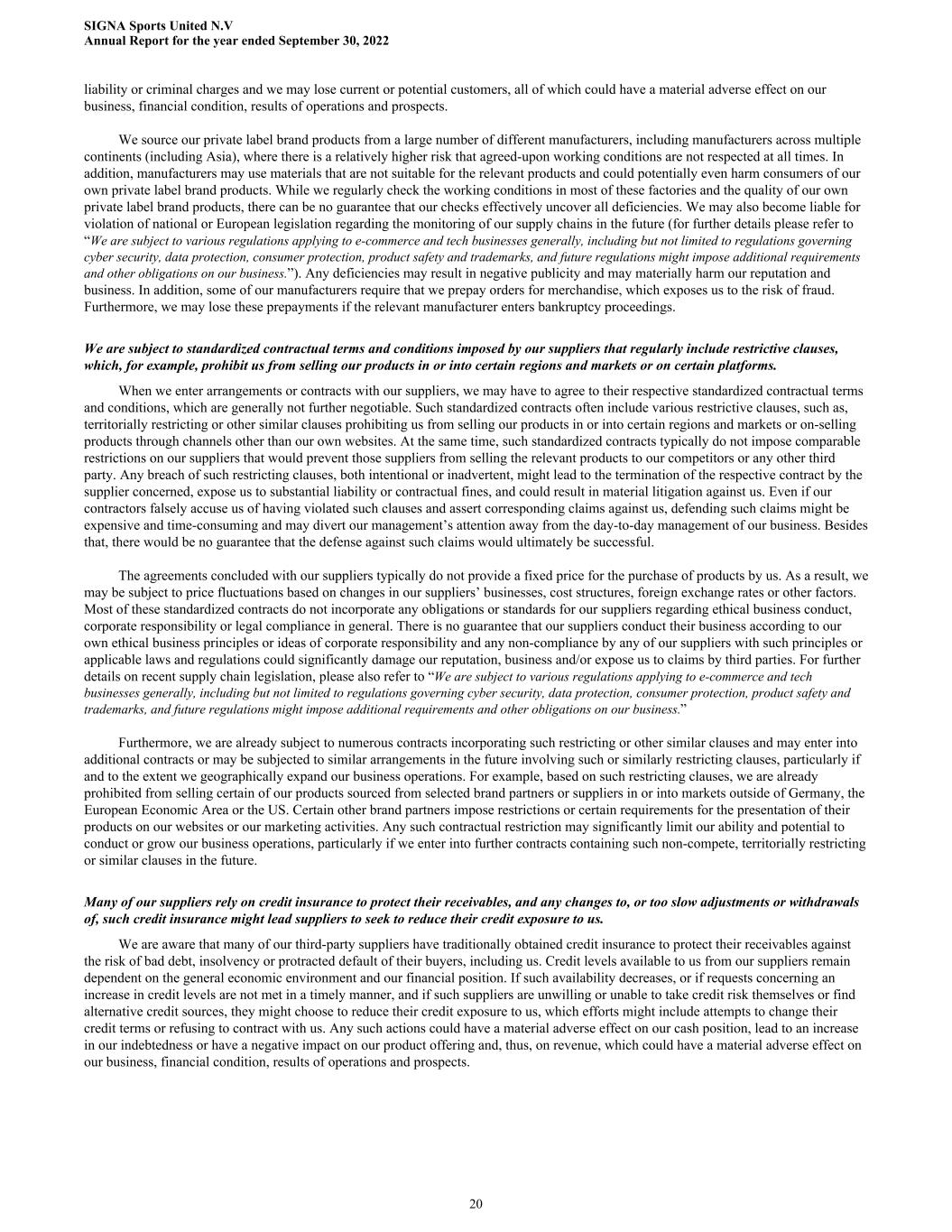
liability or criminal charges and we may lose current or potential customers, all of which could have a material adverse effect on our business, financial condition, results of operations and prospects. We source our private label brand products from a large number of different manufacturers, including manufacturers across multiple continents (including Asia), where there is a relatively higher risk that agreed-upon working conditions are not respected at all times. In addition, manufacturers may use materials that are not suitable for the relevant products and could potentially even harm consumers of our own private label brand products. While we regularly check the working conditions in most of these factories and the quality of our own private label brand products, there can be no guarantee that our checks effectively uncover all deficiencies. We may also become liable for violation of national or European legislation regarding the monitoring of our supply chains in the future (for further details please refer to “We are subject to various regulations applying to e-commerce and tech businesses generally, including but not limited to regulations governing cyber security, data protection, consumer protection, product safety and trademarks, and future regulations might impose additional requirements and other obligations on our business.”). Any deficiencies may result in negative publicity and may materially harm our reputation and business. In addition, some of our manufacturers require that we prepay orders for merchandise, which exposes us to the risk of fraud. Furthermore, we may lose these prepayments if the relevant manufacturer enters bankruptcy proceedings. We are subject to standardized contractual terms and conditions imposed by our suppliers that regularly include restrictive clauses, which, for example, prohibit us from selling our products in or into certain regions and markets or on certain platforms. When we enter arrangements or contracts with our suppliers, we may have to agree to their respective standardized contractual terms and conditions, which are generally not further negotiable. Such standardized contracts often include various restrictive clauses, such as, territorially restricting or other similar clauses prohibiting us from selling our products in or into certain regions and markets or on-selling products through channels other than our own websites. At the same time, such standardized contracts typically do not impose comparable restrictions on our suppliers that would prevent those suppliers from selling the relevant products to our competitors or any other third party. Any breach of such restricting clauses, both intentional or inadvertent, might lead to the termination of the respective contract by the supplier concerned, expose us to substantial liability or contractual fines, and could result in material litigation against us. Even if our contractors falsely accuse us of having violated such clauses and assert corresponding claims against us, defending such claims might be expensive and time-consuming and may divert our management’s attention away from the day-to-day management of our business. Besides that, there would be no guarantee that the defense against such claims would ultimately be successful. The agreements concluded with our suppliers typically do not provide a fixed price for the purchase of products by us. As a result, we may be subject to price fluctuations based on changes in our suppliers’ businesses, cost structures, foreign exchange rates or other factors. Most of these standardized contracts do not incorporate any obligations or standards for our suppliers regarding ethical business conduct, corporate responsibility or legal compliance in general. There is no guarantee that our suppliers conduct their business according to our own ethical business principles or ideas of corporate responsibility and any non-compliance by any of our suppliers with such principles or applicable laws and regulations could significantly damage our reputation, business and/or expose us to claims by third parties. For further details on recent supply chain legislation, please also refer to “We are subject to various regulations applying to e-commerce and tech businesses generally, including but not limited to regulations governing cyber security, data protection, consumer protection, product safety and trademarks, and future regulations might impose additional requirements and other obligations on our business.” Furthermore, we are already subject to numerous contracts incorporating such restricting or other similar clauses and may enter into additional contracts or may be subjected to similar arrangements in the future involving such or similarly restricting clauses, particularly if and to the extent we geographically expand our business operations. For example, based on such restricting clauses, we are already prohibited from selling certain of our products sourced from selected brand partners or suppliers in or into markets outside of Germany, the European Economic Area or the US. Certain other brand partners impose restrictions or certain requirements for the presentation of their products on our websites or our marketing activities. Any such contractual restriction may significantly limit our ability and potential to conduct or grow our business operations, particularly if we enter into further contracts containing such non-compete, territorially restricting or similar clauses in the future. Many of our suppliers rely on credit insurance to protect their receivables, and any changes to, or too slow adjustments or withdrawals of, such credit insurance might lead suppliers to seek to reduce their credit exposure to us. We are aware that many of our third-party suppliers have traditionally obtained credit insurance to protect their receivables against the risk of bad debt, insolvency or protracted default of their buyers, including us. Credit levels available to us from our suppliers remain dependent on the general economic environment and our financial position. If such availability decreases, or if requests concerning an increase in credit levels are not met in a timely manner, and if such suppliers are unwilling or unable to take credit risk themselves or find alternative credit sources, they might choose to reduce their credit exposure to us, which efforts might include attempts to change their credit terms or refusing to contract with us. Any such actions could have a material adverse effect on our cash position, lead to an increase in our indebtedness or have a negative impact on our product offering and, thus, on revenue, which could have a material adverse effect on our business, financial condition, results of operations and prospects. SIGNA Sports United N.V Annual Report for the year ended September 30, 2022 20

Changes in customer return rates might increase our costs and harm our business. We have established return policies specific to our various local markets and verticals that permit our customers to return products within designated timeframes ranging from 30 to 100 days following delivery. Granting return rights is an important element for converting app and website visitors into customers, providing our customers with the certainty that they will only be required to pay for those products that they want to keep. We might experience a significant increase in returns — for example, due to customer dissatisfaction with our products or customer service, changes in customer behavior or the abuse of our liberal return policy by persons not actually willing to purchase our products. In this case there is no guarantee that we will be able to utilize returned goods in a cost-efficient manner — for example, by reselling them on our websites, selling them at third-party outlets or returning them to our suppliers. We incur costs associated with returned goods — for example, costs associated with return processing and delivery — but may not receive revenue from returns or proceeds from sales of returned goods may not cover all costs incurred. Thus, any increase in returns would increase our costs with no corresponding increase in revenue. Continued growth, in particular in case of an increase in market place sales, is likely to increase the absolute number of returns, which may force us to allocate additional resources to the handling of such returns and may further complicate our operations. Even though products that have not passed through our fulfillment centers, but are delivered via drop-shipping, contain a return label for that drop- shipping partner, we cannot guarantee that some packages are wrongly labeled and returned to us, which may require us to store such products for a certain amount of time and initiate the further return to our partner. Furthermore, any modification of our return policies may result in customer dissatisfaction or an increase in the number of returns, which could adversely affect our business. The broad variety of payment methods we accept exposes us to operational, regulatory and fraud risks. We currently accept a number of different payment methods tailored to meet our customers’ payment preferences. These payment methods include, among others, invoicing, credit and debit cards, PayPal, direct deposit, online bank transfer, direct debit, checks and gift cards. Due to the complexity of the broad variety of payment methods we accept, we face the risk of operational failures in our checkout process, which could adversely affect our conversion rate (i.e., the percentage of people visiting our websites that actually place an order) and customer satisfaction. There is also the risk that, in connection with the methods of payment we offer, we may become subject to additional regulations, compliance requirements, and various types of fraud or cyber-attacks. For certain payment methods, including credit and debit cards, we pay bank interchange and other fees. These fees may increase over time, increasing our operating costs and decreasing our profitability. We are also subject to operating rules and certification requirements of payment scheme associations, including the Payment Card Industry Data Security Standard and rules governing electronic funds transfers. Amendments to these rules or the introduction of new laws or requirements regarding any payment method we accept could result in increasing compliance costs, higher transaction fees, and the possible loss of or restrictions to our ability to accept credit or debit cards or other types of payment. We generally rely on third parties to provide payment processing services. We also rely on third-party payment processors, and encryption and authentication technology licensed from third parties, to securely transmit customers’ personal information. If these companies become unwilling or unable to provide these services, or increase their fees, such as bank and intermediary fees for credit card payments, our operations may be disrupted and our operating costs could increase. Furthermore, we face risks relating to customer claims that purchases or payments were not properly authorized or were transmitted in error, as well as risks that customers have insufficient funds and the risk of fraud. While fraud risks are mostly covered through our contracts with payment processing services, any failure to avoid or limit losses from fraudulent transactions could damage our reputation and result in increased legal expenses and fees. The materialization of any of the risks described above could have a material adverse effect on our business, financial condition, results of operations and prospects. We depend on third-party service providers for the fulfillment and distribution of our products to end customers. We depend on third-party logistics providers for the fulfillment and distribution of the products that our customers order online. Therefore, we have only limited control over the handling of our goods in the course of the fulfillment process, the timing of deliveries and the security of our products while they are being transported. There may be shipping delays due to, among other things, inclement weather, natural disasters, strikes, terrorism or restrictions related to the COVID-19 pandemic. We also face the risk that our products may be damaged or lost in transit — for example, in the course of sourcing from overseas. If these third-party providers terminate their contracts with us, we may not be able to find suitable alternatives on commercially acceptable terms, which could disrupt our services or increase our costs. Additionally, there can be no assurance that customers will not expect or demand faster delivery times than we can ensure in the future. If the products we sell are not delivered in a timely manner or are damaged or lost in transit, if we are not able to provide adequate customer support, or if our competitors are able to deliver the same or equivalent products faster or more conveniently, our customers could become dissatisfied and cease buying on our websites. SIGNA Sports United N.V Annual Report for the year ended September 30, 2022 21

In some of our markets, it may be difficult to replace the logistics providers with whom we cooperate due to a lack of alternative offerings at comparable price and/or service quality and we may not be able to substitute such third-party services with our own last-mile delivery service. Changes in shipping terms and costs, for example due to higher fuel or energy costs, or the inability or refusal of third- party logistics providers to deliver our products in a safe and timely manner could harm our reputation and have an adverse effect on our business. Additionally, any deterioration in the financial condition of any third-party service provider could have an adverse impact on the quality of our logistics processes and distribution costs. If third-party logistics providers were to increase their shipping costs and we continue to offer free delivery and returns, the increased shipping costs could have a material adverse effect on our business and financial condition. Any failure to successfully address our changing fulfillment and logistics capacity requirements could severely affect our business and prospects. The functioning of our online business depends to a large extent on our customers receiving the ordered goods in a timely and convenient manner and their ability to return them without any difficulties. To keep our customers satisfied we rely on a multi-national logistics infrastructure, consisting of both own, hybrid and third-party logistics infrastructure set-ups, including inbound receipt of items for sale, storage systems, packaging, outbound freight, and the receipt, screening and handling of returns. These processes are complex and depend on sophisticated know-how and computerized systems. We are therefore constantly monitoring and sourcing our fulfillment services and logistics capacity to keep up with those requirements and match our continued growth. It is, however, not certain that we will be able to find suitable service providers on commercially acceptable terms to support any future expansion plans. We might also need to increase our capital expenditures more than anticipated in order to increase the capacity of our own logistics infrastructure while at the same time, in other regions we may be forced to deal with excess capacities. Any failure in the required sourcing of fulfillment and logistics infrastructure as our business expands could materially impact our growth strategy. If we continue to add new businesses or categories with different logistical requirements, or change the mix in products that we sell, our logistics capacities will become increasingly complex and operating them will become even more challenging. Operational difficulties could result in shipping delays and customer dissatisfaction or cause our logistics costs to become high and uncompetitive. Any failure to successfully address such challenges in a cost-effective and timely manner could severely disrupt our business and harm our reputation. Our sourcing and logistics costs are subject to movements in the prices for raw materials and fuel as well as other factors beyond our control, and we may not be able to pass on price increases by our third-party services providers to our customers. Our sourcing and logistics costs depend on the development of prices for certain raw materials, in particular cotton and other textile raw materials, as well as fuel. In addition, our sourcing costs are also influenced by the capacity utilization rates at our suppliers, quantities demanded from our suppliers, and product specification. As a result, our costs of materials can vary materially in the short-term and, in cases of supply shortages, can increase significantly. We are typically impacted by increases in the prices of raw materials and fuel price as well as carrier-charge increases, as our suppliers and third-party service providers attempt to pass along these increases to us. Although we may attempt to pass on cost increases to our customers by increasing selling prices via regular price reviews, we may not always be able to do so. Moreover, any price increases could adversely affect our sales or reduce our profitability. During periods of declining input or fuel prices, customer demand may also require that we sell our products at lower prices or may restrict our ability to increase prices, in spite of the fact that we may use goods that were purchased at higher prices or that we are forced to incur higher shipping costs, thereby negatively impacting our margins. The volatility in our sourcing and logistics costs and our limited ability to pass them on to customers may adversely affect our business and financial condition. Dissatisfaction with our customer service could negatively affect our customer retention and the further implementation of our growth strategy. A satisfied and loyal customer base is crucial to our continued growth. A strong customer service is required to ensure that customer complaints are dealt with in a timely manner and to the customer’s satisfaction. Except with respect to our offline stores, we do not typically have direct face-to-face contact with customers which is afforded through offline retail, the way we directly interact with customers through our customer service team is crucial to maintaining continuous customer relationships. We respond to customer requests and inquiries through e-mail, chat functions, social media and our partly toll-free hotlines. Any actual or perceived failure or unsatisfactory response by our customer service could negatively affect customer satisfaction and loyalty. Our inability to retain customers due to a lack of satisfactory customer service could have a material adverse effect on the further implementation of our growth strategy. Our business is subject to operational and accident risks which may not be fully covered by our insurance. We are exposed to risks related to the health and safety of our employees and contractors as well as other workplace safety risks. For example, our distribution activities involve specific risks such as fire, falls from height, objects falling from storage shelving and during movement, or traffic movements which could result in damage to equipment, damage to the property of third parties and personal injury or death. Accidents or other incidents that occur at any of our shops or distribution facilities or involve our personnel or operations could result in claims for damages against us and could damage our reputation. If staff and contractors get injured during the course of their duties we may, among other things, face fines and penalties from regulators as well as damage to our reputation. SIGNA Sports United N.V Annual Report for the year ended September 30, 2022 22
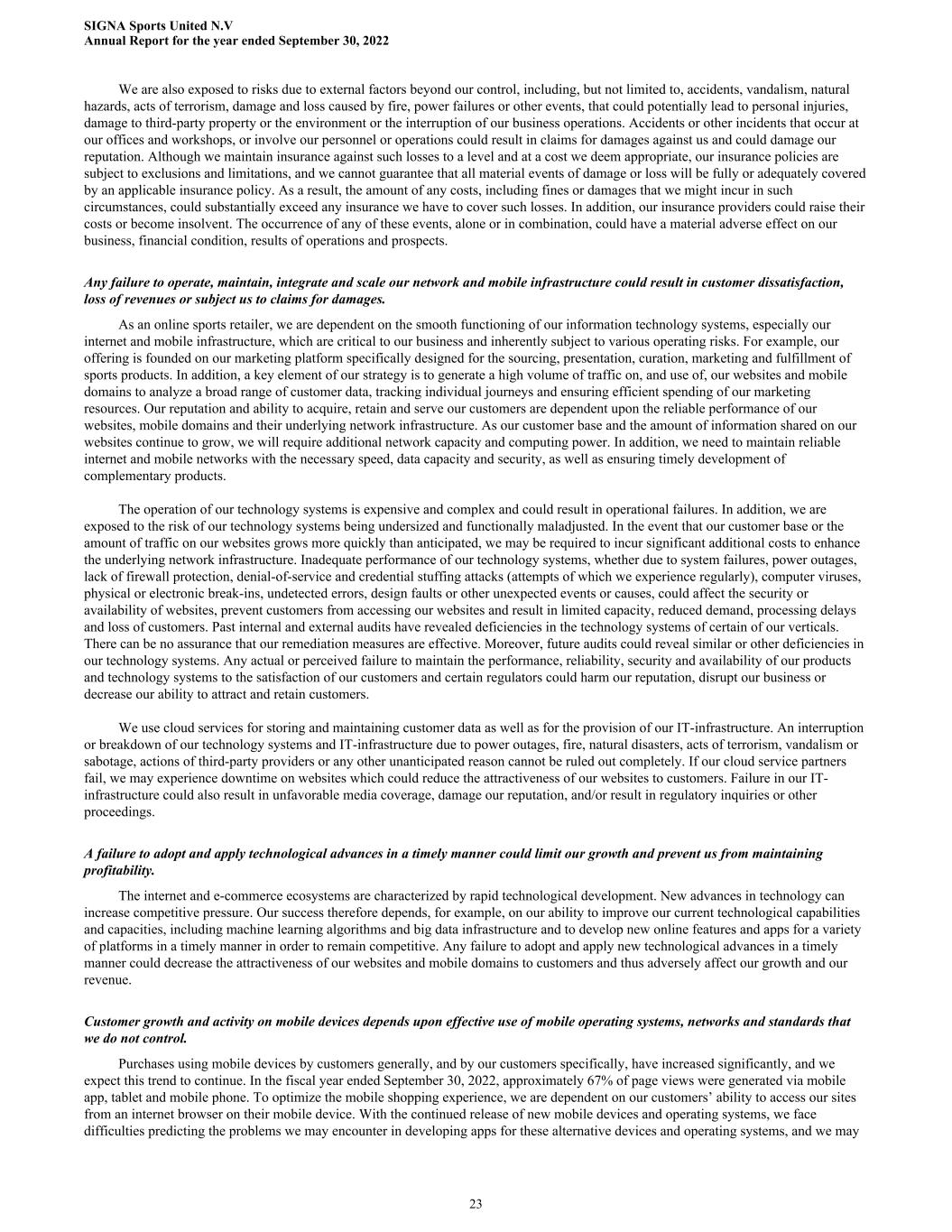
We are also exposed to risks due to external factors beyond our control, including, but not limited to, accidents, vandalism, natural hazards, acts of terrorism, damage and loss caused by fire, power failures or other events, that could potentially lead to personal injuries, damage to third-party property or the environment or the interruption of our business operations. Accidents or other incidents that occur at our offices and workshops, or involve our personnel or operations could result in claims for damages against us and could damage our reputation. Although we maintain insurance against such losses to a level and at a cost we deem appropriate, our insurance policies are subject to exclusions and limitations, and we cannot guarantee that all material events of damage or loss will be fully or adequately covered by an applicable insurance policy. As a result, the amount of any costs, including fines or damages that we might incur in such circumstances, could substantially exceed any insurance we have to cover such losses. In addition, our insurance providers could raise their costs or become insolvent. The occurrence of any of these events, alone or in combination, could have a material adverse effect on our business, financial condition, results of operations and prospects. Any failure to operate, maintain, integrate and scale our network and mobile infrastructure could result in customer dissatisfaction, loss of revenues or subject us to claims for damages. As an online sports retailer, we are dependent on the smooth functioning of our information technology systems, especially our internet and mobile infrastructure, which are critical to our business and inherently subject to various operating risks. For example, our offering is founded on our marketing platform specifically designed for the sourcing, presentation, curation, marketing and fulfillment of sports products. In addition, a key element of our strategy is to generate a high volume of traffic on, and use of, our websites and mobile domains to analyze a broad range of customer data, tracking individual journeys and ensuring efficient spending of our marketing resources. Our reputation and ability to acquire, retain and serve our customers are dependent upon the reliable performance of our websites, mobile domains and their underlying network infrastructure. As our customer base and the amount of information shared on our websites continue to grow, we will require additional network capacity and computing power. In addition, we need to maintain reliable internet and mobile networks with the necessary speed, data capacity and security, as well as ensuring timely development of complementary products. The operation of our technology systems is expensive and complex and could result in operational failures. In addition, we are exposed to the risk of our technology systems being undersized and functionally maladjusted. In the event that our customer base or the amount of traffic on our websites grows more quickly than anticipated, we may be required to incur significant additional costs to enhance the underlying network infrastructure. Inadequate performance of our technology systems, whether due to system failures, power outages, lack of firewall protection, denial-of-service and credential stuffing attacks (attempts of which we experience regularly), computer viruses, physical or electronic break-ins, undetected errors, design faults or other unexpected events or causes, could affect the security or availability of websites, prevent customers from accessing our websites and result in limited capacity, reduced demand, processing delays and loss of customers. Past internal and external audits have revealed deficiencies in the technology systems of certain of our verticals. There can be no assurance that our remediation measures are effective. Moreover, future audits could reveal similar or other deficiencies in our technology systems. Any actual or perceived failure to maintain the performance, reliability, security and availability of our products and technology systems to the satisfaction of our customers and certain regulators could harm our reputation, disrupt our business or decrease our ability to attract and retain customers. We use cloud services for storing and maintaining customer data as well as for the provision of our IT-infrastructure. An interruption or breakdown of our technology systems and IT-infrastructure due to power outages, fire, natural disasters, acts of terrorism, vandalism or sabotage, actions of third-party providers or any other unanticipated reason cannot be ruled out completely. If our cloud service partners fail, we may experience downtime on websites which could reduce the attractiveness of our websites to customers. Failure in our IT- infrastructure could also result in unfavorable media coverage, damage our reputation, and/or result in regulatory inquiries or other proceedings. A failure to adopt and apply technological advances in a timely manner could limit our growth and prevent us from maintaining profitability. The internet and e-commerce ecosystems are characterized by rapid technological development. New advances in technology can increase competitive pressure. Our success therefore depends, for example, on our ability to improve our current technological capabilities and capacities, including machine learning algorithms and big data infrastructure and to develop new online features and apps for a variety of platforms in a timely manner in order to remain competitive. Any failure to adopt and apply new technological advances in a timely manner could decrease the attractiveness of our websites and mobile domains to customers and thus adversely affect our growth and our revenue. Customer growth and activity on mobile devices depends upon effective use of mobile operating systems, networks and standards that we do not control. Purchases using mobile devices by customers generally, and by our customers specifically, have increased significantly, and we expect this trend to continue. In the fiscal year ended September 30, 2022, approximately 67% of page views were generated via mobile app, tablet and mobile phone. To optimize the mobile shopping experience, we are dependent on our customers’ ability to access our sites from an internet browser on their mobile device. With the continued release of new mobile devices and operating systems, we face difficulties predicting the problems we may encounter in developing apps for these alternative devices and operating systems, and we may SIGNA Sports United N.V Annual Report for the year ended September 30, 2022 23
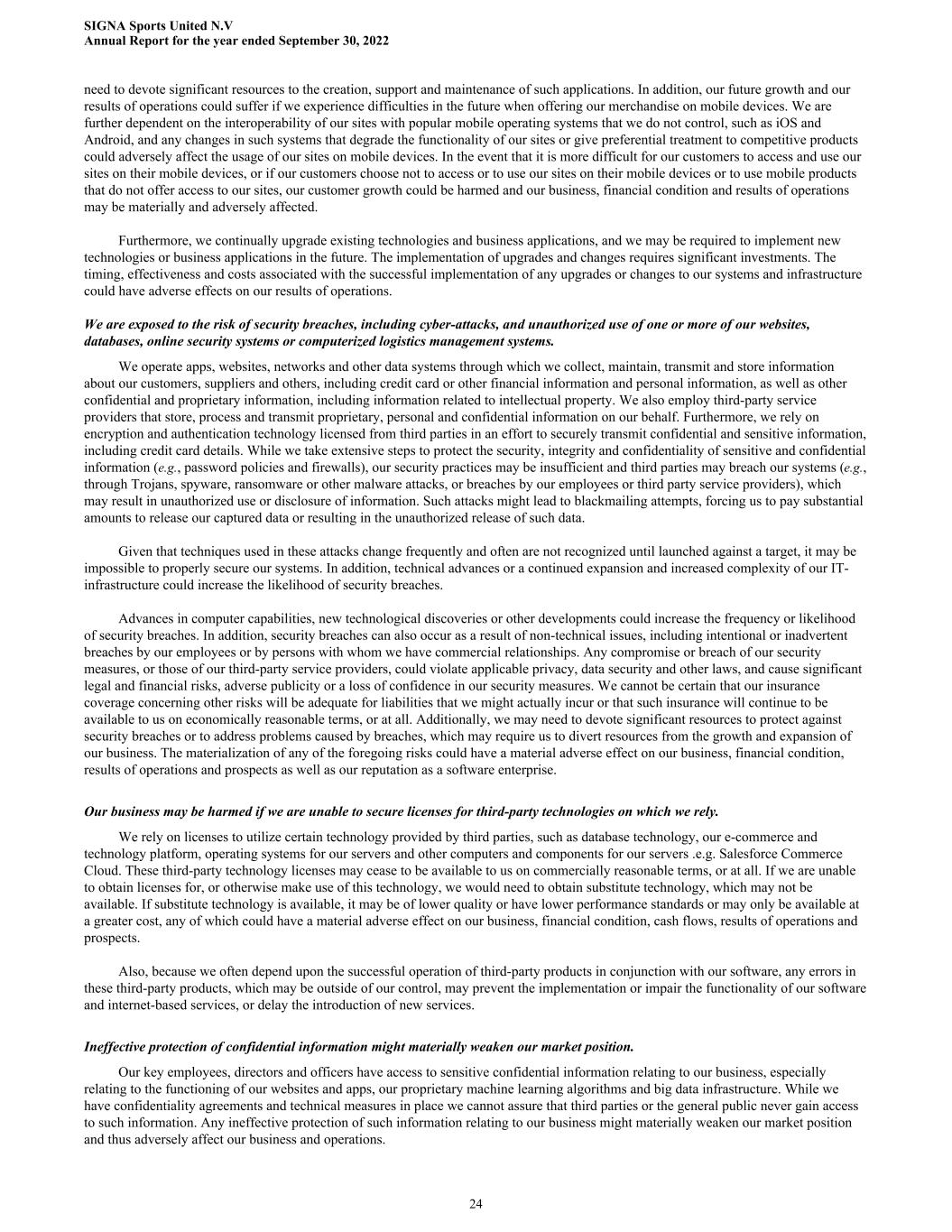
need to devote significant resources to the creation, support and maintenance of such applications. In addition, our future growth and our results of operations could suffer if we experience difficulties in the future when offering our merchandise on mobile devices. We are further dependent on the interoperability of our sites with popular mobile operating systems that we do not control, such as iOS and Android, and any changes in such systems that degrade the functionality of our sites or give preferential treatment to competitive products could adversely affect the usage of our sites on mobile devices. In the event that it is more difficult for our customers to access and use our sites on their mobile devices, or if our customers choose not to access or to use our sites on their mobile devices or to use mobile products that do not offer access to our sites, our customer growth could be harmed and our business, financial condition and results of operations may be materially and adversely affected. Furthermore, we continually upgrade existing technologies and business applications, and we may be required to implement new technologies or business applications in the future. The implementation of upgrades and changes requires significant investments. The timing, effectiveness and costs associated with the successful implementation of any upgrades or changes to our systems and infrastructure could have adverse effects on our results of operations. We are exposed to the risk of security breaches, including cyber-attacks, and unauthorized use of one or more of our websites, databases, online security systems or computerized logistics management systems. We operate apps, websites, networks and other data systems through which we collect, maintain, transmit and store information about our customers, suppliers and others, including credit card or other financial information and personal information, as well as other confidential and proprietary information, including information related to intellectual property. We also employ third-party service providers that store, process and transmit proprietary, personal and confidential information on our behalf. Furthermore, we rely on encryption and authentication technology licensed from third parties in an effort to securely transmit confidential and sensitive information, including credit card details. While we take extensive steps to protect the security, integrity and confidentiality of sensitive and confidential information (e.g., password policies and firewalls), our security practices may be insufficient and third parties may breach our systems (e.g., through Trojans, spyware, ransomware or other malware attacks, or breaches by our employees or third party service providers), which may result in unauthorized use or disclosure of information. Such attacks might lead to blackmailing attempts, forcing us to pay substantial amounts to release our captured data or resulting in the unauthorized release of such data. Given that techniques used in these attacks change frequently and often are not recognized until launched against a target, it may be impossible to properly secure our systems. In addition, technical advances or a continued expansion and increased complexity of our IT- infrastructure could increase the likelihood of security breaches. Advances in computer capabilities, new technological discoveries or other developments could increase the frequency or likelihood of security breaches. In addition, security breaches can also occur as a result of non-technical issues, including intentional or inadvertent breaches by our employees or by persons with whom we have commercial relationships. Any compromise or breach of our security measures, or those of our third-party service providers, could violate applicable privacy, data security and other laws, and cause significant legal and financial risks, adverse publicity or a loss of confidence in our security measures. We cannot be certain that our insurance coverage concerning other risks will be adequate for liabilities that we might actually incur or that such insurance will continue to be available to us on economically reasonable terms, or at all. Additionally, we may need to devote significant resources to protect against security breaches or to address problems caused by breaches, which may require us to divert resources from the growth and expansion of our business. The materialization of any of the foregoing risks could have a material adverse effect on our business, financial condition, results of operations and prospects as well as our reputation as a software enterprise. Our business may be harmed if we are unable to secure licenses for third-party technologies on which we rely. We rely on licenses to utilize certain technology provided by third parties, such as database technology, our e-commerce and technology platform, operating systems for our servers and other computers and components for our servers .e.g. Salesforce Commerce Cloud. These third-party technology licenses may cease to be available to us on commercially reasonable terms, or at all. If we are unable to obtain licenses for, or otherwise make use of this technology, we would need to obtain substitute technology, which may not be available. If substitute technology is available, it may be of lower quality or have lower performance standards or may only be available at a greater cost, any of which could have a material adverse effect on our business, financial condition, cash flows, results of operations and prospects. Also, because we often depend upon the successful operation of third-party products in conjunction with our software, any errors in these third-party products, which may be outside of our control, may prevent the implementation or impair the functionality of our software and internet-based services, or delay the introduction of new services. Ineffective protection of confidential information might materially weaken our market position. Our key employees, directors and officers have access to sensitive confidential information relating to our business, especially relating to the functioning of our websites and apps, our proprietary machine learning algorithms and big data infrastructure. While we have confidentiality agreements and technical measures in place we cannot assure that third parties or the general public never gain access to such information. Any ineffective protection of such information relating to our business might materially weaken our market position and thus adversely affect our business and operations. SIGNA Sports United N.V Annual Report for the year ended September 30, 2022 24
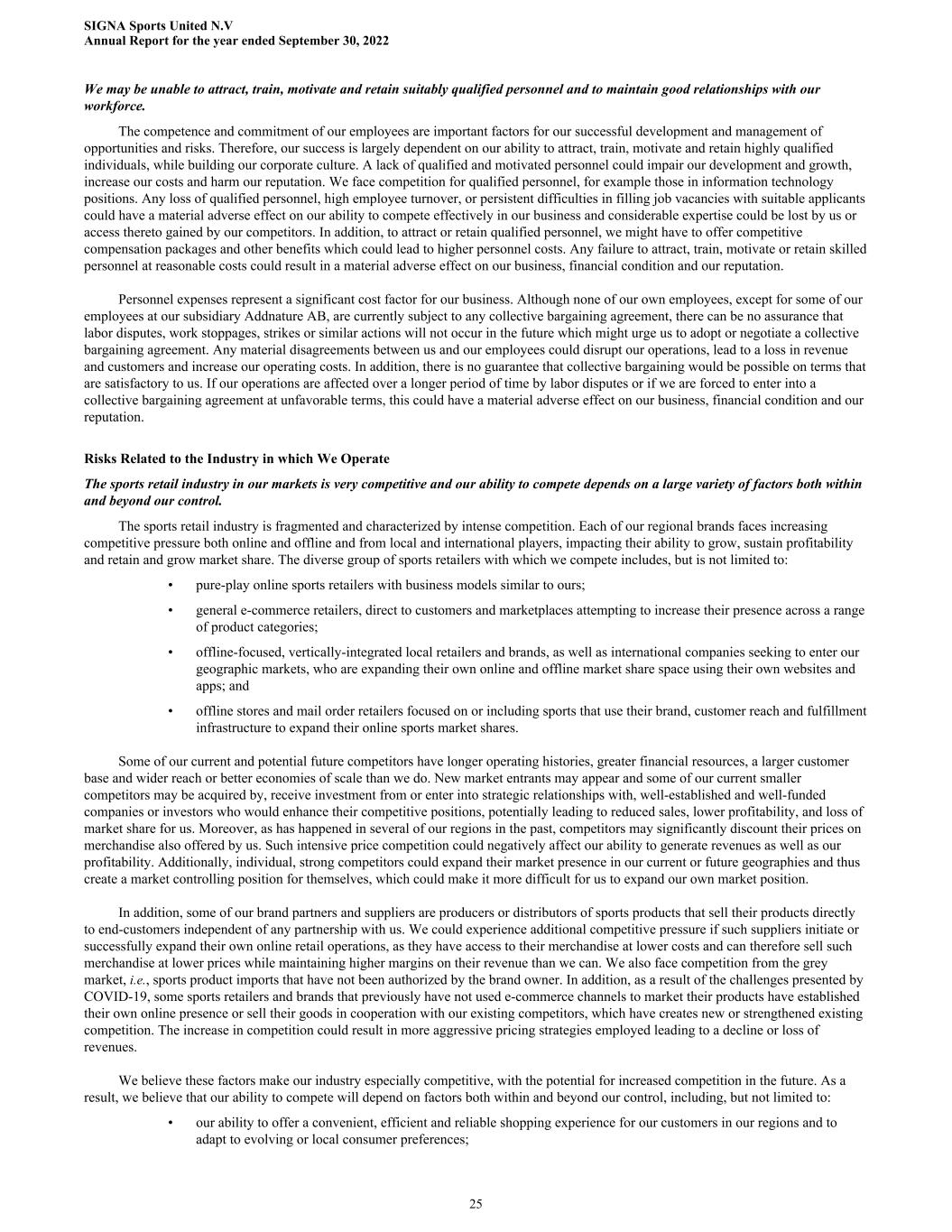
We may be unable to attract, train, motivate and retain suitably qualified personnel and to maintain good relationships with our workforce. The competence and commitment of our employees are important factors for our successful development and management of opportunities and risks. Therefore, our success is largely dependent on our ability to attract, train, motivate and retain highly qualified individuals, while building our corporate culture. A lack of qualified and motivated personnel could impair our development and growth, increase our costs and harm our reputation. We face competition for qualified personnel, for example those in information technology positions. Any loss of qualified personnel, high employee turnover, or persistent difficulties in filling job vacancies with suitable applicants could have a material adverse effect on our ability to compete effectively in our business and considerable expertise could be lost by us or access thereto gained by our competitors. In addition, to attract or retain qualified personnel, we might have to offer competitive compensation packages and other benefits which could lead to higher personnel costs. Any failure to attract, train, motivate or retain skilled personnel at reasonable costs could result in a material adverse effect on our business, financial condition and our reputation. Personnel expenses represent a significant cost factor for our business. Although none of our own employees, except for some of our employees at our subsidiary Addnature AB, are currently subject to any collective bargaining agreement, there can be no assurance that labor disputes, work stoppages, strikes or similar actions will not occur in the future which might urge us to adopt or negotiate a collective bargaining agreement. Any material disagreements between us and our employees could disrupt our operations, lead to a loss in revenue and customers and increase our operating costs. In addition, there is no guarantee that collective bargaining would be possible on terms that are satisfactory to us. If our operations are affected over a longer period of time by labor disputes or if we are forced to enter into a collective bargaining agreement at unfavorable terms, this could have a material adverse effect on our business, financial condition and our reputation. Risks Related to the Industry in which We Operate The sports retail industry in our markets is very competitive and our ability to compete depends on a large variety of factors both within and beyond our control. The sports retail industry is fragmented and characterized by intense competition. Each of our regional brands faces increasing competitive pressure both online and offline and from local and international players, impacting their ability to grow, sustain profitability and retain and grow market share. The diverse group of sports retailers with which we compete includes, but is not limited to: • pure-play online sports retailers with business models similar to ours; • general e-commerce retailers, direct to customers and marketplaces attempting to increase their presence across a range of product categories; • offline-focused, vertically-integrated local retailers and brands, as well as international companies seeking to enter our geographic markets, who are expanding their own online and offline market share space using their own websites and apps; and • offline stores and mail order retailers focused on or including sports that use their brand, customer reach and fulfillment infrastructure to expand their online sports market shares. Some of our current and potential future competitors have longer operating histories, greater financial resources, a larger customer base and wider reach or better economies of scale than we do. New market entrants may appear and some of our current smaller competitors may be acquired by, receive investment from or enter into strategic relationships with, well-established and well-funded companies or investors who would enhance their competitive positions, potentially leading to reduced sales, lower profitability, and loss of market share for us. Moreover, as has happened in several of our regions in the past, competitors may significantly discount their prices on merchandise also offered by us. Such intensive price competition could negatively affect our ability to generate revenues as well as our profitability. Additionally, individual, strong competitors could expand their market presence in our current or future geographies and thus create a market controlling position for themselves, which could make it more difficult for us to expand our own market position. In addition, some of our brand partners and suppliers are producers or distributors of sports products that sell their products directly to end-customers independent of any partnership with us. We could experience additional competitive pressure if such suppliers initiate or successfully expand their own online retail operations, as they have access to their merchandise at lower costs and can therefore sell such merchandise at lower prices while maintaining higher margins on their revenue than we can. We also face competition from the grey market, i.e., sports product imports that have not been authorized by the brand owner. In addition, as a result of the challenges presented by COVID-19, some sports retailers and brands that previously have not used e-commerce channels to market their products have established their own online presence or sell their goods in cooperation with our existing competitors, which have creates new or strengthened existing competition. The increase in competition could result in more aggressive pricing strategies employed leading to a decline or loss of revenues. We believe these factors make our industry especially competitive, with the potential for increased competition in the future. As a result, we believe that our ability to compete will depend on factors both within and beyond our control, including, but not limited to: • our ability to offer a convenient, efficient and reliable shopping experience for our customers in our regions and to adapt to evolving or local consumer preferences; SIGNA Sports United N.V Annual Report for the year ended September 30, 2022 25
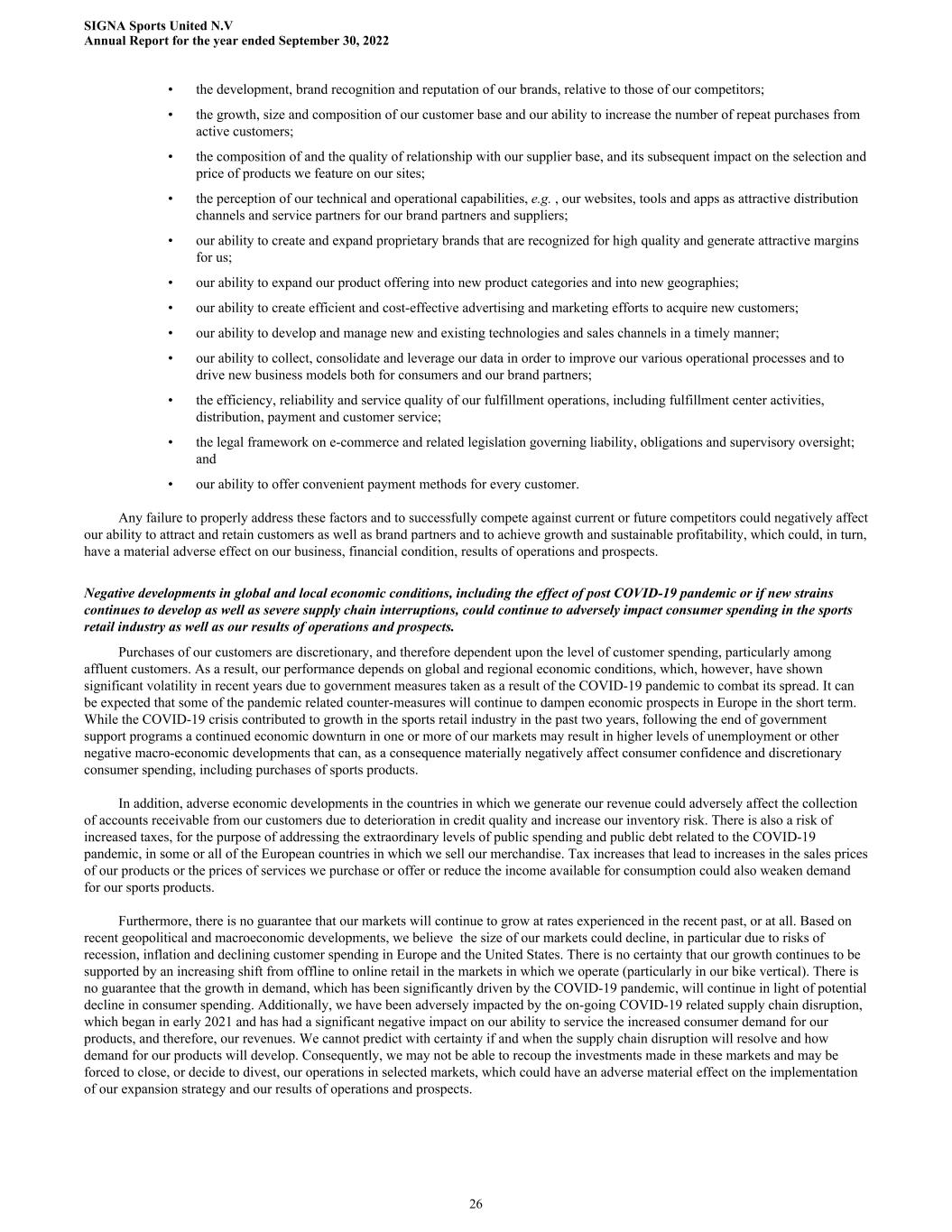
• the development, brand recognition and reputation of our brands, relative to those of our competitors; • the growth, size and composition of our customer base and our ability to increase the number of repeat purchases from active customers; • the composition of and the quality of relationship with our supplier base, and its subsequent impact on the selection and price of products we feature on our sites; • the perception of our technical and operational capabilities, e.g. , our websites, tools and apps as attractive distribution channels and service partners for our brand partners and suppliers; • our ability to create and expand proprietary brands that are recognized for high quality and generate attractive margins for us; • our ability to expand our product offering into new product categories and into new geographies; • our ability to create efficient and cost-effective advertising and marketing efforts to acquire new customers; • our ability to develop and manage new and existing technologies and sales channels in a timely manner; • our ability to collect, consolidate and leverage our data in order to improve our various operational processes and to drive new business models both for consumers and our brand partners; • the efficiency, reliability and service quality of our fulfillment operations, including fulfillment center activities, distribution, payment and customer service; • the legal framework on e-commerce and related legislation governing liability, obligations and supervisory oversight; and • our ability to offer convenient payment methods for every customer. Any failure to properly address these factors and to successfully compete against current or future competitors could negatively affect our ability to attract and retain customers as well as brand partners and to achieve growth and sustainable profitability, which could, in turn, have a material adverse effect on our business, financial condition, results of operations and prospects. Negative developments in global and local economic conditions, including the effect of post COVID-19 pandemic or if new strains continues to develop as well as severe supply chain interruptions, could continue to adversely impact consumer spending in the sports retail industry as well as our results of operations and prospects. Purchases of our customers are discretionary, and therefore dependent upon the level of customer spending, particularly among affluent customers. As a result, our performance depends on global and regional economic conditions, which, however, have shown significant volatility in recent years due to government measures taken as a result of the COVID-19 pandemic to combat its spread. It can be expected that some of the pandemic related counter-measures will continue to dampen economic prospects in Europe in the short term. While the COVID-19 crisis contributed to growth in the sports retail industry in the past two years, following the end of government support programs a continued economic downturn in one or more of our markets may result in higher levels of unemployment or other negative macro-economic developments that can, as a consequence materially negatively affect consumer confidence and discretionary consumer spending, including purchases of sports products. In addition, adverse economic developments in the countries in which we generate our revenue could adversely affect the collection of accounts receivable from our customers due to deterioration in credit quality and increase our inventory risk. There is also a risk of increased taxes, for the purpose of addressing the extraordinary levels of public spending and public debt related to the COVID-19 pandemic, in some or all of the European countries in which we sell our merchandise. Tax increases that lead to increases in the sales prices of our products or the prices of services we purchase or offer or reduce the income available for consumption could also weaken demand for our sports products. Furthermore, there is no guarantee that our markets will continue to grow at rates experienced in the recent past, or at all. Based on recent geopolitical and macroeconomic developments, we believe the size of our markets could decline, in particular due to risks of recession, inflation and declining customer spending in Europe and the United States. There is no certainty that our growth continues to be supported by an increasing shift from offline to online retail in the markets in which we operate (particularly in our bike vertical). There is no guarantee that the growth in demand, which has been significantly driven by the COVID-19 pandemic, will continue in light of potential decline in consumer spending. Additionally, we have been adversely impacted by the on-going COVID-19 related supply chain disruption, which began in early 2021 and has had a significant negative impact on our ability to service the increased consumer demand for our products, and therefore, our revenues. We cannot predict with certainty if and when the supply chain disruption will resolve and how demand for our products will develop. Consequently, we may not be able to recoup the investments made in these markets and may be forced to close, or decide to divest, our operations in selected markets, which could have an adverse material effect on the implementation of our expansion strategy and our results of operations and prospects. SIGNA Sports United N.V Annual Report for the year ended September 30, 2022 26
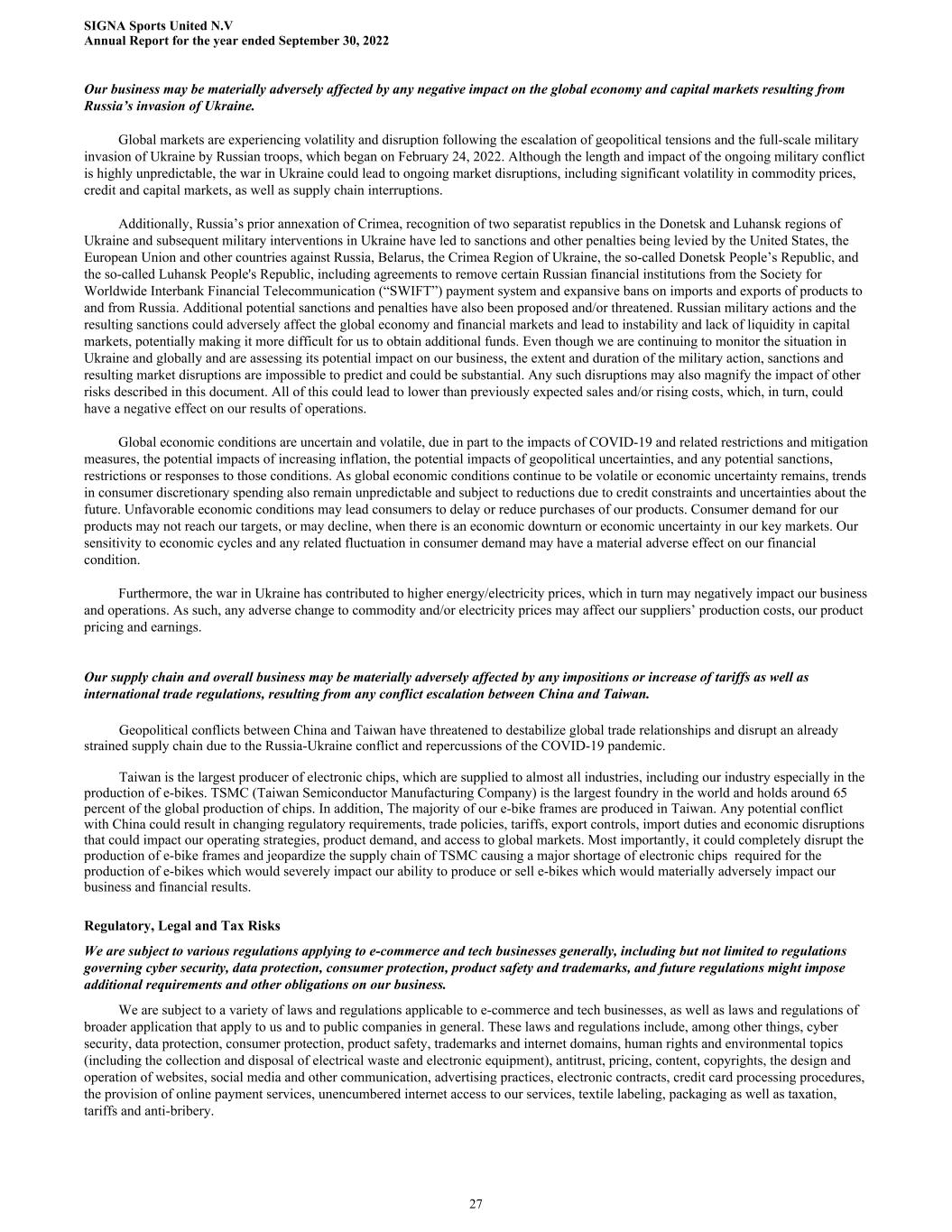
Our business may be materially adversely affected by any negative impact on the global economy and capital markets resulting from Russia’s invasion of Ukraine. Global markets are experiencing volatility and disruption following the escalation of geopolitical tensions and the full-scale military invasion of Ukraine by Russian troops, which began on February 24, 2022. Although the length and impact of the ongoing military conflict is highly unpredictable, the war in Ukraine could lead to ongoing market disruptions, including significant volatility in commodity prices, credit and capital markets, as well as supply chain interruptions. Additionally, Russia’s prior annexation of Crimea, recognition of two separatist republics in the Donetsk and Luhansk regions of Ukraine and subsequent military interventions in Ukraine have led to sanctions and other penalties being levied by the United States, the European Union and other countries against Russia, Belarus, the Crimea Region of Ukraine, the so-called Donetsk People’s Republic, and the so-called Luhansk People's Republic, including agreements to remove certain Russian financial institutions from the Society for Worldwide Interbank Financial Telecommunication (“SWIFT”) payment system and expansive bans on imports and exports of products to and from Russia. Additional potential sanctions and penalties have also been proposed and/or threatened. Russian military actions and the resulting sanctions could adversely affect the global economy and financial markets and lead to instability and lack of liquidity in capital markets, potentially making it more difficult for us to obtain additional funds. Even though we are continuing to monitor the situation in Ukraine and globally and are assessing its potential impact on our business, the extent and duration of the military action, sanctions and resulting market disruptions are impossible to predict and could be substantial. Any such disruptions may also magnify the impact of other risks described in this document. All of this could lead to lower than previously expected sales and/or rising costs, which, in turn, could have a negative effect on our results of operations. Global economic conditions are uncertain and volatile, due in part to the impacts of COVID-19 and related restrictions and mitigation measures, the potential impacts of increasing inflation, the potential impacts of geopolitical uncertainties, and any potential sanctions, restrictions or responses to those conditions. As global economic conditions continue to be volatile or economic uncertainty remains, trends in consumer discretionary spending also remain unpredictable and subject to reductions due to credit constraints and uncertainties about the future. Unfavorable economic conditions may lead consumers to delay or reduce purchases of our products. Consumer demand for our products may not reach our targets, or may decline, when there is an economic downturn or economic uncertainty in our key markets. Our sensitivity to economic cycles and any related fluctuation in consumer demand may have a material adverse effect on our financial condition. Furthermore, the war in Ukraine has contributed to higher energy/electricity prices, which in turn may negatively impact our business and operations. As such, any adverse change to commodity and/or electricity prices may affect our suppliers’ production costs, our product pricing and earnings. Our supply chain and overall business may be materially adversely affected by any impositions or increase of tariffs as well as international trade regulations, resulting from any conflict escalation between China and Taiwan. Geopolitical conflicts between China and Taiwan have threatened to destabilize global trade relationships and disrupt an already strained supply chain due to the Russia-Ukraine conflict and repercussions of the COVID-19 pandemic. Taiwan is the largest producer of electronic chips, which are supplied to almost all industries, including our industry especially in the production of e-bikes. TSMC (Taiwan Semiconductor Manufacturing Company) is the largest foundry in the world and holds around 65 percent of the global production of chips. In addition, The majority of our e-bike frames are produced in Taiwan. Any potential conflict with China could result in changing regulatory requirements, trade policies, tariffs, export controls, import duties and economic disruptions that could impact our operating strategies, product demand, and access to global markets. Most importantly, it could completely disrupt the production of e-bike frames and jeopardize the supply chain of TSMC causing a major shortage of electronic chips required for the production of e-bikes which would severely impact our ability to produce or sell e-bikes which would materially adversely impact our business and financial results. Regulatory, Legal and Tax Risks We are subject to various regulations applying to e-commerce and tech businesses generally, including but not limited to regulations governing cyber security, data protection, consumer protection, product safety and trademarks, and future regulations might impose additional requirements and other obligations on our business. We are subject to a variety of laws and regulations applicable to e-commerce and tech businesses, as well as laws and regulations of broader application that apply to us and to public companies in general. These laws and regulations include, among other things, cyber security, data protection, consumer protection, product safety, trademarks and internet domains, human rights and environmental topics (including the collection and disposal of electrical waste and electronic equipment), antitrust, pricing, content, copyrights, the design and operation of websites, social media and other communication, advertising practices, electronic contracts, credit card processing procedures, the provision of online payment services, unencumbered internet access to our services, textile labeling, packaging as well as taxation, tariffs and anti-bribery. SIGNA Sports United N.V Annual Report for the year ended September 30, 2022 27
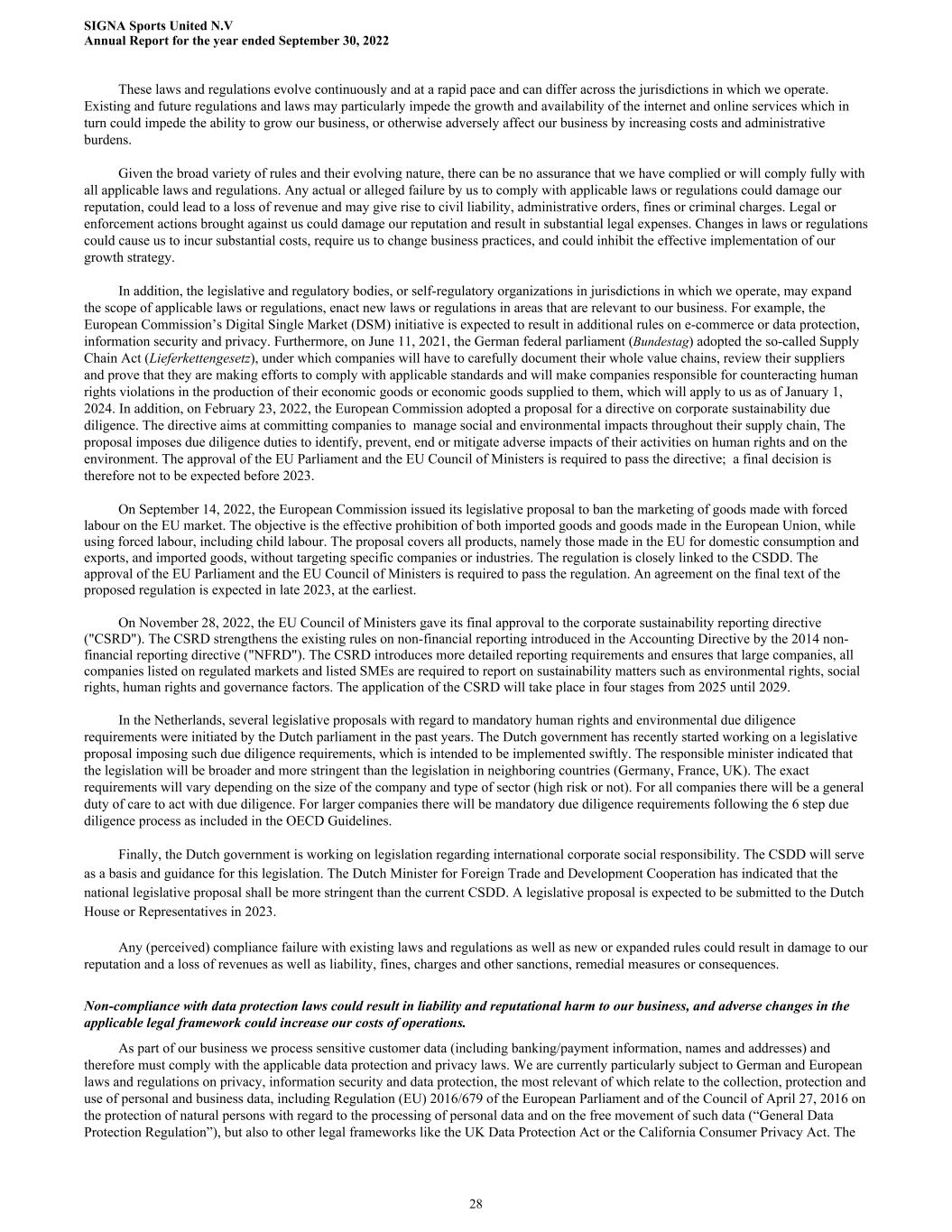
These laws and regulations evolve continuously and at a rapid pace and can differ across the jurisdictions in which we operate. Existing and future regulations and laws may particularly impede the growth and availability of the internet and online services which in turn could impede the ability to grow our business, or otherwise adversely affect our business by increasing costs and administrative burdens. Given the broad variety of rules and their evolving nature, there can be no assurance that we have complied or will comply fully with all applicable laws and regulations. Any actual or alleged failure by us to comply with applicable laws or regulations could damage our reputation, could lead to a loss of revenue and may give rise to civil liability, administrative orders, fines or criminal charges. Legal or enforcement actions brought against us could damage our reputation and result in substantial legal expenses. Changes in laws or regulations could cause us to incur substantial costs, require us to change business practices, and could inhibit the effective implementation of our growth strategy. In addition, the legislative and regulatory bodies, or self-regulatory organizations in jurisdictions in which we operate, may expand the scope of applicable laws or regulations, enact new laws or regulations in areas that are relevant to our business. For example, the European Commission’s Digital Single Market (DSM) initiative is expected to result in additional rules on e-commerce or data protection, information security and privacy. Furthermore, on June 11, 2021, the German federal parliament (Bundestag) adopted the so-called Supply Chain Act (Lieferkettengesetz), under which companies will have to carefully document their whole value chains, review their suppliers and prove that they are making efforts to comply with applicable standards and will make companies responsible for counteracting human rights violations in the production of their economic goods or economic goods supplied to them, which will apply to us as of January 1, 2024. In addition, on February 23, 2022, the European Commission adopted a proposal for a directive on corporate sustainability due diligence. The directive aims at committing companies to manage social and environmental impacts throughout their supply chain, The proposal imposes due diligence duties to identify, prevent, end or mitigate adverse impacts of their activities on human rights and on the environment. The approval of the EU Parliament and the EU Council of Ministers is required to pass the directive; a final decision is therefore not to be expected before 2023. On September 14, 2022, the European Commission issued its legislative proposal to ban the marketing of goods made with forced labour on the EU market. The objective is the effective prohibition of both imported goods and goods made in the European Union, while using forced labour, including child labour. The proposal covers all products, namely those made in the EU for domestic consumption and exports, and imported goods, without targeting specific companies or industries. The regulation is closely linked to the CSDD. The approval of the EU Parliament and the EU Council of Ministers is required to pass the regulation. An agreement on the final text of the proposed regulation is expected in late 2023, at the earliest. On November 28, 2022, the EU Council of Ministers gave its final approval to the corporate sustainability reporting directive ("CSRD"). The CSRD strengthens the existing rules on non-financial reporting introduced in the Accounting Directive by the 2014 non- financial reporting directive ("NFRD"). The CSRD introduces more detailed reporting requirements and ensures that large companies, all companies listed on regulated markets and listed SMEs are required to report on sustainability matters such as environmental rights, social rights, human rights and governance factors. The application of the CSRD will take place in four stages from 2025 until 2029. In the Netherlands, several legislative proposals with regard to mandatory human rights and environmental due diligence requirements were initiated by the Dutch parliament in the past years. The Dutch government has recently started working on a legislative proposal imposing such due diligence requirements, which is intended to be implemented swiftly. The responsible minister indicated that the legislation will be broader and more stringent than the legislation in neighboring countries (Germany, France, UK). The exact requirements will vary depending on the size of the company and type of sector (high risk or not). For all companies there will be a general duty of care to act with due diligence. For larger companies there will be mandatory due diligence requirements following the 6 step due diligence process as included in the OECD Guidelines. Finally, the Dutch government is working on legislation regarding international corporate social responsibility. The CSDD will serve as a basis and guidance for this legislation. The Dutch Minister for Foreign Trade and Development Cooperation has indicated that the national legislative proposal shall be more stringent than the current CSDD. A legislative proposal is expected to be submitted to the Dutch House or Representatives in 2023. Any (perceived) compliance failure with existing laws and regulations as well as new or expanded rules could result in damage to our reputation and a loss of revenues as well as liability, fines, charges and other sanctions, remedial measures or consequences. Non-compliance with data protection laws could result in liability and reputational harm to our business, and adverse changes in the applicable legal framework could increase our costs of operations. As part of our business we process sensitive customer data (including banking/payment information, names and addresses) and therefore must comply with the applicable data protection and privacy laws. We are currently particularly subject to German and European laws and regulations on privacy, information security and data protection, the most relevant of which relate to the collection, protection and use of personal and business data, including Regulation (EU) 2016/679 of the European Parliament and of the Council of April 27, 2016 on the protection of natural persons with regard to the processing of personal data and on the free movement of such data (“General Data Protection Regulation”), but also to other legal frameworks like the UK Data Protection Act or the California Consumer Privacy Act. The SIGNA Sports United N.V Annual Report for the year ended September 30, 2022 28
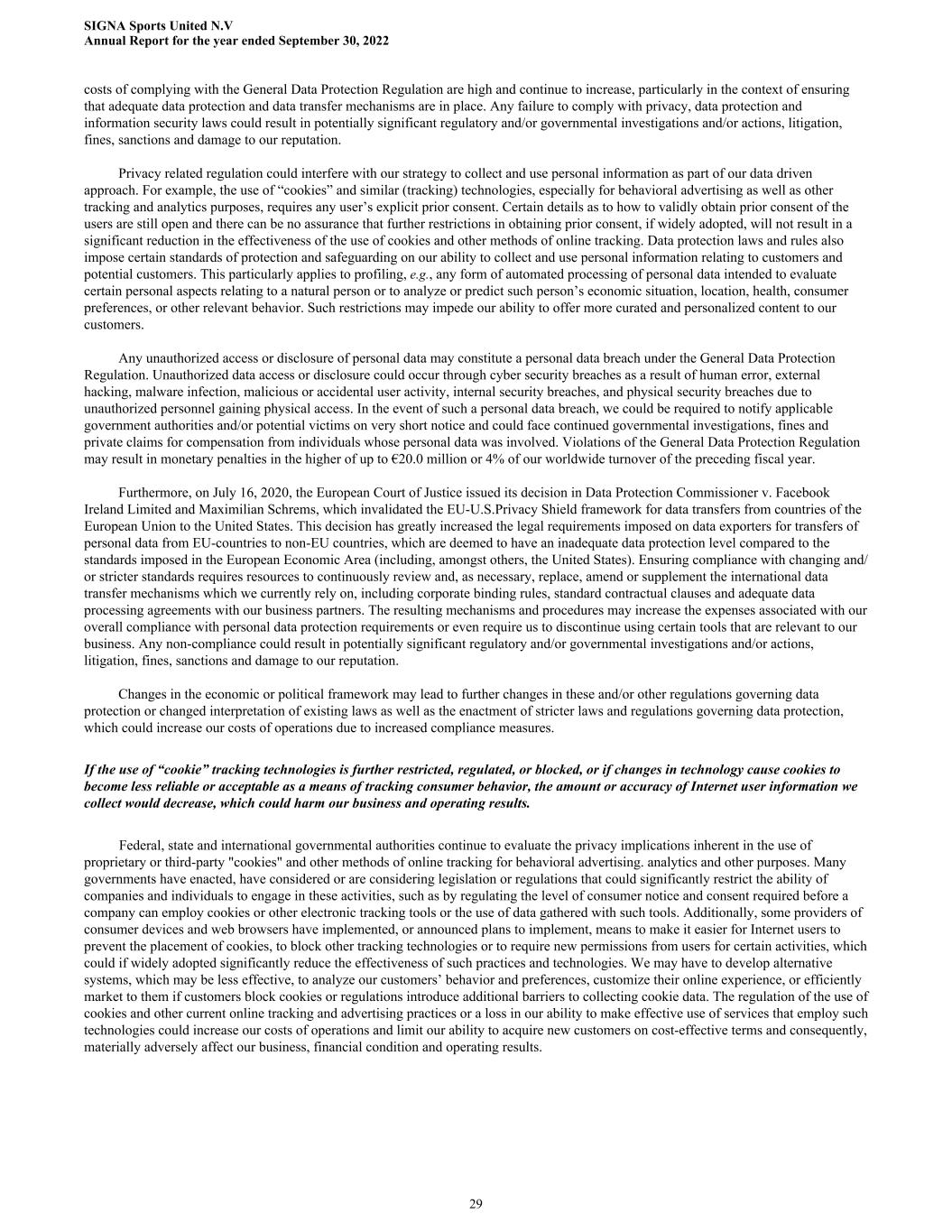
costs of complying with the General Data Protection Regulation are high and continue to increase, particularly in the context of ensuring that adequate data protection and data transfer mechanisms are in place. Any failure to comply with privacy, data protection and information security laws could result in potentially significant regulatory and/or governmental investigations and/or actions, litigation, fines, sanctions and damage to our reputation. Privacy related regulation could interfere with our strategy to collect and use personal information as part of our data driven approach. For example, the use of “cookies” and similar (tracking) technologies, especially for behavioral advertising as well as other tracking and analytics purposes, requires any user’s explicit prior consent. Certain details as to how to validly obtain prior consent of the users are still open and there can be no assurance that further restrictions in obtaining prior consent, if widely adopted, will not result in a significant reduction in the effectiveness of the use of cookies and other methods of online tracking. Data protection laws and rules also impose certain standards of protection and safeguarding on our ability to collect and use personal information relating to customers and potential customers. This particularly applies to profiling, e.g., any form of automated processing of personal data intended to evaluate certain personal aspects relating to a natural person or to analyze or predict such person’s economic situation, location, health, consumer preferences, or other relevant behavior. Such restrictions may impede our ability to offer more curated and personalized content to our customers. Any unauthorized access or disclosure of personal data may constitute a personal data breach under the General Data Protection Regulation. Unauthorized data access or disclosure could occur through cyber security breaches as a result of human error, external hacking, malware infection, malicious or accidental user activity, internal security breaches, and physical security breaches due to unauthorized personnel gaining physical access. In the event of such a personal data breach, we could be required to notify applicable government authorities and/or potential victims on very short notice and could face continued governmental investigations, fines and private claims for compensation from individuals whose personal data was involved. Violations of the General Data Protection Regulation may result in monetary penalties in the higher of up to €20.0 million or 4% of our worldwide turnover of the preceding fiscal year. Furthermore, on July 16, 2020, the European Court of Justice issued its decision in Data Protection Commissioner v. Facebook Ireland Limited and Maximilian Schrems, which invalidated the EU-U.S.Privacy Shield framework for data transfers from countries of the European Union to the United States. This decision has greatly increased the legal requirements imposed on data exporters for transfers of personal data from EU-countries to non-EU countries, which are deemed to have an inadequate data protection level compared to the standards imposed in the European Economic Area (including, amongst others, the United States). Ensuring compliance with changing and/ or stricter standards requires resources to continuously review and, as necessary, replace, amend or supplement the international data transfer mechanisms which we currently rely on, including corporate binding rules, standard contractual clauses and adequate data processing agreements with our business partners. The resulting mechanisms and procedures may increase the expenses associated with our overall compliance with personal data protection requirements or even require us to discontinue using certain tools that are relevant to our business. Any non-compliance could result in potentially significant regulatory and/or governmental investigations and/or actions, litigation, fines, sanctions and damage to our reputation. Changes in the economic or political framework may lead to further changes in these and/or other regulations governing data protection or changed interpretation of existing laws as well as the enactment of stricter laws and regulations governing data protection, which could increase our costs of operations due to increased compliance measures. If the use of “cookie” tracking technologies is further restricted, regulated, or blocked, or if changes in technology cause cookies to become less reliable or acceptable as a means of tracking consumer behavior, the amount or accuracy of Internet user information we collect would decrease, which could harm our business and operating results. Federal, state and international governmental authorities continue to evaluate the privacy implications inherent in the use of proprietary or third-party "cookies" and other methods of online tracking for behavioral advertising. analytics and other purposes. Many governments have enacted, have considered or are considering legislation or regulations that could significantly restrict the ability of companies and individuals to engage in these activities, such as by regulating the level of consumer notice and consent required before a company can employ cookies or other electronic tracking tools or the use of data gathered with such tools. Additionally, some providers of consumer devices and web browsers have implemented, or announced plans to implement, means to make it easier for Internet users to prevent the placement of cookies, to block other tracking technologies or to require new permissions from users for certain activities, which could if widely adopted significantly reduce the effectiveness of such practices and technologies. We may have to develop alternative systems, which may be less effective, to analyze our customers’ behavior and preferences, customize their online experience, or efficiently market to them if customers block cookies or regulations introduce additional barriers to collecting cookie data. The regulation of the use of cookies and other current online tracking and advertising practices or a loss in our ability to make effective use of services that employ such technologies could increase our costs of operations and limit our ability to acquire new customers on cost-effective terms and consequently, materially adversely affect our business, financial condition and operating results. SIGNA Sports United N.V Annual Report for the year ended September 30, 2022 29
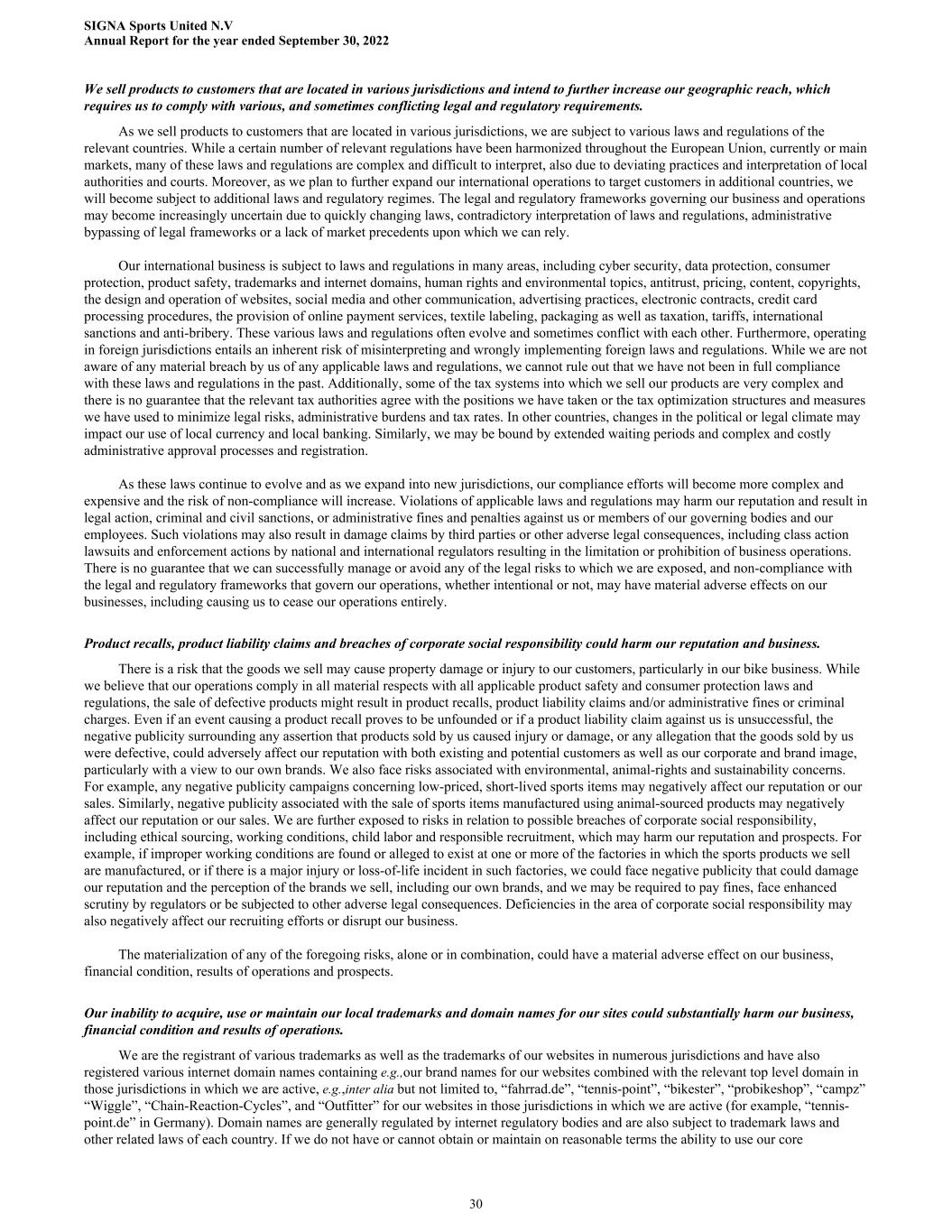
We sell products to customers that are located in various jurisdictions and intend to further increase our geographic reach, which requires us to comply with various, and sometimes conflicting legal and regulatory requirements. As we sell products to customers that are located in various jurisdictions, we are subject to various laws and regulations of the relevant countries. While a certain number of relevant regulations have been harmonized throughout the European Union, currently or main markets, many of these laws and regulations are complex and difficult to interpret, also due to deviating practices and interpretation of local authorities and courts. Moreover, as we plan to further expand our international operations to target customers in additional countries, we will become subject to additional laws and regulatory regimes. The legal and regulatory frameworks governing our business and operations may become increasingly uncertain due to quickly changing laws, contradictory interpretation of laws and regulations, administrative bypassing of legal frameworks or a lack of market precedents upon which we can rely. Our international business is subject to laws and regulations in many areas, including cyber security, data protection, consumer protection, product safety, trademarks and internet domains, human rights and environmental topics, antitrust, pricing, content, copyrights, the design and operation of websites, social media and other communication, advertising practices, electronic contracts, credit card processing procedures, the provision of online payment services, textile labeling, packaging as well as taxation, tariffs, international sanctions and anti-bribery. These various laws and regulations often evolve and sometimes conflict with each other. Furthermore, operating in foreign jurisdictions entails an inherent risk of misinterpreting and wrongly implementing foreign laws and regulations. While we are not aware of any material breach by us of any applicable laws and regulations, we cannot rule out that we have not been in full compliance with these laws and regulations in the past. Additionally, some of the tax systems into which we sell our products are very complex and there is no guarantee that the relevant tax authorities agree with the positions we have taken or the tax optimization structures and measures we have used to minimize legal risks, administrative burdens and tax rates. In other countries, changes in the political or legal climate may impact our use of local currency and local banking. Similarly, we may be bound by extended waiting periods and complex and costly administrative approval processes and registration. As these laws continue to evolve and as we expand into new jurisdictions, our compliance efforts will become more complex and expensive and the risk of non-compliance will increase. Violations of applicable laws and regulations may harm our reputation and result in legal action, criminal and civil sanctions, or administrative fines and penalties against us or members of our governing bodies and our employees. Such violations may also result in damage claims by third parties or other adverse legal consequences, including class action lawsuits and enforcement actions by national and international regulators resulting in the limitation or prohibition of business operations. There is no guarantee that we can successfully manage or avoid any of the legal risks to which we are exposed, and non-compliance with the legal and regulatory frameworks that govern our operations, whether intentional or not, may have material adverse effects on our businesses, including causing us to cease our operations entirely. Product recalls, product liability claims and breaches of corporate social responsibility could harm our reputation and business. There is a risk that the goods we sell may cause property damage or injury to our customers, particularly in our bike business. While we believe that our operations comply in all material respects with all applicable product safety and consumer protection laws and regulations, the sale of defective products might result in product recalls, product liability claims and/or administrative fines or criminal charges. Even if an event causing a product recall proves to be unfounded or if a product liability claim against us is unsuccessful, the negative publicity surrounding any assertion that products sold by us caused injury or damage, or any allegation that the goods sold by us were defective, could adversely affect our reputation with both existing and potential customers as well as our corporate and brand image, particularly with a view to our own brands. We also face risks associated with environmental, animal-rights and sustainability concerns. For example, any negative publicity campaigns concerning low-priced, short-lived sports items may negatively affect our reputation or our sales. Similarly, negative publicity associated with the sale of sports items manufactured using animal-sourced products may negatively affect our reputation or our sales. We are further exposed to risks in relation to possible breaches of corporate social responsibility, including ethical sourcing, working conditions, child labor and responsible recruitment, which may harm our reputation and prospects. For example, if improper working conditions are found or alleged to exist at one or more of the factories in which the sports products we sell are manufactured, or if there is a major injury or loss-of-life incident in such factories, we could face negative publicity that could damage our reputation and the perception of the brands we sell, including our own brands, and we may be required to pay fines, face enhanced scrutiny by regulators or be subjected to other adverse legal consequences. Deficiencies in the area of corporate social responsibility may also negatively affect our recruiting efforts or disrupt our business. The materialization of any of the foregoing risks, alone or in combination, could have a material adverse effect on our business, financial condition, results of operations and prospects. Our inability to acquire, use or maintain our local trademarks and domain names for our sites could substantially harm our business, financial condition and results of operations. We are the registrant of various trademarks as well as the trademarks of our websites in numerous jurisdictions and have also registered various internet domain names containing e.g.,our brand names for our websites combined with the relevant top level domain in those jurisdictions in which we are active, e.g.,inter alia but not limited to, “fahrrad.de”, “tennis-point”, “bikester”, “probikeshop”, “campz” “Wiggle”, “Chain-Reaction-Cycles”, and “Outfitter” for our websites in those jurisdictions in which we are active (for example, “tennis- point.de” in Germany). Domain names are generally regulated by internet regulatory bodies and are also subject to trademark laws and other related laws of each country. If we do not have or cannot obtain or maintain on reasonable terms the ability to use our core SIGNA Sports United N.V Annual Report for the year ended September 30, 2022 30
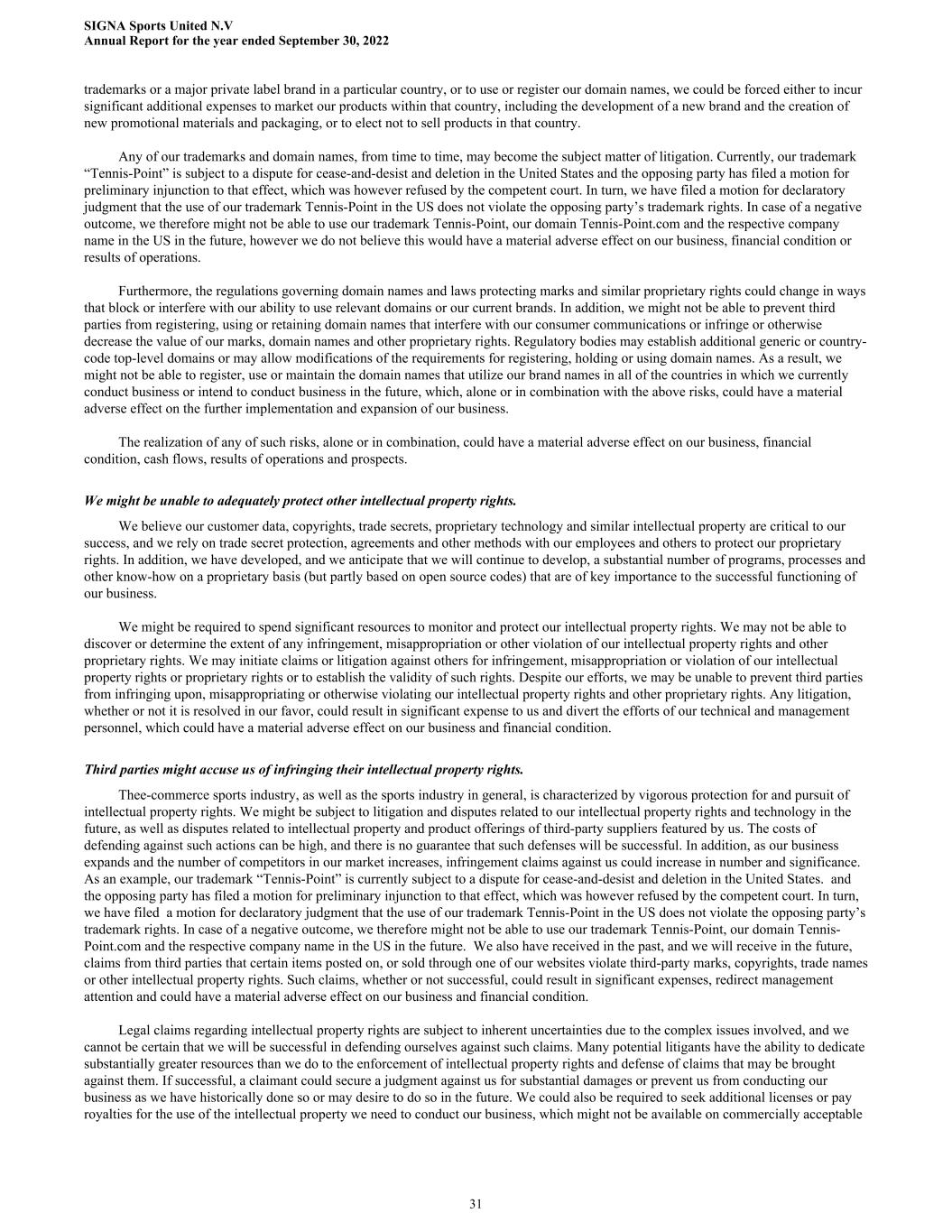
trademarks or a major private label brand in a particular country, or to use or register our domain names, we could be forced either to incur significant additional expenses to market our products within that country, including the development of a new brand and the creation of new promotional materials and packaging, or to elect not to sell products in that country. Any of our trademarks and domain names, from time to time, may become the subject matter of litigation. Currently, our trademark “Tennis-Point” is subject to a dispute for cease-and-desist and deletion in the United States and the opposing party has filed a motion for preliminary injunction to that effect, which was however refused by the competent court. In turn, we have filed a motion for declaratory judgment that the use of our trademark Tennis-Point in the US does not violate the opposing party’s trademark rights. In case of a negative outcome, we therefore might not be able to use our trademark Tennis-Point, our domain Tennis-Point.com and the respective company name in the US in the future, however we do not believe this would have a material adverse effect on our business, financial condition or results of operations. Furthermore, the regulations governing domain names and laws protecting marks and similar proprietary rights could change in ways that block or interfere with our ability to use relevant domains or our current brands. In addition, we might not be able to prevent third parties from registering, using or retaining domain names that interfere with our consumer communications or infringe or otherwise decrease the value of our marks, domain names and other proprietary rights. Regulatory bodies may establish additional generic or country- code top-level domains or may allow modifications of the requirements for registering, holding or using domain names. As a result, we might not be able to register, use or maintain the domain names that utilize our brand names in all of the countries in which we currently conduct business or intend to conduct business in the future, which, alone or in combination with the above risks, could have a material adverse effect on the further implementation and expansion of our business. The realization of any of such risks, alone or in combination, could have a material adverse effect on our business, financial condition, cash flows, results of operations and prospects. We might be unable to adequately protect other intellectual property rights. We believe our customer data, copyrights, trade secrets, proprietary technology and similar intellectual property are critical to our success, and we rely on trade secret protection, agreements and other methods with our employees and others to protect our proprietary rights. In addition, we have developed, and we anticipate that we will continue to develop, a substantial number of programs, processes and other know-how on a proprietary basis (but partly based on open source codes) that are of key importance to the successful functioning of our business. We might be required to spend significant resources to monitor and protect our intellectual property rights. We may not be able to discover or determine the extent of any infringement, misappropriation or other violation of our intellectual property rights and other proprietary rights. We may initiate claims or litigation against others for infringement, misappropriation or violation of our intellectual property rights or proprietary rights or to establish the validity of such rights. Despite our efforts, we may be unable to prevent third parties from infringing upon, misappropriating or otherwise violating our intellectual property rights and other proprietary rights. Any litigation, whether or not it is resolved in our favor, could result in significant expense to us and divert the efforts of our technical and management personnel, which could have a material adverse effect on our business and financial condition. Third parties might accuse us of infringing their intellectual property rights. Thee-commerce sports industry, as well as the sports industry in general, is characterized by vigorous protection for and pursuit of intellectual property rights. We might be subject to litigation and disputes related to our intellectual property rights and technology in the future, as well as disputes related to intellectual property and product offerings of third-party suppliers featured by us. The costs of defending against such actions can be high, and there is no guarantee that such defenses will be successful. In addition, as our business expands and the number of competitors in our market increases, infringement claims against us could increase in number and significance. As an example, our trademark “Tennis-Point” is currently subject to a dispute for cease-and-desist and deletion in the United States. and the opposing party has filed a motion for preliminary injunction to that effect, which was however refused by the competent court. In turn, we have filed a motion for declaratory judgment that the use of our trademark Tennis-Point in the US does not violate the opposing party’s trademark rights. In case of a negative outcome, we therefore might not be able to use our trademark Tennis-Point, our domain Tennis- Point.com and the respective company name in the US in the future. We also have received in the past, and we will receive in the future, claims from third parties that certain items posted on, or sold through one of our websites violate third-party marks, copyrights, trade names or other intellectual property rights. Such claims, whether or not successful, could result in significant expenses, redirect management attention and could have a material adverse effect on our business and financial condition. Legal claims regarding intellectual property rights are subject to inherent uncertainties due to the complex issues involved, and we cannot be certain that we will be successful in defending ourselves against such claims. Many potential litigants have the ability to dedicate substantially greater resources than we do to the enforcement of intellectual property rights and defense of claims that may be brought against them. If successful, a claimant could secure a judgment against us for substantial damages or prevent us from conducting our business as we have historically done so or may desire to do so in the future. We could also be required to seek additional licenses or pay royalties for the use of the intellectual property we need to conduct our business, which might not be available on commercially acceptable SIGNA Sports United N.V Annual Report for the year ended September 30, 2022 31
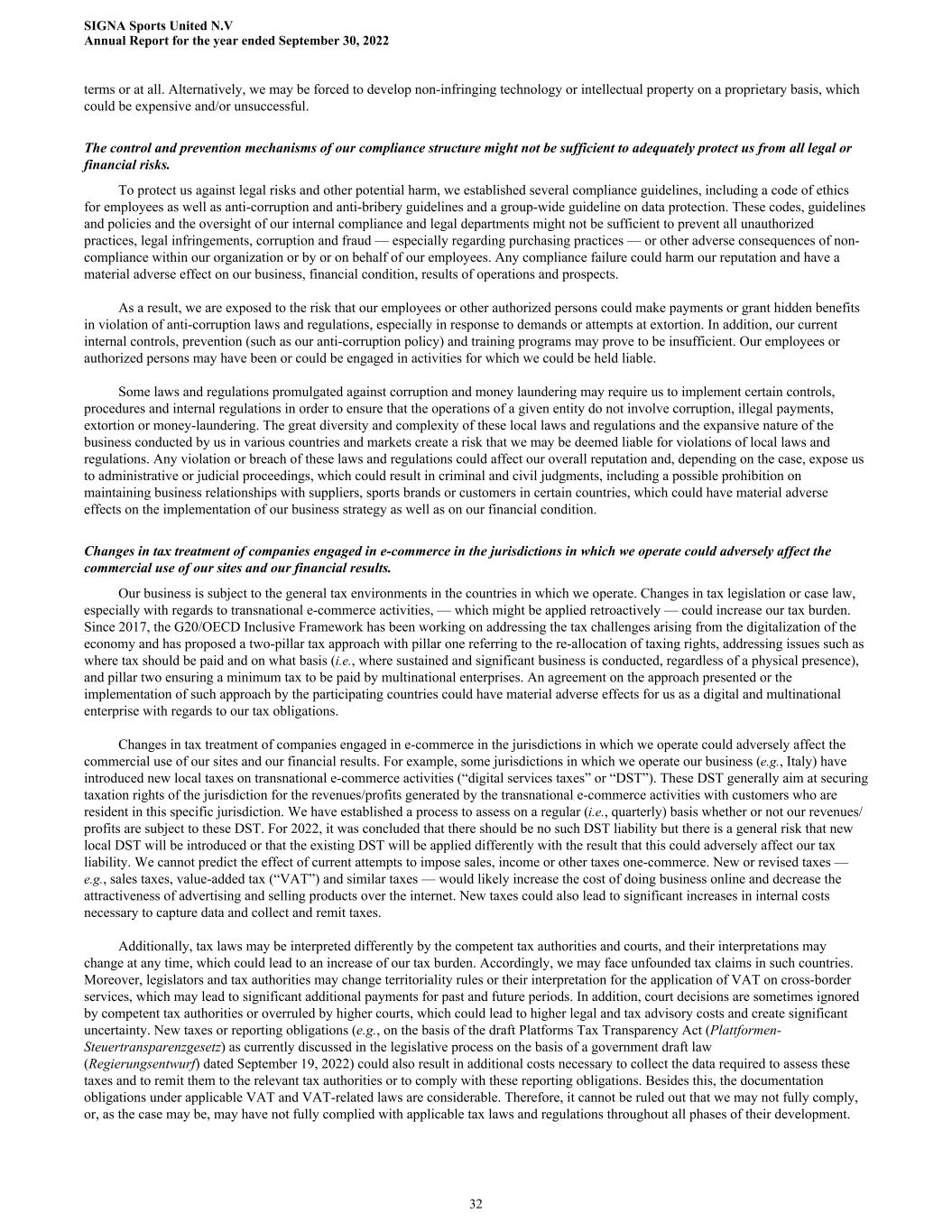
terms or at all. Alternatively, we may be forced to develop non-infringing technology or intellectual property on a proprietary basis, which could be expensive and/or unsuccessful. The control and prevention mechanisms of our compliance structure might not be sufficient to adequately protect us from all legal or financial risks. To protect us against legal risks and other potential harm, we established several compliance guidelines, including a code of ethics for employees as well as anti-corruption and anti-bribery guidelines and a group-wide guideline on data protection. These codes, guidelines and policies and the oversight of our internal compliance and legal departments might not be sufficient to prevent all unauthorized practices, legal infringements, corruption and fraud — especially regarding purchasing practices — or other adverse consequences of non- compliance within our organization or by or on behalf of our employees. Any compliance failure could harm our reputation and have a material adverse effect on our business, financial condition, results of operations and prospects. As a result, we are exposed to the risk that our employees or other authorized persons could make payments or grant hidden benefits in violation of anti-corruption laws and regulations, especially in response to demands or attempts at extortion. In addition, our current internal controls, prevention (such as our anti-corruption policy) and training programs may prove to be insufficient. Our employees or authorized persons may have been or could be engaged in activities for which we could be held liable. Some laws and regulations promulgated against corruption and money laundering may require us to implement certain controls, procedures and internal regulations in order to ensure that the operations of a given entity do not involve corruption, illegal payments, extortion or money-laundering. The great diversity and complexity of these local laws and regulations and the expansive nature of the business conducted by us in various countries and markets create a risk that we may be deemed liable for violations of local laws and regulations. Any violation or breach of these laws and regulations could affect our overall reputation and, depending on the case, expose us to administrative or judicial proceedings, which could result in criminal and civil judgments, including a possible prohibition on maintaining business relationships with suppliers, sports brands or customers in certain countries, which could have material adverse effects on the implementation of our business strategy as well as on our financial condition. Changes in tax treatment of companies engaged in e-commerce in the jurisdictions in which we operate could adversely affect the commercial use of our sites and our financial results. Our business is subject to the general tax environments in the countries in which we operate. Changes in tax legislation or case law, especially with regards to transnational e-commerce activities, — which might be applied retroactively — could increase our tax burden. Since 2017, the G20/OECD Inclusive Framework has been working on addressing the tax challenges arising from the digitalization of the economy and has proposed a two-pillar tax approach with pillar one referring to the re-allocation of taxing rights, addressing issues such as where tax should be paid and on what basis (i.e., where sustained and significant business is conducted, regardless of a physical presence), and pillar two ensuring a minimum tax to be paid by multinational enterprises. An agreement on the approach presented or the implementation of such approach by the participating countries could have material adverse effects for us as a digital and multinational enterprise with regards to our tax obligations. Changes in tax treatment of companies engaged in e-commerce in the jurisdictions in which we operate could adversely affect the commercial use of our sites and our financial results. For example, some jurisdictions in which we operate our business (e.g., Italy) have introduced new local taxes on transnational e-commerce activities (“digital services taxes” or “DST”). These DST generally aim at securing taxation rights of the jurisdiction for the revenues/profits generated by the transnational e-commerce activities with customers who are resident in this specific jurisdiction. We have established a process to assess on a regular (i.e., quarterly) basis whether or not our revenues/ profits are subject to these DST. For 2022, it was concluded that there should be no such DST liability but there is a general risk that new local DST will be introduced or that the existing DST will be applied differently with the result that this could adversely affect our tax liability. We cannot predict the effect of current attempts to impose sales, income or other taxes one-commerce. New or revised taxes — e.g., sales taxes, value-added tax (“VAT”) and similar taxes — would likely increase the cost of doing business online and decrease the attractiveness of advertising and selling products over the internet. New taxes could also lead to significant increases in internal costs necessary to capture data and collect and remit taxes. Additionally, tax laws may be interpreted differently by the competent tax authorities and courts, and their interpretations may change at any time, which could lead to an increase of our tax burden. Accordingly, we may face unfounded tax claims in such countries. Moreover, legislators and tax authorities may change territoriality rules or their interpretation for the application of VAT on cross-border services, which may lead to significant additional payments for past and future periods. In addition, court decisions are sometimes ignored by competent tax authorities or overruled by higher courts, which could lead to higher legal and tax advisory costs and create significant uncertainty. New taxes or reporting obligations (e.g., on the basis of the draft Platforms Tax Transparency Act (Plattformen- Steuertransparenzgesetz) as currently discussed in the legislative process on the basis of a government draft law (Regierungsentwurf) dated September 19, 2022) could also result in additional costs necessary to collect the data required to assess these taxes and to remit them to the relevant tax authorities or to comply with these reporting obligations. Besides this, the documentation obligations under applicable VAT and VAT-related laws are considerable. Therefore, it cannot be ruled out that we may not fully comply, or, as the case may be, may have not fully complied with applicable tax laws and regulations throughout all phases of their development. SIGNA Sports United N.V Annual Report for the year ended September 30, 2022 32
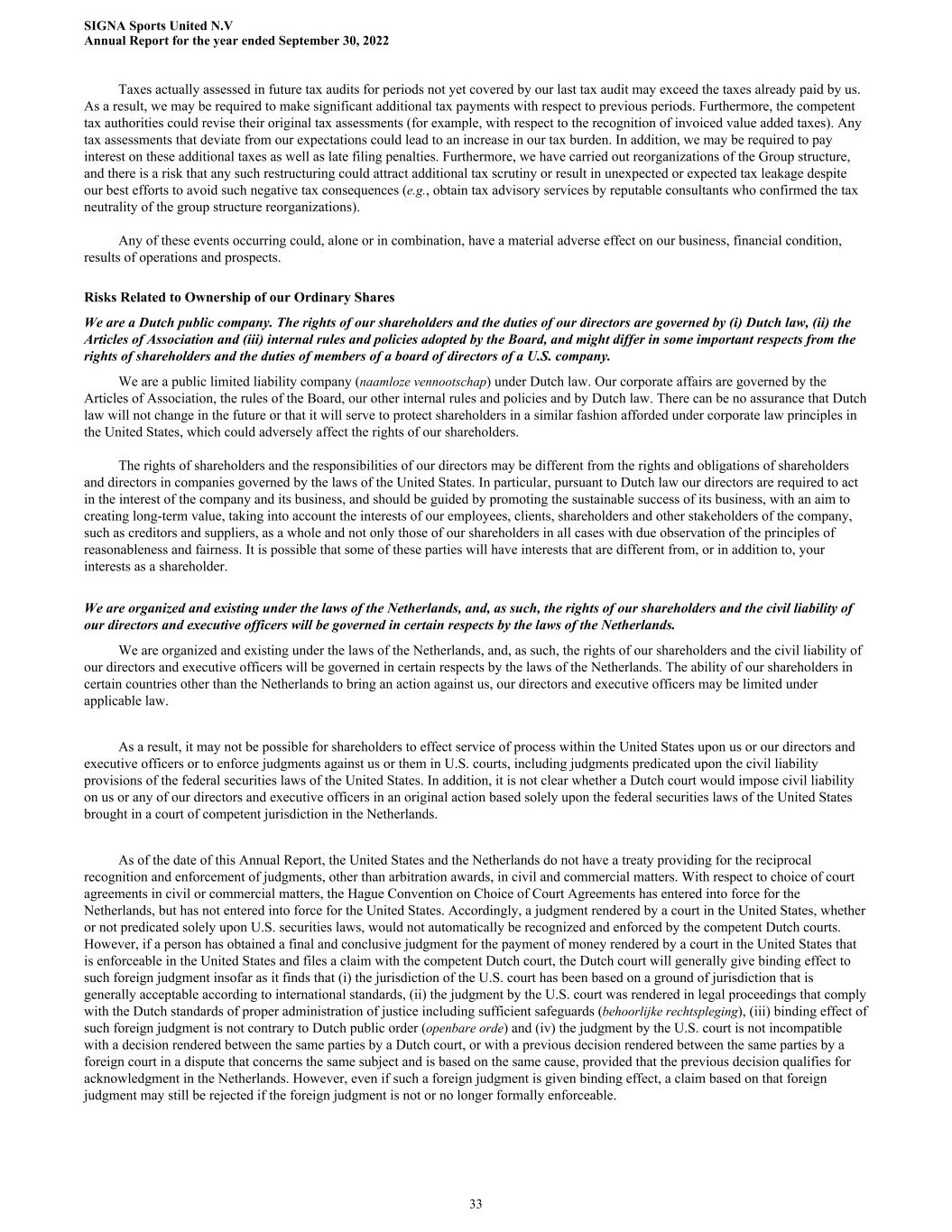
Taxes actually assessed in future tax audits for periods not yet covered by our last tax audit may exceed the taxes already paid by us. As a result, we may be required to make significant additional tax payments with respect to previous periods. Furthermore, the competent tax authorities could revise their original tax assessments (for example, with respect to the recognition of invoiced value added taxes). Any tax assessments that deviate from our expectations could lead to an increase in our tax burden. In addition, we may be required to pay interest on these additional taxes as well as late filing penalties. Furthermore, we have carried out reorganizations of the Group structure, and there is a risk that any such restructuring could attract additional tax scrutiny or result in unexpected or expected tax leakage despite our best efforts to avoid such negative tax consequences (e.g., obtain tax advisory services by reputable consultants who confirmed the tax neutrality of the group structure reorganizations). Any of these events occurring could, alone or in combination, have a material adverse effect on our business, financial condition, results of operations and prospects. Risks Related to Ownership of our Ordinary Shares We are a Dutch public company. The rights of our shareholders and the duties of our directors are governed by (i) Dutch law, (ii) the Articles of Association and (iii) internal rules and policies adopted by the Board, and might differ in some important respects from the rights of shareholders and the duties of members of a board of directors of a U.S. company. We are a public limited liability company (naamloze vennootschap) under Dutch law. Our corporate affairs are governed by the Articles of Association, the rules of the Board, our other internal rules and policies and by Dutch law. There can be no assurance that Dutch law will not change in the future or that it will serve to protect shareholders in a similar fashion afforded under corporate law principles in the United States, which could adversely affect the rights of our shareholders. The rights of shareholders and the responsibilities of our directors may be different from the rights and obligations of shareholders and directors in companies governed by the laws of the United States. In particular, pursuant to Dutch law our directors are required to act in the interest of the company and its business, and should be guided by promoting the sustainable success of its business, with an aim to creating long-term value, taking into account the interests of our employees, clients, shareholders and other stakeholders of the company, such as creditors and suppliers, as a whole and not only those of our shareholders in all cases with due observation of the principles of reasonableness and fairness. It is possible that some of these parties will have interests that are different from, or in addition to, your interests as a shareholder. We are organized and existing under the laws of the Netherlands, and, as such, the rights of our shareholders and the civil liability of our directors and executive officers will be governed in certain respects by the laws of the Netherlands. We are organized and existing under the laws of the Netherlands, and, as such, the rights of our shareholders and the civil liability of our directors and executive officers will be governed in certain respects by the laws of the Netherlands. The ability of our shareholders in certain countries other than the Netherlands to bring an action against us, our directors and executive officers may be limited under applicable law. As a result, it may not be possible for shareholders to effect service of process within the United States upon us or our directors and executive officers or to enforce judgments against us or them in U.S. courts, including judgments predicated upon the civil liability provisions of the federal securities laws of the United States. In addition, it is not clear whether a Dutch court would impose civil liability on us or any of our directors and executive officers in an original action based solely upon the federal securities laws of the United States brought in a court of competent jurisdiction in the Netherlands. As of the date of this Annual Report, the United States and the Netherlands do not have a treaty providing for the reciprocal recognition and enforcement of judgments, other than arbitration awards, in civil and commercial matters. With respect to choice of court agreements in civil or commercial matters, the Hague Convention on Choice of Court Agreements has entered into force for the Netherlands, but has not entered into force for the United States. Accordingly, a judgment rendered by a court in the United States, whether or not predicated solely upon U.S. securities laws, would not automatically be recognized and enforced by the competent Dutch courts. However, if a person has obtained a final and conclusive judgment for the payment of money rendered by a court in the United States that is enforceable in the United States and files a claim with the competent Dutch court, the Dutch court will generally give binding effect to such foreign judgment insofar as it finds that (i) the jurisdiction of the U.S. court has been based on a ground of jurisdiction that is generally acceptable according to international standards, (ii) the judgment by the U.S. court was rendered in legal proceedings that comply with the Dutch standards of proper administration of justice including sufficient safeguards (behoorlijke rechtspleging), (iii) binding effect of such foreign judgment is not contrary to Dutch public order (openbare orde) and (iv) the judgment by the U.S. court is not incompatible with a decision rendered between the same parties by a Dutch court, or with a previous decision rendered between the same parties by a foreign court in a dispute that concerns the same subject and is based on the same cause, provided that the previous decision qualifies for acknowledgment in the Netherlands. However, even if such a foreign judgment is given binding effect, a claim based on that foreign judgment may still be rejected if the foreign judgment is not or no longer formally enforceable. SIGNA Sports United N.V Annual Report for the year ended September 30, 2022 33
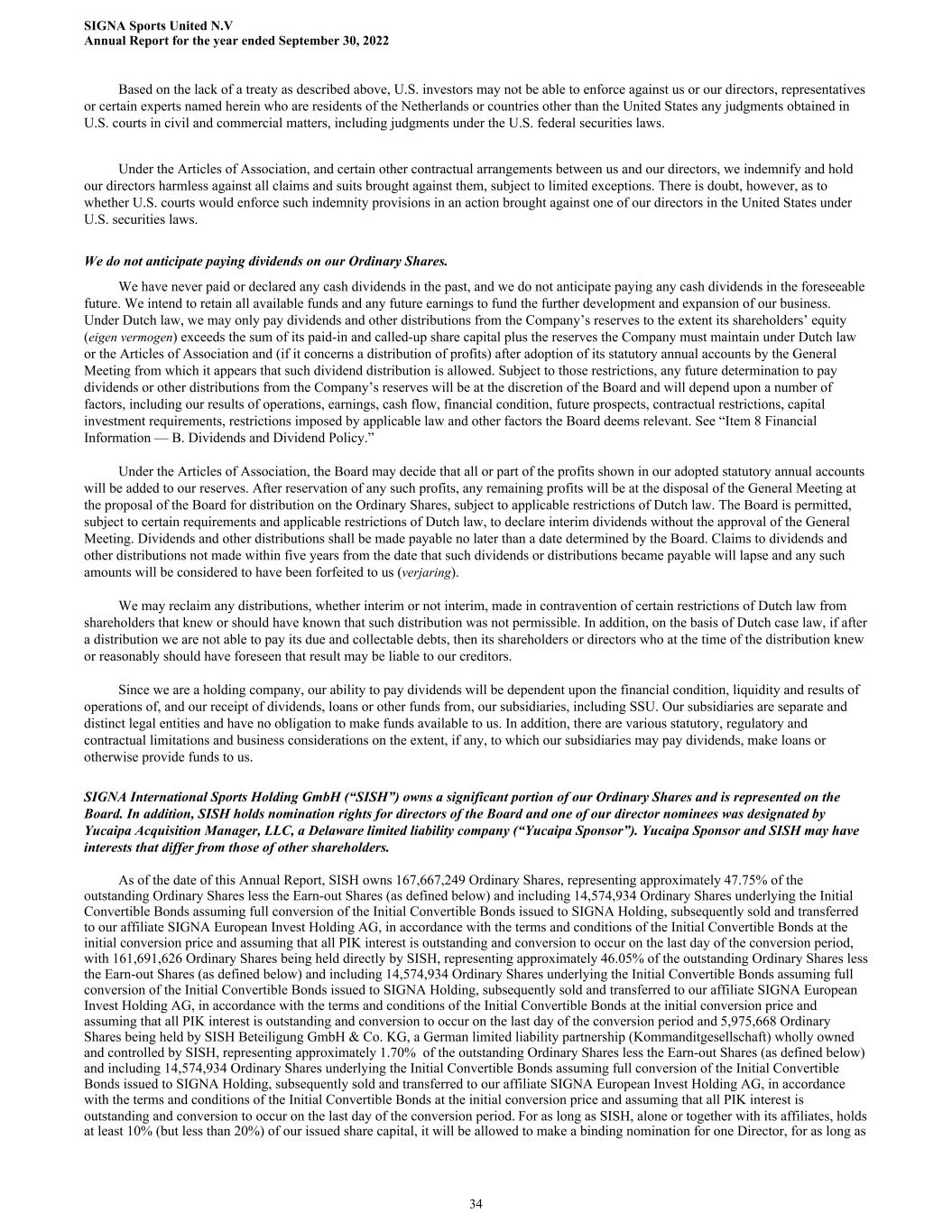
Based on the lack of a treaty as described above, U.S. investors may not be able to enforce against us or our directors, representatives or certain experts named herein who are residents of the Netherlands or countries other than the United States any judgments obtained in U.S. courts in civil and commercial matters, including judgments under the U.S. federal securities laws. Under the Articles of Association, and certain other contractual arrangements between us and our directors, we indemnify and hold our directors harmless against all claims and suits brought against them, subject to limited exceptions. There is doubt, however, as to whether U.S. courts would enforce such indemnity provisions in an action brought against one of our directors in the United States under U.S. securities laws. We do not anticipate paying dividends on our Ordinary Shares. We have never paid or declared any cash dividends in the past, and we do not anticipate paying any cash dividends in the foreseeable future. We intend to retain all available funds and any future earnings to fund the further development and expansion of our business. Under Dutch law, we may only pay dividends and other distributions from the Company’s reserves to the extent its shareholders’ equity (eigen vermogen) exceeds the sum of its paid-in and called-up share capital plus the reserves the Company must maintain under Dutch law or the Articles of Association and (if it concerns a distribution of profits) after adoption of its statutory annual accounts by the General Meeting from which it appears that such dividend distribution is allowed. Subject to those restrictions, any future determination to pay dividends or other distributions from the Company’s reserves will be at the discretion of the Board and will depend upon a number of factors, including our results of operations, earnings, cash flow, financial condition, future prospects, contractual restrictions, capital investment requirements, restrictions imposed by applicable law and other factors the Board deems relevant. See “Item 8 Financial Information — B. Dividends and Dividend Policy.” Under the Articles of Association, the Board may decide that all or part of the profits shown in our adopted statutory annual accounts will be added to our reserves. After reservation of any such profits, any remaining profits will be at the disposal of the General Meeting at the proposal of the Board for distribution on the Ordinary Shares, subject to applicable restrictions of Dutch law. The Board is permitted, subject to certain requirements and applicable restrictions of Dutch law, to declare interim dividends without the approval of the General Meeting. Dividends and other distributions shall be made payable no later than a date determined by the Board. Claims to dividends and other distributions not made within five years from the date that such dividends or distributions became payable will lapse and any such amounts will be considered to have been forfeited to us (verjaring). We may reclaim any distributions, whether interim or not interim, made in contravention of certain restrictions of Dutch law from shareholders that knew or should have known that such distribution was not permissible. In addition, on the basis of Dutch case law, if after a distribution we are not able to pay its due and collectable debts, then its shareholders or directors who at the time of the distribution knew or reasonably should have foreseen that result may be liable to our creditors. Since we are a holding company, our ability to pay dividends will be dependent upon the financial condition, liquidity and results of operations of, and our receipt of dividends, loans or other funds from, our subsidiaries, including SSU. Our subsidiaries are separate and distinct legal entities and have no obligation to make funds available to us. In addition, there are various statutory, regulatory and contractual limitations and business considerations on the extent, if any, to which our subsidiaries may pay dividends, make loans or otherwise provide funds to us. SIGNA International Sports Holding GmbH (“SISH”) owns a significant portion of our Ordinary Shares and is represented on the Board. In addition, SISH holds nomination rights for directors of the Board and one of our director nominees was designated by Yucaipa Acquisition Manager, LLC, a Delaware limited liability company (“Yucaipa Sponsor”). Yucaipa Sponsor and SISH may have interests that differ from those of other shareholders. As of the date of this Annual Report, SISH owns 167,667,249 Ordinary Shares, representing approximately 47.75% of the outstanding Ordinary Shares less the Earn-out Shares (as defined below) and including 14,574,934 Ordinary Shares underlying the Initial Convertible Bonds assuming full conversion of the Initial Convertible Bonds issued to SIGNA Holding, subsequently sold and transferred to our affiliate SIGNA European Invest Holding AG, in accordance with the terms and conditions of the Initial Convertible Bonds at the initial conversion price and assuming that all PIK interest is outstanding and conversion to occur on the last day of the conversion period, with 161,691,626 Ordinary Shares being held directly by SISH, representing approximately 46.05% of the outstanding Ordinary Shares less the Earn-out Shares (as defined below) and including 14,574,934 Ordinary Shares underlying the Initial Convertible Bonds assuming full conversion of the Initial Convertible Bonds issued to SIGNA Holding, subsequently sold and transferred to our affiliate SIGNA European Invest Holding AG, in accordance with the terms and conditions of the Initial Convertible Bonds at the initial conversion price and assuming that all PIK interest is outstanding and conversion to occur on the last day of the conversion period and 5,975,668 Ordinary Shares being held by SISH Beteiligung GmbH & Co. KG, a German limited liability partnership (Kommanditgesellschaft) wholly owned and controlled by SISH, representing approximately 1.70% of the outstanding Ordinary Shares less the Earn-out Shares (as defined below) and including 14,574,934 Ordinary Shares underlying the Initial Convertible Bonds assuming full conversion of the Initial Convertible Bonds issued to SIGNA Holding, subsequently sold and transferred to our affiliate SIGNA European Invest Holding AG, in accordance with the terms and conditions of the Initial Convertible Bonds at the initial conversion price and assuming that all PIK interest is outstanding and conversion to occur on the last day of the conversion period. For as long as SISH, alone or together with its affiliates, holds at least 10% (but less than 20%) of our issued share capital, it will be allowed to make a binding nomination for one Director, for as long as SIGNA Sports United N.V Annual Report for the year ended September 30, 2022 34
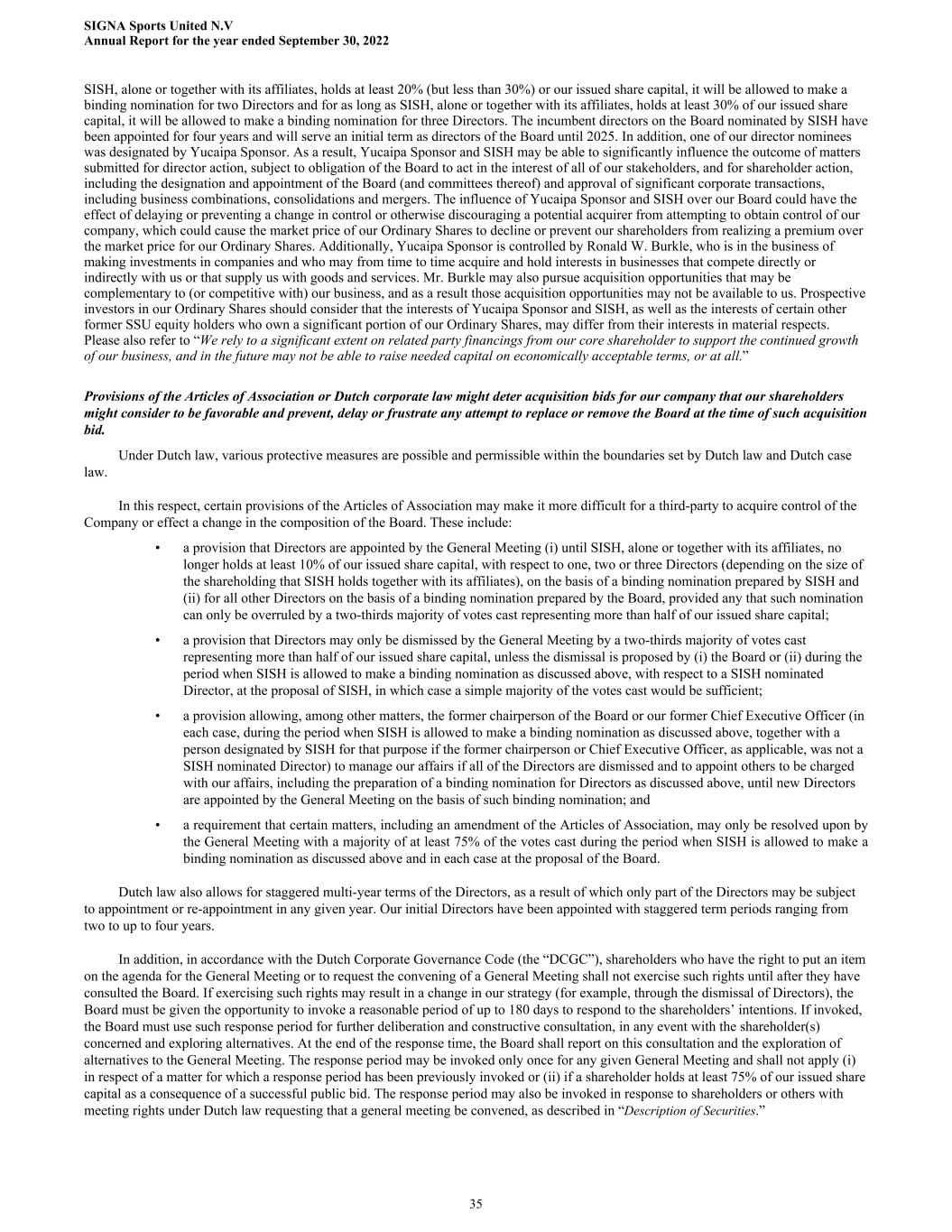
SISH, alone or together with its affiliates, holds at least 20% (but less than 30%) or our issued share capital, it will be allowed to make a binding nomination for two Directors and for as long as SISH, alone or together with its affiliates, holds at least 30% of our issued share capital, it will be allowed to make a binding nomination for three Directors. The incumbent directors on the Board nominated by SISH have been appointed for four years and will serve an initial term as directors of the Board until 2025. In addition, one of our director nominees was designated by Yucaipa Sponsor. As a result, Yucaipa Sponsor and SISH may be able to significantly influence the outcome of matters submitted for director action, subject to obligation of the Board to act in the interest of all of our stakeholders, and for shareholder action, including the designation and appointment of the Board (and committees thereof) and approval of significant corporate transactions, including business combinations, consolidations and mergers. The influence of Yucaipa Sponsor and SISH over our Board could have the effect of delaying or preventing a change in control or otherwise discouraging a potential acquirer from attempting to obtain control of our company, which could cause the market price of our Ordinary Shares to decline or prevent our shareholders from realizing a premium over the market price for our Ordinary Shares. Additionally, Yucaipa Sponsor is controlled by Ronald W. Burkle, who is in the business of making investments in companies and who may from time to time acquire and hold interests in businesses that compete directly or indirectly with us or that supply us with goods and services. Mr. Burkle may also pursue acquisition opportunities that may be complementary to (or competitive with) our business, and as a result those acquisition opportunities may not be available to us. Prospective investors in our Ordinary Shares should consider that the interests of Yucaipa Sponsor and SISH, as well as the interests of certain other former SSU equity holders who own a significant portion of our Ordinary Shares, may differ from their interests in material respects. Please also refer to “We rely to a significant extent on related party financings from our core shareholder to support the continued growth of our business, and in the future may not be able to raise needed capital on economically acceptable terms, or at all.” Provisions of the Articles of Association or Dutch corporate law might deter acquisition bids for our company that our shareholders might consider to be favorable and prevent, delay or frustrate any attempt to replace or remove the Board at the time of such acquisition bid. Under Dutch law, various protective measures are possible and permissible within the boundaries set by Dutch law and Dutch case law. In this respect, certain provisions of the Articles of Association may make it more difficult for a third-party to acquire control of the Company or effect a change in the composition of the Board. These include: • a provision that Directors are appointed by the General Meeting (i) until SISH, alone or together with its affiliates, no longer holds at least 10% of our issued share capital, with respect to one, two or three Directors (depending on the size of the shareholding that SISH holds together with its affiliates), on the basis of a binding nomination prepared by SISH and (ii) for all other Directors on the basis of a binding nomination prepared by the Board, provided any that such nomination can only be overruled by a two-thirds majority of votes cast representing more than half of our issued share capital; • a provision that Directors may only be dismissed by the General Meeting by a two-thirds majority of votes cast representing more than half of our issued share capital, unless the dismissal is proposed by (i) the Board or (ii) during the period when SISH is allowed to make a binding nomination as discussed above, with respect to a SISH nominated Director, at the proposal of SISH, in which case a simple majority of the votes cast would be sufficient; • a provision allowing, among other matters, the former chairperson of the Board or our former Chief Executive Officer (in each case, during the period when SISH is allowed to make a binding nomination as discussed above, together with a person designated by SISH for that purpose if the former chairperson or Chief Executive Officer, as applicable, was not a SISH nominated Director) to manage our affairs if all of the Directors are dismissed and to appoint others to be charged with our affairs, including the preparation of a binding nomination for Directors as discussed above, until new Directors are appointed by the General Meeting on the basis of such binding nomination; and • a requirement that certain matters, including an amendment of the Articles of Association, may only be resolved upon by the General Meeting with a majority of at least 75% of the votes cast during the period when SISH is allowed to make a binding nomination as discussed above and in each case at the proposal of the Board. Dutch law also allows for staggered multi-year terms of the Directors, as a result of which only part of the Directors may be subject to appointment or re-appointment in any given year. Our initial Directors have been appointed with staggered term periods ranging from two to up to four years. In addition, in accordance with the Dutch Corporate Governance Code (the “DCGC”), shareholders who have the right to put an item on the agenda for the General Meeting or to request the convening of a General Meeting shall not exercise such rights until after they have consulted the Board. If exercising such rights may result in a change in our strategy (for example, through the dismissal of Directors), the Board must be given the opportunity to invoke a reasonable period of up to 180 days to respond to the shareholders’ intentions. If invoked, the Board must use such response period for further deliberation and constructive consultation, in any event with the shareholder(s) concerned and exploring alternatives. At the end of the response time, the Board shall report on this consultation and the exploration of alternatives to the General Meeting. The response period may be invoked only once for any given General Meeting and shall not apply (i) in respect of a matter for which a response period has been previously invoked or (ii) if a shareholder holds at least 75% of our issued share capital as a consequence of a successful public bid. The response period may also be invoked in response to shareholders or others with meeting rights under Dutch law requesting that a general meeting be convened, as described in “Description of Securities.” SIGNA Sports United N.V Annual Report for the year ended September 30, 2022 35
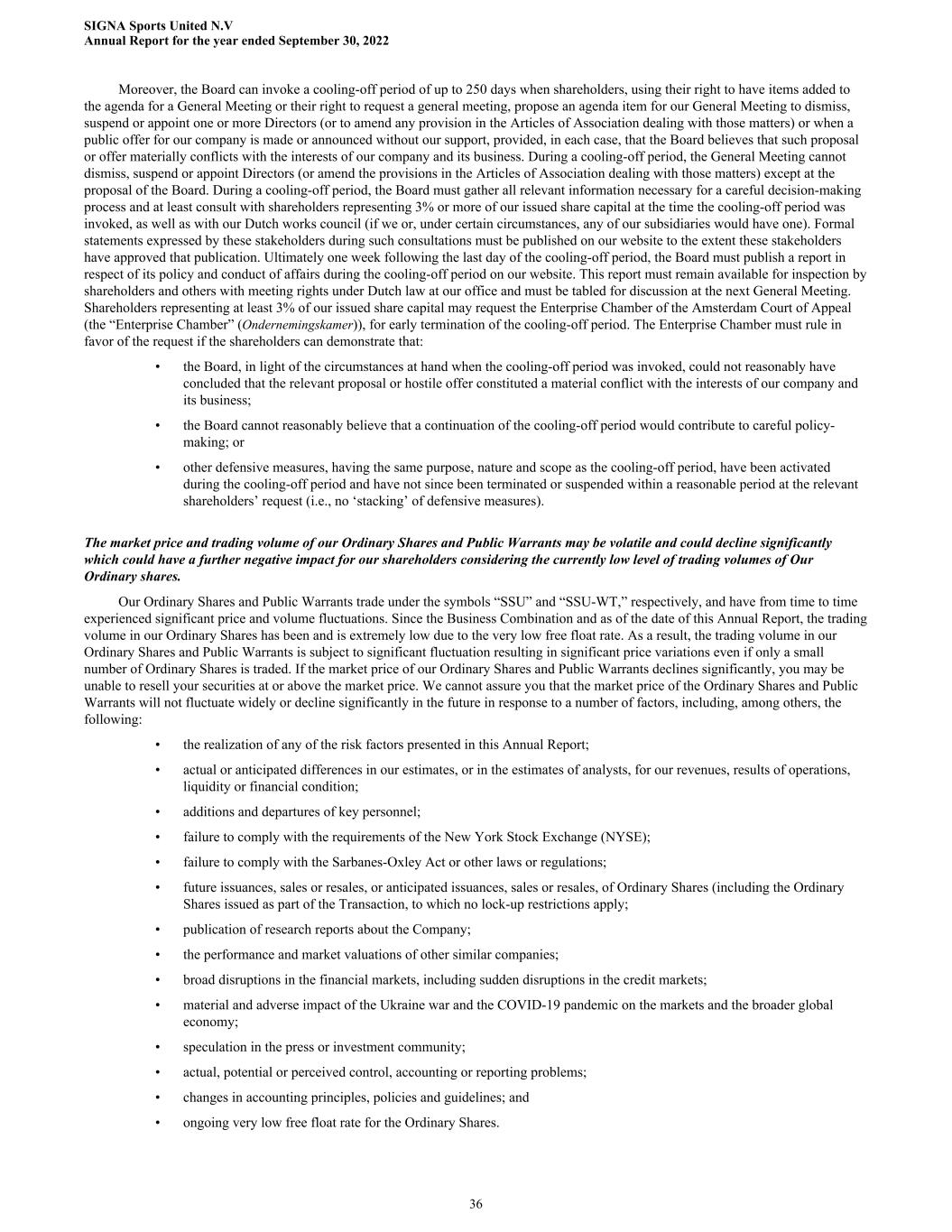
Moreover, the Board can invoke a cooling-off period of up to 250 days when shareholders, using their right to have items added to the agenda for a General Meeting or their right to request a general meeting, propose an agenda item for our General Meeting to dismiss, suspend or appoint one or more Directors (or to amend any provision in the Articles of Association dealing with those matters) or when a public offer for our company is made or announced without our support, provided, in each case, that the Board believes that such proposal or offer materially conflicts with the interests of our company and its business. During a cooling-off period, the General Meeting cannot dismiss, suspend or appoint Directors (or amend the provisions in the Articles of Association dealing with those matters) except at the proposal of the Board. During a cooling-off period, the Board must gather all relevant information necessary for a careful decision-making process and at least consult with shareholders representing 3% or more of our issued share capital at the time the cooling-off period was invoked, as well as with our Dutch works council (if we or, under certain circumstances, any of our subsidiaries would have one). Formal statements expressed by these stakeholders during such consultations must be published on our website to the extent these stakeholders have approved that publication. Ultimately one week following the last day of the cooling-off period, the Board must publish a report in respect of its policy and conduct of affairs during the cooling-off period on our website. This report must remain available for inspection by shareholders and others with meeting rights under Dutch law at our office and must be tabled for discussion at the next General Meeting. Shareholders representing at least 3% of our issued share capital may request the Enterprise Chamber of the Amsterdam Court of Appeal (the “Enterprise Chamber” (Ondernemingskamer)), for early termination of the cooling-off period. The Enterprise Chamber must rule in favor of the request if the shareholders can demonstrate that: • the Board, in light of the circumstances at hand when the cooling-off period was invoked, could not reasonably have concluded that the relevant proposal or hostile offer constituted a material conflict with the interests of our company and its business; • the Board cannot reasonably believe that a continuation of the cooling-off period would contribute to careful policy- making; or • other defensive measures, having the same purpose, nature and scope as the cooling-off period, have been activated during the cooling-off period and have not since been terminated or suspended within a reasonable period at the relevant shareholders’ request (i.e., no ‘stacking’ of defensive measures). The market price and trading volume of our Ordinary Shares and Public Warrants may be volatile and could decline significantly which could have a further negative impact for our shareholders considering the currently low level of trading volumes of Our Ordinary shares. Our Ordinary Shares and Public Warrants trade under the symbols “SSU” and “SSU-WT,” respectively, and have from time to time experienced significant price and volume fluctuations. Since the Business Combination and as of the date of this Annual Report, the trading volume in our Ordinary Shares has been and is extremely low due to the very low free float rate. As a result, the trading volume in our Ordinary Shares and Public Warrants is subject to significant fluctuation resulting in significant price variations even if only a small number of Ordinary Shares is traded. If the market price of our Ordinary Shares and Public Warrants declines significantly, you may be unable to resell your securities at or above the market price. We cannot assure you that the market price of the Ordinary Shares and Public Warrants will not fluctuate widely or decline significantly in the future in response to a number of factors, including, among others, the following: • the realization of any of the risk factors presented in this Annual Report; • actual or anticipated differences in our estimates, or in the estimates of analysts, for our revenues, results of operations, liquidity or financial condition; • additions and departures of key personnel; • failure to comply with the requirements of the New York Stock Exchange (NYSE); • failure to comply with the Sarbanes-Oxley Act or other laws or regulations; • future issuances, sales or resales, or anticipated issuances, sales or resales, of Ordinary Shares (including the Ordinary Shares issued as part of the Transaction, to which no lock-up restrictions apply; • publication of research reports about the Company; • the performance and market valuations of other similar companies; • broad disruptions in the financial markets, including sudden disruptions in the credit markets; • material and adverse impact of the Ukraine war and the COVID-19 pandemic on the markets and the broader global economy; • speculation in the press or investment community; • actual, potential or perceived control, accounting or reporting problems; • changes in accounting principles, policies and guidelines; and • ongoing very low free float rate for the Ordinary Shares. SIGNA Sports United N.V Annual Report for the year ended September 30, 2022 36
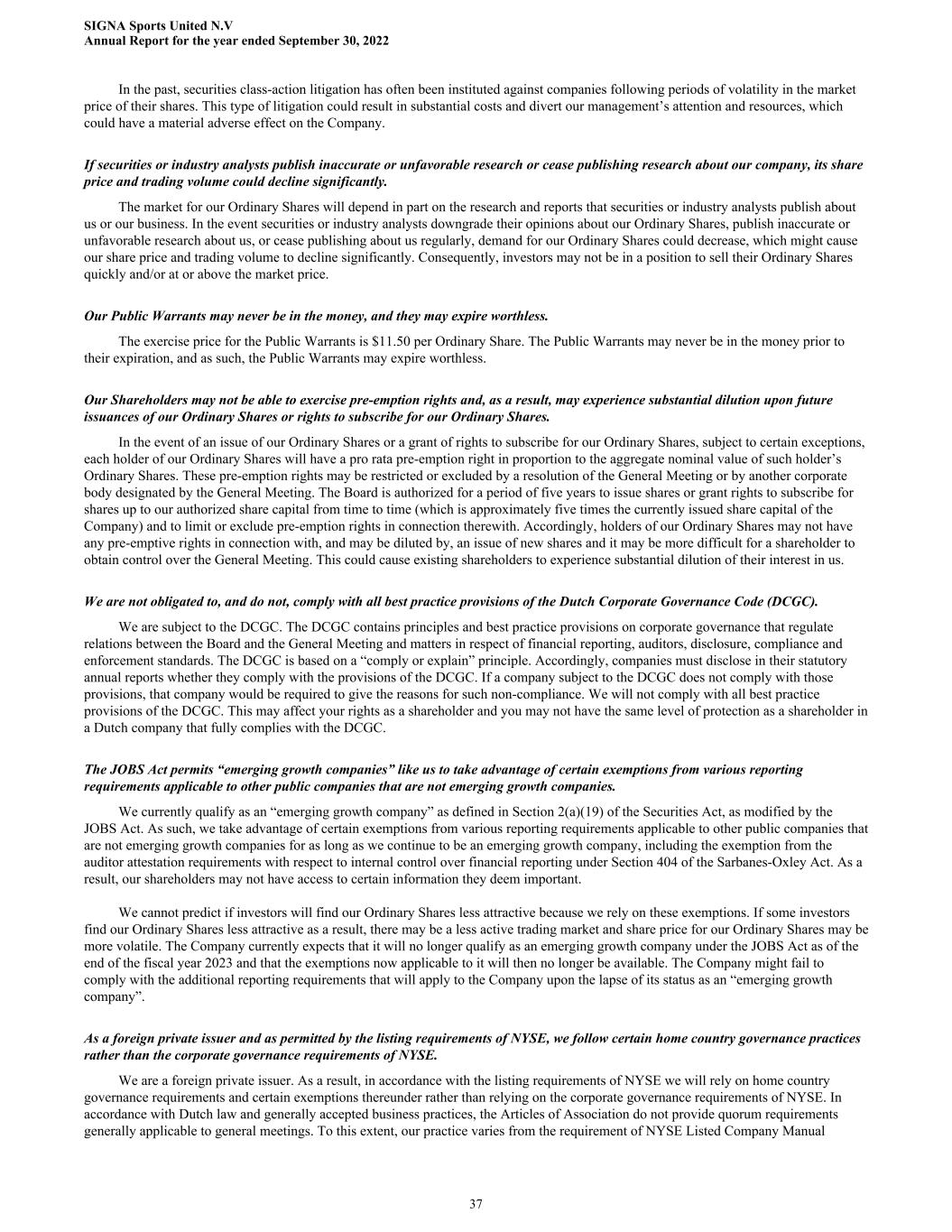
In the past, securities class-action litigation has often been instituted against companies following periods of volatility in the market price of their shares. This type of litigation could result in substantial costs and divert our management’s attention and resources, which could have a material adverse effect on the Company. If securities or industry analysts publish inaccurate or unfavorable research or cease publishing research about our company, its share price and trading volume could decline significantly. The market for our Ordinary Shares will depend in part on the research and reports that securities or industry analysts publish about us or our business. In the event securities or industry analysts downgrade their opinions about our Ordinary Shares, publish inaccurate or unfavorable research about us, or cease publishing about us regularly, demand for our Ordinary Shares could decrease, which might cause our share price and trading volume to decline significantly. Consequently, investors may not be in a position to sell their Ordinary Shares quickly and/or at or above the market price. Our Public Warrants may never be in the money, and they may expire worthless. The exercise price for the Public Warrants is $11.50 per Ordinary Share. The Public Warrants may never be in the money prior to their expiration, and as such, the Public Warrants may expire worthless. Our Shareholders may not be able to exercise pre-emption rights and, as a result, may experience substantial dilution upon future issuances of our Ordinary Shares or rights to subscribe for our Ordinary Shares. In the event of an issue of our Ordinary Shares or a grant of rights to subscribe for our Ordinary Shares, subject to certain exceptions, each holder of our Ordinary Shares will have a pro rata pre-emption right in proportion to the aggregate nominal value of such holder’s Ordinary Shares. These pre-emption rights may be restricted or excluded by a resolution of the General Meeting or by another corporate body designated by the General Meeting. The Board is authorized for a period of five years to issue shares or grant rights to subscribe for shares up to our authorized share capital from time to time (which is approximately five times the currently issued share capital of the Company) and to limit or exclude pre-emption rights in connection therewith. Accordingly, holders of our Ordinary Shares may not have any pre-emptive rights in connection with, and may be diluted by, an issue of new shares and it may be more difficult for a shareholder to obtain control over the General Meeting. This could cause existing shareholders to experience substantial dilution of their interest in us. We are not obligated to, and do not, comply with all best practice provisions of the Dutch Corporate Governance Code (DCGC). We are subject to the DCGC. The DCGC contains principles and best practice provisions on corporate governance that regulate relations between the Board and the General Meeting and matters in respect of financial reporting, auditors, disclosure, compliance and enforcement standards. The DCGC is based on a “comply or explain” principle. Accordingly, companies must disclose in their statutory annual reports whether they comply with the provisions of the DCGC. If a company subject to the DCGC does not comply with those provisions, that company would be required to give the reasons for such non-compliance. We will not comply with all best practice provisions of the DCGC. This may affect your rights as a shareholder and you may not have the same level of protection as a shareholder in a Dutch company that fully complies with the DCGC. The JOBS Act permits “emerging growth companies” like us to take advantage of certain exemptions from various reporting requirements applicable to other public companies that are not emerging growth companies. We currently qualify as an “emerging growth company” as defined in Section 2(a)(19) of the Securities Act, as modified by the JOBS Act. As such, we take advantage of certain exemptions from various reporting requirements applicable to other public companies that are not emerging growth companies for as long as we continue to be an emerging growth company, including the exemption from the auditor attestation requirements with respect to internal control over financial reporting under Section 404 of the Sarbanes-Oxley Act. As a result, our shareholders may not have access to certain information they deem important. We cannot predict if investors will find our Ordinary Shares less attractive because we rely on these exemptions. If some investors find our Ordinary Shares less attractive as a result, there may be a less active trading market and share price for our Ordinary Shares may be more volatile. The Company currently expects that it will no longer qualify as an emerging growth company under the JOBS Act as of the end of the fiscal year 2023 and that the exemptions now applicable to it will then no longer be available. The Company might fail to comply with the additional reporting requirements that will apply to the Company upon the lapse of its status as an “emerging growth company”. As a foreign private issuer and as permitted by the listing requirements of NYSE, we follow certain home country governance practices rather than the corporate governance requirements of NYSE. We are a foreign private issuer. As a result, in accordance with the listing requirements of NYSE we will rely on home country governance requirements and certain exemptions thereunder rather than relying on the corporate governance requirements of NYSE. In accordance with Dutch law and generally accepted business practices, the Articles of Association do not provide quorum requirements generally applicable to general meetings. To this extent, our practice varies from the requirement of NYSE Listed Company Manual SIGNA Sports United N.V Annual Report for the year ended September 30, 2022 37
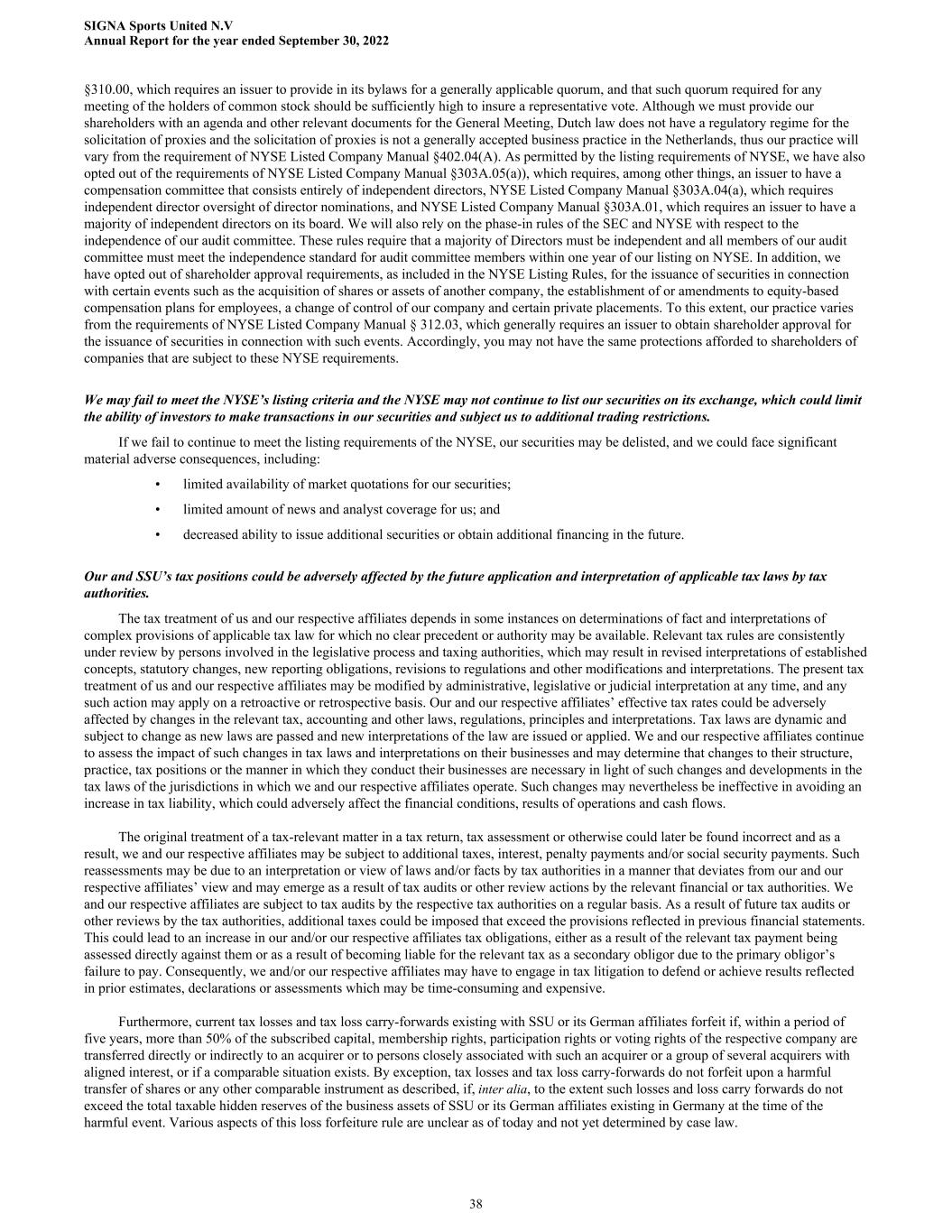
§310.00, which requires an issuer to provide in its bylaws for a generally applicable quorum, and that such quorum required for any meeting of the holders of common stock should be sufficiently high to insure a representative vote. Although we must provide our shareholders with an agenda and other relevant documents for the General Meeting, Dutch law does not have a regulatory regime for the solicitation of proxies and the solicitation of proxies is not a generally accepted business practice in the Netherlands, thus our practice will vary from the requirement of NYSE Listed Company Manual §402.04(A). As permitted by the listing requirements of NYSE, we have also opted out of the requirements of NYSE Listed Company Manual §303A.05(a)), which requires, among other things, an issuer to have a compensation committee that consists entirely of independent directors, NYSE Listed Company Manual §303A.04(a), which requires independent director oversight of director nominations, and NYSE Listed Company Manual §303A.01, which requires an issuer to have a majority of independent directors on its board. We will also rely on the phase-in rules of the SEC and NYSE with respect to the independence of our audit committee. These rules require that a majority of Directors must be independent and all members of our audit committee must meet the independence standard for audit committee members within one year of our listing on NYSE. In addition, we have opted out of shareholder approval requirements, as included in the NYSE Listing Rules, for the issuance of securities in connection with certain events such as the acquisition of shares or assets of another company, the establishment of or amendments to equity-based compensation plans for employees, a change of control of our company and certain private placements. To this extent, our practice varies from the requirements of NYSE Listed Company Manual § 312.03, which generally requires an issuer to obtain shareholder approval for the issuance of securities in connection with such events. Accordingly, you may not have the same protections afforded to shareholders of companies that are subject to these NYSE requirements. We may fail to meet the NYSE’s listing criteria and the NYSE may not continue to list our securities on its exchange, which could limit the ability of investors to make transactions in our securities and subject us to additional trading restrictions. If we fail to continue to meet the listing requirements of the NYSE, our securities may be delisted, and we could face significant material adverse consequences, including: • limited availability of market quotations for our securities; • limited amount of news and analyst coverage for us; and • decreased ability to issue additional securities or obtain additional financing in the future. Our and SSU’s tax positions could be adversely affected by the future application and interpretation of applicable tax laws by tax authorities. The tax treatment of us and our respective affiliates depends in some instances on determinations of fact and interpretations of complex provisions of applicable tax law for which no clear precedent or authority may be available. Relevant tax rules are consistently under review by persons involved in the legislative process and taxing authorities, which may result in revised interpretations of established concepts, statutory changes, new reporting obligations, revisions to regulations and other modifications and interpretations. The present tax treatment of us and our respective affiliates may be modified by administrative, legislative or judicial interpretation at any time, and any such action may apply on a retroactive or retrospective basis. Our and our respective affiliates’ effective tax rates could be adversely affected by changes in the relevant tax, accounting and other laws, regulations, principles and interpretations. Tax laws are dynamic and subject to change as new laws are passed and new interpretations of the law are issued or applied. We and our respective affiliates continue to assess the impact of such changes in tax laws and interpretations on their businesses and may determine that changes to their structure, practice, tax positions or the manner in which they conduct their businesses are necessary in light of such changes and developments in the tax laws of the jurisdictions in which we and our respective affiliates operate. Such changes may nevertheless be ineffective in avoiding an increase in tax liability, which could adversely affect the financial conditions, results of operations and cash flows. The original treatment of a tax-relevant matter in a tax return, tax assessment or otherwise could later be found incorrect and as a result, we and our respective affiliates may be subject to additional taxes, interest, penalty payments and/or social security payments. Such reassessments may be due to an interpretation or view of laws and/or facts by tax authorities in a manner that deviates from our and our respective affiliates’ view and may emerge as a result of tax audits or other review actions by the relevant financial or tax authorities. We and our respective affiliates are subject to tax audits by the respective tax authorities on a regular basis. As a result of future tax audits or other reviews by the tax authorities, additional taxes could be imposed that exceed the provisions reflected in previous financial statements. This could lead to an increase in our and/or our respective affiliates tax obligations, either as a result of the relevant tax payment being assessed directly against them or as a result of becoming liable for the relevant tax as a secondary obligor due to the primary obligor’s failure to pay. Consequently, we and/or our respective affiliates may have to engage in tax litigation to defend or achieve results reflected in prior estimates, declarations or assessments which may be time-consuming and expensive. Furthermore, current tax losses and tax loss carry-forwards existing with SSU or its German affiliates forfeit if, within a period of five years, more than 50% of the subscribed capital, membership rights, participation rights or voting rights of the respective company are transferred directly or indirectly to an acquirer or to persons closely associated with such an acquirer or a group of several acquirers with aligned interest, or if a comparable situation exists. By exception, tax losses and tax loss carry-forwards do not forfeit upon a harmful transfer of shares or any other comparable instrument as described, if, inter alia, to the extent such losses and loss carry forwards do not exceed the total taxable hidden reserves of the business assets of SSU or its German affiliates existing in Germany at the time of the harmful event. Various aspects of this loss forfeiture rule are unclear as of today and not yet determined by case law. SIGNA Sports United N.V Annual Report for the year ended September 30, 2022 38
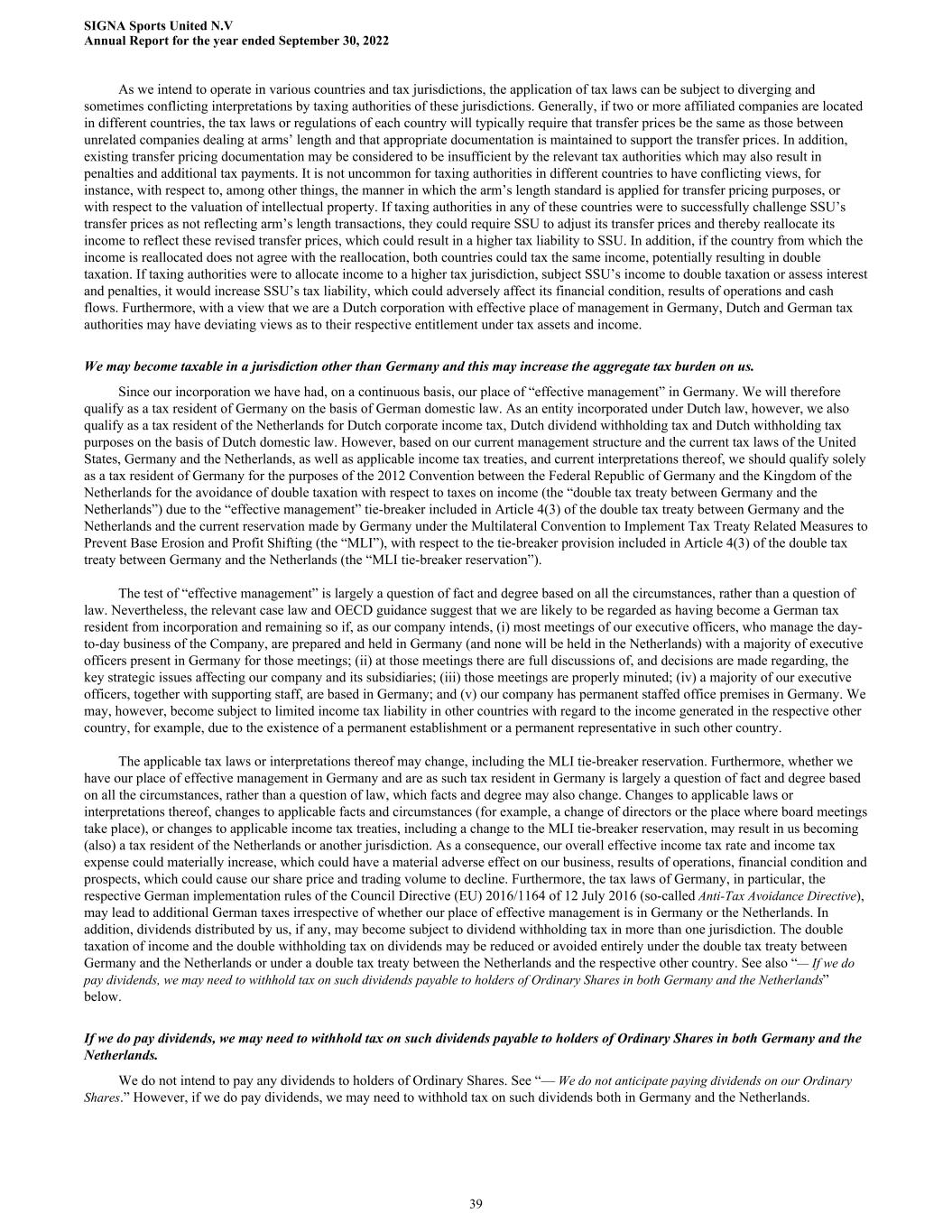
As we intend to operate in various countries and tax jurisdictions, the application of tax laws can be subject to diverging and sometimes conflicting interpretations by taxing authorities of these jurisdictions. Generally, if two or more affiliated companies are located in different countries, the tax laws or regulations of each country will typically require that transfer prices be the same as those between unrelated companies dealing at arms’ length and that appropriate documentation is maintained to support the transfer prices. In addition, existing transfer pricing documentation may be considered to be insufficient by the relevant tax authorities which may also result in penalties and additional tax payments. It is not uncommon for taxing authorities in different countries to have conflicting views, for instance, with respect to, among other things, the manner in which the arm’s length standard is applied for transfer pricing purposes, or with respect to the valuation of intellectual property. If taxing authorities in any of these countries were to successfully challenge SSU’s transfer prices as not reflecting arm’s length transactions, they could require SSU to adjust its transfer prices and thereby reallocate its income to reflect these revised transfer prices, which could result in a higher tax liability to SSU. In addition, if the country from which the income is reallocated does not agree with the reallocation, both countries could tax the same income, potentially resulting in double taxation. If taxing authorities were to allocate income to a higher tax jurisdiction, subject SSU’s income to double taxation or assess interest and penalties, it would increase SSU’s tax liability, which could adversely affect its financial condition, results of operations and cash flows. Furthermore, with a view that we are a Dutch corporation with effective place of management in Germany, Dutch and German tax authorities may have deviating views as to their respective entitlement under tax assets and income. We may become taxable in a jurisdiction other than Germany and this may increase the aggregate tax burden on us. Since our incorporation we have had, on a continuous basis, our place of “effective management” in Germany. We will therefore qualify as a tax resident of Germany on the basis of German domestic law. As an entity incorporated under Dutch law, however, we also qualify as a tax resident of the Netherlands for Dutch corporate income tax, Dutch dividend withholding tax and Dutch withholding tax purposes on the basis of Dutch domestic law. However, based on our current management structure and the current tax laws of the United States, Germany and the Netherlands, as well as applicable income tax treaties, and current interpretations thereof, we should qualify solely as a tax resident of Germany for the purposes of the 2012 Convention between the Federal Republic of Germany and the Kingdom of the Netherlands for the avoidance of double taxation with respect to taxes on income (the “double tax treaty between Germany and the Netherlands”) due to the “effective management” tie-breaker included in Article 4(3) of the double tax treaty between Germany and the Netherlands and the current reservation made by Germany under the Multilateral Convention to Implement Tax Treaty Related Measures to Prevent Base Erosion and Profit Shifting (the “MLI”), with respect to the tie-breaker provision included in Article 4(3) of the double tax treaty between Germany and the Netherlands (the “MLI tie-breaker reservation”). The test of “effective management” is largely a question of fact and degree based on all the circumstances, rather than a question of law. Nevertheless, the relevant case law and OECD guidance suggest that we are likely to be regarded as having become a German tax resident from incorporation and remaining so if, as our company intends, (i) most meetings of our executive officers, who manage the day- to-day business of the Company, are prepared and held in Germany (and none will be held in the Netherlands) with a majority of executive officers present in Germany for those meetings; (ii) at those meetings there are full discussions of, and decisions are made regarding, the key strategic issues affecting our company and its subsidiaries; (iii) those meetings are properly minuted; (iv) a majority of our executive officers, together with supporting staff, are based in Germany; and (v) our company has permanent staffed office premises in Germany. We may, however, become subject to limited income tax liability in other countries with regard to the income generated in the respective other country, for example, due to the existence of a permanent establishment or a permanent representative in such other country. The applicable tax laws or interpretations thereof may change, including the MLI tie-breaker reservation. Furthermore, whether we have our place of effective management in Germany and are as such tax resident in Germany is largely a question of fact and degree based on all the circumstances, rather than a question of law, which facts and degree may also change. Changes to applicable laws or interpretations thereof, changes to applicable facts and circumstances (for example, a change of directors or the place where board meetings take place), or changes to applicable income tax treaties, including a change to the MLI tie-breaker reservation, may result in us becoming (also) a tax resident of the Netherlands or another jurisdiction. As a consequence, our overall effective income tax rate and income tax expense could materially increase, which could have a material adverse effect on our business, results of operations, financial condition and prospects, which could cause our share price and trading volume to decline. Furthermore, the tax laws of Germany, in particular, the respective German implementation rules of the Council Directive (EU) 2016/1164 of 12 July 2016 (so-called Anti-Tax Avoidance Directive), may lead to additional German taxes irrespective of whether our place of effective management is in Germany or the Netherlands. In addition, dividends distributed by us, if any, may become subject to dividend withholding tax in more than one jurisdiction. The double taxation of income and the double withholding tax on dividends may be reduced or avoided entirely under the double tax treaty between Germany and the Netherlands or under a double tax treaty between the Netherlands and the respective other country. See also “— If we do pay dividends, we may need to withhold tax on such dividends payable to holders of Ordinary Shares in both Germany and the Netherlands” below. If we do pay dividends, we may need to withhold tax on such dividends payable to holders of Ordinary Shares in both Germany and the Netherlands. We do not intend to pay any dividends to holders of Ordinary Shares. See “— We do not anticipate paying dividends on our Ordinary Shares.” However, if we do pay dividends, we may need to withhold tax on such dividends both in Germany and the Netherlands. SIGNA Sports United N.V Annual Report for the year ended September 30, 2022 39

As an entity incorporated under Dutch law, any dividends distributed by us are subject to Dutch dividend withholding tax on the basis of Dutch domestic law. However, on the basis of the double tax treaty between Germany and the Netherlands currently in effect, the Netherlands will be restricted in imposing these taxes if we are also a tax resident of Germany and our effective management is located in Germany (the “withholding tax restriction”). See also “— We may become taxable in a jurisdiction other than Germany and this may increase the aggregate tax burden on us” above. The withholding tax restriction does, however, not apply, and Dutch dividend withholding tax is still required to be withheld from dividends, if and when paid to Dutch resident holders of our Ordinary Shares and non-Dutch resident holders of our Ordinary Shares that have a permanent establishment in the Netherlands to which their Ordinary Shares are attributable. As a result, upon a payment of dividends, we will be required to identify our shareholders in order to assess whether there are Dutch residents or non- Dutch residents with a permanent establishment in the Netherlands to which the Ordinary Shares are attributable in respect of which Dutch dividend withholding tax has to be withheld. Such identification may not always be possible in practice. If the identity of our shareholders cannot be determined, withholding of both German and Dutch dividend withholding tax may occur upon a payment of dividends. Furthermore, the withholding tax restriction referred to above is based on the current MLI tie-breaker reservation. If Germany changes its MLI tie-breaker reservation, we will not be entitled to any benefits of the double tax treaty between Germany and the Netherlands, including the withholding tax restriction, as long as Germany and the Netherlands do not reach an agreement on our tax residency for purposes of the double tax treaty between Germany and the Netherlands, and, as a result, any dividends distributed by us during the period no such agreement has been reached between Germany and the Netherlands, may be subject to dividend withholding tax both in Germany and the Netherlands. We may be or may become a passive foreign investment company (PFIC), which could result in adverse U.S. federal income tax consequences to U.S. Holders. If we or any of our subsidiaries is a PFIC for any taxable year, or portion thereof, that is included in the holding period of a U.S. Holder (as defined in the section of this registration statement captioned “Taxation”), such U.S. Holder may be subject to certain adverse U.S. federal income tax consequences and may be subject to additional reporting requirements. We and our subsidiaries are not currently expected to be treated as PFICs for U.S. federal income tax purposes for the taxable year of the Business Combination or for foreseeable future taxable years. However, this conclusion is a factual determination that must be made annually at the close of each taxable year and, thus, is subject to change. Accordingly, there can be no assurance that we or any of our subsidiaries will not be treated as a PFIC for any taxable year. Moreover, we do not expect to provide a PFIC annual information statement for 2022 or future taxable years. U.S. Holders are urged to consult their tax advisors regarding the possible application of the PFIC rules to holders of our Ordinary Shares and Public Warrants. SIGNA Sports United N.V Annual Report for the year ended September 30, 2022 40
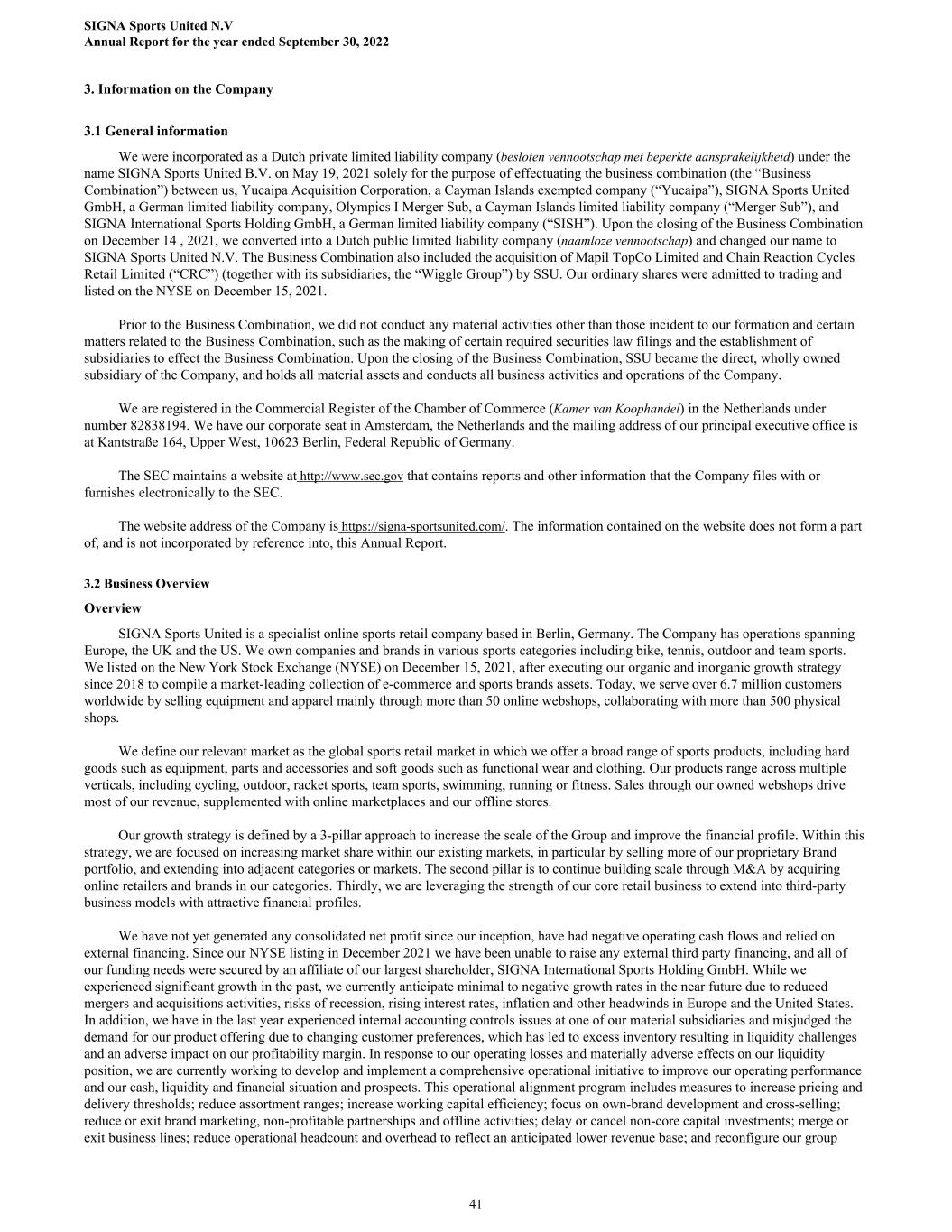
3. Information on the Company 3.1 General information We were incorporated as a Dutch private limited liability company (besloten vennootschap met beperkte aansprakelijkheid) under the name SIGNA Sports United B.V. on May 19, 2021 solely for the purpose of effectuating the business combination (the “Business Combination”) between us, Yucaipa Acquisition Corporation, a Cayman Islands exempted company (“Yucaipa”), SIGNA Sports United GmbH, a German limited liability company, Olympics I Merger Sub, a Cayman Islands limited liability company (“Merger Sub”), and SIGNA International Sports Holding GmbH, a German limited liability company (“SISH”). Upon the closing of the Business Combination on December 14 , 2021, we converted into a Dutch public limited liability company (naamloze vennootschap) and changed our name to SIGNA Sports United N.V. The Business Combination also included the acquisition of Mapil TopCo Limited and Chain Reaction Cycles Retail Limited (“CRC”) (together with its subsidiaries, the “Wiggle Group”) by SSU. Our ordinary shares were admitted to trading and listed on the NYSE on December 15, 2021. Prior to the Business Combination, we did not conduct any material activities other than those incident to our formation and certain matters related to the Business Combination, such as the making of certain required securities law filings and the establishment of subsidiaries to effect the Business Combination. Upon the closing of the Business Combination, SSU became the direct, wholly owned subsidiary of the Company, and holds all material assets and conducts all business activities and operations of the Company. We are registered in the Commercial Register of the Chamber of Commerce (Kamer van Koophandel) in the Netherlands under number 82838194. We have our corporate seat in Amsterdam, the Netherlands and the mailing address of our principal executive office is at Kantstraße 164, Upper West, 10623 Berlin, Federal Republic of Germany. The SEC maintains a website at http://www.sec.gov that contains reports and other information that the Company files with or furnishes electronically to the SEC. The website address of the Company is https://signa-sportsunited.com/. The information contained on the website does not form a part of, and is not incorporated by reference into, this Annual Report. 3.2 Business Overview Overview SIGNA Sports United is a specialist online sports retail company based in Berlin, Germany. The Company has operations spanning Europe, the UK and the US. We own companies and brands in various sports categories including bike, tennis, outdoor and team sports. We listed on the New York Stock Exchange (NYSE) on December 15, 2021, after executing our organic and inorganic growth strategy since 2018 to compile a market-leading collection of e-commerce and sports brands assets. Today, we serve over 6.7 million customers worldwide by selling equipment and apparel mainly through more than 50 online webshops, collaborating with more than 500 physical shops. We define our relevant market as the global sports retail market in which we offer a broad range of sports products, including hard goods such as equipment, parts and accessories and soft goods such as functional wear and clothing. Our products range across multiple verticals, including cycling, outdoor, racket sports, team sports, swimming, running or fitness. Sales through our owned webshops drive most of our revenue, supplemented with online marketplaces and our offline stores. Our growth strategy is defined by a 3-pillar approach to increase the scale of the Group and improve the financial profile. Within this strategy, we are focused on increasing market share within our existing markets, in particular by selling more of our proprietary Brand portfolio, and extending into adjacent categories or markets. The second pillar is to continue building scale through M&A by acquiring online retailers and brands in our categories. Thirdly, we are leveraging the strength of our core retail business to extend into third-party business models with attractive financial profiles. We have not yet generated any consolidated net profit since our inception, have had negative operating cash flows and relied on external financing. Since our NYSE listing in December 2021 we have been unable to raise any external third party financing, and all of our funding needs were secured by an affiliate of our largest shareholder, SIGNA International Sports Holding GmbH. While we experienced significant growth in the past, we currently anticipate minimal to negative growth rates in the near future due to reduced mergers and acquisitions activities, risks of recession, rising interest rates, inflation and other headwinds in Europe and the United States. In addition, we have in the last year experienced internal accounting controls issues at one of our material subsidiaries and misjudged the demand for our product offering due to changing customer preferences, which has led to excess inventory resulting in liquidity challenges and an adverse impact on our profitability margin. In response to our operating losses and materially adverse effects on our liquidity position, we are currently working to develop and implement a comprehensive operational initiative to improve our operating performance and our cash, liquidity and financial situation and prospects. This operational alignment program includes measures to increase pricing and delivery thresholds; reduce assortment ranges; increase working capital efficiency; focus on own-brand development and cross-selling; reduce or exit brand marketing, non-profitable partnerships and offline activities; delay or cancel non-core capital investments; merge or exit business lines; reduce operational headcount and overhead to reflect an anticipated lower revenue base; and reconfigure our group SIGNA Sports United N.V Annual Report for the year ended September 30, 2022 41
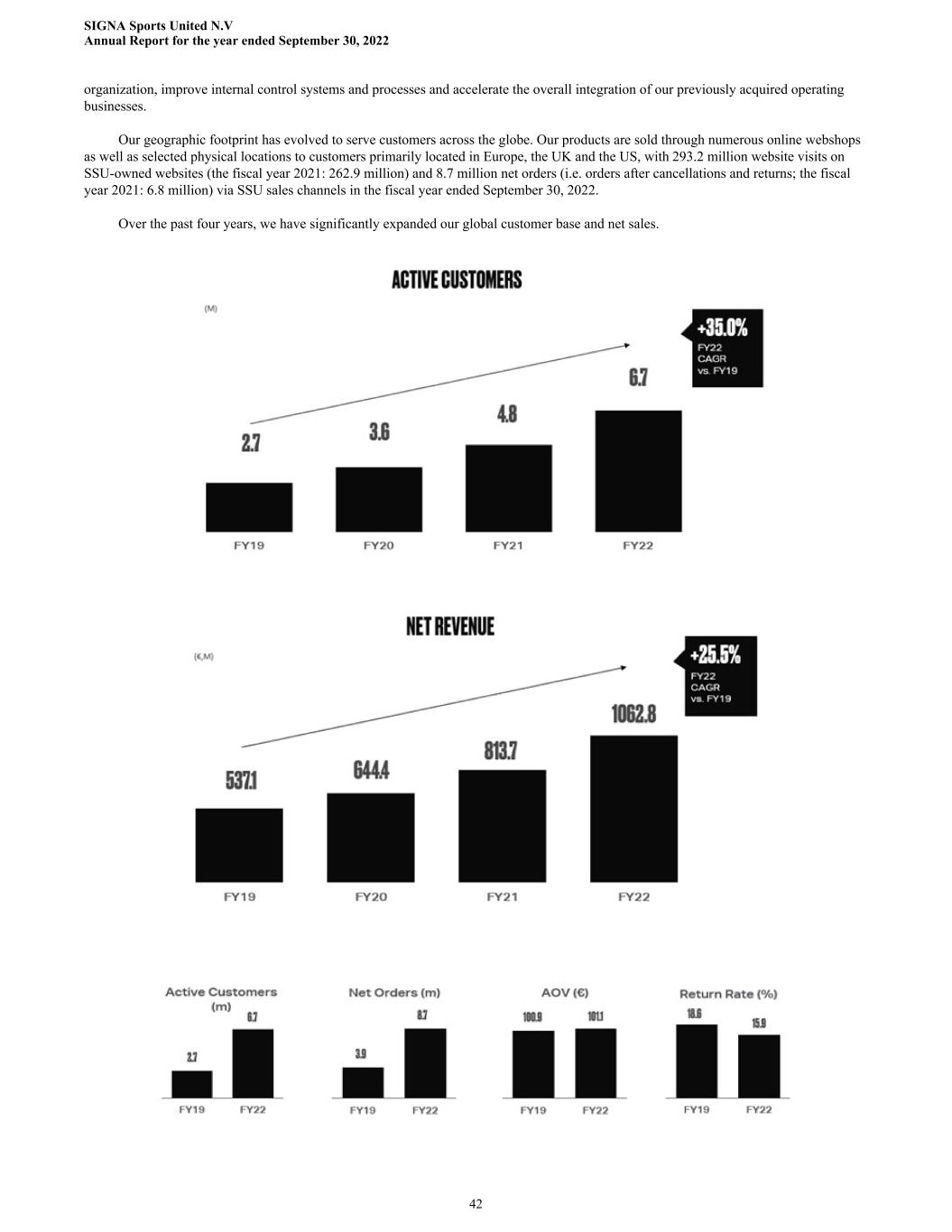
organization, improve internal control systems and processes and accelerate the overall integration of our previously acquired operating businesses. Our geographic footprint has evolved to serve customers across the globe. Our products are sold through numerous online webshops as well as selected physical locations to customers primarily located in Europe, the UK and the US, with 293.2 million website visits on SSU-owned websites (the fiscal year 2021: 262.9 million) and 8.7 million net orders (i.e. orders after cancellations and returns; the fiscal year 2021: 6.8 million) via SSU sales channels in the fiscal year ended September 30, 2022. Over the past four years, we have significantly expanded our global customer base and net sales. SIGNA Sports United N.V Annual Report for the year ended September 30, 2022 42
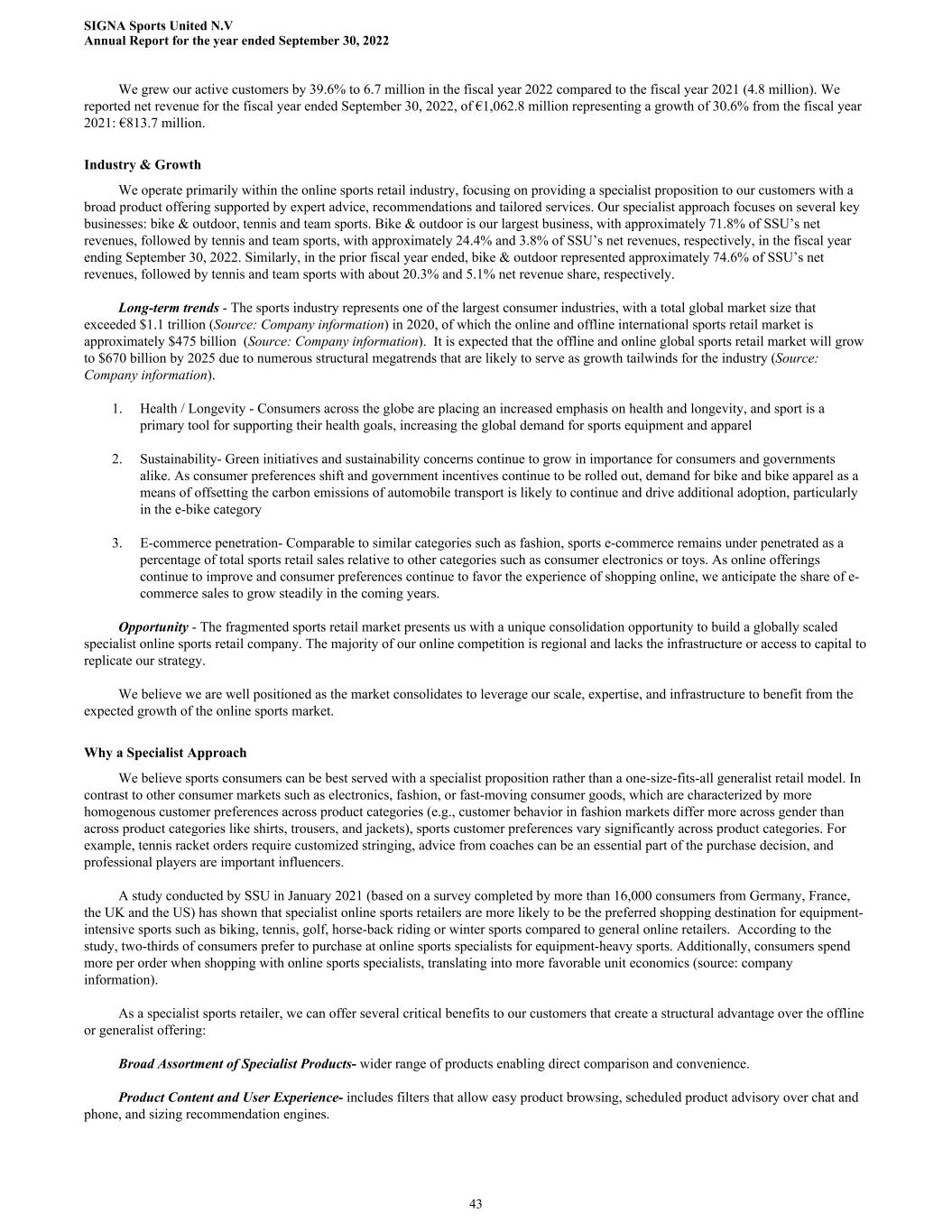
We grew our active customers by 39.6% to 6.7 million in the fiscal year 2022 compared to the fiscal year 2021 (4.8 million). We reported net revenue for the fiscal year ended September 30, 2022, of €1,062.8 million representing a growth of 30.6% from the fiscal year 2021: €813.7 million. Industry & Growth We operate primarily within the online sports retail industry, focusing on providing a specialist proposition to our customers with a broad product offering supported by expert advice, recommendations and tailored services. Our specialist approach focuses on several key businesses: bike & outdoor, tennis and team sports. Bike & outdoor is our largest business, with approximately 71.8% of SSU’s net revenues, followed by tennis and team sports, with approximately 24.4% and 3.8% of SSU’s net revenues, respectively, in the fiscal year ending September 30, 2022. Similarly, in the prior fiscal year ended, bike & outdoor represented approximately 74.6% of SSU’s net revenues, followed by tennis and team sports with about 20.3% and 5.1% net revenue share, respectively. Long-term trends - The sports industry represents one of the largest consumer industries, with a total global market size that exceeded $1.1 trillion (Source: Company information) in 2020, of which the online and offline international sports retail market is approximately $475 billion (Source: Company information). It is expected that the offline and online global sports retail market will grow to $670 billion by 2025 due to numerous structural megatrends that are likely to serve as growth tailwinds for the industry (Source: Company information). 1. Health / Longevity - Consumers across the globe are placing an increased emphasis on health and longevity, and sport is a primary tool for supporting their health goals, increasing the global demand for sports equipment and apparel 2. Sustainability- Green initiatives and sustainability concerns continue to grow in importance for consumers and governments alike. As consumer preferences shift and government incentives continue to be rolled out, demand for bike and bike apparel as a means of offsetting the carbon emissions of automobile transport is likely to continue and drive additional adoption, particularly in the e-bike category 3. E-commerce penetration- Comparable to similar categories such as fashion, sports e-commerce remains under penetrated as a percentage of total sports retail sales relative to other categories such as consumer electronics or toys. As online offerings continue to improve and consumer preferences continue to favor the experience of shopping online, we anticipate the share of e- commerce sales to grow steadily in the coming years. Opportunity - The fragmented sports retail market presents us with a unique consolidation opportunity to build a globally scaled specialist online sports retail company. The majority of our online competition is regional and lacks the infrastructure or access to capital to replicate our strategy. We believe we are well positioned as the market consolidates to leverage our scale, expertise, and infrastructure to benefit from the expected growth of the online sports market. Why a Specialist Approach We believe sports consumers can be best served with a specialist proposition rather than a one-size-fits-all generalist retail model. In contrast to other consumer markets such as electronics, fashion, or fast-moving consumer goods, which are characterized by more homogenous customer preferences across product categories (e.g., customer behavior in fashion markets differ more across gender than across product categories like shirts, trousers, and jackets), sports customer preferences vary significantly across product categories. For example, tennis racket orders require customized stringing, advice from coaches can be an essential part of the purchase decision, and professional players are important influencers. A study conducted by SSU in January 2021 (based on a survey completed by more than 16,000 consumers from Germany, France, the UK and the US) has shown that specialist online sports retailers are more likely to be the preferred shopping destination for equipment- intensive sports such as biking, tennis, golf, horse-back riding or winter sports compared to general online retailers. According to the study, two-thirds of consumers prefer to purchase at online sports specialists for equipment-heavy sports. Additionally, consumers spend more per order when shopping with online sports specialists, translating into more favorable unit economics (source: company information). As a specialist sports retailer, we can offer several critical benefits to our customers that create a structural advantage over the offline or generalist offering: Broad Assortment of Specialist Products- wider range of products enabling direct comparison and convenience. Product Content and User Experience- includes filters that allow easy product browsing, scheduled product advisory over chat and phone, and sizing recommendation engines. SIGNA Sports United N.V Annual Report for the year ended September 30, 2022 43
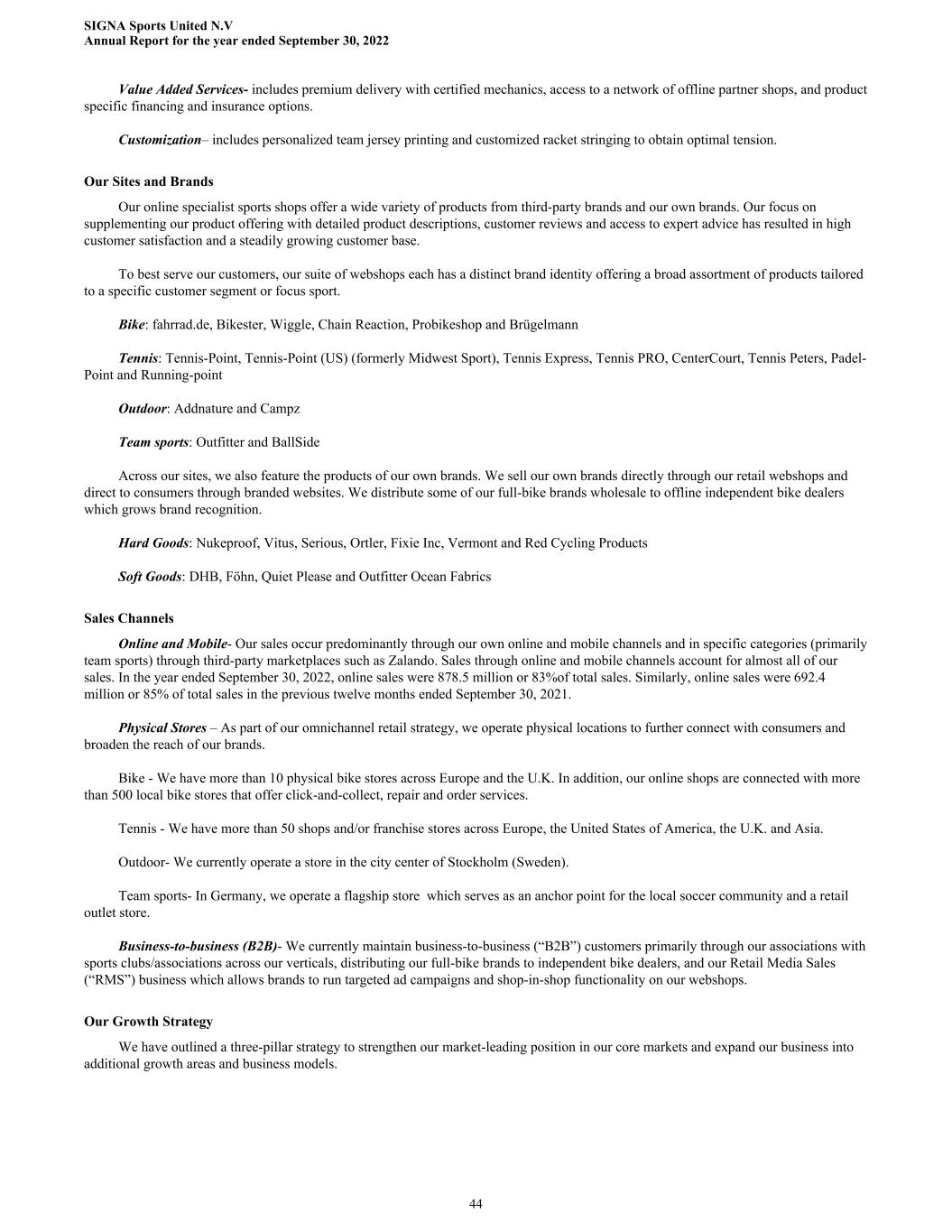
Value Added Services- includes premium delivery with certified mechanics, access to a network of offline partner shops, and product specific financing and insurance options. Customization– includes personalized team jersey printing and customized racket stringing to obtain optimal tension. Our Sites and Brands Our online specialist sports shops offer a wide variety of products from third-party brands and our own brands. Our focus on supplementing our product offering with detailed product descriptions, customer reviews and access to expert advice has resulted in high customer satisfaction and a steadily growing customer base. To best serve our customers, our suite of webshops each has a distinct brand identity offering a broad assortment of products tailored to a specific customer segment or focus sport. Bike: fahrrad.de, Bikester, Wiggle, Chain Reaction, Probikeshop and Brügelmann Tennis: Tennis-Point, Tennis-Point (US) (formerly Midwest Sport), Tennis Express, Tennis PRO, CenterCourt, Tennis Peters, Padel- Point and Running-point Outdoor: Addnature and Campz Team sports: Outfitter and BallSide Across our sites, we also feature the products of our own brands. We sell our own brands directly through our retail webshops and direct to consumers through branded websites. We distribute some of our full-bike brands wholesale to offline independent bike dealers which grows brand recognition. Hard Goods: Nukeproof, Vitus, Serious, Ortler, Fixie Inc, Vermont and Red Cycling Products Soft Goods: DHB, Föhn, Quiet Please and Outfitter Ocean Fabrics Sales Channels Online and Mobile- Our sales occur predominantly through our own online and mobile channels and in specific categories (primarily team sports) through third-party marketplaces such as Zalando. Sales through online and mobile channels account for almost all of our sales. In the year ended September 30, 2022, online sales were 878.5 million or 83%of total sales. Similarly, online sales were 692.4 million or 85% of total sales in the previous twelve months ended September 30, 2021. Physical Stores – As part of our omnichannel retail strategy, we operate physical locations to further connect with consumers and broaden the reach of our brands. Bike - We have more than 10 physical bike stores across Europe and the U.K. In addition, our online shops are connected with more than 500 local bike stores that offer click-and-collect, repair and order services. Tennis - We have more than 50 shops and/or franchise stores across Europe, the United States of America, the U.K. and Asia. Outdoor- We currently operate a store in the city center of Stockholm (Sweden). Team sports- In Germany, we operate a flagship store which serves as an anchor point for the local soccer community and a retail outlet store. Business-to-business (B2B)- We currently maintain business-to-business (“B2B”) customers primarily through our associations with sports clubs/associations across our verticals, distributing our full-bike brands to independent bike dealers, and our Retail Media Sales (“RMS”) business which allows brands to run targeted ad campaigns and shop-in-shop functionality on our webshops. Our Growth Strategy We have outlined a three-pillar strategy to strengthen our market-leading position in our core markets and expand our business into additional growth areas and business models. SIGNA Sports United N.V Annual Report for the year ended September 30, 2022 44
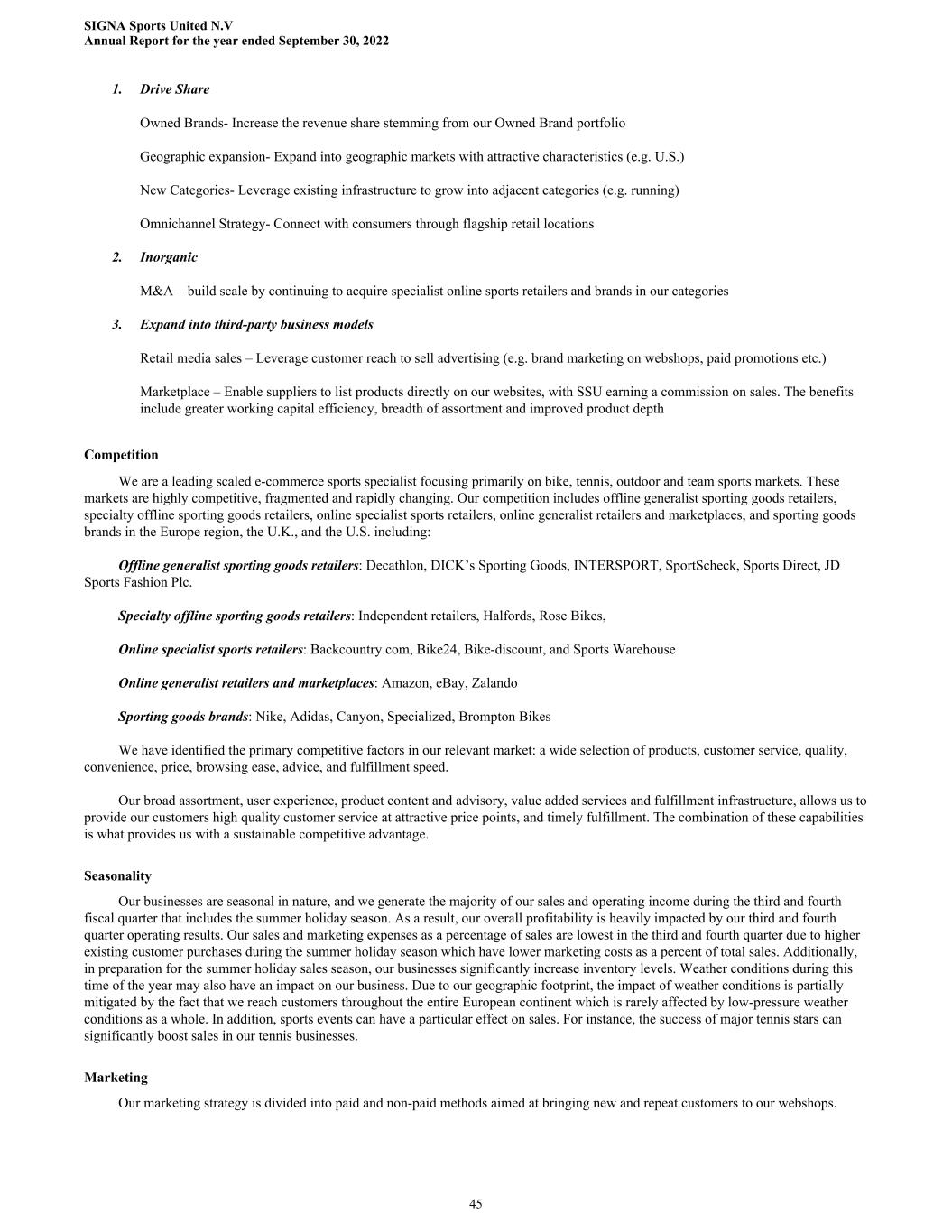
1. Drive Share Owned Brands- Increase the revenue share stemming from our Owned Brand portfolio Geographic expansion- Expand into geographic markets with attractive characteristics (e.g. U.S.) New Categories- Leverage existing infrastructure to grow into adjacent categories (e.g. running) Omnichannel Strategy- Connect with consumers through flagship retail locations 2. Inorganic M&A – build scale by continuing to acquire specialist online sports retailers and brands in our categories 3. Expand into third-party business models Retail media sales – Leverage customer reach to sell advertising (e.g. brand marketing on webshops, paid promotions etc.) Marketplace – Enable suppliers to list products directly on our websites, with SSU earning a commission on sales. The benefits include greater working capital efficiency, breadth of assortment and improved product depth Competition We are a leading scaled e-commerce sports specialist focusing primarily on bike, tennis, outdoor and team sports markets. These markets are highly competitive, fragmented and rapidly changing. Our competition includes offline generalist sporting goods retailers, specialty offline sporting goods retailers, online specialist sports retailers, online generalist retailers and marketplaces, and sporting goods brands in the Europe region, the U.K., and the U.S. including: Offline generalist sporting goods retailers: Decathlon, DICK’s Sporting Goods, INTERSPORT, SportScheck, Sports Direct, JD Sports Fashion Plc. Specialty offline sporting goods retailers: Independent retailers, Halfords, Rose Bikes, Online specialist sports retailers: Backcountry.com, Bike24, Bike-discount, and Sports Warehouse Online generalist retailers and marketplaces: Amazon, eBay, Zalando Sporting goods brands: Nike, Adidas, Canyon, Specialized, Brompton Bikes We have identified the primary competitive factors in our relevant market: a wide selection of products, customer service, quality, convenience, price, browsing ease, advice, and fulfillment speed. Our broad assortment, user experience, product content and advisory, value added services and fulfillment infrastructure, allows us to provide our customers high quality customer service at attractive price points, and timely fulfillment. The combination of these capabilities is what provides us with a sustainable competitive advantage. Seasonality Our businesses are seasonal in nature, and we generate the majority of our sales and operating income during the third and fourth fiscal quarter that includes the summer holiday season. As a result, our overall profitability is heavily impacted by our third and fourth quarter operating results. Our sales and marketing expenses as a percentage of sales are lowest in the third and fourth quarter due to higher existing customer purchases during the summer holiday season which have lower marketing costs as a percent of total sales. Additionally, in preparation for the summer holiday sales season, our businesses significantly increase inventory levels. Weather conditions during this time of the year may also have an impact on our business. Due to our geographic footprint, the impact of weather conditions is partially mitigated by the fact that we reach customers throughout the entire European continent which is rarely affected by low-pressure weather conditions as a whole. In addition, sports events can have a particular effect on sales. For instance, the success of major tennis stars can significantly boost sales in our tennis businesses. Marketing Our marketing strategy is divided into paid and non-paid methods aimed at bringing new and repeat customers to our webshops. SIGNA Sports United N.V Annual Report for the year ended September 30, 2022 45
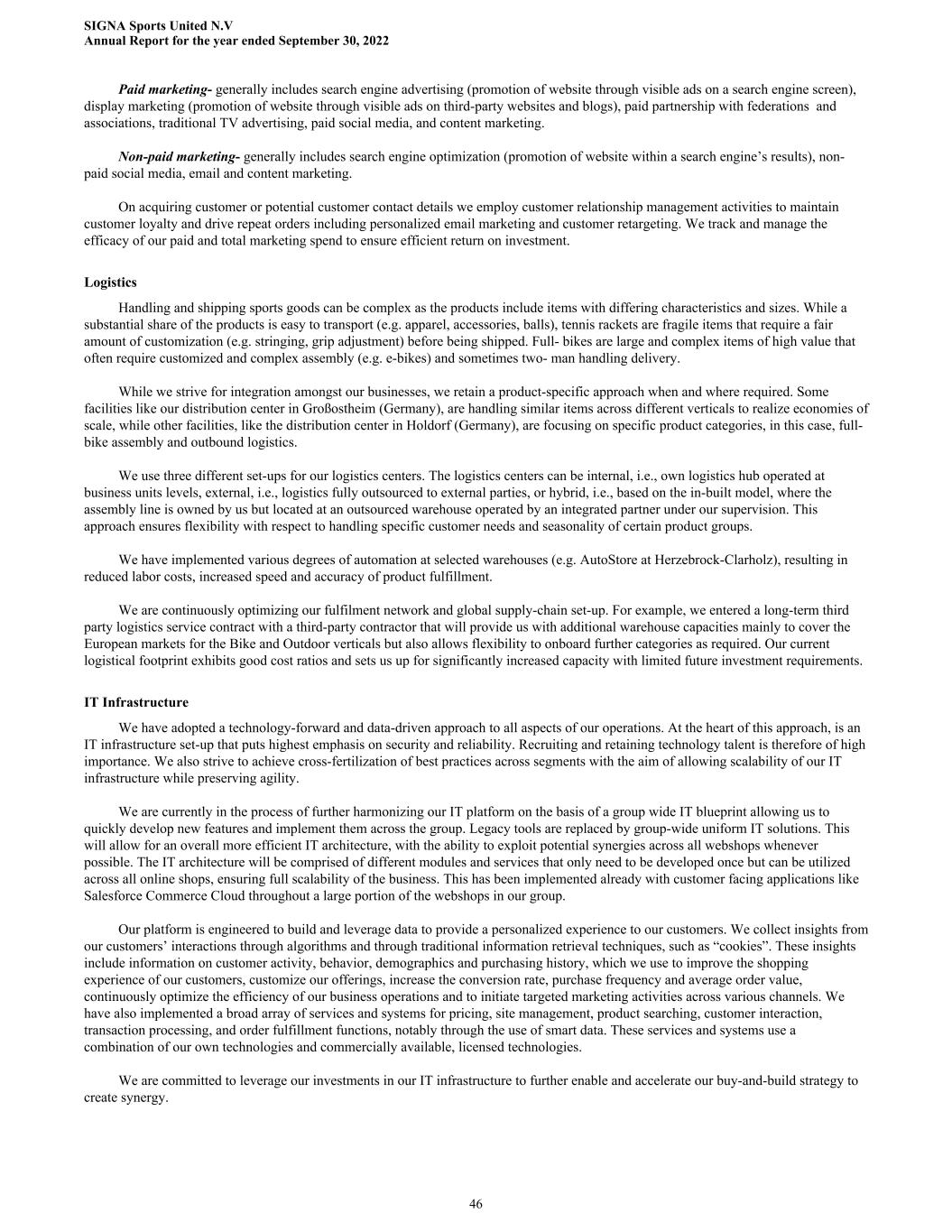
Paid marketing- generally includes search engine advertising (promotion of website through visible ads on a search engine screen), display marketing (promotion of website through visible ads on third-party websites and blogs), paid partnership with federations and associations, traditional TV advertising, paid social media, and content marketing. Non-paid marketing- generally includes search engine optimization (promotion of website within a search engine’s results), non- paid social media, email and content marketing. On acquiring customer or potential customer contact details we employ customer relationship management activities to maintain customer loyalty and drive repeat orders including personalized email marketing and customer retargeting. We track and manage the efficacy of our paid and total marketing spend to ensure efficient return on investment. Logistics Handling and shipping sports goods can be complex as the products include items with differing characteristics and sizes. While a substantial share of the products is easy to transport (e.g. apparel, accessories, balls), tennis rackets are fragile items that require a fair amount of customization (e.g. stringing, grip adjustment) before being shipped. Full- bikes are large and complex items of high value that often require customized and complex assembly (e.g. e-bikes) and sometimes two- man handling delivery. While we strive for integration amongst our businesses, we retain a product-specific approach when and where required. Some facilities like our distribution center in Großostheim (Germany), are handling similar items across different verticals to realize economies of scale, while other facilities, like the distribution center in Holdorf (Germany), are focusing on specific product categories, in this case, full- bike assembly and outbound logistics. We use three different set-ups for our logistics centers. The logistics centers can be internal, i.e., own logistics hub operated at business units levels, external, i.e., logistics fully outsourced to external parties, or hybrid, i.e., based on the in-built model, where the assembly line is owned by us but located at an outsourced warehouse operated by an integrated partner under our supervision. This approach ensures flexibility with respect to handling specific customer needs and seasonality of certain product groups. We have implemented various degrees of automation at selected warehouses (e.g. AutoStore at Herzebrock-Clarholz), resulting in reduced labor costs, increased speed and accuracy of product fulfillment. We are continuously optimizing our fulfilment network and global supply-chain set-up. For example, we entered a long-term third party logistics service contract with a third-party contractor that will provide us with additional warehouse capacities mainly to cover the European markets for the Bike and Outdoor verticals but also allows flexibility to onboard further categories as required. Our current logistical footprint exhibits good cost ratios and sets us up for significantly increased capacity with limited future investment requirements. IT Infrastructure We have adopted a technology-forward and data-driven approach to all aspects of our operations. At the heart of this approach, is an IT infrastructure set-up that puts highest emphasis on security and reliability. Recruiting and retaining technology talent is therefore of high importance. We also strive to achieve cross-fertilization of best practices across segments with the aim of allowing scalability of our IT infrastructure while preserving agility. We are currently in the process of further harmonizing our IT platform on the basis of a group wide IT blueprint allowing us to quickly develop new features and implement them across the group. Legacy tools are replaced by group-wide uniform IT solutions. This will allow for an overall more efficient IT architecture, with the ability to exploit potential synergies across all webshops whenever possible. The IT architecture will be comprised of different modules and services that only need to be developed once but can be utilized across all online shops, ensuring full scalability of the business. This has been implemented already with customer facing applications like Salesforce Commerce Cloud throughout a large portion of the webshops in our group. Our platform is engineered to build and leverage data to provide a personalized experience to our customers. We collect insights from our customers’ interactions through algorithms and through traditional information retrieval techniques, such as “cookies”. These insights include information on customer activity, behavior, demographics and purchasing history, which we use to improve the shopping experience of our customers, customize our offerings, increase the conversion rate, purchase frequency and average order value, continuously optimize the efficiency of our business operations and to initiate targeted marketing activities across various channels. We have also implemented a broad array of services and systems for pricing, site management, product searching, customer interaction, transaction processing, and order fulfillment functions, notably through the use of smart data. These services and systems use a combination of our own technologies and commercially available, licensed technologies. We are committed to leverage our investments in our IT infrastructure to further enable and accelerate our buy-and-build strategy to create synergy. SIGNA Sports United N.V Annual Report for the year ended September 30, 2022 46
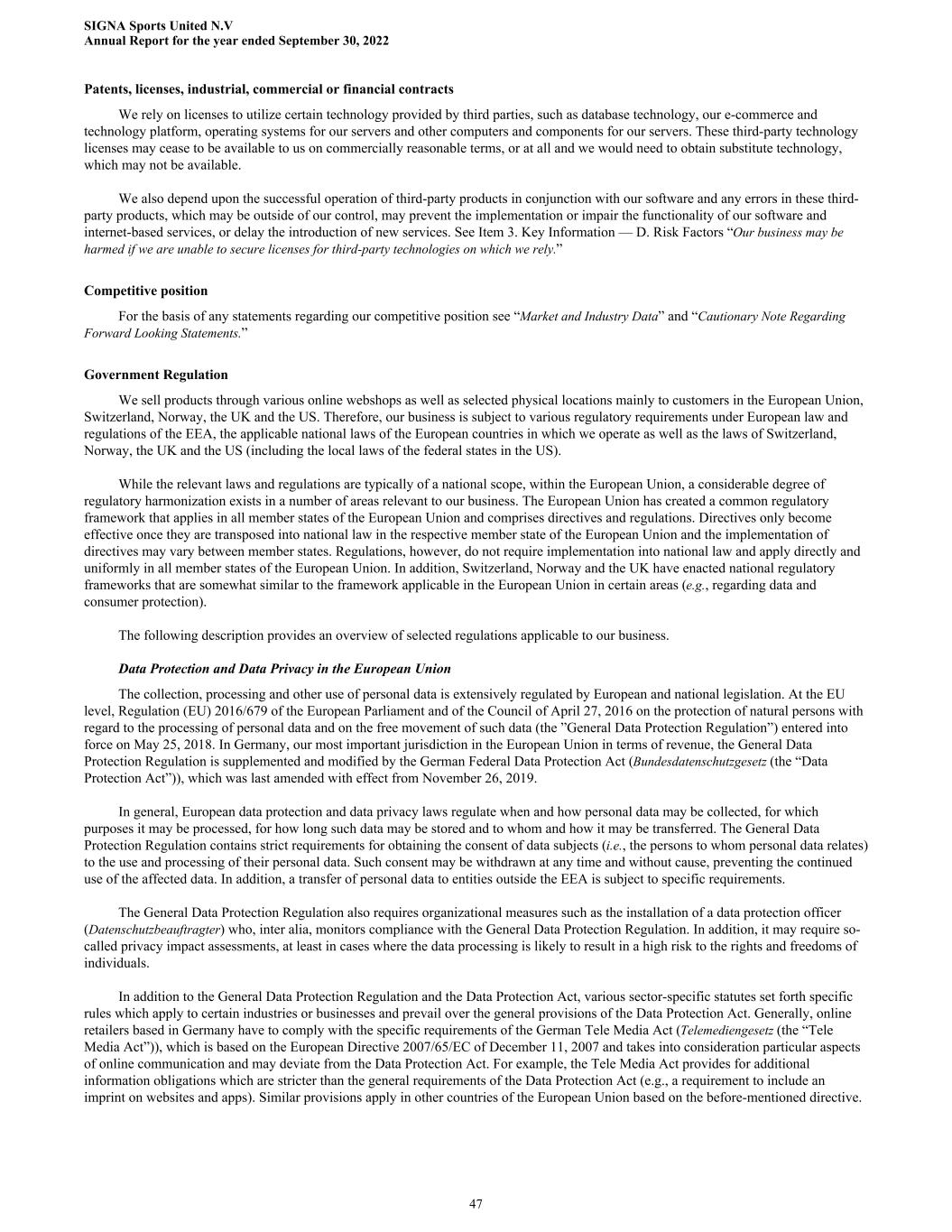
Patents, licenses, industrial, commercial or financial contracts We rely on licenses to utilize certain technology provided by third parties, such as database technology, our e-commerce and technology platform, operating systems for our servers and other computers and components for our servers. These third-party technology licenses may cease to be available to us on commercially reasonable terms, or at all and we would need to obtain substitute technology, which may not be available. We also depend upon the successful operation of third-party products in conjunction with our software and any errors in these third- party products, which may be outside of our control, may prevent the implementation or impair the functionality of our software and internet-based services, or delay the introduction of new services. See Item 3. Key Information — D. Risk Factors “Our business may be harmed if we are unable to secure licenses for third-party technologies on which we rely.” Competitive position For the basis of any statements regarding our competitive position see “Market and Industry Data” and “Cautionary Note Regarding Forward Looking Statements.” Government Regulation We sell products through various online webshops as well as selected physical locations mainly to customers in the European Union, Switzerland, Norway, the UK and the US. Therefore, our business is subject to various regulatory requirements under European law and regulations of the EEA, the applicable national laws of the European countries in which we operate as well as the laws of Switzerland, Norway, the UK and the US (including the local laws of the federal states in the US). While the relevant laws and regulations are typically of a national scope, within the European Union, a considerable degree of regulatory harmonization exists in a number of areas relevant to our business. The European Union has created a common regulatory framework that applies in all member states of the European Union and comprises directives and regulations. Directives only become effective once they are transposed into national law in the respective member state of the European Union and the implementation of directives may vary between member states. Regulations, however, do not require implementation into national law and apply directly and uniformly in all member states of the European Union. In addition, Switzerland, Norway and the UK have enacted national regulatory frameworks that are somewhat similar to the framework applicable in the European Union in certain areas (e.g., regarding data and consumer protection). The following description provides an overview of selected regulations applicable to our business. Data Protection and Data Privacy in the European Union The collection, processing and other use of personal data is extensively regulated by European and national legislation. At the EU level, Regulation (EU) 2016/679 of the European Parliament and of the Council of April 27, 2016 on the protection of natural persons with regard to the processing of personal data and on the free movement of such data (the ”General Data Protection Regulation”) entered into force on May 25, 2018. In Germany, our most important jurisdiction in the European Union in terms of revenue, the General Data Protection Regulation is supplemented and modified by the German Federal Data Protection Act (Bundesdatenschutzgesetz (the “Data Protection Act”)), which was last amended with effect from November 26, 2019. In general, European data protection and data privacy laws regulate when and how personal data may be collected, for which purposes it may be processed, for how long such data may be stored and to whom and how it may be transferred. The General Data Protection Regulation contains strict requirements for obtaining the consent of data subjects (i.e., the persons to whom personal data relates) to the use and processing of their personal data. Such consent may be withdrawn at any time and without cause, preventing the continued use of the affected data. In addition, a transfer of personal data to entities outside the EEA is subject to specific requirements. The General Data Protection Regulation also requires organizational measures such as the installation of a data protection officer (Datenschutzbeauftragter) who, inter alia, monitors compliance with the General Data Protection Regulation. In addition, it may require so- called privacy impact assessments, at least in cases where the data processing is likely to result in a high risk to the rights and freedoms of individuals. In addition to the General Data Protection Regulation and the Data Protection Act, various sector-specific statutes set forth specific rules which apply to certain industries or businesses and prevail over the general provisions of the Data Protection Act. Generally, online retailers based in Germany have to comply with the specific requirements of the German Tele Media Act (Telemediengesetz (the “Tele Media Act”)), which is based on the European Directive 2007/65/EC of December 11, 2007 and takes into consideration particular aspects of online communication and may deviate from the Data Protection Act. For example, the Tele Media Act provides for additional information obligations which are stricter than the general requirements of the Data Protection Act (e.g., a requirement to include an imprint on websites and apps). Similar provisions apply in other countries of the European Union based on the before-mentioned directive. SIGNA Sports United N.V Annual Report for the year ended September 30, 2022 47
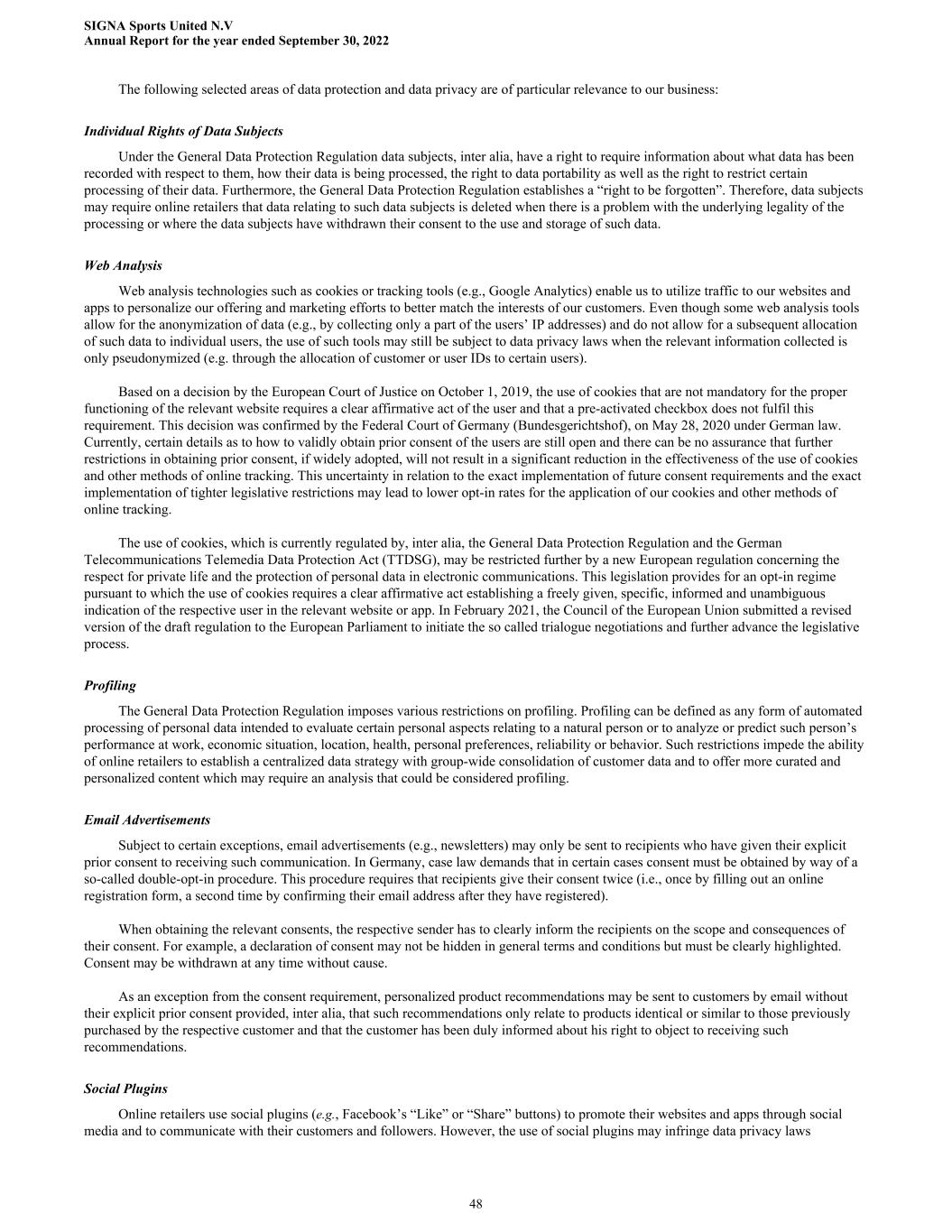
The following selected areas of data protection and data privacy are of particular relevance to our business: Individual Rights of Data Subjects Under the General Data Protection Regulation data subjects, inter alia, have a right to require information about what data has been recorded with respect to them, how their data is being processed, the right to data portability as well as the right to restrict certain processing of their data. Furthermore, the General Data Protection Regulation establishes a “right to be forgotten”. Therefore, data subjects may require online retailers that data relating to such data subjects is deleted when there is a problem with the underlying legality of the processing or where the data subjects have withdrawn their consent to the use and storage of such data. Web Analysis Web analysis technologies such as cookies or tracking tools (e.g., Google Analytics) enable us to utilize traffic to our websites and apps to personalize our offering and marketing efforts to better match the interests of our customers. Even though some web analysis tools allow for the anonymization of data (e.g., by collecting only a part of the users’ IP addresses) and do not allow for a subsequent allocation of such data to individual users, the use of such tools may still be subject to data privacy laws when the relevant information collected is only pseudonymized (e.g. through the allocation of customer or user IDs to certain users). Based on a decision by the European Court of Justice on October 1, 2019, the use of cookies that are not mandatory for the proper functioning of the relevant website requires a clear affirmative act of the user and that a pre-activated checkbox does not fulfil this requirement. This decision was confirmed by the Federal Court of Germany (Bundesgerichtshof), on May 28, 2020 under German law. Currently, certain details as to how to validly obtain prior consent of the users are still open and there can be no assurance that further restrictions in obtaining prior consent, if widely adopted, will not result in a significant reduction in the effectiveness of the use of cookies and other methods of online tracking. This uncertainty in relation to the exact implementation of future consent requirements and the exact implementation of tighter legislative restrictions may lead to lower opt-in rates for the application of our cookies and other methods of online tracking. The use of cookies, which is currently regulated by, inter alia, the General Data Protection Regulation and the German Telecommunications Telemedia Data Protection Act (TTDSG), may be restricted further by a new European regulation concerning the respect for private life and the protection of personal data in electronic communications. This legislation provides for an opt-in regime pursuant to which the use of cookies requires a clear affirmative act establishing a freely given, specific, informed and unambiguous indication of the respective user in the relevant website or app. In February 2021, the Council of the European Union submitted a revised version of the draft regulation to the European Parliament to initiate the so called trialogue negotiations and further advance the legislative process. Profiling The General Data Protection Regulation imposes various restrictions on profiling. Profiling can be defined as any form of automated processing of personal data intended to evaluate certain personal aspects relating to a natural person or to analyze or predict such person’s performance at work, economic situation, location, health, personal preferences, reliability or behavior. Such restrictions impede the ability of online retailers to establish a centralized data strategy with group-wide consolidation of customer data and to offer more curated and personalized content which may require an analysis that could be considered profiling. Email Advertisements Subject to certain exceptions, email advertisements (e.g., newsletters) may only be sent to recipients who have given their explicit prior consent to receiving such communication. In Germany, case law demands that in certain cases consent must be obtained by way of a so-called double-opt-in procedure. This procedure requires that recipients give their consent twice (i.e., once by filling out an online registration form, a second time by confirming their email address after they have registered). When obtaining the relevant consents, the respective sender has to clearly inform the recipients on the scope and consequences of their consent. For example, a declaration of consent may not be hidden in general terms and conditions but must be clearly highlighted. Consent may be withdrawn at any time without cause. As an exception from the consent requirement, personalized product recommendations may be sent to customers by email without their explicit prior consent provided, inter alia, that such recommendations only relate to products identical or similar to those previously purchased by the respective customer and that the customer has been duly informed about his right to object to receiving such recommendations. Social Plugins Online retailers use social plugins (e.g., Facebook’s “Like” or “Share” buttons) to promote their websites and apps through social media and to communicate with their customers and followers. However, the use of social plugins may infringe data privacy laws SIGNA Sports United N.V Annual Report for the year ended September 30, 2022 48
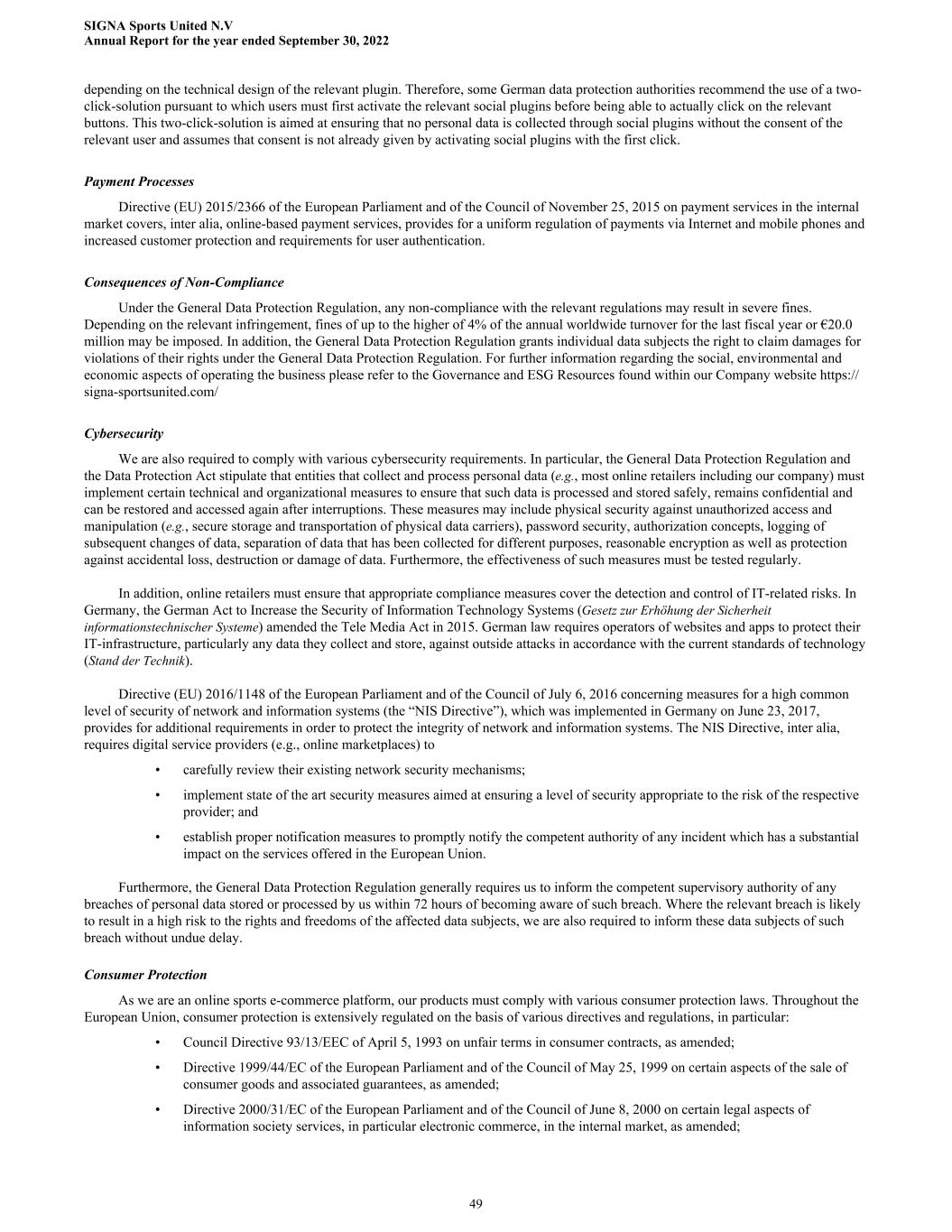
depending on the technical design of the relevant plugin. Therefore, some German data protection authorities recommend the use of a two- click-solution pursuant to which users must first activate the relevant social plugins before being able to actually click on the relevant buttons. This two-click-solution is aimed at ensuring that no personal data is collected through social plugins without the consent of the relevant user and assumes that consent is not already given by activating social plugins with the first click. Payment Processes Directive (EU) 2015/2366 of the European Parliament and of the Council of November 25, 2015 on payment services in the internal market covers, inter alia, online-based payment services, provides for a uniform regulation of payments via Internet and mobile phones and increased customer protection and requirements for user authentication. Consequences of Non-Compliance Under the General Data Protection Regulation, any non-compliance with the relevant regulations may result in severe fines. Depending on the relevant infringement, fines of up to the higher of 4% of the annual worldwide turnover for the last fiscal year or €20.0 million may be imposed. In addition, the General Data Protection Regulation grants individual data subjects the right to claim damages for violations of their rights under the General Data Protection Regulation. For further information regarding the social, environmental and economic aspects of operating the business please refer to the Governance and ESG Resources found within our Company website https:// signa-sportsunited.com/ Cybersecurity We are also required to comply with various cybersecurity requirements. In particular, the General Data Protection Regulation and the Data Protection Act stipulate that entities that collect and process personal data (e.g., most online retailers including our company) must implement certain technical and organizational measures to ensure that such data is processed and stored safely, remains confidential and can be restored and accessed again after interruptions. These measures may include physical security against unauthorized access and manipulation (e.g., secure storage and transportation of physical data carriers), password security, authorization concepts, logging of subsequent changes of data, separation of data that has been collected for different purposes, reasonable encryption as well as protection against accidental loss, destruction or damage of data. Furthermore, the effectiveness of such measures must be tested regularly. In addition, online retailers must ensure that appropriate compliance measures cover the detection and control of IT-related risks. In Germany, the German Act to Increase the Security of Information Technology Systems (Gesetz zur Erhöhung der Sicherheit informationstechnischer Systeme) amended the Tele Media Act in 2015. German law requires operators of websites and apps to protect their IT-infrastructure, particularly any data they collect and store, against outside attacks in accordance with the current standards of technology (Stand der Technik). Directive (EU) 2016/1148 of the European Parliament and of the Council of July 6, 2016 concerning measures for a high common level of security of network and information systems (the “NIS Directive”), which was implemented in Germany on June 23, 2017, provides for additional requirements in order to protect the integrity of network and information systems. The NIS Directive, inter alia, requires digital service providers (e.g., online marketplaces) to • carefully review their existing network security mechanisms; • implement state of the art security measures aimed at ensuring a level of security appropriate to the risk of the respective provider; and • establish proper notification measures to promptly notify the competent authority of any incident which has a substantial impact on the services offered in the European Union. Furthermore, the General Data Protection Regulation generally requires us to inform the competent supervisory authority of any breaches of personal data stored or processed by us within 72 hours of becoming aware of such breach. Where the relevant breach is likely to result in a high risk to the rights and freedoms of the affected data subjects, we are also required to inform these data subjects of such breach without undue delay. Consumer Protection As we are an online sports e-commerce platform, our products must comply with various consumer protection laws. Throughout the European Union, consumer protection is extensively regulated on the basis of various directives and regulations, in particular: • Council Directive 93/13/EEC of April 5, 1993 on unfair terms in consumer contracts, as amended; • Directive 1999/44/EC of the European Parliament and of the Council of May 25, 1999 on certain aspects of the sale of consumer goods and associated guarantees, as amended; • Directive 2000/31/EC of the European Parliament and of the Council of June 8, 2000 on certain legal aspects of information society services, in particular electronic commerce, in the internal market, as amended; SIGNA Sports United N.V Annual Report for the year ended September 30, 2022 49
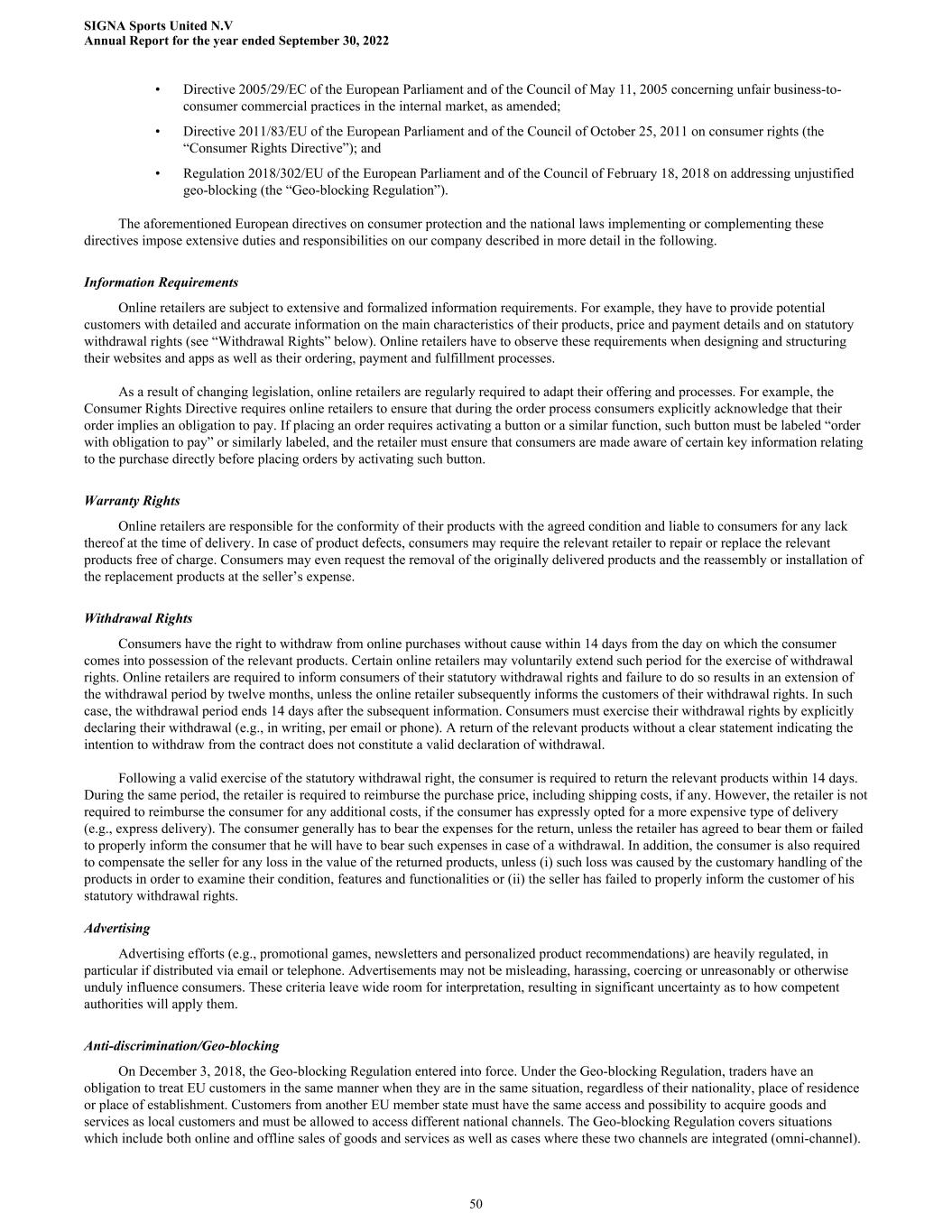
• Directive 2005/29/EC of the European Parliament and of the Council of May 11, 2005 concerning unfair business-to- consumer commercial practices in the internal market, as amended; • Directive 2011/83/EU of the European Parliament and of the Council of October 25, 2011 on consumer rights (the “Consumer Rights Directive”); and • Regulation 2018/302/EU of the European Parliament and of the Council of February 18, 2018 on addressing unjustified geo-blocking (the “Geo-blocking Regulation”). The aforementioned European directives on consumer protection and the national laws implementing or complementing these directives impose extensive duties and responsibilities on our company described in more detail in the following. Information Requirements Online retailers are subject to extensive and formalized information requirements. For example, they have to provide potential customers with detailed and accurate information on the main characteristics of their products, price and payment details and on statutory withdrawal rights (see “Withdrawal Rights” below). Online retailers have to observe these requirements when designing and structuring their websites and apps as well as their ordering, payment and fulfillment processes. As a result of changing legislation, online retailers are regularly required to adapt their offering and processes. For example, the Consumer Rights Directive requires online retailers to ensure that during the order process consumers explicitly acknowledge that their order implies an obligation to pay. If placing an order requires activating a button or a similar function, such button must be labeled “order with obligation to pay” or similarly labeled, and the retailer must ensure that consumers are made aware of certain key information relating to the purchase directly before placing orders by activating such button. Warranty Rights Online retailers are responsible for the conformity of their products with the agreed condition and liable to consumers for any lack thereof at the time of delivery. In case of product defects, consumers may require the relevant retailer to repair or replace the relevant products free of charge. Consumers may even request the removal of the originally delivered products and the reassembly or installation of the replacement products at the seller’s expense. Withdrawal Rights Consumers have the right to withdraw from online purchases without cause within 14 days from the day on which the consumer comes into possession of the relevant products. Certain online retailers may voluntarily extend such period for the exercise of withdrawal rights. Online retailers are required to inform consumers of their statutory withdrawal rights and failure to do so results in an extension of the withdrawal period by twelve months, unless the online retailer subsequently informs the customers of their withdrawal rights. In such case, the withdrawal period ends 14 days after the subsequent information. Consumers must exercise their withdrawal rights by explicitly declaring their withdrawal (e.g., in writing, per email or phone). A return of the relevant products without a clear statement indicating the intention to withdraw from the contract does not constitute a valid declaration of withdrawal. Following a valid exercise of the statutory withdrawal right, the consumer is required to return the relevant products within 14 days. During the same period, the retailer is required to reimburse the purchase price, including shipping costs, if any. However, the retailer is not required to reimburse the consumer for any additional costs, if the consumer has expressly opted for a more expensive type of delivery (e.g., express delivery). The consumer generally has to bear the expenses for the return, unless the retailer has agreed to bear them or failed to properly inform the consumer that he will have to bear such expenses in case of a withdrawal. In addition, the consumer is also required to compensate the seller for any loss in the value of the returned products, unless (i) such loss was caused by the customary handling of the products in order to examine their condition, features and functionalities or (ii) the seller has failed to properly inform the customer of his statutory withdrawal rights. Advertising Advertising efforts (e.g., promotional games, newsletters and personalized product recommendations) are heavily regulated, in particular if distributed via email or telephone. Advertisements may not be misleading, harassing, coercing or unreasonably or otherwise unduly influence consumers. These criteria leave wide room for interpretation, resulting in significant uncertainty as to how competent authorities will apply them. Anti-discrimination/Geo-blocking On December 3, 2018, the Geo-blocking Regulation entered into force. Under the Geo-blocking Regulation, traders have an obligation to treat EU customers in the same manner when they are in the same situation, regardless of their nationality, place of residence or place of establishment. Customers from another EU member state must have the same access and possibility to acquire goods and services as local customers and must be allowed to access different national channels. The Geo-blocking Regulation covers situations which include both online and offline sales of goods and services as well as cases where these two channels are integrated (omni-channel). SIGNA Sports United N.V Annual Report for the year ended September 30, 2022 50
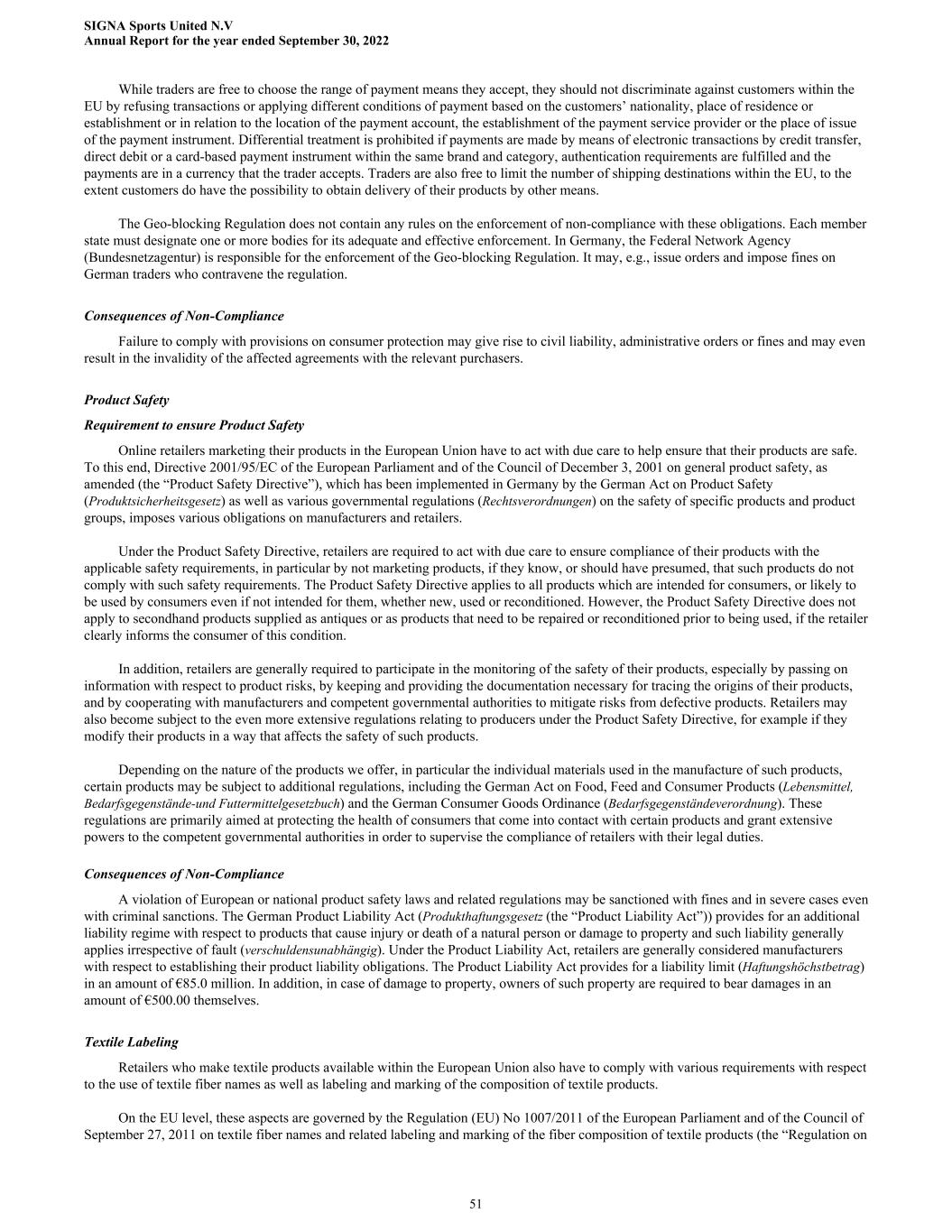
While traders are free to choose the range of payment means they accept, they should not discriminate against customers within the EU by refusing transactions or applying different conditions of payment based on the customers’ nationality, place of residence or establishment or in relation to the location of the payment account, the establishment of the payment service provider or the place of issue of the payment instrument. Differential treatment is prohibited if payments are made by means of electronic transactions by credit transfer, direct debit or a card-based payment instrument within the same brand and category, authentication requirements are fulfilled and the payments are in a currency that the trader accepts. Traders are also free to limit the number of shipping destinations within the EU, to the extent customers do have the possibility to obtain delivery of their products by other means. The Geo-blocking Regulation does not contain any rules on the enforcement of non-compliance with these obligations. Each member state must designate one or more bodies for its adequate and effective enforcement. In Germany, the Federal Network Agency (Bundesnetzagentur) is responsible for the enforcement of the Geo-blocking Regulation. It may, e.g., issue orders and impose fines on German traders who contravene the regulation. Consequences of Non-Compliance Failure to comply with provisions on consumer protection may give rise to civil liability, administrative orders or fines and may even result in the invalidity of the affected agreements with the relevant purchasers. Product Safety Requirement to ensure Product Safety Online retailers marketing their products in the European Union have to act with due care to help ensure that their products are safe. To this end, Directive 2001/95/EC of the European Parliament and of the Council of December 3, 2001 on general product safety, as amended (the “Product Safety Directive”), which has been implemented in Germany by the German Act on Product Safety (Produktsicherheitsgesetz) as well as various governmental regulations (Rechtsverordnungen) on the safety of specific products and product groups, imposes various obligations on manufacturers and retailers. Under the Product Safety Directive, retailers are required to act with due care to ensure compliance of their products with the applicable safety requirements, in particular by not marketing products, if they know, or should have presumed, that such products do not comply with such safety requirements. The Product Safety Directive applies to all products which are intended for consumers, or likely to be used by consumers even if not intended for them, whether new, used or reconditioned. However, the Product Safety Directive does not apply to secondhand products supplied as antiques or as products that need to be repaired or reconditioned prior to being used, if the retailer clearly informs the consumer of this condition. In addition, retailers are generally required to participate in the monitoring of the safety of their products, especially by passing on information with respect to product risks, by keeping and providing the documentation necessary for tracing the origins of their products, and by cooperating with manufacturers and competent governmental authorities to mitigate risks from defective products. Retailers may also become subject to the even more extensive regulations relating to producers under the Product Safety Directive, for example if they modify their products in a way that affects the safety of such products. Depending on the nature of the products we offer, in particular the individual materials used in the manufacture of such products, certain products may be subject to additional regulations, including the German Act on Food, Feed and Consumer Products (Lebensmittel, Bedarfsgegenstände-und Futtermittelgesetzbuch) and the German Consumer Goods Ordinance (Bedarfsgegenständeverordnung). These regulations are primarily aimed at protecting the health of consumers that come into contact with certain products and grant extensive powers to the competent governmental authorities in order to supervise the compliance of retailers with their legal duties. Consequences of Non-Compliance A violation of European or national product safety laws and related regulations may be sanctioned with fines and in severe cases even with criminal sanctions. The German Product Liability Act (Produkthaftungsgesetz (the “Product Liability Act”)) provides for an additional liability regime with respect to products that cause injury or death of a natural person or damage to property and such liability generally applies irrespective of fault (verschuldensunabhängig). Under the Product Liability Act, retailers are generally considered manufacturers with respect to establishing their product liability obligations. The Product Liability Act provides for a liability limit (Haftungshöchstbetrag) in an amount of €85.0 million. In addition, in case of damage to property, owners of such property are required to bear damages in an amount of €500.00 themselves. Textile Labeling Retailers who make textile products available within the European Union also have to comply with various requirements with respect to the use of textile fiber names as well as labeling and marking of the composition of textile products. On the EU level, these aspects are governed by the Regulation (EU) No 1007/2011 of the European Parliament and of the Council of September 27, 2011 on textile fiber names and related labeling and marking of the fiber composition of textile products (the “Regulation on SIGNA Sports United N.V Annual Report for the year ended September 30, 2022 51
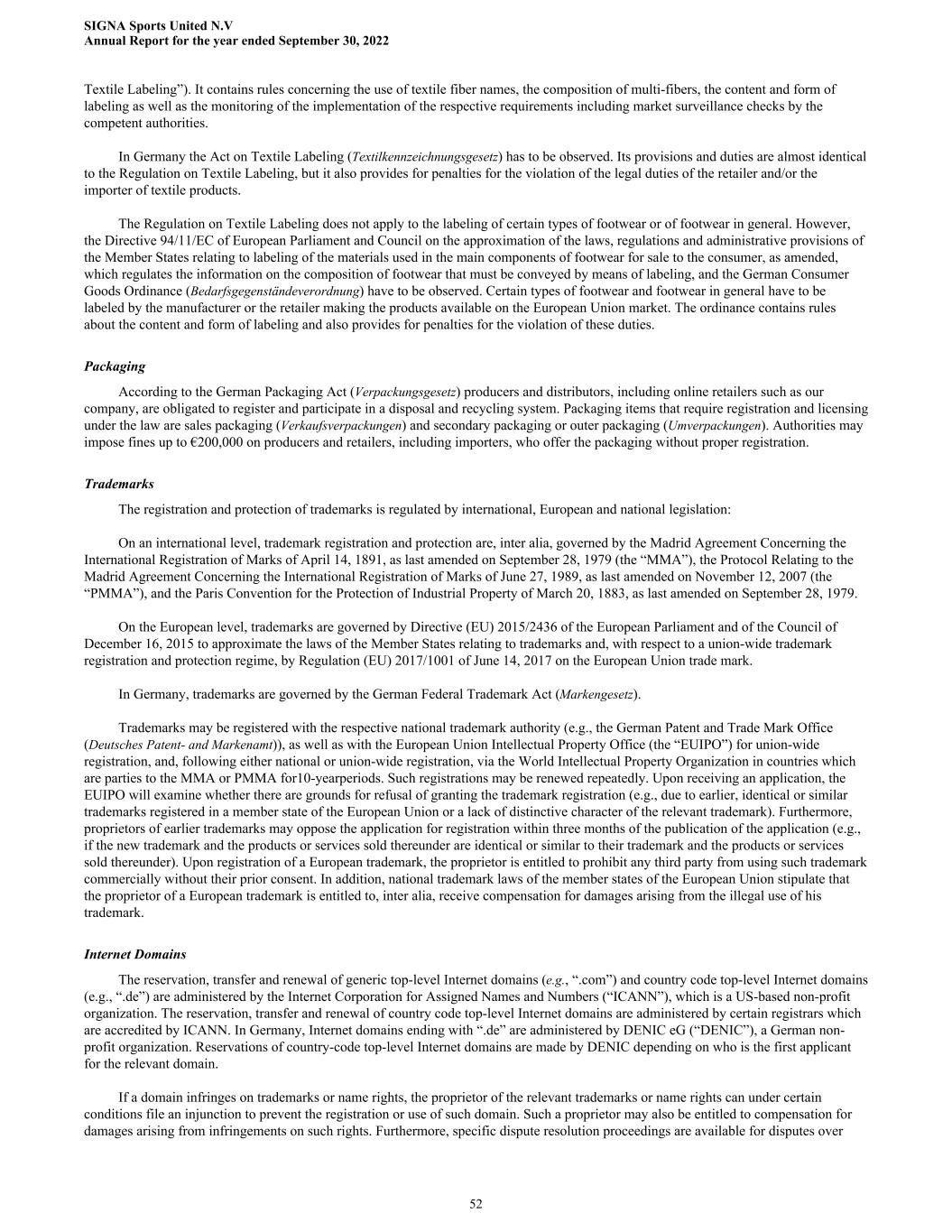
Textile Labeling”). It contains rules concerning the use of textile fiber names, the composition of multi-fibers, the content and form of labeling as well as the monitoring of the implementation of the respective requirements including market surveillance checks by the competent authorities. In Germany the Act on Textile Labeling (Textilkennzeichnungsgesetz) has to be observed. Its provisions and duties are almost identical to the Regulation on Textile Labeling, but it also provides for penalties for the violation of the legal duties of the retailer and/or the importer of textile products. The Regulation on Textile Labeling does not apply to the labeling of certain types of footwear or of footwear in general. However, the Directive 94/11/EC of European Parliament and Council on the approximation of the laws, regulations and administrative provisions of the Member States relating to labeling of the materials used in the main components of footwear for sale to the consumer, as amended, which regulates the information on the composition of footwear that must be conveyed by means of labeling, and the German Consumer Goods Ordinance (Bedarfsgegenständeverordnung) have to be observed. Certain types of footwear and footwear in general have to be labeled by the manufacturer or the retailer making the products available on the European Union market. The ordinance contains rules about the content and form of labeling and also provides for penalties for the violation of these duties. Packaging According to the German Packaging Act (Verpackungsgesetz) producers and distributors, including online retailers such as our company, are obligated to register and participate in a disposal and recycling system. Packaging items that require registration and licensing under the law are sales packaging (Verkaufsverpackungen) and secondary packaging or outer packaging (Umverpackungen). Authorities may impose fines up to €200,000 on producers and retailers, including importers, who offer the packaging without proper registration. Trademarks The registration and protection of trademarks is regulated by international, European and national legislation: On an international level, trademark registration and protection are, inter alia, governed by the Madrid Agreement Concerning the International Registration of Marks of April 14, 1891, as last amended on September 28, 1979 (the “MMA”), the Protocol Relating to the Madrid Agreement Concerning the International Registration of Marks of June 27, 1989, as last amended on November 12, 2007 (the “PMMA”), and the Paris Convention for the Protection of Industrial Property of March 20, 1883, as last amended on September 28, 1979. On the European level, trademarks are governed by Directive (EU) 2015/2436 of the European Parliament and of the Council of December 16, 2015 to approximate the laws of the Member States relating to trademarks and, with respect to a union-wide trademark registration and protection regime, by Regulation (EU) 2017/1001 of June 14, 2017 on the European Union trade mark. In Germany, trademarks are governed by the German Federal Trademark Act (Markengesetz). Trademarks may be registered with the respective national trademark authority (e.g., the German Patent and Trade Mark Office (Deutsches Patent- and Markenamt)), as well as with the European Union Intellectual Property Office (the “EUIPO”) for union-wide registration, and, following either national or union-wide registration, via the World Intellectual Property Organization in countries which are parties to the MMA or PMMA for10-yearperiods. Such registrations may be renewed repeatedly. Upon receiving an application, the EUIPO will examine whether there are grounds for refusal of granting the trademark registration (e.g., due to earlier, identical or similar trademarks registered in a member state of the European Union or a lack of distinctive character of the relevant trademark). Furthermore, proprietors of earlier trademarks may oppose the application for registration within three months of the publication of the application (e.g., if the new trademark and the products or services sold thereunder are identical or similar to their trademark and the products or services sold thereunder). Upon registration of a European trademark, the proprietor is entitled to prohibit any third party from using such trademark commercially without their prior consent. In addition, national trademark laws of the member states of the European Union stipulate that the proprietor of a European trademark is entitled to, inter alia, receive compensation for damages arising from the illegal use of his trademark. Internet Domains The reservation, transfer and renewal of generic top-level Internet domains (e.g., “.com”) and country code top-level Internet domains (e.g., “.de”) are administered by the Internet Corporation for Assigned Names and Numbers (“ICANN”), which is a US-based non-profit organization. The reservation, transfer and renewal of country code top-level Internet domains are administered by certain registrars which are accredited by ICANN. In Germany, Internet domains ending with “.de” are administered by DENIC eG (“DENIC”), a German non- profit organization. Reservations of country-code top-level Internet domains are made by DENIC depending on who is the first applicant for the relevant domain. If a domain infringes on trademarks or name rights, the proprietor of the relevant trademarks or name rights can under certain conditions file an injunction to prevent the registration or use of such domain. Such a proprietor may also be entitled to compensation for damages arising from infringements on such rights. Furthermore, specific dispute resolution proceedings are available for disputes over SIGNA Sports United N.V Annual Report for the year ended September 30, 2022 52
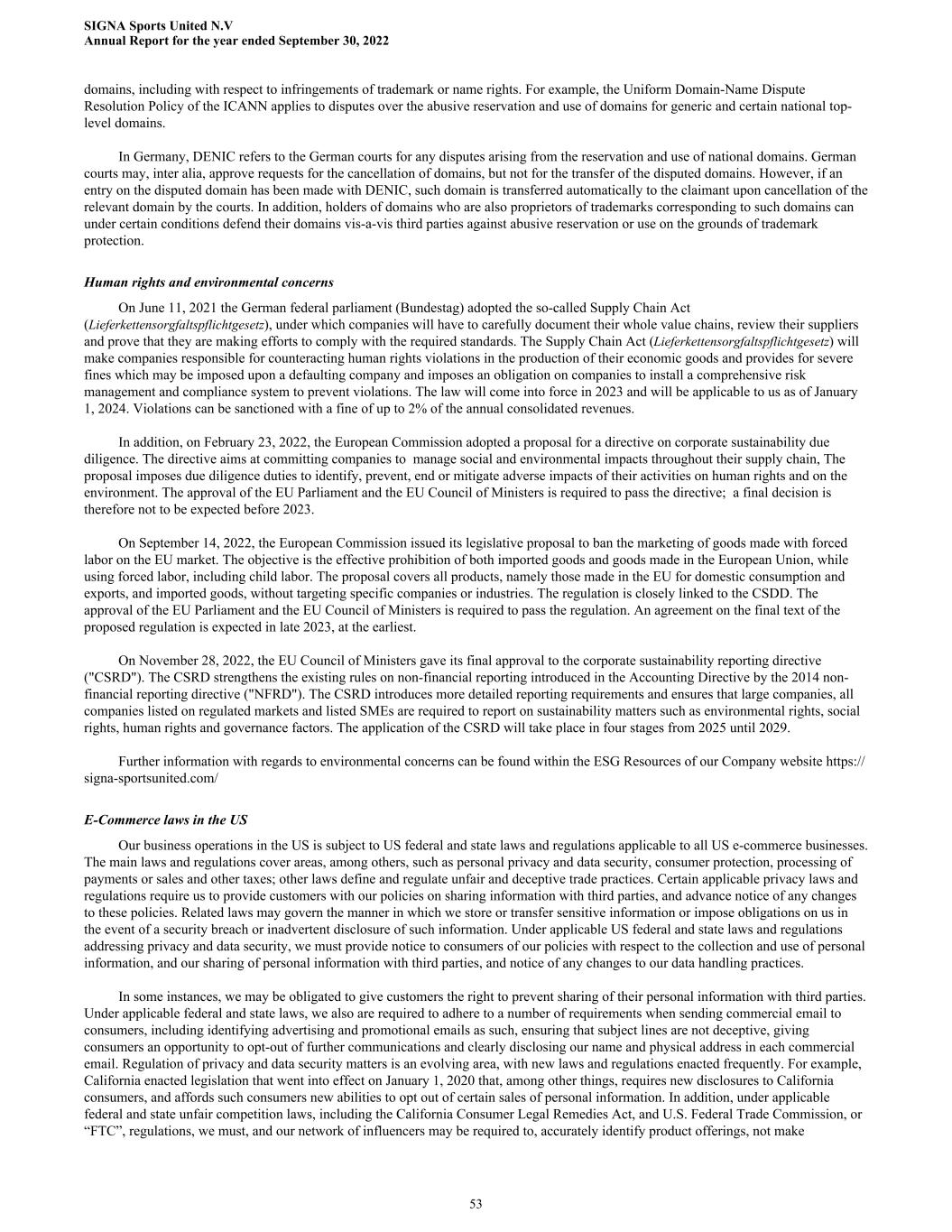
domains, including with respect to infringements of trademark or name rights. For example, the Uniform Domain-Name Dispute Resolution Policy of the ICANN applies to disputes over the abusive reservation and use of domains for generic and certain national top- level domains. In Germany, DENIC refers to the German courts for any disputes arising from the reservation and use of national domains. German courts may, inter alia, approve requests for the cancellation of domains, but not for the transfer of the disputed domains. However, if an entry on the disputed domain has been made with DENIC, such domain is transferred automatically to the claimant upon cancellation of the relevant domain by the courts. In addition, holders of domains who are also proprietors of trademarks corresponding to such domains can under certain conditions defend their domains vis-a-vis third parties against abusive reservation or use on the grounds of trademark protection. Human rights and environmental concerns On June 11, 2021 the German federal parliament (Bundestag) adopted the so-called Supply Chain Act (Lieferkettensorgfaltspflichtgesetz), under which companies will have to carefully document their whole value chains, review their suppliers and prove that they are making efforts to comply with the required standards. The Supply Chain Act (Lieferkettensorgfaltspflichtgesetz) will make companies responsible for counteracting human rights violations in the production of their economic goods and provides for severe fines which may be imposed upon a defaulting company and imposes an obligation on companies to install a comprehensive risk management and compliance system to prevent violations. The law will come into force in 2023 and will be applicable to us as of January 1, 2024. Violations can be sanctioned with a fine of up to 2% of the annual consolidated revenues. In addition, on February 23, 2022, the European Commission adopted a proposal for a directive on corporate sustainability due diligence. The directive aims at committing companies to manage social and environmental impacts throughout their supply chain, The proposal imposes due diligence duties to identify, prevent, end or mitigate adverse impacts of their activities on human rights and on the environment. The approval of the EU Parliament and the EU Council of Ministers is required to pass the directive; a final decision is therefore not to be expected before 2023. On September 14, 2022, the European Commission issued its legislative proposal to ban the marketing of goods made with forced labor on the EU market. The objective is the effective prohibition of both imported goods and goods made in the European Union, while using forced labor, including child labor. The proposal covers all products, namely those made in the EU for domestic consumption and exports, and imported goods, without targeting specific companies or industries. The regulation is closely linked to the CSDD. The approval of the EU Parliament and the EU Council of Ministers is required to pass the regulation. An agreement on the final text of the proposed regulation is expected in late 2023, at the earliest. On November 28, 2022, the EU Council of Ministers gave its final approval to the corporate sustainability reporting directive ("CSRD"). The CSRD strengthens the existing rules on non-financial reporting introduced in the Accounting Directive by the 2014 non- financial reporting directive ("NFRD"). The CSRD introduces more detailed reporting requirements and ensures that large companies, all companies listed on regulated markets and listed SMEs are required to report on sustainability matters such as environmental rights, social rights, human rights and governance factors. The application of the CSRD will take place in four stages from 2025 until 2029. Further information with regards to environmental concerns can be found within the ESG Resources of our Company website https:// signa-sportsunited.com/ E-Commerce laws in the US Our business operations in the US is subject to US federal and state laws and regulations applicable to all US e-commerce businesses. The main laws and regulations cover areas, among others, such as personal privacy and data security, consumer protection, processing of payments or sales and other taxes; other laws define and regulate unfair and deceptive trade practices. Certain applicable privacy laws and regulations require us to provide customers with our policies on sharing information with third parties, and advance notice of any changes to these policies. Related laws may govern the manner in which we store or transfer sensitive information or impose obligations on us in the event of a security breach or inadvertent disclosure of such information. Under applicable US federal and state laws and regulations addressing privacy and data security, we must provide notice to consumers of our policies with respect to the collection and use of personal information, and our sharing of personal information with third parties, and notice of any changes to our data handling practices. In some instances, we may be obligated to give customers the right to prevent sharing of their personal information with third parties. Under applicable federal and state laws, we also are required to adhere to a number of requirements when sending commercial email to consumers, including identifying advertising and promotional emails as such, ensuring that subject lines are not deceptive, giving consumers an opportunity to opt-out of further communications and clearly disclosing our name and physical address in each commercial email. Regulation of privacy and data security matters is an evolving area, with new laws and regulations enacted frequently. For example, California enacted legislation that went into effect on January 1, 2020 that, among other things, requires new disclosures to California consumers, and affords such consumers new abilities to opt out of certain sales of personal information. In addition, under applicable federal and state unfair competition laws, including the California Consumer Legal Remedies Act, and U.S. Federal Trade Commission, or “FTC”, regulations, we must, and our network of influencers may be required to, accurately identify product offerings, not make SIGNA Sports United N.V Annual Report for the year ended September 30, 2022 53

misleading claims on our websites or in advertising, and use qualifying disclosures where and when appropriate. The growth and demand for e-commerce could result in more stringent domestic and foreign consumer protection laws that impose additional compliance burdens on companies that transact substantial business on the internet. New legislation or regulation, the application of laws from jurisdictions whose laws do not currently apply to our US business, or the application of existing laws and regulations to the internet and e-commerce generally could result in significant additional taxes on our US business. Further, we could be subject to fines or other payments for any past failures to comply with these requirements. 3.3 Organizational Structure Upon the closing of the Business Combination, SSU became a direct, wholly-owned subsidiary of the Company and SSU’s subsidiaries became the Company’s indirect subsidiaries. For a list of SSU’s significant subsidiaries see Note 15 SSU’s consolidated financial statements filed as part of this Annual Report. 3.4 Property, plants and equipment We do not own any real property. Below is a list of our material leased property as of the date of this Annual Report, including the type of property, our business area, location and approximate square meterage. Type of property Business Location Square Meterage Owned/Leased Office Internetstores GmbH Stuttgart, Germany 1,670 leased Office & Warehouse Publikat GmbH & OUTFITTER Teamsport GmbH Großostheim, Germany 20,335 leased Office & Warehouse Tennis-Point GmbH Herzebrock-Clarholz, Germany 19,065 leased Office & Warehouse Tennispro Distribution SAS Entzheim, France 10,745 leased Warehouse Internetstores GmbH Esslingen, Germany* 8,554 leased Warehouse Internetstores GmbH Untertürkheim, Germany 7,568 leased Warehouse Internetstores GmbH Holdorf, Germany 14,079 leased Warehouse Internetstores GmbH Gehrde, Germany 11,400 leased Warehouse Wiggle Limited Wolverhampton, UK 30,129 leased Office & Warehouse Chain Reaction Cycles Limited Belfast, UK 1,942 leased *The facility in Esslingen will be shut down by April 2023. Lease agreements for our premises are generally long-term leases with terms between 3 and 10 years. As of the date of this Annual Report, the Company is not aware of any environmental issues that may affect the utilization of any of the premises described above and has no intention to engage in the construction, expansion or improvement of any real estate or facilities. Intellectual Property As of the date of this Annual Report, we own more than 130 trademarks (including “SIGNA Sports United”, “fahrrad.de”, “Brügelmann”, “CAMPZ”, “Addnature”, “Bikester”, “Probikeshop”, “Wiggle”, Chain Reaction Cycles, “Tennis-Point”, “Runnig Point”, “TennisPro”, “Tennis Express”, “Tennis-Point (US)/ Midwest Sport”, “CenterCourt”, “Outfitter”, and “Ballside”) as well as related tradenames and logos. We also have a portfolio of more than 900 domain names. We believe that our trademarks and our respective domains adopted for the different countries are of value to our business. Our private label brand products and other branding material are also featured on our websites and in our marketing. Please refer to note 7.1 of the Consolidated Financial Statements for further information on research and development activities. Insurance We maintain insurance against various risks related to the ordinary operations of our businesses, including general business interruption insurance and third-party liability, employer’s liability, property damage, cyber liability, liabilities for acts of terror, transportation damage and directors’ and officers’ liability insurance. We believe that the types and amounts of insurance coverage that we maintain are consistent with customary industry standards. However, no assurances can be given that this coverage will be sufficient to cover the cost of defense or damages in the event of a significant claim. SIGNA Sports United N.V Annual Report for the year ended September 30, 2022 54
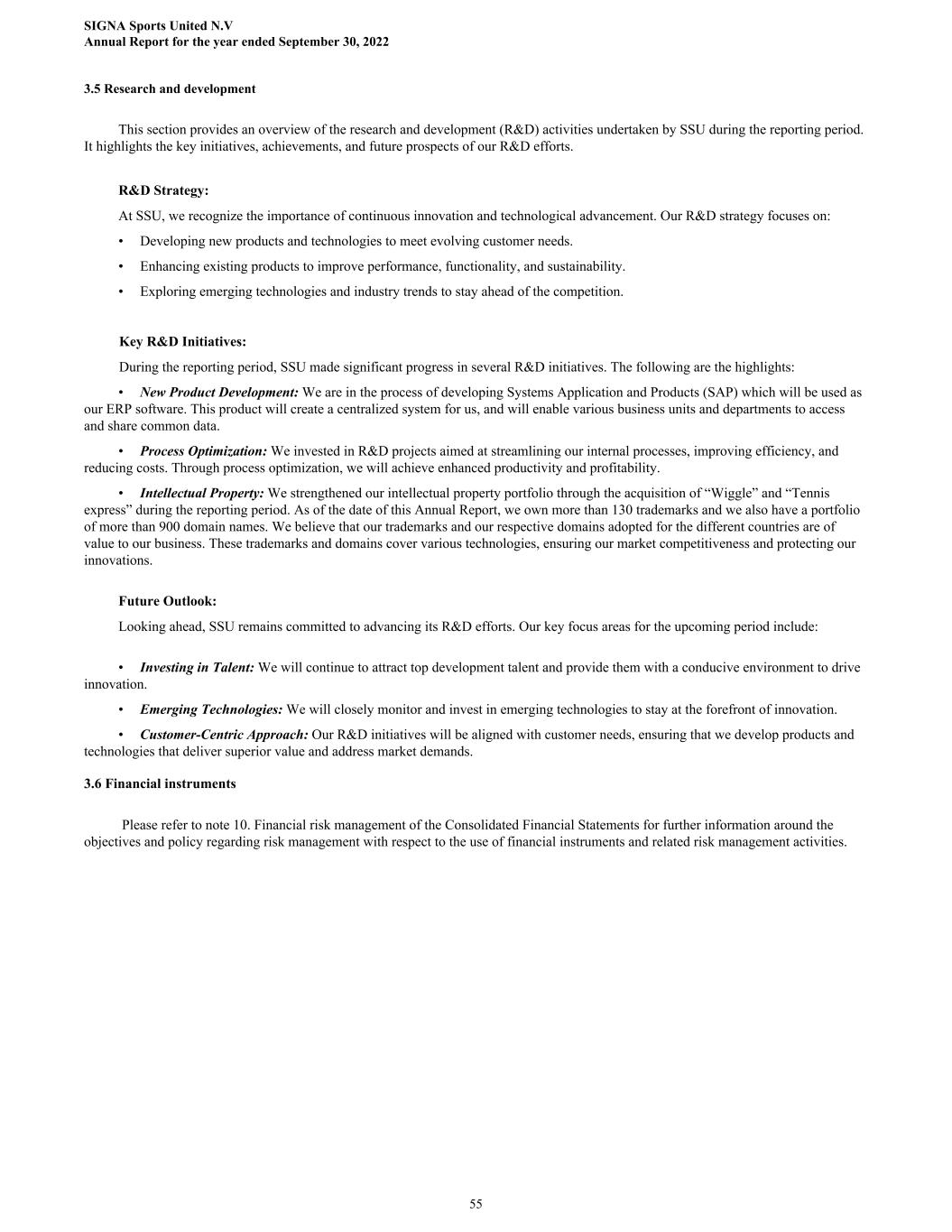
3.5 Research and development This section provides an overview of the research and development (R&D) activities undertaken by SSU during the reporting period. It highlights the key initiatives, achievements, and future prospects of our R&D efforts. R&D Strategy: At SSU, we recognize the importance of continuous innovation and technological advancement. Our R&D strategy focuses on: • Developing new products and technologies to meet evolving customer needs. • Enhancing existing products to improve performance, functionality, and sustainability. • Exploring emerging technologies and industry trends to stay ahead of the competition. Key R&D Initiatives: During the reporting period, SSU made significant progress in several R&D initiatives. The following are the highlights: • New Product Development: We are in the process of developing Systems Application and Products (SAP) which will be used as our ERP software. This product will create a centralized system for us, and will enable various business units and departments to access and share common data. • Process Optimization: We invested in R&D projects aimed at streamlining our internal processes, improving efficiency, and reducing costs. Through process optimization, we will achieve enhanced productivity and profitability. • Intellectual Property: We strengthened our intellectual property portfolio through the acquisition of “Wiggle” and “Tennis express” during the reporting period. As of the date of this Annual Report, we own more than 130 trademarks and we also have a portfolio of more than 900 domain names. We believe that our trademarks and our respective domains adopted for the different countries are of value to our business. These trademarks and domains cover various technologies, ensuring our market competitiveness and protecting our innovations. Future Outlook: Looking ahead, SSU remains committed to advancing its R&D efforts. Our key focus areas for the upcoming period include: • Investing in Talent: We will continue to attract top development talent and provide them with a conducive environment to drive innovation. • Emerging Technologies: We will closely monitor and invest in emerging technologies to stay at the forefront of innovation. • Customer-Centric Approach: Our R&D initiatives will be aligned with customer needs, ensuring that we develop products and technologies that deliver superior value and address market demands. 3.6 Financial instruments Please refer to note 10. Financial risk management of the Consolidated Financial Statements for further information around the objectives and policy regarding risk management with respect to the use of financial instruments and related risk management activities. SIGNA Sports United N.V Annual Report for the year ended September 30, 2022 55
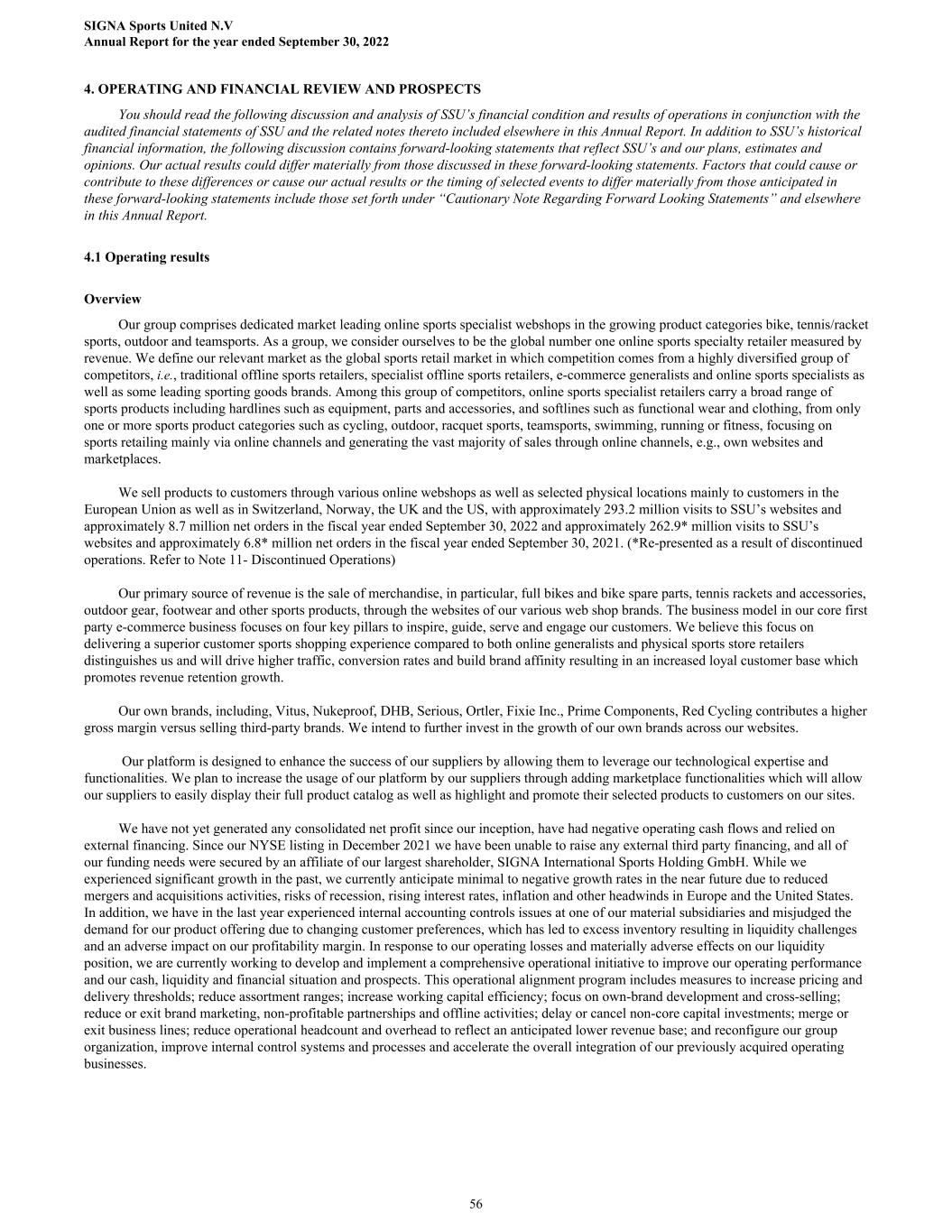
4. OPERATING AND FINANCIAL REVIEW AND PROSPECTS You should read the following discussion and analysis of SSU’s financial condition and results of operations in conjunction with the audited financial statements of SSU and the related notes thereto included elsewhere in this Annual Report. In addition to SSU’s historical financial information, the following discussion contains forward-looking statements that reflect SSU’s and our plans, estimates and opinions. Our actual results could differ materially from those discussed in these forward-looking statements. Factors that could cause or contribute to these differences or cause our actual results or the timing of selected events to differ materially from those anticipated in these forward-looking statements include those set forth under “Cautionary Note Regarding Forward Looking Statements” and elsewhere in this Annual Report. 4.1 Operating results Overview Our group comprises dedicated market leading online sports specialist webshops in the growing product categories bike, tennis/racket sports, outdoor and teamsports. As a group, we consider ourselves to be the global number one online sports specialty retailer measured by revenue. We define our relevant market as the global sports retail market in which competition comes from a highly diversified group of competitors, i.e., traditional offline sports retailers, specialist offline sports retailers, e-commerce generalists and online sports specialists as well as some leading sporting goods brands. Among this group of competitors, online sports specialist retailers carry a broad range of sports products including hardlines such as equipment, parts and accessories, and softlines such as functional wear and clothing, from only one or more sports product categories such as cycling, outdoor, racquet sports, teamsports, swimming, running or fitness, focusing on sports retailing mainly via online channels and generating the vast majority of sales through online channels, e.g., own websites and marketplaces. We sell products to customers through various online webshops as well as selected physical locations mainly to customers in the European Union as well as in Switzerland, Norway, the UK and the US, with approximately 293.2 million visits to SSU’s websites and approximately 8.7 million net orders in the fiscal year ended September 30, 2022 and approximately 262.9* million visits to SSU’s websites and approximately 6.8* million net orders in the fiscal year ended September 30, 2021. (*Re-presented as a result of discontinued operations. Refer to Note 11- Discontinued Operations) Our primary source of revenue is the sale of merchandise, in particular, full bikes and bike spare parts, tennis rackets and accessories, outdoor gear, footwear and other sports products, through the websites of our various web shop brands. The business model in our core first party e-commerce business focuses on four key pillars to inspire, guide, serve and engage our customers. We believe this focus on delivering a superior customer sports shopping experience compared to both online generalists and physical sports store retailers distinguishes us and will drive higher traffic, conversion rates and build brand affinity resulting in an increased loyal customer base which promotes revenue retention growth. Our own brands, including, Vitus, Nukeproof, DHB, Serious, Ortler, Fixie Inc., Prime Components, Red Cycling contributes a higher gross margin versus selling third-party brands. We intend to further invest in the growth of our own brands across our websites. Our platform is designed to enhance the success of our suppliers by allowing them to leverage our technological expertise and functionalities. We plan to increase the usage of our platform by our suppliers through adding marketplace functionalities which will allow our suppliers to easily display their full product catalog as well as highlight and promote their selected products to customers on our sites. We have not yet generated any consolidated net profit since our inception, have had negative operating cash flows and relied on external financing. Since our NYSE listing in December 2021 we have been unable to raise any external third party financing, and all of our funding needs were secured by an affiliate of our largest shareholder, SIGNA International Sports Holding GmbH. While we experienced significant growth in the past, we currently anticipate minimal to negative growth rates in the near future due to reduced mergers and acquisitions activities, risks of recession, rising interest rates, inflation and other headwinds in Europe and the United States. In addition, we have in the last year experienced internal accounting controls issues at one of our material subsidiaries and misjudged the demand for our product offering due to changing customer preferences, which has led to excess inventory resulting in liquidity challenges and an adverse impact on our profitability margin. In response to our operating losses and materially adverse effects on our liquidity position, we are currently working to develop and implement a comprehensive operational initiative to improve our operating performance and our cash, liquidity and financial situation and prospects. This operational alignment program includes measures to increase pricing and delivery thresholds; reduce assortment ranges; increase working capital efficiency; focus on own-brand development and cross-selling; reduce or exit brand marketing, non-profitable partnerships and offline activities; delay or cancel non-core capital investments; merge or exit business lines; reduce operational headcount and overhead to reflect an anticipated lower revenue base; and reconfigure our group organization, improve internal control systems and processes and accelerate the overall integration of our previously acquired operating businesses. SIGNA Sports United N.V Annual Report for the year ended September 30, 2022 56
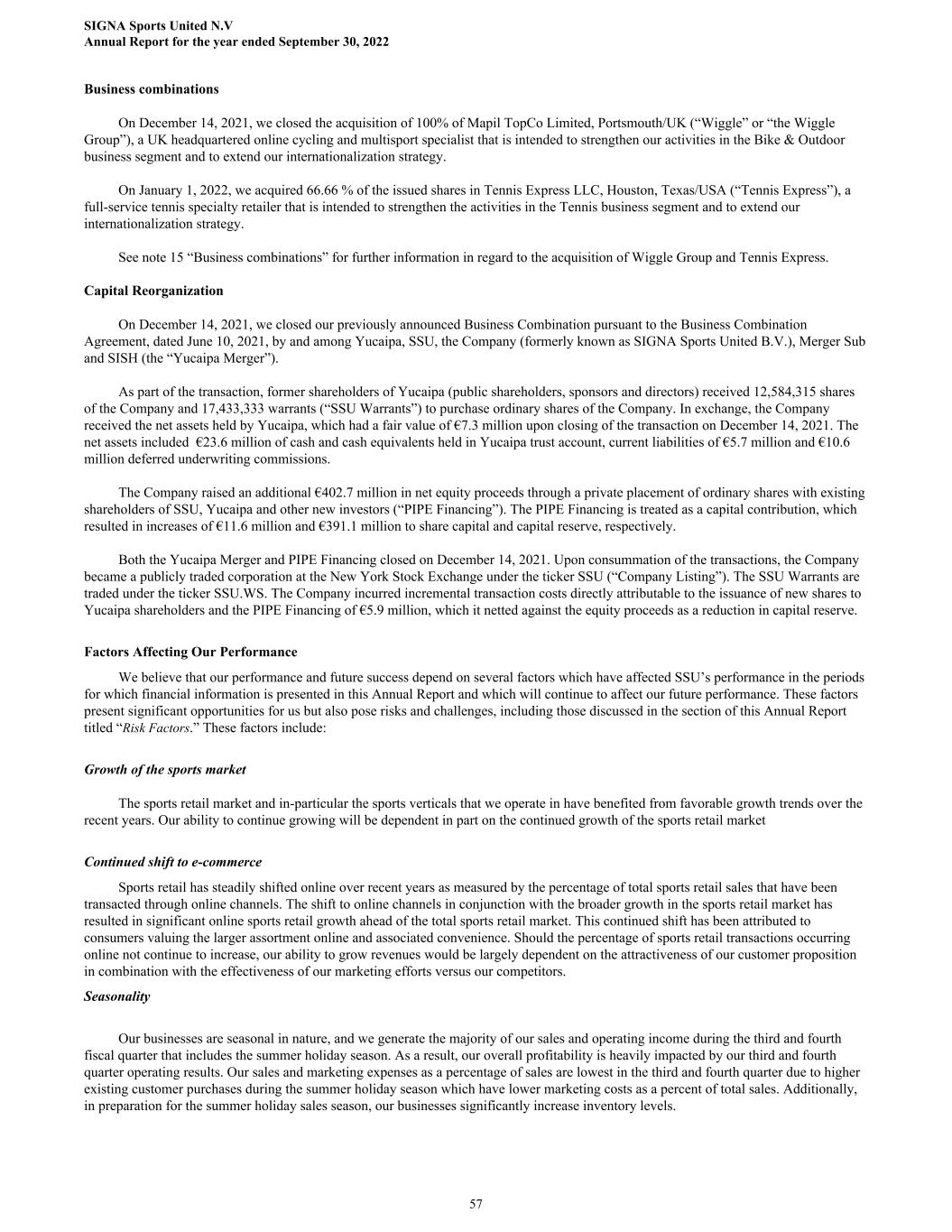
Business combinations On December 14, 2021, we closed the acquisition of 100% of Mapil TopCo Limited, Portsmouth/UK (“Wiggle” or “the Wiggle Group”), a UK headquartered online cycling and multisport specialist that is intended to strengthen our activities in the Bike & Outdoor business segment and to extend our internationalization strategy. On January 1, 2022, we acquired 66.66 % of the issued shares in Tennis Express LLC, Houston, Texas/USA (“Tennis Express”), a full-service tennis specialty retailer that is intended to strengthen the activities in the Tennis business segment and to extend our internationalization strategy. See note 15 “Business combinations” for further information in regard to the acquisition of Wiggle Group and Tennis Express. Capital Reorganization On December 14, 2021, we closed our previously announced Business Combination pursuant to the Business Combination Agreement, dated June 10, 2021, by and among Yucaipa, SSU, the Company (formerly known as SIGNA Sports United B.V.), Merger Sub and SISH (the “Yucaipa Merger”). As part of the transaction, former shareholders of Yucaipa (public shareholders, sponsors and directors) received 12,584,315 shares of the Company and 17,433,333 warrants (“SSU Warrants”) to purchase ordinary shares of the Company. In exchange, the Company received the net assets held by Yucaipa, which had a fair value of €7.3 million upon closing of the transaction on December 14, 2021. The net assets included €23.6 million of cash and cash equivalents held in Yucaipa trust account, current liabilities of €5.7 million and €10.6 million deferred underwriting commissions. The Company raised an additional €402.7 million in net equity proceeds through a private placement of ordinary shares with existing shareholders of SSU, Yucaipa and other new investors (“PIPE Financing”). The PIPE Financing is treated as a capital contribution, which resulted in increases of €11.6 million and €391.1 million to share capital and capital reserve, respectively. Both the Yucaipa Merger and PIPE Financing closed on December 14, 2021. Upon consummation of the transactions, the Company became a publicly traded corporation at the New York Stock Exchange under the ticker SSU (“Company Listing”). The SSU Warrants are traded under the ticker SSU.WS. The Company incurred incremental transaction costs directly attributable to the issuance of new shares to Yucaipa shareholders and the PIPE Financing of €5.9 million, which it netted against the equity proceeds as a reduction in capital reserve. Factors Affecting Our Performance We believe that our performance and future success depend on several factors which have affected SSU’s performance in the periods for which financial information is presented in this Annual Report and which will continue to affect our future performance. These factors present significant opportunities for us but also pose risks and challenges, including those discussed in the section of this Annual Report titled “Risk Factors.” These factors include: Growth of the sports market The sports retail market and in-particular the sports verticals that we operate in have benefited from favorable growth trends over the recent years. Our ability to continue growing will be dependent in part on the continued growth of the sports retail market Continued shift to e-commerce Sports retail has steadily shifted online over recent years as measured by the percentage of total sports retail sales that have been transacted through online channels. The shift to online channels in conjunction with the broader growth in the sports retail market has resulted in significant online sports retail growth ahead of the total sports retail market. This continued shift has been attributed to consumers valuing the larger assortment online and associated convenience. Should the percentage of sports retail transactions occurring online not continue to increase, our ability to grow revenues would be largely dependent on the attractiveness of our customer proposition in combination with the effectiveness of our marketing efforts versus our competitors. Seasonality Our businesses are seasonal in nature, and we generate the majority of our sales and operating income during the third and fourth fiscal quarter that includes the summer holiday season. As a result, our overall profitability is heavily impacted by our third and fourth quarter operating results. Our sales and marketing expenses as a percentage of sales are lowest in the third and fourth quarter due to higher existing customer purchases during the summer holiday season which have lower marketing costs as a percent of total sales. Additionally, in preparation for the summer holiday sales season, our businesses significantly increase inventory levels. SIGNA Sports United N.V Annual Report for the year ended September 30, 2022 57
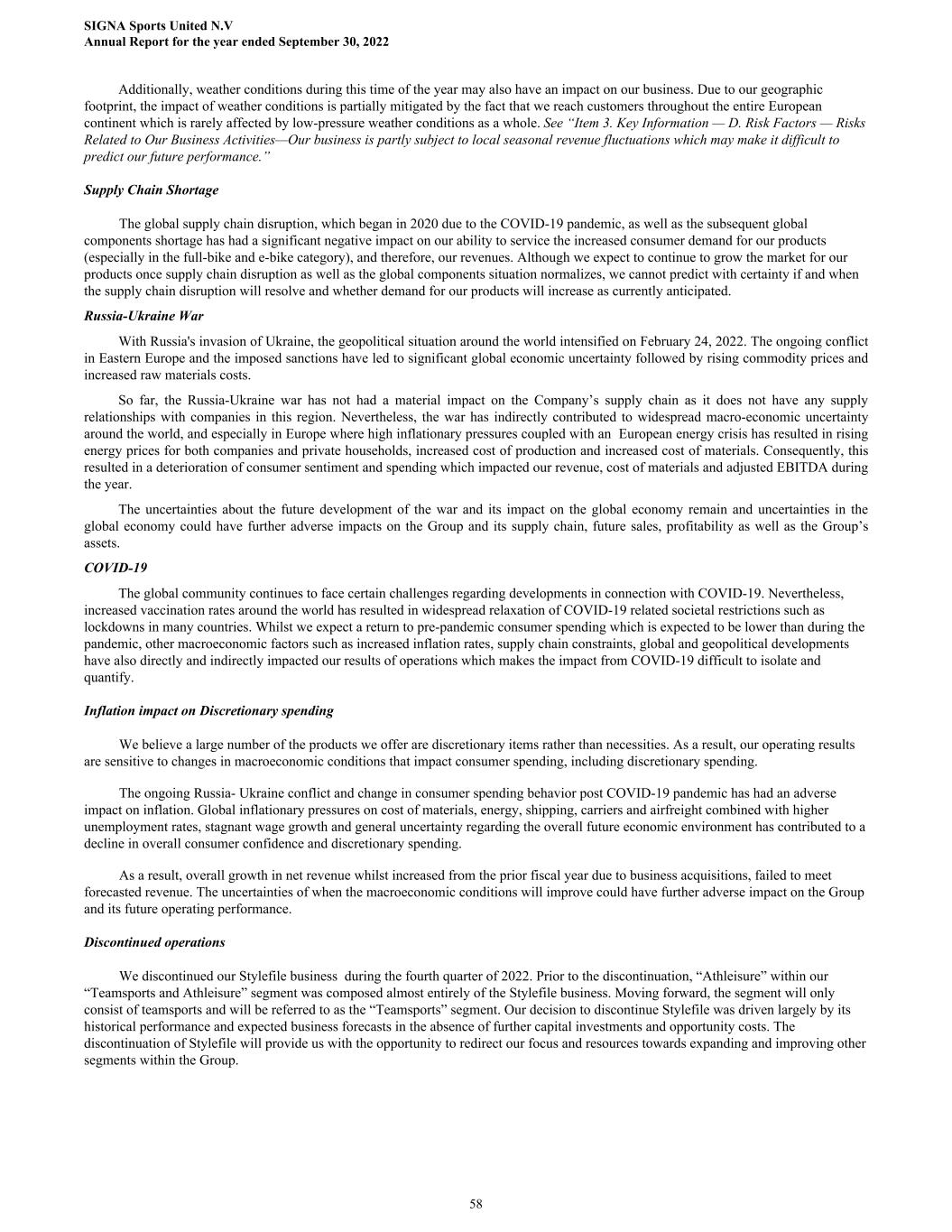
Additionally, weather conditions during this time of the year may also have an impact on our business. Due to our geographic footprint, the impact of weather conditions is partially mitigated by the fact that we reach customers throughout the entire European continent which is rarely affected by low-pressure weather conditions as a whole. See “Item 3. Key Information — D. Risk Factors — Risks Related to Our Business Activities—Our business is partly subject to local seasonal revenue fluctuations which may make it difficult to predict our future performance.” Supply Chain Shortage The global supply chain disruption, which began in 2020 due to the COVID-19 pandemic, as well as the subsequent global components shortage has had a significant negative impact on our ability to service the increased consumer demand for our products (especially in the full-bike and e-bike category), and therefore, our revenues. Although we expect to continue to grow the market for our products once supply chain disruption as well as the global components situation normalizes, we cannot predict with certainty if and when the supply chain disruption will resolve and whether demand for our products will increase as currently anticipated. Russia-Ukraine War With Russia's invasion of Ukraine, the geopolitical situation around the world intensified on February 24, 2022. The ongoing conflict in Eastern Europe and the imposed sanctions have led to significant global economic uncertainty followed by rising commodity prices and increased raw materials costs. So far, the Russia-Ukraine war has not had a material impact on the Company’s supply chain as it does not have any supply relationships with companies in this region. Nevertheless, the war has indirectly contributed to widespread macro-economic uncertainty around the world, and especially in Europe where high inflationary pressures coupled with an European energy crisis has resulted in rising energy prices for both companies and private households, increased cost of production and increased cost of materials. Consequently, this resulted in a deterioration of consumer sentiment and spending which impacted our revenue, cost of materials and adjusted EBITDA during the year. The uncertainties about the future development of the war and its impact on the global economy remain and uncertainties in the global economy could have further adverse impacts on the Group and its supply chain, future sales, profitability as well as the Group’s assets. COVID-19 The global community continues to face certain challenges regarding developments in connection with COVID-19. Nevertheless, increased vaccination rates around the world has resulted in widespread relaxation of COVID-19 related societal restrictions such as lockdowns in many countries. Whilst we expect a return to pre-pandemic consumer spending which is expected to be lower than during the pandemic, other macroeconomic factors such as increased inflation rates, supply chain constraints, global and geopolitical developments have also directly and indirectly impacted our results of operations which makes the impact from COVID-19 difficult to isolate and quantify. Inflation impact on Discretionary spending We believe a large number of the products we offer are discretionary items rather than necessities. As a result, our operating results are sensitive to changes in macroeconomic conditions that impact consumer spending, including discretionary spending. The ongoing Russia- Ukraine conflict and change in consumer spending behavior post COVID-19 pandemic has had an adverse impact on inflation. Global inflationary pressures on cost of materials, energy, shipping, carriers and airfreight combined with higher unemployment rates, stagnant wage growth and general uncertainty regarding the overall future economic environment has contributed to a decline in overall consumer confidence and discretionary spending. As a result, overall growth in net revenue whilst increased from the prior fiscal year due to business acquisitions, failed to meet forecasted revenue. The uncertainties of when the macroeconomic conditions will improve could have further adverse impact on the Group and its future operating performance. Discontinued operations We discontinued our Stylefile business during the fourth quarter of 2022. Prior to the discontinuation, “Athleisure” within our “Teamsports and Athleisure” segment was composed almost entirely of the Stylefile business. Moving forward, the segment will only consist of teamsports and will be referred to as the “Teamsports” segment. Our decision to discontinue Stylefile was driven largely by its historical performance and expected business forecasts in the absence of further capital investments and opportunity costs. The discontinuation of Stylefile will provide us with the opportunity to redirect our focus and resources towards expanding and improving other segments within the Group. SIGNA Sports United N.V Annual Report for the year ended September 30, 2022 58
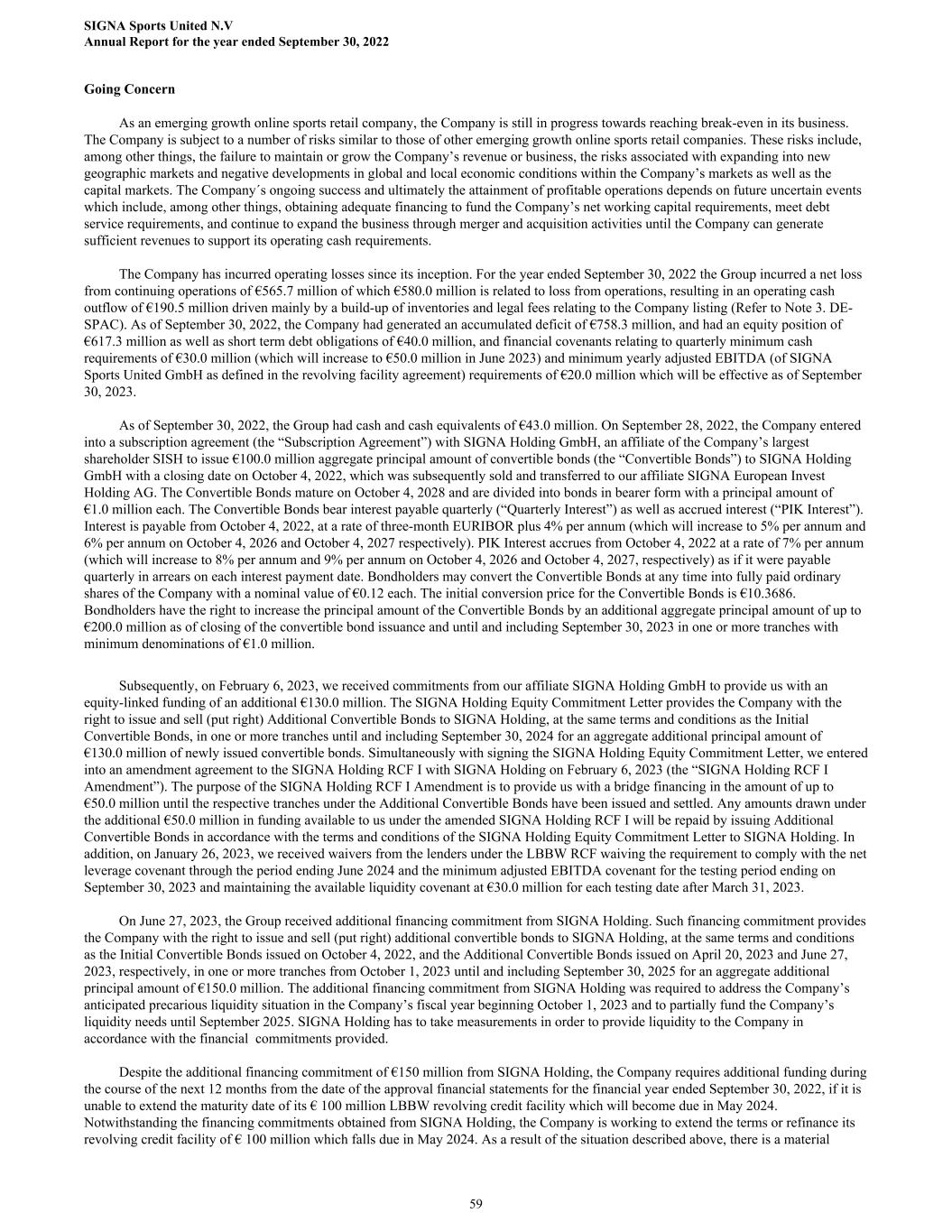
Going Concern As an emerging growth online sports retail company, the Company is still in progress towards reaching break-even in its business. The Company is subject to a number of risks similar to those of other emerging growth online sports retail companies. These risks include, among other things, the failure to maintain or grow the Company’s revenue or business, the risks associated with expanding into new geographic markets and negative developments in global and local economic conditions within the Company’s markets as well as the capital markets. The Company´s ongoing success and ultimately the attainment of profitable operations depends on future uncertain events which include, among other things, obtaining adequate financing to fund the Company’s net working capital requirements, meet debt service requirements, and continue to expand the business through merger and acquisition activities until the Company can generate sufficient revenues to support its operating cash requirements. The Company has incurred operating losses since its inception. For the year ended September 30, 2022 the Group incurred a net loss from continuing operations of €565.7 million of which €580.0 million is related to loss from operations, resulting in an operating cash outflow of €190.5 million driven mainly by a build-up of inventories and legal fees relating to the Company listing (Refer to Note 3. DE- SPAC). As of September 30, 2022, the Company had generated an accumulated deficit of €758.3 million, and had an equity position of €617.3 million as well as short term debt obligations of €40.0 million, and financial covenants relating to quarterly minimum cash requirements of €30.0 million (which will increase to €50.0 million in June 2023) and minimum yearly adjusted EBITDA (of SIGNA Sports United GmbH as defined in the revolving facility agreement) requirements of €20.0 million which will be effective as of September 30, 2023. As of September 30, 2022, the Group had cash and cash equivalents of €43.0 million. On September 28, 2022, the Company entered into a subscription agreement (the “Subscription Agreement”) with SIGNA Holding GmbH, an affiliate of the Company’s largest shareholder SISH to issue €100.0 million aggregate principal amount of convertible bonds (the “Convertible Bonds”) to SIGNA Holding GmbH with a closing date on October 4, 2022, which was subsequently sold and transferred to our affiliate SIGNA European Invest Holding AG. The Convertible Bonds mature on October 4, 2028 and are divided into bonds in bearer form with a principal amount of €1.0 million each. The Convertible Bonds bear interest payable quarterly (“Quarterly Interest”) as well as accrued interest (“PIK Interest”). Interest is payable from October 4, 2022, at a rate of three-month EURIBOR plus 4% per annum (which will increase to 5% per annum and 6% per annum on October 4, 2026 and October 4, 2027 respectively). PIK Interest accrues from October 4, 2022 at a rate of 7% per annum (which will increase to 8% per annum and 9% per annum on October 4, 2026 and October 4, 2027, respectively) as if it were payable quarterly in arrears on each interest payment date. Bondholders may convert the Convertible Bonds at any time into fully paid ordinary shares of the Company with a nominal value of €0.12 each. The initial conversion price for the Convertible Bonds is €10.3686. Bondholders have the right to increase the principal amount of the Convertible Bonds by an additional aggregate principal amount of up to €200.0 million as of closing of the convertible bond issuance and until and including September 30, 2023 in one or more tranches with minimum denominations of €1.0 million. Subsequently, on February 6, 2023, we received commitments from our affiliate SIGNA Holding GmbH to provide us with an equity-linked funding of an additional €130.0 million. The SIGNA Holding Equity Commitment Letter provides the Company with the right to issue and sell (put right) Additional Convertible Bonds to SIGNA Holding, at the same terms and conditions as the Initial Convertible Bonds, in one or more tranches until and including September 30, 2024 for an aggregate additional principal amount of €130.0 million of newly issued convertible bonds. Simultaneously with signing the SIGNA Holding Equity Commitment Letter, we entered into an amendment agreement to the SIGNA Holding RCF I with SIGNA Holding on February 6, 2023 (the “SIGNA Holding RCF I Amendment”). The purpose of the SIGNA Holding RCF I Amendment is to provide us with a bridge financing in the amount of up to €50.0 million until the respective tranches under the Additional Convertible Bonds have been issued and settled. Any amounts drawn under the additional €50.0 million in funding available to us under the amended SIGNA Holding RCF I will be repaid by issuing Additional Convertible Bonds in accordance with the terms and conditions of the SIGNA Holding Equity Commitment Letter to SIGNA Holding. In addition, on January 26, 2023, we received waivers from the lenders under the LBBW RCF waiving the requirement to comply with the net leverage covenant through the period ending June 2024 and the minimum adjusted EBITDA covenant for the testing period ending on September 30, 2023 and maintaining the available liquidity covenant at €30.0 million for each testing date after March 31, 2023. On June 27, 2023, the Group received additional financing commitment from SIGNA Holding. Such financing commitment provides the Company with the right to issue and sell (put right) additional convertible bonds to SIGNA Holding, at the same terms and conditions as the Initial Convertible Bonds issued on October 4, 2022, and the Additional Convertible Bonds issued on April 20, 2023 and June 27, 2023, respectively, in one or more tranches from October 1, 2023 until and including September 30, 2025 for an aggregate additional principal amount of €150.0 million. The additional financing commitment from SIGNA Holding was required to address the Company’s anticipated precarious liquidity situation in the Company’s fiscal year beginning October 1, 2023 and to partially fund the Company’s liquidity needs until September 2025. SIGNA Holding has to take measurements in order to provide liquidity to the Company in accordance with the financial commitments provided. Despite the additional financing commitment of €150 million from SIGNA Holding, the Company requires additional funding during the course of the next 12 months from the date of the approval financial statements for the financial year ended September 30, 2022, if it is unable to extend the maturity date of its € 100 million LBBW revolving credit facility which will become due in May 2024. Notwithstanding the financing commitments obtained from SIGNA Holding, the Company is working to extend the terms or refinance its revolving credit facility of € 100 million which falls due in May 2024. As a result of the situation described above, there is a material SIGNA Sports United N.V Annual Report for the year ended September 30, 2022 59
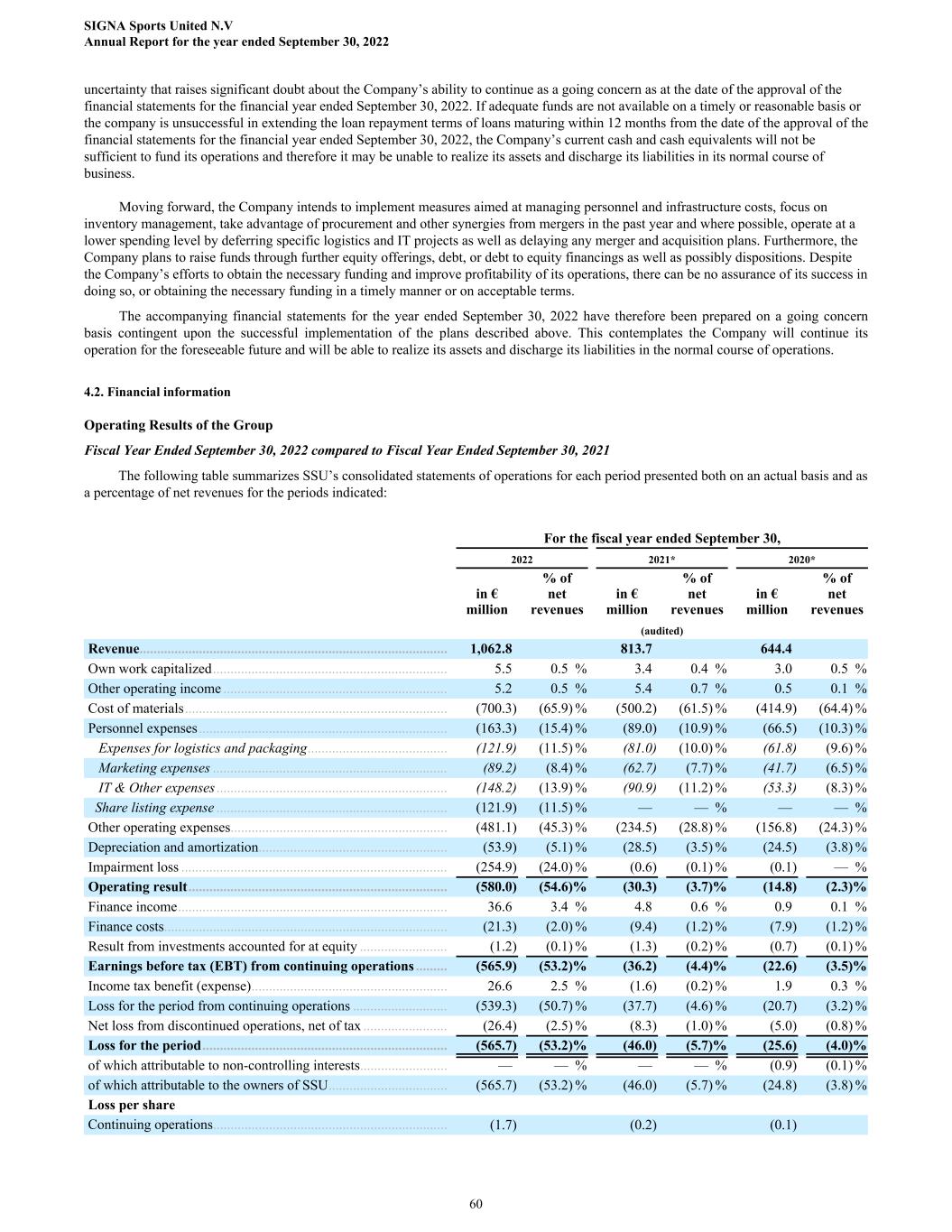
uncertainty that raises significant doubt about the Company’s ability to continue as a going concern as at the date of the approval of the financial statements for the financial year ended September 30, 2022. If adequate funds are not available on a timely or reasonable basis or the company is unsuccessful in extending the loan repayment terms of loans maturing within 12 months from the date of the approval of the financial statements for the financial year ended September 30, 2022, the Company’s current cash and cash equivalents will not be sufficient to fund its operations and therefore it may be unable to realize its assets and discharge its liabilities in its normal course of business. Moving forward, the Company intends to implement measures aimed at managing personnel and infrastructure costs, focus on inventory management, take advantage of procurement and other synergies from mergers in the past year and where possible, operate at a lower spending level by deferring specific logistics and IT projects as well as delaying any merger and acquisition plans. Furthermore, the Company plans to raise funds through further equity offerings, debt, or debt to equity financings as well as possibly dispositions. Despite the Company’s efforts to obtain the necessary funding and improve profitability of its operations, there can be no assurance of its success in doing so, or obtaining the necessary funding in a timely manner or on acceptable terms. The accompanying financial statements for the year ended September 30, 2022 have therefore been prepared on a going concern basis contingent upon the successful implementation of the plans described above. This contemplates the Company will continue its operation for the foreseeable future and will be able to realize its assets and discharge its liabilities in the normal course of operations. 4.2. Financial information Operating Results of the Group Fiscal Year Ended September 30, 2022 compared to Fiscal Year Ended September 30, 2021 The following table summarizes SSU’s consolidated statements of operations for each period presented both on an actual basis and as a percentage of net revenues for the periods indicated: For the fiscal year ended September 30, 2022 2021* 2020* in € million % of net revenues in € million % of net revenues in € million % of net revenues (audited) Revenue ........................................................................................ 1,062.8 813.7 644.4 Own work capitalized ................................................................... 5.5 0.5 % 3.4 0.4 % 3.0 0.5 % Other operating income ................................................................ 5.2 0.5 % 5.4 0.7 % 0.5 0.1 % Cost of materials ........................................................................... (700.3) (65.9) % (500.2) (61.5) % (414.9) (64.4) % Personnel expenses ....................................................................... (163.3) (15.4) % (89.0) (10.9) % (66.5) (10.3) % Expenses for logistics and packaging ........................................ (121.9) (11.5) % (81.0) (10.0) % (61.8) (9.6) % Marketing expenses ................................................................... (89.2) (8.4) % (62.7) (7.7) % (41.7) (6.5) % IT & Other expenses .................................................................. (148.2) (13.9) % (90.9) (11.2) % (53.3) (8.3) % Share listing expense .................................................................. (121.9) (11.5) % — — % — — % Other operating expenses .............................................................. (481.1) (45.3) % (234.5) (28.8) % (156.8) (24.3) % Depreciation and amortization ...................................................... (53.9) (5.1) % (28.5) (3.5) % (24.5) (3.8) % Impairment loss ............................................................................ (254.9) (24.0) % (0.6) (0.1) % (0.1) — % Operating result .......................................................................... (580.0) (54.6) % (30.3) (3.7) % (14.8) (2.3) % Finance income ............................................................................. 36.6 3.4 % 4.8 0.6 % 0.9 0.1 % Finance costs ................................................................................. (21.3) (2.0) % (9.4) (1.2) % (7.9) (1.2) % Result from investments accounted for at equity ......................... (1.2) (0.1) % (1.3) (0.2) % (0.7) (0.1) % Earnings before tax (EBT) from continuing operations ......... (565.9) (53.2) % (36.2) (4.4) % (22.6) (3.5) % Income tax benefit (expense) ........................................................ 26.6 2.5 % (1.6) (0.2) % 1.9 0.3 % Loss for the period from continuing operations ........................... (539.3) (50.7) % (37.7) (4.6) % (20.7) (3.2) % Net loss from discontinued operations, net of tax ........................ (26.4) (2.5) % (8.3) (1.0) % (5.0) (0.8) % Loss for the period ...................................................................... (565.7) (53.2) % (46.0) (5.7) % (25.6) (4.0) % of which attributable to non-controlling interests ......................... — — % — — % (0.9) (0.1) % of which attributable to the owners of SSU .................................. (565.7) (53.2) % (46.0) (5.7) % (24.8) (3.8) % Loss per share Continuing operations ................................................................... (1.7) (0.2) (0.1) SIGNA Sports United N.V Annual Report for the year ended September 30, 2022 60

Loss attributable to the owners of SIGNA Sports United ............ (1.8) (0.2) (0.1) * The comparative numbers have been re-presented as a result of discontinued operations. Refer to Note 11- Discontinued Operations. Revenue Revenue includes revenue from the sale of merchandise net of deduction of sales tax, returns, prepayments, customer discounts and rebates. For the fiscal year ended September 30, 2022, revenues were €1,062.8 million, an increase of 30.6% or €249.1 million, compared to €813.7 million in the fiscal year ended September 30, 2021. The increase in overall revenue and overall active customers was driven primarily from inorganic growth due to M&A activities Whilst inorganic growth through M&A activities have increased overall revenue and active customers, organic growth within our businesses was negative. The negative organic growth was primarily driven by a reduction in worldwide demand due to inflationary pressures affecting consumer confidence and discretionary spending; increase in cross border shipping and airfreight costs which has reduced our competitiveness internationally; and overall competitor pressures from the reduction of overall consumer demand which resulted in aggressive pricing strategies that reduced average selling prices. The performance of our bike and outdoor business was negatively affected by competitor pressures due to oversupply of lower-end inventories coupled with a decline in general demand. This resulted in additional marketing and inventory management strategies such as discounts and promotional events. Similarly, a shortage of products at the high end of the assortment range due to ongoing supply chain issues contributed to a loss in revenues. Our Tennis and Teamsport businesses are also facing increased competitor pressures driven by an oversupply in the market resulting in more aggressive pricing. In addition, a high fraction of planned goods were delivered late which resulted in loss of revenues. Cost of material Cost of material mainly consisted of cost for merchandise. For the fiscal year ended September 30, 2022, cost of material was €700.3 million, an increase of 40.0%, or €200.1 million, compared to €500.2 million in the fiscal year ended September 30, 2021. The increase in overall cost of material was driven mainly by higher order volumes through M&A activities Whilst overall absolute cost of material increased due to M&A activities, the ratio as a percentage to revenue increased due to overall worldwide inflationary pressures on raw materials, energy, and shipping, which increased the cost of production and ultimately the cost of materials. Personnel expenses Personnel expenses consisted of wages and salaries, social security contributions, share based compensation expenses and other personnel expenses. For the fiscal year ended September 30, 2022, personnel expenses were €163.3 million, an increase of 83.4%, or €74.2 million, compared to €89.0 million in the fiscal year ended September 30, 2021. Personnel expenses mainly consisted of wages and salaries. The increase in personnel expenses is primarily driven by the increased number of employees of newly acquired businesses. The average number of employees in the fiscal year ended September 30, 2022 was 3,623 compared to the 2,492 in the previous fiscal year. This increase is driven by M&A activities. Additionally, many new hires were made during the year to support the Company’s investment in strategic growth areas and transition to be a public and Sarbanes-Oxley compliant company. Furthermore, we incurred share-based compensation expenses of €17.8 million in the current fiscal year which included a one- off only bonus in the amount of €15.7 million which was awarded to all employees as part of the Yucaipa Merger compared to €2.7 million in the previous fiscal year to key management personnel as part of the Yucaipa Merger. Other operating expenses Other operating expenses mainly consisted of expenses for logistics and packaging (relating primarily to outbound shipping costs, return shipping costs and packaging material), marketing expenses (relating primarily to search engine advertising (Google), brand marketing), IT expenses, charges for payment services and share listing expenses.. For the fiscal year ended September 30, 2022, SSU’s expenses for logistics and packaging were €121.9 million, an increase of 50.5%, or €40.9 million, compared to €81.0 million in the fiscal year ended September 30, 2021. The increase in overall expenses for SIGNA Sports United N.V Annual Report for the year ended September 30, 2022 61
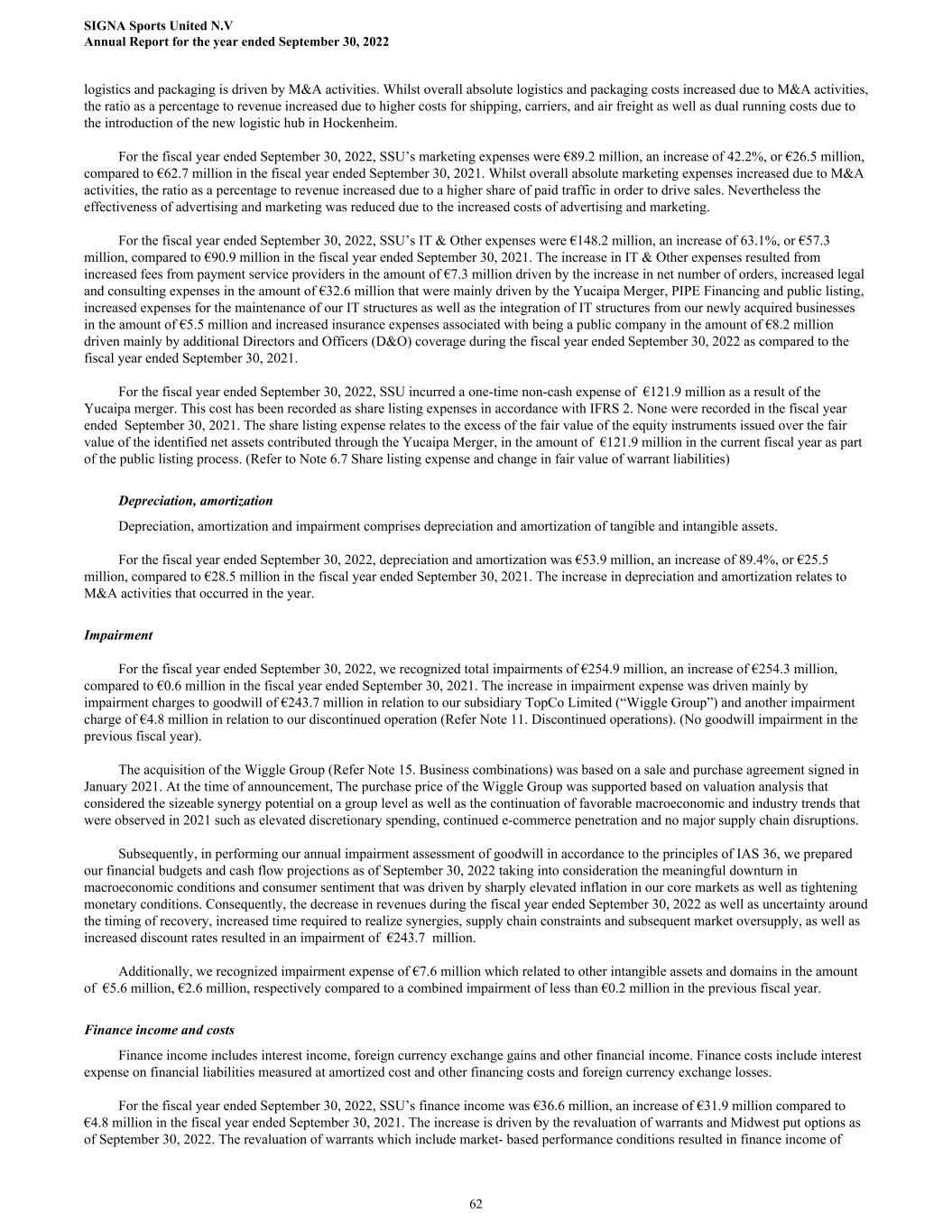
logistics and packaging is driven by M&A activities. Whilst overall absolute logistics and packaging costs increased due to M&A activities, the ratio as a percentage to revenue increased due to higher costs for shipping, carriers, and air freight as well as dual running costs due to the introduction of the new logistic hub in Hockenheim. For the fiscal year ended September 30, 2022, SSU’s marketing expenses were €89.2 million, an increase of 42.2%, or €26.5 million, compared to €62.7 million in the fiscal year ended September 30, 2021. Whilst overall absolute marketing expenses increased due to M&A activities, the ratio as a percentage to revenue increased due to a higher share of paid traffic in order to drive sales. Nevertheless the effectiveness of advertising and marketing was reduced due to the increased costs of advertising and marketing. For the fiscal year ended September 30, 2022, SSU’s IT & Other expenses were €148.2 million, an increase of 63.1%, or €57.3 million, compared to €90.9 million in the fiscal year ended September 30, 2021. The increase in IT & Other expenses resulted from increased fees from payment service providers in the amount of €7.3 million driven by the increase in net number of orders, increased legal and consulting expenses in the amount of €32.6 million that were mainly driven by the Yucaipa Merger, PIPE Financing and public listing, increased expenses for the maintenance of our IT structures as well as the integration of IT structures from our newly acquired businesses in the amount of €5.5 million and increased insurance expenses associated with being a public company in the amount of €8.2 million driven mainly by additional Directors and Officers (D&O) coverage during the fiscal year ended September 30, 2022 as compared to the fiscal year ended September 30, 2021. For the fiscal year ended September 30, 2022, SSU incurred a one-time non-cash expense of €121.9 million as a result of the Yucaipa merger. This cost has been recorded as share listing expenses in accordance with IFRS 2. None were recorded in the fiscal year ended September 30, 2021. The share listing expense relates to the excess of the fair value of the equity instruments issued over the fair value of the identified net assets contributed through the Yucaipa Merger, in the amount of €121.9 million in the current fiscal year as part of the public listing process. (Refer to Note 6.7 Share listing expense and change in fair value of warrant liabilities) Depreciation, amortization Depreciation, amortization and impairment comprises depreciation and amortization of tangible and intangible assets. For the fiscal year ended September 30, 2022, depreciation and amortization was €53.9 million, an increase of 89.4%, or €25.5 million, compared to €28.5 million in the fiscal year ended September 30, 2021. The increase in depreciation and amortization relates to M&A activities that occurred in the year. Impairment For the fiscal year ended September 30, 2022, we recognized total impairments of €254.9 million, an increase of €254.3 million, compared to €0.6 million in the fiscal year ended September 30, 2021. The increase in impairment expense was driven mainly by impairment charges to goodwill of €243.7 million in relation to our subsidiary TopCo Limited (“Wiggle Group”) and another impairment charge of €4.8 million in relation to our discontinued operation (Refer Note 11. Discontinued operations). (No goodwill impairment in the previous fiscal year). The acquisition of the Wiggle Group (Refer Note 15. Business combinations) was based on a sale and purchase agreement signed in January 2021. At the time of announcement, The purchase price of the Wiggle Group was supported based on valuation analysis that considered the sizeable synergy potential on a group level as well as the continuation of favorable macroeconomic and industry trends that were observed in 2021 such as elevated discretionary spending, continued e-commerce penetration and no major supply chain disruptions. Subsequently, in performing our annual impairment assessment of goodwill in accordance to the principles of IAS 36, we prepared our financial budgets and cash flow projections as of September 30, 2022 taking into consideration the meaningful downturn in macroeconomic conditions and consumer sentiment that was driven by sharply elevated inflation in our core markets as well as tightening monetary conditions. Consequently, the decrease in revenues during the fiscal year ended September 30, 2022 as well as uncertainty around the timing of recovery, increased time required to realize synergies, supply chain constraints and subsequent market oversupply, as well as increased discount rates resulted in an impairment of €243.7 million. Additionally, we recognized impairment expense of €7.6 million which related to other intangible assets and domains in the amount of €5.6 million, €2.6 million, respectively compared to a combined impairment of less than €0.2 million in the previous fiscal year. Finance income and costs Finance income includes interest income, foreign currency exchange gains and other financial income. Finance costs include interest expense on financial liabilities measured at amortized cost and other financing costs and foreign currency exchange losses. For the fiscal year ended September 30, 2022, SSU’s finance income was €36.6 million, an increase of €31.9 million compared to €4.8 million in the fiscal year ended September 30, 2021. The increase is driven by the revaluation of warrants and Midwest put options as of September 30, 2022. The revaluation of warrants which include market- based performance conditions resulted in finance income of SIGNA Sports United N.V Annual Report for the year ended September 30, 2022 62
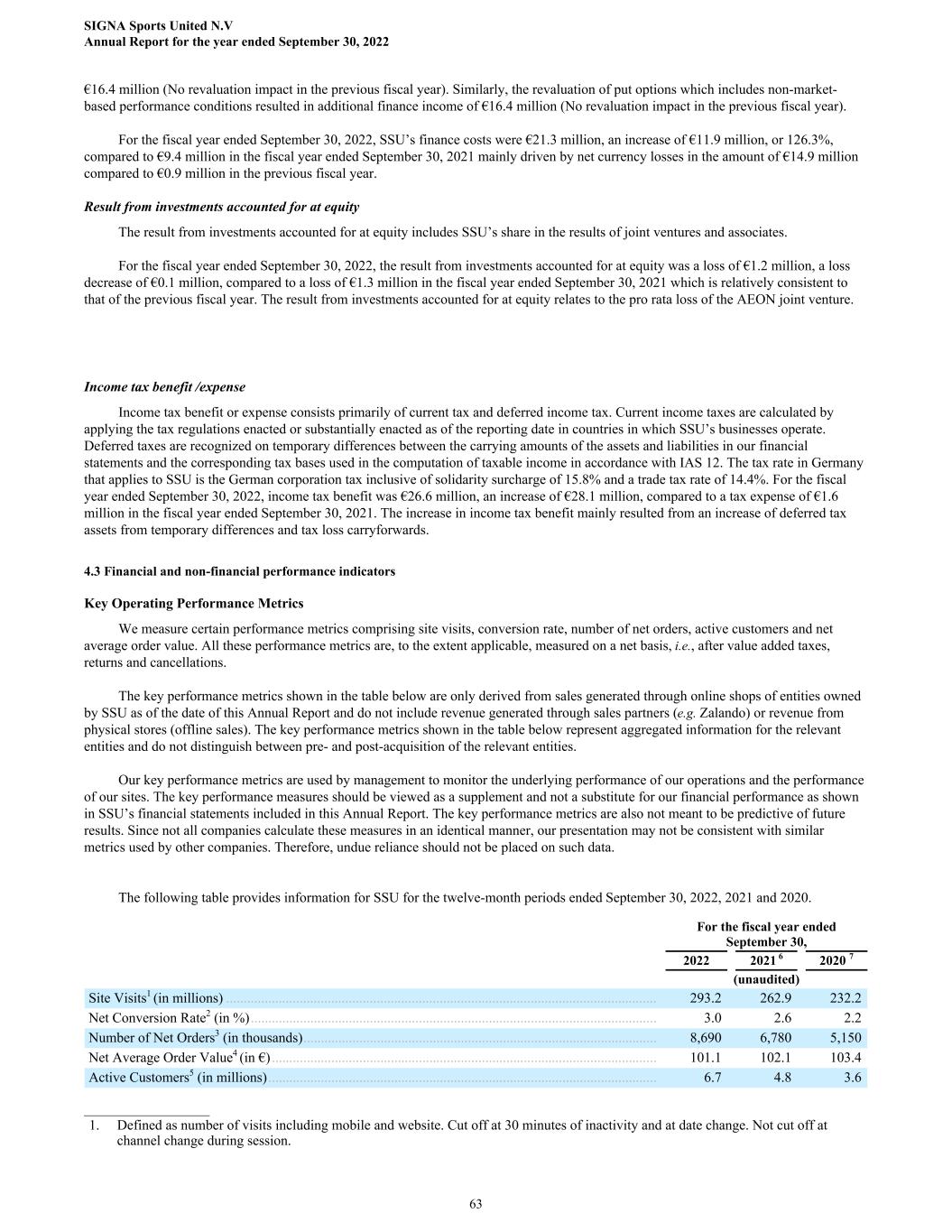
€16.4 million (No revaluation impact in the previous fiscal year). Similarly, the revaluation of put options which includes non-market- based performance conditions resulted in additional finance income of €16.4 million (No revaluation impact in the previous fiscal year). For the fiscal year ended September 30, 2022, SSU’s finance costs were €21.3 million, an increase of €11.9 million, or 126.3%, compared to €9.4 million in the fiscal year ended September 30, 2021 mainly driven by net currency losses in the amount of €14.9 million compared to €0.9 million in the previous fiscal year. Result from investments accounted for at equity The result from investments accounted for at equity includes SSU’s share in the results of joint ventures and associates. For the fiscal year ended September 30, 2022, the result from investments accounted for at equity was a loss of €1.2 million, a loss decrease of €0.1 million, compared to a loss of €1.3 million in the fiscal year ended September 30, 2021 which is relatively consistent to that of the previous fiscal year. The result from investments accounted for at equity relates to the pro rata loss of the AEON joint venture. Income tax benefit /expense Income tax benefit or expense consists primarily of current tax and deferred income tax. Current income taxes are calculated by applying the tax regulations enacted or substantially enacted as of the reporting date in countries in which SSU’s businesses operate. Deferred taxes are recognized on temporary differences between the carrying amounts of the assets and liabilities in our financial statements and the corresponding tax bases used in the computation of taxable income in accordance with IAS 12. The tax rate in Germany that applies to SSU is the German corporation tax inclusive of solidarity surcharge of 15.8% and a trade tax rate of 14.4%. For the fiscal year ended September 30, 2022, income tax benefit was €26.6 million, an increase of €28.1 million, compared to a tax expense of €1.6 million in the fiscal year ended September 30, 2021. The increase in income tax benefit mainly resulted from an increase of deferred tax assets from temporary differences and tax loss carryforwards. 4.3 Financial and non-financial performance indicators Key Operating Performance Metrics We measure certain performance metrics comprising site visits, conversion rate, number of net orders, active customers and net average order value. All these performance metrics are, to the extent applicable, measured on a net basis, i.e., after value added taxes, returns and cancellations. The key performance metrics shown in the table below are only derived from sales generated through online shops of entities owned by SSU as of the date of this Annual Report and do not include revenue generated through sales partners (e.g. Zalando) or revenue from physical stores (offline sales). The key performance metrics shown in the table below represent aggregated information for the relevant entities and do not distinguish between pre- and post-acquisition of the relevant entities. Our key performance metrics are used by management to monitor the underlying performance of our operations and the performance of our sites. The key performance measures should be viewed as a supplement and not a substitute for our financial performance as shown in SSU’s financial statements included in this Annual Report. The key performance metrics are also not meant to be predictive of future results. Since not all companies calculate these measures in an identical manner, our presentation may not be consistent with similar metrics used by other companies. Therefore, undue reliance should not be placed on such data. The following table provides information for SSU for the twelve-month periods ended September 30, 2022, 2021 and 2020. For the fiscal year ended September 30, 2022 2021 6 2020 7 (unaudited) Site Visits1 (in millions) ........................................................................................................................... 293.2 262.9 232.2 Net Conversion Rate2 (in %) .................................................................................................................... 3.0 2.6 2.2 Number of Net Orders3 (in thousands) ..................................................................................................... 8,690 6,780 5,150 Net Average Order Value4 (in €) .............................................................................................................. 101.1 102.1 103.4 Active Customers5 (in millions) ............................................................................................................... 6.7 4.8 3.6 ___________________ 1. Defined as number of visits including mobile and website. Cut off at 30 minutes of inactivity and at date change. Not cut off at channel change during session. SIGNA Sports United N.V Annual Report for the year ended September 30, 2022 63
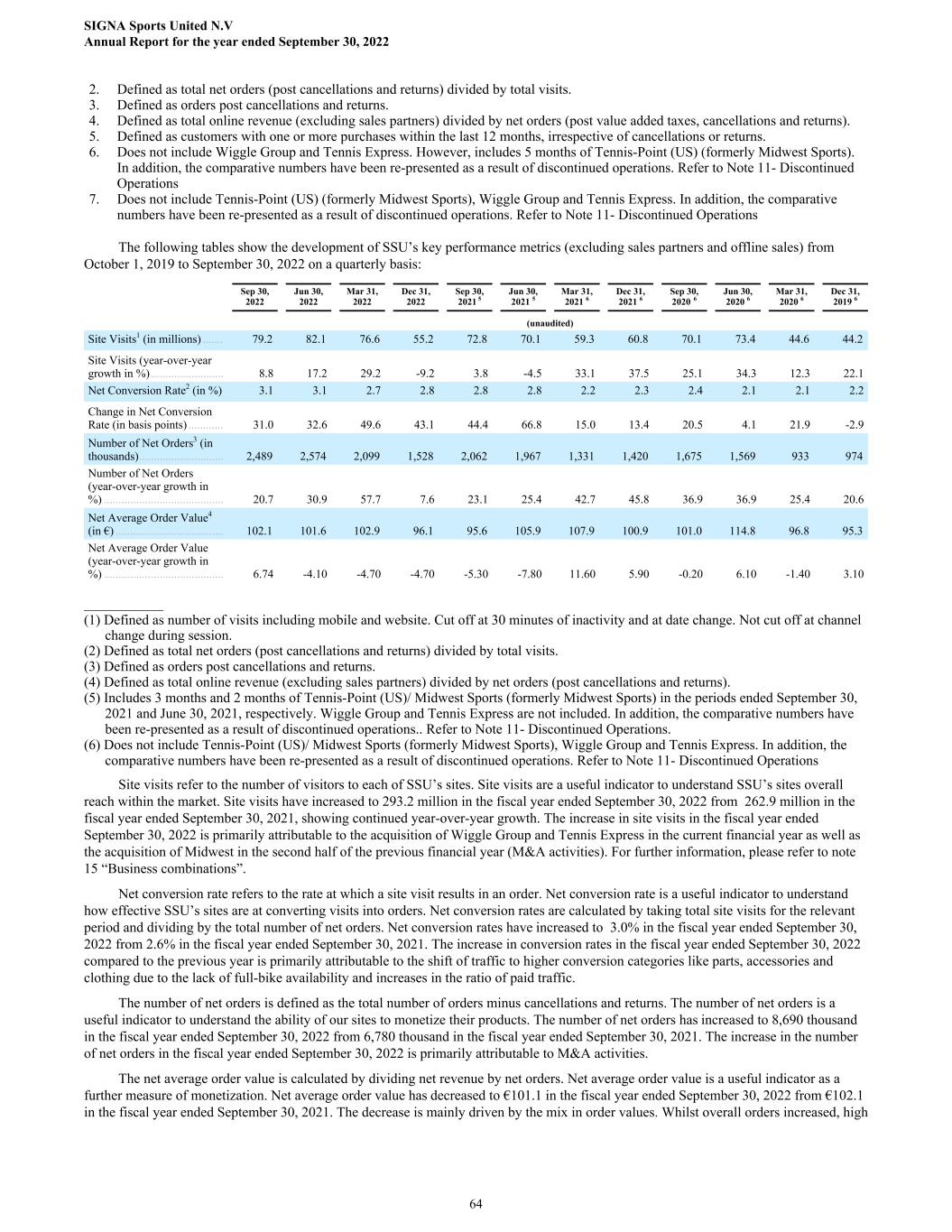
2. Defined as total net orders (post cancellations and returns) divided by total visits. 3. Defined as orders post cancellations and returns. 4. Defined as total online revenue (excluding sales partners) divided by net orders (post value added taxes, cancellations and returns). 5. Defined as customers with one or more purchases within the last 12 months, irrespective of cancellations or returns. 6. Does not include Wiggle Group and Tennis Express. However, includes 5 months of Tennis-Point (US) (formerly Midwest Sports). In addition, the comparative numbers have been re-presented as a result of discontinued operations. Refer to Note 11- Discontinued Operations 7. Does not include Tennis-Point (US) (formerly Midwest Sports), Wiggle Group and Tennis Express. In addition, the comparative numbers have been re-presented as a result of discontinued operations. Refer to Note 11- Discontinued Operations The following tables show the development of SSU’s key performance metrics (excluding sales partners and offline sales) from October 1, 2019 to September 30, 2022 on a quarterly basis: Sep 30, 2022 Jun 30, 2022 Mar 31, 2022 Dec 31, 2022 Sep 30, 2021 5 Jun 30, 2021 5 Mar 31, 2021 6 Dec 31, 2021 6 Sep 30, 2020 6 Jun 30, 2020 6 Mar 31, 2020 6 Dec 31, 2019 6 (unaudited) Site Visits1 (in millions) ....... 79.2 82.1 76.6 55.2 72.8 70.1 59.3 60.8 70.1 73.4 44.6 44.2 Site Visits (year-over-year growth in %) ......................... 8.8 17.2 29.2 -9.2 3.8 -4.5 33.1 37.5 25.1 34.3 12.3 22.1 Net Conversion Rate2 (in %) 3.1 3.1 2.7 2.8 2.8 2.8 2.2 2.3 2.4 2.1 2.1 2.2 Change in Net Conversion Rate (in basis points) ............ 31.0 32.6 49.6 43.1 44.4 66.8 15.0 13.4 20.5 4.1 21.9 -2.9 Number of Net Orders3 (in thousands) ............................. 2,489 2,574 2,099 1,528 2,062 1,967 1,331 1,420 1,675 1,569 933 974 Number of Net Orders (year-over-year growth in %) ......................................... 20.7 30.9 57.7 7.6 23.1 25.4 42.7 45.8 36.9 36.9 25.4 20.6 Net Average Order Value4 (in €) ..................................... 102.1 101.6 102.9 96.1 95.6 105.9 107.9 100.9 101.0 114.8 96.8 95.3 Net Average Order Value (year-over-year growth in %) ......................................... 6.74 -4.10 -4.70 -4.70 -5.30 -7.80 11.60 5.90 -0.20 6.10 -1.40 3.10 ____________ (1) Defined as number of visits including mobile and website. Cut off at 30 minutes of inactivity and at date change. Not cut off at channel change during session. (2) Defined as total net orders (post cancellations and returns) divided by total visits. (3) Defined as orders post cancellations and returns. (4) Defined as total online revenue (excluding sales partners) divided by net orders (post cancellations and returns). (5) Includes 3 months and 2 months of Tennis-Point (US)/ Midwest Sports (formerly Midwest Sports) in the periods ended September 30, 2021 and June 30, 2021, respectively. Wiggle Group and Tennis Express are not included. In addition, the comparative numbers have been re-presented as a result of discontinued operations.. Refer to Note 11- Discontinued Operations. (6) Does not include Tennis-Point (US)/ Midwest Sports (formerly Midwest Sports), Wiggle Group and Tennis Express. In addition, the comparative numbers have been re-presented as a result of discontinued operations. Refer to Note 11- Discontinued Operations Site visits refer to the number of visitors to each of SSU’s sites. Site visits are a useful indicator to understand SSU’s sites overall reach within the market. Site visits have increased to 293.2 million in the fiscal year ended September 30, 2022 from 262.9 million in the fiscal year ended September 30, 2021, showing continued year-over-year growth. The increase in site visits in the fiscal year ended September 30, 2022 is primarily attributable to the acquisition of Wiggle Group and Tennis Express in the current financial year as well as the acquisition of Midwest in the second half of the previous financial year (M&A activities). For further information, please refer to note 15 “Business combinations”. Net conversion rate refers to the rate at which a site visit results in an order. Net conversion rate is a useful indicator to understand how effective SSU’s sites are at converting visits into orders. Net conversion rates are calculated by taking total site visits for the relevant period and dividing by the total number of net orders. Net conversion rates have increased to 3.0% in the fiscal year ended September 30, 2022 from 2.6% in the fiscal year ended September 30, 2021. The increase in conversion rates in the fiscal year ended September 30, 2022 compared to the previous year is primarily attributable to the shift of traffic to higher conversion categories like parts, accessories and clothing due to the lack of full-bike availability and increases in the ratio of paid traffic. The number of net orders is defined as the total number of orders minus cancellations and returns. The number of net orders is a useful indicator to understand the ability of our sites to monetize their products. The number of net orders has increased to 8,690 thousand in the fiscal year ended September 30, 2022 from 6,780 thousand in the fiscal year ended September 30, 2021. The increase in the number of net orders in the fiscal year ended September 30, 2022 is primarily attributable to M&A activities. The net average order value is calculated by dividing net revenue by net orders. Net average order value is a useful indicator as a further measure of monetization. Net average order value has decreased to €101.1 in the fiscal year ended September 30, 2022 from €102.1 in the fiscal year ended September 30, 2021. The decrease is mainly driven by the mix in order values. Whilst overall orders increased, high SIGNA Sports United N.V Annual Report for the year ended September 30, 2022 64
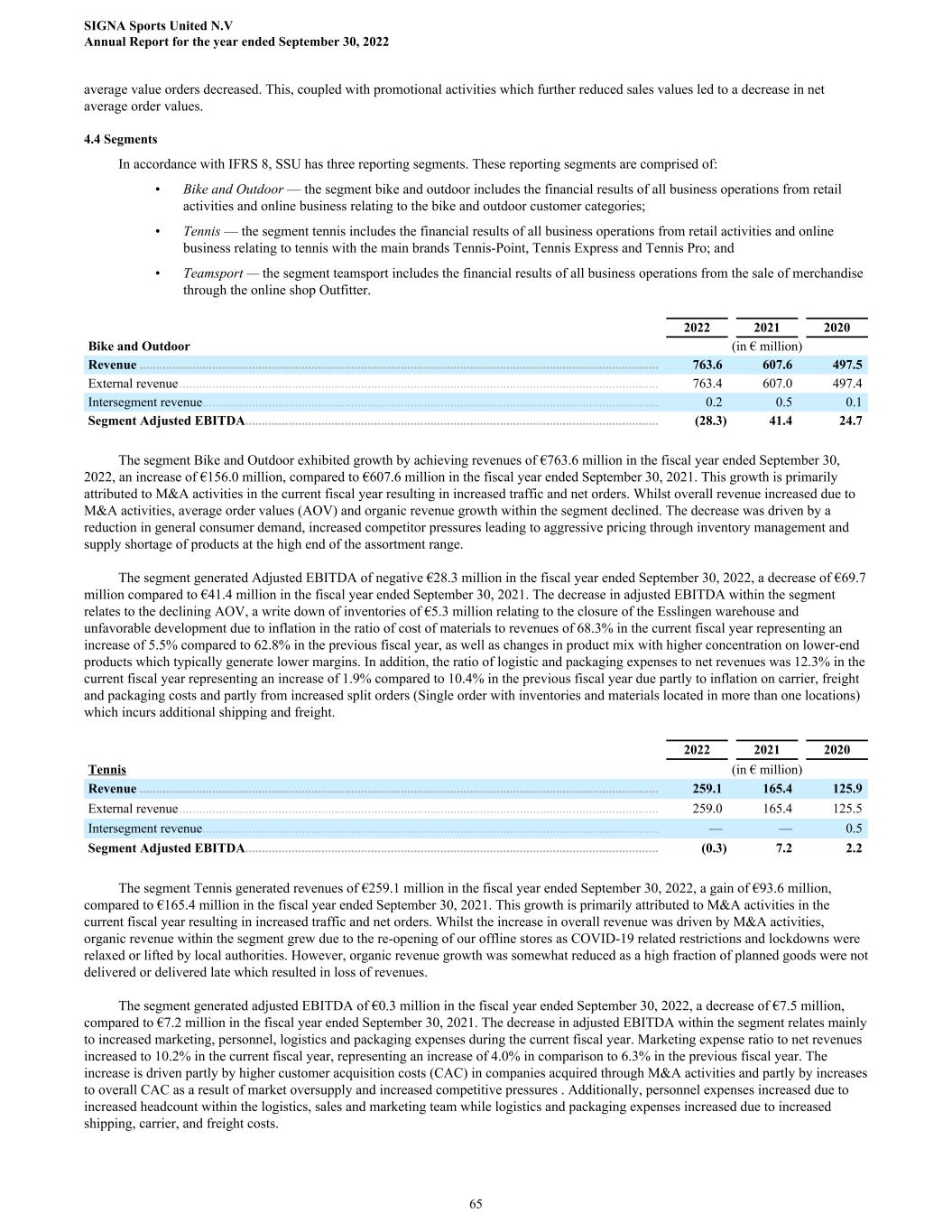
average value orders decreased. This, coupled with promotional activities which further reduced sales values led to a decrease in net average order values. 4.4 Segments In accordance with IFRS 8, SSU has three reporting segments. These reporting segments are comprised of: • Bike and Outdoor — the segment bike and outdoor includes the financial results of all business operations from retail activities and online business relating to the bike and outdoor customer categories; • Tennis — the segment tennis includes the financial results of all business operations from retail activities and online business relating to tennis with the main brands Tennis-Point, Tennis Express and Tennis Pro; and • Teamsport — the segment teamsport includes the financial results of all business operations from the sale of merchandise through the online shop Outfitter. 2022 2021 2020 Bike and Outdoor (in € million) Revenue ............................................................................................................................................................. 763.6 607.6 497.5 External revenue ................................................................................................................................................. 763.4 607.0 497.4 Intersegment revenue .......................................................................................................................................... 0.2 0.5 0.1 Segment Adjusted EBITDA ............................................................................................................................. (28.3) 41.4 24.7 The segment Bike and Outdoor exhibited growth by achieving revenues of €763.6 million in the fiscal year ended September 30, 2022, an increase of €156.0 million, compared to €607.6 million in the fiscal year ended September 30, 2021. This growth is primarily attributed to M&A activities in the current fiscal year resulting in increased traffic and net orders. Whilst overall revenue increased due to M&A activities, average order values (AOV) and organic revenue growth within the segment declined. The decrease was driven by a reduction in general consumer demand, increased competitor pressures leading to aggressive pricing through inventory management and supply shortage of products at the high end of the assortment range. The segment generated Adjusted EBITDA of negative €28.3 million in the fiscal year ended September 30, 2022, a decrease of €69.7 million compared to €41.4 million in the fiscal year ended September 30, 2021. The decrease in adjusted EBITDA within the segment relates to the declining AOV, a write down of inventories of €5.3 million relating to the closure of the Esslingen warehouse and unfavorable development due to inflation in the ratio of cost of materials to revenues of 68.3% in the current fiscal year representing an increase of 5.5% compared to 62.8% in the previous fiscal year, as well as changes in product mix with higher concentration on lower-end products which typically generate lower margins. In addition, the ratio of logistic and packaging expenses to net revenues was 12.3% in the current fiscal year representing an increase of 1.9% compared to 10.4% in the previous fiscal year due partly to inflation on carrier, freight and packaging costs and partly from increased split orders (Single order with inventories and materials located in more than one locations) which incurs additional shipping and freight. 2022 2021 2020 Tennis (in € million) Revenue ............................................................................................................................................................. 259.1 165.4 125.9 External revenue ................................................................................................................................................. 259.0 165.4 125.5 Intersegment revenue .......................................................................................................................................... — — 0.5 Segment Adjusted EBITDA ............................................................................................................................. (0.3) 7.2 2.2 The segment Tennis generated revenues of €259.1 million in the fiscal year ended September 30, 2022, a gain of €93.6 million, compared to €165.4 million in the fiscal year ended September 30, 2021. This growth is primarily attributed to M&A activities in the current fiscal year resulting in increased traffic and net orders. Whilst the increase in overall revenue was driven by M&A activities, organic revenue within the segment grew due to the re-opening of our offline stores as COVID-19 related restrictions and lockdowns were relaxed or lifted by local authorities. However, organic revenue growth was somewhat reduced as a high fraction of planned goods were not delivered or delivered late which resulted in loss of revenues. The segment generated adjusted EBITDA of €0.3 million in the fiscal year ended September 30, 2022, a decrease of €7.5 million, compared to €7.2 million in the fiscal year ended September 30, 2021. The decrease in adjusted EBITDA within the segment relates mainly to increased marketing, personnel, logistics and packaging expenses during the current fiscal year. Marketing expense ratio to net revenues increased to 10.2% in the current fiscal year, representing an increase of 4.0% in comparison to 6.3% in the previous fiscal year. The increase is driven partly by higher customer acquisition costs (CAC) in companies acquired through M&A activities and partly by increases to overall CAC as a result of market oversupply and increased competitive pressures . Additionally, personnel expenses increased due to increased headcount within the logistics, sales and marketing team while logistics and packaging expenses increased due to increased shipping, carrier, and freight costs. SIGNA Sports United N.V Annual Report for the year ended September 30, 2022 65
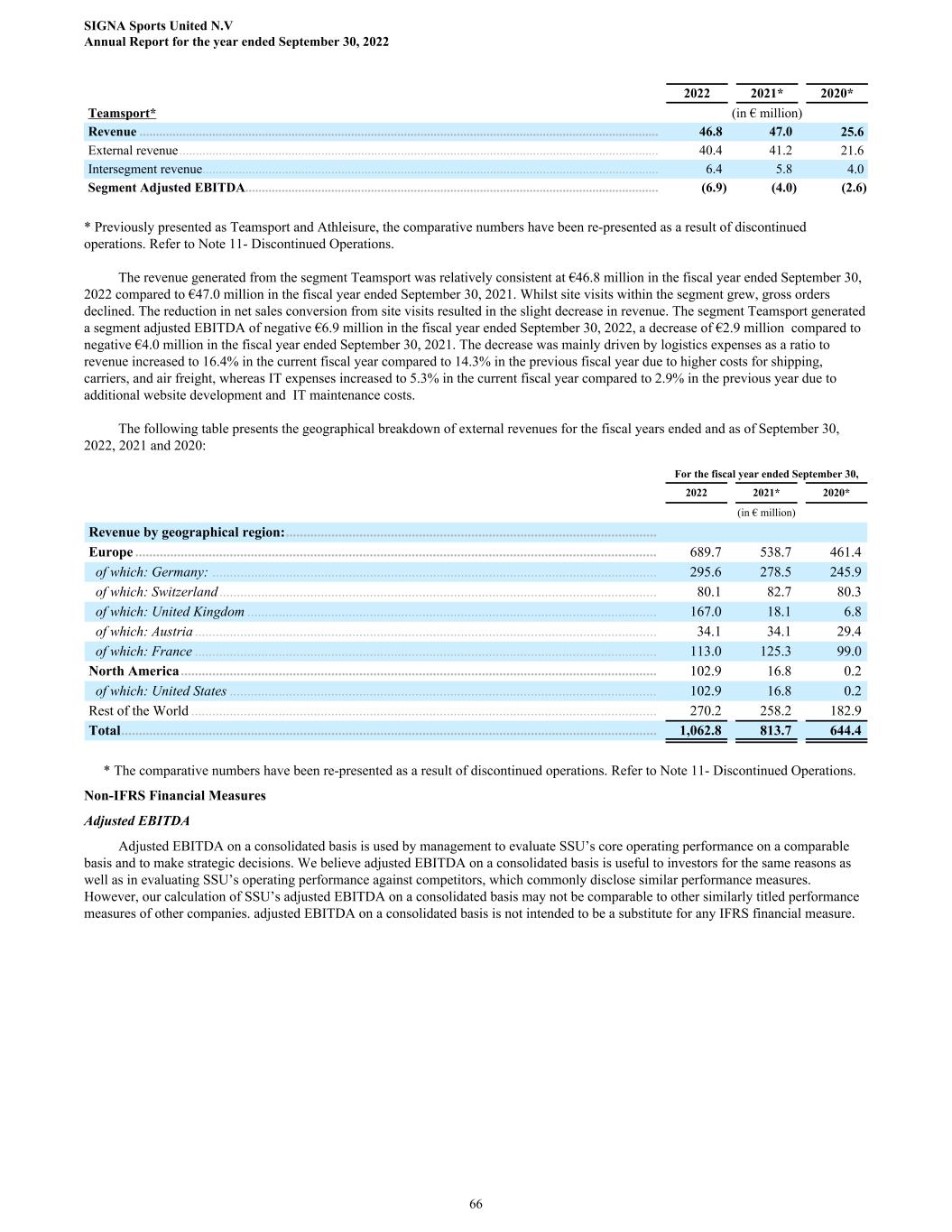
2022 2021* 2020* Teamsport* (in € million) Revenue ............................................................................................................................................................. 46.8 47.0 25.6 External revenue ................................................................................................................................................. 40.4 41.2 21.6 Intersegment revenue .......................................................................................................................................... 6.4 5.8 4.0 Segment Adjusted EBITDA ............................................................................................................................. (6.9) (4.0) (2.6) * Previously presented as Teamsport and Athleisure, the comparative numbers have been re-presented as a result of discontinued operations. Refer to Note 11- Discontinued Operations. The revenue generated from the segment Teamsport was relatively consistent at €46.8 million in the fiscal year ended September 30, 2022 compared to €47.0 million in the fiscal year ended September 30, 2021. Whilst site visits within the segment grew, gross orders declined. The reduction in net sales conversion from site visits resulted in the slight decrease in revenue. The segment Teamsport generated a segment adjusted EBITDA of negative €6.9 million in the fiscal year ended September 30, 2022, a decrease of €2.9 million compared to negative €4.0 million in the fiscal year ended September 30, 2021. The decrease was mainly driven by logistics expenses as a ratio to revenue increased to 16.4% in the current fiscal year compared to 14.3% in the previous fiscal year due to higher costs for shipping, carriers, and air freight, whereas IT expenses increased to 5.3% in the current fiscal year compared to 2.9% in the previous year due to additional website development and IT maintenance costs. The following table presents the geographical breakdown of external revenues for the fiscal years ended and as of September 30, 2022, 2021 and 2020: For the fiscal year ended September 30, 2022 2021* 2020* (in € million) Revenue by geographical region: .......................................................................................................... Europe ..................................................................................................................................................... 689.7 538.7 461.4 of which: Germany: ............................................................................................................................... 295.6 278.5 245.9 of which: Switzerland ............................................................................................................................. 80.1 82.7 80.3 of which: United Kingdom ..................................................................................................................... 167.0 18.1 6.8 of which: Austria .................................................................................................................................... 34.1 34.1 29.4 of which: France .................................................................................................................................... 113.0 125.3 99.0 North America ........................................................................................................................................ 102.9 16.8 0.2 of which: United States .......................................................................................................................... 102.9 16.8 0.2 Rest of the World ..................................................................................................................................... 270.2 258.2 182.9 Total ......................................................................................................................................................... 1,062.8 813.7 644.4 * The comparative numbers have been re-presented as a result of discontinued operations. Refer to Note 11- Discontinued Operations. Non-IFRS Financial Measures Adjusted EBITDA Adjusted EBITDA on a consolidated basis is used by management to evaluate SSU’s core operating performance on a comparable basis and to make strategic decisions. We believe adjusted EBITDA on a consolidated basis is useful to investors for the same reasons as well as in evaluating SSU’s operating performance against competitors, which commonly disclose similar performance measures. However, our calculation of SSU’s adjusted EBITDA on a consolidated basis may not be comparable to other similarly titled performance measures of other companies. adjusted EBITDA on a consolidated basis is not intended to be a substitute for any IFRS financial measure. SIGNA Sports United N.V Annual Report for the year ended September 30, 2022 66

The following table presents a reconciliation of SSU’s adjusted EBITDA on a consolidated basis from SSU’s consolidated net loss for the periods indicated. For the fiscal year ended September 30, 2022 2021* 2020* (in € millions) Net loss for the year from continuing operations ................................................................................ (539.3) (37.7) (20.7) Income tax expense/ (benefit) .................................................................................................................. (26.6) 1.6 (1.9) Depreciation and amortization ................................................................................................................. 53.9 28.5 24.5 Interest expense (net) ............................................................................................................................... 4.2 4.3 7.1 EBITDA ................................................................................................................................................... (507.7) (3.4) 9.0 Impairment loss ........................................................................................................................................ 254.9 0.6 0.1 Other net finance (income)/ costs 1 .......................................................................................................... (19.5) 0.3 — Result from investments accounted for at equity ..................................................................................... 1.2 1.3 0.7 Acquisition related charges 2 .................................................................................................................... 2.7 0.5 0.4 Reorganization and restructuring costs 3 .................................................................................................. 140.5 7.2 3.2 Consulting fees 4 ....................................................................................................................................... 41.7 21.6 0.6 Share-based compensation 5 ..................................................................................................................... 17.1 2.7 0.1 Other items not directly related to current operations 6............................................................................ 2.7 (1.2) 2.5 Adjusted EBITDA from continuing operations** .............................................................................. (66.5) 29.6 16.5 * The comparative numbers have been re-presented as a result of discontinued operations. Refer to Note 11- Discontinued Operations. ** The definition of adjusted EBITDA was changed beginning October 1, 2021 to include ramp-up costs and consulting expenses related to management hiring which had previously been excluded. The prior period amounts have been adjusted to state the relevant amounts on a comparable basis. The impact on the prior period adjusted EBITDA was less than €1.4 million. _________________ (1) Other net finance (income)/ costs consists mainly of currency gains and losses and impact from derivative revaluations, (2) Acquisition related charges consist of transaction costs incurred from acquisitions during the period or subsequent business integration related project costs directly associated with an acquired business. (3) Reorganization and restructuring costs represent fees and costs associated with various internal reorganization and restructuring initiatives across the SSU’s segments, including share listing expenses of €121.9 million and restructuring costs of €18.5 million in the fiscal year ended September 30, 2022. In the fiscal year ended September 30, 2021, reorganization and restructuring costs consisted mainly of severance costs in the amount of €2.8 million and restructuring costs in the amount of €4.0 million. (4) Consulting fees primarily consists of consultancy fees in connection with acquisitions, financing (equity and debt) and strategic projects including expenses incurred in connection with the share listing of €25.7 million, fees related to ERP implementation of €3.9 million and preparation costs in relation to being Sarbanes-Oxley (SOX) compliant of €3.2 million for the fiscal year ended September 30, 2022. In the fiscal year ended September 30, 2021, consulting fees primarily consisted of expenses incurred in connection with the public listing of €17.8 million, fees related to Business Combinations of €1.5 million and expenses for a market study in the amount of €0.8 million. (5) Share-based compensation represents non-cash share-based compensation expenses related to option awards to employees and executives. (6) Other items are excluded from adjusted EBITDA because they are not considered to be representative of the performance of our businesses. For the fiscal year ended September 30, 2022, adjusted EBITDA from continuing operations was negative €66.5 million in the fiscal year ended September 30, 2022, a decrease of €96.0 million compared to €29.6 million in the fiscal year ended September 30, 2021. The decrease in adjusted EBITDA was primarily due to the one- off €121.9 million share listing expense, and other consulting costs related to the cost of becoming a public company 4.5 Liquidity and Capital Resources Sources and uses of funds Our primary requirements for liquidity and capital are to, among others, fund our net working capital requirements, make capital expenditures, meet debt service requirements and interest payments under our indebtedness, fund general corporate uses, and expand our business through acquisitions. SIGNA Sports United N.V Annual Report for the year ended September 30, 2022 67

Our primary sources of liquidity are our existing cash reserves, the LBBW RCF, proceeds generated from the Business Combination and PIPE Financing that closed on December 14, 2021, as well as two SIGNA Holding RCFs each in the amount of €50.0 million entered into with our affiliate SIGNA Holding GmbH and the Convertible Bonds. As of September 30, 2022, the LBBW RCF had an average interest rate of 3.1% based on EURIBOR 3M plus 3.5 points and our outstanding balance on the revolving credit agreement was €100.3 million. The future payments associated with the LBBW RCF are €5.5 million within the next twelve months and €103.2 million over the following four years. The LBBW RCF is secured against a share pledge in one of our subsidiaries. As of September 30, 2022, our SIGNA Holding RCFs had an average interest rate of 6.2% based on EURIBOR 12M plus 5.0 points and our outstanding balances on the SIGNA Holding RCFs were €81.4 million. The future payments associated with the SIGNA Holding RCFs are €33.8 million in the next twelve months, and €56.3 million over the following four years. The SIGNA Holding RCFs are unsecured. The SIGNA Holding RCFs and the LBBW RCF provide liquidity as we continue to grow and require additional liquidity, in particular due to the seasonal variability of our business. On September 28, 2022, we entered into the Subscription Agreement with SIGNA Holding to issue the Initial Convertible Bonds with a closing date on October 4, 2022 which was subsequently sold and transferred to our affiliate SIGNA European Invest Holding AG. The bondholders have the right to increase the principal amount of the Initial Convertible Bonds of up to €200.0 million as of closing of the Initial Convertible Bonds issuance and until and including September 30, 2023. (Upsize Option) The Initial Convertible Bonds bear Quarterly Interest as well as PIK Interest. Interest is payable from October 4, 2022, at a rate of three-month EURIBOR plus 4% per annum (which will increase to 5% per annum and 6% per annum on October 4, 2026, and October 4, 2027, respectively). PIK Interest accrues from October 4, 2022, at a rate of 7% per annum (which will increase to 8% per annum and 9% per annum on October 4, 2026, and October 4, 2027, respectively) as if it were payable quarterly in arrears on each interest payment date. On February 6, 2023, we received the SIGNA Holding Equity Commitment Letter from SIGNA Holding. Such commitment provides the Company with the right to issue and sell (put right) Additional Convertible Bonds to our affiliate SIGNA Holding, at the same terms and conditions as the Initial Convertible Bonds, in one or more tranches until and including September 30, 2024 for an aggregate additional principal amount of €130.0 million of newly issued convertible bonds. Any subsequent exercise of the put right pursuant to the SIGNA Holding Equity Commitment Letter will reduce Euro for euro, the available amount under the ‘Upsize Option’ granted by SSU to SIGNA Holding in connection with the issuance of the ‘Initial Convertible Bonds‘. The SIGNA Holding Equity Commitment Letter was required to address our very precarious liquidity situation since the beginning of our fiscal year ending September 30, 2023 fiscal year and to provide the Company with a going-concern perspective until mid-February 2024. Simultaneously with signing the SIGNA Holding Equity Commitment Letter, we entered into an amendment agreement to the SIGNA Holding RCF I with SIGNA Holding on February 6, 2023 (the “SIGNA Holding RCF I Amendment”). The purpose of the SIGNA Holding RCF I Amendment is to provide us with a bridge financing in the amount of up to €50.0 million until the respective tranches under the Additional Convertible Bonds have been issued and settled. Any amounts drawn under the additional €50.0 million in funding available to us under the amended SIGNA Holding RCF I will be repaid by issuing Additional Convertible Bonds in accordance with the terms and conditions of the SIGNA Holding Equity Commitment Letter to SIGNA Holding. We believed on February 6, 2023, that the SIGNA Holding Equity Commitment Letter was sufficient to address our very precarious liquidity situation since the beginning of our financial year and a period of 12 months from the date of this report and to provide the Company with a going-concern perspective until mid-February 2024. However, despite the initial €130 million SIGNA Holding Equity Commitment Letter we had received on February 6, 2023, as discussed in this report, our liquidity requirements are more severe than initially anticipated. As a result, we received an additional €150 million financing commitment from SIGNA Holding on June 27, 2023. Such commitment provides the Company with the right to issue and sell (put right) additional convertible bonds to SIGNA Holding, at the same terms and conditions as the ‘Initial Convertible Bonds’ issued on October 4, 2022 and the Additional Convertible Bonds issued on April 20, 2023 and on June 27, 2023, respectively, in one or more tranches from October 1, 2023 until and including September 30, 2025 for an aggregate additional principal amount of €150.0 million. Cash and Cash Equivalents As of September 30, 2022, SSU had cash and cash equivalents of €43.0 million that primarily consisted of cash and bank deposits. A majority of SSU’s cash and cash equivalents, approximately 67.1%, were held in Germany, of which 77.5% and 6.1% were denominated in Euro and Norwegian Kroner, respectively. No other currency held in Germany accounted for more than 5.4% of SSU’s cash and cash equivalents. Approximately 32.9% of SSU’s cash and cash equivalents were held outside of Germany, with the majority held in France in Euro. Net Working Capital Net working capital is defined as inventories plus trade receivables minus trade payables. This represents the amount of cash flows and working capital we require to support our operational fluctuations throughout the year, primarily driven by the seasonality of our business. Our working capital requirements are also affected by payment terms agreed with suppliers. SIGNA Sports United N.V Annual Report for the year ended September 30, 2022 68
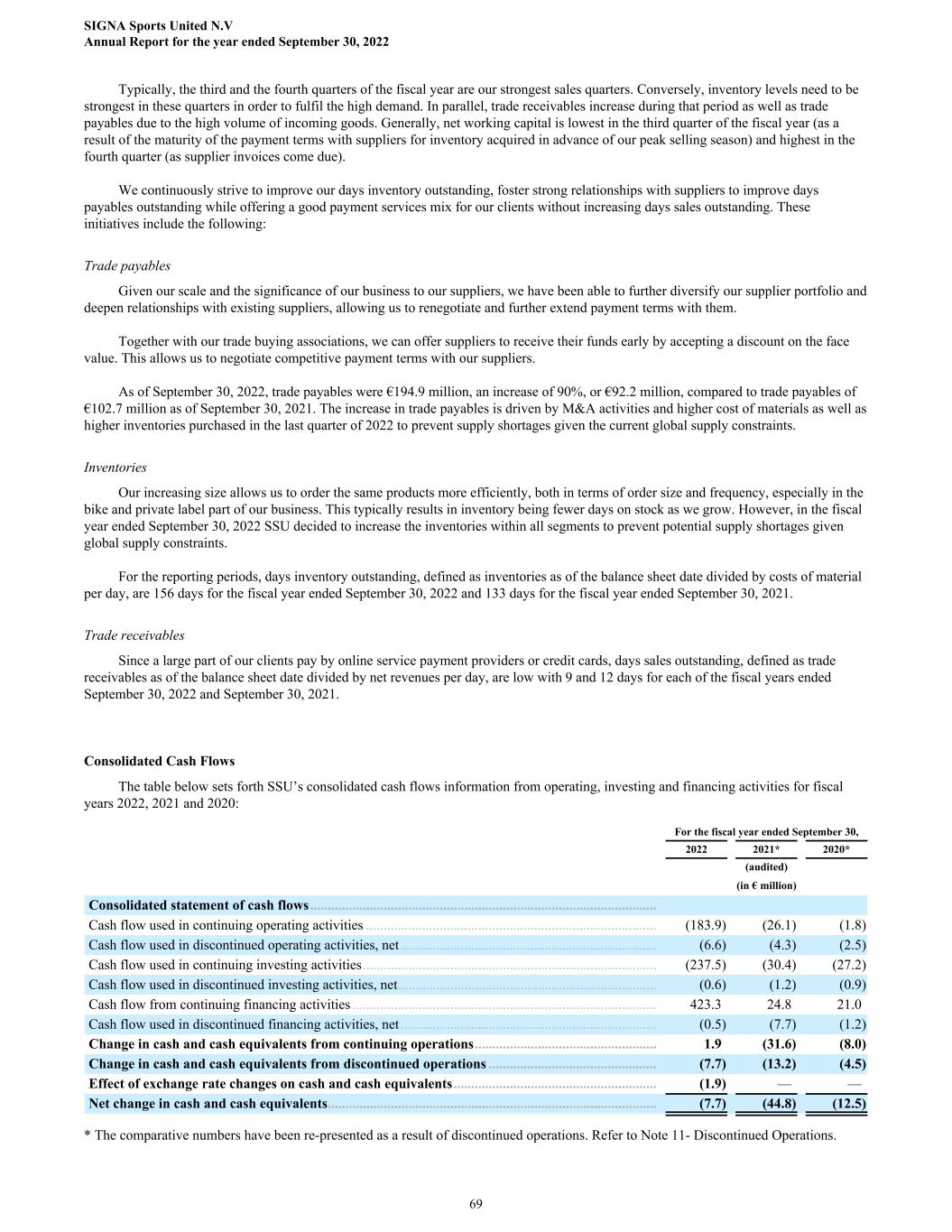
Typically, the third and the fourth quarters of the fiscal year are our strongest sales quarters. Conversely, inventory levels need to be strongest in these quarters in order to fulfil the high demand. In parallel, trade receivables increase during that period as well as trade payables due to the high volume of incoming goods. Generally, net working capital is lowest in the third quarter of the fiscal year (as a result of the maturity of the payment terms with suppliers for inventory acquired in advance of our peak selling season) and highest in the fourth quarter (as supplier invoices come due). We continuously strive to improve our days inventory outstanding, foster strong relationships with suppliers to improve days payables outstanding while offering a good payment services mix for our clients without increasing days sales outstanding. These initiatives include the following: Trade payables Given our scale and the significance of our business to our suppliers, we have been able to further diversify our supplier portfolio and deepen relationships with existing suppliers, allowing us to renegotiate and further extend payment terms with them. Together with our trade buying associations, we can offer suppliers to receive their funds early by accepting a discount on the face value. This allows us to negotiate competitive payment terms with our suppliers. As of September 30, 2022, trade payables were €194.9 million, an increase of 90%, or €92.2 million, compared to trade payables of €102.7 million as of September 30, 2021. The increase in trade payables is driven by M&A activities and higher cost of materials as well as higher inventories purchased in the last quarter of 2022 to prevent supply shortages given the current global supply constraints. Inventories Our increasing size allows us to order the same products more efficiently, both in terms of order size and frequency, especially in the bike and private label part of our business. This typically results in inventory being fewer days on stock as we grow. However, in the fiscal year ended September 30, 2022 SSU decided to increase the inventories within all segments to prevent potential supply shortages given global supply constraints. For the reporting periods, days inventory outstanding, defined as inventories as of the balance sheet date divided by costs of material per day, are 156 days for the fiscal year ended September 30, 2022 and 133 days for the fiscal year ended September 30, 2021. Trade receivables Since a large part of our clients pay by online service payment providers or credit cards, days sales outstanding, defined as trade receivables as of the balance sheet date divided by net revenues per day, are low with 9 and 12 days for each of the fiscal years ended September 30, 2022 and September 30, 2021. Consolidated Cash Flows The table below sets forth SSU’s consolidated cash flows information from operating, investing and financing activities for fiscal years 2022, 2021 and 2020: For the fiscal year ended September 30, 2022 2021* 2020* (audited) (in € million) Consolidated statement of cash flows ................................................................................................... Cash flow used in continuing operating activities ................................................................................... (183.9) (26.1) (1.8) Cash flow used in discontinued operating activities, net ......................................................................... (6.6) (4.3) (2.5) Cash flow used in continuing investing activities .................................................................................... (237.5) (30.4) (27.2) Cash flow used in discontinued investing activities, net .......................................................................... (0.6) (1.2) (0.9) Cash flow from continuing financing activities ....................................................................................... 423.3 24.8 21.0 Cash flow used in discontinued financing activities, net ......................................................................... (0.5) (7.7) (1.2) Change in cash and cash equivalents from continuing operations .................................................... 1.9 (31.6) (8.0) Change in cash and cash equivalents from discontinued operations ................................................ (7.7) (13.2) (4.5) Effect of exchange rate changes on cash and cash equivalents .......................................................... (1.9) — — Net change in cash and cash equivalents .............................................................................................. (7.7) (44.8) (12.5) * The comparative numbers have been re-presented as a result of discontinued operations. Refer to Note 11- Discontinued Operations. SIGNA Sports United N.V Annual Report for the year ended September 30, 2022 69
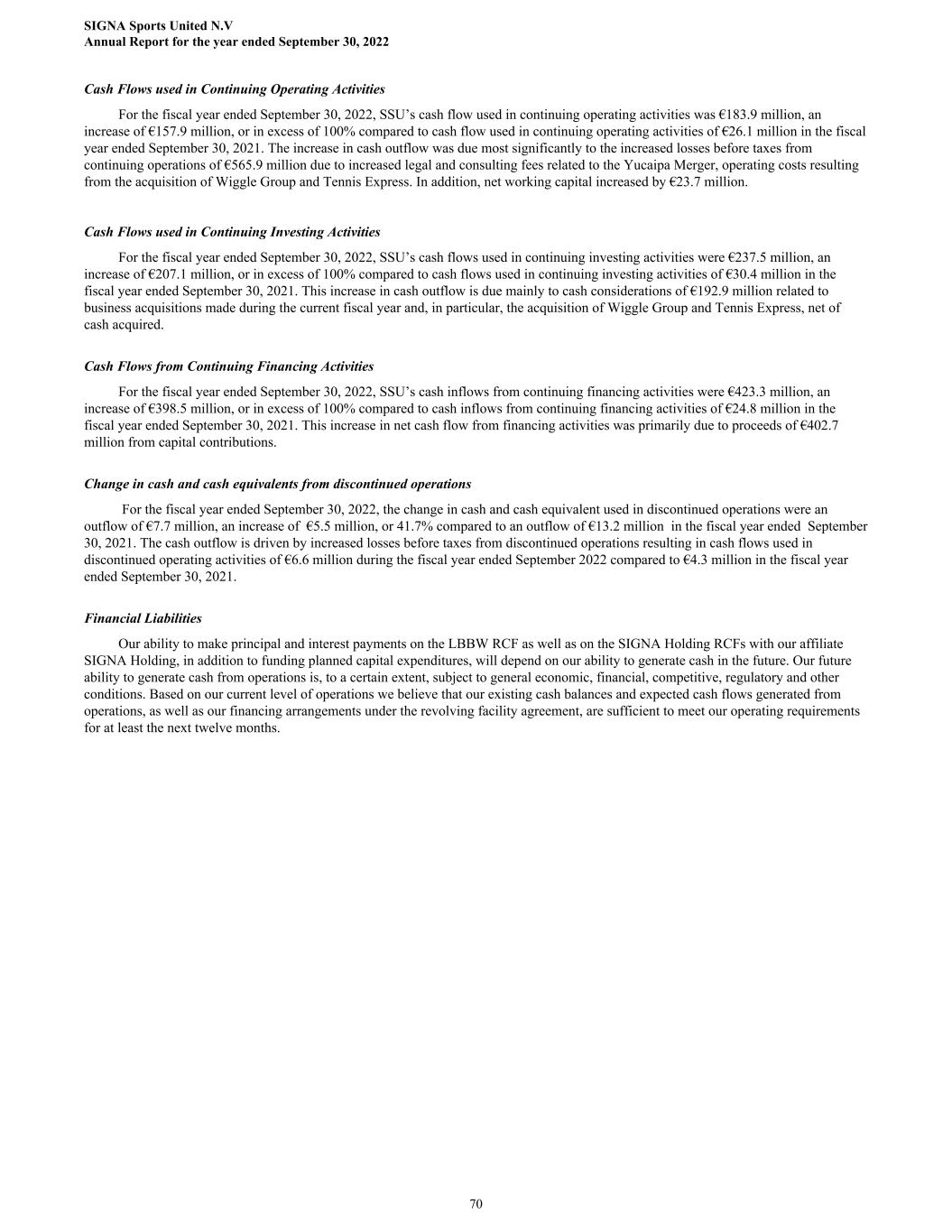
Cash Flows used in Continuing Operating Activities For the fiscal year ended September 30, 2022, SSU’s cash flow used in continuing operating activities was €183.9 million, an increase of €157.9 million, or in excess of 100% compared to cash flow used in continuing operating activities of €26.1 million in the fiscal year ended September 30, 2021. The increase in cash outflow was due most significantly to the increased losses before taxes from continuing operations of €565.9 million due to increased legal and consulting fees related to the Yucaipa Merger, operating costs resulting from the acquisition of Wiggle Group and Tennis Express. In addition, net working capital increased by €23.7 million. Cash Flows used in Continuing Investing Activities For the fiscal year ended September 30, 2022, SSU’s cash flows used in continuing investing activities were €237.5 million, an increase of €207.1 million, or in excess of 100% compared to cash flows used in continuing investing activities of €30.4 million in the fiscal year ended September 30, 2021. This increase in cash outflow is due mainly to cash considerations of €192.9 million related to business acquisitions made during the current fiscal year and, in particular, the acquisition of Wiggle Group and Tennis Express, net of cash acquired. Cash Flows from Continuing Financing Activities For the fiscal year ended September 30, 2022, SSU’s cash inflows from continuing financing activities were €423.3 million, an increase of €398.5 million, or in excess of 100% compared to cash inflows from continuing financing activities of €24.8 million in the fiscal year ended September 30, 2021. This increase in net cash flow from financing activities was primarily due to proceeds of €402.7 million from capital contributions. Change in cash and cash equivalents from discontinued operations For the fiscal year ended September 30, 2022, the change in cash and cash equivalent used in discontinued operations were an outflow of €7.7 million, an increase of €5.5 million, or 41.7% compared to an outflow of €13.2 million in the fiscal year ended September 30, 2021. The cash outflow is driven by increased losses before taxes from discontinued operations resulting in cash flows used in discontinued operating activities of €6.6 million during the fiscal year ended September 2022 compared to €4.3 million in the fiscal year ended September 30, 2021. Financial Liabilities Our ability to make principal and interest payments on the LBBW RCF as well as on the SIGNA Holding RCFs with our affiliate SIGNA Holding, in addition to funding planned capital expenditures, will depend on our ability to generate cash in the future. Our future ability to generate cash from operations is, to a certain extent, subject to general economic, financial, competitive, regulatory and other conditions. Based on our current level of operations we believe that our existing cash balances and expected cash flows generated from operations, as well as our financing arrangements under the revolving facility agreement, are sufficient to meet our operating requirements for at least the next twelve months. SIGNA Sports United N.V Annual Report for the year ended September 30, 2022 70

5. LEGAL PROCEEDINGS From time to time, we may be subject to various legal proceedings and claims that arise in the ordinary course of our business activities. The results of litigation and claims cannot be predicted with certainty. As of the date of this Annual Report, neither we nor any of our subsidiaries are party to any governmental, legal or arbitration proceedings (nor are we aware of any such proceedings that are pending or threatened) that have had or may have a significant effect on our financial position or profitability. SIGNA Sports United N.V Annual Report for the year ended September 30, 2022 71
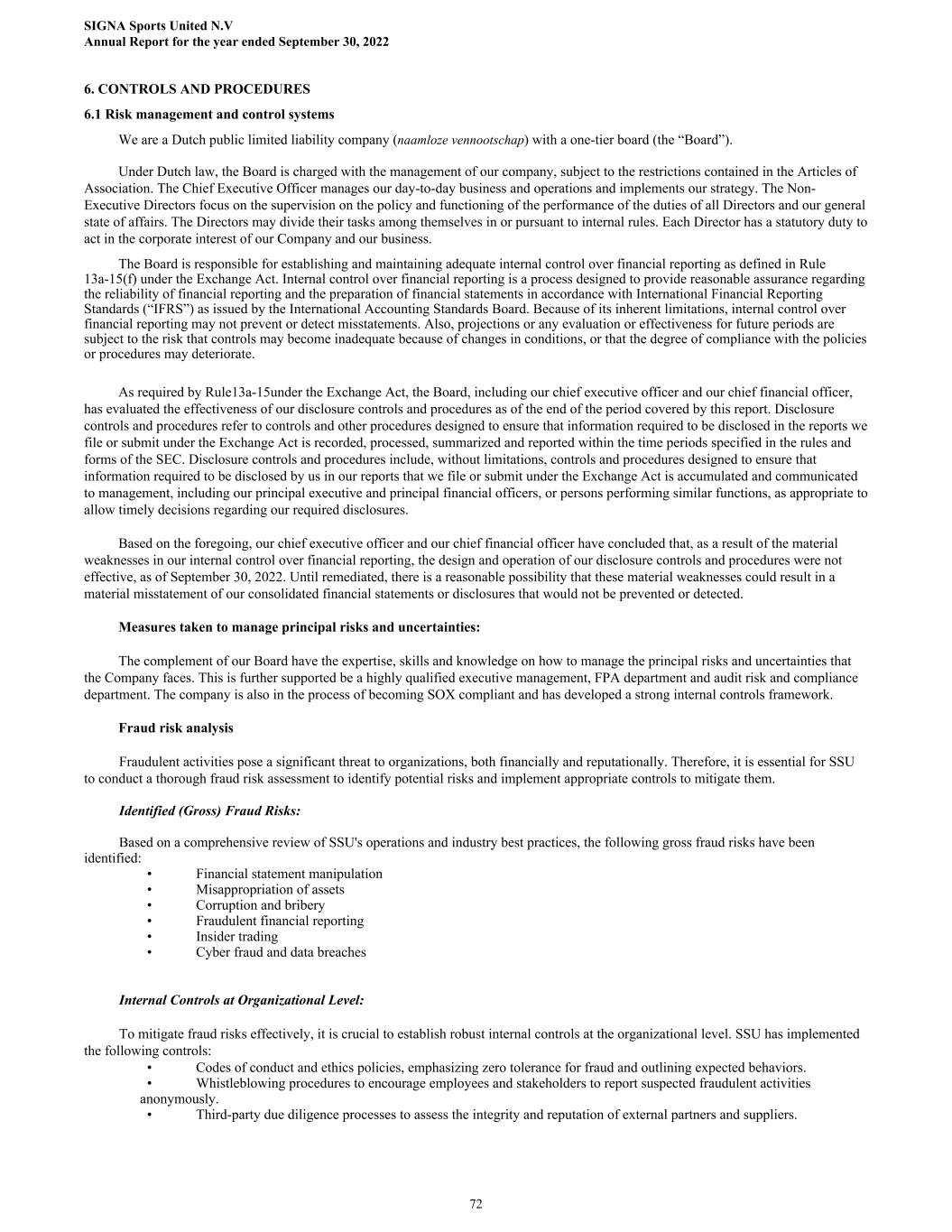
6. CONTROLS AND PROCEDURES 6.1 Risk management and control systems We are a Dutch public limited liability company (naamloze vennootschap) with a one-tier board (the “Board”). Under Dutch law, the Board is charged with the management of our company, subject to the restrictions contained in the Articles of Association. The Chief Executive Officer manages our day-to-day business and operations and implements our strategy. The Non- Executive Directors focus on the supervision on the policy and functioning of the performance of the duties of all Directors and our general state of affairs. The Directors may divide their tasks among themselves in or pursuant to internal rules. Each Director has a statutory duty to act in the corporate interest of our Company and our business. The Board is responsible for establishing and maintaining adequate internal control over financial reporting as defined in Rule 13a-15(f) under the Exchange Act. Internal control over financial reporting is a process designed to provide reasonable assurance regarding the reliability of financial reporting and the preparation of financial statements in accordance with International Financial Reporting Standards (“IFRS”) as issued by the International Accounting Standards Board. Because of its inherent limitations, internal control over financial reporting may not prevent or detect misstatements. Also, projections or any evaluation or effectiveness for future periods are subject to the risk that controls may become inadequate because of changes in conditions, or that the degree of compliance with the policies or procedures may deteriorate. As required by Rule13a-15under the Exchange Act, the Board, including our chief executive officer and our chief financial officer, has evaluated the effectiveness of our disclosure controls and procedures as of the end of the period covered by this report. Disclosure controls and procedures refer to controls and other procedures designed to ensure that information required to be disclosed in the reports we file or submit under the Exchange Act is recorded, processed, summarized and reported within the time periods specified in the rules and forms of the SEC. Disclosure controls and procedures include, without limitations, controls and procedures designed to ensure that information required to be disclosed by us in our reports that we file or submit under the Exchange Act is accumulated and communicated to management, including our principal executive and principal financial officers, or persons performing similar functions, as appropriate to allow timely decisions regarding our required disclosures. Based on the foregoing, our chief executive officer and our chief financial officer have concluded that, as a result of the material weaknesses in our internal control over financial reporting, the design and operation of our disclosure controls and procedures were not effective, as of September 30, 2022. Until remediated, there is a reasonable possibility that these material weaknesses could result in a material misstatement of our consolidated financial statements or disclosures that would not be prevented or detected. Measures taken to manage principal risks and uncertainties: The complement of our Board have the expertise, skills and knowledge on how to manage the principal risks and uncertainties that the Company faces. This is further supported be a highly qualified executive management, FPA department and audit risk and compliance department. The company is also in the process of becoming SOX compliant and has developed a strong internal controls framework. Fraud risk analysis Fraudulent activities pose a significant threat to organizations, both financially and reputationally. Therefore, it is essential for SSU to conduct a thorough fraud risk assessment to identify potential risks and implement appropriate controls to mitigate them. Identified (Gross) Fraud Risks: Based on a comprehensive review of SSU's operations and industry best practices, the following gross fraud risks have been identified: • Financial statement manipulation • Misappropriation of assets • Corruption and bribery • Fraudulent financial reporting • Insider trading • Cyber fraud and data breaches Internal Controls at Organizational Level: To mitigate fraud risks effectively, it is crucial to establish robust internal controls at the organizational level. SSU has implemented the following controls: • Codes of conduct and ethics policies, emphasizing zero tolerance for fraud and outlining expected behaviors. • Whistleblowing procedures to encourage employees and stakeholders to report suspected fraudulent activities anonymously. • Third-party due diligence processes to assess the integrity and reputation of external partners and suppliers. SIGNA Sports United N.V Annual Report for the year ended September 30, 2022 72

Internal Controls at Process Level: In addition to organizational controls, SSU has implemented internal controls at the process level to address specific fraud risks. The key controls include: • Segregation of duties to prevent any single individual from having complete control over a process. • Regular monitoring of financial transactions to identify any anomalies or irregularities. • Documented approval processes for financial transactions and expenditures. • Access controls and restricted permissions to sensitive systems and data. • Regular training and awareness programs for employees to recognize and report fraudulent activities. Procedures to Mitigate Risks: To mitigate the identified fraud risks effectively, the following procedures have been implemented: • Periodic risk assessments and updates to ensure the ongoing relevance and effectiveness of controls. • Robust internal and external audit processes to identify control weaknesses and address them promptly. • Incident response protocols to handle suspected fraud incidents, including investigation procedures and disciplinary actions. • Continuous monitoring of technological advancements and implementation of appropriate cybersecurity measures to protect against cyber fraud and data breaches. Follow-up and Recommendations for remedial actions: As a result of the fraud risk analysis, the following recommendations for remedial actions are proposed: • Strengthen internal controls by implementing an automated monitoring system to detect and alert on suspicious financial transactions. • Enhance the whistleblower program by ensuring secure and confidential reporting channels and providing incentives for reporting. • Conduct periodic fraud awareness training for employees at all levels to promote a strong anti-fraud culture. • Review and update the third-party due diligence process to incorporate emerging risks and compliance requirements. • Establish a dedicated fraud response team to investigate and address reported incidents promptly. Fraud risk analysis is an ongoing process that requires continuous monitoring, evaluation, and improvement. By implementing the recommended remedial actions and maintaining a proactive approach to fraud prevention, SSU can mitigate risks, safeguard its assets, and protect its reputation. Regular updates and reassessment of the fraud risk analysis are performed by SSU to stay ahead of evolving fraud threats. 6.2 In control statement On the basis of reports and information provided to our Board, our Board is of the opinion that: • this report provides sufficient insight into any failings in the effectiveness of the Company's risk management and control systems; • notwithstanding the material weakness in our internal control over financial reporting, the Company's risk management and control systems provide reasonable assurance that the Company's financial reporting does not contain material inaccuracies; • based on the Company's state of affairs as at the date of this report, it is justified that the Company's financial reporting is prepared on a going concern basis; and • this report states those material risks and uncertainties that are relevant to the expectation of the Company's continuity for a period of twelve months after the date of this Annual Report. Any material failings in, material changes to, and/or material improvements of the Company's risk management and control systems which have been observed, made and/or planned, respectively, during the fiscal year to which this report relates, have been discussed with our audit committee. For further information on the company code of conduct and please refer to the Governance section within our website https://signa- sportsunited.com/ SIGNA Sports United N.V Annual Report for the year ended September 30, 2022 73
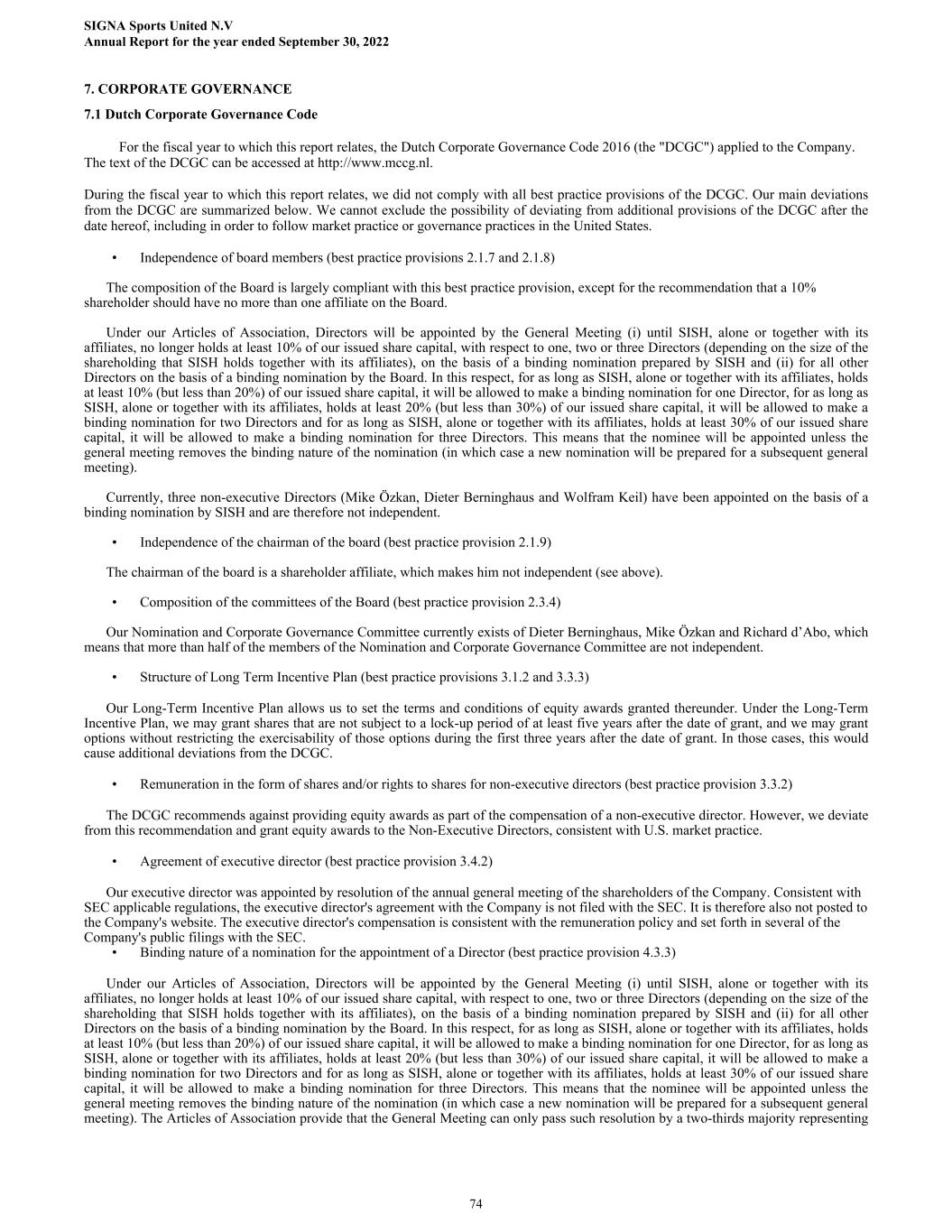
7. CORPORATE GOVERNANCE 7.1 Dutch Corporate Governance Code For the fiscal year to which this report relates, the Dutch Corporate Governance Code 2016 (the "DCGC") applied to the Company. The text of the DCGC can be accessed at http://www.mccg.nl. During the fiscal year to which this report relates, we did not comply with all best practice provisions of the DCGC. Our main deviations from the DCGC are summarized below. We cannot exclude the possibility of deviating from additional provisions of the DCGC after the date hereof, including in order to follow market practice or governance practices in the United States. • Independence of board members (best practice provisions 2.1.7 and 2.1.8) The composition of the Board is largely compliant with this best practice provision, except for the recommendation that a 10% shareholder should have no more than one affiliate on the Board. Under our Articles of Association, Directors will be appointed by the General Meeting (i) until SISH, alone or together with its affiliates, no longer holds at least 10% of our issued share capital, with respect to one, two or three Directors (depending on the size of the shareholding that SISH holds together with its affiliates), on the basis of a binding nomination prepared by SISH and (ii) for all other Directors on the basis of a binding nomination by the Board. In this respect, for as long as SISH, alone or together with its affiliates, holds at least 10% (but less than 20%) of our issued share capital, it will be allowed to make a binding nomination for one Director, for as long as SISH, alone or together with its affiliates, holds at least 20% (but less than 30%) of our issued share capital, it will be allowed to make a binding nomination for two Directors and for as long as SISH, alone or together with its affiliates, holds at least 30% of our issued share capital, it will be allowed to make a binding nomination for three Directors. This means that the nominee will be appointed unless the general meeting removes the binding nature of the nomination (in which case a new nomination will be prepared for a subsequent general meeting). Currently, three non-executive Directors (Mike Özkan, Dieter Berninghaus and Wolfram Keil) have been appointed on the basis of a binding nomination by SISH and are therefore not independent. • Independence of the chairman of the board (best practice provision 2.1.9) The chairman of the board is a shareholder affiliate, which makes him not independent (see above). • Composition of the committees of the Board (best practice provision 2.3.4) Our Nomination and Corporate Governance Committee currently exists of Dieter Berninghaus, Mike Özkan and Richard d’Abo, which means that more than half of the members of the Nomination and Corporate Governance Committee are not independent. • Structure of Long Term Incentive Plan (best practice provisions 3.1.2 and 3.3.3) Our Long-Term Incentive Plan allows us to set the terms and conditions of equity awards granted thereunder. Under the Long-Term Incentive Plan, we may grant shares that are not subject to a lock-up period of at least five years after the date of grant, and we may grant options without restricting the exercisability of those options during the first three years after the date of grant. In those cases, this would cause additional deviations from the DCGC. • Remuneration in the form of shares and/or rights to shares for non-executive directors (best practice provision 3.3.2) The DCGC recommends against providing equity awards as part of the compensation of a non-executive director. However, we deviate from this recommendation and grant equity awards to the Non-Executive Directors, consistent with U.S. market practice. • Agreement of executive director (best practice provision 3.4.2) Our executive director was appointed by resolution of the annual general meeting of the shareholders of the Company. Consistent with SEC applicable regulations, the executive director's agreement with the Company is not filed with the SEC. It is therefore also not posted to the Company's website. The executive director's compensation is consistent with the remuneration policy and set forth in several of the Company's public filings with the SEC. • Binding nature of a nomination for the appointment of a Director (best practice provision 4.3.3) Under our Articles of Association, Directors will be appointed by the General Meeting (i) until SISH, alone or together with its affiliates, no longer holds at least 10% of our issued share capital, with respect to one, two or three Directors (depending on the size of the shareholding that SISH holds together with its affiliates), on the basis of a binding nomination prepared by SISH and (ii) for all other Directors on the basis of a binding nomination by the Board. In this respect, for as long as SISH, alone or together with its affiliates, holds at least 10% (but less than 20%) of our issued share capital, it will be allowed to make a binding nomination for one Director, for as long as SISH, alone or together with its affiliates, holds at least 20% (but less than 30%) of our issued share capital, it will be allowed to make a binding nomination for two Directors and for as long as SISH, alone or together with its affiliates, holds at least 30% of our issued share capital, it will be allowed to make a binding nomination for three Directors. This means that the nominee will be appointed unless the general meeting removes the binding nature of the nomination (in which case a new nomination will be prepared for a subsequent general meeting). The Articles of Association provide that the General Meeting can only pass such resolution by a two-thirds majority representing SIGNA Sports United N.V Annual Report for the year ended September 30, 2022 74
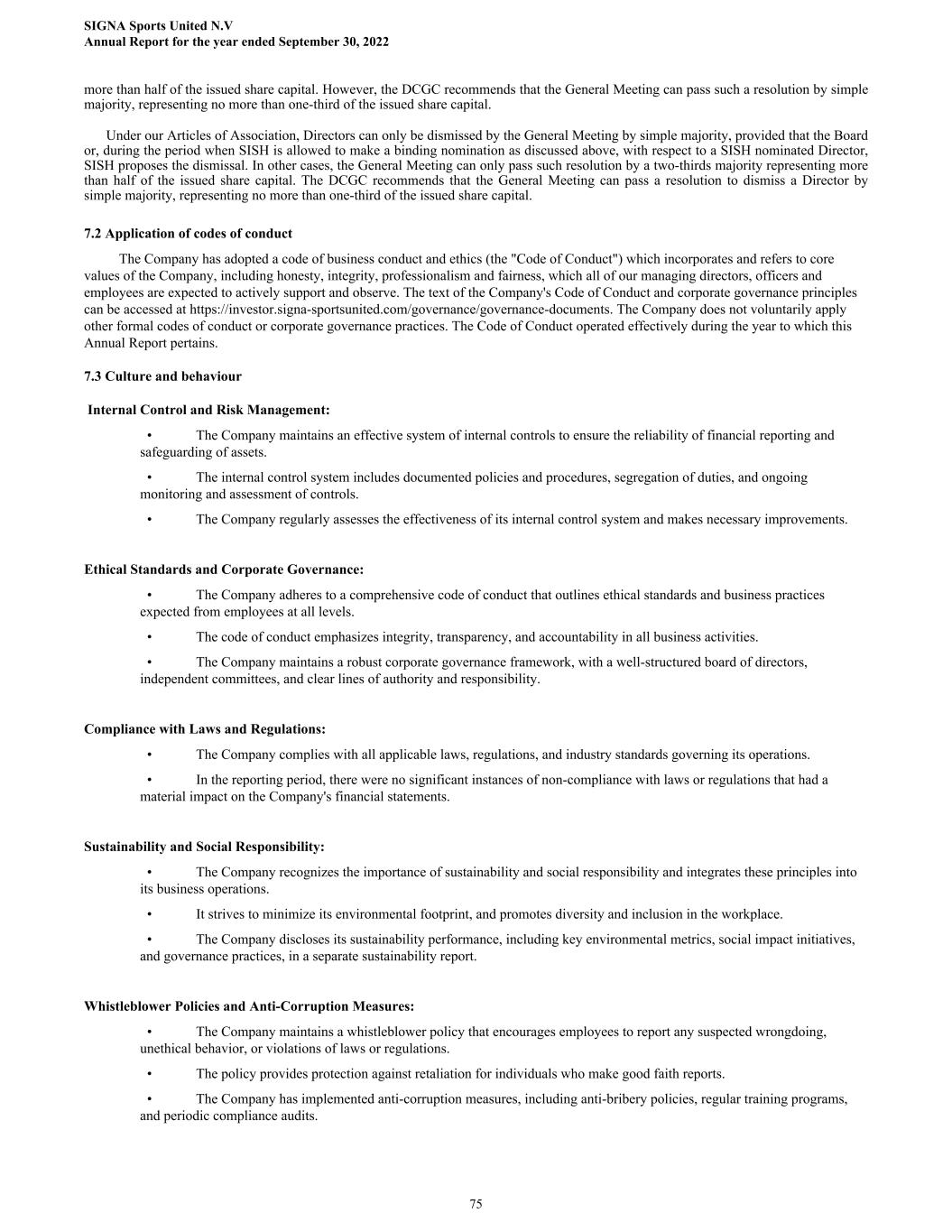
more than half of the issued share capital. However, the DCGC recommends that the General Meeting can pass such a resolution by simple majority, representing no more than one-third of the issued share capital. Under our Articles of Association, Directors can only be dismissed by the General Meeting by simple majority, provided that the Board or, during the period when SISH is allowed to make a binding nomination as discussed above, with respect to a SISH nominated Director, SISH proposes the dismissal. In other cases, the General Meeting can only pass such resolution by a two-thirds majority representing more than half of the issued share capital. The DCGC recommends that the General Meeting can pass a resolution to dismiss a Director by simple majority, representing no more than one-third of the issued share capital. 7.2 Application of codes of conduct The Company has adopted a code of business conduct and ethics (the "Code of Conduct") which incorporates and refers to core values of the Company, including honesty, integrity, professionalism and fairness, which all of our managing directors, officers and employees are expected to actively support and observe. The text of the Company's Code of Conduct and corporate governance principles can be accessed at https://investor.signa-sportsunited.com/governance/governance-documents. The Company does not voluntarily apply other formal codes of conduct or corporate governance practices. The Code of Conduct operated effectively during the year to which this Annual Report pertains. 7.3 Culture and behaviour Internal Control and Risk Management: • The Company maintains an effective system of internal controls to ensure the reliability of financial reporting and safeguarding of assets. • The internal control system includes documented policies and procedures, segregation of duties, and ongoing monitoring and assessment of controls. • The Company regularly assesses the effectiveness of its internal control system and makes necessary improvements. Ethical Standards and Corporate Governance: • The Company adheres to a comprehensive code of conduct that outlines ethical standards and business practices expected from employees at all levels. • The code of conduct emphasizes integrity, transparency, and accountability in all business activities. • The Company maintains a robust corporate governance framework, with a well-structured board of directors, independent committees, and clear lines of authority and responsibility. Compliance with Laws and Regulations: • The Company complies with all applicable laws, regulations, and industry standards governing its operations. • In the reporting period, there were no significant instances of non-compliance with laws or regulations that had a material impact on the Company's financial statements. Sustainability and Social Responsibility: • The Company recognizes the importance of sustainability and social responsibility and integrates these principles into its business operations. • It strives to minimize its environmental footprint, and promotes diversity and inclusion in the workplace. • The Company discloses its sustainability performance, including key environmental metrics, social impact initiatives, and governance practices, in a separate sustainability report. Whistleblower Policies and Anti-Corruption Measures: • The Company maintains a whistleblower policy that encourages employees to report any suspected wrongdoing, unethical behavior, or violations of laws or regulations. • The policy provides protection against retaliation for individuals who make good faith reports. • The Company has implemented anti-corruption measures, including anti-bribery policies, regular training programs, and periodic compliance audits. SIGNA Sports United N.V Annual Report for the year ended September 30, 2022 75
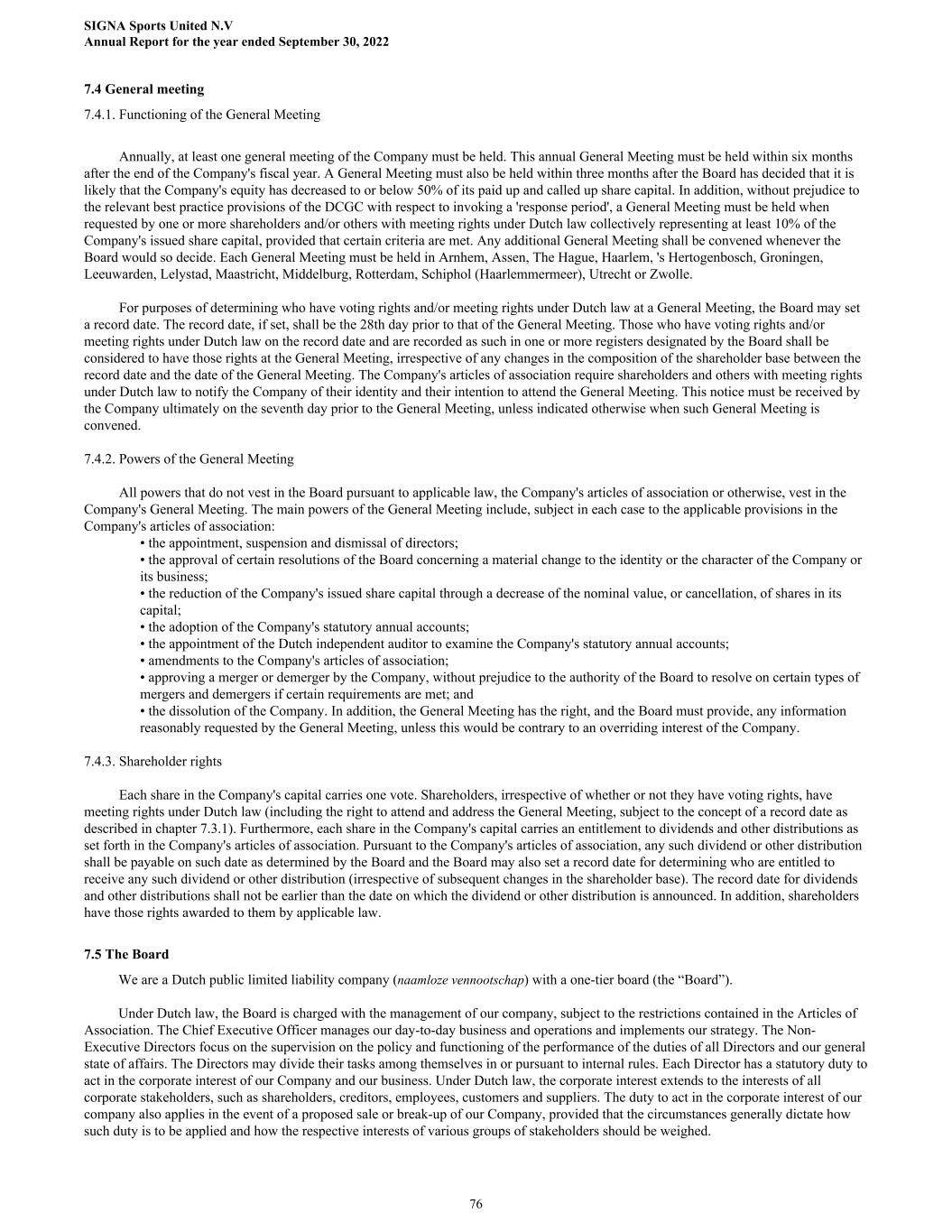
7.4 General meeting 7.4.1. Functioning of the General Meeting Annually, at least one general meeting of the Company must be held. This annual General Meeting must be held within six months after the end of the Company's fiscal year. A General Meeting must also be held within three months after the Board has decided that it is likely that the Company's equity has decreased to or below 50% of its paid up and called up share capital. In addition, without prejudice to the relevant best practice provisions of the DCGC with respect to invoking a 'response period', a General Meeting must be held when requested by one or more shareholders and/or others with meeting rights under Dutch law collectively representing at least 10% of the Company's issued share capital, provided that certain criteria are met. Any additional General Meeting shall be convened whenever the Board would so decide. Each General Meeting must be held in Arnhem, Assen, The Hague, Haarlem, 's Hertogenbosch, Groningen, Leeuwarden, Lelystad, Maastricht, Middelburg, Rotterdam, Schiphol (Haarlemmermeer), Utrecht or Zwolle. For purposes of determining who have voting rights and/or meeting rights under Dutch law at a General Meeting, the Board may set a record date. The record date, if set, shall be the 28th day prior to that of the General Meeting. Those who have voting rights and/or meeting rights under Dutch law on the record date and are recorded as such in one or more registers designated by the Board shall be considered to have those rights at the General Meeting, irrespective of any changes in the composition of the shareholder base between the record date and the date of the General Meeting. The Company's articles of association require shareholders and others with meeting rights under Dutch law to notify the Company of their identity and their intention to attend the General Meeting. This notice must be received by the Company ultimately on the seventh day prior to the General Meeting, unless indicated otherwise when such General Meeting is convened. 7.4.2. Powers of the General Meeting All powers that do not vest in the Board pursuant to applicable law, the Company's articles of association or otherwise, vest in the Company's General Meeting. The main powers of the General Meeting include, subject in each case to the applicable provisions in the Company's articles of association: • the appointment, suspension and dismissal of directors; • the approval of certain resolutions of the Board concerning a material change to the identity or the character of the Company or its business; • the reduction of the Company's issued share capital through a decrease of the nominal value, or cancellation, of shares in its capital; • the adoption of the Company's statutory annual accounts; • the appointment of the Dutch independent auditor to examine the Company's statutory annual accounts; • amendments to the Company's articles of association; • approving a merger or demerger by the Company, without prejudice to the authority of the Board to resolve on certain types of mergers and demergers if certain requirements are met; and • the dissolution of the Company. In addition, the General Meeting has the right, and the Board must provide, any information reasonably requested by the General Meeting, unless this would be contrary to an overriding interest of the Company. 7.4.3. Shareholder rights Each share in the Company's capital carries one vote. Shareholders, irrespective of whether or not they have voting rights, have meeting rights under Dutch law (including the right to attend and address the General Meeting, subject to the concept of a record date as described in chapter 7.3.1). Furthermore, each share in the Company's capital carries an entitlement to dividends and other distributions as set forth in the Company's articles of association. Pursuant to the Company's articles of association, any such dividend or other distribution shall be payable on such date as determined by the Board and the Board may also set a record date for determining who are entitled to receive any such dividend or other distribution (irrespective of subsequent changes in the shareholder base). The record date for dividends and other distributions shall not be earlier than the date on which the dividend or other distribution is announced. In addition, shareholders have those rights awarded to them by applicable law. 7.5 The Board We are a Dutch public limited liability company (naamloze vennootschap) with a one-tier board (the “Board”). Under Dutch law, the Board is charged with the management of our company, subject to the restrictions contained in the Articles of Association. The Chief Executive Officer manages our day-to-day business and operations and implements our strategy. The Non- Executive Directors focus on the supervision on the policy and functioning of the performance of the duties of all Directors and our general state of affairs. The Directors may divide their tasks among themselves in or pursuant to internal rules. Each Director has a statutory duty to act in the corporate interest of our Company and our business. Under Dutch law, the corporate interest extends to the interests of all corporate stakeholders, such as shareholders, creditors, employees, customers and suppliers. The duty to act in the corporate interest of our company also applies in the event of a proposed sale or break-up of our Company, provided that the circumstances generally dictate how such duty is to be applied and how the respective interests of various groups of stakeholders should be weighed. SIGNA Sports United N.V Annual Report for the year ended September 30, 2022 76
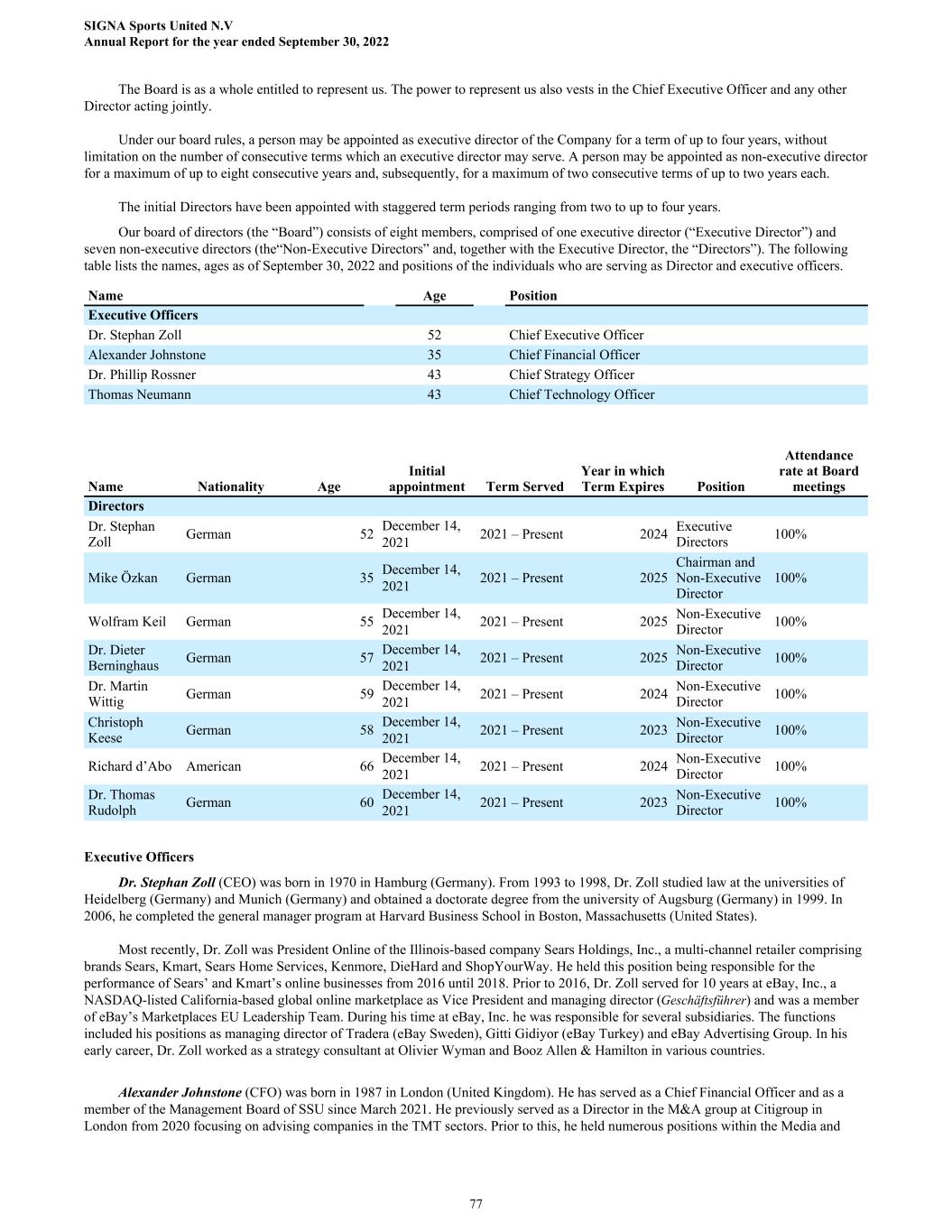
The Board is as a whole entitled to represent us. The power to represent us also vests in the Chief Executive Officer and any other Director acting jointly. Under our board rules, a person may be appointed as executive director of the Company for a term of up to four years, without limitation on the number of consecutive terms which an executive director may serve. A person may be appointed as non-executive director for a maximum of up to eight consecutive years and, subsequently, for a maximum of two consecutive terms of up to two years each. The initial Directors have been appointed with staggered term periods ranging from two to up to four years. Our board of directors (the “Board”) consists of eight members, comprised of one executive director (“Executive Director”) and seven non-executive directors (the“Non-Executive Directors” and, together with the Executive Director, the “Directors”). The following table lists the names, ages as of September 30, 2022 and positions of the individuals who are serving as Director and executive officers. Name Age Position Executive Officers Dr. Stephan Zoll 52 Chief Executive Officer Alexander Johnstone 35 Chief Financial Officer Dr. Phillip Rossner 43 Chief Strategy Officer Thomas Neumann 43 Chief Technology Officer Name Nationality Age Initial appointment Term Served Year in which Term Expires Position Attendance rate at Board meetings Directors Dr. Stephan Zoll German 52 December 14, 2021 2021 – Present 2024 Executive Directors 100% Mike Özkan German 35 December 14, 2021 2021 – Present 2025 Chairman and Non-Executive Director 100% Wolfram Keil German 55 December 14, 2021 2021 – Present 2025 Non-Executive Director 100% Dr. Dieter Berninghaus German 57 December 14, 2021 2021 – Present 2025 Non-Executive Director 100% Dr. Martin Wittig German 59 December 14, 2021 2021 – Present 2024 Non-Executive Director 100% Christoph Keese German 58 December 14, 2021 2021 – Present 2023 Non-Executive Director 100% Richard d’Abo American 66 December 14, 2021 2021 – Present 2024 Non-Executive Director 100% Dr. Thomas Rudolph German 60 December 14, 2021 2021 – Present 2023 Non-Executive Director 100% Executive Officers Dr. Stephan Zoll (CEO) was born in 1970 in Hamburg (Germany). From 1993 to 1998, Dr. Zoll studied law at the universities of Heidelberg (Germany) and Munich (Germany) and obtained a doctorate degree from the university of Augsburg (Germany) in 1999. In 2006, he completed the general manager program at Harvard Business School in Boston, Massachusetts (United States). Most recently, Dr. Zoll was President Online of the Illinois-based company Sears Holdings, Inc., a multi-channel retailer comprising brands Sears, Kmart, Sears Home Services, Kenmore, DieHard and ShopYourWay. He held this position being responsible for the performance of Sears’ and Kmart’s online businesses from 2016 until 2018. Prior to 2016, Dr. Zoll served for 10 years at eBay, Inc., a NASDAQ-listed California-based global online marketplace as Vice President and managing director (Geschäftsführer) and was a member of eBay’s Marketplaces EU Leadership Team. During his time at eBay, Inc. he was responsible for several subsidiaries. The functions included his positions as managing director of Tradera (eBay Sweden), Gitti Gidiyor (eBay Turkey) and eBay Advertising Group. In his early career, Dr. Zoll worked as a strategy consultant at Olivier Wyman and Booz Allen & Hamilton in various countries. Alexander Johnstone (CFO) was born in 1987 in London (United Kingdom). He has served as a Chief Financial Officer and as a member of the Management Board of SSU since March 2021. He previously served as a Director in the M&A group at Citigroup in London from 2020 focusing on advising companies in the TMT sectors. Prior to this, he held numerous positions within the Media and SIGNA Sports United N.V Annual Report for the year ended September 30, 2022 77
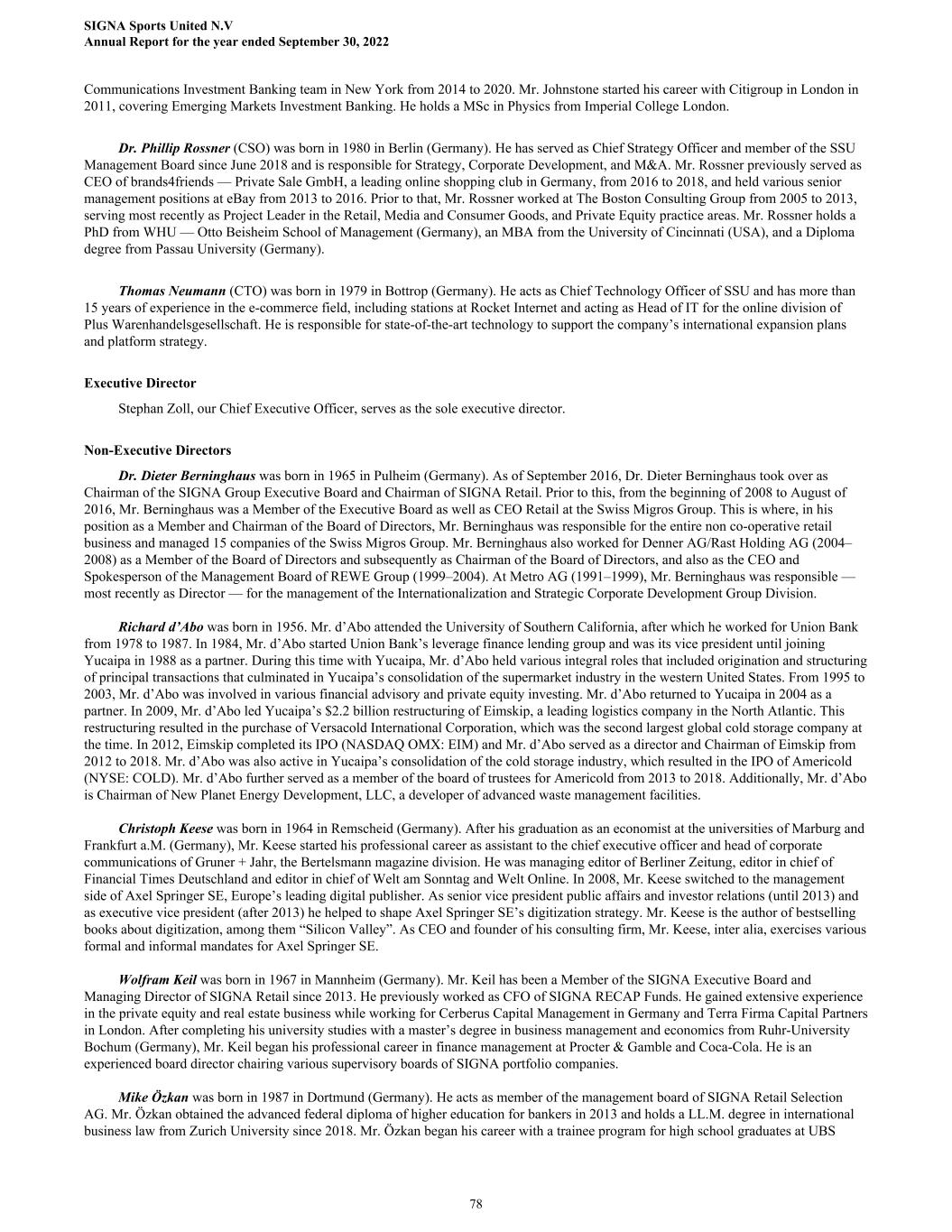
Communications Investment Banking team in New York from 2014 to 2020. Mr. Johnstone started his career with Citigroup in London in 2011, covering Emerging Markets Investment Banking. He holds a MSc in Physics from Imperial College London. Dr. Phillip Rossner (CSO) was born in 1980 in Berlin (Germany). He has served as Chief Strategy Officer and member of the SSU Management Board since June 2018 and is responsible for Strategy, Corporate Development, and M&A. Mr. Rossner previously served as CEO of brands4friends — Private Sale GmbH, a leading online shopping club in Germany, from 2016 to 2018, and held various senior management positions at eBay from 2013 to 2016. Prior to that, Mr. Rossner worked at The Boston Consulting Group from 2005 to 2013, serving most recently as Project Leader in the Retail, Media and Consumer Goods, and Private Equity practice areas. Mr. Rossner holds a PhD from WHU — Otto Beisheim School of Management (Germany), an MBA from the University of Cincinnati (USA), and a Diploma degree from Passau University (Germany). Thomas Neumann (CTO) was born in 1979 in Bottrop (Germany). He acts as Chief Technology Officer of SSU and has more than 15 years of experience in the e-commerce field, including stations at Rocket Internet and acting as Head of IT for the online division of Plus Warenhandelsgesellschaft. He is responsible for state-of-the-art technology to support the company’s international expansion plans and platform strategy. Executive Director Stephan Zoll, our Chief Executive Officer, serves as the sole executive director. Non-Executive Directors Dr. Dieter Berninghaus was born in 1965 in Pulheim (Germany). As of September 2016, Dr. Dieter Berninghaus took over as Chairman of the SIGNA Group Executive Board and Chairman of SIGNA Retail. Prior to this, from the beginning of 2008 to August of 2016, Mr. Berninghaus was a Member of the Executive Board as well as CEO Retail at the Swiss Migros Group. This is where, in his position as a Member and Chairman of the Board of Directors, Mr. Berninghaus was responsible for the entire non co-operative retail business and managed 15 companies of the Swiss Migros Group. Mr. Berninghaus also worked for Denner AG/Rast Holding AG (2004– 2008) as a Member of the Board of Directors and subsequently as Chairman of the Board of Directors, and also as the CEO and Spokesperson of the Management Board of REWE Group (1999–2004). At Metro AG (1991–1999), Mr. Berninghaus was responsible — most recently as Director — for the management of the Internationalization and Strategic Corporate Development Group Division. Richard d’Abo was born in 1956. Mr. d’Abo attended the University of Southern California, after which he worked for Union Bank from 1978 to 1987. In 1984, Mr. d’Abo started Union Bank’s leverage finance lending group and was its vice president until joining Yucaipa in 1988 as a partner. During this time with Yucaipa, Mr. d’Abo held various integral roles that included origination and structuring of principal transactions that culminated in Yucaipa’s consolidation of the supermarket industry in the western United States. From 1995 to 2003, Mr. d’Abo was involved in various financial advisory and private equity investing. Mr. d’Abo returned to Yucaipa in 2004 as a partner. In 2009, Mr. d’Abo led Yucaipa’s $2.2 billion restructuring of Eimskip, a leading logistics company in the North Atlantic. This restructuring resulted in the purchase of Versacold International Corporation, which was the second largest global cold storage company at the time. In 2012, Eimskip completed its IPO (NASDAQ OMX: EIM) and Mr. d’Abo served as a director and Chairman of Eimskip from 2012 to 2018. Mr. d’Abo was also active in Yucaipa’s consolidation of the cold storage industry, which resulted in the IPO of Americold (NYSE: COLD). Mr. d’Abo further served as a member of the board of trustees for Americold from 2013 to 2018. Additionally, Mr. d’Abo is Chairman of New Planet Energy Development, LLC, a developer of advanced waste management facilities. Christoph Keese was born in 1964 in Remscheid (Germany). After his graduation as an economist at the universities of Marburg and Frankfurt a.M. (Germany), Mr. Keese started his professional career as assistant to the chief executive officer and head of corporate communications of Gruner + Jahr, the Bertelsmann magazine division. He was managing editor of Berliner Zeitung, editor in chief of Financial Times Deutschland and editor in chief of Welt am Sonntag and Welt Online. In 2008, Mr. Keese switched to the management side of Axel Springer SE, Europe’s leading digital publisher. As senior vice president public affairs and investor relations (until 2013) and as executive vice president (after 2013) he helped to shape Axel Springer SE’s digitization strategy. Mr. Keese is the author of bestselling books about digitization, among them “Silicon Valley”. As CEO and founder of his consulting firm, Mr. Keese, inter alia, exercises various formal and informal mandates for Axel Springer SE. Wolfram Keil was born in 1967 in Mannheim (Germany). Mr. Keil has been a Member of the SIGNA Executive Board and Managing Director of SIGNA Retail since 2013. He previously worked as CFO of SIGNA RECAP Funds. He gained extensive experience in the private equity and real estate business while working for Cerberus Capital Management in Germany and Terra Firma Capital Partners in London. After completing his university studies with a master’s degree in business management and economics from Ruhr-University Bochum (Germany), Mr. Keil began his professional career in finance management at Procter & Gamble and Coca-Cola. He is an experienced board director chairing various supervisory boards of SIGNA portfolio companies. Mike Özkan was born in 1987 in Dortmund (Germany). He acts as member of the management board of SIGNA Retail Selection AG. Mr. Özkan obtained the advanced federal diploma of higher education for bankers in 2013 and holds a LL.M. degree in international business law from Zurich University since 2018. Mr. Özkan began his career with a trainee program for high school graduates at UBS SIGNA Sports United N.V Annual Report for the year ended September 30, 2022 78

Switzerland in Zurich (Switzerland) and was promoted to Associate Director of Sales in 2009. In 2011, he was promoted to authorized officer at DZ Private Bank where he was a financial advisor to wealthy private clients. Since 2018, Mr. Özkan plays a major role in establishing and building up SSU and contributes significantly to its further strategic development. Dr. Thomas Rudolph was born in 1962 in Öhringen (Germany). He studied business administration at the University of Mannheim. Since 2000, he teaches marketing and researches as a full-time professor at the University of St. Gallen. In 2006, he founded the “Retail Lab”, a partnership program between the University of St. Gallen and numerous international retailers. Since 2009, he manages and directs the Institute of Retail Management. Professor Rudolph authored over 400 research articles, many in high impact journals, as well as eleven books, and is consistently honored for his excellence in research and teaching. As an advisory board member he supports numerous renowned companies. Dr. Martin Wittig was born in 1964 in Frankenholz (now: Bexbach) (Germany). He graduated from RHTW Aachen (Germany) and holds a degree in mining engineering and in economics. Moreover, he obtained his doctorate degree in mining engineering from the Technical University of Berlin (Germany) in 1995. In the same year, Dr. Wittig joined Roland Berger Strategy Consultants and became an associate partner in 1999 and a full partner in 2000. Since January 2001, he had been acting as managing partner and director of the branch in Zurich (Switzerland). In December 2002, Dr. Wittig was elected chief financial officer by the partners in the global executive committee of Roland Berger and re-elected in 2006. Dr. Wittig was elected the chief executive officer of Roland Berger Strategy Consultants unanimously by 180 partners in 2010. In May 2013, Dr. Wittig resigned from his office at Roland Berger. He holds lectures at the University of St. Gallen (Switzerland) on a regular basis and has been appointed Honorary Consul of Germany for the nation of Switzerland (Canton of Schwyz and Canton of Zurich). All of our directors are independent within the meaning of the DCGC” with “All of our non-executive directors, except Mike Özkan, Dieter Berninghaus and Wolfram Keil, are independent within the meaning of the DCGC. Family Relationships There are no family relationships among any of our executive officers or Directors. 7.6 Committees Committees of the Board The Board has established three standing committees, including Audit Committee, Compensation Committee and Nomination and Corporate Governance Committee. Each committee operates pursuant to its charter. As at September 30, 2022, the committees were composed as follows: Name Audit committee and attendance Compensation committee Nomination and corporate governance committee Mike Özkan — — 100% attendance Wolfram Keil** 100% attendance 100% attendance — Dr. Dieter Berninghaus*** — — 100% attendance Dr. Martin Wittig* 100% attendance — — Christoph Keese 100% attendance 100% attendance — Richard d’Abo 100% attendance — 100% attendance Dr. Thomas Rudolph — 100% attendance — * Chairman of the audit committee ** Chairman of the compensation committee *** Chairman of the nomination and corporate governance committee Audit Committee The responsibilities of our audit committee include: • monitoring the Board with respect to (i) the relations with, and the compliance with recommendations and follow-up of comments made by, the Company's internal audit function and the Dutch independent auditor, (ii) the Company's funding, (iii) the application of information and communication technology by the Company, including risks relating to cybersecurity and (iv) the Company's tax policy; SIGNA Sports United N.V Annual Report for the year ended September 30, 2022 79
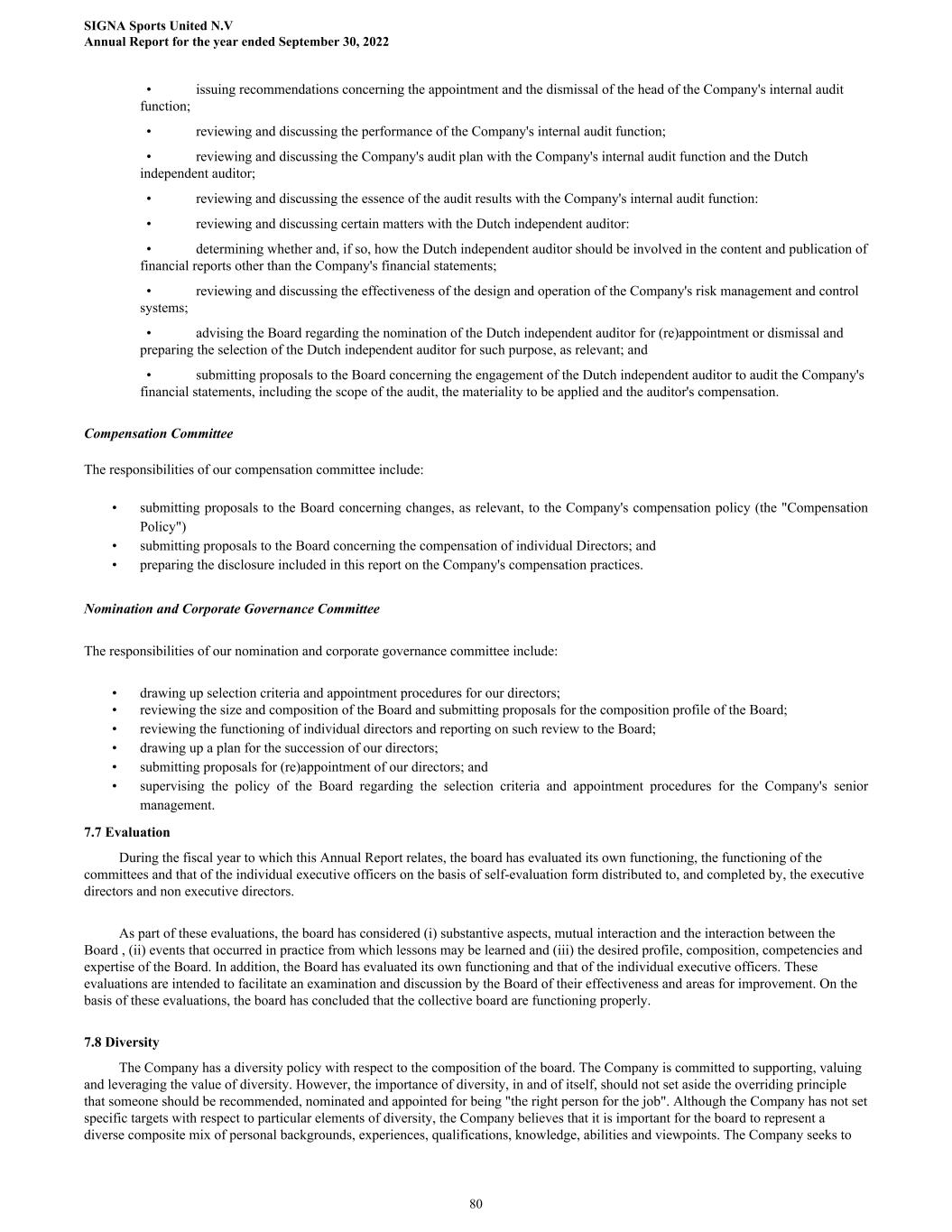
• issuing recommendations concerning the appointment and the dismissal of the head of the Company's internal audit function; • reviewing and discussing the performance of the Company's internal audit function; • reviewing and discussing the Company's audit plan with the Company's internal audit function and the Dutch independent auditor; • reviewing and discussing the essence of the audit results with the Company's internal audit function: • reviewing and discussing certain matters with the Dutch independent auditor: • determining whether and, if so, how the Dutch independent auditor should be involved in the content and publication of financial reports other than the Company's financial statements; • reviewing and discussing the effectiveness of the design and operation of the Company's risk management and control systems; • advising the Board regarding the nomination of the Dutch independent auditor for (re)appointment or dismissal and preparing the selection of the Dutch independent auditor for such purpose, as relevant; and • submitting proposals to the Board concerning the engagement of the Dutch independent auditor to audit the Company's financial statements, including the scope of the audit, the materiality to be applied and the auditor's compensation. Compensation Committee The responsibilities of our compensation committee include: • submitting proposals to the Board concerning changes, as relevant, to the Company's compensation policy (the "Compensation Policy") • submitting proposals to the Board concerning the compensation of individual Directors; and • preparing the disclosure included in this report on the Company's compensation practices. Nomination and Corporate Governance Committee The responsibilities of our nomination and corporate governance committee include: • drawing up selection criteria and appointment procedures for our directors; • reviewing the size and composition of the Board and submitting proposals for the composition profile of the Board; • reviewing the functioning of individual directors and reporting on such review to the Board; • drawing up a plan for the succession of our directors; • submitting proposals for (re)appointment of our directors; and • supervising the policy of the Board regarding the selection criteria and appointment procedures for the Company's senior management. 7.7 Evaluation During the fiscal year to which this Annual Report relates, the board has evaluated its own functioning, the functioning of the committees and that of the individual executive officers on the basis of self-evaluation form distributed to, and completed by, the executive directors and non executive directors. As part of these evaluations, the board has considered (i) substantive aspects, mutual interaction and the interaction between the Board , (ii) events that occurred in practice from which lessons may be learned and (iii) the desired profile, composition, competencies and expertise of the Board. In addition, the Board has evaluated its own functioning and that of the individual executive officers. These evaluations are intended to facilitate an examination and discussion by the Board of their effectiveness and areas for improvement. On the basis of these evaluations, the board has concluded that the collective board are functioning properly. 7.8 Diversity The Company has a diversity policy with respect to the composition of the board. The Company is committed to supporting, valuing and leveraging the value of diversity. However, the importance of diversity, in and of itself, should not set aside the overriding principle that someone should be recommended, nominated and appointed for being "the right person for the job". Although the Company has not set specific targets with respect to particular elements of diversity, the Company believes that it is important for the board to represent a diverse composite mix of personal backgrounds, experiences, qualifications, knowledge, abilities and viewpoints. The Company seeks to SIGNA Sports United N.V Annual Report for the year ended September 30, 2022 80
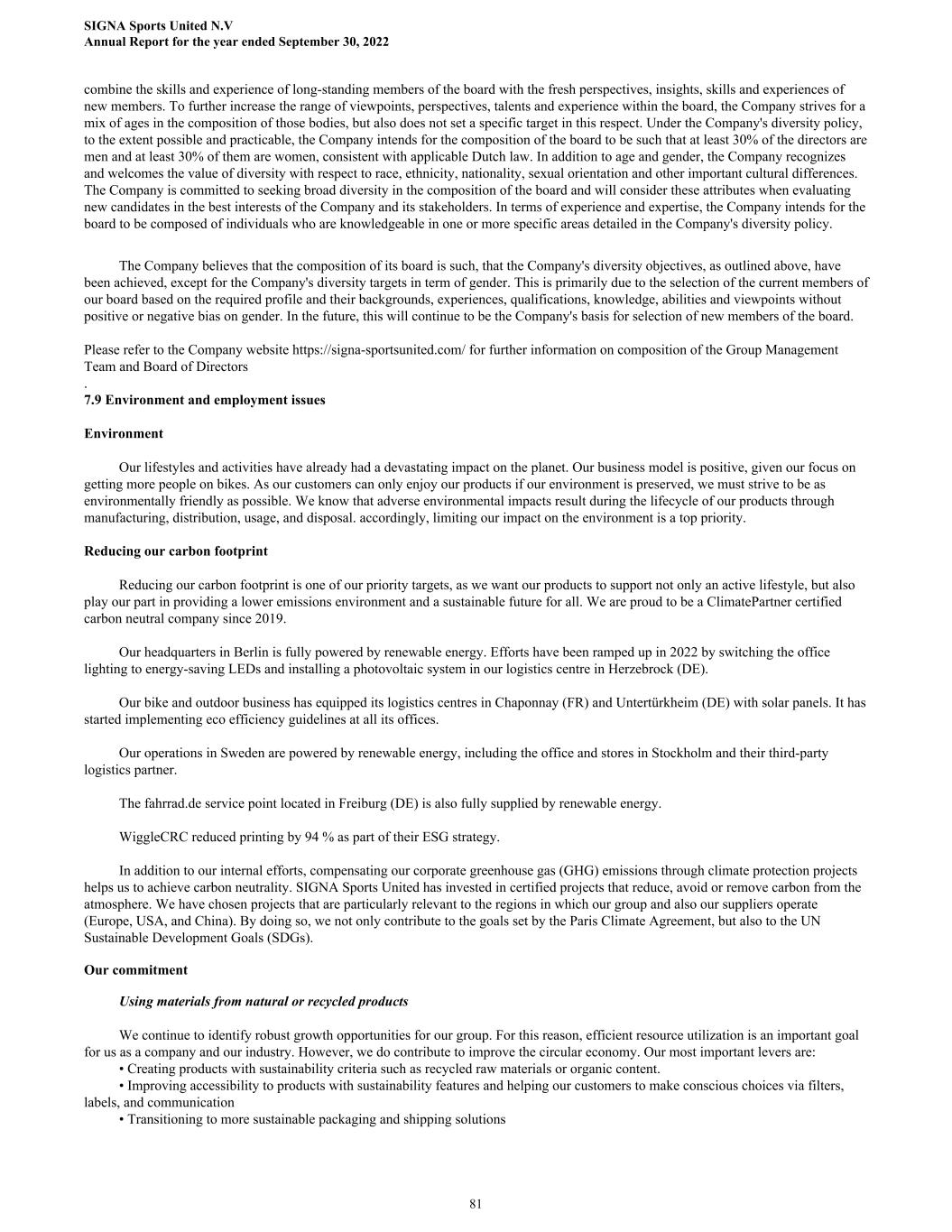
combine the skills and experience of long-standing members of the board with the fresh perspectives, insights, skills and experiences of new members. To further increase the range of viewpoints, perspectives, talents and experience within the board, the Company strives for a mix of ages in the composition of those bodies, but also does not set a specific target in this respect. Under the Company's diversity policy, to the extent possible and practicable, the Company intends for the composition of the board to be such that at least 30% of the directors are men and at least 30% of them are women, consistent with applicable Dutch law. In addition to age and gender, the Company recognizes and welcomes the value of diversity with respect to race, ethnicity, nationality, sexual orientation and other important cultural differences. The Company is committed to seeking broad diversity in the composition of the board and will consider these attributes when evaluating new candidates in the best interests of the Company and its stakeholders. In terms of experience and expertise, the Company intends for the board to be composed of individuals who are knowledgeable in one or more specific areas detailed in the Company's diversity policy. The Company believes that the composition of its board is such, that the Company's diversity objectives, as outlined above, have been achieved, except for the Company's diversity targets in term of gender. This is primarily due to the selection of the current members of our board based on the required profile and their backgrounds, experiences, qualifications, knowledge, abilities and viewpoints without positive or negative bias on gender. In the future, this will continue to be the Company's basis for selection of new members of the board. Please refer to the Company website https://signa-sportsunited.com/ for further information on composition of the Group Management Team and Board of Directors . 7.9 Environment and employment issues Environment Our lifestyles and activities have already had a devastating impact on the planet. Our business model is positive, given our focus on getting more people on bikes. As our customers can only enjoy our products if our environment is preserved, we must strive to be as environmentally friendly as possible. We know that adverse environmental impacts result during the lifecycle of our products through manufacturing, distribution, usage, and disposal. accordingly, limiting our impact on the environment is a top priority. Reducing our carbon footprint Reducing our carbon footprint is one of our priority targets, as we want our products to support not only an active lifestyle, but also play our part in providing a lower emissions environment and a sustainable future for all. We are proud to be a ClimatePartner certified carbon neutral company since 2019. Our headquarters in Berlin is fully powered by renewable energy. Efforts have been ramped up in 2022 by switching the office lighting to energy-saving LEDs and installing a photovoltaic system in our logistics centre in Herzebrock (DE). Our bike and outdoor business has equipped its logistics centres in Chaponnay (FR) and Untertürkheim (DE) with solar panels. It has started implementing eco efficiency guidelines at all its offices. Our operations in Sweden are powered by renewable energy, including the office and stores in Stockholm and their third-party logistics partner. The fahrrad.de service point located in Freiburg (DE) is also fully supplied by renewable energy. WiggleCRC reduced printing by 94 % as part of their ESG strategy. In addition to our internal efforts, compensating our corporate greenhouse gas (GHG) emissions through climate protection projects helps us to achieve carbon neutrality. SIGNA Sports United has invested in certified projects that reduce, avoid or remove carbon from the atmosphere. We have chosen projects that are particularly relevant to the regions in which our group and also our suppliers operate (Europe, USA, and China). By doing so, we not only contribute to the goals set by the Paris Climate Agreement, but also to the UN Sustainable Development Goals (SDGs). Our commitment Using materials from natural or recycled products We continue to identify robust growth opportunities for our group. For this reason, efficient resource utilization is an important goal for us as a company and our industry. However, we do contribute to improve the circular economy. Our most important levers are: • Creating products with sustainability criteria such as recycled raw materials or organic content. • Improving accessibility to products with sustainability features and helping our customers to make conscious choices via filters, labels, and communication • Transitioning to more sustainable packaging and shipping solutions SIGNA Sports United N.V Annual Report for the year ended September 30, 2022 81
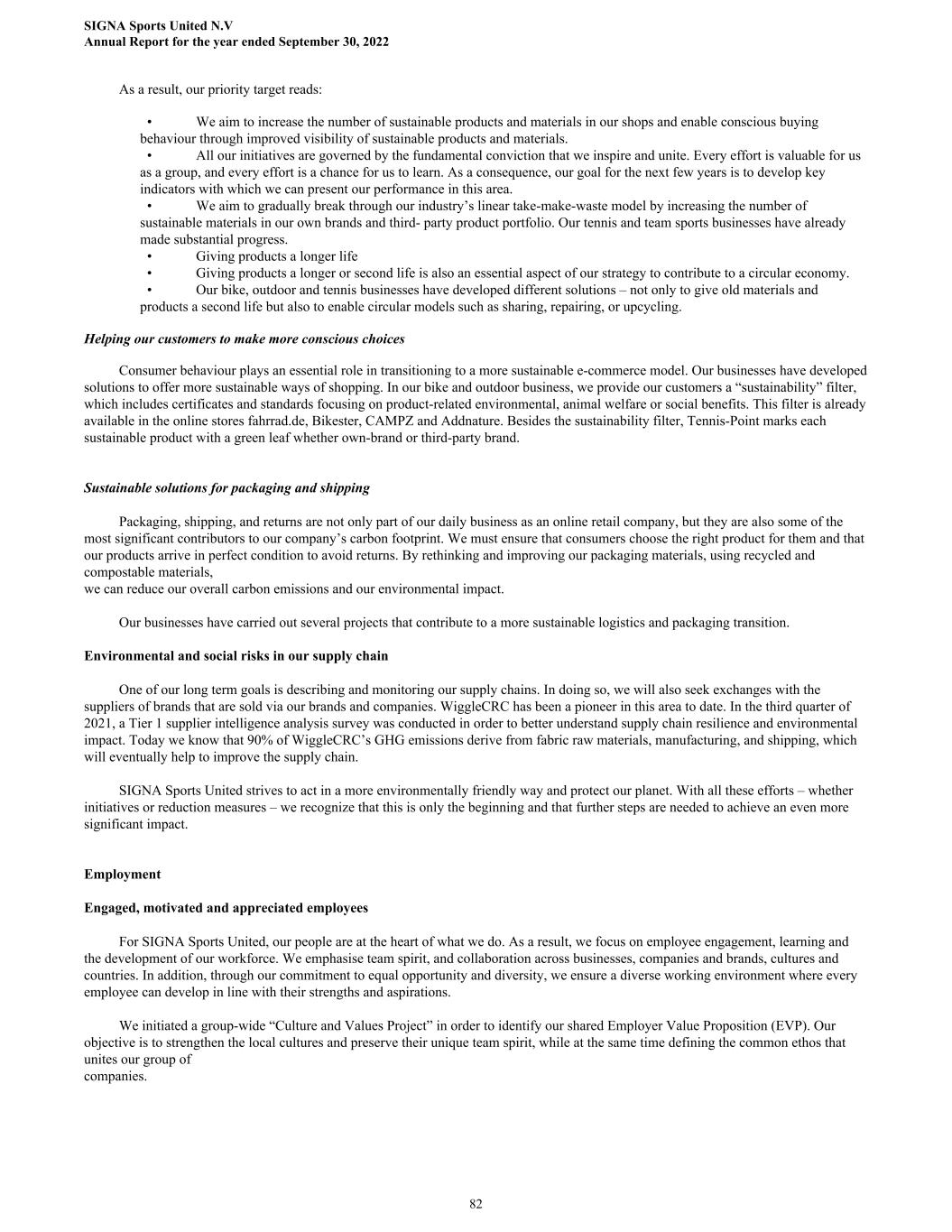
As a result, our priority target reads: • We aim to increase the number of sustainable products and materials in our shops and enable conscious buying behaviour through improved visibility of sustainable products and materials. • All our initiatives are governed by the fundamental conviction that we inspire and unite. Every effort is valuable for us as a group, and every effort is a chance for us to learn. As a consequence, our goal for the next few years is to develop key indicators with which we can present our performance in this area. • We aim to gradually break through our industry’s linear take-make-waste model by increasing the number of sustainable materials in our own brands and third- party product portfolio. Our tennis and team sports businesses have already made substantial progress. • Giving products a longer life • Giving products a longer or second life is also an essential aspect of our strategy to contribute to a circular economy. • Our bike, outdoor and tennis businesses have developed different solutions – not only to give old materials and products a second life but also to enable circular models such as sharing, repairing, or upcycling. Helping our customers to make more conscious choices Consumer behaviour plays an essential role in transitioning to a more sustainable e-commerce model. Our businesses have developed solutions to offer more sustainable ways of shopping. In our bike and outdoor business, we provide our customers a “sustainability” filter, which includes certificates and standards focusing on product-related environmental, animal welfare or social benefits. This filter is already available in the online stores fahrrad.de, Bikester, CAMPZ and Addnature. Besides the sustainability filter, Tennis-Point marks each sustainable product with a green leaf whether own-brand or third-party brand. Sustainable solutions for packaging and shipping Packaging, shipping, and returns are not only part of our daily business as an online retail company, but they are also some of the most significant contributors to our company’s carbon footprint. We must ensure that consumers choose the right product for them and that our products arrive in perfect condition to avoid returns. By rethinking and improving our packaging materials, using recycled and compostable materials, we can reduce our overall carbon emissions and our environmental impact. Our businesses have carried out several projects that contribute to a more sustainable logistics and packaging transition. Environmental and social risks in our supply chain One of our long term goals is describing and monitoring our supply chains. In doing so, we will also seek exchanges with the suppliers of brands that are sold via our brands and companies. WiggleCRC has been a pioneer in this area to date. In the third quarter of 2021, a Tier 1 supplier intelligence analysis survey was conducted in order to better understand supply chain resilience and environmental impact. Today we know that 90% of WiggleCRC’s GHG emissions derive from fabric raw materials, manufacturing, and shipping, which will eventually help to improve the supply chain. SIGNA Sports United strives to act in a more environmentally friendly way and protect our planet. With all these efforts – whether initiatives or reduction measures – we recognize that this is only the beginning and that further steps are needed to achieve an even more significant impact. Employment Engaged, motivated and appreciated employees For SIGNA Sports United, our people are at the heart of what we do. As a result, we focus on employee engagement, learning and the development of our workforce. We emphasise team spirit, and collaboration across businesses, companies and brands, cultures and countries. In addition, through our commitment to equal opportunity and diversity, we ensure a diverse working environment where every employee can develop in line with their strengths and aspirations. We initiated a group-wide “Culture and Values Project” in order to identify our shared Employer Value Proposition (EVP). Our objective is to strengthen the local cultures and preserve their unique team spirit, while at the same time defining the common ethos that unites our group of companies. SIGNA Sports United N.V Annual Report for the year ended September 30, 2022 82
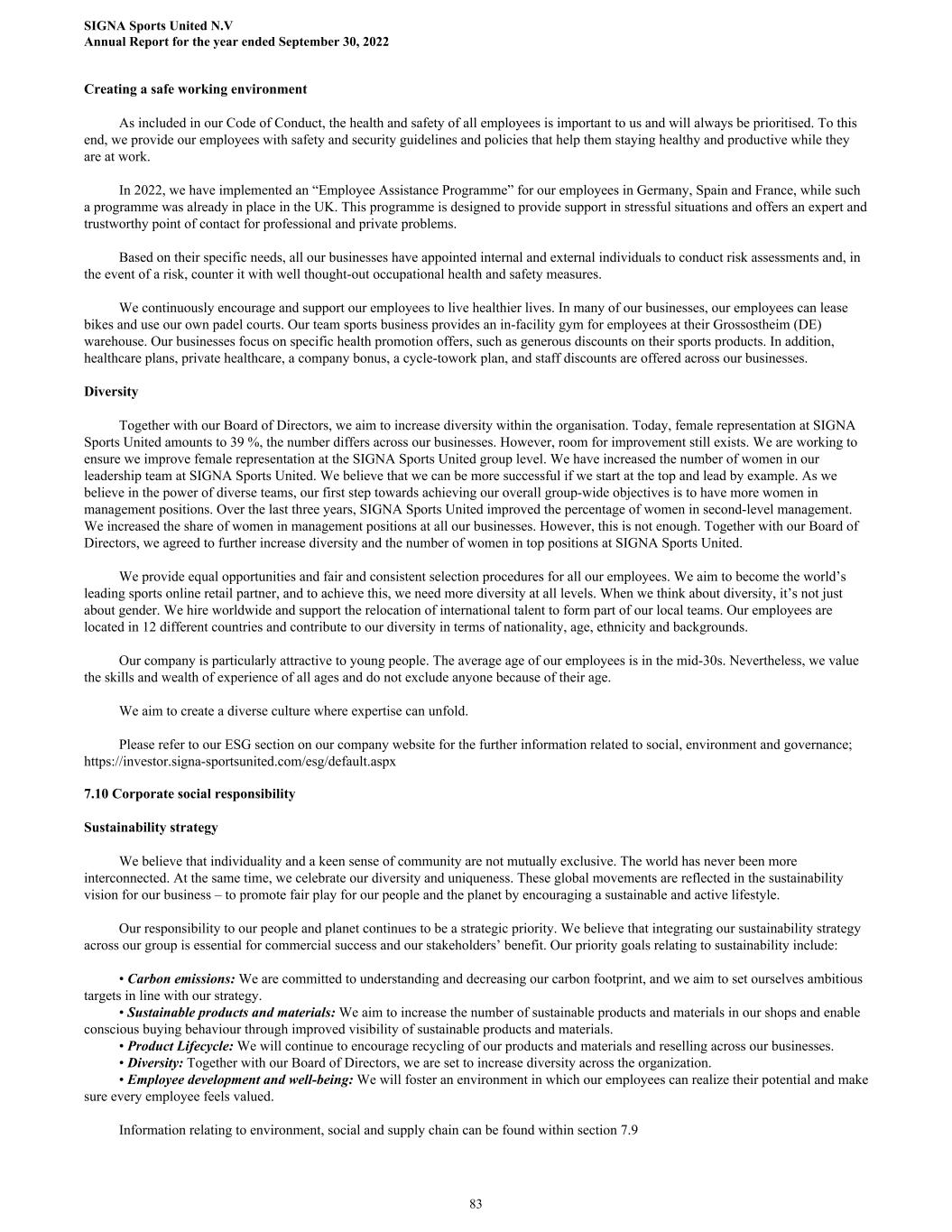
Creating a safe working environment As included in our Code of Conduct, the health and safety of all employees is important to us and will always be prioritised. To this end, we provide our employees with safety and security guidelines and policies that help them staying healthy and productive while they are at work. In 2022, we have implemented an “Employee Assistance Programme” for our employees in Germany, Spain and France, while such a programme was already in place in the UK. This programme is designed to provide support in stressful situations and offers an expert and trustworthy point of contact for professional and private problems. Based on their specific needs, all our businesses have appointed internal and external individuals to conduct risk assessments and, in the event of a risk, counter it with well thought-out occupational health and safety measures. We continuously encourage and support our employees to live healthier lives. In many of our businesses, our employees can lease bikes and use our own padel courts. Our team sports business provides an in-facility gym for employees at their Grossostheim (DE) warehouse. Our businesses focus on specific health promotion offers, such as generous discounts on their sports products. In addition, healthcare plans, private healthcare, a company bonus, a cycle-towork plan, and staff discounts are offered across our businesses. Diversity Together with our Board of Directors, we aim to increase diversity within the organisation. Today, female representation at SIGNA Sports United amounts to 39 %, the number differs across our businesses. However, room for improvement still exists. We are working to ensure we improve female representation at the SIGNA Sports United group level. We have increased the number of women in our leadership team at SIGNA Sports United. We believe that we can be more successful if we start at the top and lead by example. As we believe in the power of diverse teams, our first step towards achieving our overall group-wide objectives is to have more women in management positions. Over the last three years, SIGNA Sports United improved the percentage of women in second-level management. We increased the share of women in management positions at all our businesses. However, this is not enough. Together with our Board of Directors, we agreed to further increase diversity and the number of women in top positions at SIGNA Sports United. We provide equal opportunities and fair and consistent selection procedures for all our employees. We aim to become the world’s leading sports online retail partner, and to achieve this, we need more diversity at all levels. When we think about diversity, it’s not just about gender. We hire worldwide and support the relocation of international talent to form part of our local teams. Our employees are located in 12 different countries and contribute to our diversity in terms of nationality, age, ethnicity and backgrounds. Our company is particularly attractive to young people. The average age of our employees is in the mid-30s. Nevertheless, we value the skills and wealth of experience of all ages and do not exclude anyone because of their age. We aim to create a diverse culture where expertise can unfold. Please refer to our ESG section on our company website for the further information related to social, environment and governance; https://investor.signa-sportsunited.com/esg/default.aspx 7.10 Corporate social responsibility Sustainability strategy We believe that individuality and a keen sense of community are not mutually exclusive. The world has never been more interconnected. At the same time, we celebrate our diversity and uniqueness. These global movements are reflected in the sustainability vision for our business – to promote fair play for our people and the planet by encouraging a sustainable and active lifestyle. Our responsibility to our people and planet continues to be a strategic priority. We believe that integrating our sustainability strategy across our group is essential for commercial success and our stakeholders’ benefit. Our priority goals relating to sustainability include: • Carbon emissions: We are committed to understanding and decreasing our carbon footprint, and we aim to set ourselves ambitious targets in line with our strategy. • Sustainable products and materials: We aim to increase the number of sustainable products and materials in our shops and enable conscious buying behaviour through improved visibility of sustainable products and materials. • Product Lifecycle: We will continue to encourage recycling of our products and materials and reselling across our businesses. • Diversity: Together with our Board of Directors, we are set to increase diversity across the organization. • Employee development and well-being: We will foster an environment in which our employees can realize their potential and make sure every employee feels valued. Information relating to environment, social and supply chain can be found within section 7.9 SIGNA Sports United N.V Annual Report for the year ended September 30, 2022 83
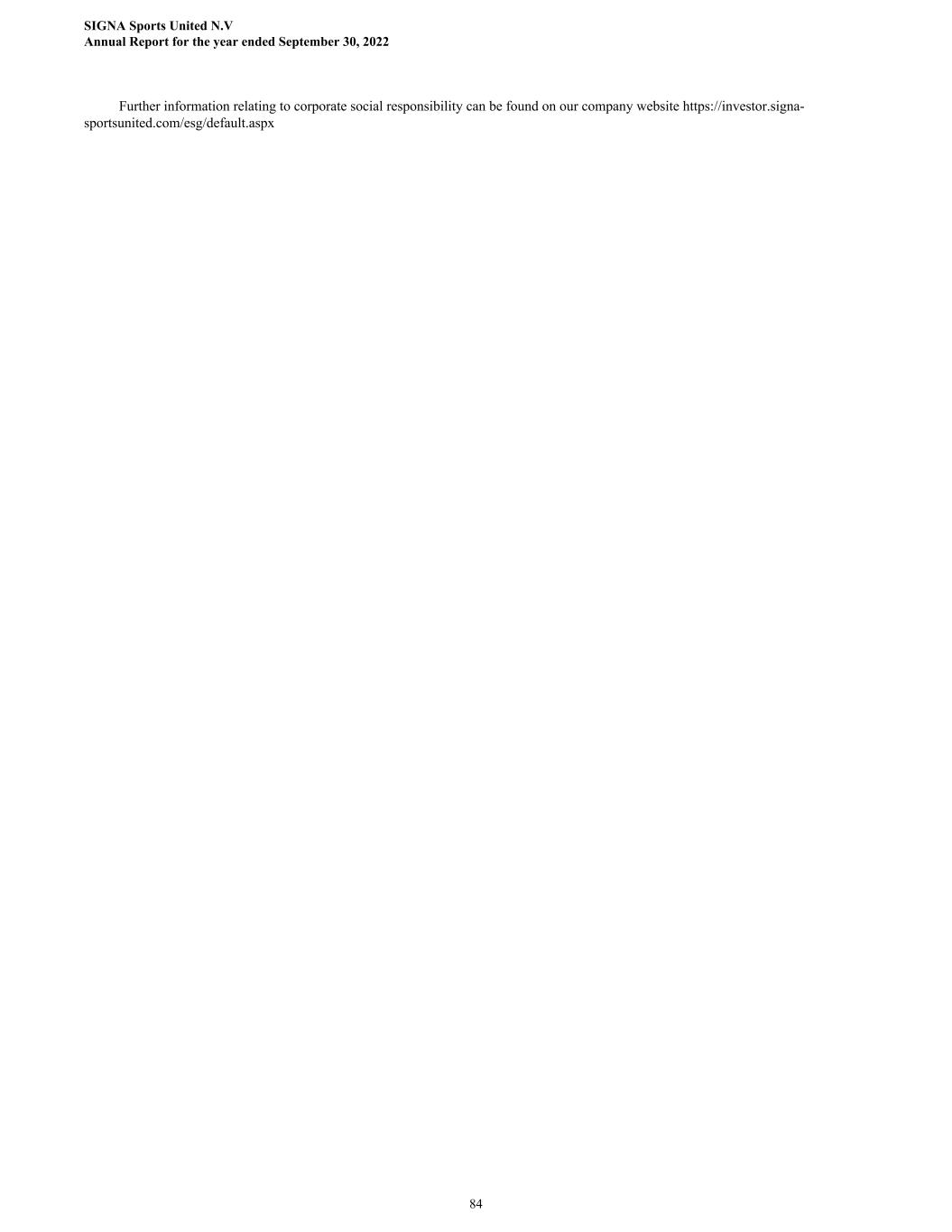
Further information relating to corporate social responsibility can be found on our company website https://investor.signa- sportsunited.com/esg/default.aspx SIGNA Sports United N.V Annual Report for the year ended September 30, 2022 84
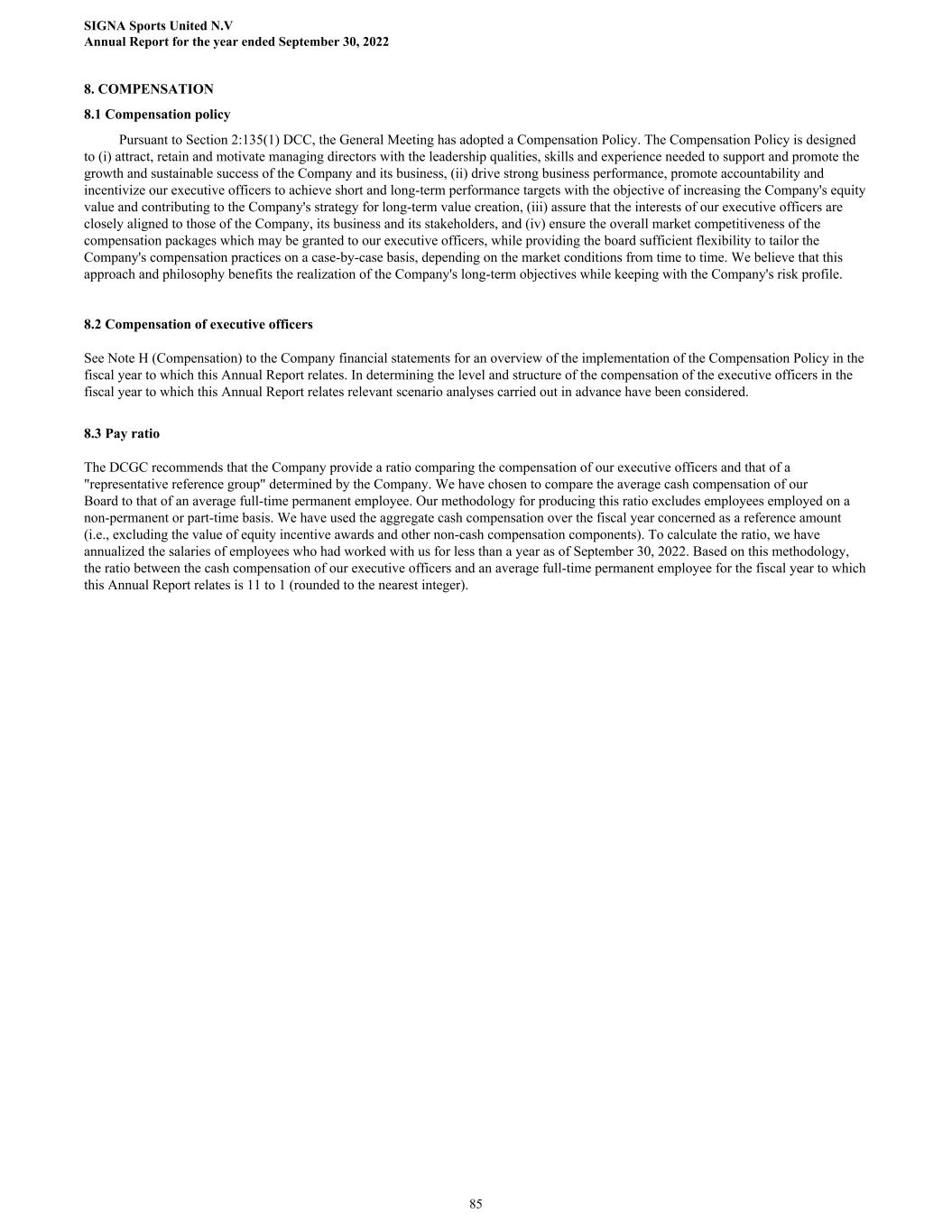
8. COMPENSATION 8.1 Compensation policy Pursuant to Section 2:135(1) DCC, the General Meeting has adopted a Compensation Policy. The Compensation Policy is designed to (i) attract, retain and motivate managing directors with the leadership qualities, skills and experience needed to support and promote the growth and sustainable success of the Company and its business, (ii) drive strong business performance, promote accountability and incentivize our executive officers to achieve short and long-term performance targets with the objective of increasing the Company's equity value and contributing to the Company's strategy for long-term value creation, (iii) assure that the interests of our executive officers are closely aligned to those of the Company, its business and its stakeholders, and (iv) ensure the overall market competitiveness of the compensation packages which may be granted to our executive officers, while providing the board sufficient flexibility to tailor the Company's compensation practices on a case-by-case basis, depending on the market conditions from time to time. We believe that this approach and philosophy benefits the realization of the Company's long-term objectives while keeping with the Company's risk profile. 8.2 Compensation of executive officers See Note H (Compensation) to the Company financial statements for an overview of the implementation of the Compensation Policy in the fiscal year to which this Annual Report relates. In determining the level and structure of the compensation of the executive officers in the fiscal year to which this Annual Report relates relevant scenario analyses carried out in advance have been considered. 8.3 Pay ratio The DCGC recommends that the Company provide a ratio comparing the compensation of our executive officers and that of a "representative reference group" determined by the Company. We have chosen to compare the average cash compensation of our Board to that of an average full-time permanent employee. Our methodology for producing this ratio excludes employees employed on a non-permanent or part-time basis. We have used the aggregate cash compensation over the fiscal year concerned as a reference amount (i.e., excluding the value of equity incentive awards and other non-cash compensation components). To calculate the ratio, we have annualized the salaries of employees who had worked with us for less than a year as of September 30, 2022. Based on this methodology, the ratio between the cash compensation of our executive officers and an average full-time permanent employee for the fiscal year to which this Annual Report relates is 11 to 1 (rounded to the nearest integer). SIGNA Sports United N.V Annual Report for the year ended September 30, 2022 85
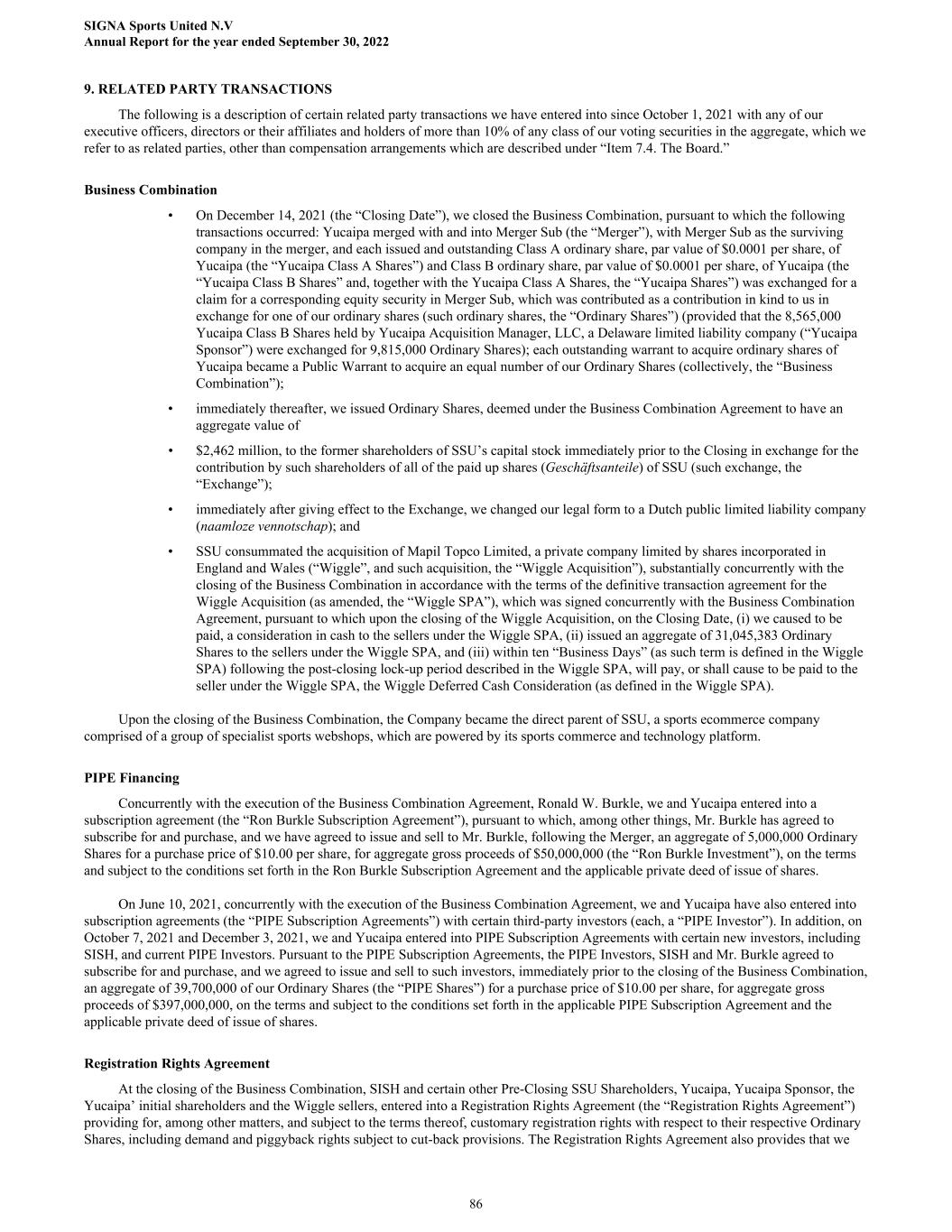
9. RELATED PARTY TRANSACTIONS The following is a description of certain related party transactions we have entered into since October 1, 2021 with any of our executive officers, directors or their affiliates and holders of more than 10% of any class of our voting securities in the aggregate, which we refer to as related parties, other than compensation arrangements which are described under “Item 7.4. The Board.” Business Combination • On December 14, 2021 (the “Closing Date”), we closed the Business Combination, pursuant to which the following transactions occurred: Yucaipa merged with and into Merger Sub (the “Merger”), with Merger Sub as the surviving company in the merger, and each issued and outstanding Class A ordinary share, par value of $0.0001 per share, of Yucaipa (the “Yucaipa Class A Shares”) and Class B ordinary share, par value of $0.0001 per share, of Yucaipa (the “Yucaipa Class B Shares” and, together with the Yucaipa Class A Shares, the “Yucaipa Shares”) was exchanged for a claim for a corresponding equity security in Merger Sub, which was contributed as a contribution in kind to us in exchange for one of our ordinary shares (such ordinary shares, the “Ordinary Shares”) (provided that the 8,565,000 Yucaipa Class B Shares held by Yucaipa Acquisition Manager, LLC, a Delaware limited liability company (“Yucaipa Sponsor”) were exchanged for 9,815,000 Ordinary Shares); each outstanding warrant to acquire ordinary shares of Yucaipa became a Public Warrant to acquire an equal number of our Ordinary Shares (collectively, the “Business Combination”); • immediately thereafter, we issued Ordinary Shares, deemed under the Business Combination Agreement to have an aggregate value of • $2,462 million, to the former shareholders of SSU’s capital stock immediately prior to the Closing in exchange for the contribution by such shareholders of all of the paid up shares (Geschäftsanteile) of SSU (such exchange, the “Exchange”); • immediately after giving effect to the Exchange, we changed our legal form to a Dutch public limited liability company (naamloze vennotschap); and • SSU consummated the acquisition of Mapil Topco Limited, a private company limited by shares incorporated in England and Wales (“Wiggle”, and such acquisition, the “Wiggle Acquisition”), substantially concurrently with the closing of the Business Combination in accordance with the terms of the definitive transaction agreement for the Wiggle Acquisition (as amended, the “Wiggle SPA”), which was signed concurrently with the Business Combination Agreement, pursuant to which upon the closing of the Wiggle Acquisition, on the Closing Date, (i) we caused to be paid, a consideration in cash to the sellers under the Wiggle SPA, (ii) issued an aggregate of 31,045,383 Ordinary Shares to the sellers under the Wiggle SPA, and (iii) within ten “Business Days” (as such term is defined in the Wiggle SPA) following the post-closing lock-up period described in the Wiggle SPA, will pay, or shall cause to be paid to the seller under the Wiggle SPA, the Wiggle Deferred Cash Consideration (as defined in the Wiggle SPA). Upon the closing of the Business Combination, the Company became the direct parent of SSU, a sports ecommerce company comprised of a group of specialist sports webshops, which are powered by its sports commerce and technology platform. PIPE Financing Concurrently with the execution of the Business Combination Agreement, Ronald W. Burkle, we and Yucaipa entered into a subscription agreement (the “Ron Burkle Subscription Agreement”), pursuant to which, among other things, Mr. Burkle has agreed to subscribe for and purchase, and we have agreed to issue and sell to Mr. Burkle, following the Merger, an aggregate of 5,000,000 Ordinary Shares for a purchase price of $10.00 per share, for aggregate gross proceeds of $50,000,000 (the “Ron Burkle Investment”), on the terms and subject to the conditions set forth in the Ron Burkle Subscription Agreement and the applicable private deed of issue of shares. On June 10, 2021, concurrently with the execution of the Business Combination Agreement, we and Yucaipa have also entered into subscription agreements (the “PIPE Subscription Agreements”) with certain third-party investors (each, a “PIPE Investor”). In addition, on October 7, 2021 and December 3, 2021, we and Yucaipa entered into PIPE Subscription Agreements with certain new investors, including SISH, and current PIPE Investors. Pursuant to the PIPE Subscription Agreements, the PIPE Investors, SISH and Mr. Burkle agreed to subscribe for and purchase, and we agreed to issue and sell to such investors, immediately prior to the closing of the Business Combination, an aggregate of 39,700,000 of our Ordinary Shares (the “PIPE Shares”) for a purchase price of $10.00 per share, for aggregate gross proceeds of $397,000,000, on the terms and subject to the conditions set forth in the applicable PIPE Subscription Agreement and the applicable private deed of issue of shares. Registration Rights Agreement At the closing of the Business Combination, SISH and certain other Pre-Closing SSU Shareholders, Yucaipa, Yucaipa Sponsor, the Yucaipa’ initial shareholders and the Wiggle sellers, entered into a Registration Rights Agreement (the “Registration Rights Agreement”) providing for, among other matters, and subject to the terms thereof, customary registration rights with respect to their respective Ordinary Shares, including demand and piggyback rights subject to cut-back provisions. The Registration Rights Agreement also provides that we SIGNA Sports United N.V Annual Report for the year ended September 30, 2022 86
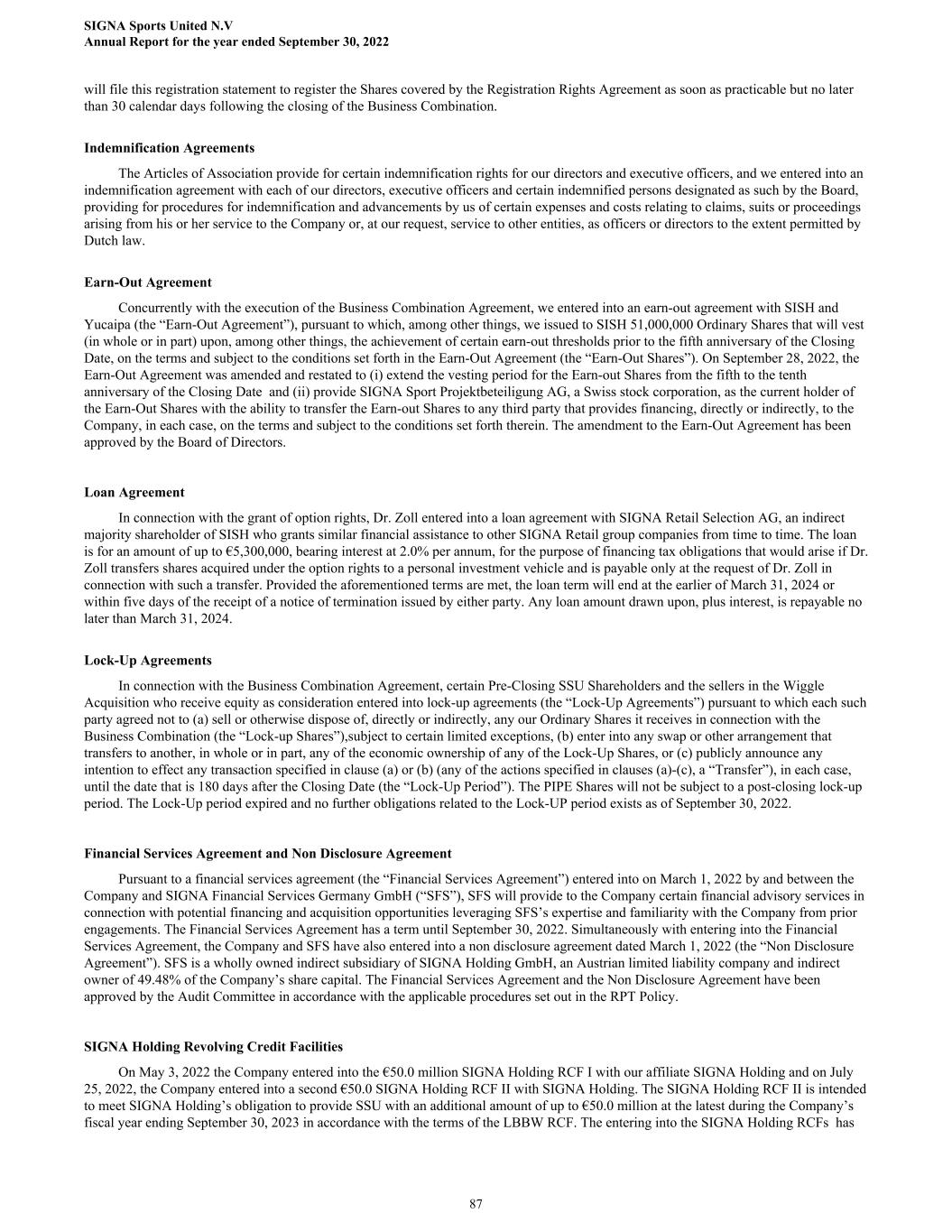
will file this registration statement to register the Shares covered by the Registration Rights Agreement as soon as practicable but no later than 30 calendar days following the closing of the Business Combination. Indemnification Agreements The Articles of Association provide for certain indemnification rights for our directors and executive officers, and we entered into an indemnification agreement with each of our directors, executive officers and certain indemnified persons designated as such by the Board, providing for procedures for indemnification and advancements by us of certain expenses and costs relating to claims, suits or proceedings arising from his or her service to the Company or, at our request, service to other entities, as officers or directors to the extent permitted by Dutch law. Earn-Out Agreement Concurrently with the execution of the Business Combination Agreement, we entered into an earn-out agreement with SISH and Yucaipa (the “Earn-Out Agreement”), pursuant to which, among other things, we issued to SISH 51,000,000 Ordinary Shares that will vest (in whole or in part) upon, among other things, the achievement of certain earn-out thresholds prior to the fifth anniversary of the Closing Date, on the terms and subject to the conditions set forth in the Earn-Out Agreement (the “Earn-Out Shares”). On September 28, 2022, the Earn-Out Agreement was amended and restated to (i) extend the vesting period for the Earn-out Shares from the fifth to the tenth anniversary of the Closing Date and (ii) provide SIGNA Sport Projektbeteiligung AG, a Swiss stock corporation, as the current holder of the Earn-Out Shares with the ability to transfer the Earn-out Shares to any third party that provides financing, directly or indirectly, to the Company, in each case, on the terms and subject to the conditions set forth therein. The amendment to the Earn-Out Agreement has been approved by the Board of Directors. Loan Agreement In connection with the grant of option rights, Dr. Zoll entered into a loan agreement with SIGNA Retail Selection AG, an indirect majority shareholder of SISH who grants similar financial assistance to other SIGNA Retail group companies from time to time. The loan is for an amount of up to €5,300,000, bearing interest at 2.0% per annum, for the purpose of financing tax obligations that would arise if Dr. Zoll transfers shares acquired under the option rights to a personal investment vehicle and is payable only at the request of Dr. Zoll in connection with such a transfer. Provided the aforementioned terms are met, the loan term will end at the earlier of March 31, 2024 or within five days of the receipt of a notice of termination issued by either party. Any loan amount drawn upon, plus interest, is repayable no later than March 31, 2024. Lock-Up Agreements In connection with the Business Combination Agreement, certain Pre-Closing SSU Shareholders and the sellers in the Wiggle Acquisition who receive equity as consideration entered into lock-up agreements (the “Lock-Up Agreements”) pursuant to which each such party agreed not to (a) sell or otherwise dispose of, directly or indirectly, any our Ordinary Shares it receives in connection with the Business Combination (the “Lock-up Shares”),subject to certain limited exceptions, (b) enter into any swap or other arrangement that transfers to another, in whole or in part, any of the economic ownership of any of the Lock-Up Shares, or (c) publicly announce any intention to effect any transaction specified in clause (a) or (b) (any of the actions specified in clauses (a)-(c), a “Transfer”), in each case, until the date that is 180 days after the Closing Date (the “Lock-Up Period”). The PIPE Shares will not be subject to a post-closing lock-up period. The Lock-Up period expired and no further obligations related to the Lock-UP period exists as of September 30, 2022. Financial Services Agreement and Non Disclosure Agreement Pursuant to a financial services agreement (the “Financial Services Agreement”) entered into on March 1, 2022 by and between the Company and SIGNA Financial Services Germany GmbH (“SFS”), SFS will provide to the Company certain financial advisory services in connection with potential financing and acquisition opportunities leveraging SFS’s expertise and familiarity with the Company from prior engagements. The Financial Services Agreement has a term until September 30, 2022. Simultaneously with entering into the Financial Services Agreement, the Company and SFS have also entered into a non disclosure agreement dated March 1, 2022 (the “Non Disclosure Agreement”). SFS is a wholly owned indirect subsidiary of SIGNA Holding GmbH, an Austrian limited liability company and indirect owner of 49.48% of the Company’s share capital. The Financial Services Agreement and the Non Disclosure Agreement have been approved by the Audit Committee in accordance with the applicable procedures set out in the RPT Policy. SIGNA Holding Revolving Credit Facilities On May 3, 2022 the Company entered into the €50.0 million SIGNA Holding RCF I with our affiliate SIGNA Holding and on July 25, 2022, the Company entered into a second €50.0 SIGNA Holding RCF II with SIGNA Holding. The SIGNA Holding RCF II is intended to meet SIGNA Holding’s obligation to provide SSU with an additional amount of up to €50.0 million at the latest during the Company’s fiscal year ending September 30, 2023 in accordance with the terms of the LBBW RCF. The entering into the SIGNA Holding RCFs has SIGNA Sports United N.V Annual Report for the year ended September 30, 2022 87
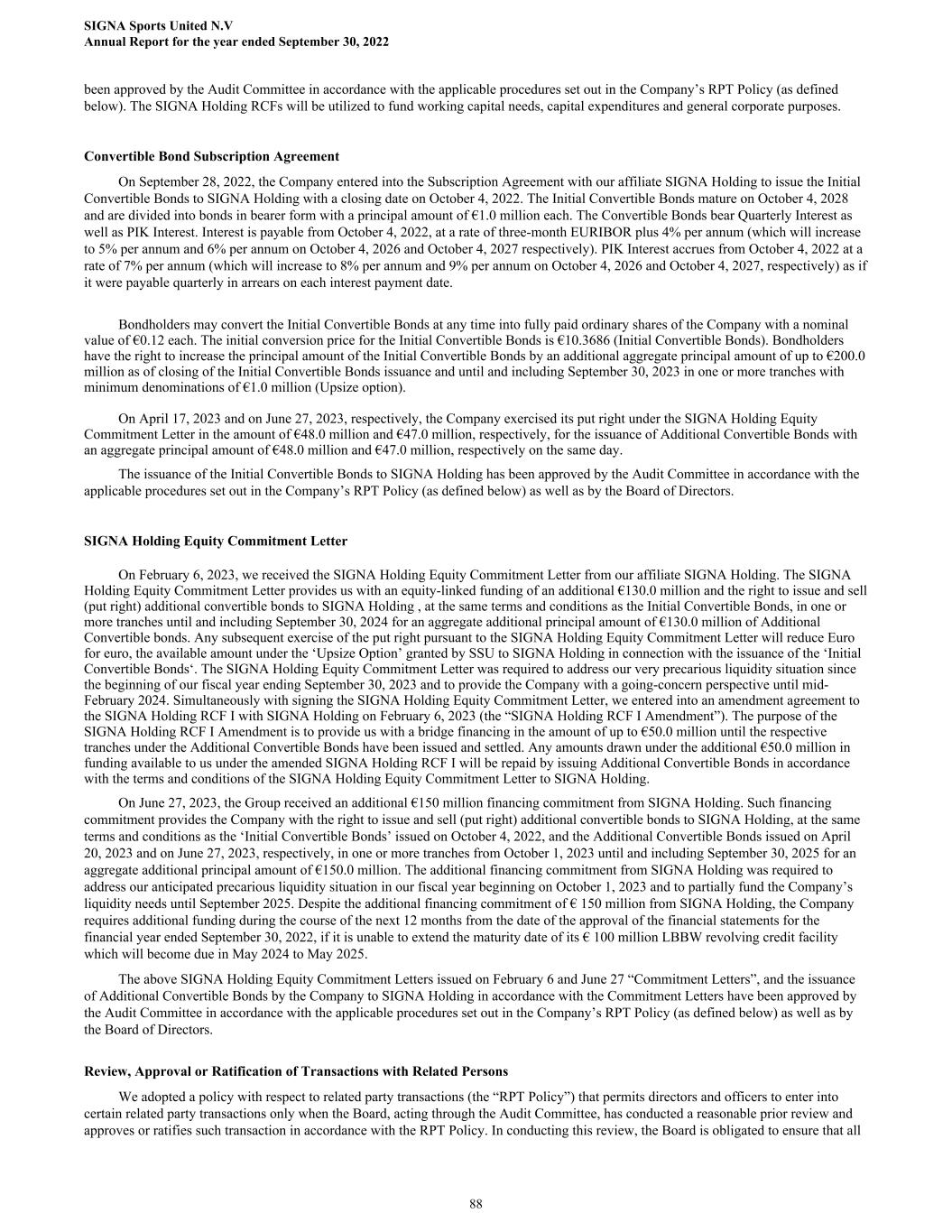
been approved by the Audit Committee in accordance with the applicable procedures set out in the Company’s RPT Policy (as defined below). The SIGNA Holding RCFs will be utilized to fund working capital needs, capital expenditures and general corporate purposes. Convertible Bond Subscription Agreement On September 28, 2022, the Company entered into the Subscription Agreement with our affiliate SIGNA Holding to issue the Initial Convertible Bonds to SIGNA Holding with a closing date on October 4, 2022. The Initial Convertible Bonds mature on October 4, 2028 and are divided into bonds in bearer form with a principal amount of €1.0 million each. The Convertible Bonds bear Quarterly Interest as well as PIK Interest. Interest is payable from October 4, 2022, at a rate of three-month EURIBOR plus 4% per annum (which will increase to 5% per annum and 6% per annum on October 4, 2026 and October 4, 2027 respectively). PIK Interest accrues from October 4, 2022 at a rate of 7% per annum (which will increase to 8% per annum and 9% per annum on October 4, 2026 and October 4, 2027, respectively) as if it were payable quarterly in arrears on each interest payment date. Bondholders may convert the Initial Convertible Bonds at any time into fully paid ordinary shares of the Company with a nominal value of €0.12 each. The initial conversion price for the Initial Convertible Bonds is €10.3686 (Initial Convertible Bonds). Bondholders have the right to increase the principal amount of the Initial Convertible Bonds by an additional aggregate principal amount of up to €200.0 million as of closing of the Initial Convertible Bonds issuance and until and including September 30, 2023 in one or more tranches with minimum denominations of €1.0 million (Upsize option). On April 17, 2023 and on June 27, 2023, respectively, the Company exercised its put right under the SIGNA Holding Equity Commitment Letter in the amount of €48.0 million and €47.0 million, respectively, for the issuance of Additional Convertible Bonds with an aggregate principal amount of €48.0 million and €47.0 million, respectively on the same day. The issuance of the Initial Convertible Bonds to SIGNA Holding has been approved by the Audit Committee in accordance with the applicable procedures set out in the Company’s RPT Policy (as defined below) as well as by the Board of Directors. SIGNA Holding Equity Commitment Letter On February 6, 2023, we received the SIGNA Holding Equity Commitment Letter from our affiliate SIGNA Holding. The SIGNA Holding Equity Commitment Letter provides us with an equity-linked funding of an additional €130.0 million and the right to issue and sell (put right) additional convertible bonds to SIGNA Holding , at the same terms and conditions as the Initial Convertible Bonds, in one or more tranches until and including September 30, 2024 for an aggregate additional principal amount of €130.0 million of Additional Convertible bonds. Any subsequent exercise of the put right pursuant to the SIGNA Holding Equity Commitment Letter will reduce Euro for euro, the available amount under the ‘Upsize Option’ granted by SSU to SIGNA Holding in connection with the issuance of the ‘Initial Convertible Bonds‘. The SIGNA Holding Equity Commitment Letter was required to address our very precarious liquidity situation since the beginning of our fiscal year ending September 30, 2023 and to provide the Company with a going-concern perspective until mid- February 2024. Simultaneously with signing the SIGNA Holding Equity Commitment Letter, we entered into an amendment agreement to the SIGNA Holding RCF I with SIGNA Holding on February 6, 2023 (the “SIGNA Holding RCF I Amendment”). The purpose of the SIGNA Holding RCF I Amendment is to provide us with a bridge financing in the amount of up to €50.0 million until the respective tranches under the Additional Convertible Bonds have been issued and settled. Any amounts drawn under the additional €50.0 million in funding available to us under the amended SIGNA Holding RCF I will be repaid by issuing Additional Convertible Bonds in accordance with the terms and conditions of the SIGNA Holding Equity Commitment Letter to SIGNA Holding. On June 27, 2023, the Group received an additional €150 million financing commitment from SIGNA Holding. Such financing commitment provides the Company with the right to issue and sell (put right) additional convertible bonds to SIGNA Holding, at the same terms and conditions as the ‘Initial Convertible Bonds’ issued on October 4, 2022, and the Additional Convertible Bonds issued on April 20, 2023 and on June 27, 2023, respectively, in one or more tranches from October 1, 2023 until and including September 30, 2025 for an aggregate additional principal amount of €150.0 million. The additional financing commitment from SIGNA Holding was required to address our anticipated precarious liquidity situation in our fiscal year beginning on October 1, 2023 and to partially fund the Company’s liquidity needs until September 2025. Despite the additional financing commitment of € 150 million from SIGNA Holding, the Company requires additional funding during the course of the next 12 months from the date of the approval of the financial statements for the financial year ended September 30, 2022, if it is unable to extend the maturity date of its € 100 million LBBW revolving credit facility which will become due in May 2024 to May 2025. The above SIGNA Holding Equity Commitment Letters issued on February 6 and June 27 “Commitment Letters”, and the issuance of Additional Convertible Bonds by the Company to SIGNA Holding in accordance with the Commitment Letters have been approved by the Audit Committee in accordance with the applicable procedures set out in the Company’s RPT Policy (as defined below) as well as by the Board of Directors. Review, Approval or Ratification of Transactions with Related Persons We adopted a policy with respect to related party transactions (the “RPT Policy”) that permits directors and officers to enter into certain related party transactions only when the Board, acting through the Audit Committee, has conducted a reasonable prior review and approves or ratifies such transaction in accordance with the RPT Policy. In conducting this review, the Board is obligated to ensure that all SIGNA Sports United N.V Annual Report for the year ended September 30, 2022 88

such transactions are approved by the members of the Board not otherwise interested in the transaction and are in the best interest of the Company and its stockholders. SIGNA Sports United N.V Annual Report for the year ended September 30, 2022 89
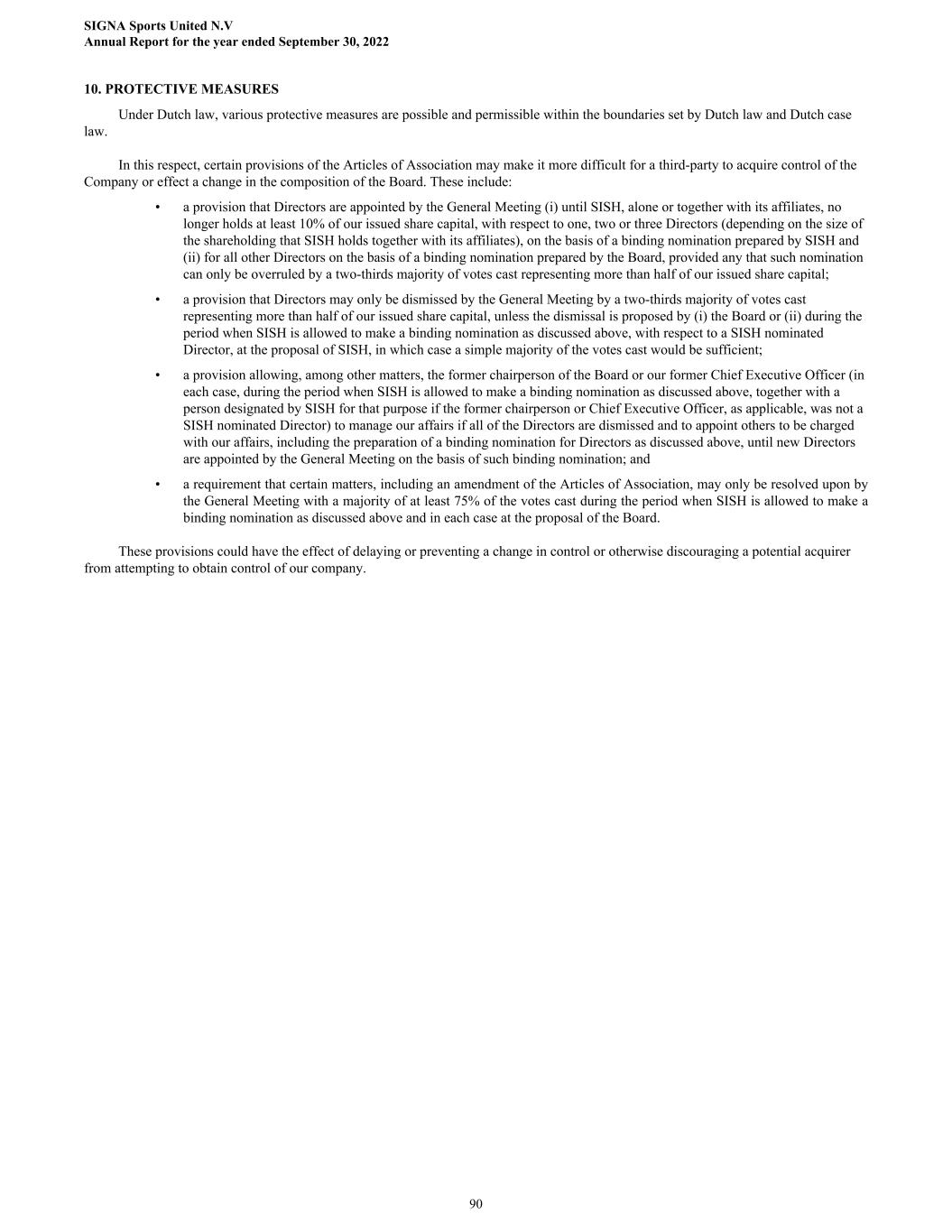
10. PROTECTIVE MEASURES Under Dutch law, various protective measures are possible and permissible within the boundaries set by Dutch law and Dutch case law. In this respect, certain provisions of the Articles of Association may make it more difficult for a third-party to acquire control of the Company or effect a change in the composition of the Board. These include: • a provision that Directors are appointed by the General Meeting (i) until SISH, alone or together with its affiliates, no longer holds at least 10% of our issued share capital, with respect to one, two or three Directors (depending on the size of the shareholding that SISH holds together with its affiliates), on the basis of a binding nomination prepared by SISH and (ii) for all other Directors on the basis of a binding nomination prepared by the Board, provided any that such nomination can only be overruled by a two-thirds majority of votes cast representing more than half of our issued share capital; • a provision that Directors may only be dismissed by the General Meeting by a two-thirds majority of votes cast representing more than half of our issued share capital, unless the dismissal is proposed by (i) the Board or (ii) during the period when SISH is allowed to make a binding nomination as discussed above, with respect to a SISH nominated Director, at the proposal of SISH, in which case a simple majority of the votes cast would be sufficient; • a provision allowing, among other matters, the former chairperson of the Board or our former Chief Executive Officer (in each case, during the period when SISH is allowed to make a binding nomination as discussed above, together with a person designated by SISH for that purpose if the former chairperson or Chief Executive Officer, as applicable, was not a SISH nominated Director) to manage our affairs if all of the Directors are dismissed and to appoint others to be charged with our affairs, including the preparation of a binding nomination for Directors as discussed above, until new Directors are appointed by the General Meeting on the basis of such binding nomination; and • a requirement that certain matters, including an amendment of the Articles of Association, may only be resolved upon by the General Meeting with a majority of at least 75% of the votes cast during the period when SISH is allowed to make a binding nomination as discussed above and in each case at the proposal of the Board. These provisions could have the effect of delaying or preventing a change in control or otherwise discouraging a potential acquirer from attempting to obtain control of our company. SIGNA Sports United N.V Annual Report for the year ended September 30, 2022 90
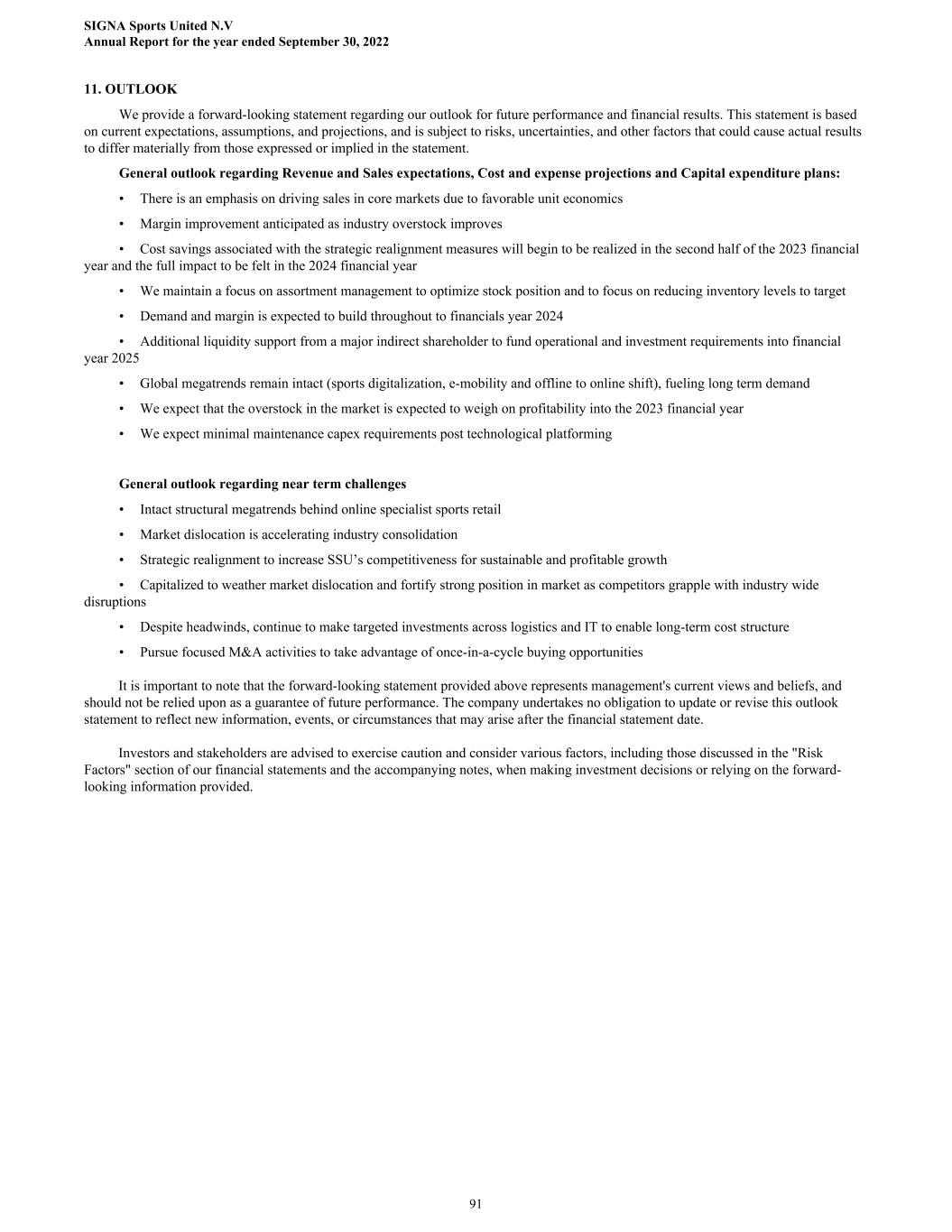
11. OUTLOOK We provide a forward-looking statement regarding our outlook for future performance and financial results. This statement is based on current expectations, assumptions, and projections, and is subject to risks, uncertainties, and other factors that could cause actual results to differ materially from those expressed or implied in the statement. General outlook regarding Revenue and Sales expectations, Cost and expense projections and Capital expenditure plans: • There is an emphasis on driving sales in core markets due to favorable unit economics • Margin improvement anticipated as industry overstock improves • Cost savings associated with the strategic realignment measures will begin to be realized in the second half of the 2023 financial year and the full impact to be felt in the 2024 financial year • We maintain a focus on assortment management to optimize stock position and to focus on reducing inventory levels to target • Demand and margin is expected to build throughout to financials year 2024 • Additional liquidity support from a major indirect shareholder to fund operational and investment requirements into financial year 2025 • Global megatrends remain intact (sports digitalization, e-mobility and offline to online shift), fueling long term demand • We expect that the overstock in the market is expected to weigh on profitability into the 2023 financial year • We expect minimal maintenance capex requirements post technological platforming General outlook regarding near term challenges • Intact structural megatrends behind online specialist sports retail • Market dislocation is accelerating industry consolidation • Strategic realignment to increase SSU’s competitiveness for sustainable and profitable growth • Capitalized to weather market dislocation and fortify strong position in market as competitors grapple with industry wide disruptions • Despite headwinds, continue to make targeted investments across logistics and IT to enable long-term cost structure • Pursue focused M&A activities to take advantage of once-in-a-cycle buying opportunities It is important to note that the forward-looking statement provided above represents management's current views and beliefs, and should not be relied upon as a guarantee of future performance. The company undertakes no obligation to update or revise this outlook statement to reflect new information, events, or circumstances that may arise after the financial statement date. Investors and stakeholders are advised to exercise caution and consider various factors, including those discussed in the "Risk Factors" section of our financial statements and the accompanying notes, when making investment decisions or relying on the forward- looking information provided. SIGNA Sports United N.V Annual Report for the year ended September 30, 2022 91
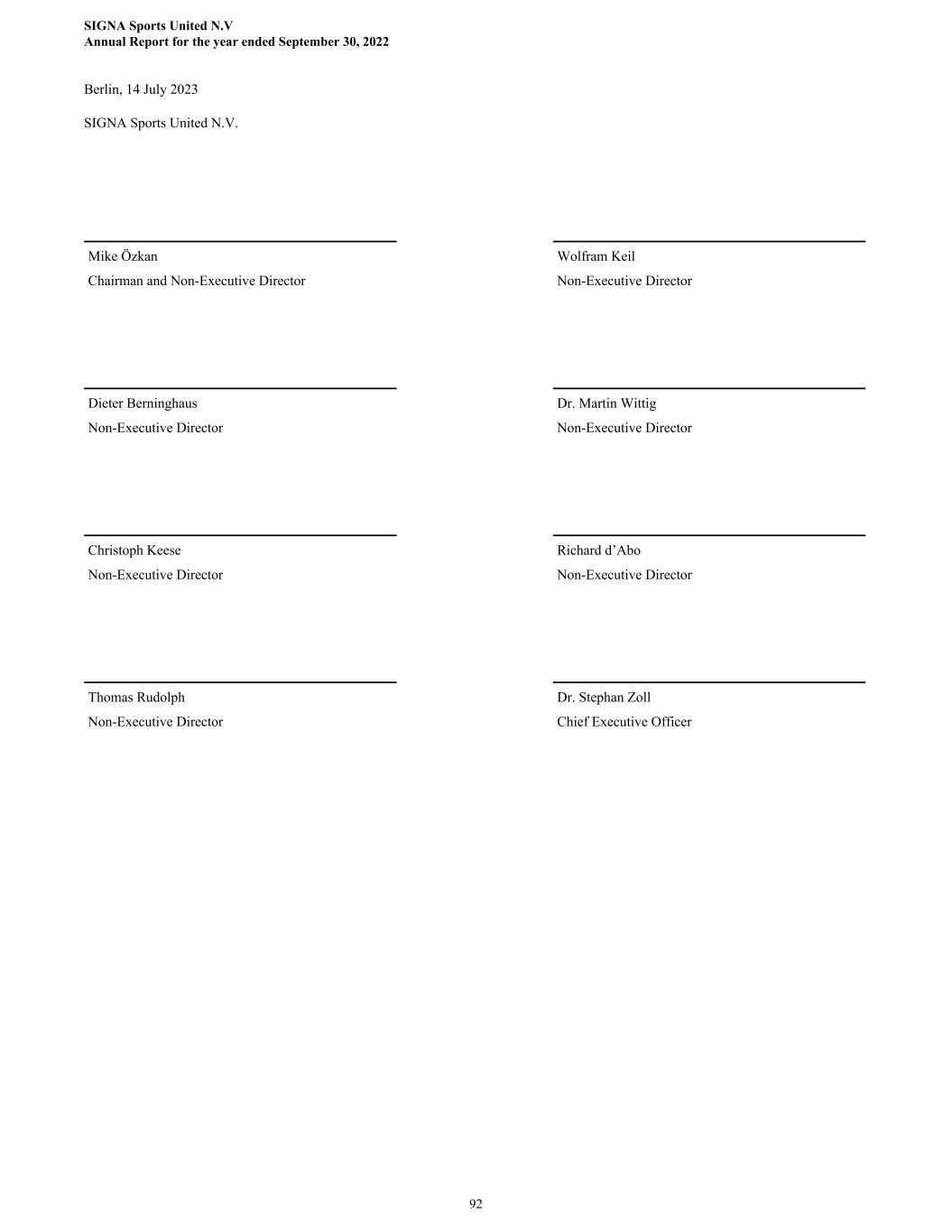
Berlin, 14 July 2023 SIGNA Sports United N.V. Mike Özkan Wolfram Keil Chairman and Non-Executive Director Non-Executive Director Dieter Berninghaus Dr. Martin Wittig Non-Executive Director Non-Executive Director Christoph Keese Richard d’Abo Non-Executive Director Non-Executive Director Thomas Rudolph Dr. Stephan Zoll Non-Executive Director Chief Executive Officer SIGNA Sports United N.V Annual Report for the year ended September 30, 2022 92
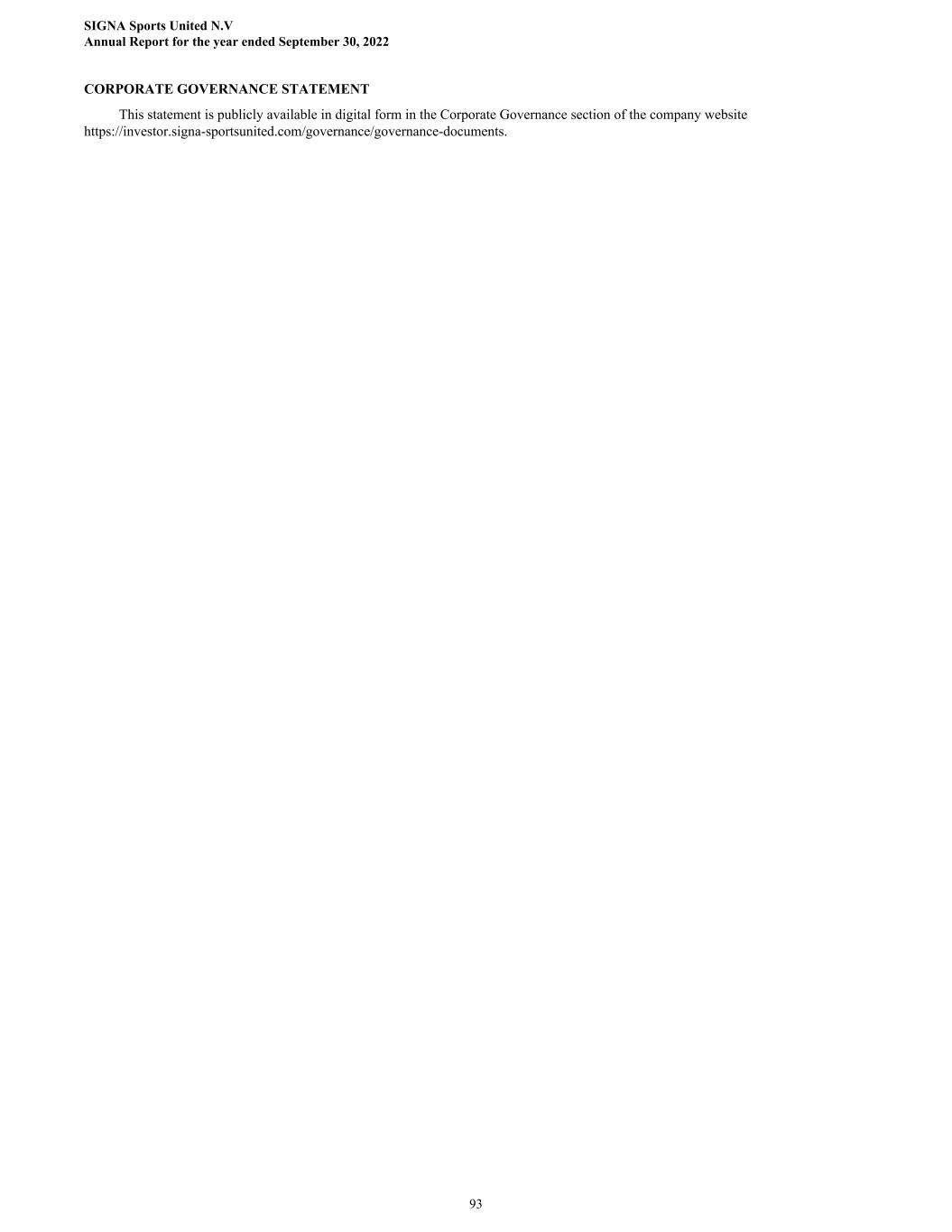
CORPORATE GOVERNANCE STATEMENT This statement is publicly available in digital form in the Corporate Governance section of the company website https://investor.signa-sportsunited.com/governance/governance-documents. SIGNA Sports United N.V Annual Report for the year ended September 30, 2022 93

MANAGEMENT STATEMENT The financial statements give a true and fair view of the assets and liabilities, the financial position and the profit or loss, the management report provides a true and fair view and the significant risks and uncertainties to which the Company is exposed have been described. SIGNA Sports United N.V Annual Report for the year ended September 30, 2022 94
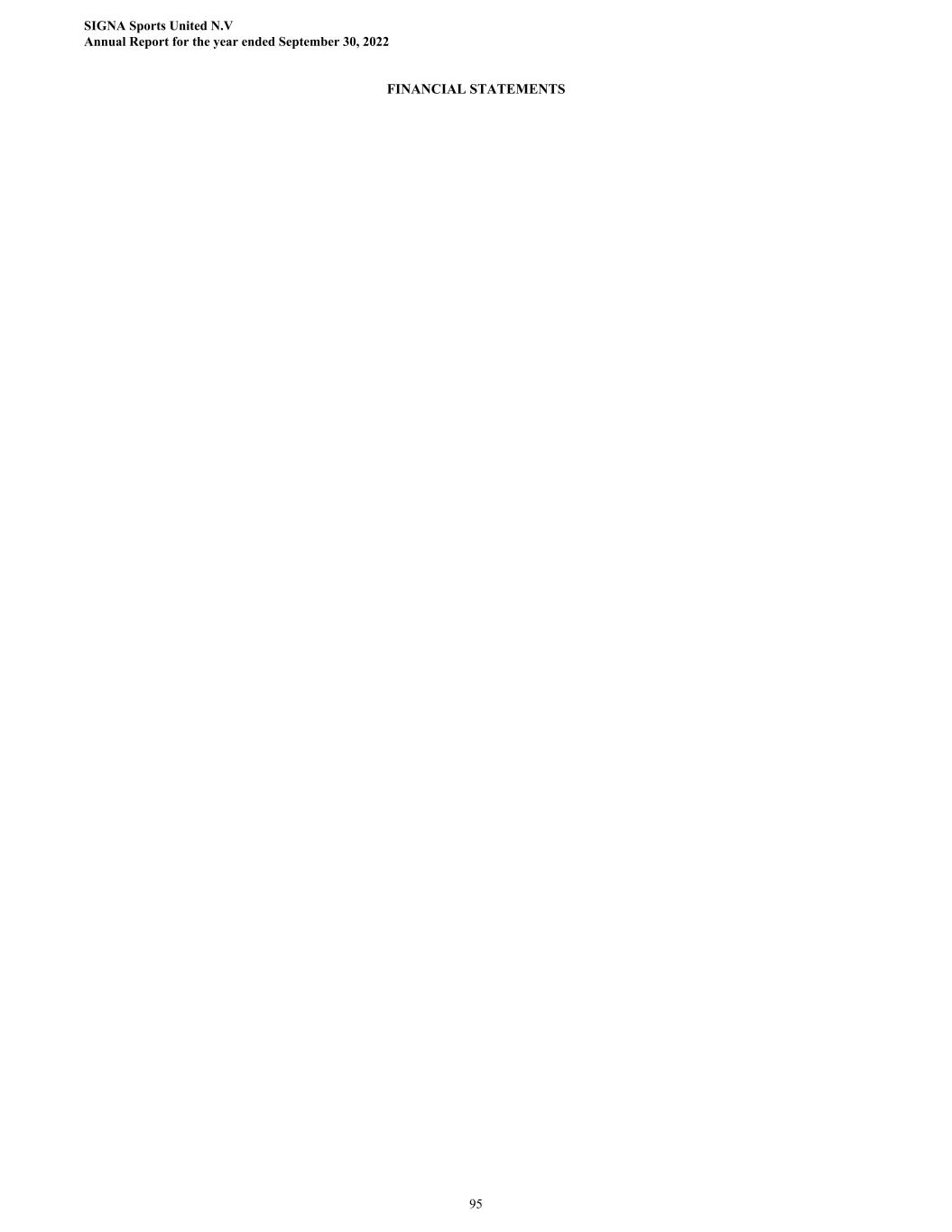
FINANCIAL STATEMENTS SIGNA Sports United N.V Annual Report for the year ended September 30, 2022 95
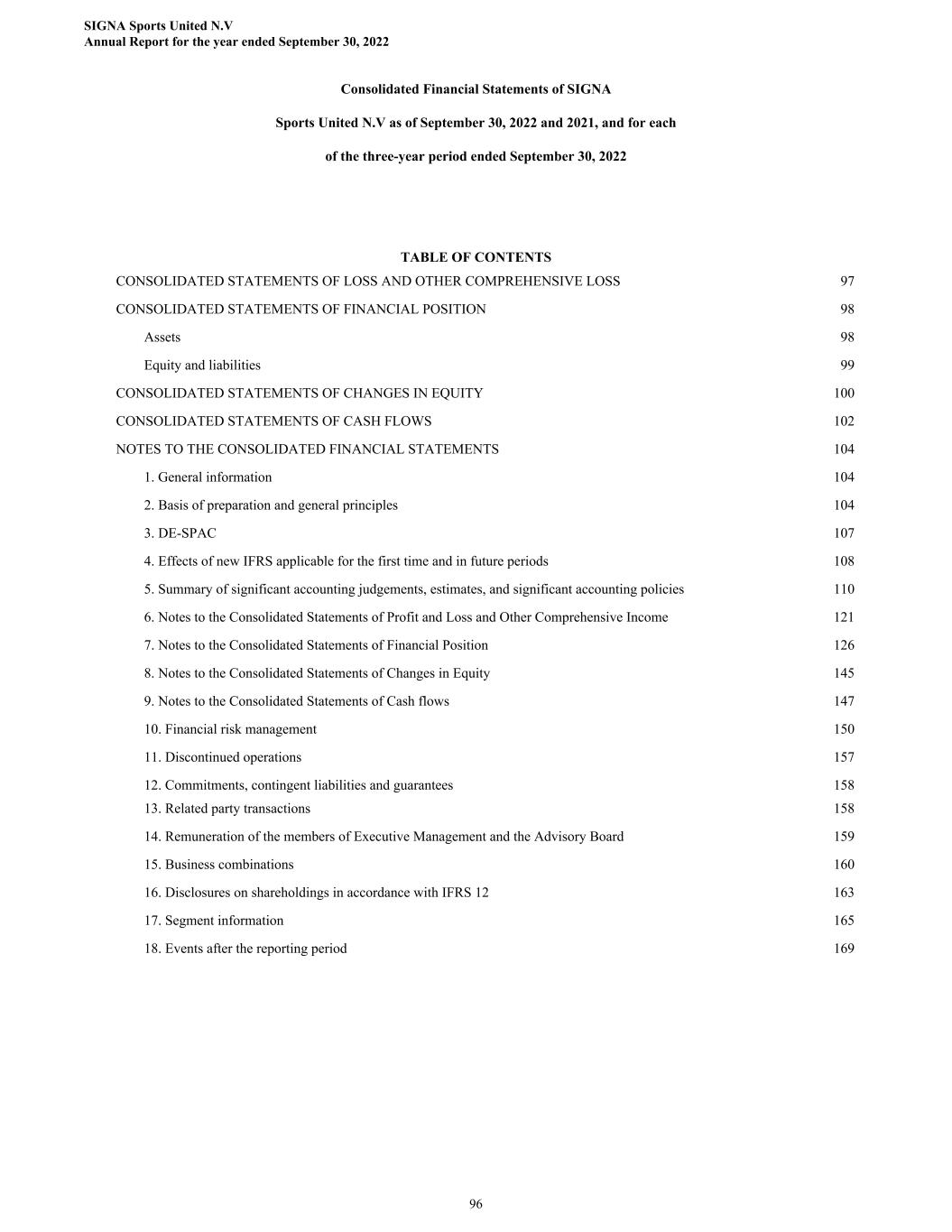
Consolidated Financial Statements of SIGNA Sports United N.V as of September 30, 2022 and 2021, and for each of the three-year period ended September 30, 2022 TABLE OF CONTENTS CONSOLIDATED STATEMENTS OF LOSS AND OTHER COMPREHENSIVE LOSS 97 CONSOLIDATED STATEMENTS OF FINANCIAL POSITION 98 Assets 98 Equity and liabilities 99 CONSOLIDATED STATEMENTS OF CHANGES IN EQUITY 100 CONSOLIDATED STATEMENTS OF CASH FLOWS 102 NOTES TO THE CONSOLIDATED FINANCIAL STATEMENTS 104 1. General information 104 2. Basis of preparation and general principles 104 3. DE-SPAC 107 4. Effects of new IFRS applicable for the first time and in future periods 108 5. Summary of significant accounting judgements, estimates, and significant accounting policies 110 6. Notes to the Consolidated Statements of Profit and Loss and Other Comprehensive Income 121 7. Notes to the Consolidated Statements of Financial Position 126 8. Notes to the Consolidated Statements of Changes in Equity 145 9. Notes to the Consolidated Statements of Cash flows 147 10. Financial risk management 150 11. Discontinued operations 157 12. Commitments, contingent liabilities and guarantees 158 13. Related party transactions 158 14. Remuneration of the members of Executive Management and the Advisory Board 159 15. Business combinations 160 16. Disclosures on shareholdings in accordance with IFRS 12 163 17. Segment information 165 18. Events after the reporting period 169 SIGNA Sports United N.V Annual Report for the year ended September 30, 2022 96
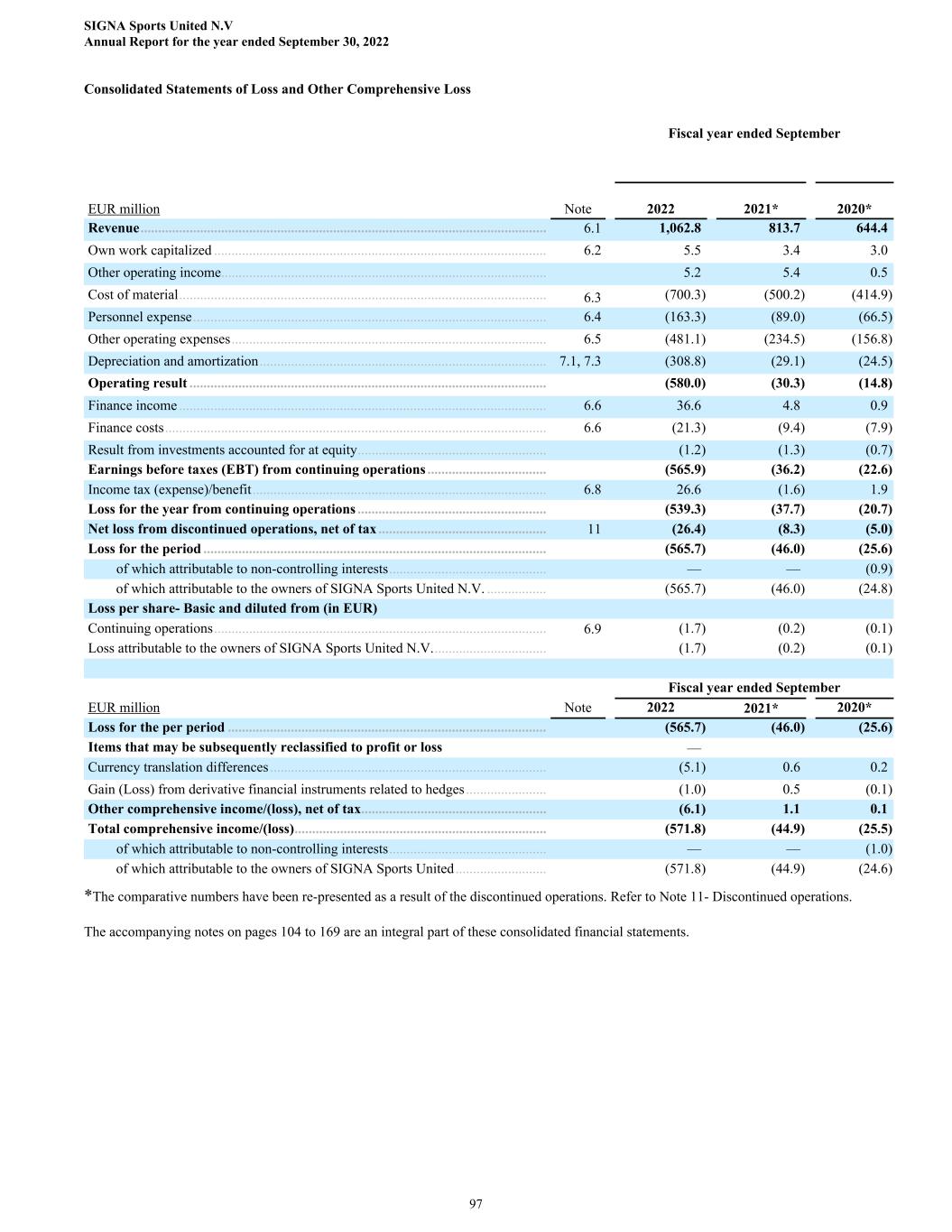
Consolidated Statements of Loss and Other Comprehensive Loss Fiscal year ended September EUR million Note 2022 2021* 2020* Revenue .................................................................................................................... 6.1 1,062.8 813.7 644.4 Own work capitalized ............................................................................................... 6.2 5.5 3.4 3.0 Other operating income ............................................................................................. 5.2 5.4 0.5 Cost of material ......................................................................................................... 6.3 (700.3) (500.2) (414.9) Personnel expense ..................................................................................................... 6.4 (163.3) (89.0) (66.5) Other operating expenses .......................................................................................... 6.5 (481.1) (234.5) (156.8) Depreciation and amortization .................................................................................. 7.1, 7.3 (308.8) (29.1) (24.5) Operating result ...................................................................................................... (580.0) (30.3) (14.8) Finance income ......................................................................................................... 6.6 36.6 4.8 0.9 Finance costs ............................................................................................................. 6.6 (21.3) (9.4) (7.9) Result from investments accounted for at equity ...................................................... (1.2) (1.3) (0.7) Earnings before taxes (EBT) from continuing operations .................................. (565.9) (36.2) (22.6) Income tax (expense)/benefit .................................................................................... 6.8 26.6 (1.6) 1.9 Loss for the year from continuing operations ...................................................... (539.3) (37.7) (20.7) Net loss from discontinued operations, net of tax ................................................ 11 (26.4) (8.3) (5.0) Loss for the period .................................................................................................. (565.7) (46.0) (25.6) of which attributable to non-controlling interests ............................................. — — (0.9) of which attributable to the owners of SIGNA Sports United N.V. ................. (565.7) (46.0) (24.8) Loss per share- Basic and diluted from (in EUR) Continuing operations ............................................................................................... 6.9 (1.7) (0.2) (0.1) Loss attributable to the owners of SIGNA Sports United N.V. ................................ (1.7) (0.2) (0.1) Fiscal year ended September EUR million Note 2022 2021* 2020* Loss for the per period ........................................................................................... (565.7) (46.0) (25.6) Items that may be subsequently reclassified to profit or loss — Currency translation differences ............................................................................... (5.1) 0.6 0.2 Gain (Loss) from derivative financial instruments related to hedges ....................... (1.0) 0.5 (0.1) Other comprehensive income/(loss), net of tax ..................................................... (6.1) 1.1 0.1 Total comprehensive income/(loss) ........................................................................ (571.8) (44.9) (25.5) of which attributable to non-controlling interests ............................................. — — (1.0) of which attributable to the owners of SIGNA Sports United .......................... (571.8) (44.9) (24.6) *The comparative numbers have been re-presented as a result of the discontinued operations. Refer to Note 11- Discontinued operations. The accompanying notes on pages 104 to 169 are an integral part of these consolidated financial statements. SIGNA Sports United N.V Annual Report for the year ended September 30, 2022 97
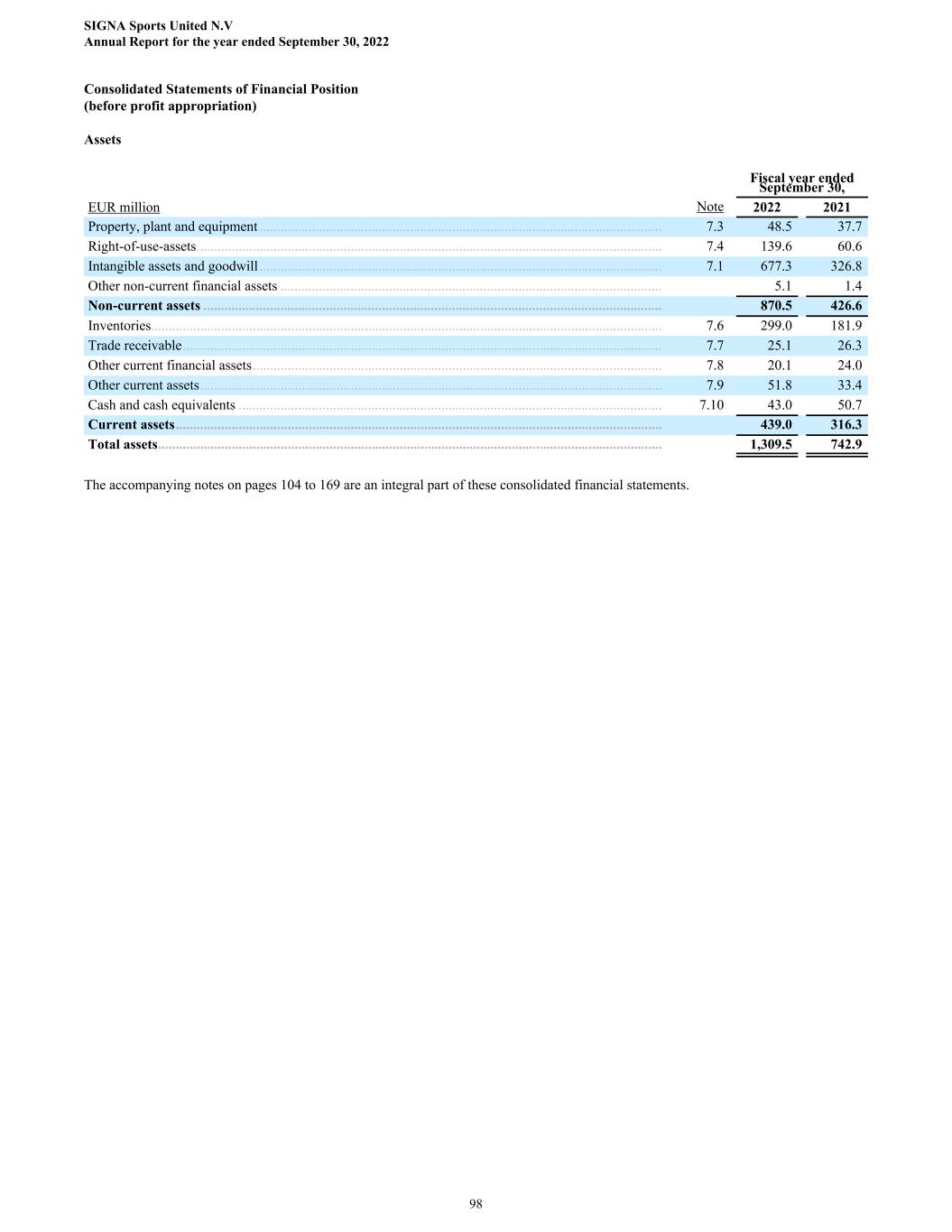
Consolidated Statements of Financial Position (before profit appropriation) Assets Fiscal year ended September 30, EUR million Note 2022 2021 Property, plant and equipment ................................................................................................................... 7.3 48.5 37.7 Right-of-use-assets ..................................................................................................................................... 7.4 139.6 60.6 Intangible assets and goodwill ................................................................................................................... 7.1 677.3 326.8 Other non-current financial assets ............................................................................................................. 5.1 1.4 Non-current assets ................................................................................................................................... 870.5 426.6 Inventories .................................................................................................................................................. 7.6 299.0 181.9 Trade receivable ......................................................................................................................................... 7.7 25.1 26.3 Other current financial assets ..................................................................................................................... 7.8 20.1 24.0 Other current assets .................................................................................................................................... 7.9 51.8 33.4 Cash and cash equivalents ......................................................................................................................... 7.10 43.0 50.7 Current assets ........................................................................................................................................... 439.0 316.3 Total assets ................................................................................................................................................ 1,309.5 742.9 The accompanying notes on pages 104 to 169 are an integral part of these consolidated financial statements. SIGNA Sports United N.V Annual Report for the year ended September 30, 2022 98
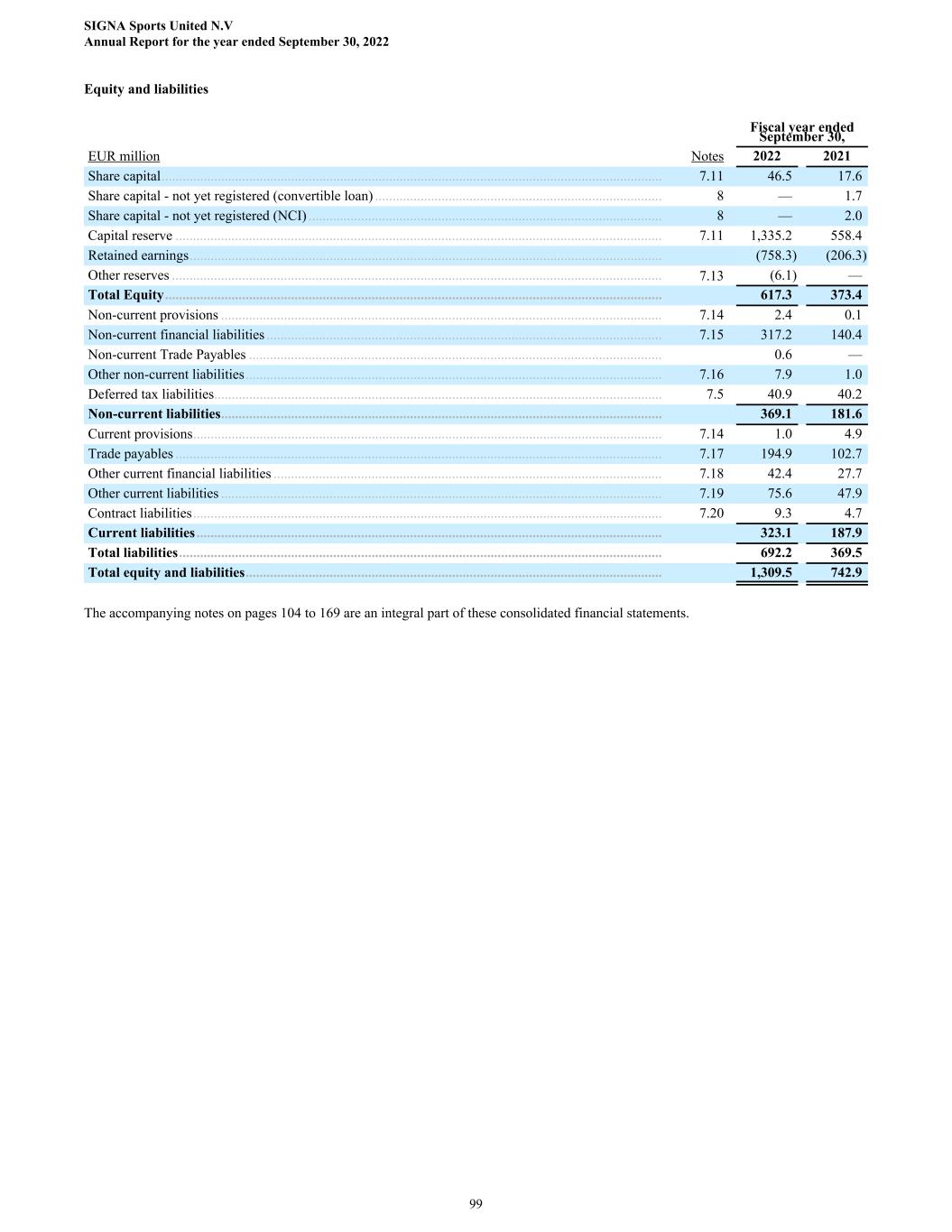
Equity and liabilities Fiscal year ended September 30, EUR million Notes 2022 2021 Share capital ............................................................................................................................................... 7.11 46.5 17.6 Share capital - not yet registered (convertible loan) .................................................................................. 8 — 1.7 Share capital - not yet registered (NCI) ..................................................................................................... 8 — 2.0 Capital reserve ........................................................................................................................................... 7.11 1,335.2 558.4 Retained earnings ....................................................................................................................................... (758.3) (206.3) Other reserves ............................................................................................................................................ 7.13 (6.1) — Total Equity .............................................................................................................................................. 617.3 373.4 Non-current provisions .............................................................................................................................. 7.14 2.4 0.1 Non-current financial liabilities ................................................................................................................. 7.15 317.2 140.4 Non-current Trade Payables ...................................................................................................................... 0.6 — Other non-current liabilities ....................................................................................................................... 7.16 7.9 1.0 Deferred tax liabilities ................................................................................................................................ 7.5 40.9 40.2 Non-current liabilities .............................................................................................................................. 369.1 181.6 Current provisions ...................................................................................................................................... 7.14 1.0 4.9 Trade payables ........................................................................................................................................... 7.17 194.9 102.7 Other current financial liabilities ............................................................................................................... 7.18 42.4 27.7 Other current liabilities .............................................................................................................................. 7.19 75.6 47.9 Contract liabilities ...................................................................................................................................... 7.20 9.3 4.7 Current liabilities ..................................................................................................................................... 323.1 187.9 Total liabilities .......................................................................................................................................... 692.2 369.5 Total equity and liabilities ....................................................................................................................... 1,309.5 742.9 The accompanying notes on pages 104 to 169 are an integral part of these consolidated financial statements. SIGNA Sports United N.V Annual Report for the year ended September 30, 2022 99

Consolidated Statements of Changes in Equity Capital Reserves Other Reserves EUR million Share capital Share capital-not yet registered (convertible loan) Share capital- not yet registered (NCI) Capital reserve Equity component of convertible loans Currency conversion Cash flow hedges Retained earnings Group equity Balance as of Oct. 1, 2021 ........................ 17.6 1.7 2.0 555.3 3.1 0.1 (0.1) (206.3) 373.4 Total income/(loss) .................................... — — — — — — — (565.7) (565.7) Other comprehensive income/(loss), net of tax ................................................ — — — — — (5.1) (1.0) — (6.1) Total comprehensive income/(loss) ......................................... — — — — — (5.1) (1.0) (565.7) (571.8) Reclass Share capital and capital reserve .. 3.7 (1.7) (2.0) 3.1 (3.1) — — — — Equity-settled share-based payment .......... 0.1 — — 4.0 — — — 13.6 17.8 Issue of share capital ............................... PIPE Financing .......................................... 11.6 — — 391.1 — — — — 402.7 Yucaipa Merger ......................................... 1.5 — — 108.6 — — — — 110.1 Issue of ordinary shares related to business combinations ............................... 4.0 — — 287.0 — — — — 291.0 Total issuance of share capital ................ 17.1 — — 786.7 — — — — 803.8 Recapitalization ......................................... 8.0 — — (8.0) — — — — — Transaction costs of the capital increase after taxes ................................................... — — — (5.9) — — — — (5.9) Balance as of Sep. 30, 2022 ...................... 46.5 — — 1,335.2 — (5.0) (1.1) (758.3) 617.3 The accompanying notes on pages 104 to 169 are an integral part of these consolidated financial statements. Capital Reserves Other Reserves EUR million Share capital Share capital- not yet registered (convertible loan) Share capital- not yet registered (NCI) Capital reserve Equity component of convertible loans Currency conversion Cash flow hedges Retained earnings Capital and reserves attributable to the owners of SIGNA Sports United GmbH Non- controlling interests Group equity Balance as of Oct. 1, 2020 .... 17.6 — — 367.3 3.1 (0.4) (0.3) (64.6) 322.7 24.4 347.1 Total income/(loss) ................. — — — — — — — (46.0) (46.0) — (46.0) Other comprehensive income/ (loss), net of tax ..................... — — — — — 0.6 0.5 — 1.1 — 1.1 Total comprehensive income/(loss) ..................... — — — — — 0.6 0.5 (46.0) (44.9) — (44.9) Capital Increase ...................... — 1.7 2.0 115.5 — — — — 119.1 — 119.1 Equity-settled share-based payment .................................. — — — — — — — 2.7 2.7 — 2.7 Conversion of convertible loan ......................................... — — — 73.8 — — — — 73.8 — 73.8 Dividends ............................... — — — — — — — (0.3) (0.3) — (0.3) Change in non-controlling interests (NCI) ....................... — — — — — (0.1) (0.3) (98.0) (98.4) (24.4) (122.8) Transaction costs of the capital increase after increase after taxes ............................... — — — (1.2) — — — — (1.2) — (1.2) Balance as of Sep. 30, 2021 .. 17.6 1.7 2.0 555.3 3.1 0.1 (0.1) (206.3) 373.4 — 373.4 The accompanying notes on pages 104 to 169 are an integral part of these consolidated financial statements. SIGNA Sports United N.V Annual Report for the year ended September 30, 2022 100
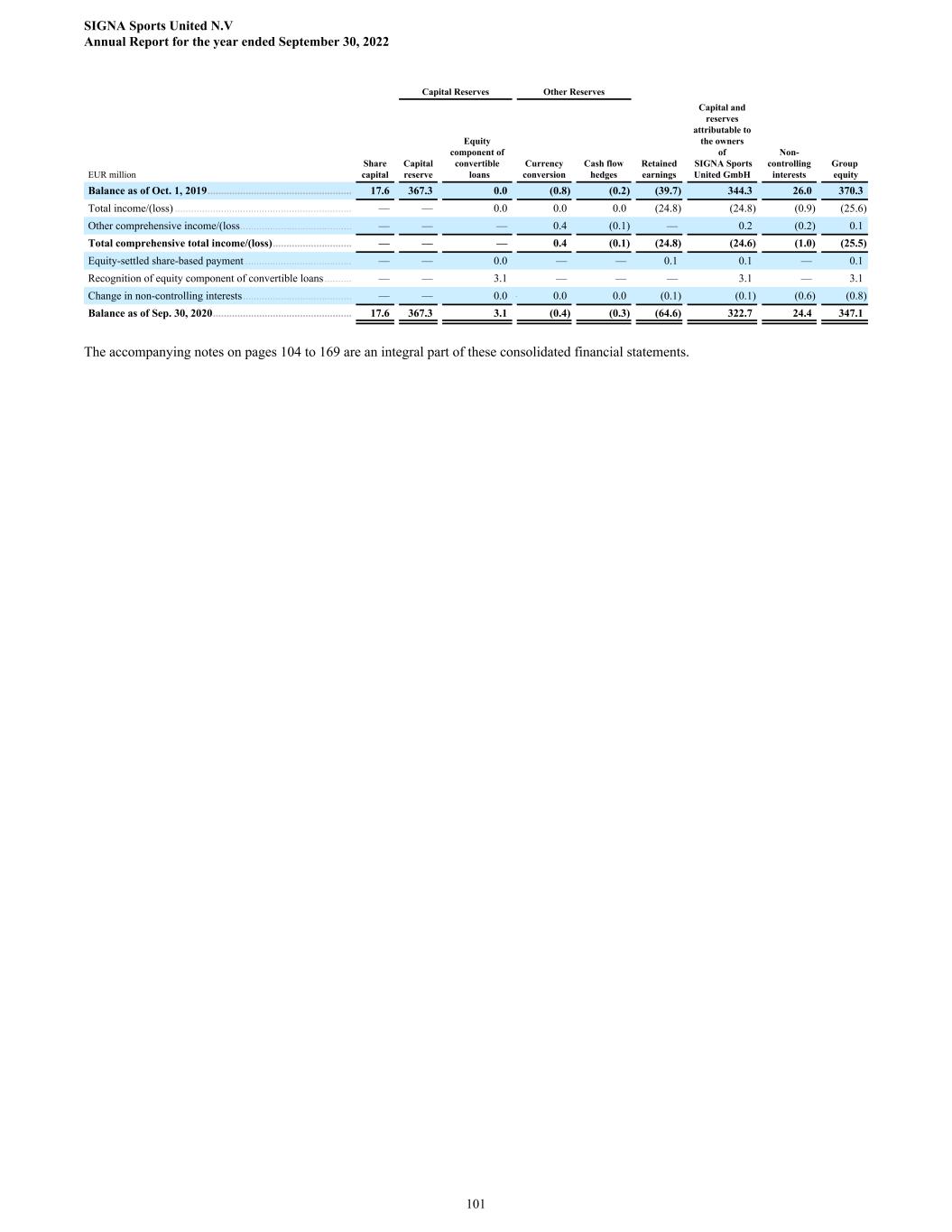
Capital Reserves Other Reserves EUR million Share capital Capital reserve Equity component of convertible loans Currency conversion Cash flow hedges Retained earnings Capital and reserves attributable to the owners of SIGNA Sports United GmbH Non- controlling interests Group equity Balance as of Oct. 1, 2019 ..................................................... 17.6 367.3 0.0 (0.8) (0.2) (39.7) 344.3 26.0 370.3 Total income/(loss) ................................................................. — — 0.0 0.0 0.0 (24.8) (24.8) (0.9) (25.6) Other comprehensive income/(loss ......................................... — — — 0.4 (0.1) — 0.2 (0.2) 0.1 Total comprehensive total income/(loss) ............................. — — — 0.4 (0.1) (24.8) (24.6) (1.0) (25.5) Equity-settled share-based payment ....................................... — — 0.0 — — 0.1 0.1 — 0.1 Recognition of equity component of convertible loans .......... — — 3.1 — — — 3.1 — 3.1 Change in non-controlling interests ........................................ — — 0.0 — 0.0 0.0 (0.1) (0.1) (0.6) (0.8) Balance as of Sep. 30, 2020 ................................................... 17.6 367.3 3.1 (0.4) (0.3) (64.6) 322.7 24.4 347.1 The accompanying notes on pages 104 to 169 are an integral part of these consolidated financial statements. SIGNA Sports United N.V Annual Report for the year ended September 30, 2022 101
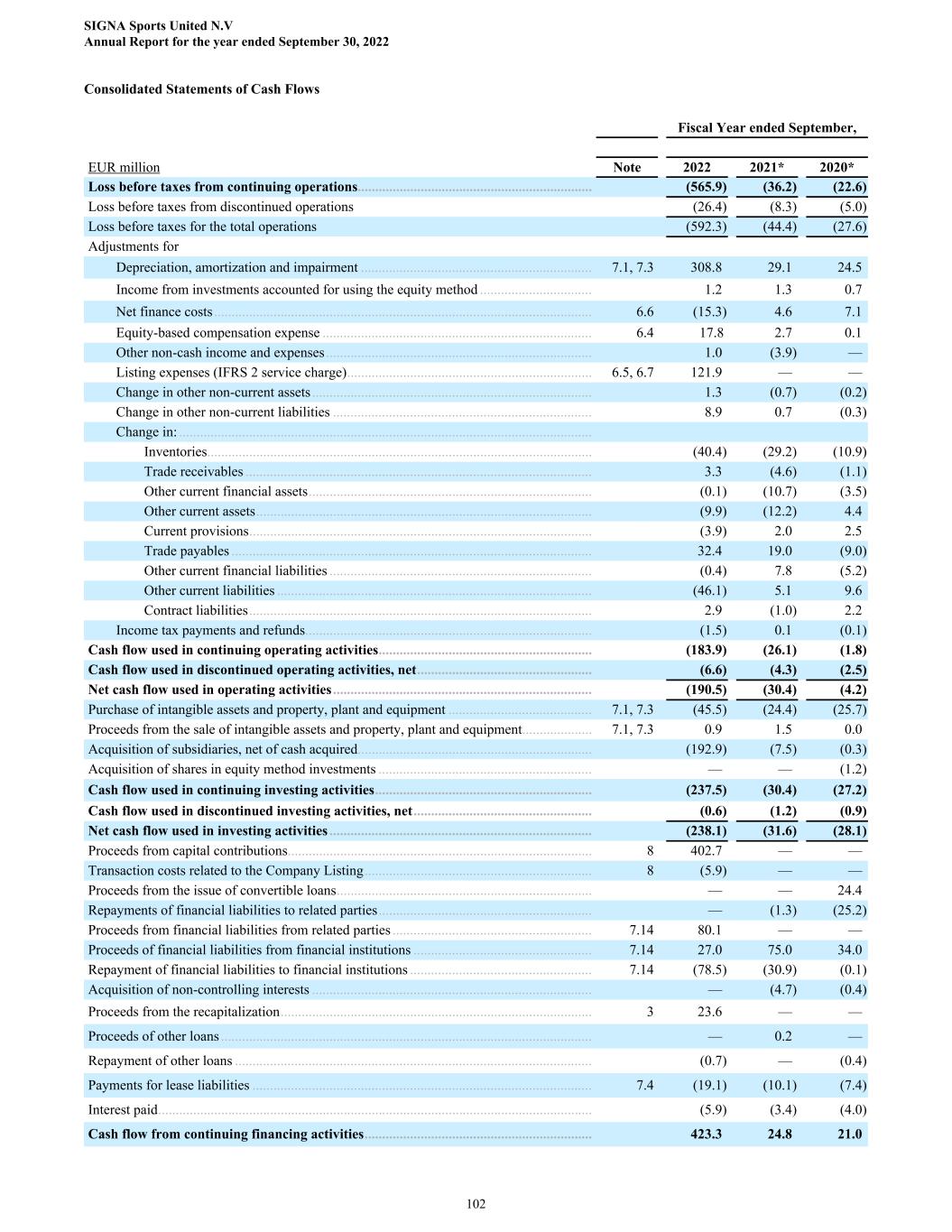
Consolidated Statements of Cash Flows Fiscal Year ended September, EUR million Note 2022 2021* 2020* Loss before taxes from continuing operations ................................................................... (565.9) (36.2) (22.6) Loss before taxes from discontinued operations (26.4) (8.3) (5.0) Loss before taxes for the total operations (592.3) (44.4) (27.6) Adjustments for Depreciation, amortization and impairment .................................................................. 7.1, 7.3 308.8 29.1 24.5 Income from investments accounted for using the equity method ................................ 1.2 1.3 0.7 Net finance costs ............................................................................................................ 6.6 (15.3) 4.6 7.1 Equity-based compensation expense ............................................................................. 6.4 17.8 2.7 0.1 Other non-cash income and expenses ............................................................................ 1.0 (3.9) — Listing expenses (IFRS 2 service charge) ...................................................................... 6.5, 6.7 121.9 — — Change in other non-current assets ................................................................................ 1.3 (0.7) (0.2) Change in other non-current liabilities .......................................................................... 8.9 0.7 (0.3) Change in: ...................................................................................................................... Inventories .............................................................................................................. (40.4) (29.2) (10.9) Trade receivables ................................................................................................... 3.3 (4.6) (1.1) Other current financial assets ................................................................................. (0.1) (10.7) (3.5) Other current assets ................................................................................................ (9.9) (12.2) 4.4 Current provisions .................................................................................................. (3.9) 2.0 2.5 Trade payables ....................................................................................................... 32.4 19.0 (9.0) Other current financial liabilities ........................................................................... (0.4) 7.8 (5.2) Other current liabilities .......................................................................................... (46.1) 5.1 9.6 Contract liabilities .................................................................................................. 2.9 (1.0) 2.2 Income tax payments and refunds .................................................................................. (1.5) 0.1 (0.1) Cash flow used in continuing operating activities ............................................................. (183.9) (26.1) (1.8) Cash flow used in discontinued operating activities, net .................................................. (6.6) (4.3) (2.5) Net cash flow used in operating activities .......................................................................... (190.5) (30.4) (4.2) Purchase of intangible assets and property, plant and equipment ......................................... 7.1, 7.3 (45.5) (24.4) (25.7) Proceeds from the sale of intangible assets and property, plant and equipment .................... 7.1, 7.3 0.9 1.5 0.0 Acquisition of subsidiaries, net of cash acquired ................................................................... (192.9) (7.5) (0.3) Acquisition of shares in equity method investments ............................................................. — — (1.2) Cash flow used in continuing investing activities .............................................................. (237.5) (30.4) (27.2) Cash flow used in discontinued investing activities, net ................................................... (0.6) (1.2) (0.9) Net cash flow used in investing activities ........................................................................... (238.1) (31.6) (28.1) Proceeds from capital contributions ....................................................................................... 8 402.7 — — Transaction costs related to the Company Listing ................................................................. 8 (5.9) — — Proceeds from the issue of convertible loans ......................................................................... — — 24.4 Repayments of financial liabilities to related parties ............................................................. — (1.3) (25.2) Proceeds from financial liabilities from related parties ......................................................... 7.14 80.1 — — Proceeds of financial liabilities from financial institutions ................................................... 7.14 27.0 75.0 34.0 Repayment of financial liabilities to financial institutions .................................................... 7.14 (78.5) (30.9) (0.1) Acquisition of non-controlling interests ................................................................................ — (4.7) (0.4) Proceeds from the recapitalization ......................................................................................... 3 23.6 — — Proceeds of other loans .......................................................................................................... — 0.2 — Repayment of other loans ...................................................................................................... (0.7) — (0.4) Payments for lease liabilities ................................................................................................. 7.4 (19.1) (10.1) (7.4) Interest paid ............................................................................................................................ (5.9) (3.4) (4.0) Cash flow from continuing financing activities ................................................................. 423.3 24.8 21.0 SIGNA Sports United N.V Annual Report for the year ended September 30, 2022 102
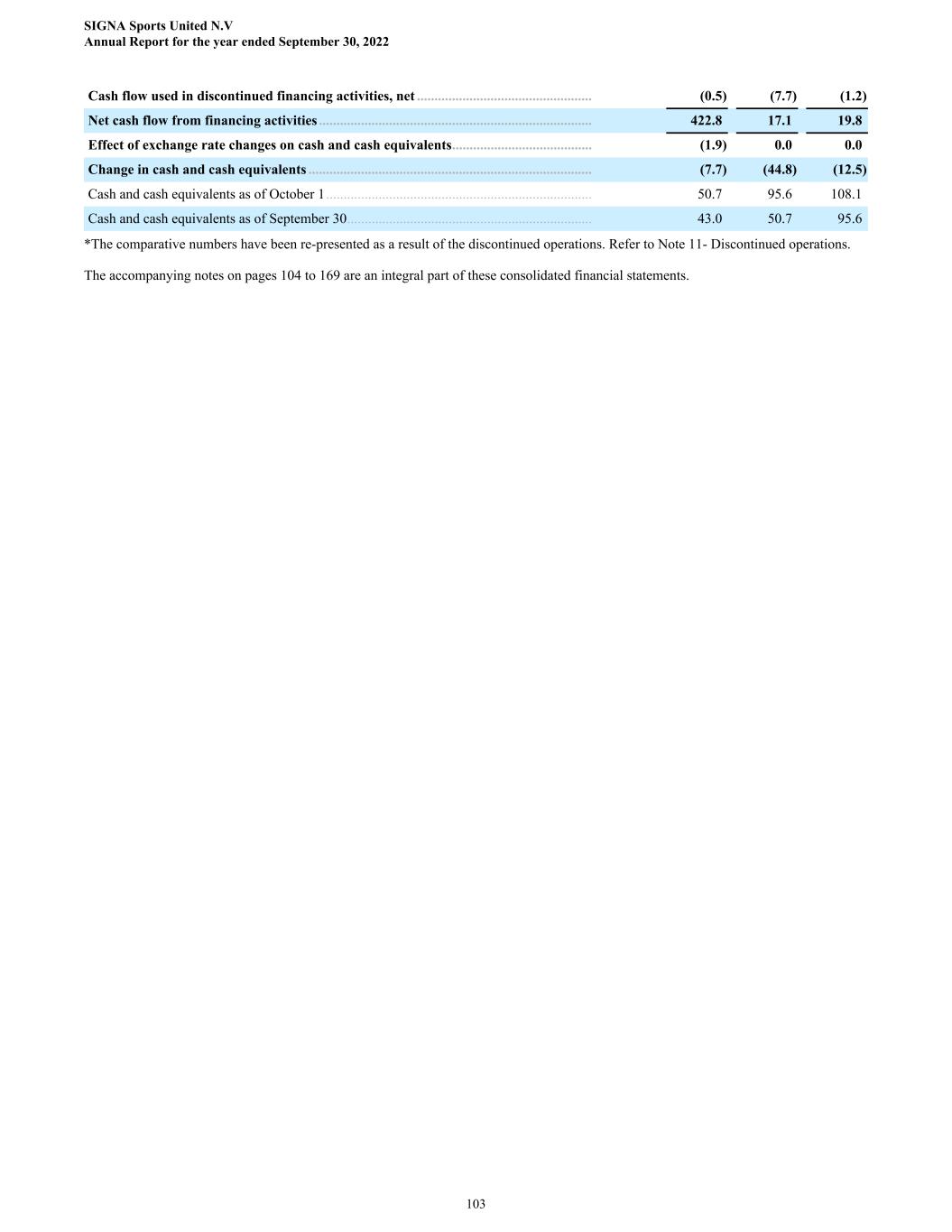
Cash flow used in discontinued financing activities, net .................................................. (0.5) (7.7) (1.2) Net cash flow from financing activities .............................................................................. 422.8 17.1 19.8 Effect of exchange rate changes on cash and cash equivalents ........................................ (1.9) 0.0 0.0 Change in cash and cash equivalents ................................................................................. (7.7) (44.8) (12.5) Cash and cash equivalents as of October 1 ............................................................................ 50.7 95.6 108.1 Cash and cash equivalents as of September 30 ...................................................................... 43.0 50.7 95.6 *The comparative numbers have been re-presented as a result of the discontinued operations. Refer to Note 11- Discontinued operations. The accompanying notes on pages 104 to 169 are an integral part of these consolidated financial statements. SIGNA Sports United N.V Annual Report for the year ended September 30, 2022 103
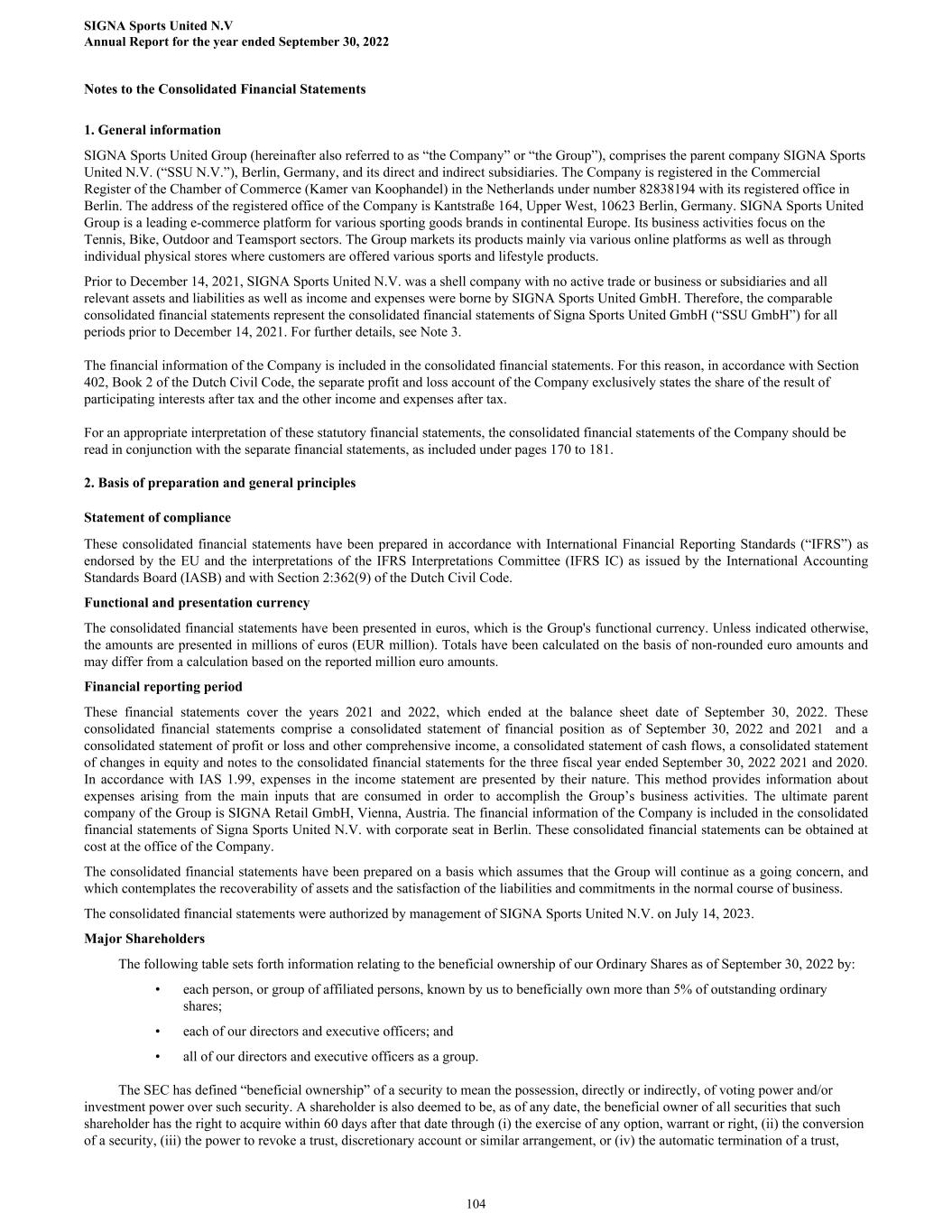
Notes to the Consolidated Financial Statements 1. General information SIGNA Sports United Group (hereinafter also referred to as “the Company” or “the Group”), comprises the parent company SIGNA Sports United N.V. (“SSU N.V.”), Berlin, Germany, and its direct and indirect subsidiaries. The Company is registered in the Commercial Register of the Chamber of Commerce (Kamer van Koophandel) in the Netherlands under number 82838194 with its registered office in Berlin. The address of the registered office of the Company is Kantstraße 164, Upper West, 10623 Berlin, Germany. SIGNA Sports United Group is a leading e-commerce platform for various sporting goods brands in continental Europe. Its business activities focus on the Tennis, Bike, Outdoor and Teamsport sectors. The Group markets its products mainly via various online platforms as well as through individual physical stores where customers are offered various sports and lifestyle products. Prior to December 14, 2021, SIGNA Sports United N.V. was a shell company with no active trade or business or subsidiaries and all relevant assets and liabilities as well as income and expenses were borne by SIGNA Sports United GmbH. Therefore, the comparable consolidated financial statements represent the consolidated financial statements of Signa Sports United GmbH (“SSU GmbH”) for all periods prior to December 14, 2021. For further details, see Note 3. The financial information of the Company is included in the consolidated financial statements. For this reason, in accordance with Section 402, Book 2 of the Dutch Civil Code, the separate profit and loss account of the Company exclusively states the share of the result of participating interests after tax and the other income and expenses after tax. For an appropriate interpretation of these statutory financial statements, the consolidated financial statements of the Company should be read in conjunction with the separate financial statements, as included under pages 170 to 181. 2. Basis of preparation and general principles Statement of compliance These consolidated financial statements have been prepared in accordance with International Financial Reporting Standards (“IFRS”) as endorsed by the EU and the interpretations of the IFRS Interpretations Committee (IFRS IC) as issued by the International Accounting Standards Board (IASB) and with Section 2:362(9) of the Dutch Civil Code. Functional and presentation currency The consolidated financial statements have been presented in euros, which is the Group's functional currency. Unless indicated otherwise, the amounts are presented in millions of euros (EUR million). Totals have been calculated on the basis of non-rounded euro amounts and may differ from a calculation based on the reported million euro amounts. Financial reporting period These financial statements cover the years 2021 and 2022, which ended at the balance sheet date of September 30, 2022. These consolidated financial statements comprise a consolidated statement of financial position as of September 30, 2022 and 2021 and a consolidated statement of profit or loss and other comprehensive income, a consolidated statement of cash flows, a consolidated statement of changes in equity and notes to the consolidated financial statements for the three fiscal year ended September 30, 2022 2021 and 2020. In accordance with IAS 1.99, expenses in the income statement are presented by their nature. This method provides information about expenses arising from the main inputs that are consumed in order to accomplish the Group’s business activities. The ultimate parent company of the Group is SIGNA Retail GmbH, Vienna, Austria. The financial information of the Company is included in the consolidated financial statements of Signa Sports United N.V. with corporate seat in Berlin. These consolidated financial statements can be obtained at cost at the office of the Company. The consolidated financial statements have been prepared on a basis which assumes that the Group will continue as a going concern, and which contemplates the recoverability of assets and the satisfaction of the liabilities and commitments in the normal course of business. The consolidated financial statements were authorized by management of SIGNA Sports United N.V. on July 14, 2023. Major Shareholders The following table sets forth information relating to the beneficial ownership of our Ordinary Shares as of September 30, 2022 by: • each person, or group of affiliated persons, known by us to beneficially own more than 5% of outstanding ordinary shares; • each of our directors and executive officers; and • all of our directors and executive officers as a group. The SEC has defined “beneficial ownership” of a security to mean the possession, directly or indirectly, of voting power and/or investment power over such security. A shareholder is also deemed to be, as of any date, the beneficial owner of all securities that such shareholder has the right to acquire within 60 days after that date through (i) the exercise of any option, warrant or right, (ii) the conversion of a security, (iii) the power to revoke a trust, discretionary account or similar arrangement, or (iv) the automatic termination of a trust, SIGNA Sports United N.V Annual Report for the year ended September 30, 2022 104
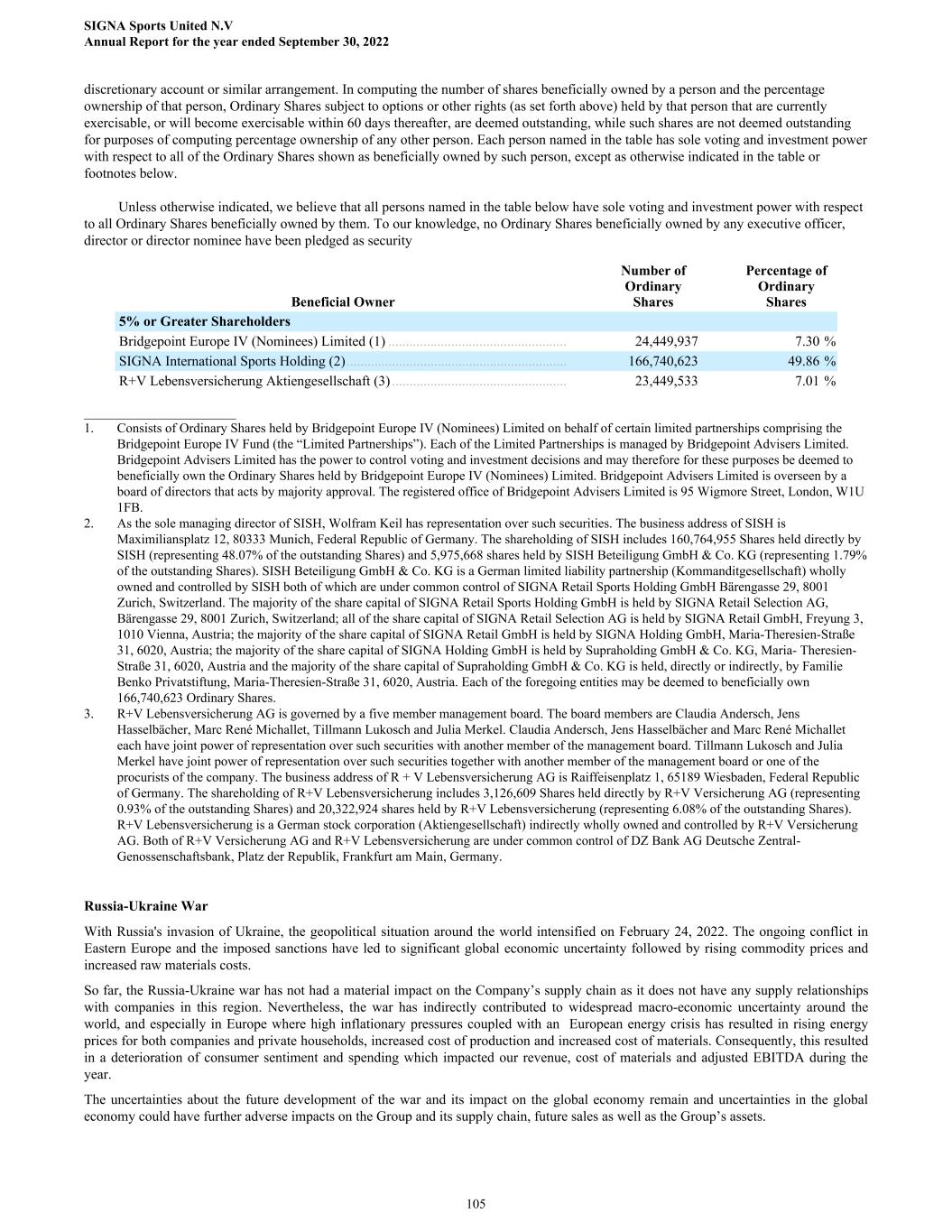
discretionary account or similar arrangement. In computing the number of shares beneficially owned by a person and the percentage ownership of that person, Ordinary Shares subject to options or other rights (as set forth above) held by that person that are currently exercisable, or will become exercisable within 60 days thereafter, are deemed outstanding, while such shares are not deemed outstanding for purposes of computing percentage ownership of any other person. Each person named in the table has sole voting and investment power with respect to all of the Ordinary Shares shown as beneficially owned by such person, except as otherwise indicated in the table or footnotes below. Unless otherwise indicated, we believe that all persons named in the table below have sole voting and investment power with respect to all Ordinary Shares beneficially owned by them. To our knowledge, no Ordinary Shares beneficially owned by any executive officer, director or director nominee have been pledged as security Beneficial Owner Number of Ordinary Shares Percentage of Ordinary Shares 5% or Greater Shareholders Bridgepoint Europe IV (Nominees) Limited (1) ................................................... 24,449,937 7.30 % SIGNA International Sports Holding (2) ............................................................... 166,740,623 49.86 % R+V Lebensversicherung Aktiengesellschaft (3) .................................................. 23,449,533 7.01 % _______________________ 1. Consists of Ordinary Shares held by Bridgepoint Europe IV (Nominees) Limited on behalf of certain limited partnerships comprising the Bridgepoint Europe IV Fund (the “Limited Partnerships”). Each of the Limited Partnerships is managed by Bridgepoint Advisers Limited. Bridgepoint Advisers Limited has the power to control voting and investment decisions and may therefore for these purposes be deemed to beneficially own the Ordinary Shares held by Bridgepoint Europe IV (Nominees) Limited. Bridgepoint Advisers Limited is overseen by a board of directors that acts by majority approval. The registered office of Bridgepoint Advisers Limited is 95 Wigmore Street, London, W1U 1FB. 2. As the sole managing director of SISH, Wolfram Keil has representation over such securities. The business address of SISH is Maximiliansplatz 12, 80333 Munich, Federal Republic of Germany. The shareholding of SISH includes 160,764,955 Shares held directly by SISH (representing 48.07% of the outstanding Shares) and 5,975,668 shares held by SISH Beteiligung GmbH & Co. KG (representing 1.79% of the outstanding Shares). SISH Beteiligung GmbH & Co. KG is a German limited liability partnership (Kommanditgesellschaft) wholly owned and controlled by SISH both of which are under common control of SIGNA Retail Sports Holding GmbH Bärengasse 29, 8001 Zurich, Switzerland. The majority of the share capital of SIGNA Retail Sports Holding GmbH is held by SIGNA Retail Selection AG, Bärengasse 29, 8001 Zurich, Switzerland; all of the share capital of SIGNA Retail Selection AG is held by SIGNA Retail GmbH, Freyung 3, 1010 Vienna, Austria; the majority of the share capital of SIGNA Retail GmbH is held by SIGNA Holding GmbH, Maria-Theresien-Straße 31, 6020, Austria; the majority of the share capital of SIGNA Holding GmbH is held by Supraholding GmbH & Co. KG, Maria- Theresien- Straße 31, 6020, Austria and the majority of the share capital of Supraholding GmbH & Co. KG is held, directly or indirectly, by Familie Benko Privatstiftung, Maria-Theresien-Straße 31, 6020, Austria. Each of the foregoing entities may be deemed to beneficially own 166,740,623 Ordinary Shares. 3. R+V Lebensversicherung AG is governed by a five member management board. The board members are Claudia Andersch, Jens Hasselbächer, Marc René Michallet, Tillmann Lukosch and Julia Merkel. Claudia Andersch, Jens Hasselbächer and Marc René Michallet each have joint power of representation over such securities with another member of the management board. Tillmann Lukosch and Julia Merkel have joint power of representation over such securities together with another member of the management board or one of the procurists of the company. The business address of R + V Lebensversicherung AG is Raiffeisenplatz 1, 65189 Wiesbaden, Federal Republic of Germany. The shareholding of R+V Lebensversicherung includes 3,126,609 Shares held directly by R+V Versicherung AG (representing 0.93% of the outstanding Shares) and 20,322,924 shares held by R+V Lebensversicherung (representing 6.08% of the outstanding Shares). R+V Lebensversicherung is a German stock corporation (Aktiengesellschaft) indirectly wholly owned and controlled by R+V Versicherung AG. Both of R+V Versicherung AG and R+V Lebensversicherung are under common control of DZ Bank AG Deutsche Zentral- Genossenschaftsbank, Platz der Republik, Frankfurt am Main, Germany. Russia-Ukraine War With Russia's invasion of Ukraine, the geopolitical situation around the world intensified on February 24, 2022. The ongoing conflict in Eastern Europe and the imposed sanctions have led to significant global economic uncertainty followed by rising commodity prices and increased raw materials costs. So far, the Russia-Ukraine war has not had a material impact on the Company’s supply chain as it does not have any supply relationships with companies in this region. Nevertheless, the war has indirectly contributed to widespread macro-economic uncertainty around the world, and especially in Europe where high inflationary pressures coupled with an European energy crisis has resulted in rising energy prices for both companies and private households, increased cost of production and increased cost of materials. Consequently, this resulted in a deterioration of consumer sentiment and spending which impacted our revenue, cost of materials and adjusted EBITDA during the year. The uncertainties about the future development of the war and its impact on the global economy remain and uncertainties in the global economy could have further adverse impacts on the Group and its supply chain, future sales as well as the Group’s assets. SIGNA Sports United N.V Annual Report for the year ended September 30, 2022 105
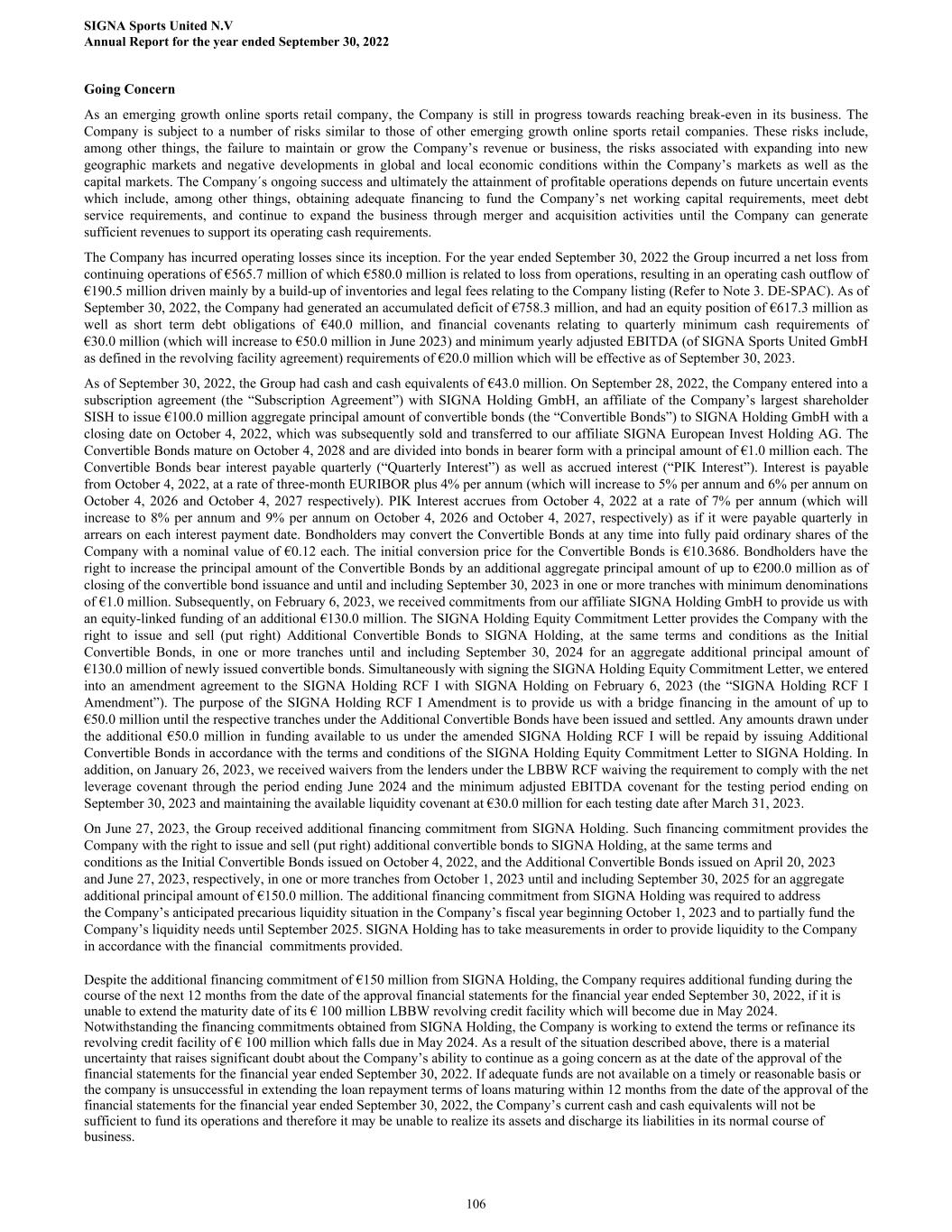
Going Concern As an emerging growth online sports retail company, the Company is still in progress towards reaching break-even in its business. The Company is subject to a number of risks similar to those of other emerging growth online sports retail companies. These risks include, among other things, the failure to maintain or grow the Company’s revenue or business, the risks associated with expanding into new geographic markets and negative developments in global and local economic conditions within the Company’s markets as well as the capital markets. The Company´s ongoing success and ultimately the attainment of profitable operations depends on future uncertain events which include, among other things, obtaining adequate financing to fund the Company’s net working capital requirements, meet debt service requirements, and continue to expand the business through merger and acquisition activities until the Company can generate sufficient revenues to support its operating cash requirements. The Company has incurred operating losses since its inception. For the year ended September 30, 2022 the Group incurred a net loss from continuing operations of €565.7 million of which €580.0 million is related to loss from operations, resulting in an operating cash outflow of €190.5 million driven mainly by a build-up of inventories and legal fees relating to the Company listing (Refer to Note 3. DE-SPAC). As of September 30, 2022, the Company had generated an accumulated deficit of €758.3 million, and had an equity position of €617.3 million as well as short term debt obligations of €40.0 million, and financial covenants relating to quarterly minimum cash requirements of €30.0 million (which will increase to €50.0 million in June 2023) and minimum yearly adjusted EBITDA (of SIGNA Sports United GmbH as defined in the revolving facility agreement) requirements of €20.0 million which will be effective as of September 30, 2023. As of September 30, 2022, the Group had cash and cash equivalents of €43.0 million. On September 28, 2022, the Company entered into a subscription agreement (the “Subscription Agreement”) with SIGNA Holding GmbH, an affiliate of the Company’s largest shareholder SISH to issue €100.0 million aggregate principal amount of convertible bonds (the “Convertible Bonds”) to SIGNA Holding GmbH with a closing date on October 4, 2022, which was subsequently sold and transferred to our affiliate SIGNA European Invest Holding AG. The Convertible Bonds mature on October 4, 2028 and are divided into bonds in bearer form with a principal amount of €1.0 million each. The Convertible Bonds bear interest payable quarterly (“Quarterly Interest”) as well as accrued interest (“PIK Interest”). Interest is payable from October 4, 2022, at a rate of three-month EURIBOR plus 4% per annum (which will increase to 5% per annum and 6% per annum on October 4, 2026 and October 4, 2027 respectively). PIK Interest accrues from October 4, 2022 at a rate of 7% per annum (which will increase to 8% per annum and 9% per annum on October 4, 2026 and October 4, 2027, respectively) as if it were payable quarterly in arrears on each interest payment date. Bondholders may convert the Convertible Bonds at any time into fully paid ordinary shares of the Company with a nominal value of €0.12 each. The initial conversion price for the Convertible Bonds is €10.3686. Bondholders have the right to increase the principal amount of the Convertible Bonds by an additional aggregate principal amount of up to €200.0 million as of closing of the convertible bond issuance and until and including September 30, 2023 in one or more tranches with minimum denominations of €1.0 million. Subsequently, on February 6, 2023, we received commitments from our affiliate SIGNA Holding GmbH to provide us with an equity-linked funding of an additional €130.0 million. The SIGNA Holding Equity Commitment Letter provides the Company with the right to issue and sell (put right) Additional Convertible Bonds to SIGNA Holding, at the same terms and conditions as the Initial Convertible Bonds, in one or more tranches until and including September 30, 2024 for an aggregate additional principal amount of €130.0 million of newly issued convertible bonds. Simultaneously with signing the SIGNA Holding Equity Commitment Letter, we entered into an amendment agreement to the SIGNA Holding RCF I with SIGNA Holding on February 6, 2023 (the “SIGNA Holding RCF I Amendment”). The purpose of the SIGNA Holding RCF I Amendment is to provide us with a bridge financing in the amount of up to €50.0 million until the respective tranches under the Additional Convertible Bonds have been issued and settled. Any amounts drawn under the additional €50.0 million in funding available to us under the amended SIGNA Holding RCF I will be repaid by issuing Additional Convertible Bonds in accordance with the terms and conditions of the SIGNA Holding Equity Commitment Letter to SIGNA Holding. In addition, on January 26, 2023, we received waivers from the lenders under the LBBW RCF waiving the requirement to comply with the net leverage covenant through the period ending June 2024 and the minimum adjusted EBITDA covenant for the testing period ending on September 30, 2023 and maintaining the available liquidity covenant at €30.0 million for each testing date after March 31, 2023. On June 27, 2023, the Group received additional financing commitment from SIGNA Holding. Such financing commitment provides the Company with the right to issue and sell (put right) additional convertible bonds to SIGNA Holding, at the same terms and conditions as the Initial Convertible Bonds issued on October 4, 2022, and the Additional Convertible Bonds issued on April 20, 2023 and June 27, 2023, respectively, in one or more tranches from October 1, 2023 until and including September 30, 2025 for an aggregate additional principal amount of €150.0 million. The additional financing commitment from SIGNA Holding was required to address the Company’s anticipated precarious liquidity situation in the Company’s fiscal year beginning October 1, 2023 and to partially fund the Company’s liquidity needs until September 2025. SIGNA Holding has to take measurements in order to provide liquidity to the Company in accordance with the financial commitments provided. Despite the additional financing commitment of €150 million from SIGNA Holding, the Company requires additional funding during the course of the next 12 months from the date of the approval financial statements for the financial year ended September 30, 2022, if it is unable to extend the maturity date of its € 100 million LBBW revolving credit facility which will become due in May 2024. Notwithstanding the financing commitments obtained from SIGNA Holding, the Company is working to extend the terms or refinance its revolving credit facility of € 100 million which falls due in May 2024. As a result of the situation described above, there is a material uncertainty that raises significant doubt about the Company’s ability to continue as a going concern as at the date of the approval of the financial statements for the financial year ended September 30, 2022. If adequate funds are not available on a timely or reasonable basis or the company is unsuccessful in extending the loan repayment terms of loans maturing within 12 months from the date of the approval of the financial statements for the financial year ended September 30, 2022, the Company’s current cash and cash equivalents will not be sufficient to fund its operations and therefore it may be unable to realize its assets and discharge its liabilities in its normal course of business. SIGNA Sports United N.V Annual Report for the year ended September 30, 2022 106
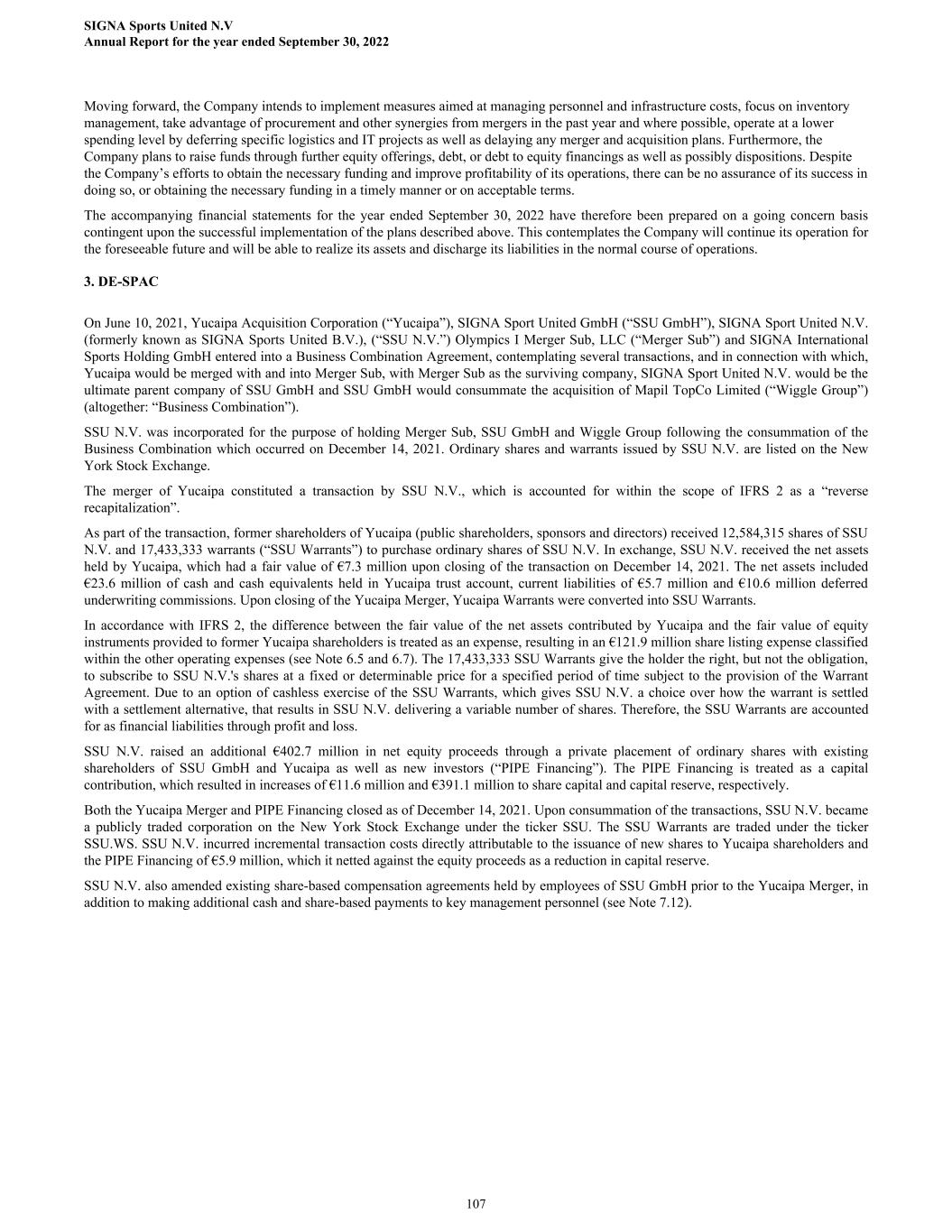
Moving forward, the Company intends to implement measures aimed at managing personnel and infrastructure costs, focus on inventory management, take advantage of procurement and other synergies from mergers in the past year and where possible, operate at a lower spending level by deferring specific logistics and IT projects as well as delaying any merger and acquisition plans. Furthermore, the Company plans to raise funds through further equity offerings, debt, or debt to equity financings as well as possibly dispositions. Despite the Company’s efforts to obtain the necessary funding and improve profitability of its operations, there can be no assurance of its success in doing so, or obtaining the necessary funding in a timely manner or on acceptable terms. The accompanying financial statements for the year ended September 30, 2022 have therefore been prepared on a going concern basis contingent upon the successful implementation of the plans described above. This contemplates the Company will continue its operation for the foreseeable future and will be able to realize its assets and discharge its liabilities in the normal course of operations. 3. DE-SPAC On June 10, 2021, Yucaipa Acquisition Corporation (“Yucaipa”), SIGNA Sport United GmbH (“SSU GmbH”), SIGNA Sport United N.V. (formerly known as SIGNA Sports United B.V.), (“SSU N.V.”) Olympics I Merger Sub, LLC (“Merger Sub”) and SIGNA International Sports Holding GmbH entered into a Business Combination Agreement, contemplating several transactions, and in connection with which, Yucaipa would be merged with and into Merger Sub, with Merger Sub as the surviving company, SIGNA Sport United N.V. would be the ultimate parent company of SSU GmbH and SSU GmbH would consummate the acquisition of Mapil TopCo Limited (“Wiggle Group”) (altogether: “Business Combination”). SSU N.V. was incorporated for the purpose of holding Merger Sub, SSU GmbH and Wiggle Group following the consummation of the Business Combination which occurred on December 14, 2021. Ordinary shares and warrants issued by SSU N.V. are listed on the New York Stock Exchange. The merger of Yucaipa constituted a transaction by SSU N.V., which is accounted for within the scope of IFRS 2 as a “reverse recapitalization”. As part of the transaction, former shareholders of Yucaipa (public shareholders, sponsors and directors) received 12,584,315 shares of SSU N.V. and 17,433,333 warrants (“SSU Warrants”) to purchase ordinary shares of SSU N.V. In exchange, SSU N.V. received the net assets held by Yucaipa, which had a fair value of €7.3 million upon closing of the transaction on December 14, 2021. The net assets included €23.6 million of cash and cash equivalents held in Yucaipa trust account, current liabilities of €5.7 million and €10.6 million deferred underwriting commissions. Upon closing of the Yucaipa Merger, Yucaipa Warrants were converted into SSU Warrants. In accordance with IFRS 2, the difference between the fair value of the net assets contributed by Yucaipa and the fair value of equity instruments provided to former Yucaipa shareholders is treated as an expense, resulting in an €121.9 million share listing expense classified within the other operating expenses (see Note 6.5 and 6.7). The 17,433,333 SSU Warrants give the holder the right, but not the obligation, to subscribe to SSU N.V.'s shares at a fixed or determinable price for a specified period of time subject to the provision of the Warrant Agreement. Due to an option of cashless exercise of the SSU Warrants, which gives SSU N.V. a choice over how the warrant is settled with a settlement alternative, that results in SSU N.V. delivering a variable number of shares. Therefore, the SSU Warrants are accounted for as financial liabilities through profit and loss. SSU N.V. raised an additional €402.7 million in net equity proceeds through a private placement of ordinary shares with existing shareholders of SSU GmbH and Yucaipa as well as new investors (“PIPE Financing”). The PIPE Financing is treated as a capital contribution, which resulted in increases of €11.6 million and €391.1 million to share capital and capital reserve, respectively. Both the Yucaipa Merger and PIPE Financing closed as of December 14, 2021. Upon consummation of the transactions, SSU N.V. became a publicly traded corporation on the New York Stock Exchange under the ticker SSU. The SSU Warrants are traded under the ticker SSU.WS. SSU N.V. incurred incremental transaction costs directly attributable to the issuance of new shares to Yucaipa shareholders and the PIPE Financing of €5.9 million, which it netted against the equity proceeds as a reduction in capital reserve. SSU N.V. also amended existing share-based compensation agreements held by employees of SSU GmbH prior to the Yucaipa Merger, in addition to making additional cash and share-based payments to key management personnel (see Note 7.12). SIGNA Sports United N.V Annual Report for the year ended September 30, 2022 107
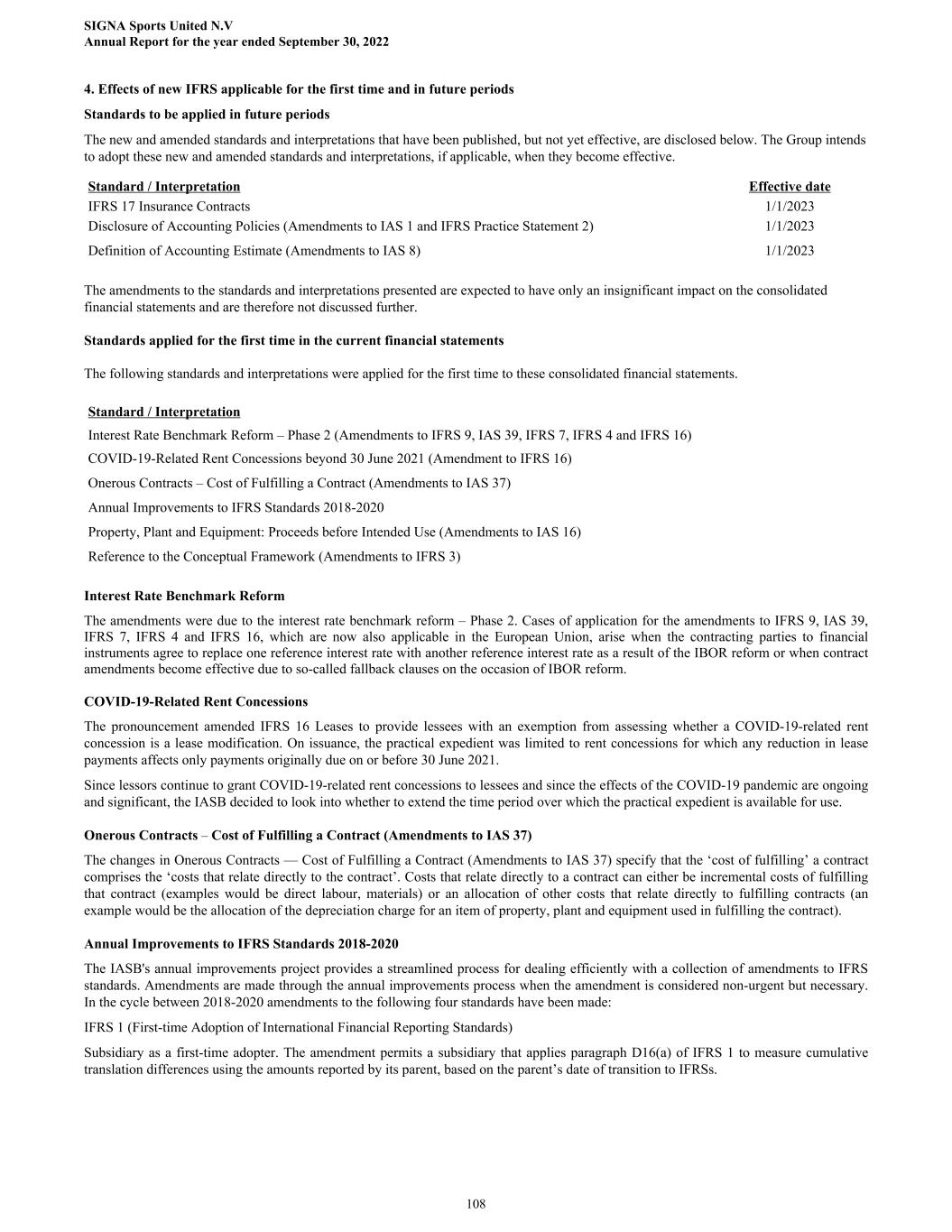
4. Effects of new IFRS applicable for the first time and in future periods Standards to be applied in future periods The new and amended standards and interpretations that have been published, but not yet effective, are disclosed below. The Group intends to adopt these new and amended standards and interpretations, if applicable, when they become effective. Standard / Interpretation Effective date IFRS 17 Insurance Contracts 1/1/2023 Disclosure of Accounting Policies (Amendments to IAS 1 and IFRS Practice Statement 2) 1/1/2023 Definition of Accounting Estimate (Amendments to IAS 8) 1/1/2023 The amendments to the standards and interpretations presented are expected to have only an insignificant impact on the consolidated financial statements and are therefore not discussed further. Standards applied for the first time in the current financial statements The following standards and interpretations were applied for the first time to these consolidated financial statements. Standard / Interpretation Interest Rate Benchmark Reform – Phase 2 (Amendments to IFRS 9, IAS 39, IFRS 7, IFRS 4 and IFRS 16) COVID-19-Related Rent Concessions beyond 30 June 2021 (Amendment to IFRS 16) Onerous Contracts – Cost of Fulfilling a Contract (Amendments to IAS 37) Annual Improvements to IFRS Standards 2018-2020 Property, Plant and Equipment: Proceeds before Intended Use (Amendments to IAS 16) Reference to the Conceptual Framework (Amendments to IFRS 3) Interest Rate Benchmark Reform The amendments were due to the interest rate benchmark reform – Phase 2. Cases of application for the amendments to IFRS 9, IAS 39, IFRS 7, IFRS 4 and IFRS 16, which are now also applicable in the European Union, arise when the contracting parties to financial instruments agree to replace one reference interest rate with another reference interest rate as a result of the IBOR reform or when contract amendments become effective due to so-called fallback clauses on the occasion of IBOR reform. COVID-19-Related Rent Concessions The pronouncement amended IFRS 16 Leases to provide lessees with an exemption from assessing whether a COVID-19-related rent concession is a lease modification. On issuance, the practical expedient was limited to rent concessions for which any reduction in lease payments affects only payments originally due on or before 30 June 2021. Since lessors continue to grant COVID-19-related rent concessions to lessees and since the effects of the COVID-19 pandemic are ongoing and significant, the IASB decided to look into whether to extend the time period over which the practical expedient is available for use. Onerous Contracts – Cost of Fulfilling a Contract (Amendments to IAS 37) The changes in Onerous Contracts — Cost of Fulfilling a Contract (Amendments to IAS 37) specify that the ‘cost of fulfilling’ a contract comprises the ‘costs that relate directly to the contract’. Costs that relate directly to a contract can either be incremental costs of fulfilling that contract (examples would be direct labour, materials) or an allocation of other costs that relate directly to fulfilling contracts (an example would be the allocation of the depreciation charge for an item of property, plant and equipment used in fulfilling the contract). Annual Improvements to IFRS Standards 2018-2020 The IASB's annual improvements project provides a streamlined process for dealing efficiently with a collection of amendments to IFRS standards. Amendments are made through the annual improvements process when the amendment is considered non-urgent but necessary. In the cycle between 2018-2020 amendments to the following four standards have been made: IFRS 1 (First-time Adoption of International Financial Reporting Standards) Subsidiary as a first-time adopter. The amendment permits a subsidiary that applies paragraph D16(a) of IFRS 1 to measure cumulative translation differences using the amounts reported by its parent, based on the parent’s date of transition to IFRSs. SIGNA Sports United N.V Annual Report for the year ended September 30, 2022 108
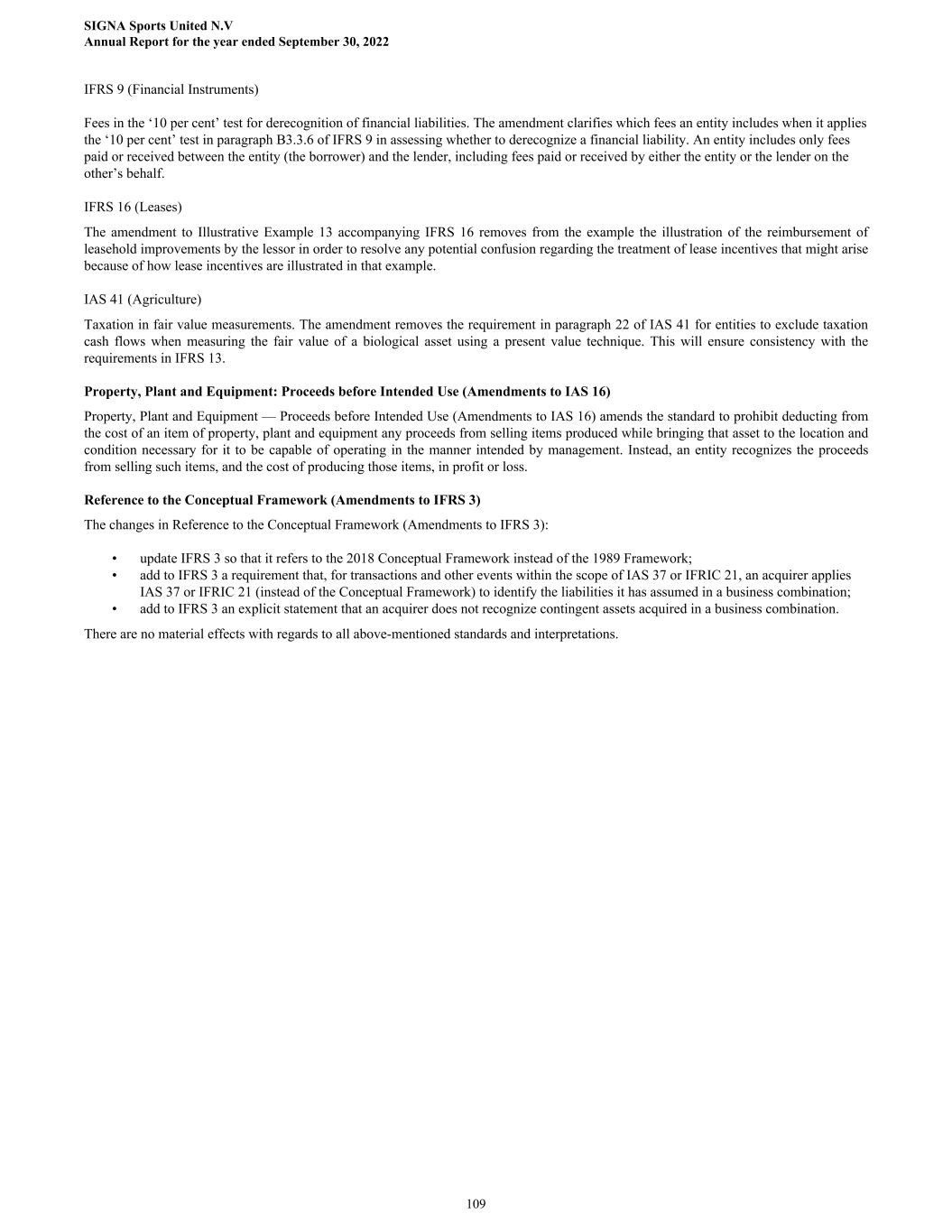
IFRS 9 (Financial Instruments) Fees in the ‘10 per cent’ test for derecognition of financial liabilities. The amendment clarifies which fees an entity includes when it applies the ‘10 per cent’ test in paragraph B3.3.6 of IFRS 9 in assessing whether to derecognize a financial liability. An entity includes only fees paid or received between the entity (the borrower) and the lender, including fees paid or received by either the entity or the lender on the other’s behalf. IFRS 16 (Leases) The amendment to Illustrative Example 13 accompanying IFRS 16 removes from the example the illustration of the reimbursement of leasehold improvements by the lessor in order to resolve any potential confusion regarding the treatment of lease incentives that might arise because of how lease incentives are illustrated in that example. IAS 41 (Agriculture) Taxation in fair value measurements. The amendment removes the requirement in paragraph 22 of IAS 41 for entities to exclude taxation cash flows when measuring the fair value of a biological asset using a present value technique. This will ensure consistency with the requirements in IFRS 13. Property, Plant and Equipment: Proceeds before Intended Use (Amendments to IAS 16) Property, Plant and Equipment — Proceeds before Intended Use (Amendments to IAS 16) amends the standard to prohibit deducting from the cost of an item of property, plant and equipment any proceeds from selling items produced while bringing that asset to the location and condition necessary for it to be capable of operating in the manner intended by management. Instead, an entity recognizes the proceeds from selling such items, and the cost of producing those items, in profit or loss. Reference to the Conceptual Framework (Amendments to IFRS 3) The changes in Reference to the Conceptual Framework (Amendments to IFRS 3): • update IFRS 3 so that it refers to the 2018 Conceptual Framework instead of the 1989 Framework; • add to IFRS 3 a requirement that, for transactions and other events within the scope of IAS 37 or IFRIC 21, an acquirer applies IAS 37 or IFRIC 21 (instead of the Conceptual Framework) to identify the liabilities it has assumed in a business combination; • add to IFRS 3 an explicit statement that an acquirer does not recognize contingent assets acquired in a business combination. There are no material effects with regards to all above-mentioned standards and interpretations. SIGNA Sports United N.V Annual Report for the year ended September 30, 2022 109
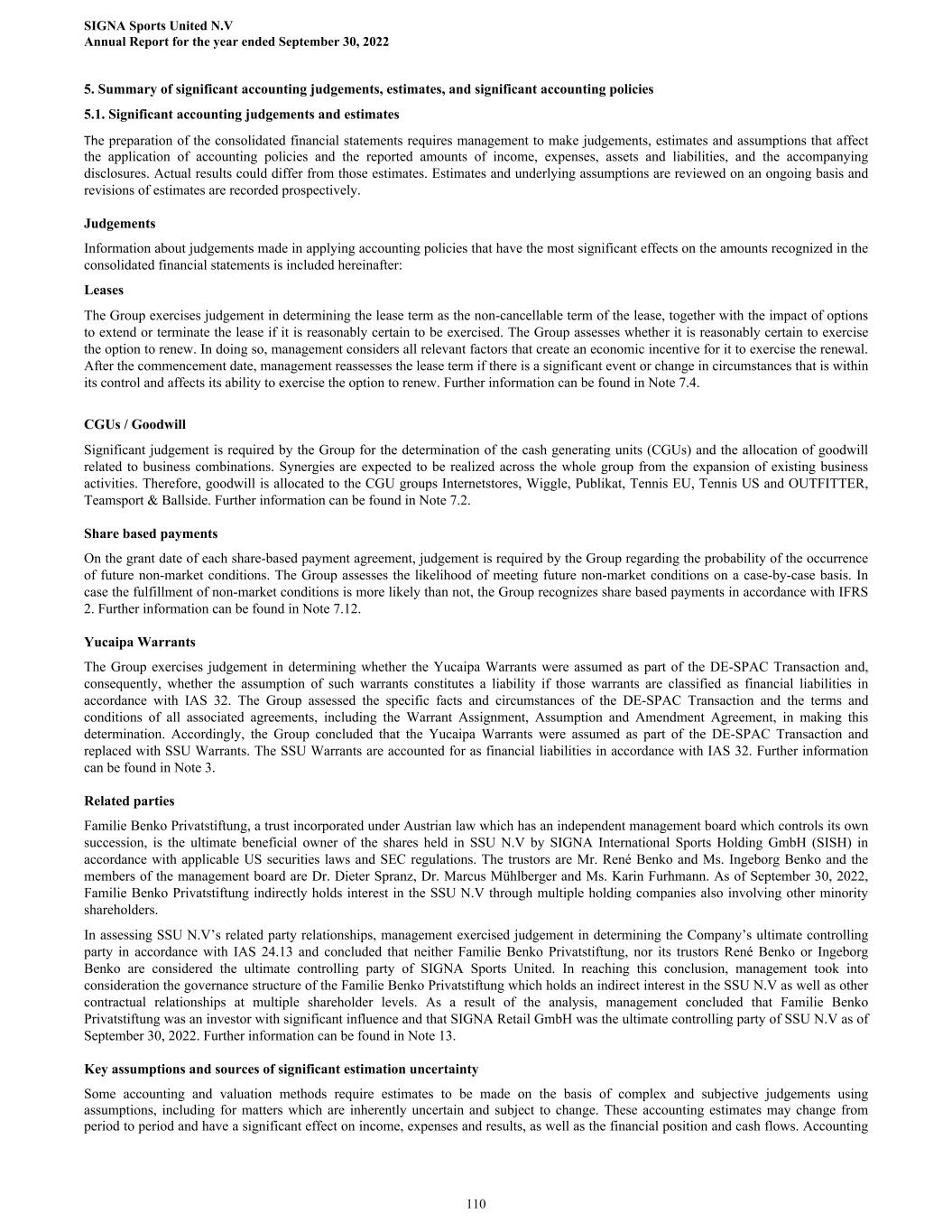
5. Summary of significant accounting judgements, estimates, and significant accounting policies 5.1. Significant accounting judgements and estimates The preparation of the consolidated financial statements requires management to make judgements, estimates and assumptions that affect the application of accounting policies and the reported amounts of income, expenses, assets and liabilities, and the accompanying disclosures. Actual results could differ from those estimates. Estimates and underlying assumptions are reviewed on an ongoing basis and revisions of estimates are recorded prospectively. Judgements Information about judgements made in applying accounting policies that have the most significant effects on the amounts recognized in the consolidated financial statements is included hereinafter: Leases The Group exercises judgement in determining the lease term as the non-cancellable term of the lease, together with the impact of options to extend or terminate the lease if it is reasonably certain to be exercised. The Group assesses whether it is reasonably certain to exercise the option to renew. In doing so, management considers all relevant factors that create an economic incentive for it to exercise the renewal. After the commencement date, management reassesses the lease term if there is a significant event or change in circumstances that is within its control and affects its ability to exercise the option to renew. Further information can be found in Note 7.4. CGUs / Goodwill Significant judgement is required by the Group for the determination of the cash generating units (CGUs) and the allocation of goodwill related to business combinations. Synergies are expected to be realized across the whole group from the expansion of existing business activities. Therefore, goodwill is allocated to the CGU groups Internetstores, Wiggle, Publikat, Tennis EU, Tennis US and OUTFITTER, Teamsport & Ballside. Further information can be found in Note 7.2. Share based payments On the grant date of each share-based payment agreement, judgement is required by the Group regarding the probability of the occurrence of future non-market conditions. The Group assesses the likelihood of meeting future non-market conditions on a case-by-case basis. In case the fulfillment of non-market conditions is more likely than not, the Group recognizes share based payments in accordance with IFRS 2. Further information can be found in Note 7.12. Yucaipa Warrants The Group exercises judgement in determining whether the Yucaipa Warrants were assumed as part of the DE-SPAC Transaction and, consequently, whether the assumption of such warrants constitutes a liability if those warrants are classified as financial liabilities in accordance with IAS 32. The Group assessed the specific facts and circumstances of the DE-SPAC Transaction and the terms and conditions of all associated agreements, including the Warrant Assignment, Assumption and Amendment Agreement, in making this determination. Accordingly, the Group concluded that the Yucaipa Warrants were assumed as part of the DE-SPAC Transaction and replaced with SSU Warrants. The SSU Warrants are accounted for as financial liabilities in accordance with IAS 32. Further information can be found in Note 3. Related parties Familie Benko Privatstiftung, a trust incorporated under Austrian law which has an independent management board which controls its own succession, is the ultimate beneficial owner of the shares held in SSU N.V by SIGNA International Sports Holding GmbH (SISH) in accordance with applicable US securities laws and SEC regulations. The trustors are Mr. René Benko and Ms. Ingeborg Benko and the members of the management board are Dr. Dieter Spranz, Dr. Marcus Mühlberger and Ms. Karin Furhmann. As of September 30, 2022, Familie Benko Privatstiftung indirectly holds interest in the SSU N.V through multiple holding companies also involving other minority shareholders. In assessing SSU N.V’s related party relationships, management exercised judgement in determining the Company’s ultimate controlling party in accordance with IAS 24.13 and concluded that neither Familie Benko Privatstiftung, nor its trustors René Benko or Ingeborg Benko are considered the ultimate controlling party of SIGNA Sports United. In reaching this conclusion, management took into consideration the governance structure of the Familie Benko Privatstiftung which holds an indirect interest in the SSU N.V as well as other contractual relationships at multiple shareholder levels. As a result of the analysis, management concluded that Familie Benko Privatstiftung was an investor with significant influence and that SIGNA Retail GmbH was the ultimate controlling party of SSU N.V as of September 30, 2022. Further information can be found in Note 13. Key assumptions and sources of significant estimation uncertainty Some accounting and valuation methods require estimates to be made on the basis of complex and subjective judgements using assumptions, including for matters which are inherently uncertain and subject to change. These accounting estimates may change from period to period and have a significant effect on income, expenses and results, as well as the financial position and cash flows. Accounting SIGNA Sports United N.V Annual Report for the year ended September 30, 2022 110
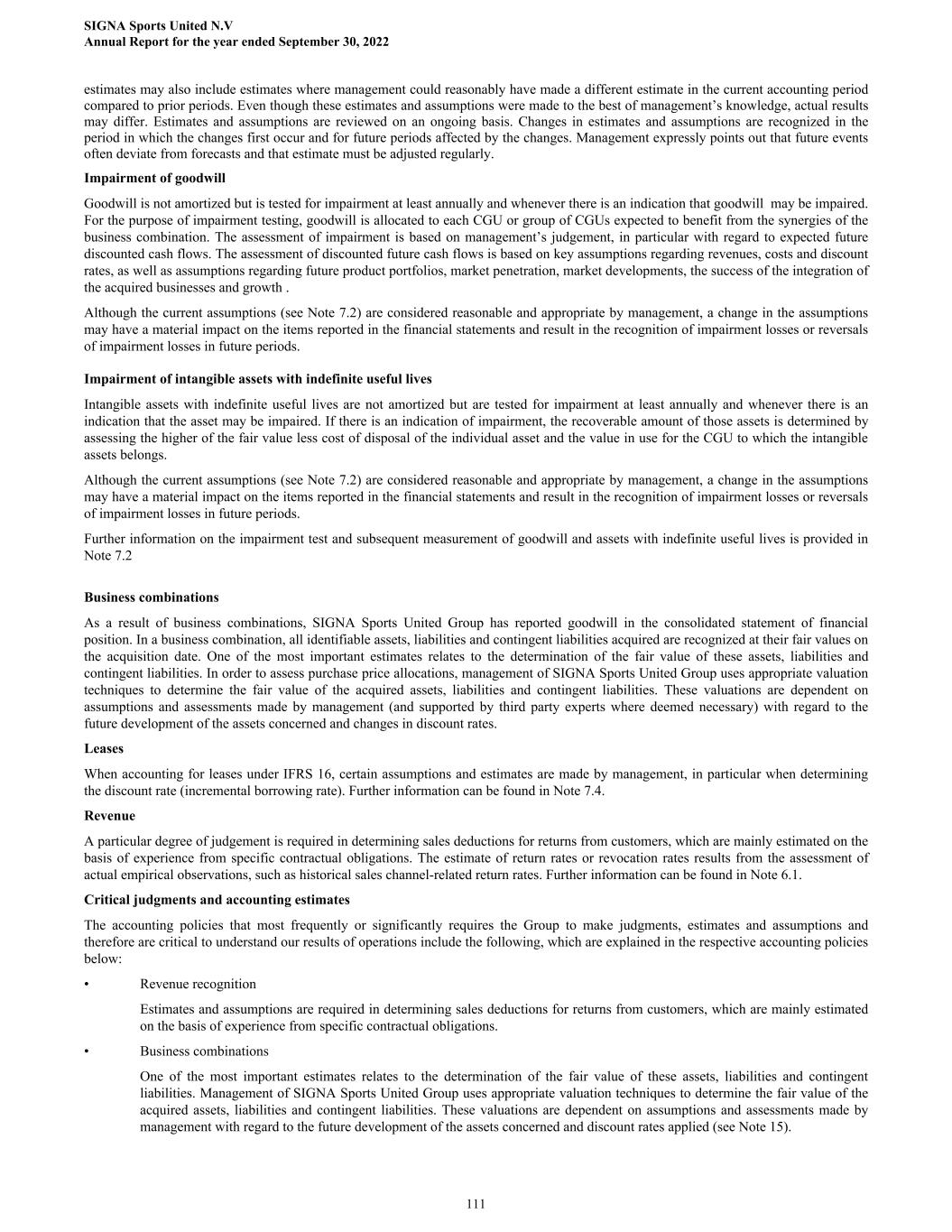
estimates may also include estimates where management could reasonably have made a different estimate in the current accounting period compared to prior periods. Even though these estimates and assumptions were made to the best of management’s knowledge, actual results may differ. Estimates and assumptions are reviewed on an ongoing basis. Changes in estimates and assumptions are recognized in the period in which the changes first occur and for future periods affected by the changes. Management expressly points out that future events often deviate from forecasts and that estimate must be adjusted regularly. Impairment of goodwill Goodwill is not amortized but is tested for impairment at least annually and whenever there is an indication that goodwill may be impaired. For the purpose of impairment testing, goodwill is allocated to each CGU or group of CGUs expected to benefit from the synergies of the business combination. The assessment of impairment is based on management’s judgement, in particular with regard to expected future discounted cash flows. The assessment of discounted future cash flows is based on key assumptions regarding revenues, costs and discount rates, as well as assumptions regarding future product portfolios, market penetration, market developments, the success of the integration of the acquired businesses and growth . Although the current assumptions (see Note 7.2) are considered reasonable and appropriate by management, a change in the assumptions may have a material impact on the items reported in the financial statements and result in the recognition of impairment losses or reversals of impairment losses in future periods. Impairment of intangible assets with indefinite useful lives Intangible assets with indefinite useful lives are not amortized but are tested for impairment at least annually and whenever there is an indication that the asset may be impaired. If there is an indication of impairment, the recoverable amount of those assets is determined by assessing the higher of the fair value less cost of disposal of the individual asset and the value in use for the CGU to which the intangible assets belongs. Although the current assumptions (see Note 7.2) are considered reasonable and appropriate by management, a change in the assumptions may have a material impact on the items reported in the financial statements and result in the recognition of impairment losses or reversals of impairment losses in future periods. Further information on the impairment test and subsequent measurement of goodwill and assets with indefinite useful lives is provided in Note 7.2 Business combinations As a result of business combinations, SIGNA Sports United Group has reported goodwill in the consolidated statement of financial position. In a business combination, all identifiable assets, liabilities and contingent liabilities acquired are recognized at their fair values on the acquisition date. One of the most important estimates relates to the determination of the fair value of these assets, liabilities and contingent liabilities. In order to assess purchase price allocations, management of SIGNA Sports United Group uses appropriate valuation techniques to determine the fair value of the acquired assets, liabilities and contingent liabilities. These valuations are dependent on assumptions and assessments made by management (and supported by third party experts where deemed necessary) with regard to the future development of the assets concerned and changes in discount rates. Leases When accounting for leases under IFRS 16, certain assumptions and estimates are made by management, in particular when determining the discount rate (incremental borrowing rate). Further information can be found in Note 7.4. Revenue A particular degree of judgement is required in determining sales deductions for returns from customers, which are mainly estimated on the basis of experience from specific contractual obligations. The estimate of return rates or revocation rates results from the assessment of actual empirical observations, such as historical sales channel-related return rates. Further information can be found in Note 6.1. Critical judgments and accounting estimates The accounting policies that most frequently or significantly requires the Group to make judgments, estimates and assumptions and therefore are critical to understand our results of operations include the following, which are explained in the respective accounting policies below: • Revenue recognition Estimates and assumptions are required in determining sales deductions for returns from customers, which are mainly estimated on the basis of experience from specific contractual obligations. • Business combinations One of the most important estimates relates to the determination of the fair value of these assets, liabilities and contingent liabilities. Management of SIGNA Sports United Group uses appropriate valuation techniques to determine the fair value of the acquired assets, liabilities and contingent liabilities. These valuations are dependent on assumptions and assessments made by management with regard to the future development of the assets concerned and discount rates applied (see Note 15). SIGNA Sports United N.V Annual Report for the year ended September 30, 2022 111
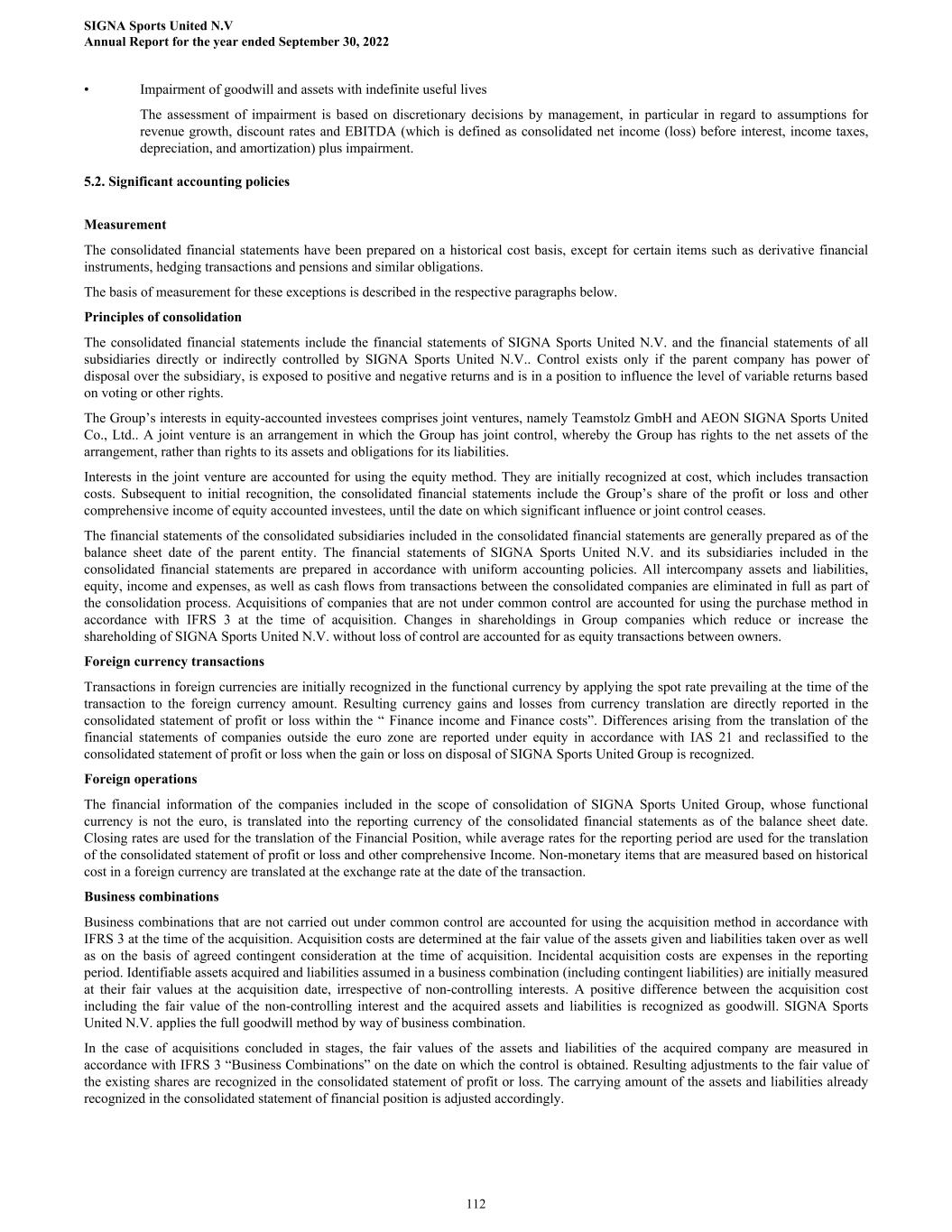
• Impairment of goodwill and assets with indefinite useful lives The assessment of impairment is based on discretionary decisions by management, in particular in regard to assumptions for revenue growth, discount rates and EBITDA (which is defined as consolidated net income (loss) before interest, income taxes, depreciation, and amortization) plus impairment. 5.2. Significant accounting policies Measurement The consolidated financial statements have been prepared on a historical cost basis, except for certain items such as derivative financial instruments, hedging transactions and pensions and similar obligations. The basis of measurement for these exceptions is described in the respective paragraphs below. Principles of consolidation The consolidated financial statements include the financial statements of SIGNA Sports United N.V. and the financial statements of all subsidiaries directly or indirectly controlled by SIGNA Sports United N.V.. Control exists only if the parent company has power of disposal over the subsidiary, is exposed to positive and negative returns and is in a position to influence the level of variable returns based on voting or other rights. The Group’s interests in equity-accounted investees comprises joint ventures, namely Teamstolz GmbH and AEON SIGNA Sports United Co., Ltd.. A joint venture is an arrangement in which the Group has joint control, whereby the Group has rights to the net assets of the arrangement, rather than rights to its assets and obligations for its liabilities. Interests in the joint venture are accounted for using the equity method. They are initially recognized at cost, which includes transaction costs. Subsequent to initial recognition, the consolidated financial statements include the Group’s share of the profit or loss and other comprehensive income of equity accounted investees, until the date on which significant influence or joint control ceases. The financial statements of the consolidated subsidiaries included in the consolidated financial statements are generally prepared as of the balance sheet date of the parent entity. The financial statements of SIGNA Sports United N.V. and its subsidiaries included in the consolidated financial statements are prepared in accordance with uniform accounting policies. All intercompany assets and liabilities, equity, income and expenses, as well as cash flows from transactions between the consolidated companies are eliminated in full as part of the consolidation process. Acquisitions of companies that are not under common control are accounted for using the purchase method in accordance with IFRS 3 at the time of acquisition. Changes in shareholdings in Group companies which reduce or increase the shareholding of SIGNA Sports United N.V. without loss of control are accounted for as equity transactions between owners. Foreign currency transactions Transactions in foreign currencies are initially recognized in the functional currency by applying the spot rate prevailing at the time of the transaction to the foreign currency amount. Resulting currency gains and losses from currency translation are directly reported in the consolidated statement of profit or loss within the “ Finance income and Finance costs”. Differences arising from the translation of the financial statements of companies outside the euro zone are reported under equity in accordance with IAS 21 and reclassified to the consolidated statement of profit or loss when the gain or loss on disposal of SIGNA Sports United Group is recognized. Foreign operations The financial information of the companies included in the scope of consolidation of SIGNA Sports United Group, whose functional currency is not the euro, is translated into the reporting currency of the consolidated financial statements as of the balance sheet date. Closing rates are used for the translation of the Financial Position, while average rates for the reporting period are used for the translation of the consolidated statement of profit or loss and other comprehensive Income. Non-monetary items that are measured based on historical cost in a foreign currency are translated at the exchange rate at the date of the transaction. Business combinations Business combinations that are not carried out under common control are accounted for using the acquisition method in accordance with IFRS 3 at the time of the acquisition. Acquisition costs are determined at the fair value of the assets given and liabilities taken over as well as on the basis of agreed contingent consideration at the time of acquisition. Incidental acquisition costs are expenses in the reporting period. Identifiable assets acquired and liabilities assumed in a business combination (including contingent liabilities) are initially measured at their fair values at the acquisition date, irrespective of non-controlling interests. A positive difference between the acquisition cost including the fair value of the non-controlling interest and the acquired assets and liabilities is recognized as goodwill. SIGNA Sports United N.V. applies the full goodwill method by way of business combination. In the case of acquisitions concluded in stages, the fair values of the assets and liabilities of the acquired company are measured in accordance with IFRS 3 “Business Combinations” on the date on which the control is obtained. Resulting adjustments to the fair value of the existing shares are recognized in the consolidated statement of profit or loss. The carrying amount of the assets and liabilities already recognized in the consolidated statement of financial position is adjusted accordingly. SIGNA Sports United N.V Annual Report for the year ended September 30, 2022 112

The application of the acquisition method requires certain estimates and assumptions, especially with regard to the fair values of the acquired intangible assets, property, plant and equipment and liabilities assumed at the time of acquisition, as well as the useful lives of the acquired intangible assets and property, plant and equipment. The valuation is primarily based on expected cash flows. If the actual cash flows differ from those used in the calculation of fair values, this may have a material impact on future operating results. The valuations are based on the information available at the time of acquisition. The valuation of the indefinite life intangible assets is based on the relief from royalty method at the time of the acquisition. Discontinued operations A discontinued operation is a component of an entity that either has been disposed of, or that is classified as held for sale. It must either: represent a major separate line of business or geographical area of operations; be part of a single coordinated disposal plan; or be a subsidiary acquired exclusively with a view to resale. Intercompany transactions between continuing and discontinued operations are eliminated against continuing operations. Non-current assets and disposal groups are not classified as assets held for sale if their carrying amount is to be recovered through continuing use. In 2022, the Group decided to end its Stylefile business activities during the fourth quarter of 2022. The Group assessed that ending the activities of Stylefile within Publikat would qualify as a discontinued operation. Therefore, the profit or loss related to the Stylefile business is presented in a separate line item of the consolidated profit and loss section of the statements of profit or loss and other comprehensive income and consolidated statements of cash flow for the year ended September 30, 2022, 2021 and 2020. The segment reporting note and notes to the consolidated financial statements for the years ended September 30, 2022, 2021 and 2020 mainly represent continuing operations. On November 21, 2022, the Group entered into an ‘Asset Sale and Purchase Agreement - ASPA’ to sell specific assets (mainly inventories, trademarks/domains and customer relationships) from its discontinued Stylefile business. The expected closing date of this agreement is July 31, 2023. For the period from November 1, 2022, until the closing date July 31, 2023, a ‘Transitional Service Agreement - TSA’ has been signed with the purchaser. According to the TSA, Publikat will resume the operations of Stylefile on behalf of the buyer until the transaction is finalized on the expected closing date of July 31, 2023. Accordingly, the Group no longer bears the economic risk or the profits/losses from the sales activities for Stylefile as of November 1, 2022. Goodwill and assets with indefinite useful lives Groups of CGUs to which goodwill has been allocated are tested for impairment annually, or more frequently when there is an indication that the unit may be impaired. If the recoverable amount of the CGU or group of CGU is less than the carrying amount of the unit, the impairment loss is allocated first to reduce the carrying amount of any goodwill allocated to the unit and then to the other assets of the unit pro-rata on the basis of the carrying amount of each asset in the unit. An impairment loss recognized for goodwill is not reversed in a subsequent period. Intangible assets with an indefinite useful life are tested for impairment at least annually and whenever there is an indication that the asset may be impaired. If there is an indication of impairment, the recoverable amount is determined for the CGU to which the intangible asset belongs. If the recoverable amount of the CGU is less than the carrying amount of the unit, the impairment loss is allocated first to reduce the carrying amount of any intangible assets with an indefinite useful life allocated to the unit and then to the other assets of the unit pro- rata on the basis of the carrying amount of each asset in the unit or whichever method reflects best the impairment. If an indication arises that the reasons for impairment no longer exist, a review is carried out to determine whether a reversal of the impairment loss is required in whole or in part. Therefore, the carrying amount is written up to the recoverable amount, but not higher than the amortized cost of the asset, as if no impairment had taken place. Further information can be found in Note 7.2. Goodwill and assets with indefinite useful lives are measured at cost less accumulated impairment losses. Intangible assets Acquired intangible assets are initially measured at cost, whereas intangible assets acquired in a business combination are measured at fair value. After initial recognition, intangible assets are accounted for using the cost model. Amortization of intangible assets with finite useful lives is calculated using the straight-line method. The estimated useful life and the amortization method are reviewed annually at the end of the reporting period and any changes in the useful life are accounted for prospectively. Amortization of intangible assets is recognized in the consolidated statement of profit or loss. For further information on intangible assets, please see Note 7.1. Besides scheduled amortization, an impairment test is performed if relevant events or changes in circumstances indicate that intangible assets may be impaired. If the carrying amount of an intangible asset exceeds its recoverable amount, the intangible asset is impaired. An impairment loss is recognized in the amount by which the carrying amount exceeds the recoverable amount. Assets are grouped at the lowest levels for which there are separately identifiable cash inflows which are largely independent of the cash inflows from other assets or groups of assets (CGUs). If the reasons for impairment no longer exist, the impairment loss is reversed up to the amortized cost of the intangible asset. SIGNA Sports United N.V Annual Report for the year ended September 30, 2022 113
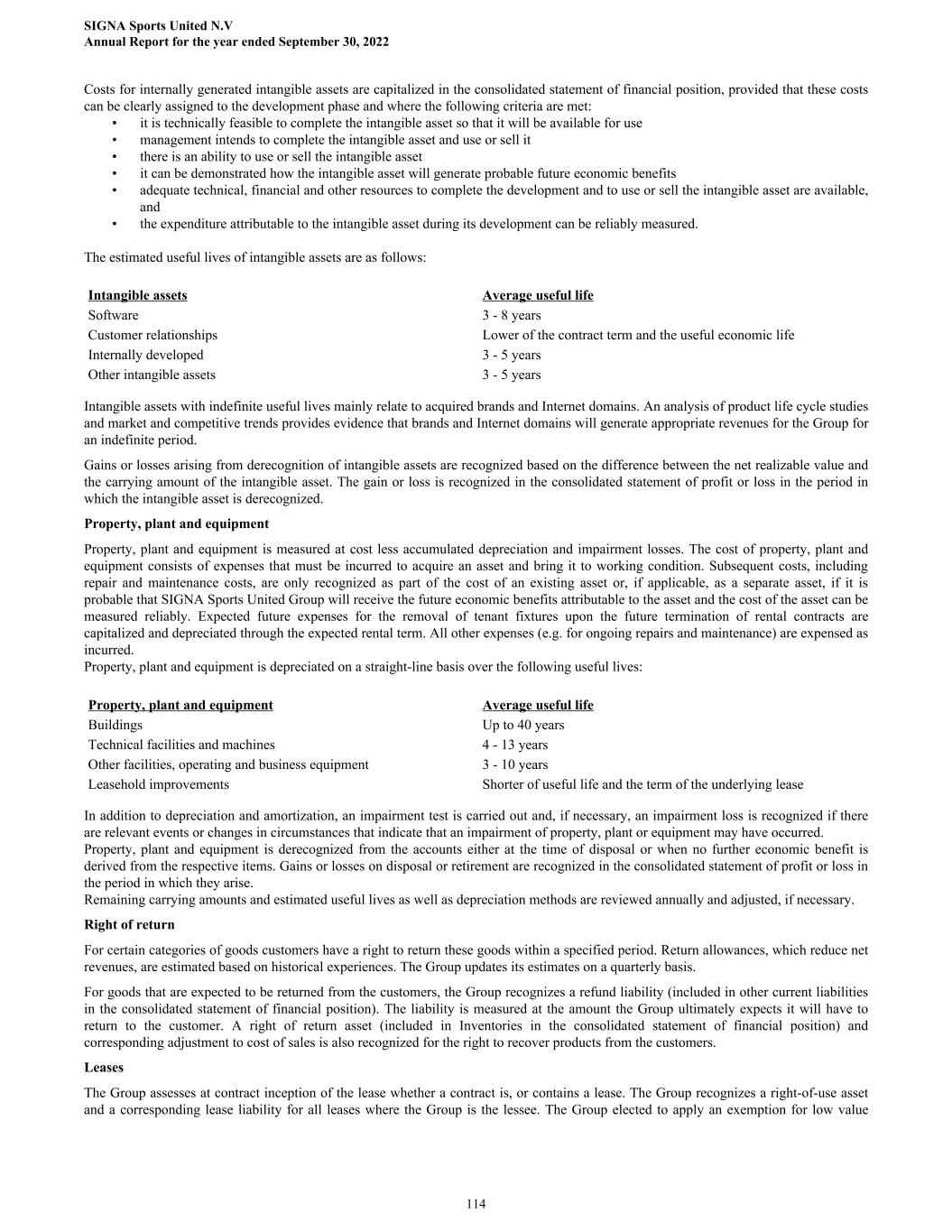
Costs for internally generated intangible assets are capitalized in the consolidated statement of financial position, provided that these costs can be clearly assigned to the development phase and where the following criteria are met: • it is technically feasible to complete the intangible asset so that it will be available for use • management intends to complete the intangible asset and use or sell it • there is an ability to use or sell the intangible asset • it can be demonstrated how the intangible asset will generate probable future economic benefits • adequate technical, financial and other resources to complete the development and to use or sell the intangible asset are available, and • the expenditure attributable to the intangible asset during its development can be reliably measured. The estimated useful lives of intangible assets are as follows: Intangible assets Average useful life Software 3 - 8 years Customer relationships Lower of the contract term and the useful economic life Internally developed 3 - 5 years Other intangible assets 3 - 5 years Intangible assets with indefinite useful lives mainly relate to acquired brands and Internet domains. An analysis of product life cycle studies and market and competitive trends provides evidence that brands and Internet domains will generate appropriate revenues for the Group for an indefinite period. Gains or losses arising from derecognition of intangible assets are recognized based on the difference between the net realizable value and the carrying amount of the intangible asset. The gain or loss is recognized in the consolidated statement of profit or loss in the period in which the intangible asset is derecognized. Property, plant and equipment Property, plant and equipment is measured at cost less accumulated depreciation and impairment losses. The cost of property, plant and equipment consists of expenses that must be incurred to acquire an asset and bring it to working condition. Subsequent costs, including repair and maintenance costs, are only recognized as part of the cost of an existing asset or, if applicable, as a separate asset, if it is probable that SIGNA Sports United Group will receive the future economic benefits attributable to the asset and the cost of the asset can be measured reliably. Expected future expenses for the removal of tenant fixtures upon the future termination of rental contracts are capitalized and depreciated through the expected rental term. All other expenses (e.g. for ongoing repairs and maintenance) are expensed as incurred. Property, plant and equipment is depreciated on a straight-line basis over the following useful lives: Property, plant and equipment Average useful life Buildings Up to 40 years Technical facilities and machines 4 - 13 years Other facilities, operating and business equipment 3 - 10 years Leasehold improvements Shorter of useful life and the term of the underlying lease In addition to depreciation and amortization, an impairment test is carried out and, if necessary, an impairment loss is recognized if there are relevant events or changes in circumstances that indicate that an impairment of property, plant or equipment may have occurred. Property, plant and equipment is derecognized from the accounts either at the time of disposal or when no further economic benefit is derived from the respective items. Gains or losses on disposal or retirement are recognized in the consolidated statement of profit or loss in the period in which they arise. Remaining carrying amounts and estimated useful lives as well as depreciation methods are reviewed annually and adjusted, if necessary. Right of return For certain categories of goods customers have a right to return these goods within a specified period. Return allowances, which reduce net revenues, are estimated based on historical experiences. The Group updates its estimates on a quarterly basis. For goods that are expected to be returned from the customers, the Group recognizes a refund liability (included in other current liabilities in the consolidated statement of financial position). The liability is measured at the amount the Group ultimately expects it will have to return to the customer. A right of return asset (included in Inventories in the consolidated statement of financial position) and corresponding adjustment to cost of sales is also recognized for the right to recover products from the customers. Leases The Group assesses at contract inception of the lease whether a contract is, or contains a lease. The Group recognizes a right-of-use asset and a corresponding lease liability for all leases where the Group is the lessee. The Group elected to apply an exemption for low value SIGNA Sports United N.V Annual Report for the year ended September 30, 2022 114

leases as well as short-term leases in accordance with IFRS 16. Lease payments associated with low value leases and short-term leases are expensed on a straight-line basis over the lease term. Accordingly, no right of use assets or lease liabilities are recognized. Upon initial recognition, the lease liability is measured at the present value of the lease payments not yet paid at the inception of the lease and is discounted on the basis of the interest rate underlying the lease. If this interest rate cannot be readily determined, the Group uses its incremental borrowing rate. The following lease payments are included in the measurement of the lease liability: • Fixed lease payments (including de facto fixed payments), less incentive payments to be received; • Variable lease payments based on an index or price, initially measured at the index or price at the inception of the lease; • Expected payments by the lessee due to residual value guarantees; • Exercise prices of purchase options if the lessee is reasonably certain that these will be exercised; and • Penalties for the premature termination of leases, if the term of the lease is based on the exercise of the right to terminate the lease. Subsequent measurement of the lease liability is made by increasing the carrying amount by the interest on the lease liability (using the effective interest method) and reducing the carrying amount by the lease payments made. In the following cases, the Group remeasures the lease liability and adjusts the corresponding right-of-use asset accordingly: • There has been a change in the lease term or there is a significant event or significant change in circumstances that results in a change in judgement with respect to the exercise of a purchase option. In this case, the lease liability is remeasured by discounting the adjusted lease payments at a revised discount rate. • The lease payments change due to index or exchange rate changes or due to a change in the expected payment to be made on the basis of a residual value guarantee. In these cases, the lease liability is remeasured by discounting the adjusted lease payments at an unchanged discount rate, unless the change in the lease payments is attributable to a change in a variable interest rate. In this case, an updated interest rate is to be applied. • A lease is amended and the amendment to the lease is not recognized as a separate lease. In this case, the lease liability is remeasured on the basis of the term of the amended lease by discounting the amended lease payments at an updated interest rate at the effective date of the amendment. Right-of-use assets are generally amortized over the term of the lease. However, if the useful life of the underlying asset is shorter than the term of the lease, the right-of-use asset shall be amortized over that period accordingly. This also applies in cases where a lease transfers ownership of the leased asset or where the Group deems the exercise of a purchase option agreed under the lease to be sufficiently certain and the exercise price is therefore already included in the cost of the right-of-use asset. Depreciation begins at the beginning of the lease. To assess the need for an impairment of a right-of-use asset, the Group applies IAS 36 and recognizes all impairment losses as described in the accounting policies for property, plant and equipment. Share-based Payment IFRS 2 “Share-based Payment” is applied in accounting for share-based payment schemes involving employees and other participants who render the respective services. In the case of equity-settled share-based payment, services are provided as consideration for equity instruments. The fair value of the services is determined at the grant date by reference to the fair value of the equity instruments. The fair value is recognized over the vesting period as personnel expenses with a corresponding increase in equity. The fair value of equity instruments is determined using valuation models such as the Black-Scholes formula or a Monte Carlo model. In the case of cash-settled shared-based payments a liability is recognized for the fair value of the cash-settled transaction. Fair value A number of accounting policies and disclosures of SIGNA Sports United Group require the measurement of fair values for both financial and non-financial assets and liabilities. The valuation of assets and liabilities at fair value is based on the three-level “fair value hierarchy” or “level hierarchy” in accordance with IFRS 13 and the proximity of the valuation factors used to an active market. An active market is a market in which homogeneous products are traded, in which interested buyers and sellers can be found at any time and in which prices are publicly available. On the basis of the three-level measurement hierarchy, certain assumptions and estimates of management were used, in particular with regard to assets and liabilities at fair value, which were classified to Levels 2 and 3: Level 1: Quoted prices (unadjusted) in active markets for identical assets and liabilities. Level 2: Quoted prices other than those included in Level 1 that are observable, directly or indirectly, for the asset or liability. The fair value of Level 2 financial instruments is determined on the basis of the conditions prevailing at the end of the reporting period, such as interest rates or exchange rates, and using recognized models such as discounted cash flow or option pricing models. Level 3: Inputs for the asset or liability that are not based on observable market data (unobservable inputs). The fair value of Level 3 financial instruments was determined by reference to individual default expectations; these are based to a large extent on the Group’s assumptions regarding the creditworthiness of the counterparty. SIGNA Sports United N.V Annual Report for the year ended September 30, 2022 115
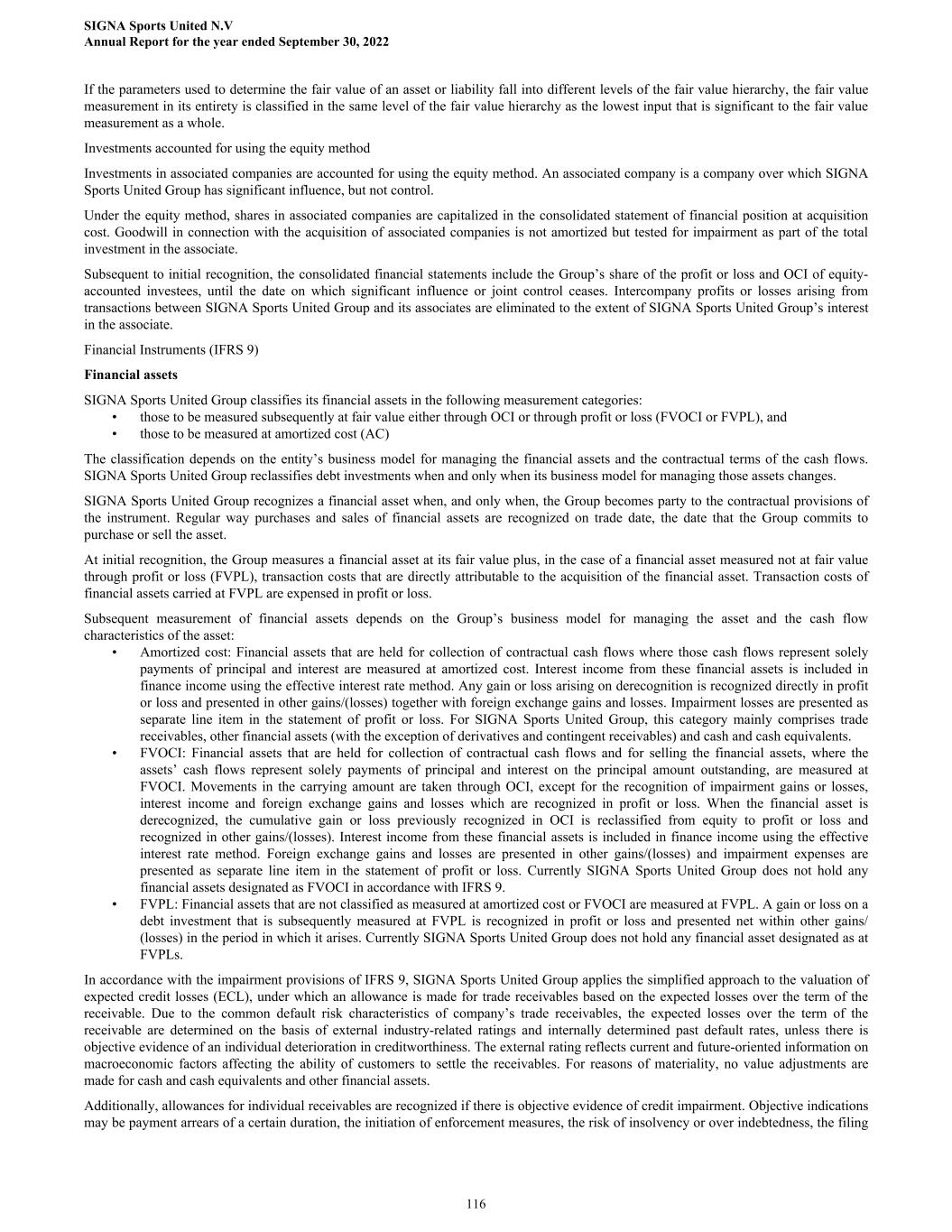
If the parameters used to determine the fair value of an asset or liability fall into different levels of the fair value hierarchy, the fair value measurement in its entirety is classified in the same level of the fair value hierarchy as the lowest input that is significant to the fair value measurement as a whole. Investments accounted for using the equity method Investments in associated companies are accounted for using the equity method. An associated company is a company over which SIGNA Sports United Group has significant influence, but not control. Under the equity method, shares in associated companies are capitalized in the consolidated statement of financial position at acquisition cost. Goodwill in connection with the acquisition of associated companies is not amortized but tested for impairment as part of the total investment in the associate. Subsequent to initial recognition, the consolidated financial statements include the Group’s share of the profit or loss and OCI of equity- accounted investees, until the date on which significant influence or joint control ceases. Intercompany profits or losses arising from transactions between SIGNA Sports United Group and its associates are eliminated to the extent of SIGNA Sports United Group’s interest in the associate. Financial Instruments (IFRS 9) Financial assets SIGNA Sports United Group classifies its financial assets in the following measurement categories: • those to be measured subsequently at fair value either through OCI or through profit or loss (FVOCI or FVPL), and • those to be measured at amortized cost (AC) The classification depends on the entity’s business model for managing the financial assets and the contractual terms of the cash flows. SIGNA Sports United Group reclassifies debt investments when and only when its business model for managing those assets changes. SIGNA Sports United Group recognizes a financial asset when, and only when, the Group becomes party to the contractual provisions of the instrument. Regular way purchases and sales of financial assets are recognized on trade date, the date that the Group commits to purchase or sell the asset. At initial recognition, the Group measures a financial asset at its fair value plus, in the case of a financial asset measured not at fair value through profit or loss (FVPL), transaction costs that are directly attributable to the acquisition of the financial asset. Transaction costs of financial assets carried at FVPL are expensed in profit or loss. Subsequent measurement of financial assets depends on the Group’s business model for managing the asset and the cash flow characteristics of the asset: • Amortized cost: Financial assets that are held for collection of contractual cash flows where those cash flows represent solely payments of principal and interest are measured at amortized cost. Interest income from these financial assets is included in finance income using the effective interest rate method. Any gain or loss arising on derecognition is recognized directly in profit or loss and presented in other gains/(losses) together with foreign exchange gains and losses. Impairment losses are presented as separate line item in the statement of profit or loss. For SIGNA Sports United Group, this category mainly comprises trade receivables, other financial assets (with the exception of derivatives and contingent receivables) and cash and cash equivalents. • FVOCI: Financial assets that are held for collection of contractual cash flows and for selling the financial assets, where the assets’ cash flows represent solely payments of principal and interest on the principal amount outstanding, are measured at FVOCI. Movements in the carrying amount are taken through OCI, except for the recognition of impairment gains or losses, interest income and foreign exchange gains and losses which are recognized in profit or loss. When the financial asset is derecognized, the cumulative gain or loss previously recognized in OCI is reclassified from equity to profit or loss and recognized in other gains/(losses). Interest income from these financial assets is included in finance income using the effective interest rate method. Foreign exchange gains and losses are presented in other gains/(losses) and impairment expenses are presented as separate line item in the statement of profit or loss. Currently SIGNA Sports United Group does not hold any financial assets designated as FVOCI in accordance with IFRS 9. • FVPL: Financial assets that are not classified as measured at amortized cost or FVOCI are measured at FVPL. A gain or loss on a debt investment that is subsequently measured at FVPL is recognized in profit or loss and presented net within other gains/ (losses) in the period in which it arises. Currently SIGNA Sports United Group does not hold any financial asset designated as at FVPLs. In accordance with the impairment provisions of IFRS 9, SIGNA Sports United Group applies the simplified approach to the valuation of expected credit losses (ECL), under which an allowance is made for trade receivables based on the expected losses over the term of the receivable. Due to the common default risk characteristics of company’s trade receivables, the expected losses over the term of the receivable are determined on the basis of external industry-related ratings and internally determined past default rates, unless there is objective evidence of an individual deterioration in creditworthiness. The external rating reflects current and future-oriented information on macroeconomic factors affecting the ability of customers to settle the receivables. For reasons of materiality, no value adjustments are made for cash and cash equivalents and other financial assets. Additionally, allowances for individual receivables are recognized if there is objective evidence of credit impairment. Objective indications may be payment arrears of a certain duration, the initiation of enforcement measures, the risk of insolvency or over indebtedness, the filing SIGNA Sports United N.V Annual Report for the year ended September 30, 2022 116
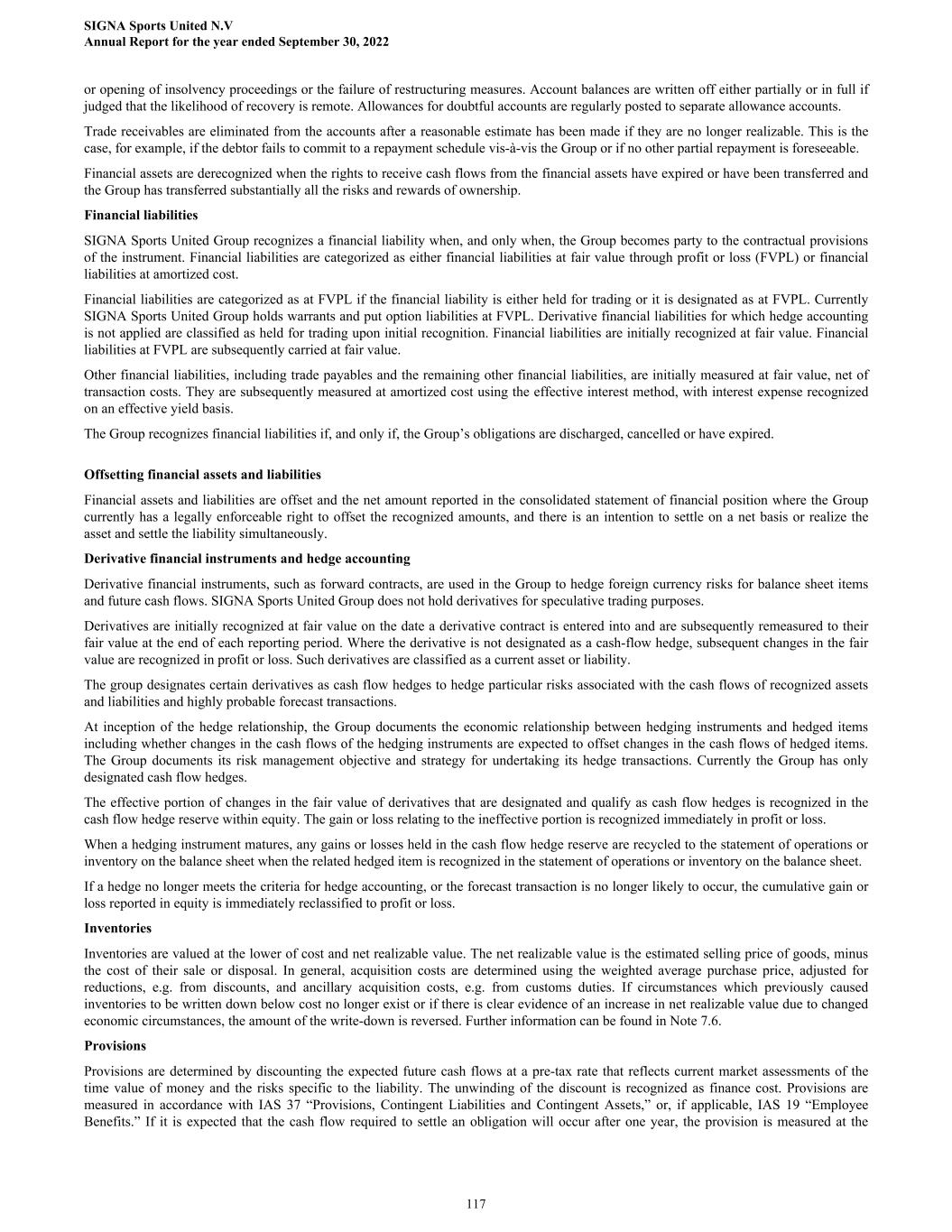
or opening of insolvency proceedings or the failure of restructuring measures. Account balances are written off either partially or in full if judged that the likelihood of recovery is remote. Allowances for doubtful accounts are regularly posted to separate allowance accounts. Trade receivables are eliminated from the accounts after a reasonable estimate has been made if they are no longer realizable. This is the case, for example, if the debtor fails to commit to a repayment schedule vis-à-vis the Group or if no other partial repayment is foreseeable. Financial assets are derecognized when the rights to receive cash flows from the financial assets have expired or have been transferred and the Group has transferred substantially all the risks and rewards of ownership. Financial liabilities SIGNA Sports United Group recognizes a financial liability when, and only when, the Group becomes party to the contractual provisions of the instrument. Financial liabilities are categorized as either financial liabilities at fair value through profit or loss (FVPL) or financial liabilities at amortized cost. Financial liabilities are categorized as at FVPL if the financial liability is either held for trading or it is designated as at FVPL. Currently SIGNA Sports United Group holds warrants and put option liabilities at FVPL. Derivative financial liabilities for which hedge accounting is not applied are classified as held for trading upon initial recognition. Financial liabilities are initially recognized at fair value. Financial liabilities at FVPL are subsequently carried at fair value. Other financial liabilities, including trade payables and the remaining other financial liabilities, are initially measured at fair value, net of transaction costs. They are subsequently measured at amortized cost using the effective interest method, with interest expense recognized on an effective yield basis. The Group recognizes financial liabilities if, and only if, the Group’s obligations are discharged, cancelled or have expired. Offsetting financial assets and liabilities Financial assets and liabilities are offset and the net amount reported in the consolidated statement of financial position where the Group currently has a legally enforceable right to offset the recognized amounts, and there is an intention to settle on a net basis or realize the asset and settle the liability simultaneously. Derivative financial instruments and hedge accounting Derivative financial instruments, such as forward contracts, are used in the Group to hedge foreign currency risks for balance sheet items and future cash flows. SIGNA Sports United Group does not hold derivatives for speculative trading purposes. Derivatives are initially recognized at fair value on the date a derivative contract is entered into and are subsequently remeasured to their fair value at the end of each reporting period. Where the derivative is not designated as a cash-flow hedge, subsequent changes in the fair value are recognized in profit or loss. Such derivatives are classified as a current asset or liability. The group designates certain derivatives as cash flow hedges to hedge particular risks associated with the cash flows of recognized assets and liabilities and highly probable forecast transactions. At inception of the hedge relationship, the Group documents the economic relationship between hedging instruments and hedged items including whether changes in the cash flows of the hedging instruments are expected to offset changes in the cash flows of hedged items. The Group documents its risk management objective and strategy for undertaking its hedge transactions. Currently the Group has only designated cash flow hedges. The effective portion of changes in the fair value of derivatives that are designated and qualify as cash flow hedges is recognized in the cash flow hedge reserve within equity. The gain or loss relating to the ineffective portion is recognized immediately in profit or loss. When a hedging instrument matures, any gains or losses held in the cash flow hedge reserve are recycled to the statement of operations or inventory on the balance sheet when the related hedged item is recognized in the statement of operations or inventory on the balance sheet. If a hedge no longer meets the criteria for hedge accounting, or the forecast transaction is no longer likely to occur, the cumulative gain or loss reported in equity is immediately reclassified to profit or loss. Inventories Inventories are valued at the lower of cost and net realizable value. The net realizable value is the estimated selling price of goods, minus the cost of their sale or disposal. In general, acquisition costs are determined using the weighted average purchase price, adjusted for reductions, e.g. from discounts, and ancillary acquisition costs, e.g. from customs duties. If circumstances which previously caused inventories to be written down below cost no longer exist or if there is clear evidence of an increase in net realizable value due to changed economic circumstances, the amount of the write-down is reversed. Further information can be found in Note 7.6. Provisions Provisions are determined by discounting the expected future cash flows at a pre-tax rate that reflects current market assessments of the time value of money and the risks specific to the liability. The unwinding of the discount is recognized as finance cost. Provisions are measured in accordance with IAS 37 “Provisions, Contingent Liabilities and Contingent Assets,” or, if applicable, IAS 19 “Employee Benefits.” If it is expected that the cash flow required to settle an obligation will occur after one year, the provision is measured at the SIGNA Sports United N.V Annual Report for the year ended September 30, 2022 117

present value of the expected cash flow. Claims for reimbursement by third parties are shown separately in the consolidated statement of financial position if their realization is virtually certain. Further information can be found in Note 7.13. Contingent liabilities Contingent liabilities are possible obligations resulting from past events whose existence will only be confirmed by the occurrence of one or more uncertain future events that are not entirely within the control of SIGNA Sports United Group. Furthermore, contingent liabilities can be current obligations resulting from past events but which are not recognized in the consolidated statement of financial position because it is not probable that an outflow of resources will be required to settle the obligation or the amount of the obligation cannot be measured with sufficient reliability. In accordance with IAS 37, such contingent liabilities are not recognized in the consolidated statement of financial position but disclosed in the notes. Revenue recognition Revenue is measured at the calculated transaction price including any effects of variable consideration, financing components, non-cash consideration and payments to customer. Revenue is recognized when the Group has satisfied the underlying performance obligations. Revenue from the sale of merchandise is recognized on delivery of goods to the end consumer, which represents the point in time at which control transfers to the consumer and the Group’s performance obligation is satisfied. Thus, transportation is not considered as separate performance obligation since customer obtains control of the goods after transport is completed. Revenue from the sale of merchandise is recognized at net value, i.e. after deduction of sales tax, returns, prepayments, customer discounts and rebates. Sales transactions generally include the right of the buyer to return the goods within a certain period of time. Sales deductions, including for returns from customers, are estimated mainly on the basis of past experience and specific contract provisions. Services (e.g. repair, product configuration, flocking) are recognized at the time of service provision, i.e. when the service is completed. The services that are offered by the Group usually run for a short period of time only. Accordingly, the revenue is recognized at a point in time rather than over a period. Payment for the purchased goods or services is generally made either before delivery or when service is performed. In case of payment by invoice payment is due within short time after sending the goods to the customer. Cash is collected by the Group from the end consumer using payment service providers. A contract liability is recognized for customer advances as well as for unredeemed gift certificates. Employee benefits Short-term employee benefits Short-term employee benefits are expensed as the related service is provided. A liability is recognised for the amount expected to be paid if the Group has a present legal or constructive obligation to pay this amount as a result of past service provided by the employee and the obligation can be estimated reliably. Share-based payment transactions The grant-date fair value of equity-settled share-based payment awards granted to employees is generally recognised as an expense, with a corresponding increase in equity, over the vesting period of the awards. The amount recognised as an expense is adjusted to reflect the number of awards for which the related service and non-market performance conditions are expected to be met, such that the amount ultimately recognised is based on the number of awards that meet the related service and non-market performance conditions at the vesting date. For share-based payment awards with non-vesting conditions, the grant-date fair value of the share-based payment is measured to reflect such conditions and there is no true-up for differences between expected and actual outcomes. The fair value of the amount payable to employees in respect of share appreciation rights (‘SARs’), which are settled in cash, is recognised as an expense with a corresponding increase in liabilities, over the period during which the employees become unconditionally entitled to payment. The liability is remeasured at each reporting date and at settlement date based on the fair value of the share appreciation rights. Any changes in the liability are recognised in profit or loss. Operating profits Operating profit is the result generated from the continuing principal revenue producing activities of the Group as well as other income and expenses related to operating activities. Operating profit excludes net finance costs, share of profit of equity accounted investees and income taxes. Finance income and finance costs The Group’s finance income and finance costs include: • interest income; • interest expense; • the net gain or loss on financial assets at FVTPL; SIGNA Sports United N.V Annual Report for the year ended September 30, 2022 118
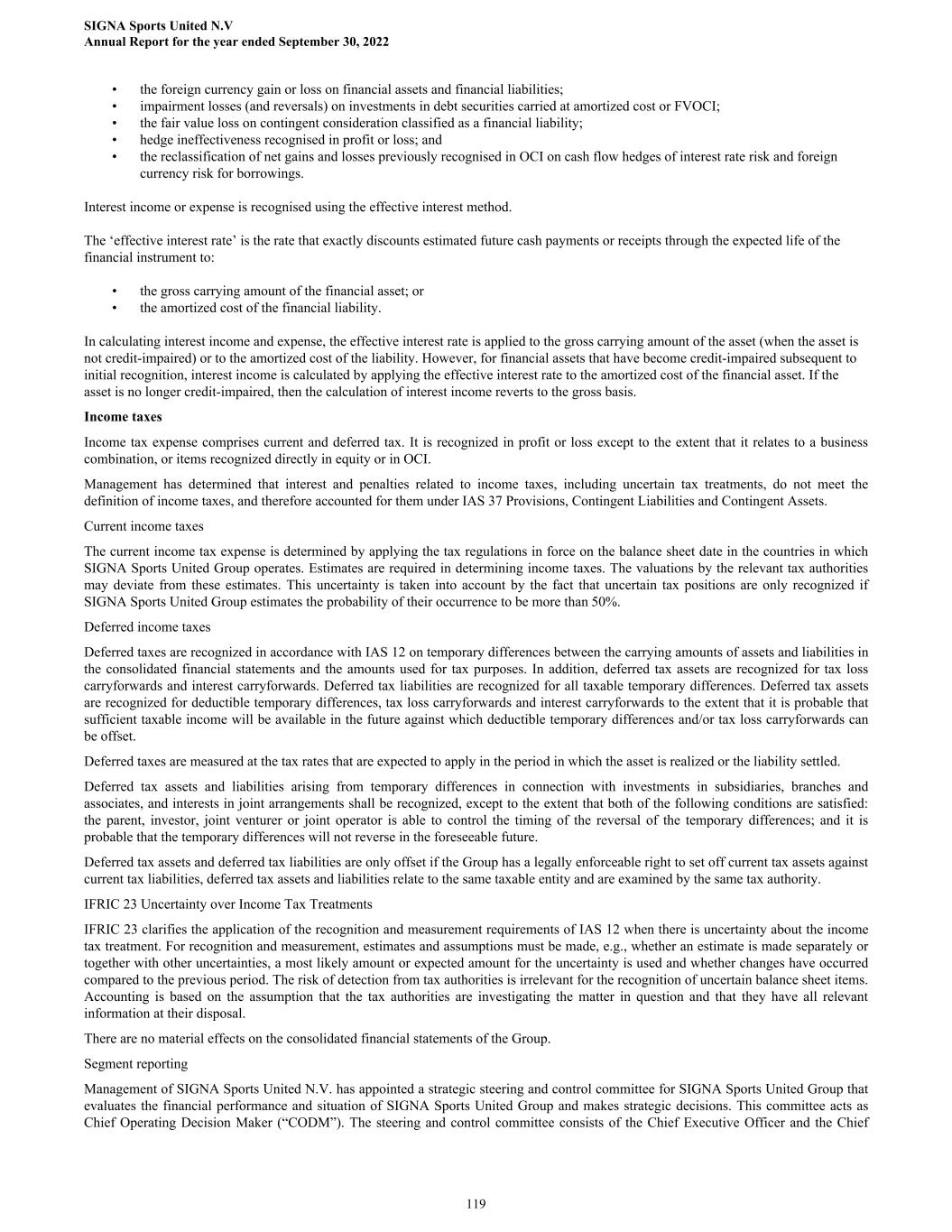
• the foreign currency gain or loss on financial assets and financial liabilities; • impairment losses (and reversals) on investments in debt securities carried at amortized cost or FVOCI; • the fair value loss on contingent consideration classified as a financial liability; • hedge ineffectiveness recognised in profit or loss; and • the reclassification of net gains and losses previously recognised in OCI on cash flow hedges of interest rate risk and foreign currency risk for borrowings. Interest income or expense is recognised using the effective interest method. The ‘effective interest rate’ is the rate that exactly discounts estimated future cash payments or receipts through the expected life of the financial instrument to: • the gross carrying amount of the financial asset; or • the amortized cost of the financial liability. In calculating interest income and expense, the effective interest rate is applied to the gross carrying amount of the asset (when the asset is not credit-impaired) or to the amortized cost of the liability. However, for financial assets that have become credit-impaired subsequent to initial recognition, interest income is calculated by applying the effective interest rate to the amortized cost of the financial asset. If the asset is no longer credit-impaired, then the calculation of interest income reverts to the gross basis. Income taxes Income tax expense comprises current and deferred tax. It is recognized in profit or loss except to the extent that it relates to a business combination, or items recognized directly in equity or in OCI. Management has determined that interest and penalties related to income taxes, including uncertain tax treatments, do not meet the definition of income taxes, and therefore accounted for them under IAS 37 Provisions, Contingent Liabilities and Contingent Assets. Current income taxes The current income tax expense is determined by applying the tax regulations in force on the balance sheet date in the countries in which SIGNA Sports United Group operates. Estimates are required in determining income taxes. The valuations by the relevant tax authorities may deviate from these estimates. This uncertainty is taken into account by the fact that uncertain tax positions are only recognized if SIGNA Sports United Group estimates the probability of their occurrence to be more than 50%. Deferred income taxes Deferred taxes are recognized in accordance with IAS 12 on temporary differences between the carrying amounts of assets and liabilities in the consolidated financial statements and the amounts used for tax purposes. In addition, deferred tax assets are recognized for tax loss carryforwards and interest carryforwards. Deferred tax liabilities are recognized for all taxable temporary differences. Deferred tax assets are recognized for deductible temporary differences, tax loss carryforwards and interest carryforwards to the extent that it is probable that sufficient taxable income will be available in the future against which deductible temporary differences and/or tax loss carryforwards can be offset. Deferred taxes are measured at the tax rates that are expected to apply in the period in which the asset is realized or the liability settled. Deferred tax assets and liabilities arising from temporary differences in connection with investments in subsidiaries, branches and associates, and interests in joint arrangements shall be recognized, except to the extent that both of the following conditions are satisfied: the parent, investor, joint venturer or joint operator is able to control the timing of the reversal of the temporary differences; and it is probable that the temporary differences will not reverse in the foreseeable future. Deferred tax assets and deferred tax liabilities are only offset if the Group has a legally enforceable right to set off current tax assets against current tax liabilities, deferred tax assets and liabilities relate to the same taxable entity and are examined by the same tax authority. IFRIC 23 Uncertainty over Income Tax Treatments IFRIC 23 clarifies the application of the recognition and measurement requirements of IAS 12 when there is uncertainty about the income tax treatment. For recognition and measurement, estimates and assumptions must be made, e.g., whether an estimate is made separately or together with other uncertainties, a most likely amount or expected amount for the uncertainty is used and whether changes have occurred compared to the previous period. The risk of detection from tax authorities is irrelevant for the recognition of uncertain balance sheet items. Accounting is based on the assumption that the tax authorities are investigating the matter in question and that they have all relevant information at their disposal. There are no material effects on the consolidated financial statements of the Group. Segment reporting Management of SIGNA Sports United N.V. has appointed a strategic steering and control committee for SIGNA Sports United Group that evaluates the financial performance and situation of SIGNA Sports United Group and makes strategic decisions. This committee acts as Chief Operating Decision Maker (“CODM”). The steering and control committee consists of the Chief Executive Officer and the Chief SIGNA Sports United N.V Annual Report for the year ended September 30, 2022 119
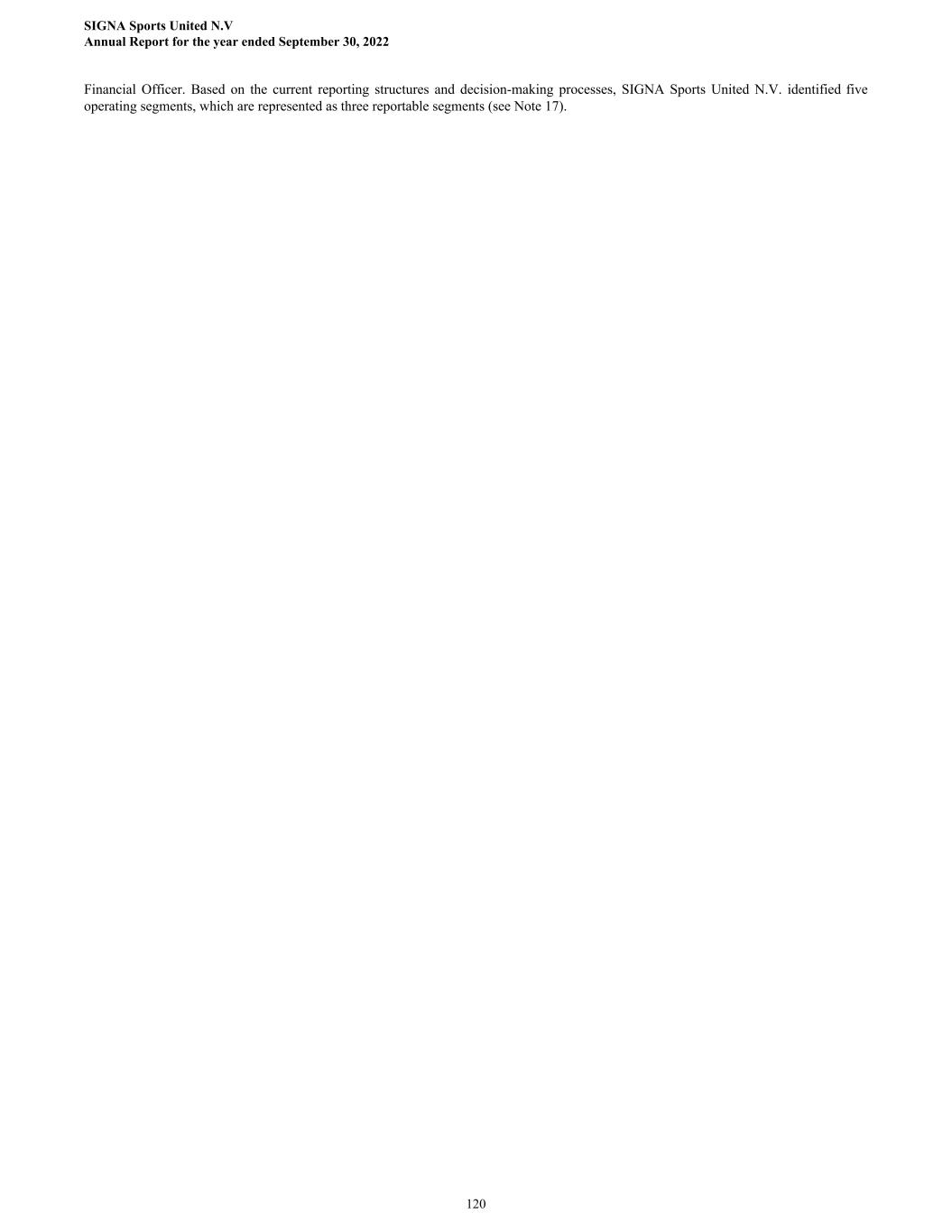
Financial Officer. Based on the current reporting structures and decision-making processes, SIGNA Sports United N.V. identified five operating segments, which are represented as three reportable segments (see Note 17). SIGNA Sports United N.V Annual Report for the year ended September 30, 2022 120
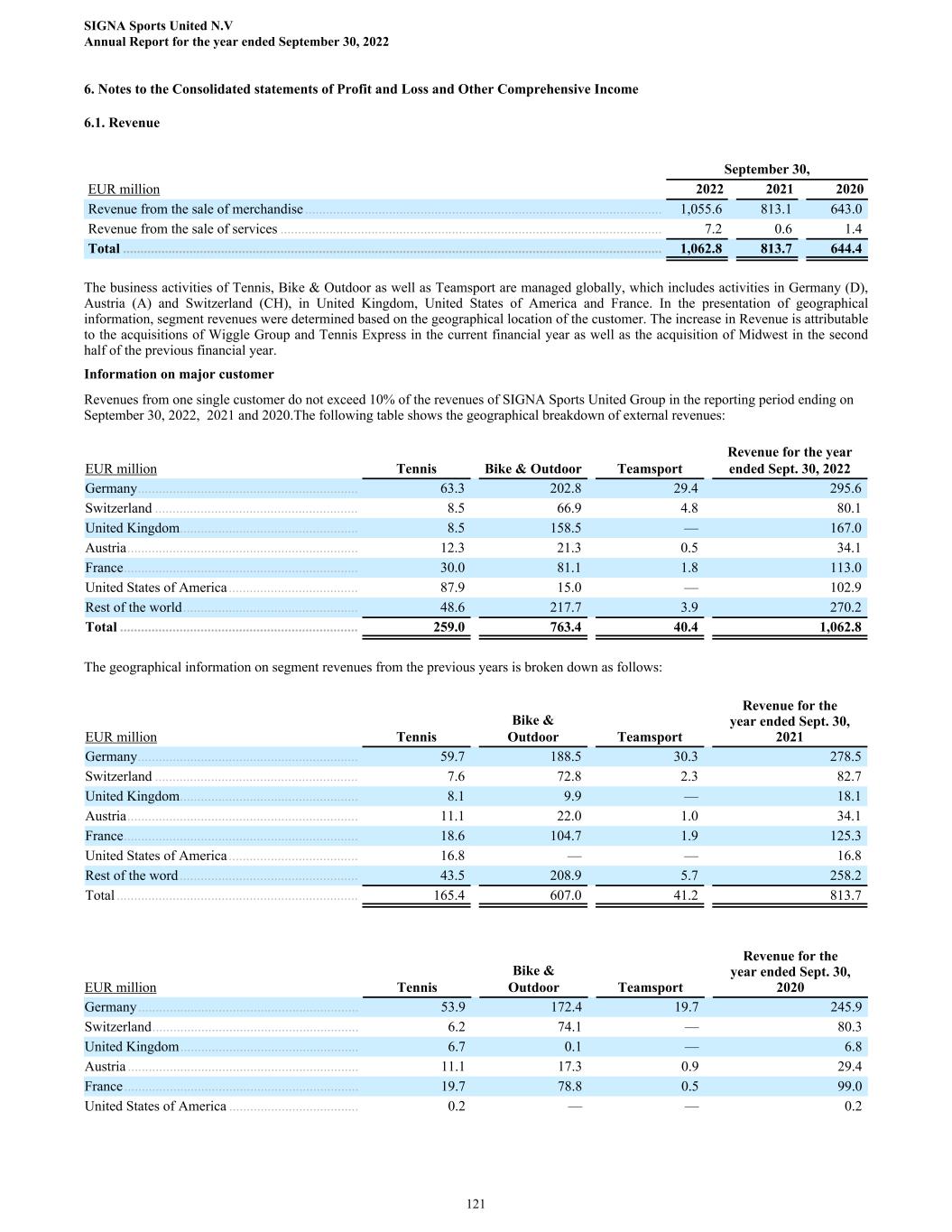
6. Notes to the Consolidated statements of Profit and Loss and Other Comprehensive Income 6.1. Revenue September 30, EUR million 2022 2021 2020 Revenue from the sale of merchandise ...................................................................................................... 1,055.6 813.1 643.0 Revenue from the sale of services ............................................................................................................. 7.2 0.6 1.4 Total .......................................................................................................................................................... 1,062.8 813.7 644.4 The business activities of Tennis, Bike & Outdoor as well as Teamsport are managed globally, which includes activities in Germany (D), Austria (A) and Switzerland (CH), in United Kingdom, United States of America and France. In the presentation of geographical information, segment revenues were determined based on the geographical location of the customer. The increase in Revenue is attributable to the acquisitions of Wiggle Group and Tennis Express in the current financial year as well as the acquisition of Midwest in the second half of the previous financial year. Information on major customer Revenues from one single customer do not exceed 10% of the revenues of SIGNA Sports United Group in the reporting period ending on September 30, 2022, 2021 and 2020.The following table shows the geographical breakdown of external revenues: EUR million Tennis Bike & Outdoor Teamsport Revenue for the year ended Sept. 30, 2022 Germany ............................................................... 63.3 202.8 29.4 295.6 Switzerland .......................................................... 8.5 66.9 4.8 80.1 United Kingdom ................................................... 8.5 158.5 — 167.0 Austria .................................................................. 12.3 21.3 0.5 34.1 France ................................................................... 30.0 81.1 1.8 113.0 United States of America ..................................... 87.9 15.0 — 102.9 Rest of the world .................................................. 48.6 217.7 3.9 270.2 Total .................................................................... 259.0 763.4 40.4 1,062.8 The geographical information on segment revenues from the previous years is broken down as follows: EUR million Tennis Bike & Outdoor Teamsport Revenue for the year ended Sept. 30, 2021 Germany ............................................................... 59.7 188.5 30.3 278.5 Switzerland .......................................................... 7.6 72.8 2.3 82.7 United Kingdom ................................................... 8.1 9.9 — 18.1 Austria .................................................................. 11.1 22.0 1.0 34.1 France ................................................................... 18.6 104.7 1.9 125.3 United States of America ..................................... 16.8 — — 16.8 Rest of the word ................................................... 43.5 208.9 5.7 258.2 Total ..................................................................... 165.4 607.0 41.2 813.7 EUR million Tennis Bike & Outdoor Teamsport Revenue for the year ended Sept. 30, 2020 Germany ............................................................... 53.9 172.4 19.7 245.9 Switzerland ........................................................... 6.2 74.1 — 80.3 United Kingdom ................................................... 6.7 0.1 — 6.8 Austria .................................................................. 11.1 17.3 0.9 29.4 France ................................................................... 19.7 78.8 0.5 99.0 United States of America ..................................... 0.2 — — 0.2 SIGNA Sports United N.V Annual Report for the year ended September 30, 2022 121
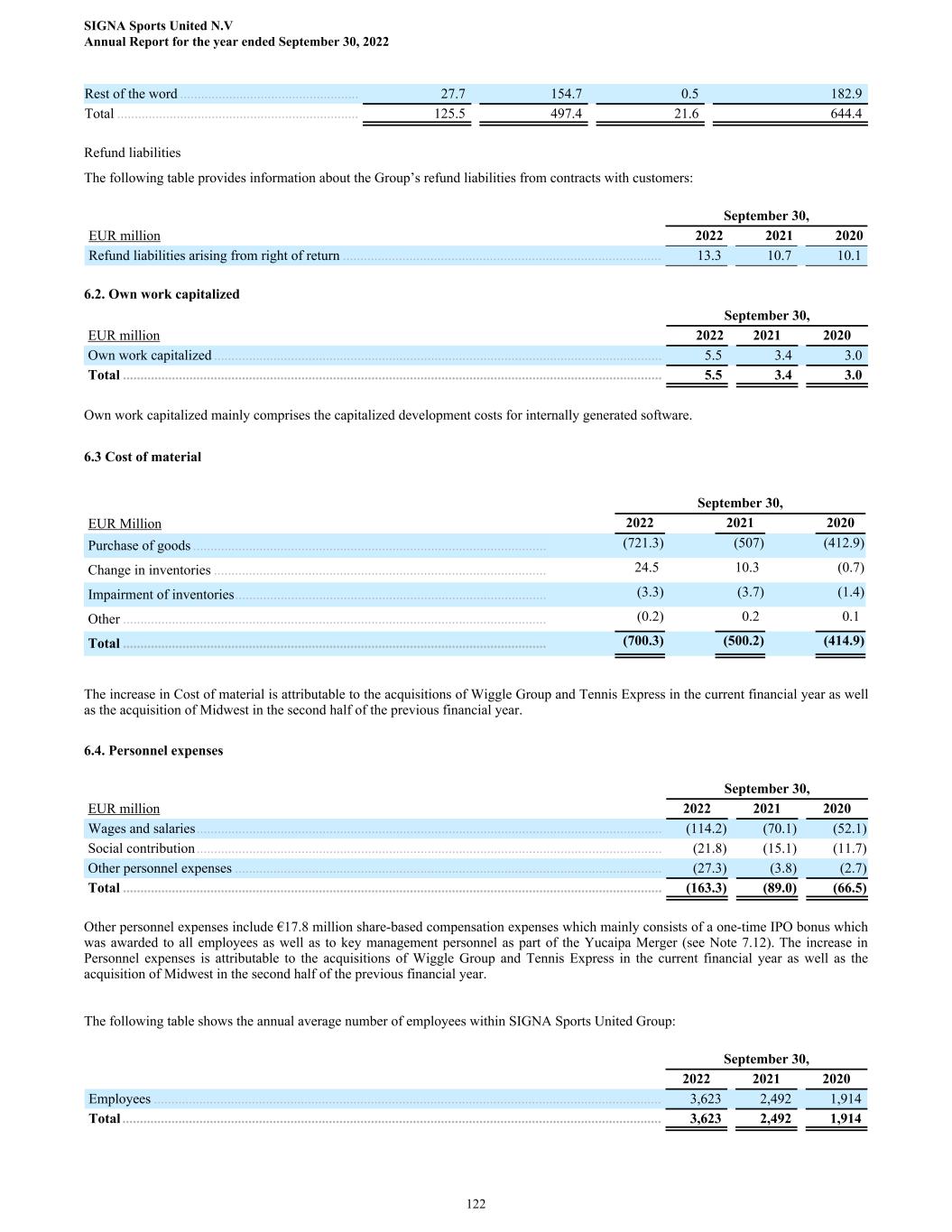
Rest of the word ................................................... 27.7 154.7 0.5 182.9 Total ..................................................................... 125.5 497.4 21.6 644.4 Refund liabilities The following table provides information about the Group’s refund liabilities from contracts with customers: September 30, EUR million 2022 2021 2020 Refund liabilities arising from right of return ........................................................................................... 13.3 10.7 10.1 6.2. Own work capitalized September 30, EUR million 2022 2021 2020 Own work capitalized ................................................................................................................................ 5.5 3.4 3.0 Total .......................................................................................................................................................... 5.5 3.4 3.0 Own work capitalized mainly comprises the capitalized development costs for internally generated software. 6.3 Cost of material September 30, EUR Million 2022 2021 2020 Purchase of goods ..................................................................................................... (721.3) (507) (412.9) Change in inventories ............................................................................................... 24.5 10.3 (0.7) Impairment of inventories ......................................................................................... (3.3) (3.7) (1.4) Other ......................................................................................................................... (0.2) 0.2 0.1 Total ......................................................................................................................... (700.3) (500.2) (414.9) The increase in Cost of material is attributable to the acquisitions of Wiggle Group and Tennis Express in the current financial year as well as the acquisition of Midwest in the second half of the previous financial year. 6.4. Personnel expenses September 30, EUR million 2022 2021 2020 Wages and salaries ..................................................................................................................................... (114.2) (70.1) (52.1) Social contribution ..................................................................................................................................... (21.8) (15.1) (11.7) Other personnel expenses .......................................................................................................................... (27.3) (3.8) (2.7) Total .......................................................................................................................................................... (163.3) (89.0) (66.5) Other personnel expenses include €17.8 million share-based compensation expenses which mainly consists of a one-time IPO bonus which was awarded to all employees as well as to key management personnel as part of the Yucaipa Merger (see Note 7.12). The increase in Personnel expenses is attributable to the acquisitions of Wiggle Group and Tennis Express in the current financial year as well as the acquisition of Midwest in the second half of the previous financial year. The following table shows the annual average number of employees within SIGNA Sports United Group: September 30, 2022 2021 2020 Employees ................................................................................................................................................. 3,623 2,492 1,914 Total .......................................................................................................................................................... 3,623 2,492 1,914 SIGNA Sports United N.V Annual Report for the year ended September 30, 2022 122

6.5. Other operating expenses September 30, EUR million 2022 2021 2020 Expenses for logistics and packaging ........................................................................................................ (121.9) (81.0) (61.8) Marketing expenses ................................................................................................................................... (89.2) (62.7) (41.7) Expenses for warehousing, rents and similar expenses ............................................................................. (8.2) (6.3) (9.6) Charges for payment services .................................................................................................................... (18.6) (11.3) (8.5) Legal and consulting fees ........................................................................................................................... (64.5) (31.8) (7.1) IT expense .................................................................................................................................................. (19.7) (14.2) (9.4) Administrative expenses ............................................................................................................................ (15.3) (7.3) (3.3) Temporary workers and other personnel related expenses ........................................................................ (12.0) (11.9) (8.2) ECL allowance ........................................................................................................................................... (2.2) (2.1) (3.9) Share listing expense (IFRS 2) .................................................................................................................. (121.9) — — Other .......................................................................................................................................................... (7.7) (6.0) (3.3) Total .......................................................................................................................................................... (481.1) (234.5) (156.8) For further information regarding the €121.9 million share listing expense see Note 6.7. The increase in legal and consulting fees resulted mainly from an increase in accounting, audit and legal fees. The increase is due to both one-time expenses associated with the Yucaipa Merger and PIPE Financing as well as efforts to operate as a public company. The remaining other operating expenses increased due to the acquisitions of Wiggle Group and Tennis Express in the current financial year as well as the acquisition of Midwest in the second half of the previous financial year. 6.6. Finance income and cost September 30, EUR million 2022 2021 2020 Finance income Interest income ........................................................................................................................................... 1.8 4.0 0.7 Other financial income ............................................................................................................................... 34.9 0.8 0.1 Total .......................................................................................................................................................... 36.6 4.8 0.9 Finance cost Interest expense for financial liabilities carried at amortized cost ............................................................. (5.7) (8.1) (7.7) Other financial expenses ............................................................................................................................ (15.3) (1.1) (0.1) Interest expense for lease liabilities (IFRS 16) .......................................................................................... (0.3) (0.2) (0.1) Total .......................................................................................................................................................... (21.3) (9.4) (7.9) Net finance income (costs) ....................................................................................................................... 15.3 (4.6) (7.1) The other financial income includes €16.4 million due to the revaluation of the warrants (see Note 6.7) as well as €16.4 million due to the revaluation of the put option liabilities for Tennis Express and Midwest Sports. Other financial expenses include currency losses of €14.9 million mainly resulting from intercompany balances and warrants revaluation. 6.7. Share listing expense and change in fair value of warrant liabilities As described in Note 3, the Yucaipa Merger led to a Share listing expense. SSU N.V. issued shares with a fair value of €110.1 million to Yucaipa shareholders, comprised of the fair value of SSU N.V. shares, that were issued to Yucaipa shareholders of €8.75 per share (Yucaipa’s closing price as of December 14, 2021). In exchange, SSU N.V received the identifiable net assets held by Yucaipa, which had a fair value upon closing of €7.3 million, comprising of investments held in Yucaipa’s trust account partly offset by current liabilities by Yucaipa, deferred underwriting commissions and financial liabilities in the amount of €19.0 million accounted for the 17,433,333 Yucaipa Warrants considering a fair value of the warrants of €1.09 per warrant (price of Yucaipa Warrants at Closing of the Yucaipa Merger in EUR; closing price in USD as the denominated currency was USD 1.24). The excess of the fair value of the equity instruments issued over the fair value of the identified net assets contributed, represents a non-cash expense in accordance with IFRS 2. This one-time expense as a result of the Yucaipa Merger, in the amount of €121.9 million, is recognized as Share listing expense in other operating expenses within the Consolidated Statement of Profit or Loss. SIGNA Sports United N.V Annual Report for the year ended September 30, 2022 123
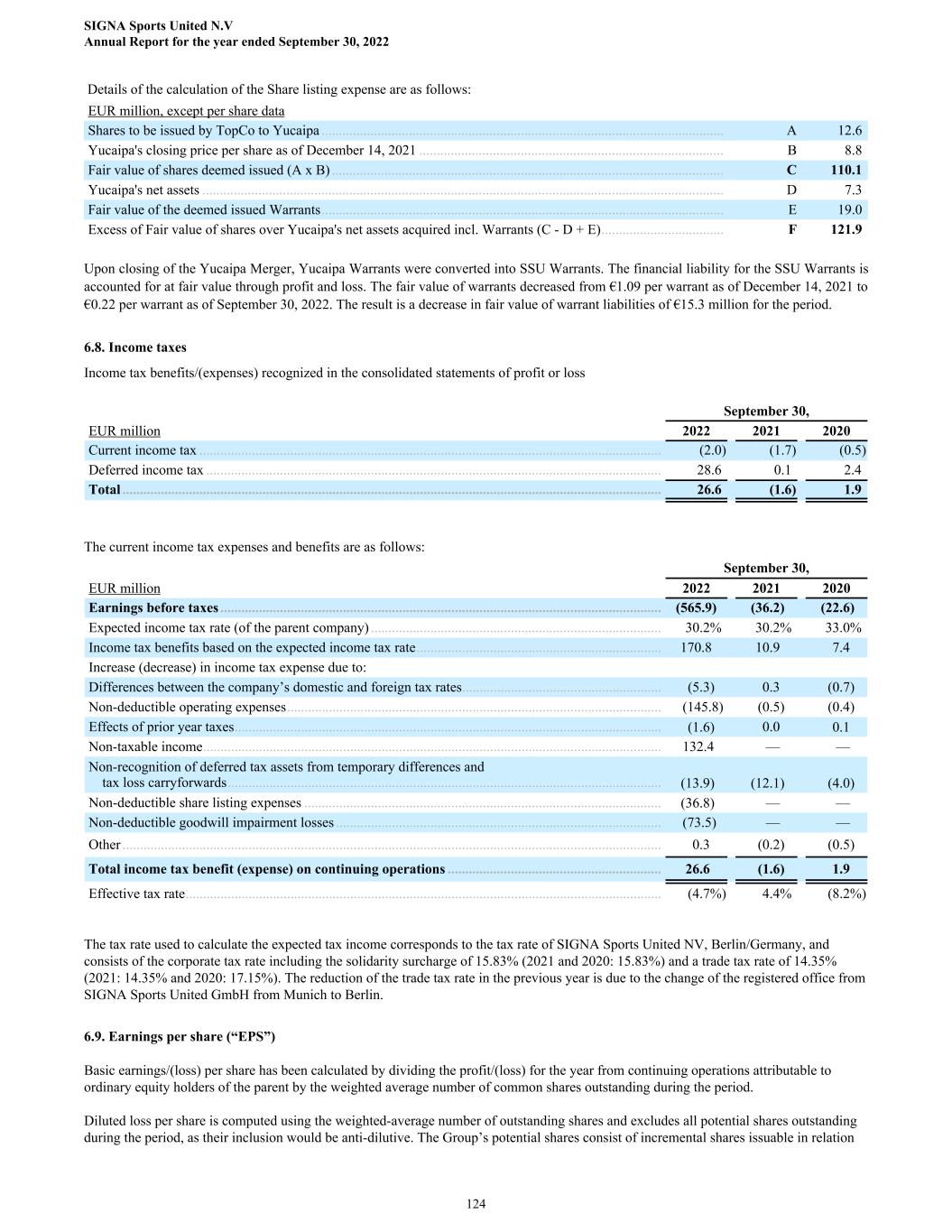
Details of the calculation of the Share listing expense are as follows: EUR million, except per share data Shares to be issued by TopCo to Yucaipa ................................................................................................................... A 12.6 Yucaipa's closing price per share as of December 14, 2021 ....................................................................................... B 8.8 Fair value of shares deemed issued (A x B) ................................................................................................................ C 110.1 Yucaipa's net assets ..................................................................................................................................................... D 7.3 Fair value of the deemed issued Warrants ................................................................................................................... E 19.0 Excess of Fair value of shares over Yucaipa's net assets acquired incl. Warrants (C - D + E) ................................... F 121.9 Upon closing of the Yucaipa Merger, Yucaipa Warrants were converted into SSU Warrants. The financial liability for the SSU Warrants is accounted for at fair value through profit and loss. The fair value of warrants decreased from €1.09 per warrant as of December 14, 2021 to €0.22 per warrant as of September 30, 2022. The result is a decrease in fair value of warrant liabilities of €15.3 million for the period. 6.8. Income taxes Income tax benefits/(expenses) recognized in the consolidated statements of profit or loss September 30, EUR million 2022 2021 2020 Current income tax .................................................................................................................................... (2.0) (1.7) (0.5) Deferred income tax .................................................................................................................................. 28.6 0.1 2.4 Total .......................................................................................................................................................... 26.6 (1.6) 1.9 The current income tax expenses and benefits are as follows: September 30, EUR million 2022 2021 2020 Earnings before taxes .............................................................................................................................. (565.9) (36.2) (22.6) Expected income tax rate (of the parent company) ................................................................................... 30.2% 30.2% 33.0% Income tax benefits based on the expected income tax rate ...................................................................... 170.8 10.9 7.4 Increase (decrease) in income tax expense due to: Differences between the company’s domestic and foreign tax rates ......................................................... (5.3) 0.3 (0.7) Non-deductible operating expenses ........................................................................................................... (145.8) (0.5) (0.4) Effects of prior year taxes .......................................................................................................................... (1.6) 0.0 0.1 Non-taxable income ................................................................................................................................... 132.4 — — Non-recognition of deferred tax assets from temporary differences and tax loss carryforwards ............................................................................................................................ (13.9) (12.1) (4.0) Non-deductible share listing expenses ...................................................................................................... (36.8) — — Non-deductible goodwill impairment losses ............................................................................................. (73.5) — — Other .......................................................................................................................................................... 0.3 (0.2) (0.5) Total income tax benefit (expense) on continuing operations ............................................................. 26.6 (1.6) 1.9 Effective tax rate ........................................................................................................................................ (4.7%) 4.4% (8.2%) The tax rate used to calculate the expected tax income corresponds to the tax rate of SIGNA Sports United NV, Berlin/Germany, and consists of the corporate tax rate including the solidarity surcharge of 15.83% (2021 and 2020: 15.83%) and a trade tax rate of 14.35% (2021: 14.35% and 2020: 17.15%). The reduction of the trade tax rate in the previous year is due to the change of the registered office from SIGNA Sports United GmbH from Munich to Berlin. 6.9. Earnings per share (“EPS”) Basic earnings/(loss) per share has been calculated by dividing the profit/(loss) for the year from continuing operations attributable to ordinary equity holders of the parent by the weighted average number of common shares outstanding during the period. Diluted loss per share is computed using the weighted-average number of outstanding shares and excludes all potential shares outstanding during the period, as their inclusion would be anti-dilutive. The Group’s potential shares consist of incremental shares issuable in relation SIGNA Sports United N.V Annual Report for the year ended September 30, 2022 124
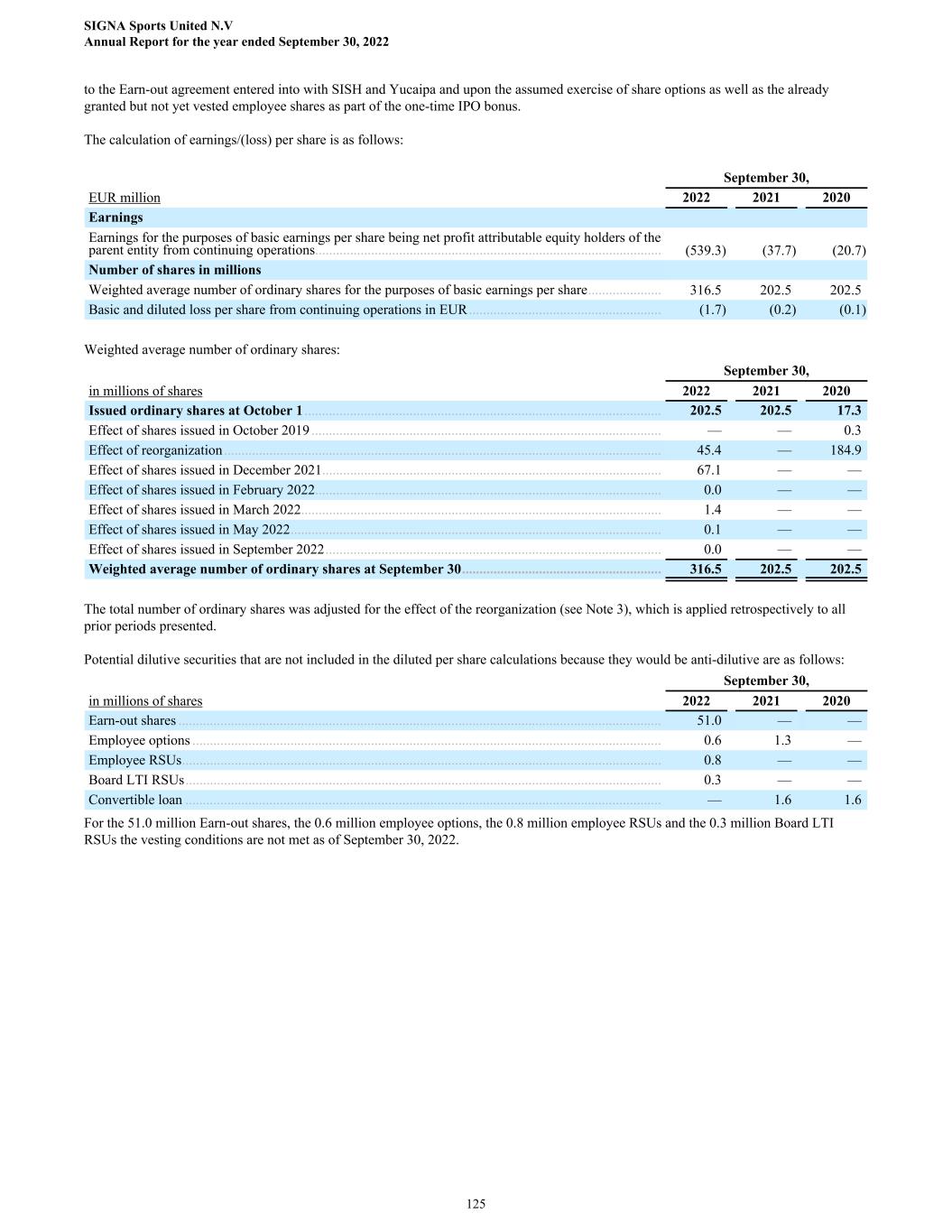
to the Earn-out agreement entered into with SISH and Yucaipa and upon the assumed exercise of share options as well as the already granted but not yet vested employee shares as part of the one-time IPO bonus. The calculation of earnings/(loss) per share is as follows: September 30, EUR million 2022 2021 2020 Earnings Earnings for the purposes of basic earnings per share being net profit attributable equity holders of the parent entity from continuing operations ................................................................................................... (539.3) (37.7) (20.7) Number of shares in millions Weighted average number of ordinary shares for the purposes of basic earnings per share ..................... 316.5 202.5 202.5 Basic and diluted loss per share from continuing operations in EUR ....................................................... (1.7) (0.2) (0.1) Weighted average number of ordinary shares: September 30, in millions of shares 2022 2021 2020 Issued ordinary shares at October 1 ...................................................................................................... 202.5 202.5 17.3 Effect of shares issued in October 2019 .................................................................................................... — — 0.3 Effect of reorganization ............................................................................................................................. 45.4 — 184.9 Effect of shares issued in December 2021 ................................................................................................. 67.1 — — Effect of shares issued in February 2022 ................................................................................................... 0.0 — — Effect of shares issued in March 2022 ....................................................................................................... 1.4 — — Effect of shares issued in May 2022 .......................................................................................................... 0.1 — — Effect of shares issued in September 2022 ................................................................................................ 0.0 — — Weighted average number of ordinary shares at September 30 ......................................................... 316.5 202.5 202.5 The total number of ordinary shares was adjusted for the effect of the reorganization (see Note 3), which is applied retrospectively to all prior periods presented. Potential dilutive securities that are not included in the diluted per share calculations because they would be anti-dilutive are as follows: September 30, in millions of shares 2022 2021 2020 Earn-out shares .......................................................................................................................................... 51.0 — — Employee options ...................................................................................................................................... 0.6 1.3 — Employee RSUs ......................................................................................................................................... 0.8 — — Board LTI RSUs ........................................................................................................................................ 0.3 — — Convertible loan ........................................................................................................................................ — 1.6 1.6 For the 51.0 million Earn-out shares, the 0.6 million employee options, the 0.8 million employee RSUs and the 0.3 million Board LTI RSUs the vesting conditions are not met as of September 30, 2022. SIGNA Sports United N.V Annual Report for the year ended September 30, 2022 125
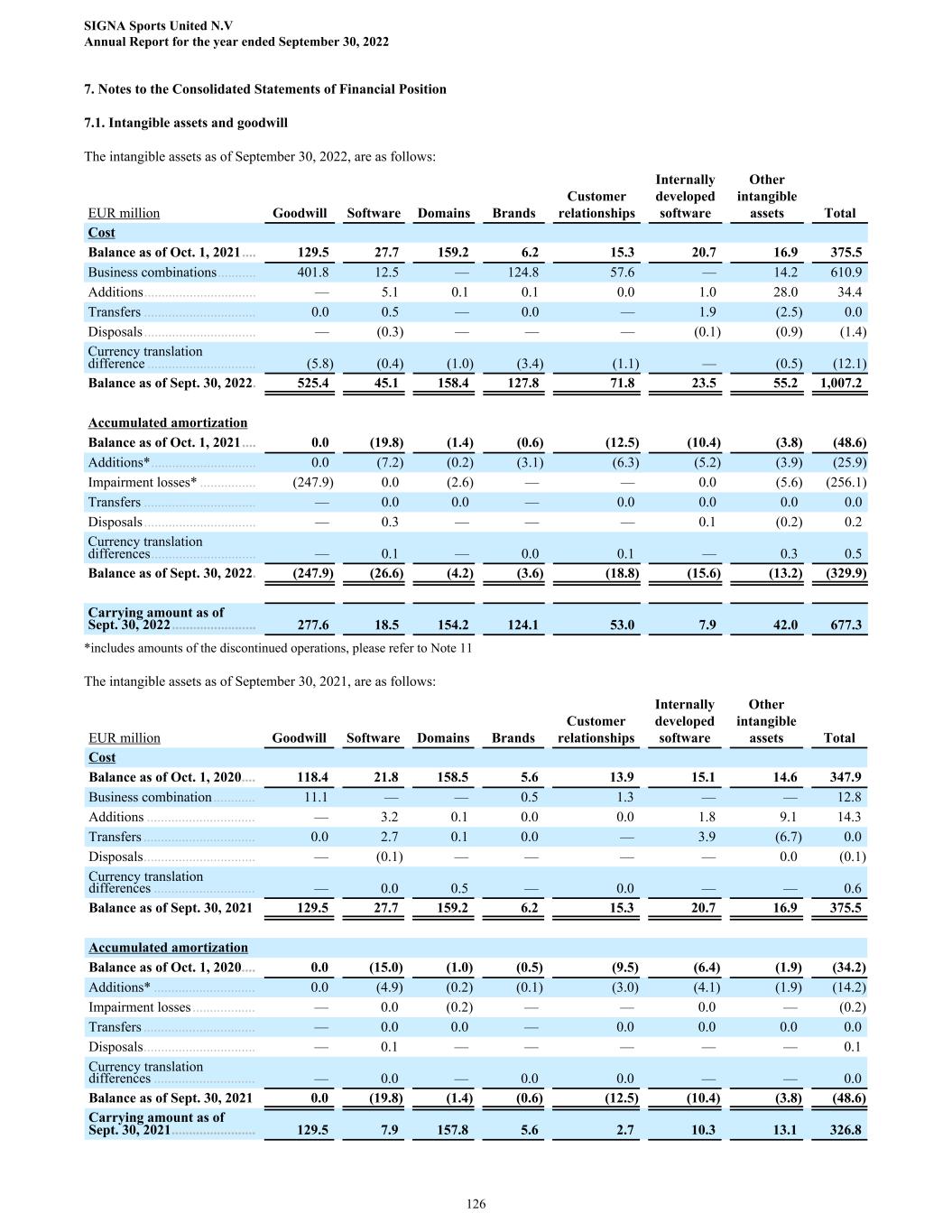
7. Notes to the Consolidated Statements of Financial Position 7.1. Intangible assets and goodwill The intangible assets as of September 30, 2022, are as follows: EUR million Goodwill Software Domains Brands Customer relationships Internally developed software Other intangible assets Total Cost Balance as of Oct. 1, 2021 .... 129.5 27.7 159.2 6.2 15.3 20.7 16.9 375.5 Business combinations ........... 401.8 12.5 — 124.8 57.6 — 14.2 610.9 Additions ................................ — 5.1 0.1 0.1 0.0 1.0 28.0 34.4 Transfers ................................ 0.0 0.5 — 0.0 — 1.9 (2.5) 0.0 Disposals ................................ — (0.3) — — — (0.1) (0.9) (1.4) Currency translation difference ............................... (5.8) (0.4) (1.0) (3.4) (1.1) — (0.5) (12.1) Balance as of Sept. 30, 2022 . 525.4 45.1 158.4 127.8 71.8 23.5 55.2 1,007.2 Accumulated amortization Balance as of Oct. 1, 2021 .... 0.0 (19.8) (1.4) (0.6) (12.5) (10.4) (3.8) (48.6) Additions* .............................. 0.0 (7.2) (0.2) (3.1) (6.3) (5.2) (3.9) (25.9) Impairment losses* ................ (247.9) 0.0 (2.6) — — 0.0 (5.6) (256.1) Transfers ................................ — 0.0 0.0 — 0.0 0.0 0.0 0.0 Disposals ................................ — 0.3 — — — 0.1 (0.2) 0.2 Currency translation differences .............................. — 0.1 — 0.0 0.1 — 0.3 0.5 Balance as of Sept. 30, 2022 . (247.9) (26.6) (4.2) (3.6) (18.8) (15.6) (13.2) (329.9) Carrying amount as of Sept. 30, 2022 ........................ 277.6 18.5 154.2 124.1 53.0 7.9 42.0 677.3 *includes amounts of the discontinued operations, please refer to Note 11 The intangible assets as of September 30, 2021, are as follows: EUR million Goodwill Software Domains Brands Customer relationships Internally developed software Other intangible assets Total Cost Balance as of Oct. 1, 2020 .... 118.4 21.8 158.5 5.6 13.9 15.1 14.6 347.9 Business combination ............ 11.1 — — 0.5 1.3 — — 12.8 Additions ............................... — 3.2 0.1 0.0 0.0 1.8 9.1 14.3 Transfers ................................ 0.0 2.7 0.1 0.0 — 3.9 (6.7) 0.0 Disposals ................................ — (0.1) — — — — 0.0 (0.1) Currency translation differences ............................. — 0.0 0.5 — 0.0 — — 0.6 Balance as of Sept. 30, 2021 129.5 27.7 159.2 6.2 15.3 20.7 16.9 375.5 Accumulated amortization Balance as of Oct. 1, 2020 .... 0.0 (15.0) (1.0) (0.5) (9.5) (6.4) (1.9) (34.2) Additions* ............................. 0.0 (4.9) (0.2) (0.1) (3.0) (4.1) (1.9) (14.2) Impairment losses .................. — 0.0 (0.2) — — 0.0 — (0.2) Transfers ................................ — 0.0 0.0 — 0.0 0.0 0.0 0.0 Disposals ................................ — 0.1 — — — — — 0.1 Currency translation differences ............................. — 0.0 — 0.0 0.0 — — 0.0 Balance as of Sept. 30, 2021 0.0 (19.8) (1.4) (0.6) (12.5) (10.4) (3.8) (48.6) Carrying amount as of Sept. 30, 2021 ........................ 129.5 7.9 157.8 5.6 2.7 10.3 13.1 326.8 SIGNA Sports United N.V Annual Report for the year ended September 30, 2022 126
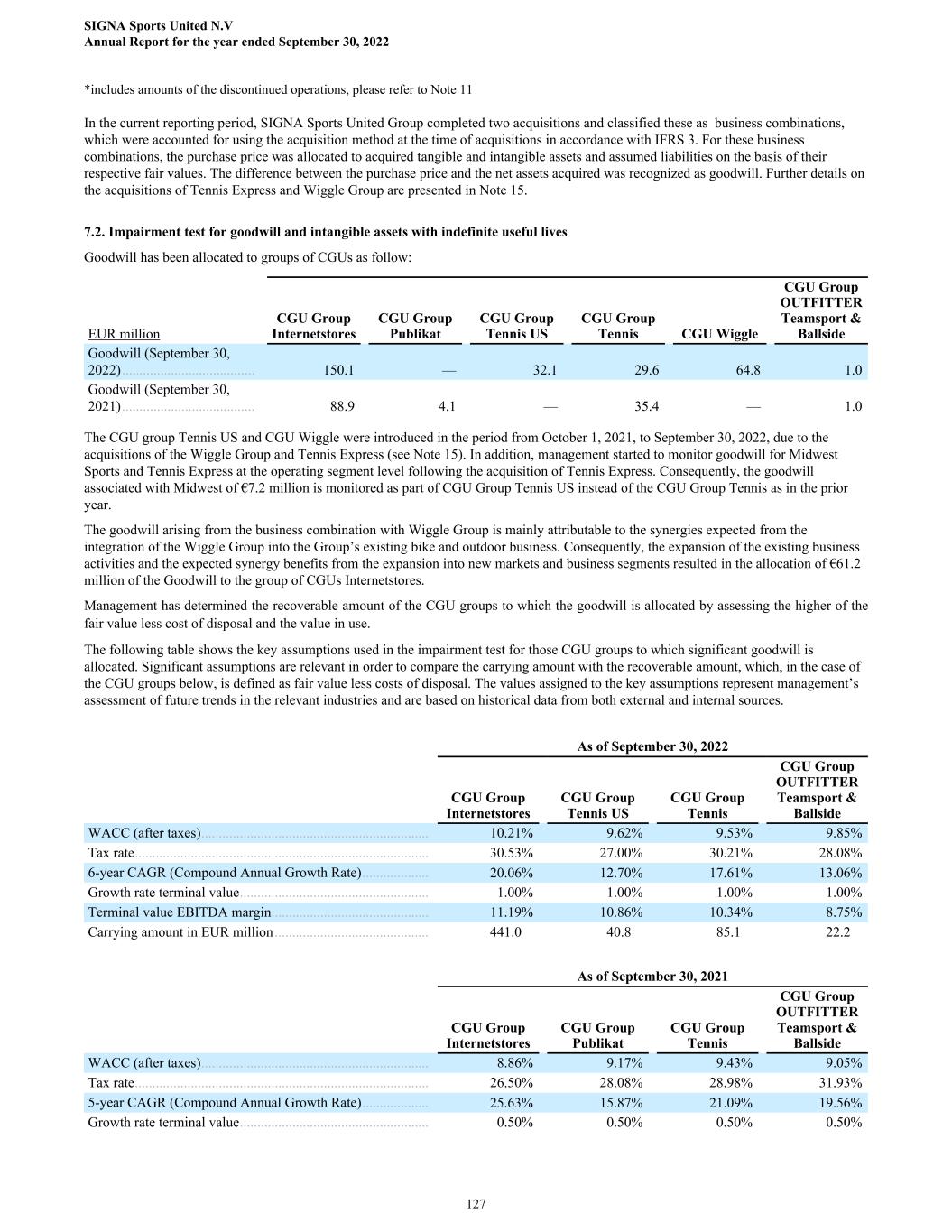
*includes amounts of the discontinued operations, please refer to Note 11 In the current reporting period, SIGNA Sports United Group completed two acquisitions and classified these as business combinations, which were accounted for using the acquisition method at the time of acquisitions in accordance with IFRS 3. For these business combinations, the purchase price was allocated to acquired tangible and intangible assets and assumed liabilities on the basis of their respective fair values. The difference between the purchase price and the net assets acquired was recognized as goodwill. Further details on the acquisitions of Tennis Express and Wiggle Group are presented in Note 15. 7.2. Impairment test for goodwill and intangible assets with indefinite useful lives Goodwill has been allocated to groups of CGUs as follow: EUR million CGU Group Internetstores CGU Group Publikat CGU Group Tennis US CGU Group Tennis CGU Wiggle CGU Group OUTFITTER Teamsport & Ballside Goodwill (September 30, 2022) ...................................... 150.1 — 32.1 29.6 64.8 1.0 Goodwill (September 30, 2021) ...................................... 88.9 4.1 — 35.4 — 1.0 The CGU group Tennis US and CGU Wiggle were introduced in the period from October 1, 2021, to September 30, 2022, due to the acquisitions of the Wiggle Group and Tennis Express (see Note 15). In addition, management started to monitor goodwill for Midwest Sports and Tennis Express at the operating segment level following the acquisition of Tennis Express. Consequently, the goodwill associated with Midwest of €7.2 million is monitored as part of CGU Group Tennis US instead of the CGU Group Tennis as in the prior year. The goodwill arising from the business combination with Wiggle Group is mainly attributable to the synergies expected from the integration of the Wiggle Group into the Group’s existing bike and outdoor business. Consequently, the expansion of the existing business activities and the expected synergy benefits from the expansion into new markets and business segments resulted in the allocation of €61.2 million of the Goodwill to the group of CGUs Internetstores. Management has determined the recoverable amount of the CGU groups to which the goodwill is allocated by assessing the higher of the fair value less cost of disposal and the value in use. The following table shows the key assumptions used in the impairment test for those CGU groups to which significant goodwill is allocated. Significant assumptions are relevant in order to compare the carrying amount with the recoverable amount, which, in the case of the CGU groups below, is defined as fair value less costs of disposal. The values assigned to the key assumptions represent management’s assessment of future trends in the relevant industries and are based on historical data from both external and internal sources. As of September 30, 2022 CGU Group Internetstores CGU Group Tennis US CGU Group Tennis CGU Group OUTFITTER Teamsport & Ballside WACC (after taxes) ................................................................. 10.21% 9.62% 9.53% 9.85% Tax rate .................................................................................... 30.53% 27.00% 30.21% 28.08% 6-year CAGR (Compound Annual Growth Rate) ................... 20.06% 12.70% 17.61% 13.06% Growth rate terminal value ...................................................... 1.00% 1.00% 1.00% 1.00% Terminal value EBITDA margin ............................................. 11.19% 10.86% 10.34% 8.75% Carrying amount in EUR million ............................................ 441.0 40.8 85.1 22.2 As of September 30, 2021 CGU Group Internetstores CGU Group Publikat CGU Group Tennis CGU Group OUTFITTER Teamsport & Ballside WACC (after taxes) ................................................................. 8.86% 9.17% 9.43% 9.05% Tax rate .................................................................................... 26.50% 28.08% 28.98% 31.93% 5-year CAGR (Compound Annual Growth Rate) ................... 25.63% 15.87% 21.09% 19.56% Growth rate terminal value ...................................................... 0.50% 0.50% 0.50% 0.50% SIGNA Sports United N.V Annual Report for the year ended September 30, 2022 127

Terminal value EBITDA margin ............................................. 13.49% 9.44% 11.73% 9.44% Carrying amount in EUR million ............................................ 293.2 44.2 105.7 20.8 For the goodwill impairment test, the recoverable amount of the CGU groups that are mentioned in the tables above for the financial year ending September 30, 2022 and 2021 was determined on the basis of fair value less costs of disposal, which requires the use of assumptions. The calculations are based on cash flow projections from financial budgets approved by management and covers a period of six years until TV (Terminal Value) in 2028. Accordingly, the budget represents an appropriate financial basis for the calculation of a fair value less cost of disposal, which would be paid in an orderly transaction between market participants. As there is no active market, fair values are calculated as the sum of discounted cash flow projections less costs of disposal, estimated at 3% (2021: 3%). (Level 3 of the valuation hierarchy). Cash flows beyond the six-year period are extrapolated using the estimated terminal value growth rates mentioned above. The terminal value growth rate was determined based on management’s estimate of the long-term compound annual EBITDA growth rate (please refer to Note 17), consistent with the assumptions that a market participant would make. Assumed 6-year CAGR mentioned above were projected taking into account the average growth levels experienced over the past five years and the estimated sales volume and price growth for the next six years. Growth rates in the past were above average market growth, partially due to the effect of the COVID-19 Pandemic on online sales of the product groups within each group of CGUs. It was assumed that sales prices would increase in line with forecast inflation over the next six years in the respective market environments of the CGU groups. The budgeted EBITDA takes into account the 6-year CAGR projected as described above. The planning period was extended from five to six years due to the current uncertain economic environment. For the CGU Group Wiggle CRC, the recoverable amount was based on its value in use, determined by discounting the future cash flows from the continuing use of the CGU. Five years of cash flows were included in the discounted cash flow model. Budgeted EBITDA considers historical performance and anticipated revenue growth adjusted for inflation. Revenue growth is projected by considering the average growth levels experienced over the past five years, estimated sales volume and estimated price growth for the next five years. Taking into consideration the decrease in the Wiggle CRC generated revenues during the fiscal year ended September 30, 2022 and increased time required to realize synergies as well as adverse impact of inflation and supply chain constraints on the overall performance of the Wiggle CRC Group, the carrying amount of the CGU was determined to be higher than its recoverable amount resulting in an impairment loss of €243.7 million which was recognized in the fiscal year ended September 30, 2022. The impairment loss is fully allocated to goodwill and is included in ‘Impairment Loss’. The key assumptions used in the estimation of value in use were as follows: WACC ................................................................................................................................................................................. 9.68% Tax rate ................................................................................................................................................................................. 25.00% 5-year CAGR (Compound Annual Growth Rate) ................................................................................................................ 16.10% Growth rate terminal value ................................................................................................................................................... 1.00% Terminal value EBITDA margin .......................................................................................................................................... 7.47% Carrying amount in EUR million ......................................................................................................................................... 533.2 The recoverable amount of goodwill within the CGU Group Wiggle CRC is equal to the carrying amount following the impairment recognized during the year. Any adverse movements in a key assumption would trigger further impairments. For the CGU Group Publikat, the recoverable amount was determined on the basis of the fair value less cost of disposal. Subsequent to year end, the company Publikat entered into a sale and purchase agreement to sell a material portion of the company to an interested market participant (see Note 5). As there is an active market (Level 1 of the fair value hierarchy), fair values were determined through the market price. Consequently, the carrying amount of the CGU was determined to be higher than its recoverable amount and an impairment loss of €4.8 million was recognized for the fiscal year ended September 30, 2022. The impairment loss was allocated to goodwill in the amount of €4.1 million and domains in the amount of €0.7 million. Both amounts are included in ‘Loss from discontinued operations, net of tax’. Intangible assets with an indefinite useful life As required by IAS 36, intangible assets with an indefinite useful life have to be tested for impairment annually. Net Intangible assets with indefinite useful lives amounted to €250.1 million as of September 30, 2022 (2021: €163.1 million). The Internetstores group comprises 24 brands and domains with carrying amounts between €0.1 million and €33.1 million (2021: €0.2 million and €33.1 million). The Tennis group comprises 21 brands and domains with carrying amounts between €0.1 million and €8.3 million (2021: €0.1 million and €8.3 million). Publikat comprises of one domain with book value of €0.1 million (2021: €0.1 million and €0.5 million). Outfitter Teamsport & Ballside comprise of one domain with book value of €3.8 million (2021: €3.8 million). The Wiggle group which were introduced in the current year (see note 15) comprises 2 brands (Wiggle and Chain reactions CRC),with carrying amounts of €42.4 million and €49.5 million (2021: € — million and € — million) The largest internet domains names being www.fahrrad.de and www.bikester.ch with a carrying amount of €33.1 million and €25.8, respectively. All other individual domains/brand names not mentioned above have carrying amounts that are below 10% of the total carrying amount of all indefinite useful life intangible assets. SIGNA Sports United N.V Annual Report for the year ended September 30, 2022 128
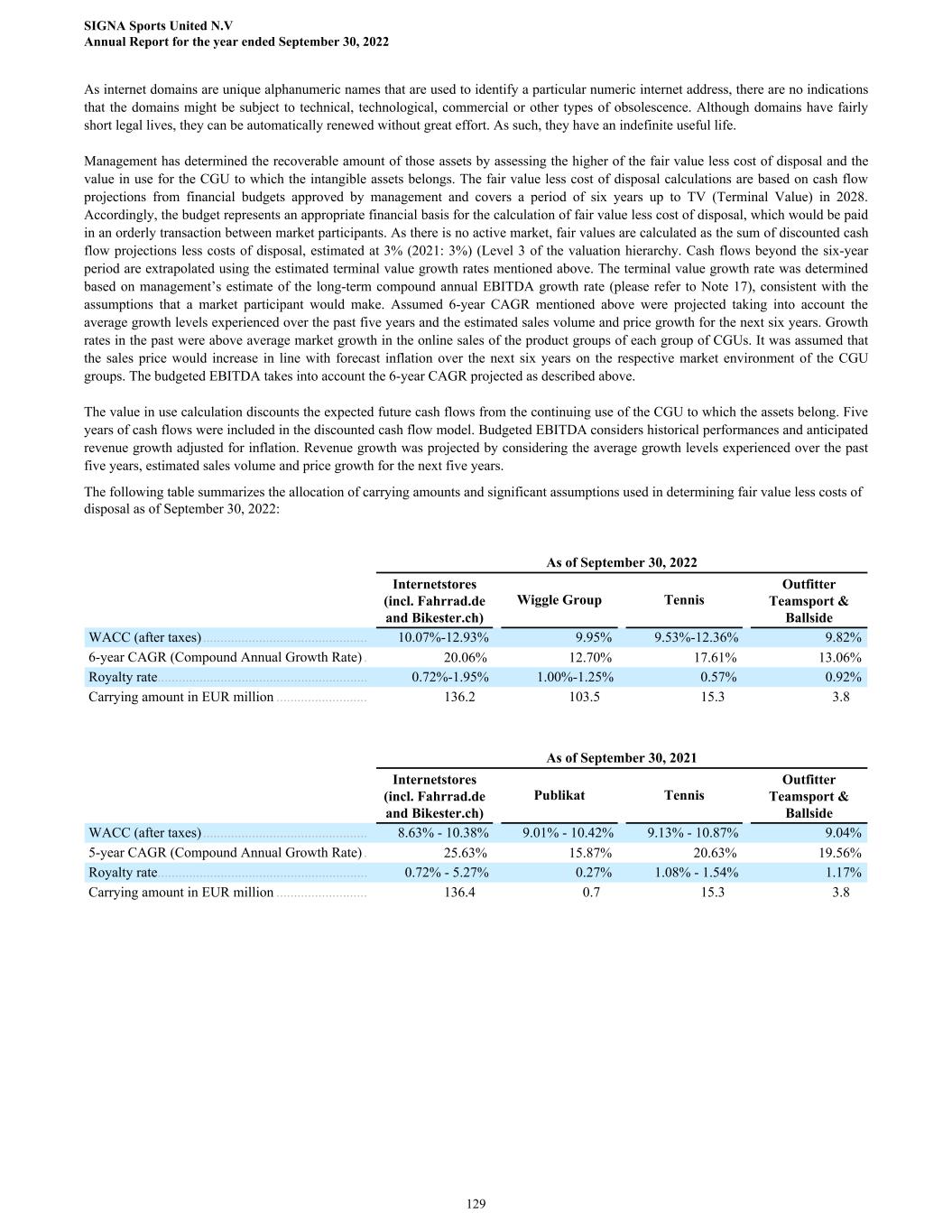
As internet domains are unique alphanumeric names that are used to identify a particular numeric internet address, there are no indications that the domains might be subject to technical, technological, commercial or other types of obsolescence. Although domains have fairly short legal lives, they can be automatically renewed without great effort. As such, they have an indefinite useful life. Management has determined the recoverable amount of those assets by assessing the higher of the fair value less cost of disposal and the value in use for the CGU to which the intangible assets belongs. The fair value less cost of disposal calculations are based on cash flow projections from financial budgets approved by management and covers a period of six years up to TV (Terminal Value) in 2028. Accordingly, the budget represents an appropriate financial basis for the calculation of fair value less cost of disposal, which would be paid in an orderly transaction between market participants. As there is no active market, fair values are calculated as the sum of discounted cash flow projections less costs of disposal, estimated at 3% (2021: 3%) (Level 3 of the valuation hierarchy. Cash flows beyond the six-year period are extrapolated using the estimated terminal value growth rates mentioned above. The terminal value growth rate was determined based on management’s estimate of the long-term compound annual EBITDA growth rate (please refer to Note 17), consistent with the assumptions that a market participant would make. Assumed 6-year CAGR mentioned above were projected taking into account the average growth levels experienced over the past five years and the estimated sales volume and price growth for the next six years. Growth rates in the past were above average market growth in the online sales of the product groups of each group of CGUs. It was assumed that the sales price would increase in line with forecast inflation over the next six years on the respective market environment of the CGU groups. The budgeted EBITDA takes into account the 6-year CAGR projected as described above. The value in use calculation discounts the expected future cash flows from the continuing use of the CGU to which the assets belong. Five years of cash flows were included in the discounted cash flow model. Budgeted EBITDA considers historical performances and anticipated revenue growth adjusted for inflation. Revenue growth was projected by considering the average growth levels experienced over the past five years, estimated sales volume and price growth for the next five years. The following table summarizes the allocation of carrying amounts and significant assumptions used in determining fair value less costs of disposal as of September 30, 2022: As of September 30, 2022 Internetstores (incl. Fahrrad.de and Bikester.ch) Wiggle Group Tennis Outfitter Teamsport & Ballside WACC (after taxes) ............................................... 10.07%-12.93% 9.95% 9.53%-12.36% 9.82% 6-year CAGR (Compound Annual Growth Rate) . 20.06% 12.70% 17.61% 13.06% Royalty rate ............................................................ 0.72%-1.95% 1.00%-1.25% 0.57% 0.92% Carrying amount in EUR million .......................... 136.2 103.5 15.3 3.8 As of September 30, 2021 Internetstores (incl. Fahrrad.de and Bikester.ch) Publikat Tennis Outfitter Teamsport & Ballside WACC (after taxes) ............................................... 8.63% - 10.38% 9.01% - 10.42% 9.13% - 10.87% 9.04% 5-year CAGR (Compound Annual Growth Rate) . 25.63% 15.87% 20.63% 19.56% Royalty rate ............................................................ 0.72% - 5.27% 0.27% 1.08% - 1.54% 1.17% Carrying amount in EUR million .......................... 136.4 0.7 15.3 3.8 SIGNA Sports United N.V Annual Report for the year ended September 30, 2022 129
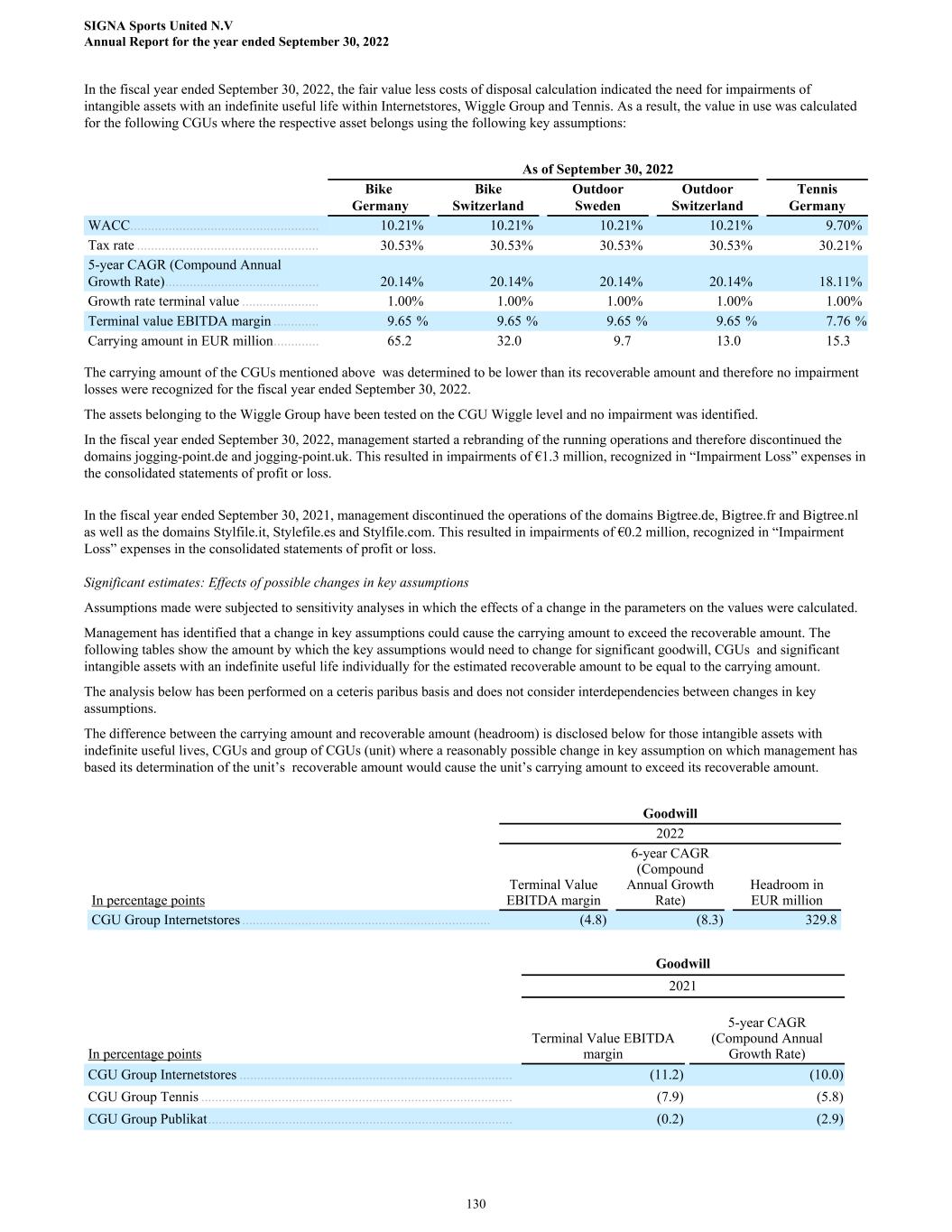
In the fiscal year ended September 30, 2022, the fair value less costs of disposal calculation indicated the need for impairments of intangible assets with an indefinite useful life within Internetstores, Wiggle Group and Tennis. As a result, the value in use was calculated for the following CGUs where the respective asset belongs using the following key assumptions: As of September 30, 2022 Bike Germany Bike Switzerland Outdoor Sweden Outdoor Switzerland Tennis Germany WACC ...................................................... 10.21% 10.21% 10.21% 10.21% 9.70% Tax rate .................................................... 30.53% 30.53% 30.53% 30.53% 30.21% 5-year CAGR (Compound Annual Growth Rate) ............................................ 20.14% 20.14% 20.14% 20.14% 18.11% Growth rate terminal value ...................... 1.00% 1.00% 1.00% 1.00% 1.00% Terminal value EBITDA margin ............. 9.65 % 9.65 % 9.65 % 9.65 % 7.76 % Carrying amount in EUR million ............. 65.2 32.0 9.7 13.0 15.3 The carrying amount of the CGUs mentioned above was determined to be lower than its recoverable amount and therefore no impairment losses were recognized for the fiscal year ended September 30, 2022. The assets belonging to the Wiggle Group have been tested on the CGU Wiggle level and no impairment was identified. In the fiscal year ended September 30, 2022, management started a rebranding of the running operations and therefore discontinued the domains jogging-point.de and jogging-point.uk. This resulted in impairments of €1.3 million, recognized in “Impairment Loss” expenses in the consolidated statements of profit or loss. In the fiscal year ended September 30, 2021, management discontinued the operations of the domains Bigtree.de, Bigtree.fr and Bigtree.nl as well as the domains Stylfile.it, Stylefile.es and Stylfile.com. This resulted in impairments of €0.2 million, recognized in “Impairment Loss” expenses in the consolidated statements of profit or loss. Significant estimates: Effects of possible changes in key assumptions Assumptions made were subjected to sensitivity analyses in which the effects of a change in the parameters on the values were calculated. Management has identified that a change in key assumptions could cause the carrying amount to exceed the recoverable amount. The following tables show the amount by which the key assumptions would need to change for significant goodwill, CGUs and significant intangible assets with an indefinite useful life individually for the estimated recoverable amount to be equal to the carrying amount. The analysis below has been performed on a ceteris paribus basis and does not consider interdependencies between changes in key assumptions. The difference between the carrying amount and recoverable amount (headroom) is disclosed below for those intangible assets with indefinite useful lives, CGUs and group of CGUs (unit) where a reasonably possible change in key assumption on which management has based its determination of the unit’s recoverable amount would cause the unit’s carrying amount to exceed its recoverable amount. Goodwill 2022 In percentage points Terminal Value EBITDA margin 6-year CAGR (Compound Annual Growth Rate) Headroom in EUR million CGU Group Internetstores ....................................................................... (4.8) (8.3) 329.8 Goodwill 2021 In percentage points Terminal Value EBITDA margin 5-year CAGR (Compound Annual Growth Rate) CGU Group Internetstores .............................................................................. (11.2) (10.0) CGU Group Tennis ......................................................................................... (7.9) (5.8) CGU Group Publikat ....................................................................................... (0.2) (2.9) SIGNA Sports United N.V Annual Report for the year ended September 30, 2022 130
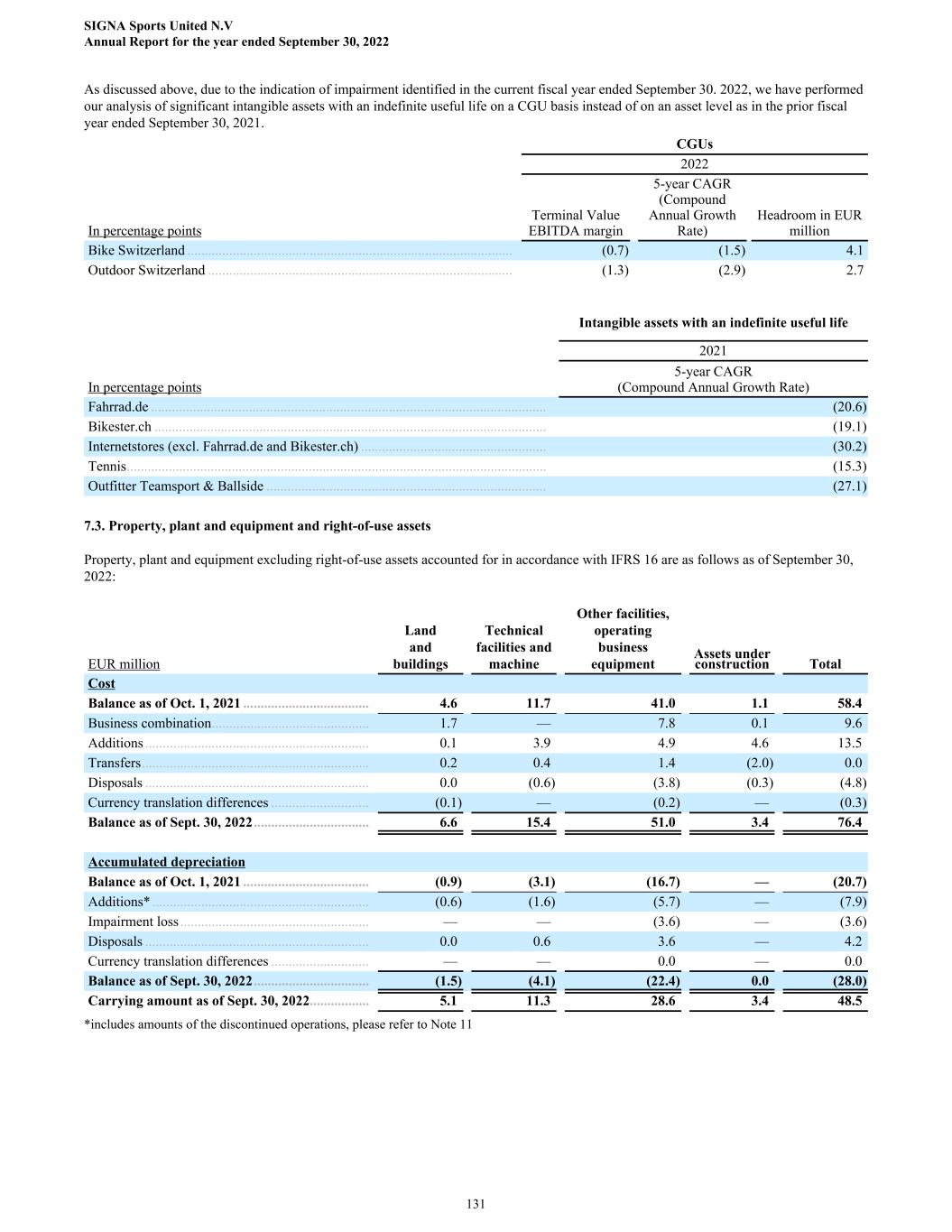
As discussed above, due to the indication of impairment identified in the current fiscal year ended September 30. 2022, we have performed our analysis of significant intangible assets with an indefinite useful life on a CGU basis instead of on an asset level as in the prior fiscal year ended September 30, 2021. CGUs 2022 In percentage points Terminal Value EBITDA margin 5-year CAGR (Compound Annual Growth Rate) Headroom in EUR million Bike Switzerland ............................................................................................. (0.7) (1.5) 4.1 Outdoor Switzerland ....................................................................................... (1.3) (2.9) 2.7 Intangible assets with an indefinite useful life 2021 In percentage points 5-year CAGR (Compound Annual Growth Rate) Fahrrad.de ................................................................................................................. (20.6) Bikester.ch ................................................................................................................ (19.1) Internetstores (excl. Fahrrad.de and Bikester.ch) ..................................................... (30.2) Tennis ........................................................................................................................ (15.3) Outfitter Teamsport & Ballside ................................................................................ (27.1) 7.3. Property, plant and equipment and right-of-use assets Property, plant and equipment excluding right-of-use assets accounted for in accordance with IFRS 16 are as follows as of September 30, 2022: EUR million Land and buildings Technical facilities and machine Other facilities, operating business equipment Assets under construction Total Cost Balance as of Oct. 1, 2021 .................................... 4.6 11.7 41.0 1.1 58.4 Business combination ............................................. 1.7 — 7.8 0.1 9.6 Additions ................................................................ 0.1 3.9 4.9 4.6 13.5 Transfers ................................................................. 0.2 0.4 1.4 (2.0) 0.0 Disposals ................................................................ 0.0 (0.6) (3.8) (0.3) (4.8) Currency translation differences ............................ (0.1) — (0.2) — (0.3) Balance as of Sept. 30, 2022 ................................. 6.6 15.4 51.0 3.4 76.4 Accumulated depreciation Balance as of Oct. 1, 2021 .................................... (0.9) (3.1) (16.7) — (20.7) Additions* .............................................................. (0.6) (1.6) (5.7) — (7.9) Impairment loss ...................................................... — — (3.6) — (3.6) Disposals ................................................................ 0.0 0.6 3.6 — 4.2 Currency translation differences ............................ — — 0.0 — 0.0 Balance as of Sept. 30, 2022 ................................. (1.5) (4.1) (22.4) 0.0 (28.0) Carrying amount as of Sept. 30, 2022 ................. 5.1 11.3 28.6 3.4 48.5 *includes amounts of the discontinued operations, please refer to Note 11 SIGNA Sports United N.V Annual Report for the year ended September 30, 2022 131
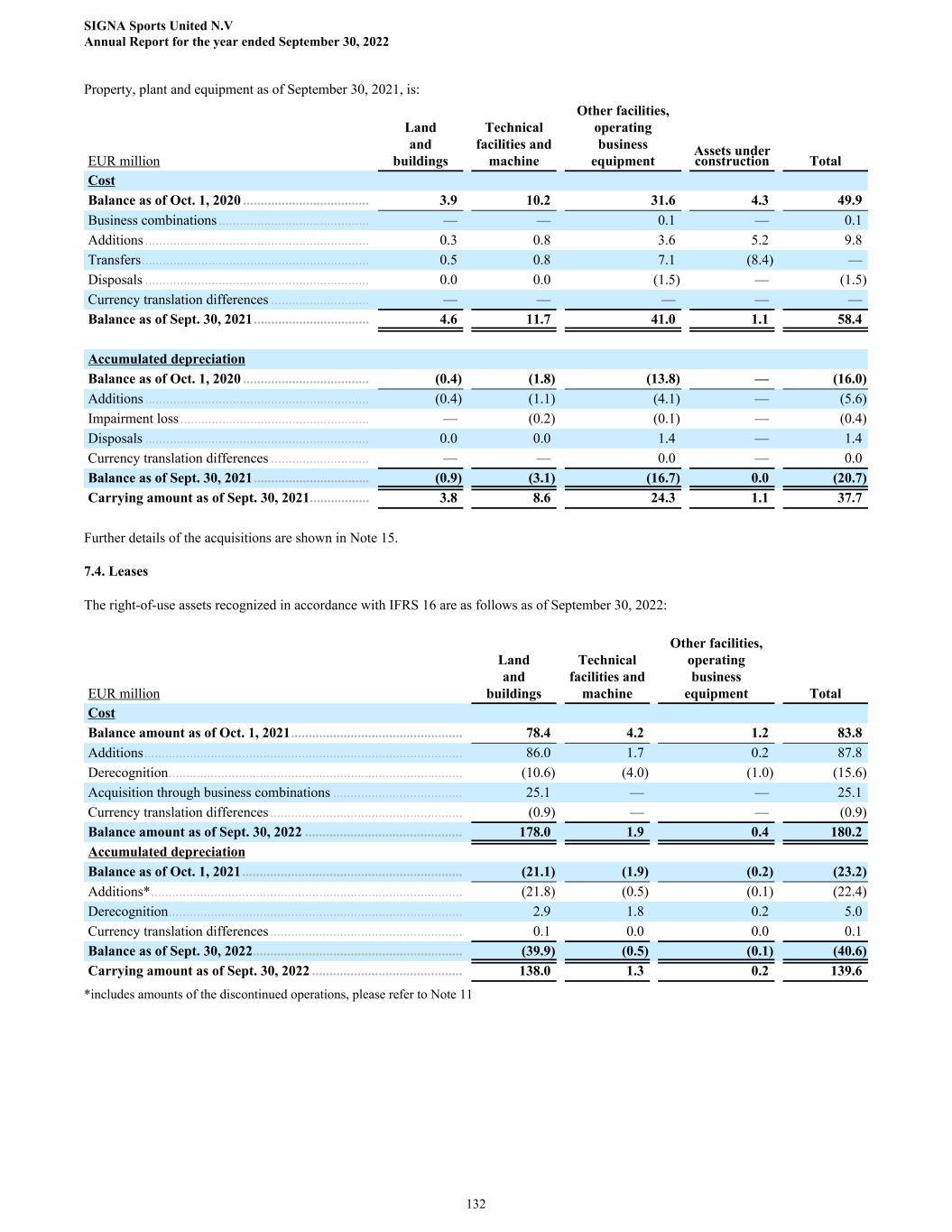
Property, plant and equipment as of September 30, 2021, is: EUR million Land and buildings Technical facilities and machine Other facilities, operating business equipment Assets under construction Total Cost Balance as of Oct. 1, 2020 .................................... 3.9 10.2 31.6 4.3 49.9 Business combinations ........................................... — — 0.1 — 0.1 Additions ................................................................ 0.3 0.8 3.6 5.2 9.8 Transfers ................................................................. 0.5 0.8 7.1 (8.4) — Disposals ................................................................ 0.0 0.0 (1.5) — (1.5) Currency translation differences ............................ — — — — — Balance as of Sept. 30, 2021 ................................. 4.6 11.7 41.0 1.1 58.4 Accumulated depreciation Balance as of Oct. 1, 2020 .................................... (0.4) (1.8) (13.8) — (16.0) Additions ................................................................ (0.4) (1.1) (4.1) — (5.6) Impairment loss ...................................................... — (0.2) (0.1) — (0.4) Disposals ................................................................ 0.0 0.0 1.4 — 1.4 Currency translation differences ............................ — — 0.0 — 0.0 Balance as of Sept. 30, 2021 ................................. (0.9) (3.1) (16.7) 0.0 (20.7) Carrying amount as of Sept. 30, 2021 ................. 3.8 8.6 24.3 1.1 37.7 Further details of the acquisitions are shown in Note 15. 7.4. Leases The right-of-use assets recognized in accordance with IFRS 16 are as follows as of September 30, 2022: EUR million Land and buildings Technical facilities and machine Other facilities, operating business equipment Total Cost Balance amount as of Oct. 1, 2021 ................................................. 78.4 4.2 1.2 83.8 Additions ........................................................................................... 86.0 1.7 0.2 87.8 Derecognition .................................................................................... (10.6) (4.0) (1.0) (15.6) Acquisition through business combinations ..................................... 25.1 — — 25.1 Currency translation differences ....................................................... (0.9) — — (0.9) Balance amount as of Sept. 30, 2022 ............................................. 178.0 1.9 0.4 180.2 Accumulated depreciation Balance as of Oct. 1, 2021 ............................................................... (21.1) (1.9) (0.2) (23.2) Additions* ......................................................................................... (21.8) (0.5) (0.1) (22.4) Derecognition .................................................................................... 2.9 1.8 0.2 5.0 Currency translation differences ....................................................... 0.1 0.0 0.0 0.1 Balance as of Sept. 30, 2022 ............................................................ (39.9) (0.5) (0.1) (40.6) Carrying amount as of Sept. 30, 2022 ........................................... 138.0 1.3 0.2 139.6 *includes amounts of the discontinued operations, please refer to Note 11 SIGNA Sports United N.V Annual Report for the year ended September 30, 2022 132
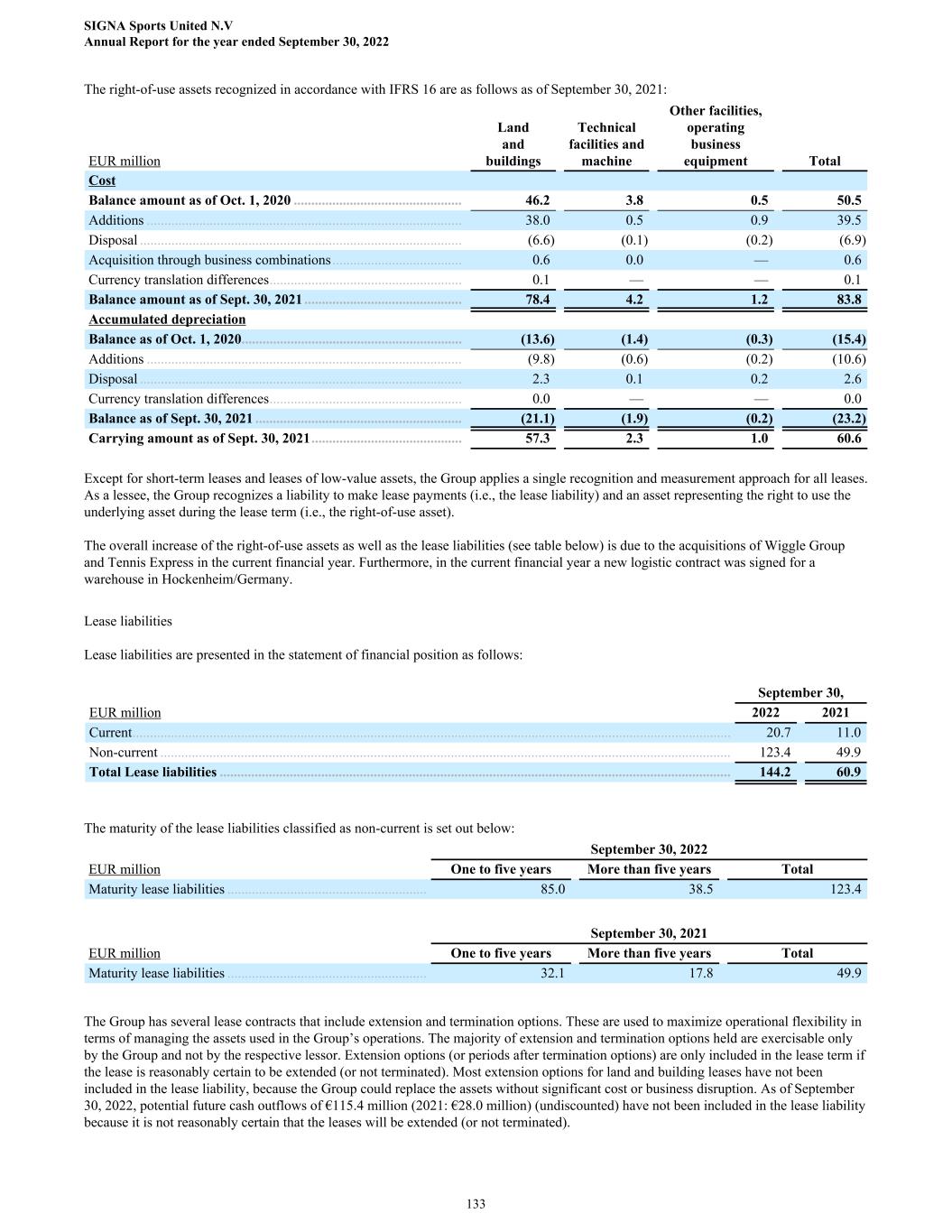
The right-of-use assets recognized in accordance with IFRS 16 are as follows as of September 30, 2021: EUR million Land and buildings Technical facilities and machine Other facilities, operating business equipment Total Cost Balance amount as of Oct. 1, 2020 ................................................ 46.2 3.8 0.5 50.5 Additions .......................................................................................... 38.0 0.5 0.9 39.5 Disposal ............................................................................................ (6.6) (0.1) (0.2) (6.9) Acquisition through business combinations ..................................... 0.6 0.0 — 0.6 Currency translation differences ....................................................... 0.1 — — 0.1 Balance amount as of Sept. 30, 2021 ............................................. 78.4 4.2 1.2 83.8 Accumulated depreciation Balance as of Oct. 1, 2020 ............................................................... (13.6) (1.4) (0.3) (15.4) Additions .......................................................................................... (9.8) (0.6) (0.2) (10.6) Disposal ............................................................................................ 2.3 0.1 0.2 2.6 Currency translation differences ....................................................... 0.0 — — 0.0 Balance as of Sept. 30, 2021 ........................................................... (21.1) (1.9) (0.2) (23.2) Carrying amount as of Sept. 30, 2021 ........................................... 57.3 2.3 1.0 60.6 Except for short-term leases and leases of low-value assets, the Group applies a single recognition and measurement approach for all leases. As a lessee, the Group recognizes a liability to make lease payments (i.e., the lease liability) and an asset representing the right to use the underlying asset during the lease term (i.e., the right-of-use asset). The overall increase of the right-of-use assets as well as the lease liabilities (see table below) is due to the acquisitions of Wiggle Group and Tennis Express in the current financial year. Furthermore, in the current financial year a new logistic contract was signed for a warehouse in Hockenheim/Germany. Lease liabilities Lease liabilities are presented in the statement of financial position as follows: September 30, EUR million 2022 2021 Current ........................................................................................................................................................................... 20.7 11.0 Non-current ................................................................................................................................................................... 123.4 49.9 Total Lease liabilities .................................................................................................................................................. 144.2 60.9 The maturity of the lease liabilities classified as non-current is set out below: September 30, 2022 EUR million One to five years More than five years Total Maturity lease liabilities ......................................................... 85.0 38.5 123.4 September 30, 2021 EUR million One to five years More than five years Total Maturity lease liabilities ......................................................... 32.1 17.8 49.9 The Group has several lease contracts that include extension and termination options. These are used to maximize operational flexibility in terms of managing the assets used in the Group’s operations. The majority of extension and termination options held are exercisable only by the Group and not by the respective lessor. Extension options (or periods after termination options) are only included in the lease term if the lease is reasonably certain to be extended (or not terminated). Most extension options for land and building leases have not been included in the lease liability, because the Group could replace the assets without significant cost or business disruption. As of September 30, 2022, potential future cash outflows of €115.4 million (2021: €28.0 million) (undiscounted) have not been included in the lease liability because it is not reasonably certain that the leases will be extended (or not terminated). SIGNA Sports United N.V Annual Report for the year ended September 30, 2022 133
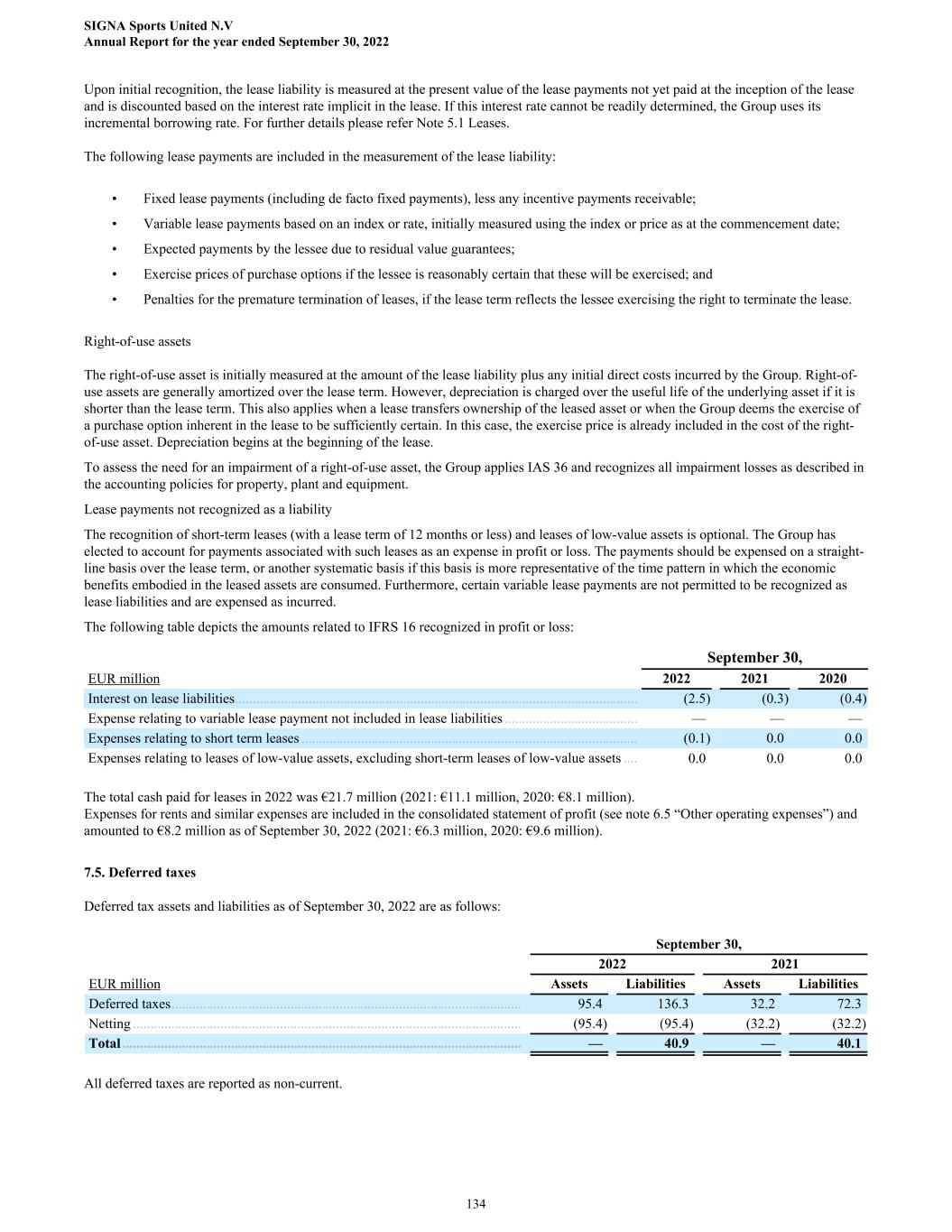
Upon initial recognition, the lease liability is measured at the present value of the lease payments not yet paid at the inception of the lease and is discounted based on the interest rate implicit in the lease. If this interest rate cannot be readily determined, the Group uses its incremental borrowing rate. For further details please refer Note 5.1 Leases. The following lease payments are included in the measurement of the lease liability: • Fixed lease payments (including de facto fixed payments), less any incentive payments receivable; • Variable lease payments based on an index or rate, initially measured using the index or price as at the commencement date; • Expected payments by the lessee due to residual value guarantees; • Exercise prices of purchase options if the lessee is reasonably certain that these will be exercised; and • Penalties for the premature termination of leases, if the lease term reflects the lessee exercising the right to terminate the lease. Right-of-use assets The right-of-use asset is initially measured at the amount of the lease liability plus any initial direct costs incurred by the Group. Right-of- use assets are generally amortized over the lease term. However, depreciation is charged over the useful life of the underlying asset if it is shorter than the lease term. This also applies when a lease transfers ownership of the leased asset or when the Group deems the exercise of a purchase option inherent in the lease to be sufficiently certain. In this case, the exercise price is already included in the cost of the right- of-use asset. Depreciation begins at the beginning of the lease. To assess the need for an impairment of a right-of-use asset, the Group applies IAS 36 and recognizes all impairment losses as described in the accounting policies for property, plant and equipment. Lease payments not recognized as a liability The recognition of short-term leases (with a lease term of 12 months or less) and leases of low-value assets is optional. The Group has elected to account for payments associated with such leases as an expense in profit or loss. The payments should be expensed on a straight- line basis over the lease term, or another systematic basis if this basis is more representative of the time pattern in which the economic benefits embodied in the leased assets are consumed. Furthermore, certain variable lease payments are not permitted to be recognized as lease liabilities and are expensed as incurred. The following table depicts the amounts related to IFRS 16 recognized in profit or loss: September 30, EUR million 2022 2021 2020 Interest on lease liabilities ................................................................................................................... (2.5) (0.3) (0.4) Expense relating to variable lease payment not included in lease liabilities ...................................... — — — Expenses relating to short term leases ................................................................................................ (0.1) 0.0 0.0 Expenses relating to leases of low-value assets, excluding short-term leases of low-value assets .... 0.0 0.0 0.0 The total cash paid for leases in 2022 was €21.7 million (2021: €11.1 million, 2020: €8.1 million). Expenses for rents and similar expenses are included in the consolidated statement of profit (see note 6.5 “Other operating expenses”) and amounted to €8.2 million as of September 30, 2022 (2021: €6.3 million, 2020: €9.6 million). 7.5. Deferred taxes Deferred tax assets and liabilities as of September 30, 2022 are as follows: September 30, 2022 2021 EUR million Assets Liabilities Assets Liabilities Deferred taxes .................................................................................................... 95.4 136.3 32.2 72.3 Netting ............................................................................................................... (95.4) (95.4) (32.2) (32.2) Total .................................................................................................................. — 40.9 — 40.1 All deferred taxes are reported as non-current. SIGNA Sports United N.V Annual Report for the year ended September 30, 2022 134
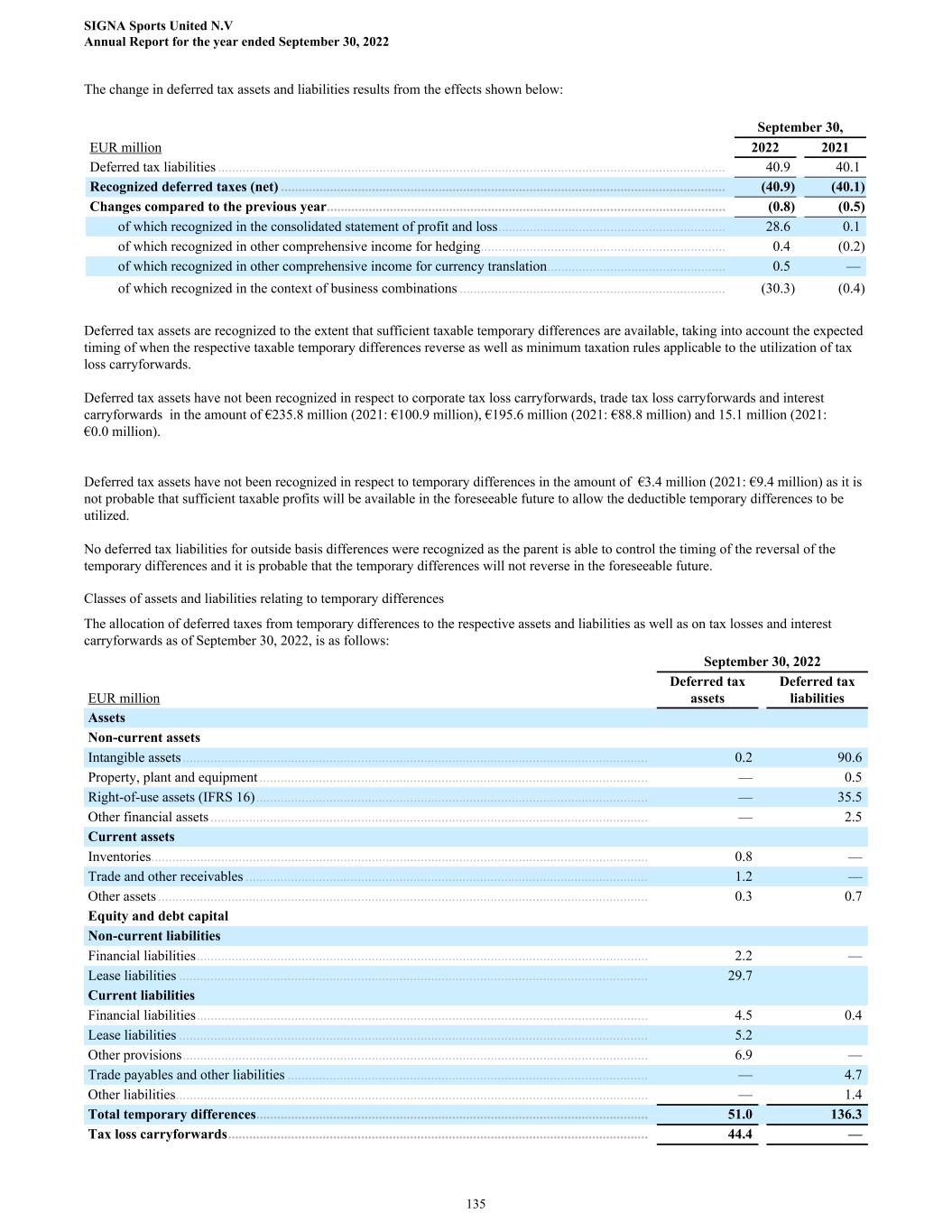
The change in deferred tax assets and liabilities results from the effects shown below: September 30, EUR million 2022 2021 Deferred tax liabilities ................................................................................................................................................. 40.9 40.1 Recognized deferred taxes (net) ............................................................................................................................... (40.9) (40.1) Changes compared to the previous year .................................................................................................................. (0.8) (0.5) of which recognized in the consolidated statement of profit and loss ................................................................. 28.6 0.1 of which recognized in other comprehensive income for hedging ...................................................................... 0.4 (0.2) of which recognized in other comprehensive income for currency translation ................................................... 0.5 — of which recognized in the context of business combinations ............................................................................ (30.3) (0.4) Deferred tax assets are recognized to the extent that sufficient taxable temporary differences are available, taking into account the expected timing of when the respective taxable temporary differences reverse as well as minimum taxation rules applicable to the utilization of tax loss carryforwards. Deferred tax assets have not been recognized in respect to corporate tax loss carryforwards, trade tax loss carryforwards and interest carryforwards in the amount of €235.8 million (2021: €100.9 million), €195.6 million (2021: €88.8 million) and 15.1 million (2021: €0.0 million). Deferred tax assets have not been recognized in respect to temporary differences in the amount of €3.4 million (2021: €9.4 million) as it is not probable that sufficient taxable profits will be available in the foreseeable future to allow the deductible temporary differences to be utilized. No deferred tax liabilities for outside basis differences were recognized as the parent is able to control the timing of the reversal of the temporary differences and it is probable that the temporary differences will not reverse in the foreseeable future. Classes of assets and liabilities relating to temporary differences The allocation of deferred taxes from temporary differences to the respective assets and liabilities as well as on tax losses and interest carryforwards as of September 30, 2022, is as follows: September 30, 2022 EUR million Deferred tax assets Deferred tax liabilities Assets Non-current assets Intangible assets ..................................................................................................................................... 0.2 90.6 Property, plant and equipment ............................................................................................................... — 0.5 Right-of-use assets (IFRS 16) ................................................................................................................ — 35.5 Other financial assets ............................................................................................................................. — 2.5 Current assets Inventories .............................................................................................................................................. 0.8 — Trade and other receivables ................................................................................................................... 1.2 — Other assets ............................................................................................................................................ 0.3 0.7 Equity and debt capital Non-current liabilities Financial liabilities ................................................................................................................................. 2.2 — Lease liabilities ...................................................................................................................................... 29.7 Current liabilities Financial liabilities ................................................................................................................................. 4.5 0.4 Lease liabilities ...................................................................................................................................... 5.2 Other provisions ..................................................................................................................................... 6.9 — Trade payables and other liabilities ....................................................................................................... — 4.7 Other liabilities ....................................................................................................................................... — 1.4 Total temporary differences ................................................................................................................ 51.0 136.3 Tax loss carryforwards ........................................................................................................................ 44.4 — SIGNA Sports United N.V Annual Report for the year ended September 30, 2022 135
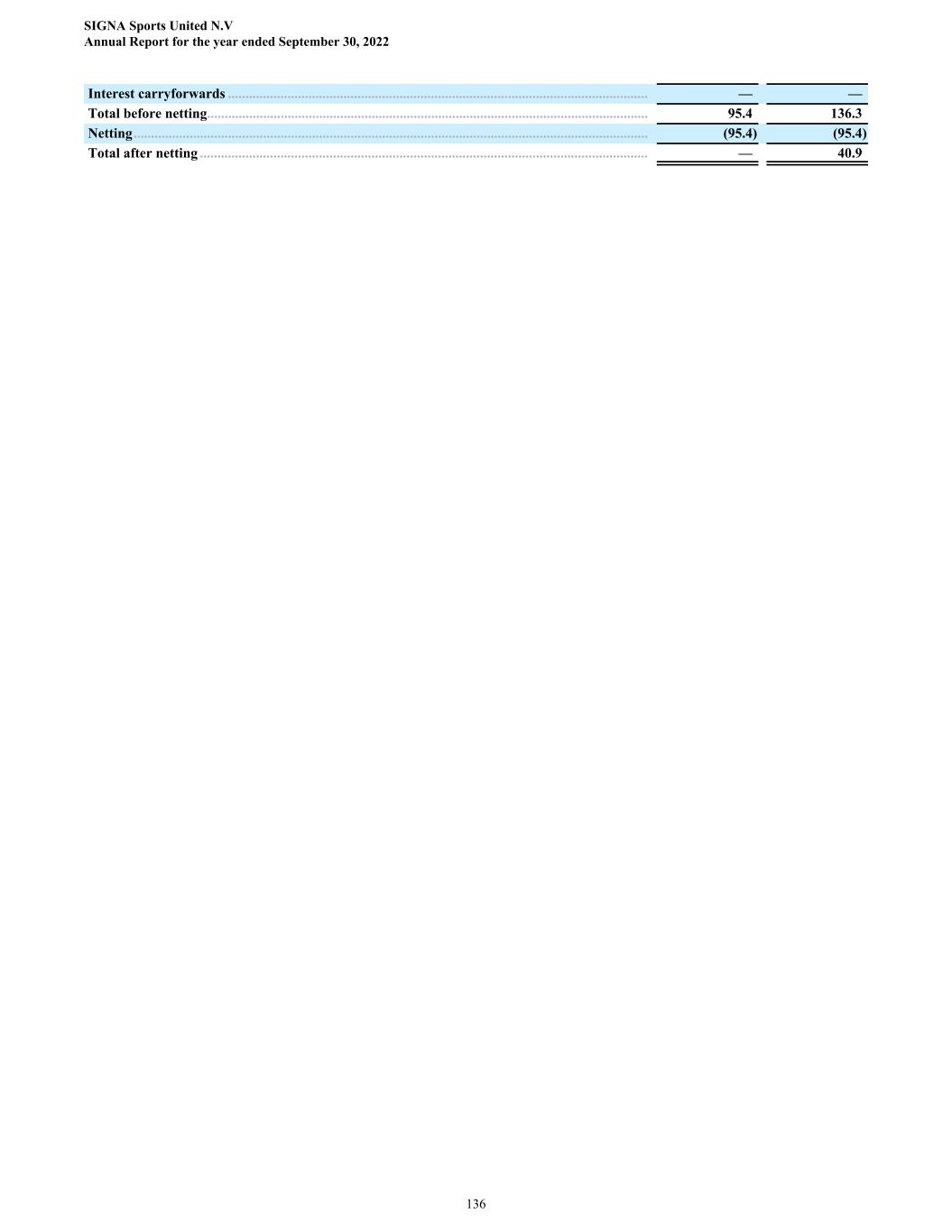
Interest carryforwards ........................................................................................................................ — — Total before netting .............................................................................................................................. 95.4 136.3 Netting ................................................................................................................................................... (95.4) (95.4) Total after netting ................................................................................................................................ — 40.9 SIGNA Sports United N.V Annual Report for the year ended September 30, 2022 136
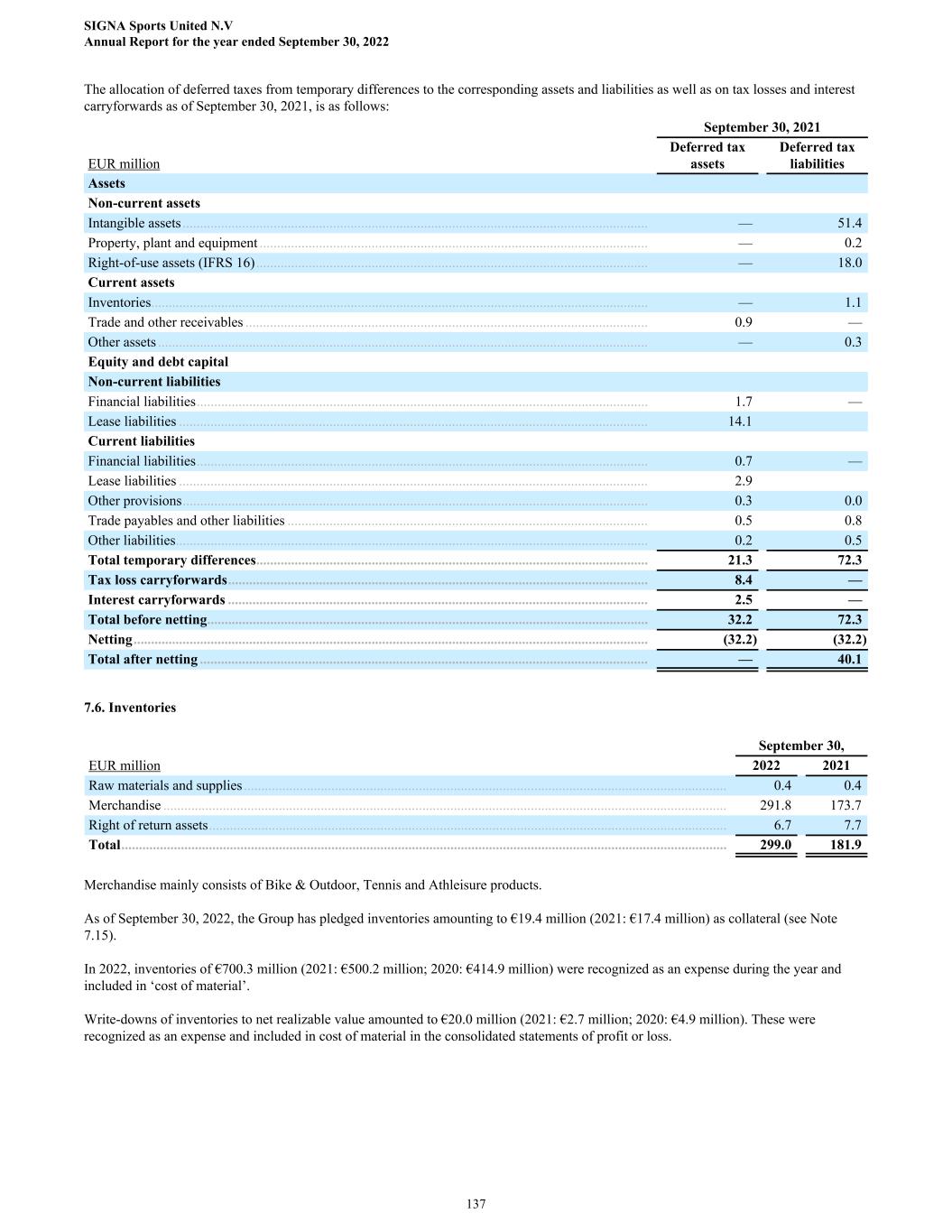
The allocation of deferred taxes from temporary differences to the corresponding assets and liabilities as well as on tax losses and interest carryforwards as of September 30, 2021, is as follows: September 30, 2021 EUR million Deferred tax assets Deferred tax liabilities Assets Non-current assets Intangible assets ..................................................................................................................................... — 51.4 Property, plant and equipment ............................................................................................................... — 0.2 Right-of-use assets (IFRS 16) ................................................................................................................ — 18.0 Current assets Inventories .............................................................................................................................................. — 1.1 Trade and other receivables ................................................................................................................... 0.9 — Other assets ............................................................................................................................................ — 0.3 Equity and debt capital Non-current liabilities Financial liabilities ................................................................................................................................. 1.7 — Lease liabilities ...................................................................................................................................... 14.1 Current liabilities Financial liabilities ................................................................................................................................. 0.7 — Lease liabilities ...................................................................................................................................... 2.9 Other provisions ..................................................................................................................................... 0.3 0.0 Trade payables and other liabilities ....................................................................................................... 0.5 0.8 Other liabilities ....................................................................................................................................... 0.2 0.5 Total temporary differences ................................................................................................................ 21.3 72.3 Tax loss carryforwards ........................................................................................................................ 8.4 — Interest carryforwards ........................................................................................................................ 2.5 — Total before netting .............................................................................................................................. 32.2 72.3 Netting ................................................................................................................................................... (32.2) (32.2) Total after netting ................................................................................................................................ — 40.1 7.6. Inventories September 30, EUR million 2022 2021 Raw materials and supplies .......................................................................................................................................... 0.4 0.4 Merchandise ................................................................................................................................................................. 291.8 173.7 Right of return assets .................................................................................................................................................... 6.7 7.7 Total ............................................................................................................................................................................. 299.0 181.9 Merchandise mainly consists of Bike & Outdoor, Tennis and Athleisure products. As of September 30, 2022, the Group has pledged inventories amounting to €19.4 million (2021: €17.4 million) as collateral (see Note 7.15). In 2022, inventories of €700.3 million (2021: €500.2 million; 2020: €414.9 million) were recognized as an expense during the year and included in ‘cost of material’. Write-downs of inventories to net realizable value amounted to €20.0 million (2021: €2.7 million; 2020: €4.9 million). These were recognized as an expense and included in cost of material in the consolidated statements of profit or loss. SIGNA Sports United N.V Annual Report for the year ended September 30, 2022 137
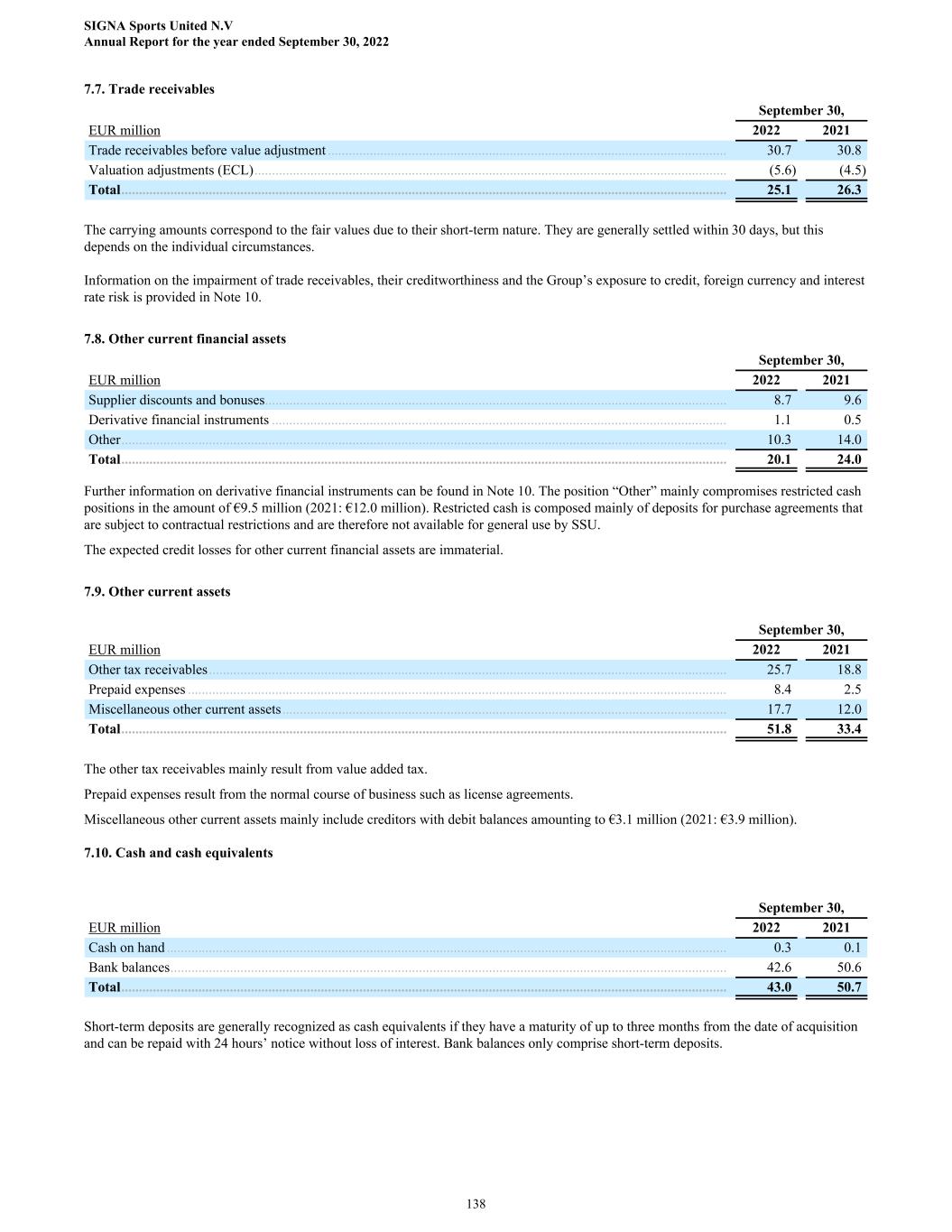
7.7. Trade receivables September 30, EUR million 2022 2021 Trade receivables before value adjustment .................................................................................................................. 30.7 30.8 Valuation adjustments (ECL) ....................................................................................................................................... (5.6) (4.5) Total ............................................................................................................................................................................. 25.1 26.3 The carrying amounts correspond to the fair values due to their short-term nature. They are generally settled within 30 days, but this depends on the individual circumstances. Information on the impairment of trade receivables, their creditworthiness and the Group’s exposure to credit, foreign currency and interest rate risk is provided in Note 10. 7.8. Other current financial assets September 30, EUR million 2022 2021 Supplier discounts and bonuses .................................................................................................................................... 8.7 9.6 Derivative financial instruments .................................................................................................................................. 1.1 0.5 Other ............................................................................................................................................................................. 10.3 14.0 Total ............................................................................................................................................................................. 20.1 24.0 Further information on derivative financial instruments can be found in Note 10. The position “Other” mainly compromises restricted cash positions in the amount of €9.5 million (2021: €12.0 million). Restricted cash is composed mainly of deposits for purchase agreements that are subject to contractual restrictions and are therefore not available for general use by SSU. The expected credit losses for other current financial assets are immaterial. 7.9. Other current assets September 30, EUR million 2022 2021 Other tax receivables .................................................................................................................................................... 25.7 18.8 Prepaid expenses .......................................................................................................................................................... 8.4 2.5 Miscellaneous other current assets ............................................................................................................................... 17.7 12.0 Total ............................................................................................................................................................................. 51.8 33.4 The other tax receivables mainly result from value added tax. Prepaid expenses result from the normal course of business such as license agreements. Miscellaneous other current assets mainly include creditors with debit balances amounting to €3.1 million (2021: €3.9 million). 7.10. Cash and cash equivalents September 30, EUR million 2022 2021 Cash on hand ................................................................................................................................................................ 0.3 0.1 Bank balances ............................................................................................................................................................... 42.6 50.6 Total ............................................................................................................................................................................. 43.0 50.7 Short-term deposits are generally recognized as cash equivalents if they have a maturity of up to three months from the date of acquisition and can be repaid with 24 hours’ notice without loss of interest. Bank balances only comprise short-term deposits. SIGNA Sports United N.V Annual Report for the year ended September 30, 2022 138
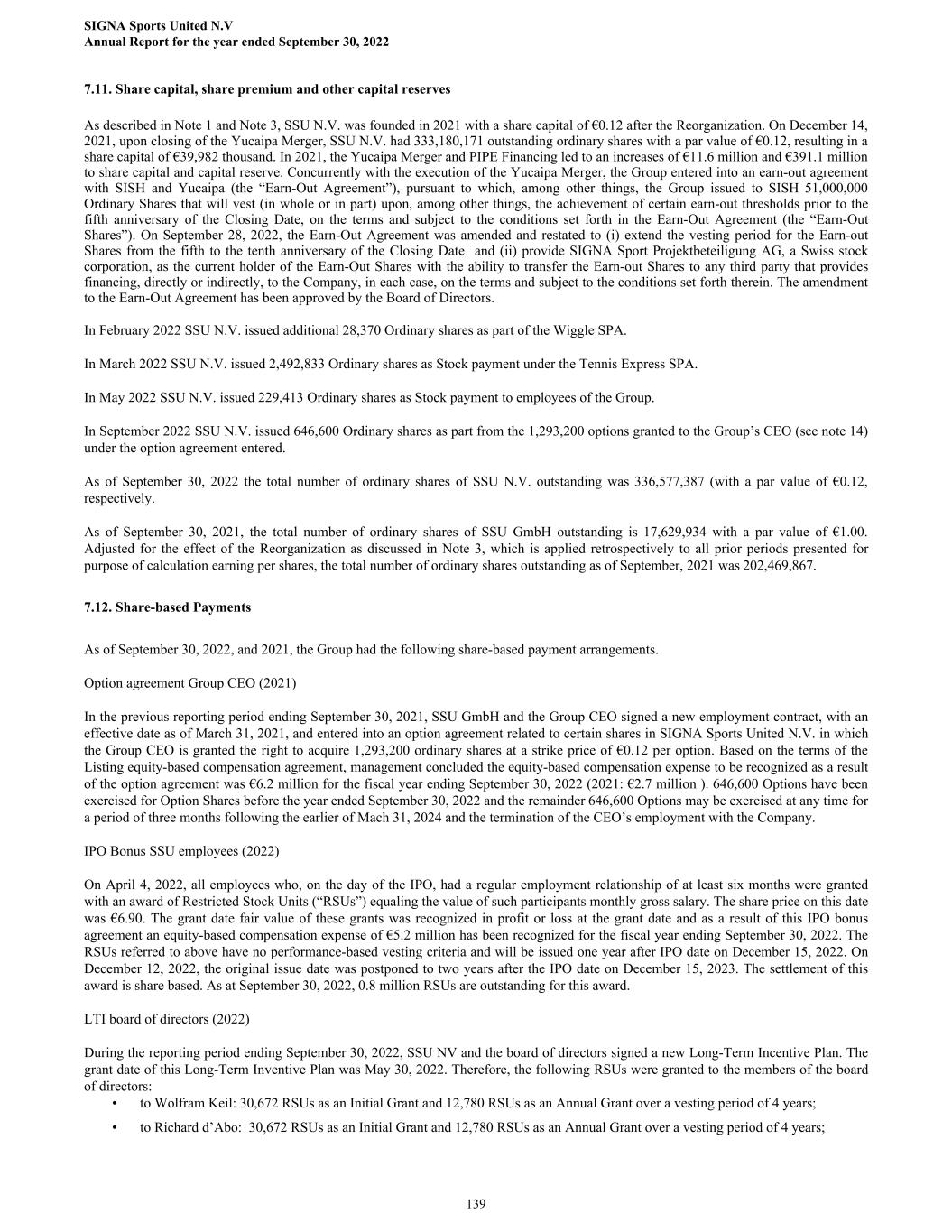
7.11. Share capital, share premium and other capital reserves As described in Note 1 and Note 3, SSU N.V. was founded in 2021 with a share capital of €0.12 after the Reorganization. On December 14, 2021, upon closing of the Yucaipa Merger, SSU N.V. had 333,180,171 outstanding ordinary shares with a par value of €0.12, resulting in a share capital of €39,982 thousand. In 2021, the Yucaipa Merger and PIPE Financing led to an increases of €11.6 million and €391.1 million to share capital and capital reserve. Concurrently with the execution of the Yucaipa Merger, the Group entered into an earn-out agreement with SISH and Yucaipa (the “Earn-Out Agreement”), pursuant to which, among other things, the Group issued to SISH 51,000,000 Ordinary Shares that will vest (in whole or in part) upon, among other things, the achievement of certain earn-out thresholds prior to the fifth anniversary of the Closing Date, on the terms and subject to the conditions set forth in the Earn-Out Agreement (the “Earn-Out Shares”). On September 28, 2022, the Earn-Out Agreement was amended and restated to (i) extend the vesting period for the Earn-out Shares from the fifth to the tenth anniversary of the Closing Date and (ii) provide SIGNA Sport Projektbeteiligung AG, a Swiss stock corporation, as the current holder of the Earn-Out Shares with the ability to transfer the Earn-out Shares to any third party that provides financing, directly or indirectly, to the Company, in each case, on the terms and subject to the conditions set forth therein. The amendment to the Earn-Out Agreement has been approved by the Board of Directors. In February 2022 SSU N.V. issued additional 28,370 Ordinary shares as part of the Wiggle SPA. In March 2022 SSU N.V. issued 2,492,833 Ordinary shares as Stock payment under the Tennis Express SPA. In May 2022 SSU N.V. issued 229,413 Ordinary shares as Stock payment to employees of the Group. In September 2022 SSU N.V. issued 646,600 Ordinary shares as part from the 1,293,200 options granted to the Group’s CEO (see note 14) under the option agreement entered. As of September 30, 2022 the total number of ordinary shares of SSU N.V. outstanding was 336,577,387 (with a par value of €0.12, respectively. As of September 30, 2021, the total number of ordinary shares of SSU GmbH outstanding is 17,629,934 with a par value of €1.00. Adjusted for the effect of the Reorganization as discussed in Note 3, which is applied retrospectively to all prior periods presented for purpose of calculation earning per shares, the total number of ordinary shares outstanding as of September, 2021 was 202,469,867. 7.12. Share-based Payments As of September 30, 2022, and 2021, the Group had the following share-based payment arrangements. Option agreement Group CEO (2021) In the previous reporting period ending September 30, 2021, SSU GmbH and the Group CEO signed a new employment contract, with an effective date as of March 31, 2021, and entered into an option agreement related to certain shares in SIGNA Sports United N.V. in which the Group CEO is granted the right to acquire 1,293,200 ordinary shares at a strike price of €0.12 per option. Based on the terms of the Listing equity-based compensation agreement, management concluded the equity-based compensation expense to be recognized as a result of the option agreement was €6.2 million for the fiscal year ending September 30, 2022 (2021: €2.7 million ). 646,600 Options have been exercised for Option Shares before the year ended September 30, 2022 and the remainder 646,600 Options may be exercised at any time for a period of three months following the earlier of Mach 31, 2024 and the termination of the CEO’s employment with the Company. IPO Bonus SSU employees (2022) On April 4, 2022, all employees who, on the day of the IPO, had a regular employment relationship of at least six months were granted with an award of Restricted Stock Units (“RSUs”) equaling the value of such participants monthly gross salary. The share price on this date was €6.90. The grant date fair value of these grants was recognized in profit or loss at the grant date and as a result of this IPO bonus agreement an equity-based compensation expense of €5.2 million has been recognized for the fiscal year ending September 30, 2022. The RSUs referred to above have no performance-based vesting criteria and will be issued one year after IPO date on December 15, 2022. On December 12, 2022, the original issue date was postponed to two years after the IPO date on December 15, 2023. The settlement of this award is share based. As at September 30, 2022, 0.8 million RSUs are outstanding for this award. LTI board of directors (2022) During the reporting period ending September 30, 2022, SSU NV and the board of directors signed a new Long-Term Incentive Plan. The grant date of this Long-Term Inventive Plan was May 30, 2022. Therefore, the following RSUs were granted to the members of the board of directors: • to Wolfram Keil: 30,672 RSUs as an Initial Grant and 12,780 RSUs as an Annual Grant over a vesting period of 4 years; • to Richard d’Abo: 30,672 RSUs as an Initial Grant and 12,780 RSUs as an Annual Grant over a vesting period of 4 years; SIGNA Sports United N.V Annual Report for the year ended September 30, 2022 139

• to Dr. Dieter Berninghaus: 30,672 RSUs as an Initial Grant and 12,780 RSUs as an Annual Grant over a vesting period of 4 years; • to Dr. Martin Wittig: 30,672 RSUs as an Initial Grant and 12,780 RSUs as an Annual Grant over a vesting period of 4 years; • to Christoph Keese: 30,672 RSUs as an Initial Grant and 12,780 RSUs as an Annual Grant over a vesting period of 4 years; • to Dr. Thomas Rudolph: 30,672 RSUs as an Initial Grant and 12,780 RSUs as an Annual Grant over a vesting period of 4 years. The Initial Grant vests in four equal installments on each anniversary of the one-, two-, three- and four-year anniversaries of the first day of trading of the Company’s shares on the New York Stock Exchange (December 15, 2021; the Listing Date). The Annual Grant vests on the first anniversary of the Listing Date or on subsequent anniversaries of the Listing Date. The RSUs referred to above have no performance-based vesting criteria. Each RSU represents a right to receive a payment in shares equal to the value of the RSU at the exercise date. The grant date fair value of these grants will be recognized in profit or loss over the service period by using the staged vesting approach. The share price on the grant date was €5.79. As a result of this Long-Term Incentive Plan an equity-based compensation expense of €0.6 million has been recognized for the fiscal year ending September 30, 2022. IPO Bonus SSU management In connection with the closing of the Business Combination, in November 2021, SSU and certain key executive officers of SSU and of its subsidiaries as well as certain senior employees of SSU entered into bonus agreements with a view to their legacy contractual rights to participate in a long-term incentive program to be established by SSU for time periods prior to the closing of the Business Combination and/or to receive a one-time bonus payment upon a successful listing. The aggregate nominal amount of the cash bonus payments to be made under these bonus agreements is €7.1 million. The bonus agreements contained an offer to the beneficiaries to convert all or part of their bonus entitlements from a cash payment to a grant in SSU shares which the majority of the beneficiaries accepted for all or part of their cash bonus entitlements. The relevant number of SSU shares to be granted to the beneficiaries are to be calculated, inter alia, on the basis of the volume-weighted average price of the SSU shares five days prior to the defined record date (initially May 16, 2022), with the shares to be delivered by no later than May 23, 2022. The record date (and accordingly the delivery date of these shares) was postponed to May 16, 2023 and May 23, 2023, respectively by amendment agreements entered into on May 12, 2022 with the relevant beneficiaries. In these amendment agreements, the beneficiaries were also granted a right to convert a certain amount of their bonus entitlements back to a cash payment. As at September 30, 2022, SSU shares in the amount of €3.8 million are outstanding. By resolution dated December 5, 2022, the Board approved an offer to be made to the beneficiaries under the amended bonus agreements to either have the relevant number of shares issued in May 2023 as defined in the amended bonus agreements or to convert the bonus payment claims back to payment in cash to be made on December 15, 2023. This offer will be formally made to the beneficiaries expectedly in March or April 2023. WCRC Exit Bonus On June 11, 2021, the board of directors from Mapil Topco Limited entered into an exit bonus scheme in the aggregate amount of €2.7 million payable in cash subject to the unconditional completion of the sale of Topco and its subsidiaries to Signa Sports United GmbH pursuant to the Wiggle SPA. On December 14, 2021, the exit bonus scheme was amended by individual agreements with the beneficiaries to reflect that up to 25% of the awards under the exit bonus scheme were to be satisfied by the issue of shares in SSU. The relevant number of shares to be granted to each beneficiary was determined on the basis of the individual bonus amounts and a formula contained in the amendment agreements to reflect the cash and payment in shares portion in the Wiggle SPA. The relevant number of SSU shares based on the individual bonus amounts to be granted to the beneficiaries were to be calculated, inter alia, on the basis of the volume-weighted average price of the SSU shares five days prior to the defined record date (initially May 16, 2022). The record date (and accordingly the delivery date of these shares) was postponed to May 16, 2023 and May 23, 2023, respectively by amendment agreements entered into on May 12, 2022 with the relevant beneficiaries. In these amendment agreements, the beneficiaries were also granted a right to convert a certain amount of their bonus entitlements back to a cash payment. As at September 30, 2022, SSU shares in the amount of €2.1 million is outstanding. By resolution dated December 5, 2022, the Board approved an offer to be made to the beneficiaries under the amended bonus agreements to either have the relevant number of shares issued in May 2023 as defined in the amended bonus agreements or to convert the bonus payment claims back to payment in cash to be made on December 15, 2023. This offer will be formally made to the beneficiaries expectedly in March or April 2023. WCRC Retention Bonus On June 9, 2022, selected employees of Wiggle CRC group were granted a one-time retention bonus with a total value of €1.2 million. According to the bonus agreement, the bonus will be settled with the issuance of ordinary shares of SIGNA Sports United N.V. in two SIGNA Sports United N.V Annual Report for the year ended September 30, 2022 140
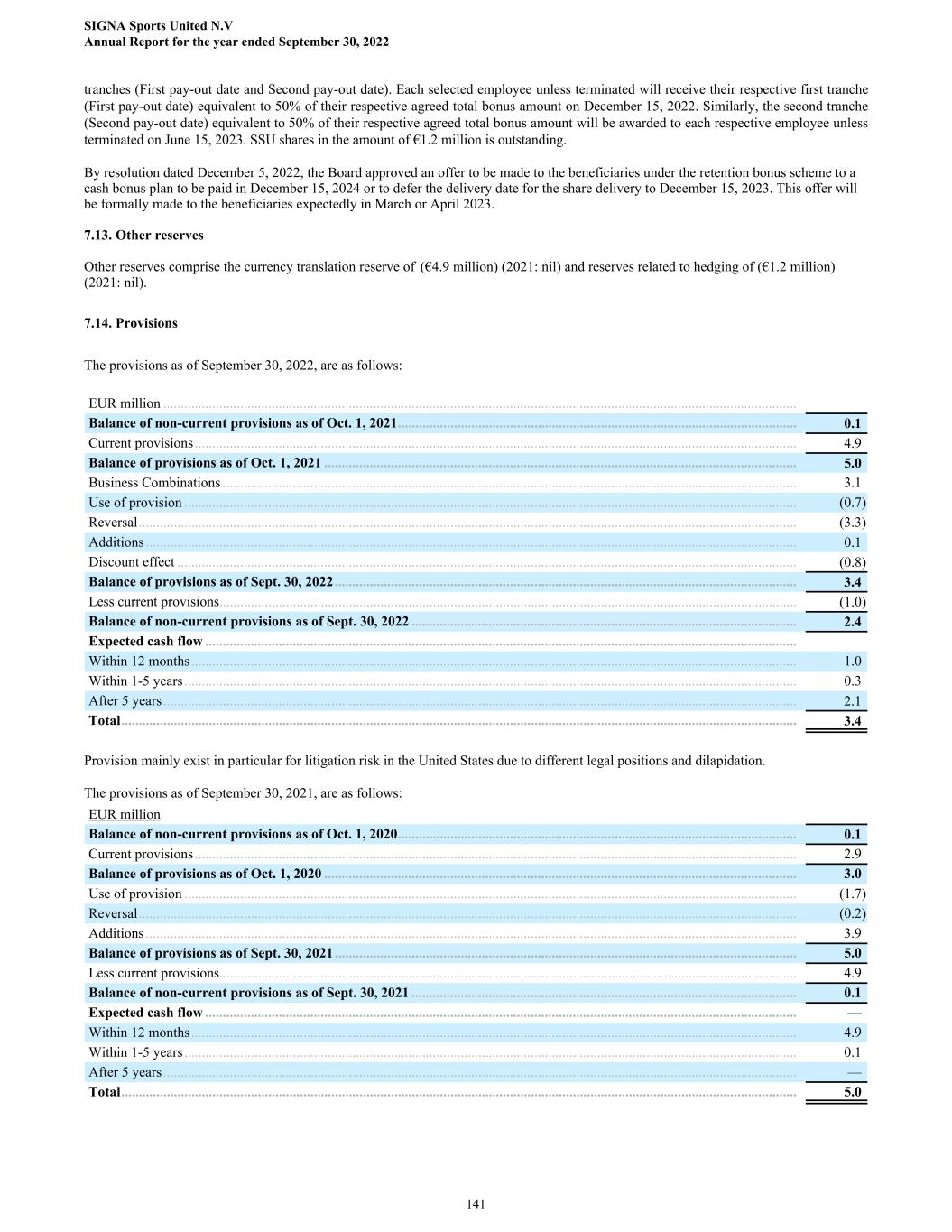
tranches (First pay-out date and Second pay-out date). Each selected employee unless terminated will receive their respective first tranche (First pay-out date) equivalent to 50% of their respective agreed total bonus amount on December 15, 2022. Similarly, the second tranche (Second pay-out date) equivalent to 50% of their respective agreed total bonus amount will be awarded to each respective employee unless terminated on June 15, 2023. SSU shares in the amount of €1.2 million is outstanding. By resolution dated December 5, 2022, the Board approved an offer to be made to the beneficiaries under the retention bonus scheme to a cash bonus plan to be paid in December 15, 2024 or to defer the delivery date for the share delivery to December 15, 2023. This offer will be formally made to the beneficiaries expectedly in March or April 2023. 7.13. Other reserves Other reserves comprise the currency translation reserve of (€4.9 million) (2021: nil) and reserves related to hedging of (€1.2 million) (2021: nil). 7.14. Provisions The provisions as of September 30, 2022, are as follows: EUR million ..................................................................................................................................................................................... Balance of non-current provisions as of Oct. 1, 2021 .................................................................................................................. 0.1 Current provisions ............................................................................................................................................................................ 4.9 Balance of provisions as of Oct. 1, 2021 ....................................................................................................................................... 5.0 Business Combinations .................................................................................................................................................................... 3.1 Use of provision ............................................................................................................................................................................... (0.7) Reversal ............................................................................................................................................................................................ (3.3) Additions .......................................................................................................................................................................................... 0.1 Discount effect ................................................................................................................................................................................. (0.8) Balance of provisions as of Sept. 30, 2022 .................................................................................................................................... 3.4 Less current provisions ..................................................................................................................................................................... (1.0) Balance of non-current provisions as of Sept. 30, 2022 .............................................................................................................. 2.4 Expected cash flow ......................................................................................................................................................................... Within 12 months ............................................................................................................................................................................. 1.0 Within 1-5 years ............................................................................................................................................................................... 0.3 After 5 years ..................................................................................................................................................................................... 2.1 Total ................................................................................................................................................................................................. 3.4 Provision mainly exist in particular for litigation risk in the United States due to different legal positions and dilapidation. The provisions as of September 30, 2021, are as follows: EUR million Balance of non-current provisions as of Oct. 1, 2020 .................................................................................................................. 0.1 Current provisions ............................................................................................................................................................................ 2.9 Balance of provisions as of Oct. 1, 2020 ....................................................................................................................................... 3.0 Use of provision ............................................................................................................................................................................... (1.7) Reversal ............................................................................................................................................................................................ (0.2) Additions .......................................................................................................................................................................................... 3.9 Balance of provisions as of Sept. 30, 2021 .................................................................................................................................... 5.0 Less current provisions ..................................................................................................................................................................... 4.9 Balance of non-current provisions as of Sept. 30, 2021 .............................................................................................................. 0.1 Expected cash flow ......................................................................................................................................................................... — Within 12 months ............................................................................................................................................................................. 4.9 Within 1-5 years ............................................................................................................................................................................... 0.1 After 5 years ..................................................................................................................................................................................... — Total ................................................................................................................................................................................................. 5.0 SIGNA Sports United N.V Annual Report for the year ended September 30, 2022 141
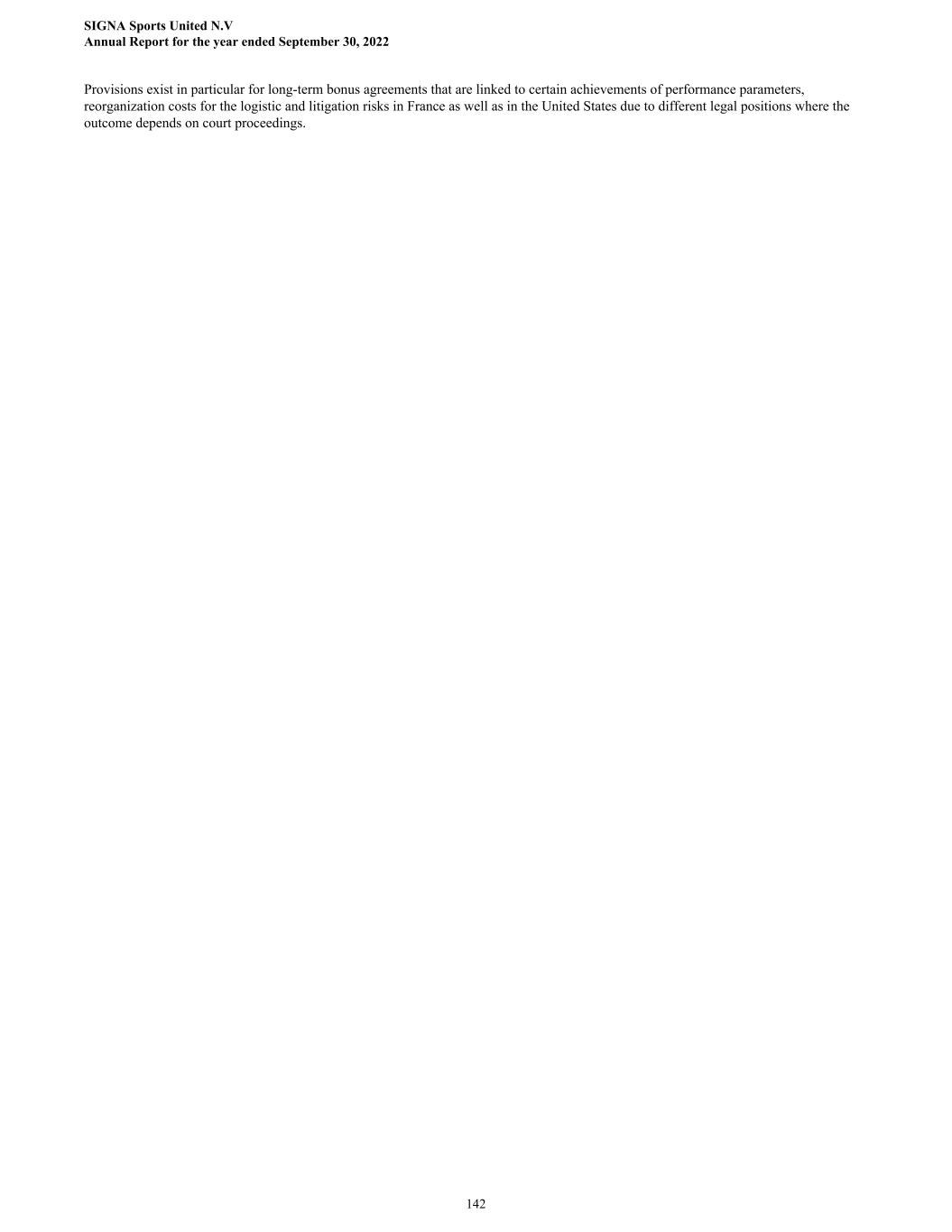
Provisions exist in particular for long-term bonus agreements that are linked to certain achievements of performance parameters, reorganization costs for the logistic and litigation risks in France as well as in the United States due to different legal positions where the outcome depends on court proceedings. SIGNA Sports United N.V Annual Report for the year ended September 30, 2022 142
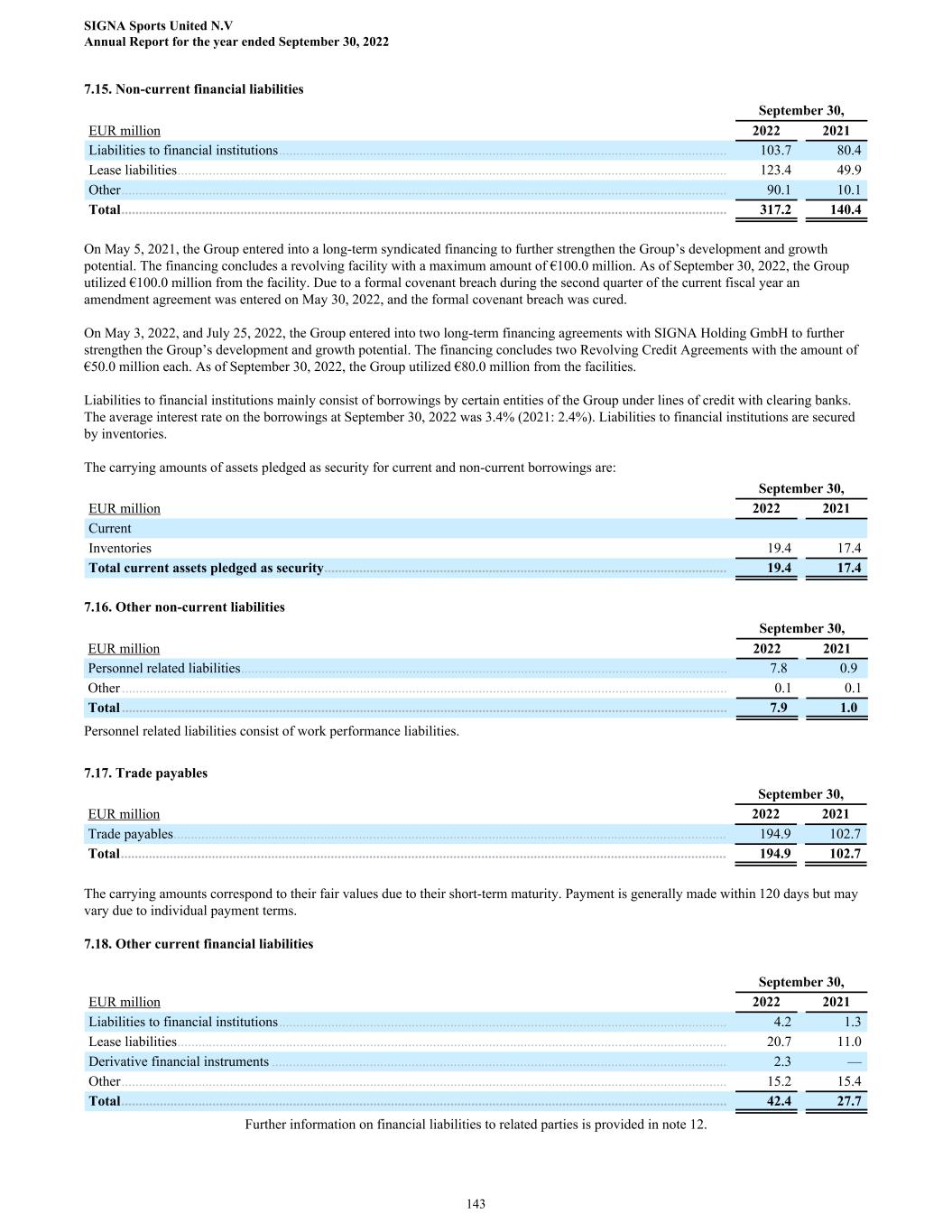
7.15. Non-current financial liabilities September 30, EUR million 2022 2021 Liabilities to financial institutions ................................................................................................................................ 103.7 80.4 Lease liabilities ............................................................................................................................................................. 123.4 49.9 Other ............................................................................................................................................................................. 90.1 10.1 Total ............................................................................................................................................................................. 317.2 140.4 On May 5, 2021, the Group entered into a long-term syndicated financing to further strengthen the Group’s development and growth potential. The financing concludes a revolving facility with a maximum amount of €100.0 million. As of September 30, 2022, the Group utilized €100.0 million from the facility. Due to a formal covenant breach during the second quarter of the current fiscal year an amendment agreement was entered on May 30, 2022, and the formal covenant breach was cured. On May 3, 2022, and July 25, 2022, the Group entered into two long-term financing agreements with SIGNA Holding GmbH to further strengthen the Group’s development and growth potential. The financing concludes two Revolving Credit Agreements with the amount of €50.0 million each. As of September 30, 2022, the Group utilized €80.0 million from the facilities. Liabilities to financial institutions mainly consist of borrowings by certain entities of the Group under lines of credit with clearing banks. The average interest rate on the borrowings at September 30, 2022 was 3.4% (2021: 2.4%). Liabilities to financial institutions are secured by inventories. The carrying amounts of assets pledged as security for current and non-current borrowings are: September 30, EUR million 2022 2021 Current Inventories 19.4 17.4 Total current assets pledged as security ................................................................................................................... 19.4 17.4 7.16. Other non-current liabilities September 30, EUR million 2022 2021 Personnel related liabilities ........................................................................................................................................... 7.8 0.9 Other ............................................................................................................................................................................. 0.1 0.1 Total ............................................................................................................................................................................. 7.9 1.0 Personnel related liabilities consist of work performance liabilities. 7.17. Trade payables September 30, EUR million 2022 2021 Trade payables .............................................................................................................................................................. 194.9 102.7 Total ............................................................................................................................................................................. 194.9 102.7 The carrying amounts correspond to their fair values due to their short-term maturity. Payment is generally made within 120 days but may vary due to individual payment terms. 7.18. Other current financial liabilities September 30, EUR million 2022 2021 Liabilities to financial institutions ................................................................................................................................ 4.2 1.3 Lease liabilities ............................................................................................................................................................. 20.7 11.0 Derivative financial instruments .................................................................................................................................. 2.3 — Other ............................................................................................................................................................................. 15.2 15.4 Total ............................................................................................................................................................................. 42.4 27.7 Further information on financial liabilities to related parties is provided in note 12. SIGNA Sports United N.V Annual Report for the year ended September 30, 2022 143
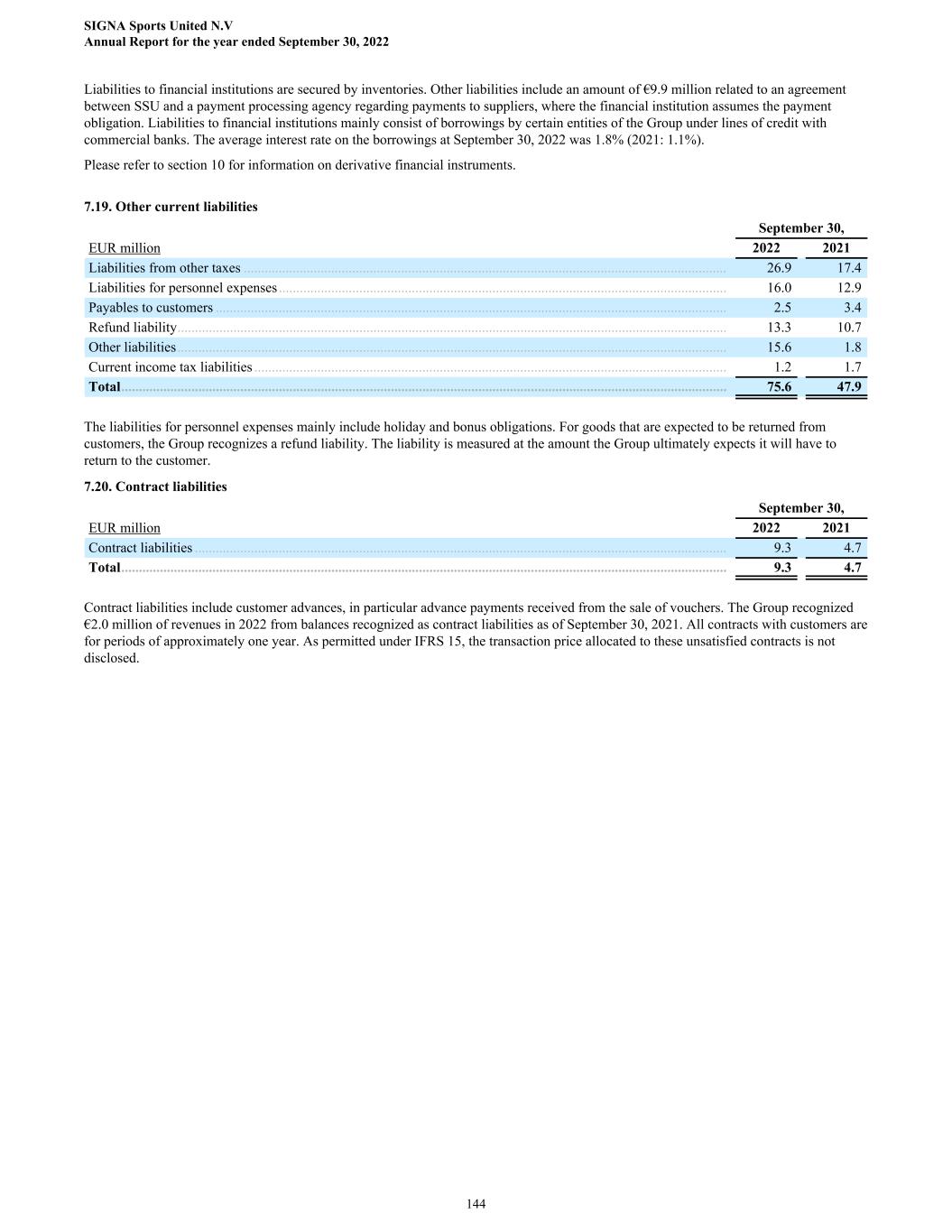
Liabilities to financial institutions are secured by inventories. Other liabilities include an amount of €9.9 million related to an agreement between SSU and a payment processing agency regarding payments to suppliers, where the financial institution assumes the payment obligation. Liabilities to financial institutions mainly consist of borrowings by certain entities of the Group under lines of credit with commercial banks. The average interest rate on the borrowings at September 30, 2022 was 1.8% (2021: 1.1%). Please refer to section 10 for information on derivative financial instruments. 7.19. Other current liabilities September 30, EUR million 2022 2021 Liabilities from other taxes .......................................................................................................................................... 26.9 17.4 Liabilities for personnel expenses ................................................................................................................................ 16.0 12.9 Payables to customers .................................................................................................................................................. 2.5 3.4 Refund liability ............................................................................................................................................................. 13.3 10.7 Other liabilities ............................................................................................................................................................. 15.6 1.8 Current income tax liabilities ....................................................................................................................................... 1.2 1.7 Total ............................................................................................................................................................................. 75.6 47.9 The liabilities for personnel expenses mainly include holiday and bonus obligations. For goods that are expected to be returned from customers, the Group recognizes a refund liability. The liability is measured at the amount the Group ultimately expects it will have to return to the customer. 7.20. Contract liabilities September 30, EUR million 2022 2021 Contract liabilities ........................................................................................................................................................ 9.3 4.7 Total ............................................................................................................................................................................. 9.3 4.7 Contract liabilities include customer advances, in particular advance payments received from the sale of vouchers. The Group recognized €2.0 million of revenues in 2022 from balances recognized as contract liabilities as of September 30, 2021. All contracts with customers are for periods of approximately one year. As permitted under IFRS 15, the transaction price allocated to these unsatisfied contracts is not disclosed. SIGNA Sports United N.V Annual Report for the year ended September 30, 2022 144
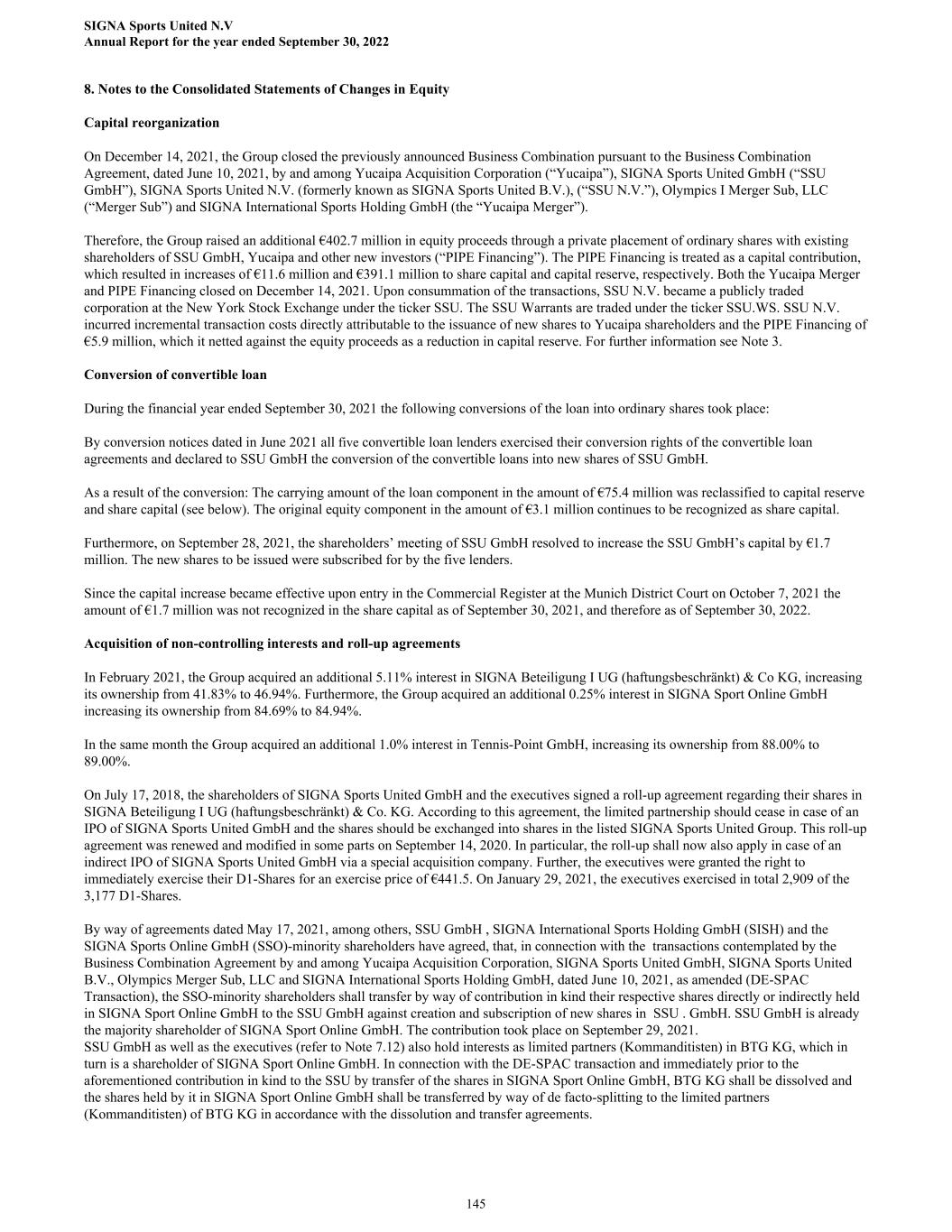
8. Notes to the Consolidated Statements of Changes in Equity Capital reorganization On December 14, 2021, the Group closed the previously announced Business Combination pursuant to the Business Combination Agreement, dated June 10, 2021, by and among Yucaipa Acquisition Corporation (“Yucaipa”), SIGNA Sports United GmbH (“SSU GmbH”), SIGNA Sports United N.V. (formerly known as SIGNA Sports United B.V.), (“SSU N.V.”), Olympics I Merger Sub, LLC (“Merger Sub”) and SIGNA International Sports Holding GmbH (the “Yucaipa Merger”). Therefore, the Group raised an additional €402.7 million in equity proceeds through a private placement of ordinary shares with existing shareholders of SSU GmbH, Yucaipa and other new investors (“PIPE Financing”). The PIPE Financing is treated as a capital contribution, which resulted in increases of €11.6 million and €391.1 million to share capital and capital reserve, respectively. Both the Yucaipa Merger and PIPE Financing closed on December 14, 2021. Upon consummation of the transactions, SSU N.V. became a publicly traded corporation at the New York Stock Exchange under the ticker SSU. The SSU Warrants are traded under the ticker SSU.WS. SSU N.V. incurred incremental transaction costs directly attributable to the issuance of new shares to Yucaipa shareholders and the PIPE Financing of €5.9 million, which it netted against the equity proceeds as a reduction in capital reserve. For further information see Note 3. Conversion of convertible loan During the financial year ended September 30, 2021 the following conversions of the loan into ordinary shares took place: By conversion notices dated in June 2021 all five convertible loan lenders exercised their conversion rights of the convertible loan agreements and declared to SSU GmbH the conversion of the convertible loans into new shares of SSU GmbH. As a result of the conversion: The carrying amount of the loan component in the amount of €75.4 million was reclassified to capital reserve and share capital (see below). The original equity component in the amount of €3.1 million continues to be recognized as share capital. Furthermore, on September 28, 2021, the shareholders’ meeting of SSU GmbH resolved to increase the SSU GmbH’s capital by €1.7 million. The new shares to be issued were subscribed for by the five lenders. Since the capital increase became effective upon entry in the Commercial Register at the Munich District Court on October 7, 2021 the amount of €1.7 million was not recognized in the share capital as of September 30, 2021, and therefore as of September 30, 2022. Acquisition of non-controlling interests and roll-up agreements In February 2021, the Group acquired an additional 5.11% interest in SIGNA Beteiligung I UG (haftungsbeschränkt) & Co KG, increasing its ownership from 41.83% to 46.94%. Furthermore, the Group acquired an additional 0.25% interest in SIGNA Sport Online GmbH increasing its ownership from 84.69% to 84.94%. In the same month the Group acquired an additional 1.0% interest in Tennis-Point GmbH, increasing its ownership from 88.00% to 89.00%. On July 17, 2018, the shareholders of SIGNA Sports United GmbH and the executives signed a roll-up agreement regarding their shares in SIGNA Beteiligung I UG (haftungsbeschränkt) & Co. KG. According to this agreement, the limited partnership should cease in case of an IPO of SIGNA Sports United GmbH and the shares should be exchanged into shares in the listed SIGNA Sports United Group. This roll-up agreement was renewed and modified in some parts on September 14, 2020. In particular, the roll-up shall now also apply in case of an indirect IPO of SIGNA Sports United GmbH via a special acquisition company. Further, the executives were granted the right to immediately exercise their D1-Shares for an exercise price of €441.5. On January 29, 2021, the executives exercised in total 2,909 of the 3,177 D1-Shares. By way of agreements dated May 17, 2021, among others, SSU GmbH , SIGNA International Sports Holding GmbH (SISH) and the SIGNA Sports Online GmbH (SSO)-minority shareholders have agreed, that, in connection with the transactions contemplated by the Business Combination Agreement by and among Yucaipa Acquisition Corporation, SIGNA Sports United GmbH, SIGNA Sports United B.V., Olympics Merger Sub, LLC and SIGNA International Sports Holding GmbH, dated June 10, 2021, as amended (DE-SPAC Transaction), the SSO-minority shareholders shall transfer by way of contribution in kind their respective shares directly or indirectly held in SIGNA Sport Online GmbH to the SSU GmbH against creation and subscription of new shares in SSU . GmbH. SSU GmbH is already the majority shareholder of SIGNA Sport Online GmbH. The contribution took place on September 29, 2021. SSU GmbH as well as the executives (refer to Note 7.12) also hold interests as limited partners (Kommanditisten) in BTG KG, which in turn is a shareholder of SIGNA Sport Online GmbH. In connection with the DE-SPAC transaction and immediately prior to the aforementioned contribution in kind to the SSU by transfer of the shares in SIGNA Sport Online GmbH, BTG KG shall be dissolved and the shares held by it in SIGNA Sport Online GmbH shall be transferred by way of de facto-splitting to the limited partners (Kommanditisten) of BTG KG in accordance with the dissolution and transfer agreements. SIGNA Sports United N.V Annual Report for the year ended September 30, 2022 145
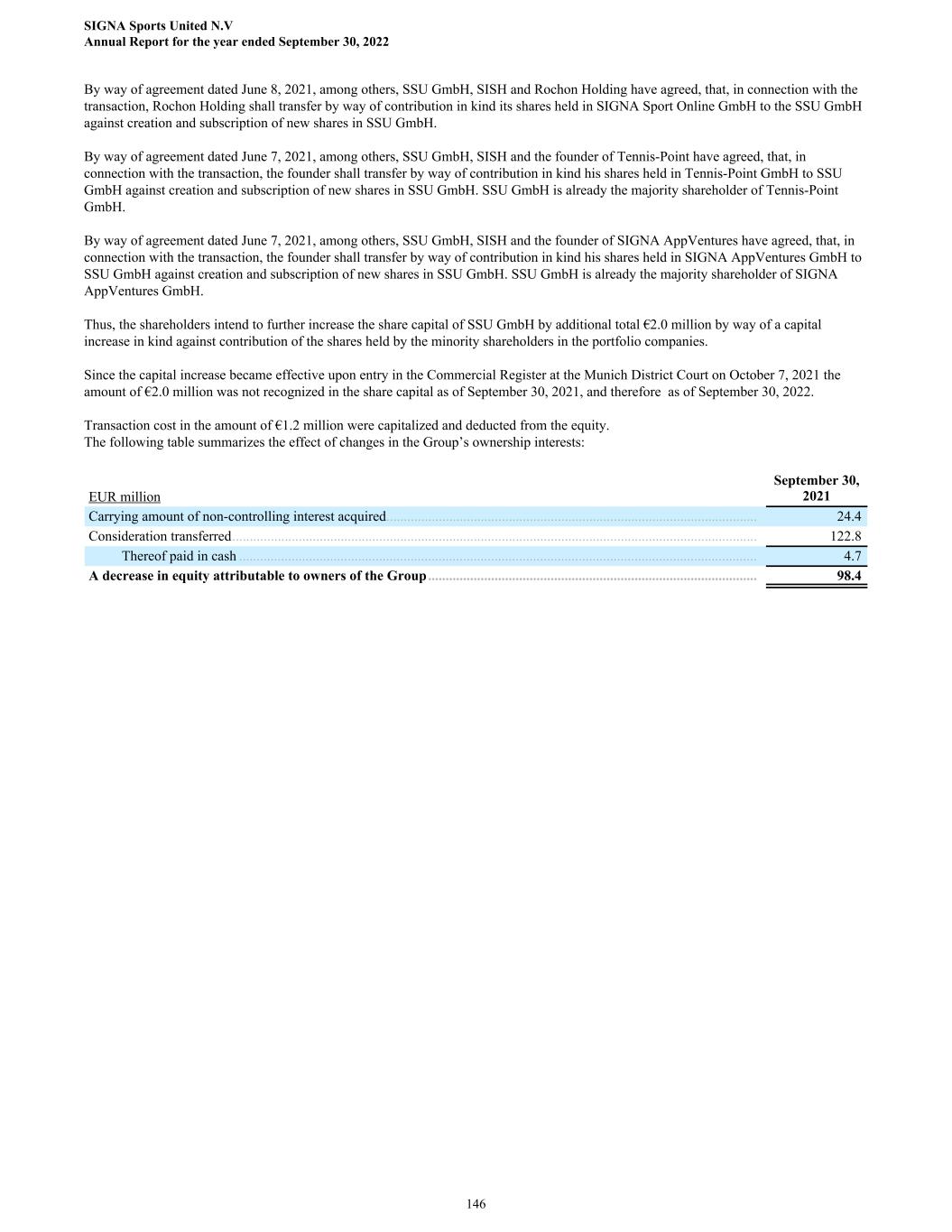
By way of agreement dated June 8, 2021, among others, SSU GmbH, SISH and Rochon Holding have agreed, that, in connection with the transaction, Rochon Holding shall transfer by way of contribution in kind its shares held in SIGNA Sport Online GmbH to the SSU GmbH against creation and subscription of new shares in SSU GmbH. By way of agreement dated June 7, 2021, among others, SSU GmbH, SISH and the founder of Tennis-Point have agreed, that, in connection with the transaction, the founder shall transfer by way of contribution in kind his shares held in Tennis-Point GmbH to SSU GmbH against creation and subscription of new shares in SSU GmbH. SSU GmbH is already the majority shareholder of Tennis-Point GmbH. By way of agreement dated June 7, 2021, among others, SSU GmbH, SISH and the founder of SIGNA AppVentures have agreed, that, in connection with the transaction, the founder shall transfer by way of contribution in kind his shares held in SIGNA AppVentures GmbH to SSU GmbH against creation and subscription of new shares in SSU GmbH. SSU GmbH is already the majority shareholder of SIGNA AppVentures GmbH. Thus, the shareholders intend to further increase the share capital of SSU GmbH by additional total €2.0 million by way of a capital increase in kind against contribution of the shares held by the minority shareholders in the portfolio companies. Since the capital increase became effective upon entry in the Commercial Register at the Munich District Court on October 7, 2021 the amount of €2.0 million was not recognized in the share capital as of September 30, 2021, and therefore as of September 30, 2022. Transaction cost in the amount of €1.2 million were capitalized and deducted from the equity. The following table summarizes the effect of changes in the Group’s ownership interests: EUR million September 30, 2021 Carrying amount of non-controlling interest acquired .......................................................................................................... 24.4 Consideration transferred ...................................................................................................................................................... 122.8 Thereof paid in cash .................................................................................................................................................... 4.7 A decrease in equity attributable to owners of the Group .............................................................................................. 98.4 SIGNA Sports United N.V Annual Report for the year ended September 30, 2022 146
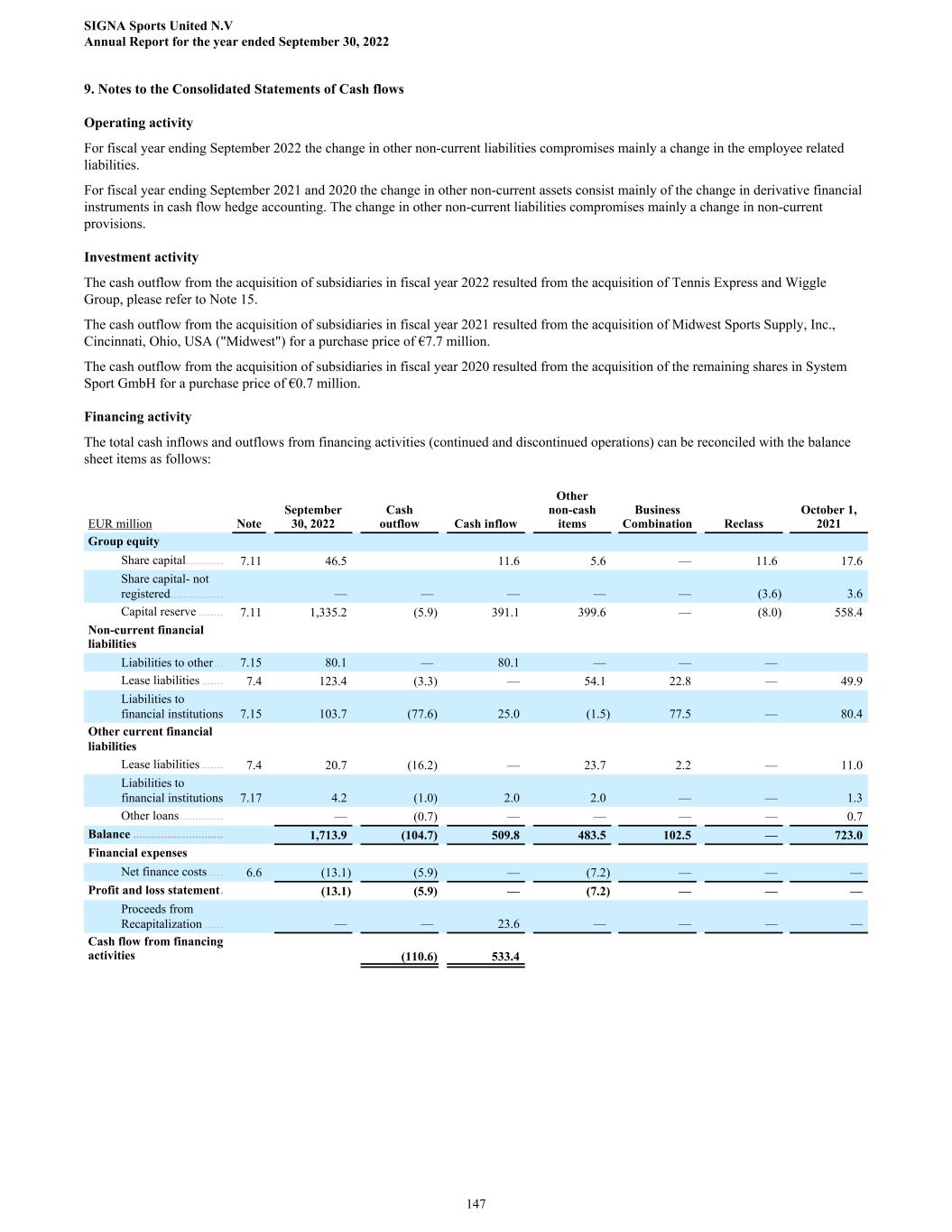
9. Notes to the Consolidated Statements of Cash flows Operating activity For fiscal year ending September 2022 the change in other non-current liabilities compromises mainly a change in the employee related liabilities. For fiscal year ending September 2021 and 2020 the change in other non-current assets consist mainly of the change in derivative financial instruments in cash flow hedge accounting. The change in other non-current liabilities compromises mainly a change in non-current provisions. Investment activity The cash outflow from the acquisition of subsidiaries in fiscal year 2022 resulted from the acquisition of Tennis Express and Wiggle Group, please refer to Note 15. The cash outflow from the acquisition of subsidiaries in fiscal year 2021 resulted from the acquisition of Midwest Sports Supply, Inc., Cincinnati, Ohio, USA ("Midwest") for a purchase price of €7.7 million. The cash outflow from the acquisition of subsidiaries in fiscal year 2020 resulted from the acquisition of the remaining shares in System Sport GmbH for a purchase price of €0.7 million. Financing activity The total cash inflows and outflows from financing activities (continued and discontinued operations) can be reconciled with the balance sheet items as follows: EUR million Note September 30, 2022 Cash outflow Cash inflow Other non-cash items Business Combination Reclass October 1, 2021 Group equity Share capital ............ 7.11 46.5 11.6 5.6 — 11.6 17.6 Share capital- not registered ................. — — — — — (3.6) 3.6 Capital reserve ........ 7.11 1,335.2 (5.9) 391.1 399.6 — (8.0) 558.4 Non-current financial liabilities Liabilities to other ... 7.15 80.1 — 80.1 — — — Lease liabilities ....... 7.4 123.4 (3.3) — 54.1 22.8 — 49.9 Liabilities to financial institutions 7.15 103.7 (77.6) 25.0 (1.5) 77.5 — 80.4 Other current financial liabilities Lease liabilities ....... 7.4 20.7 (16.2) — 23.7 2.2 — 11.0 Liabilities to financial institutions 7.17 4.2 (1.0) 2.0 2.0 — — 1.3 Other loans .............. — (0.7) — — — — 0.7 Balance ............................. 1,713.9 (104.7) 509.8 483.5 102.5 — 723.0 Financial expenses Net finance costs ..... 6.6 (13.1) (5.9) — (7.2) — — — Profit and loss statement . (13.1) (5.9) — (7.2) — — — Proceeds from Recapitalization ...... — — 23.6 — — — — Cash flow from financing activities (110.6) 533.4 SIGNA Sports United N.V Annual Report for the year ended September 30, 2022 147
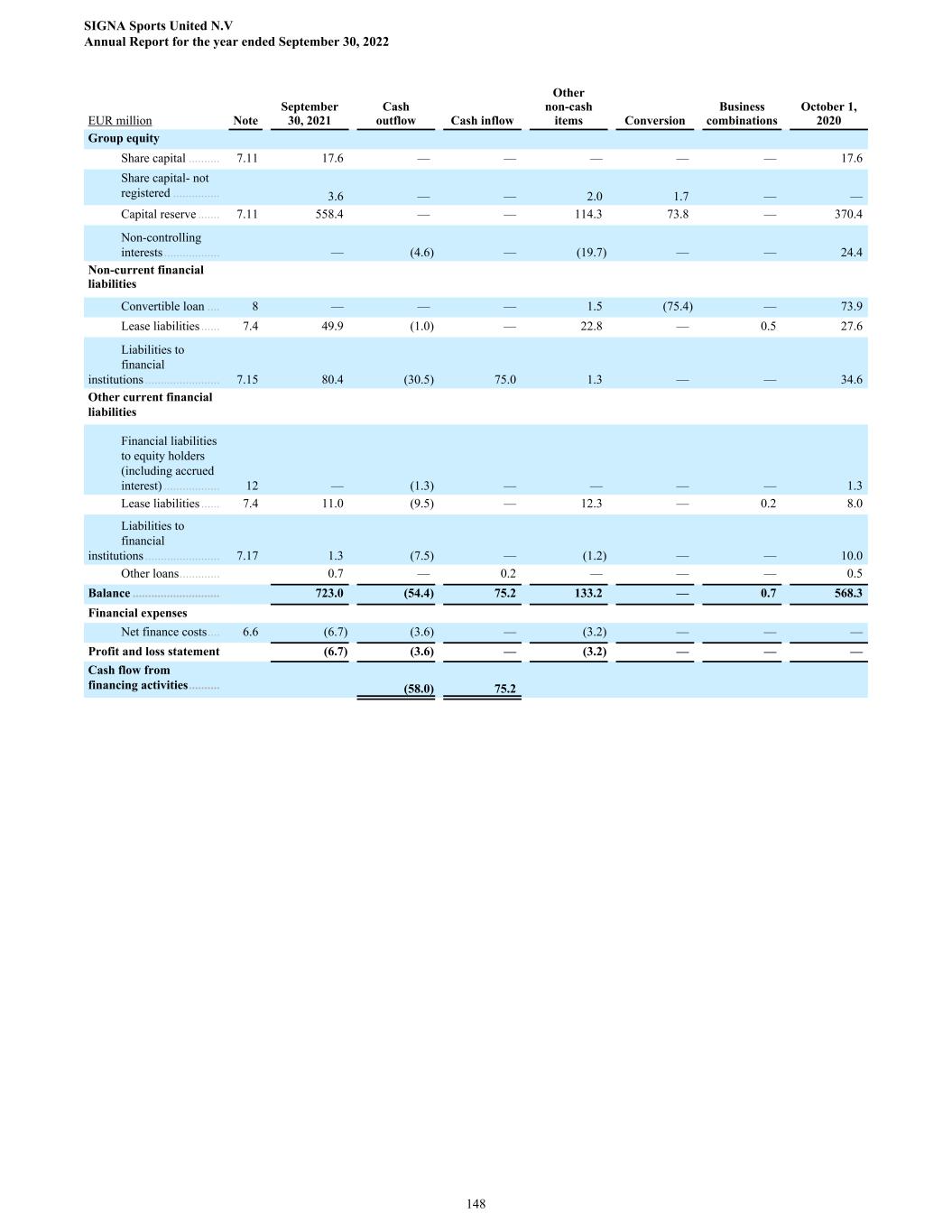
EUR million Note September 30, 2021 Cash outflow Cash inflow Other non-cash items Conversion Business combinations October 1, 2020 Group equity Share capital .......... 7.11 17.6 — — — — — 17.6 Share capital- not registered ............... 3.6 — — 2.0 1.7 — — Capital reserve ....... 7.11 558.4 — — 114.3 73.8 — 370.4 Non-controlling interests .................. — (4.6) — (19.7) — — 24.4 Non-current financial liabilities Convertible loan .... 8 — — — 1.5 (75.4) — 73.9 Lease liabilities ...... 7.4 49.9 (1.0) — 22.8 — 0.5 27.6 Liabilities to financial institutions ........................ 7.15 80.4 (30.5) 75.0 1.3 — — 34.6 Other current financial liabilities Financial liabilities to equity holders (including accrued interest) .................. 12 — (1.3) — — — — 1.3 Lease liabilities ...... 7.4 11.0 (9.5) — 12.3 — 0.2 8.0 Liabilities to financial institutions ........................ 7.17 1.3 (7.5) — (1.2) — — 10.0 Other loans ............. 0.7 — 0.2 — — — 0.5 Balance ............................ 723.0 (54.4) 75.2 133.2 — 0.7 568.3 Financial expenses Net finance costs .... 6.6 (6.7) (3.6) — (3.2) — — — Profit and loss statement (6.7) (3.6) — (3.2) — — — Cash flow from financing activities .......... (58.0) 75.2 SIGNA Sports United N.V Annual Report for the year ended September 30, 2022 148
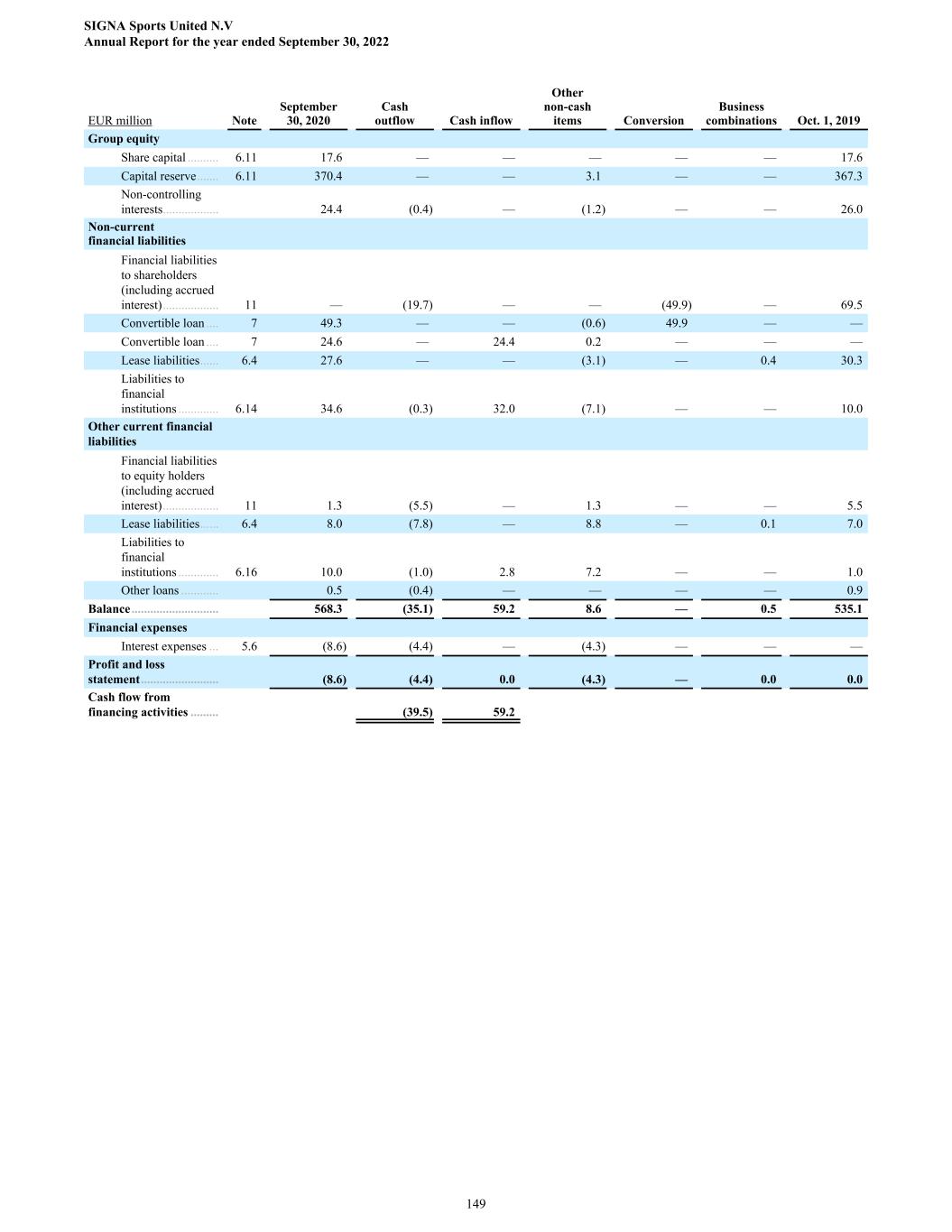
EUR million Note September 30, 2020 Cash outflow Cash inflow Other non-cash items Conversion Business combinations Oct. 1, 2019 Group equity Share capital .......... 6.11 17.6 — — — — — 17.6 Capital reserve ....... 6.11 370.4 — — 3.1 — — 367.3 Non-controlling interests .................. 24.4 (0.4) — (1.2) — — 26.0 Non-current financial liabilities Financial liabilities to shareholders (including accrued interest) .................. 11 — (19.7) — — (49.9) — 69.5 Convertible loan .... 7 49.3 — — (0.6) 49.9 — — Convertible loan .... 7 24.6 — 24.4 0.2 — — — Lease liabilities ...... 6.4 27.6 — — (3.1) — 0.4 30.3 Liabilities to financial institutions ............. 6.14 34.6 (0.3) 32.0 (7.1) — — 10.0 Other current financial liabilities Financial liabilities to equity holders (including accrued interest) .................. 11 1.3 (5.5) — 1.3 — — 5.5 Lease liabilities ...... 6.4 8.0 (7.8) — 8.8 — 0.1 7.0 Liabilities to financial institutions ............. 6.16 10.0 (1.0) 2.8 7.2 — — 1.0 Other loans ............ 0.5 (0.4) — — — — 0.9 Balance ............................ 568.3 (35.1) 59.2 8.6 — 0.5 535.1 Financial expenses Interest expenses ... 5.6 (8.6) (4.4) — (4.3) — — — Profit and loss statement ......................... (8.6) (4.4) 0.0 (4.3) — 0.0 0.0 Cash flow from financing activities ......... (39.5) 59.2 SIGNA Sports United N.V Annual Report for the year ended September 30, 2022 149

10. Financial risk management 10.1. Categories and measurement at fair value The following section provides additional information on the significance of financial instruments and on individual items of the consolidated statements of financial position and the consolidated statements of profit or loss and other comprehensive income with respect to financial instruments. The following table shows the reconciliation of the consolidated statements of financial position items to the relevant classes of financial instruments as of September 30, 2022 and 2021, broken down by the carrying amount and fair value of the financial instruments and the allocation of the consolidated statements of financial position items to the measurement categories. The financial instruments as of September 30, 2022, are as follows: EUR million Measurement category in accordance with IFRS 9 Balance sheet carrying amount as of September 30, 2022 Fair value hierarchy Fair value Financial asset Other non-current financial assets ....................................... 5.1 5.1 of which with related companies and persons ...... AC — 2 — of which from the positive fair values of derivative financial instruments in cash flow hedge accounting ................................................... Hedge Accounting — 2 — of which from other financial assets ..................... AC 5.1 2 5.1 Trade receivables ................................................................... AC 25.1 n/a 25.1 Other current financial assets ............................................... 20.1 n/a 20.1 of which from the positive fair values of derivative financial instruments in cash flow hedge accounting ................................................... Hedge Accounting 1.1 2 1.1 of which from financial assets .............................. AC 19.0 n/a 19.0 Cash and cash equivalents ..................................................... AC 43.0 n/a 43.0 Financial liabilities Non-current financial liabilities ............................................ 317.2 193.0 of which to financial institutions .......................... AC 103.7 2 101.6 of which other loans .............................................. AC 0.9 2 0.9 of which from lease liabilities ............................... n/a 123.4 n/a n/a of which with related companies and persons ...... AC 80.0 2 81.3 of which put option liabilities ............................... FVPL 5.4 2 5.4 of which from the negative fair values of derivative financial instruments in cash flow hedge accounting ................................................... Hedge Accounting — 2 — of which from other financial liabilities ............... AC — 2 — of which warrants .................................................. FVPL 3.8 1 3.8 Trade payables ....................................................................... AC 195.5 n/a 195.5 EUR million Measurement category in accordance with IFRS 9 Balance sheet carrying amount as of September 30, 2022 Fair value hierarchy Fair value Other current financial liabilities ......................................... 42.4 21.7 of which to financial institutions ........................... AC 4.2 n/a 4.2 of which from lease liabilities ............................... n/a 20.7 n/a n/a of which from the negative fair values of derivative financial instruments in cash flow hedge accounting ................................................... Hedge Accounting 2.3 2 2.3 of which from other financial liabilities ................ AC 15.2 n/a 15.2 SIGNA Sports United N.V Annual Report for the year ended September 30, 2022 150
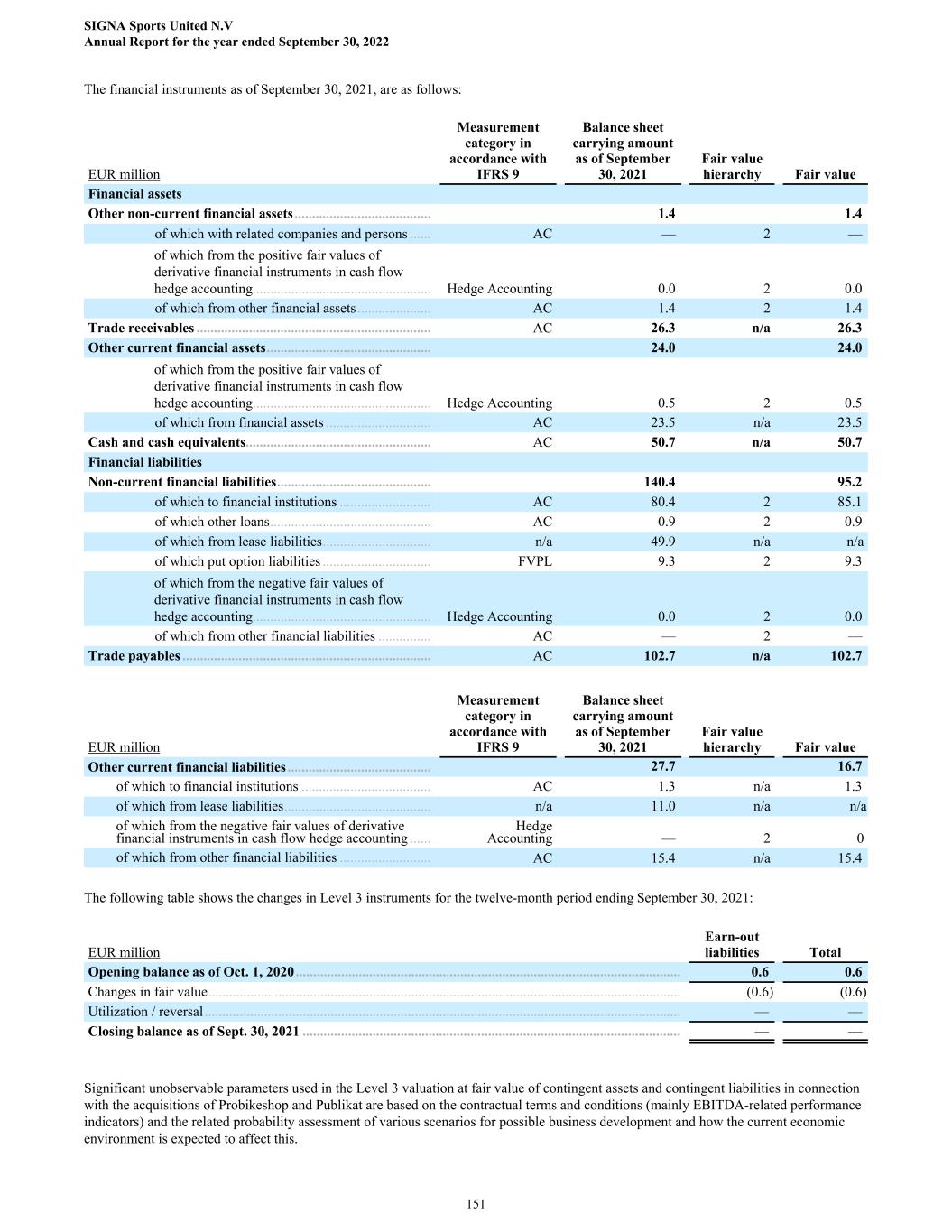
The financial instruments as of September 30, 2021, are as follows: EUR million Measurement category in accordance with IFRS 9 Balance sheet carrying amount as of September 30, 2021 Fair value hierarchy Fair value Financial assets Other non-current financial assets ....................................... 1.4 1.4 of which with related companies and persons ...... AC — 2 — of which from the positive fair values of derivative financial instruments in cash flow hedge accounting ................................................... Hedge Accounting 0.0 2 0.0 of which from other financial assets ..................... AC 1.4 2 1.4 Trade receivables ................................................................... AC 26.3 n/a 26.3 Other current financial assets ............................................... 24.0 24.0 of which from the positive fair values of derivative financial instruments in cash flow hedge accounting ................................................... Hedge Accounting 0.5 2 0.5 of which from financial assets .............................. AC 23.5 n/a 23.5 Cash and cash equivalents ..................................................... AC 50.7 n/a 50.7 Financial liabilities Non-current financial liabilities ............................................ 140.4 95.2 of which to financial institutions .......................... AC 80.4 2 85.1 of which other loans .............................................. AC 0.9 2 0.9 of which from lease liabilities ............................... n/a 49.9 n/a n/a of which put option liabilities ............................... FVPL 9.3 2 9.3 of which from the negative fair values of derivative financial instruments in cash flow hedge accounting ................................................... Hedge Accounting 0.0 2 0.0 of which from other financial liabilities ............... AC — 2 — Trade payables ....................................................................... AC 102.7 n/a 102.7 EUR million Measurement category in accordance with IFRS 9 Balance sheet carrying amount as of September 30, 2021 Fair value hierarchy Fair value Other current financial liabilities ......................................... 27.7 16.7 of which to financial institutions ..................................... AC 1.3 n/a 1.3 of which from lease liabilities .......................................... n/a 11.0 n/a n/a of which from the negative fair values of derivative financial instruments in cash flow hedge accounting ...... Hedge Accounting — 2 0 of which from other financial liabilities .......................... AC 15.4 n/a 15.4 The following table shows the changes in Level 3 instruments for the twelve-month period ending September 30, 2021: EUR million Earn-out liabilities Total Opening balance as of Oct. 1, 2020 .............................................................................................................. 0.6 0.6 Changes in fair value ....................................................................................................................................... (0.6) (0.6) Utilization / reversal ........................................................................................................................................ — — Closing balance as of Sept. 30, 2021 ............................................................................................................ — — Significant unobservable parameters used in the Level 3 valuation at fair value of contingent assets and contingent liabilities in connection with the acquisitions of Probikeshop and Publikat are based on the contractual terms and conditions (mainly EBITDA-related performance indicators) and the related probability assessment of various scenarios for possible business development and how the current economic environment is expected to affect this. SIGNA Sports United N.V Annual Report for the year ended September 30, 2022 151
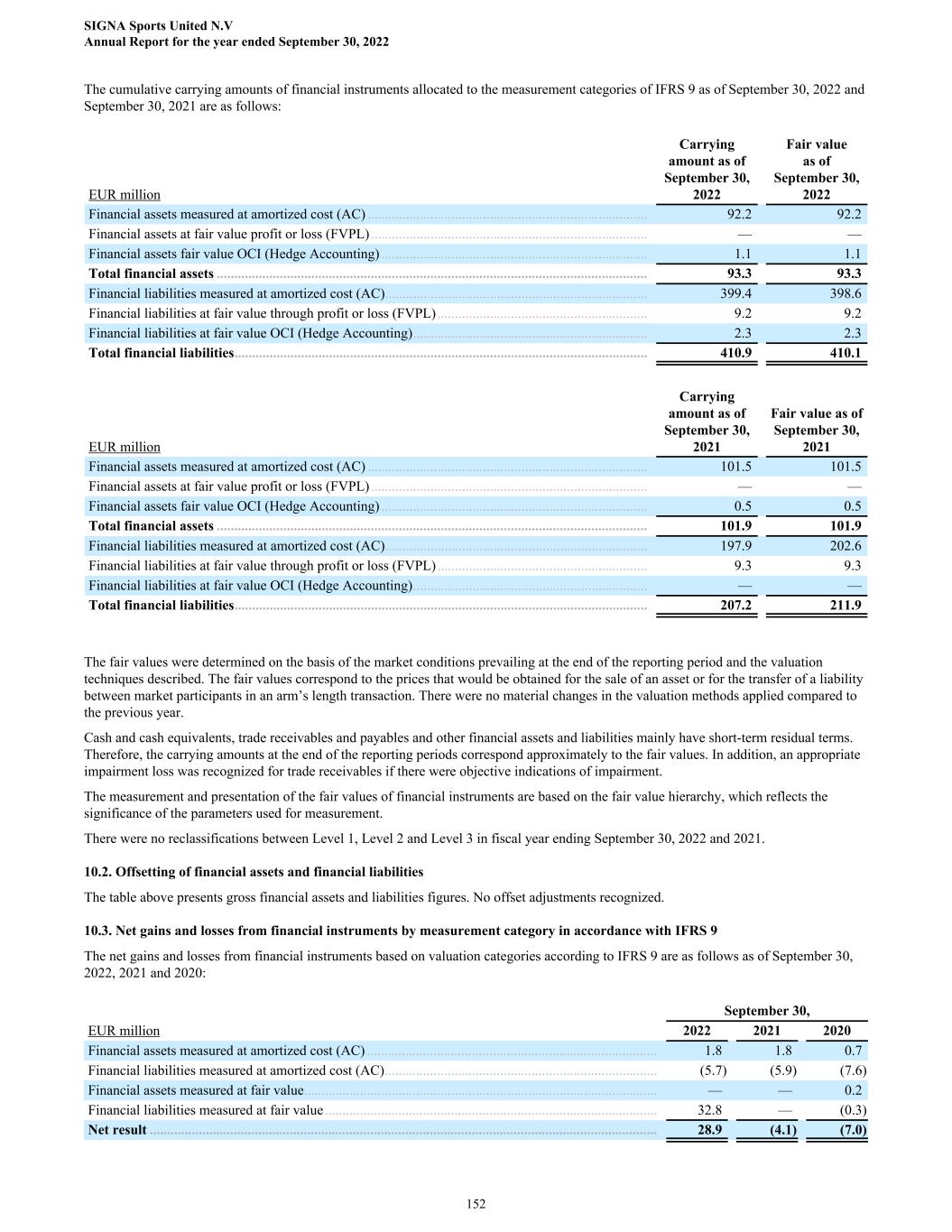
The cumulative carrying amounts of financial instruments allocated to the measurement categories of IFRS 9 as of September 30, 2022 and September 30, 2021 are as follows: EUR million Carrying amount as of September 30, 2022 Fair value as of September 30, 2022 Financial assets measured at amortized cost (AC) ................................................................................ 92.2 92.2 Financial assets at fair value profit or loss (FVPL) ............................................................................... — — Financial assets fair value OCI (Hedge Accounting) ............................................................................ 1.1 1.1 Total financial assets ........................................................................................................................... 93.3 93.3 Financial liabilities measured at amortized cost (AC) ........................................................................... 399.4 398.6 Financial liabilities at fair value through profit or loss (FVPL) ............................................................ 9.2 9.2 Financial liabilities at fair value OCI (Hedge Accounting) ................................................................... 2.3 2.3 Total financial liabilities ...................................................................................................................... 410.9 410.1 EUR million Carrying amount as of September 30, 2021 Fair value as of September 30, 2021 Financial assets measured at amortized cost (AC) ................................................................................ 101.5 101.5 Financial assets at fair value profit or loss (FVPL) ............................................................................... — — Financial assets fair value OCI (Hedge Accounting) ............................................................................ 0.5 0.5 Total financial assets ........................................................................................................................... 101.9 101.9 Financial liabilities measured at amortized cost (AC) ........................................................................... 197.9 202.6 Financial liabilities at fair value through profit or loss (FVPL) ............................................................ 9.3 9.3 Financial liabilities at fair value OCI (Hedge Accounting) ................................................................... — — Total financial liabilities ...................................................................................................................... 207.2 211.9 The fair values were determined on the basis of the market conditions prevailing at the end of the reporting period and the valuation techniques described. The fair values correspond to the prices that would be obtained for the sale of an asset or for the transfer of a liability between market participants in an arm’s length transaction. There were no material changes in the valuation methods applied compared to the previous year. Cash and cash equivalents, trade receivables and payables and other financial assets and liabilities mainly have short-term residual terms. Therefore, the carrying amounts at the end of the reporting periods correspond approximately to the fair values. In addition, an appropriate impairment loss was recognized for trade receivables if there were objective indications of impairment. The measurement and presentation of the fair values of financial instruments are based on the fair value hierarchy, which reflects the significance of the parameters used for measurement. There were no reclassifications between Level 1, Level 2 and Level 3 in fiscal year ending September 30, 2022 and 2021. 10.2. Offsetting of financial assets and financial liabilities The table above presents gross financial assets and liabilities figures. No offset adjustments recognized. 10.3. Net gains and losses from financial instruments by measurement category in accordance with IFRS 9 The net gains and losses from financial instruments based on valuation categories according to IFRS 9 are as follows as of September 30, 2022, 2021 and 2020: September 30, EUR million 2022 2021 2020 Financial assets measured at amortized cost (AC) ................................................................................... 1.8 1.8 0.7 Financial liabilities measured at amortized cost (AC) .............................................................................. (5.7) (5.9) (7.6) Financial assets measured at fair value ..................................................................................................... — — 0.2 Financial liabilities measured at fair value ............................................................................................... 32.8 — (0.3) Net result ................................................................................................................................................. 28.9 (4.1) (7.0) SIGNA Sports United N.V Annual Report for the year ended September 30, 2022 152
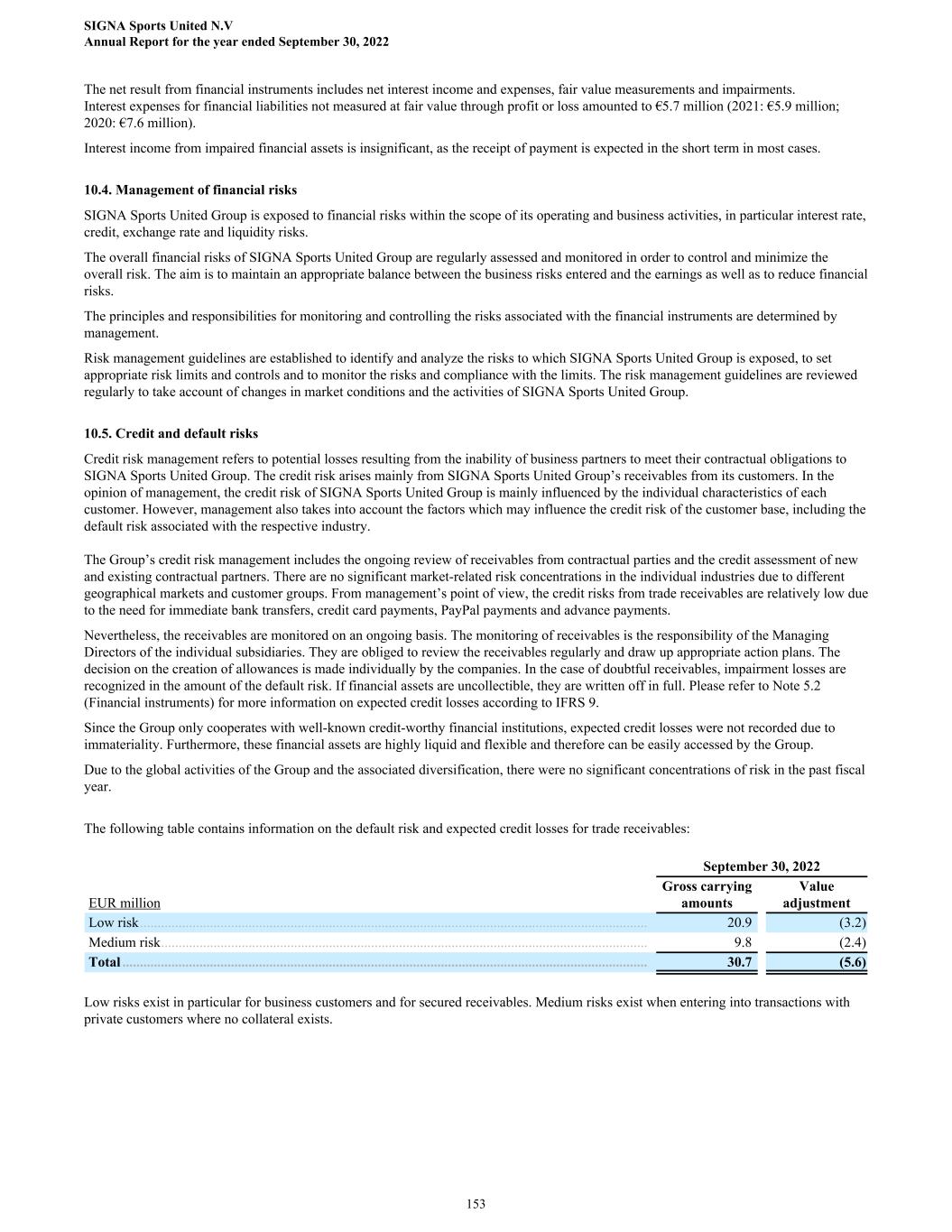
The net result from financial instruments includes net interest income and expenses, fair value measurements and impairments. Interest expenses for financial liabilities not measured at fair value through profit or loss amounted to €5.7 million (2021: €5.9 million; 2020: €7.6 million). Interest income from impaired financial assets is insignificant, as the receipt of payment is expected in the short term in most cases. 10.4. Management of financial risks SIGNA Sports United Group is exposed to financial risks within the scope of its operating and business activities, in particular interest rate, credit, exchange rate and liquidity risks. The overall financial risks of SIGNA Sports United Group are regularly assessed and monitored in order to control and minimize the overall risk. The aim is to maintain an appropriate balance between the business risks entered and the earnings as well as to reduce financial risks. The principles and responsibilities for monitoring and controlling the risks associated with the financial instruments are determined by management. Risk management guidelines are established to identify and analyze the risks to which SIGNA Sports United Group is exposed, to set appropriate risk limits and controls and to monitor the risks and compliance with the limits. The risk management guidelines are reviewed regularly to take account of changes in market conditions and the activities of SIGNA Sports United Group. 10.5. Credit and default risks Credit risk management refers to potential losses resulting from the inability of business partners to meet their contractual obligations to SIGNA Sports United Group. The credit risk arises mainly from SIGNA Sports United Group’s receivables from its customers. In the opinion of management, the credit risk of SIGNA Sports United Group is mainly influenced by the individual characteristics of each customer. However, management also takes into account the factors which may influence the credit risk of the customer base, including the default risk associated with the respective industry. The Group’s credit risk management includes the ongoing review of receivables from contractual parties and the credit assessment of new and existing contractual partners. There are no significant market-related risk concentrations in the individual industries due to different geographical markets and customer groups. From management’s point of view, the credit risks from trade receivables are relatively low due to the need for immediate bank transfers, credit card payments, PayPal payments and advance payments. Nevertheless, the receivables are monitored on an ongoing basis. The monitoring of receivables is the responsibility of the Managing Directors of the individual subsidiaries. They are obliged to review the receivables regularly and draw up appropriate action plans. The decision on the creation of allowances is made individually by the companies. In the case of doubtful receivables, impairment losses are recognized in the amount of the default risk. If financial assets are uncollectible, they are written off in full. Please refer to Note 5.2 (Financial instruments) for more information on expected credit losses according to IFRS 9. Since the Group only cooperates with well-known credit-worthy financial institutions, expected credit losses were not recorded due to immateriality. Furthermore, these financial assets are highly liquid and flexible and therefore can be easily accessed by the Group. Due to the global activities of the Group and the associated diversification, there were no significant concentrations of risk in the past fiscal year. The following table contains information on the default risk and expected credit losses for trade receivables: September 30, 2022 EUR million Gross carrying amounts Value adjustment Low risk ................................................................................................................................................. 20.9 (3.2) Medium risk ........................................................................................................................................... 9.8 (2.4) Total ...................................................................................................................................................... 30.7 (5.6) Low risks exist in particular for business customers and for secured receivables. Medium risks exist when entering into transactions with private customers where no collateral exists. SIGNA Sports United N.V Annual Report for the year ended September 30, 2022 153
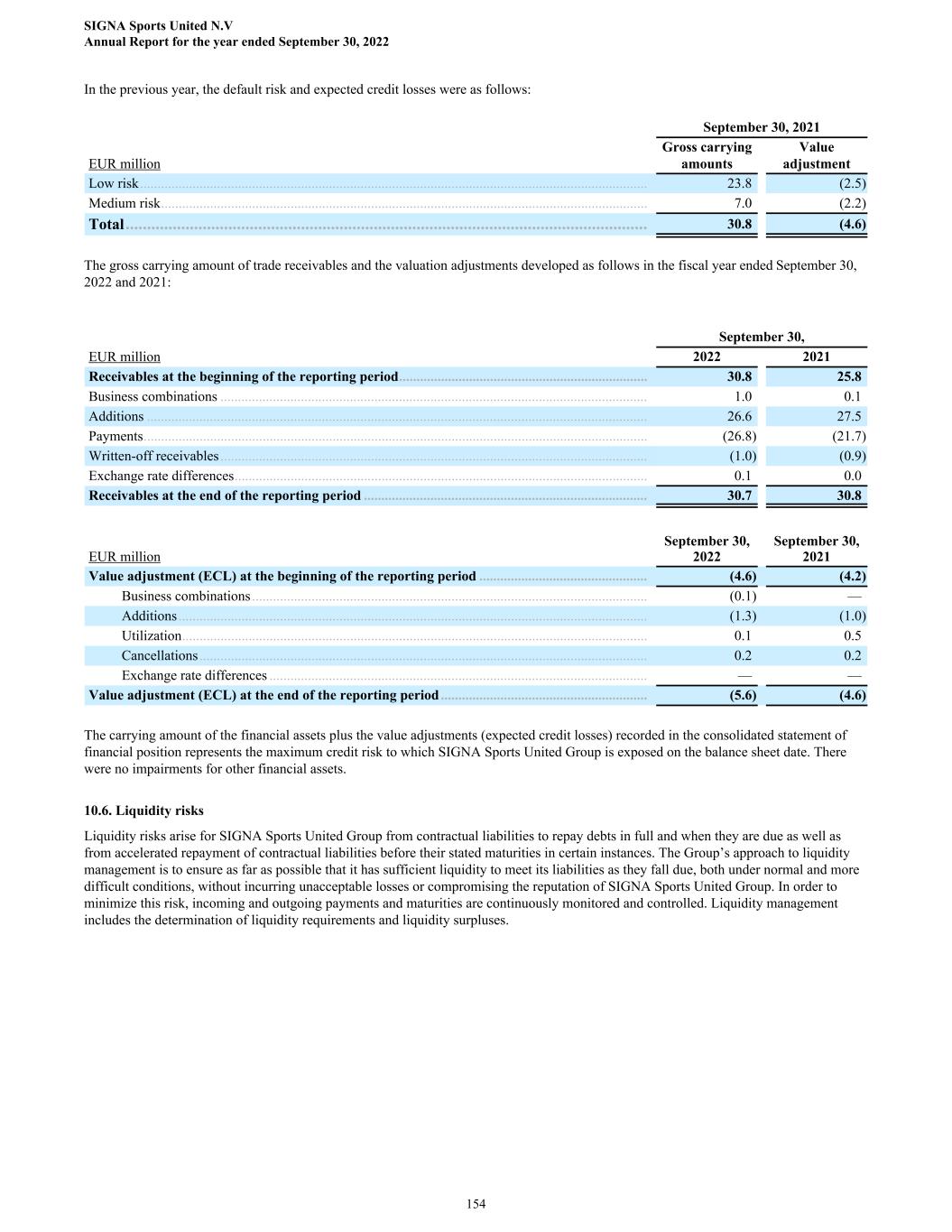
In the previous year, the default risk and expected credit losses were as follows: September 30, 2021 EUR million Gross carrying amounts Value adjustment Low risk ................................................................................................................................................. 23.8 (2.5) Medium risk ........................................................................................................................................... 7.0 (2.2) Total .......................................................................................................................... 30.8 (4.6) The gross carrying amount of trade receivables and the valuation adjustments developed as follows in the fiscal year ended September 30, 2022 and 2021: EUR million 2022 2021 Receivables at the beginning of the reporting period ....................................................................... 30.8 25.8 Business combinations .......................................................................................................................... 1.0 0.1 Additions ............................................................................................................................................... 26.6 27.5 Payments ................................................................................................................................................ (26.8) (21.7) Written-off receivables .......................................................................................................................... (1.0) (0.9) Exchange rate differences ...................................................................................................................... 0.1 0.0 Receivables at the end of the reporting period ................................................................................. 30.7 30.8 September 30, EUR million September 30, 2022 September 30, 2021 Value adjustment (ECL) at the beginning of the reporting period ................................................ (4.6) (4.2) Business combinations ................................................................................................................. (0.1) — Additions ...................................................................................................................................... (1.3) (1.0) Utilization ..................................................................................................................................... 0.1 0.5 Cancellations ................................................................................................................................ 0.2 0.2 Exchange rate differences ............................................................................................................ — — Value adjustment (ECL) at the end of the reporting period ........................................................... (5.6) (4.6) The carrying amount of the financial assets plus the value adjustments (expected credit losses) recorded in the consolidated statement of financial position represents the maximum credit risk to which SIGNA Sports United Group is exposed on the balance sheet date. There were no impairments for other financial assets. 10.6. Liquidity risks Liquidity risks arise for SIGNA Sports United Group from contractual liabilities to repay debts in full and when they are due as well as from accelerated repayment of contractual liabilities before their stated maturities in certain instances. The Group’s approach to liquidity management is to ensure as far as possible that it has sufficient liquidity to meet its liabilities as they fall due, both under normal and more difficult conditions, without incurring unacceptable losses or compromising the reputation of SIGNA Sports United Group. In order to minimize this risk, incoming and outgoing payments and maturities are continuously monitored and controlled. Liquidity management includes the determination of liquidity requirements and liquidity surpluses. SIGNA Sports United N.V Annual Report for the year ended September 30, 2022 154
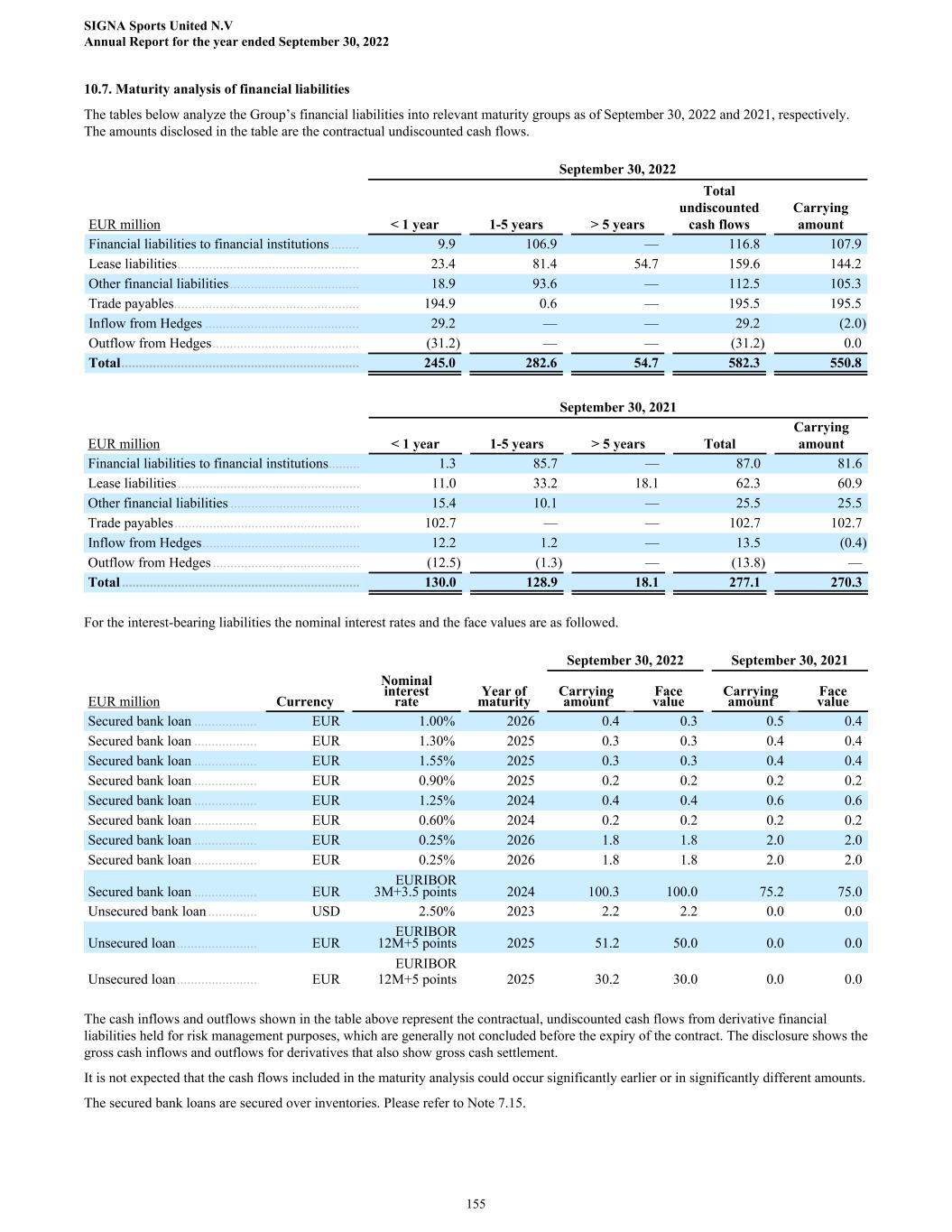
10.7. Maturity analysis of financial liabilities The tables below analyze the Group’s financial liabilities into relevant maturity groups as of September 30, 2022 and 2021, respectively. The amounts disclosed in the table are the contractual undiscounted cash flows. September 30, 2022 EUR million < 1 year 1-5 years > 5 years Total undiscounted cash flows Carrying amount Financial liabilities to financial institutions ........ 9.9 106.9 — 116.8 107.9 Lease liabilities .................................................... 23.4 81.4 54.7 159.6 144.2 Other financial liabilities ..................................... 18.9 93.6 — 112.5 105.3 Trade payables ..................................................... 194.9 0.6 — 195.5 195.5 Inflow from Hedges ............................................ 29.2 — — 29.2 (2.0) Outflow from Hedges .......................................... (31.2) — — (31.2) 0.0 Total .................................................................... 245.0 282.6 54.7 582.3 550.8 September 30, 2021 EUR million < 1 year 1-5 years > 5 years Total Carrying amount Financial liabilities to financial institutions ......... 1.3 85.7 — 87.0 81.6 Lease liabilities .................................................... 11.0 33.2 18.1 62.3 60.9 Other financial liabilities ..................................... 15.4 10.1 — 25.5 25.5 Trade payables ..................................................... 102.7 — — 102.7 102.7 Inflow from Hedges ............................................. 12.2 1.2 — 13.5 (0.4) Outflow from Hedges .......................................... (12.5) (1.3) — (13.8) — Total .................................................................... 130.0 128.9 18.1 277.1 270.3 For the interest-bearing liabilities the nominal interest rates and the face values are as followed. September 30, 2022 September 30, 2021 EUR million Currency Nominal interest rate Year of maturity Carrying amount Face value Carrying amount Face value Secured bank loan .................. EUR 1.00% 2026 0.4 0.3 0.5 0.4 Secured bank loan .................. EUR 1.30% 2025 0.3 0.3 0.4 0.4 Secured bank loan .................. EUR 1.55% 2025 0.3 0.3 0.4 0.4 Secured bank loan .................. EUR 0.90% 2025 0.2 0.2 0.2 0.2 Secured bank loan .................. EUR 1.25% 2024 0.4 0.4 0.6 0.6 Secured bank loan .................. EUR 0.60% 2024 0.2 0.2 0.2 0.2 Secured bank loan .................. EUR 0.25% 2026 1.8 1.8 2.0 2.0 Secured bank loan .................. EUR 0.25% 2026 1.8 1.8 2.0 2.0 Secured bank loan .................. EUR EURIBOR 3M+3.5 points 2024 100.3 100.0 75.2 75.0 Unsecured bank loan .............. USD 2.50% 2023 2.2 2.2 0.0 0.0 Unsecured loan ....................... EUR EURIBOR 12M+5 points 2025 51.2 50.0 0.0 0.0 Unsecured loan ....................... EUR EURIBOR 12M+5 points 2025 30.2 30.0 0.0 0.0 The cash inflows and outflows shown in the table above represent the contractual, undiscounted cash flows from derivative financial liabilities held for risk management purposes, which are generally not concluded before the expiry of the contract. The disclosure shows the gross cash inflows and outflows for derivatives that also show gross cash settlement. It is not expected that the cash flows included in the maturity analysis could occur significantly earlier or in significantly different amounts. The secured bank loans are secured over inventories. Please refer to Note 7.15. SIGNA Sports United N.V Annual Report for the year ended September 30, 2022 155
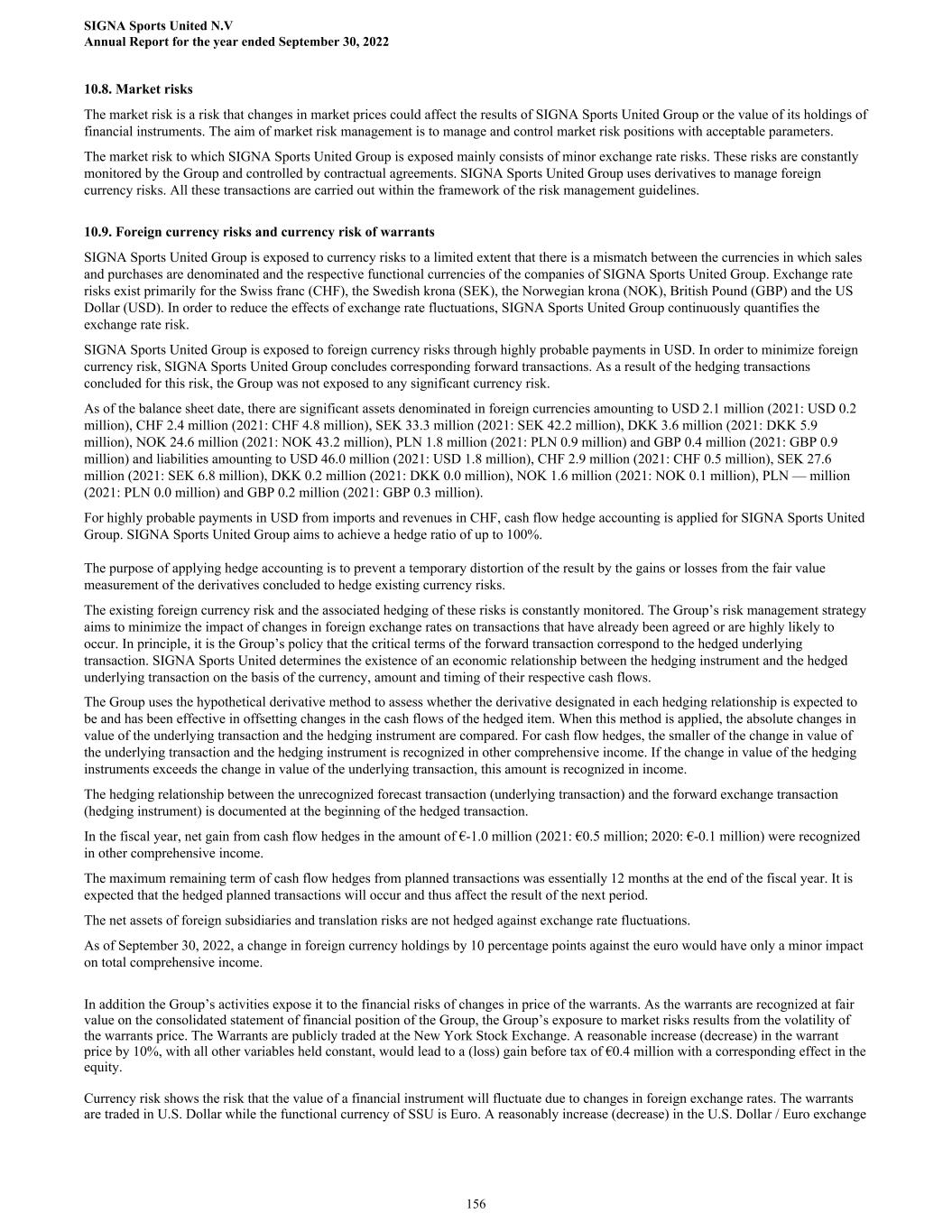
10.8. Market risks The market risk is a risk that changes in market prices could affect the results of SIGNA Sports United Group or the value of its holdings of financial instruments. The aim of market risk management is to manage and control market risk positions with acceptable parameters. The market risk to which SIGNA Sports United Group is exposed mainly consists of minor exchange rate risks. These risks are constantly monitored by the Group and controlled by contractual agreements. SIGNA Sports United Group uses derivatives to manage foreign currency risks. All these transactions are carried out within the framework of the risk management guidelines. 10.9. Foreign currency risks and currency risk of warrants SIGNA Sports United Group is exposed to currency risks to a limited extent that there is a mismatch between the currencies in which sales and purchases are denominated and the respective functional currencies of the companies of SIGNA Sports United Group. Exchange rate risks exist primarily for the Swiss franc (CHF), the Swedish krona (SEK), the Norwegian krona (NOK), British Pound (GBP) and the US Dollar (USD). In order to reduce the effects of exchange rate fluctuations, SIGNA Sports United Group continuously quantifies the exchange rate risk. SIGNA Sports United Group is exposed to foreign currency risks through highly probable payments in USD. In order to minimize foreign currency risk, SIGNA Sports United Group concludes corresponding forward transactions. As a result of the hedging transactions concluded for this risk, the Group was not exposed to any significant currency risk. As of the balance sheet date, there are significant assets denominated in foreign currencies amounting to USD 2.1 million (2021: USD 0.2 million), CHF 2.4 million (2021: CHF 4.8 million), SEK 33.3 million (2021: SEK 42.2 million), DKK 3.6 million (2021: DKK 5.9 million), NOK 24.6 million (2021: NOK 43.2 million), PLN 1.8 million (2021: PLN 0.9 million) and GBP 0.4 million (2021: GBP 0.9 million) and liabilities amounting to USD 46.0 million (2021: USD 1.8 million), CHF 2.9 million (2021: CHF 0.5 million), SEK 27.6 million (2021: SEK 6.8 million), DKK 0.2 million (2021: DKK 0.0 million), NOK 1.6 million (2021: NOK 0.1 million), PLN — million (2021: PLN 0.0 million) and GBP 0.2 million (2021: GBP 0.3 million). For highly probable payments in USD from imports and revenues in CHF, cash flow hedge accounting is applied for SIGNA Sports United Group. SIGNA Sports United Group aims to achieve a hedge ratio of up to 100%. The purpose of applying hedge accounting is to prevent a temporary distortion of the result by the gains or losses from the fair value measurement of the derivatives concluded to hedge existing currency risks. The existing foreign currency risk and the associated hedging of these risks is constantly monitored. The Group’s risk management strategy aims to minimize the impact of changes in foreign exchange rates on transactions that have already been agreed or are highly likely to occur. In principle, it is the Group’s policy that the critical terms of the forward transaction correspond to the hedged underlying transaction. SIGNA Sports United determines the existence of an economic relationship between the hedging instrument and the hedged underlying transaction on the basis of the currency, amount and timing of their respective cash flows. The Group uses the hypothetical derivative method to assess whether the derivative designated in each hedging relationship is expected to be and has been effective in offsetting changes in the cash flows of the hedged item. When this method is applied, the absolute changes in value of the underlying transaction and the hedging instrument are compared. For cash flow hedges, the smaller of the change in value of the underlying transaction and the hedging instrument is recognized in other comprehensive income. If the change in value of the hedging instruments exceeds the change in value of the underlying transaction, this amount is recognized in income. The hedging relationship between the unrecognized forecast transaction (underlying transaction) and the forward exchange transaction (hedging instrument) is documented at the beginning of the hedged transaction. In the fiscal year, net gain from cash flow hedges in the amount of €-1.0 million (2021: €0.5 million; 2020: €-0.1 million) were recognized in other comprehensive income. The maximum remaining term of cash flow hedges from planned transactions was essentially 12 months at the end of the fiscal year. It is expected that the hedged planned transactions will occur and thus affect the result of the next period. The net assets of foreign subsidiaries and translation risks are not hedged against exchange rate fluctuations. As of September 30, 2022, a change in foreign currency holdings by 10 percentage points against the euro would have only a minor impact on total comprehensive income. In addition the Group’s activities expose it to the financial risks of changes in price of the warrants. As the warrants are recognized at fair value on the consolidated statement of financial position of the Group, the Group’s exposure to market risks results from the volatility of the warrants price. The Warrants are publicly traded at the New York Stock Exchange. A reasonable increase (decrease) in the warrant price by 10%, with all other variables held constant, would lead to a (loss) gain before tax of €0.4 million with a corresponding effect in the equity. Currency risk shows the risk that the value of a financial instrument will fluctuate due to changes in foreign exchange rates. The warrants are traded in U.S. Dollar while the functional currency of SSU is Euro. A reasonably increase (decrease) in the U.S. Dollar / Euro exchange SIGNA Sports United N.V Annual Report for the year ended September 30, 2022 156
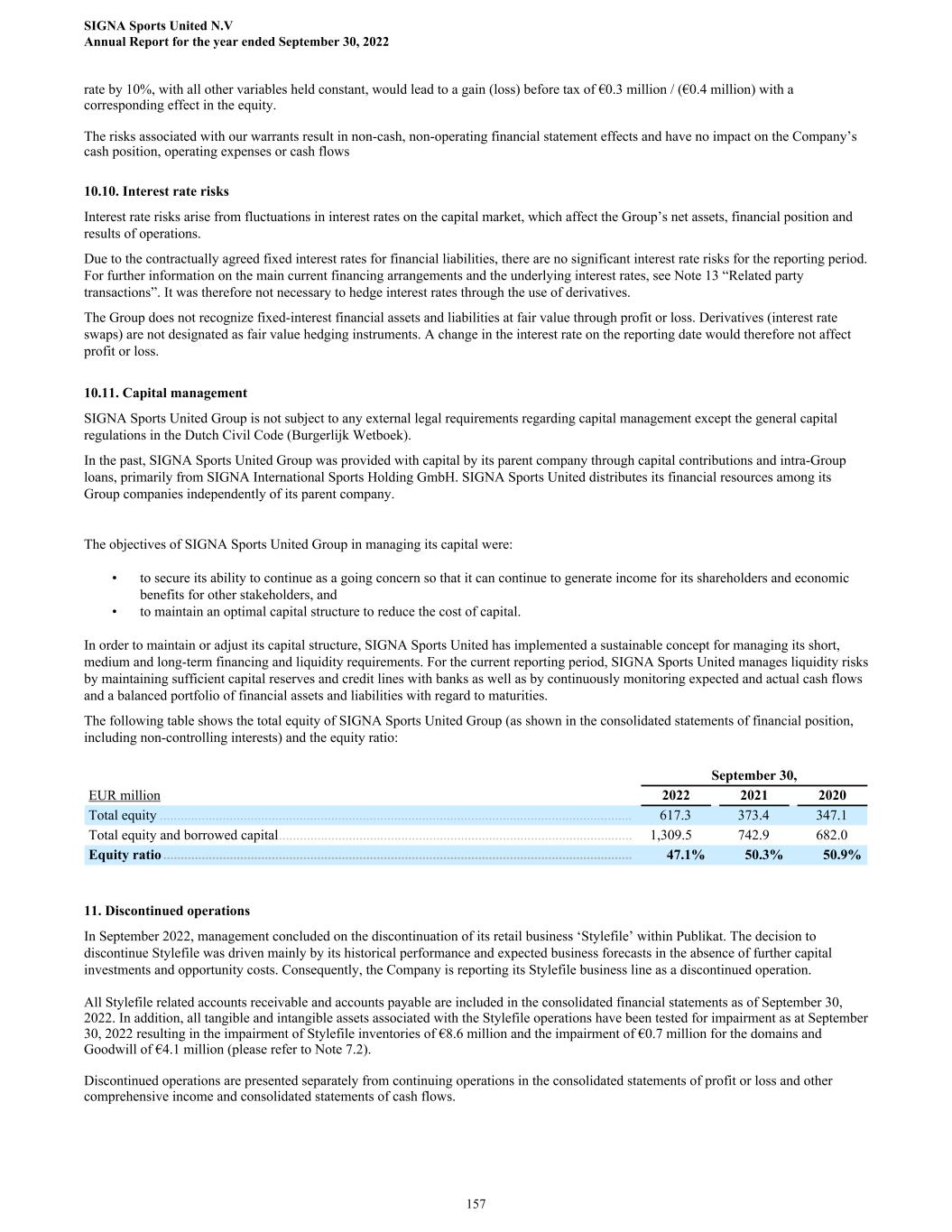
rate by 10%, with all other variables held constant, would lead to a gain (loss) before tax of €0.3 million / (€0.4 million) with a corresponding effect in the equity. The risks associated with our warrants result in non-cash, non-operating financial statement effects and have no impact on the Company’s cash position, operating expenses or cash flows 10.10. Interest rate risks Interest rate risks arise from fluctuations in interest rates on the capital market, which affect the Group’s net assets, financial position and results of operations. Due to the contractually agreed fixed interest rates for financial liabilities, there are no significant interest rate risks for the reporting period. For further information on the main current financing arrangements and the underlying interest rates, see Note 13 “Related party transactions”. It was therefore not necessary to hedge interest rates through the use of derivatives. The Group does not recognize fixed-interest financial assets and liabilities at fair value through profit or loss. Derivatives (interest rate swaps) are not designated as fair value hedging instruments. A change in the interest rate on the reporting date would therefore not affect profit or loss. 10.11. Capital management SIGNA Sports United Group is not subject to any external legal requirements regarding capital management except the general capital regulations in the Dutch Civil Code (Burgerlijk Wetboek). In the past, SIGNA Sports United Group was provided with capital by its parent company through capital contributions and intra-Group loans, primarily from SIGNA International Sports Holding GmbH. SIGNA Sports United distributes its financial resources among its Group companies independently of its parent company. The objectives of SIGNA Sports United Group in managing its capital were: • to secure its ability to continue as a going concern so that it can continue to generate income for its shareholders and economic benefits for other stakeholders, and • to maintain an optimal capital structure to reduce the cost of capital. In order to maintain or adjust its capital structure, SIGNA Sports United has implemented a sustainable concept for managing its short, medium and long-term financing and liquidity requirements. For the current reporting period, SIGNA Sports United manages liquidity risks by maintaining sufficient capital reserves and credit lines with banks as well as by continuously monitoring expected and actual cash flows and a balanced portfolio of financial assets and liabilities with regard to maturities. The following table shows the total equity of SIGNA Sports United Group (as shown in the consolidated statements of financial position, including non-controlling interests) and the equity ratio: September 30, EUR million 2022 2021 2020 Total equity ....................................................................................................................................... 617.3 373.4 347.1 Total equity and borrowed capital ..................................................................................................... 1,309.5 742.9 682.0 Equity ratio ...................................................................................................................................... 47.1% 50.3% 50.9% 11. Discontinued operations In September 2022, management concluded on the discontinuation of its retail business ‘Stylefile’ within Publikat. The decision to discontinue Stylefile was driven mainly by its historical performance and expected business forecasts in the absence of further capital investments and opportunity costs. Consequently, the Company is reporting its Stylefile business line as a discontinued operation. All Stylefile related accounts receivable and accounts payable are included in the consolidated financial statements as of September 30, 2022. In addition, all tangible and intangible assets associated with the Stylefile operations have been tested for impairment as at September 30, 2022 resulting in the impairment of Stylefile inventories of €8.6 million and the impairment of €0.7 million for the domains and Goodwill of €4.1 million (please refer to Note 7.2). Discontinued operations are presented separately from continuing operations in the consolidated statements of profit or loss and other comprehensive income and consolidated statements of cash flows. SIGNA Sports United N.V Annual Report for the year ended September 30, 2022 157
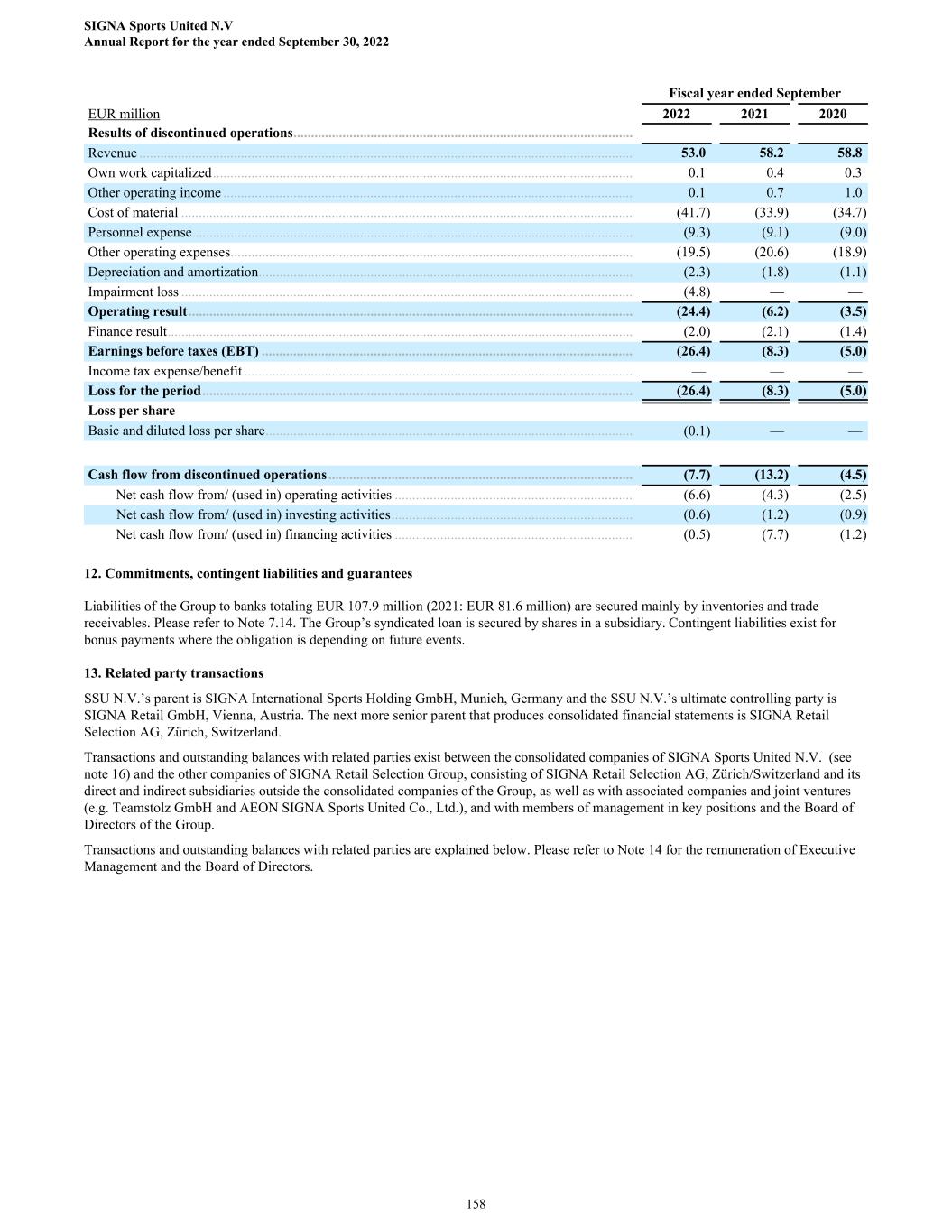
Fiscal year ended September EUR million 2022 2021 2020 Results of discontinued operations ................................................................................................. Revenue ............................................................................................................................................. 53.0 58.2 58.8 Own work capitalized ........................................................................................................................ 0.1 0.4 0.3 Other operating income ..................................................................................................................... 0.1 0.7 1.0 Cost of material ................................................................................................................................. (41.7) (33.9) (34.7) Personnel expense .............................................................................................................................. (9.3) (9.1) (9.0) Other operating expenses ................................................................................................................... (19.5) (20.6) (18.9) Depreciation and amortization ........................................................................................................... (2.3) (1.8) (1.1) Impairment loss ................................................................................................................................. (4.8) — — Operating result ............................................................................................................................... (24.4) (6.2) (3.5) Finance result ..................................................................................................................................... (2.0) (2.1) (1.4) Earnings before taxes (EBT) .......................................................................................................... (26.4) (8.3) (5.0) Income tax expense/benefit ............................................................................................................... — — — Loss for the period ........................................................................................................................... (26.4) (8.3) (5.0) Loss per share Basic and diluted loss per share ......................................................................................................... (0.1) — — Cash flow from discontinued operations ....................................................................................... (7.7) (13.2) (4.5) Net cash flow from/ (used in) operating activities .................................................................... (6.6) (4.3) (2.5) Net cash flow from/ (used in) investing activities ..................................................................... (0.6) (1.2) (0.9) Net cash flow from/ (used in) financing activities .................................................................... (0.5) (7.7) (1.2) 12. Commitments, contingent liabilities and guarantees Liabilities of the Group to banks totaling EUR 107.9 million (2021: EUR 81.6 million) are secured mainly by inventories and trade receivables. Please refer to Note 7.14. The Group’s syndicated loan is secured by shares in a subsidiary. Contingent liabilities exist for bonus payments where the obligation is depending on future events. 13. Related party transactions SSU N.V.’s parent is SIGNA International Sports Holding GmbH, Munich, Germany and the SSU N.V.’s ultimate controlling party is SIGNA Retail GmbH, Vienna, Austria. The next more senior parent that produces consolidated financial statements is SIGNA Retail Selection AG, Zürich, Switzerland. Transactions and outstanding balances with related parties exist between the consolidated companies of SIGNA Sports United N.V. (see note 16) and the other companies of SIGNA Retail Selection Group, consisting of SIGNA Retail Selection AG, Zürich/Switzerland and its direct and indirect subsidiaries outside the consolidated companies of the Group, as well as with associated companies and joint ventures (e.g. Teamstolz GmbH and AEON SIGNA Sports United Co., Ltd.), and with members of management in key positions and the Board of Directors of the Group. Transactions and outstanding balances with related parties are explained below. Please refer to Note 14 for the remuneration of Executive Management and the Board of Directors. SIGNA Sports United N.V Annual Report for the year ended September 30, 2022 158
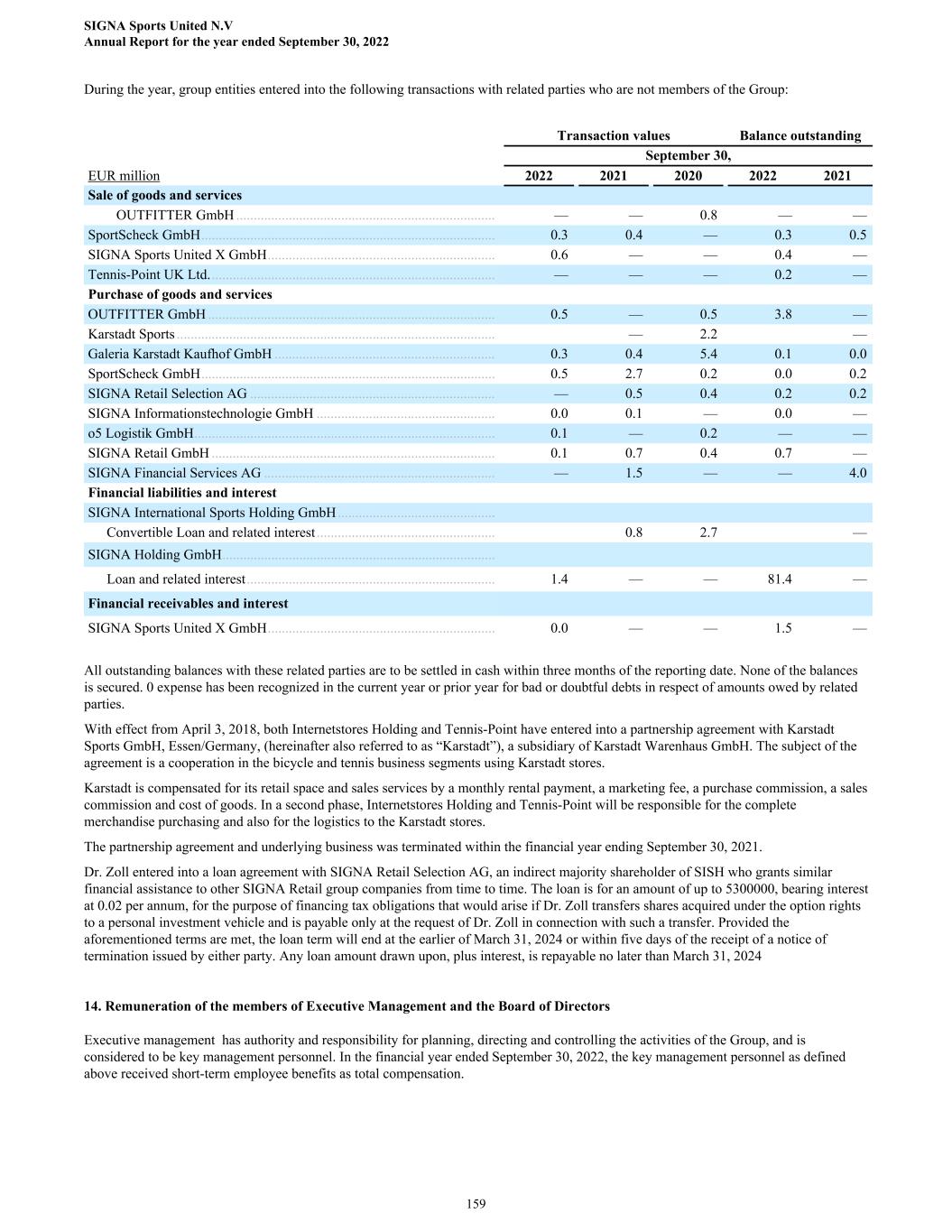
During the year, group entities entered into the following transactions with related parties who are not members of the Group: Transaction values Balance outstanding September 30, EUR million 2022 2021 2020 2022 2021 Sale of goods and services OUTFITTER GmbH .......................................................................... — — 0.8 — — SportScheck GmbH .................................................................................... 0.3 0.4 — 0.3 0.5 SIGNA Sports United X GmbH ................................................................. 0.6 — — 0.4 — Tennis-Point UK Ltd. ................................................................................. — — — 0.2 — Purchase of goods and services OUTFITTER GmbH .................................................................................. 0.5 — 0.5 3.8 — Karstadt Sports ........................................................................................... — 2.2 — Galeria Karstadt Kaufhof GmbH ............................................................... 0.3 0.4 5.4 0.1 0.0 SportScheck GmbH .................................................................................... 0.5 2.7 0.2 0.0 0.2 SIGNA Retail Selection AG ...................................................................... — 0.5 0.4 0.2 0.2 SIGNA Informationstechnologie GmbH ................................................... 0.0 0.1 — 0.0 — o5 Logistik GmbH ...................................................................................... 0.1 — 0.2 — — SIGNA Retail GmbH ................................................................................. 0.1 0.7 0.4 0.7 — SIGNA Financial Services AG .................................................................. — 1.5 — — 4.0 Financial liabilities and interest SIGNA International Sports Holding GmbH ............................................. Convertible Loan and related interest ................................................... 0.8 2.7 — SIGNA Holding GmbH .............................................................................. Loan and related interest ....................................................................... 1.4 — — 81.4 — Financial receivables and interest SIGNA Sports United X GmbH ................................................................. 0.0 — — 1.5 — All outstanding balances with these related parties are to be settled in cash within three months of the reporting date. None of the balances is secured. 0 expense has been recognized in the current year or prior year for bad or doubtful debts in respect of amounts owed by related parties. With effect from April 3, 2018, both Internetstores Holding and Tennis-Point have entered into a partnership agreement with Karstadt Sports GmbH, Essen/Germany, (hereinafter also referred to as “Karstadt”), a subsidiary of Karstadt Warenhaus GmbH. The subject of the agreement is a cooperation in the bicycle and tennis business segments using Karstadt stores. Karstadt is compensated for its retail space and sales services by a monthly rental payment, a marketing fee, a purchase commission, a sales commission and cost of goods. In a second phase, Internetstores Holding and Tennis-Point will be responsible for the complete merchandise purchasing and also for the logistics to the Karstadt stores. The partnership agreement and underlying business was terminated within the financial year ending September 30, 2021. Dr. Zoll entered into a loan agreement with SIGNA Retail Selection AG, an indirect majority shareholder of SISH who grants similar financial assistance to other SIGNA Retail group companies from time to time. The loan is for an amount of up to 5300000, bearing interest at 0.02 per annum, for the purpose of financing tax obligations that would arise if Dr. Zoll transfers shares acquired under the option rights to a personal investment vehicle and is payable only at the request of Dr. Zoll in connection with such a transfer. Provided the aforementioned terms are met, the loan term will end at the earlier of March 31, 2024 or within five days of the receipt of a notice of termination issued by either party. Any loan amount drawn upon, plus interest, is repayable no later than March 31, 2024 14. Remuneration of the members of Executive Management and the Board of Directors Executive management has authority and responsibility for planning, directing and controlling the activities of the Group, and is considered to be key management personnel. In the financial year ended September 30, 2022, the key management personnel as defined above received short-term employee benefits as total compensation. SIGNA Sports United N.V Annual Report for the year ended September 30, 2022 159
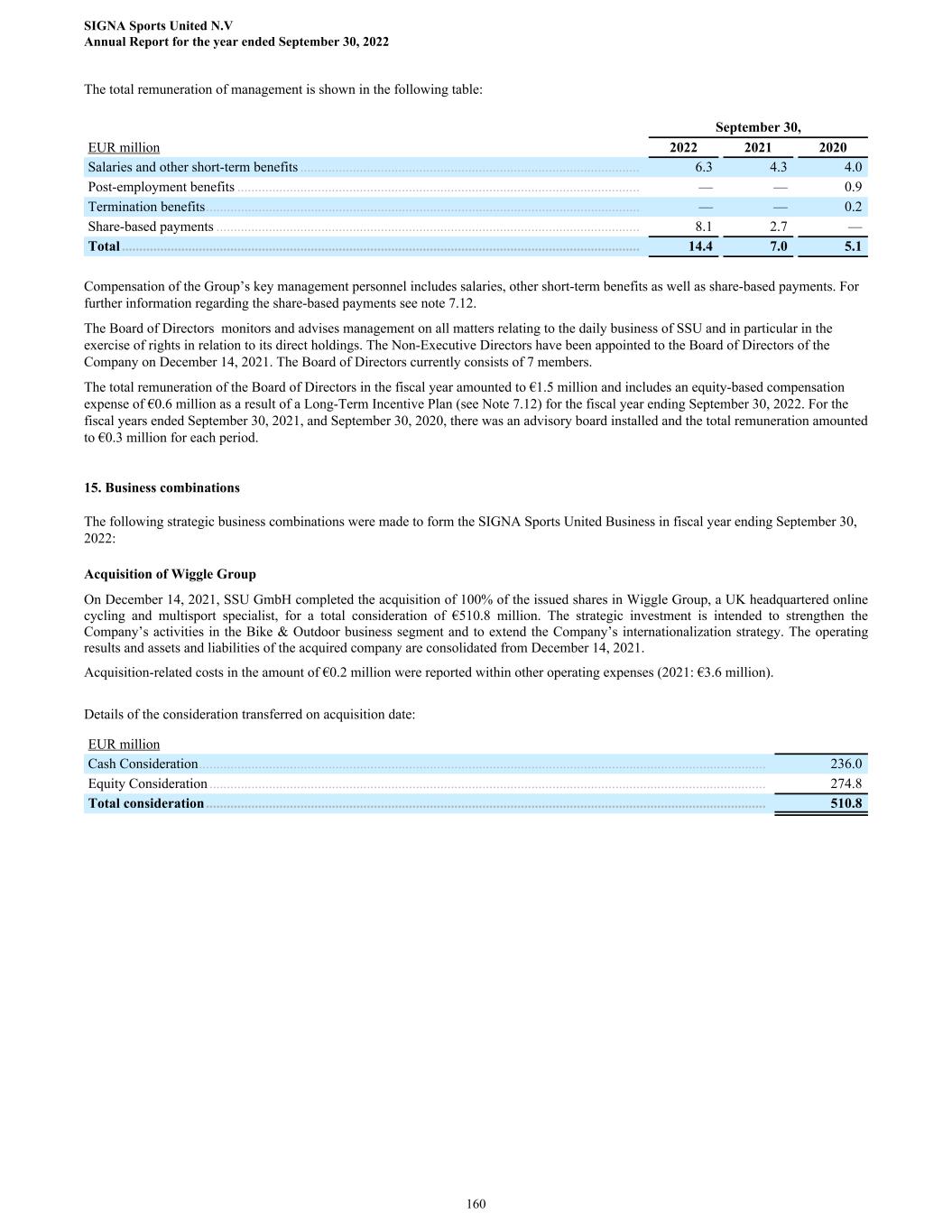
The total remuneration of management is shown in the following table: September 30, EUR million 2022 2021 2020 Salaries and other short-term benefits ................................................................................................. 6.3 4.3 4.0 Post-employment benefits ................................................................................................................... — — 0.9 Termination benefits ............................................................................................................................ — — 0.2 Share-based payments ......................................................................................................................... 8.1 2.7 — Total .................................................................................................................................................... 14.4 7.0 5.1 Compensation of the Group’s key management personnel includes salaries, other short-term benefits as well as share-based payments. For further information regarding the share-based payments see note 7.12. The Board of Directors monitors and advises management on all matters relating to the daily business of SSU and in particular in the exercise of rights in relation to its direct holdings. The Non-Executive Directors have been appointed to the Board of Directors of the Company on December 14, 2021. The Board of Directors currently consists of 7 members. The total remuneration of the Board of Directors in the fiscal year amounted to €1.5 million and includes an equity-based compensation expense of €0.6 million as a result of a Long-Term Incentive Plan (see Note 7.12) for the fiscal year ending September 30, 2022. For the fiscal years ended September 30, 2021, and September 30, 2020, there was an advisory board installed and the total remuneration amounted to €0.3 million for each period. 15. Business combinations The following strategic business combinations were made to form the SIGNA Sports United Business in fiscal year ending September 30, 2022: Acquisition of Wiggle Group On December 14, 2021, SSU GmbH completed the acquisition of 100% of the issued shares in Wiggle Group, a UK headquartered online cycling and multisport specialist, for a total consideration of €510.8 million. The strategic investment is intended to strengthen the Company’s activities in the Bike & Outdoor business segment and to extend the Company’s internationalization strategy. The operating results and assets and liabilities of the acquired company are consolidated from December 14, 2021. Acquisition-related costs in the amount of €0.2 million were reported within other operating expenses (2021: €3.6 million). Details of the consideration transferred on acquisition date: EUR million Cash Consideration .................................................................................................................................................................. 236.0 Equity Consideration ............................................................................................................................................................... 274.8 Total consideration ................................................................................................................................................................ 510.8 SIGNA Sports United N.V Annual Report for the year ended September 30, 2022 160
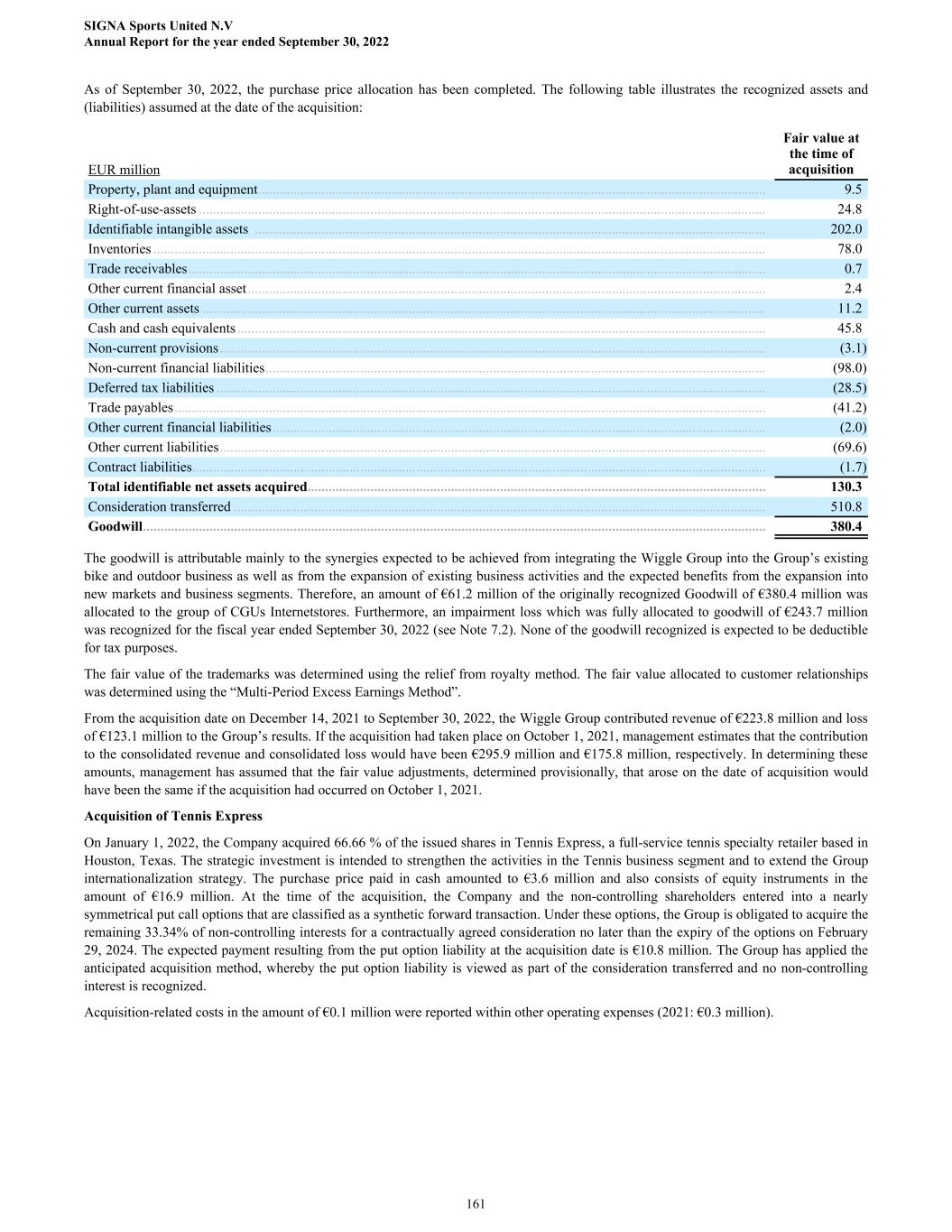
As of September 30, 2022, the purchase price allocation has been completed. The following table illustrates the recognized assets and (liabilities) assumed at the date of the acquisition: EUR million Fair value at the time of acquisition Property, plant and equipment ................................................................................................................................................. 9.5 Right-of-use-assets .................................................................................................................................................................. 24.8 Identifiable intangible assets .................................................................................................................................................. 202.0 Inventories ............................................................................................................................................................................... 78.0 Trade receivables ..................................................................................................................................................................... 0.7 Other current financial asset .................................................................................................................................................... 2.4 Other current assets ................................................................................................................................................................. 11.2 Cash and cash equivalents ....................................................................................................................................................... 45.8 Non-current provisions ............................................................................................................................................................ (3.1) Non-current financial liabilities ............................................................................................................................................... (98.0) Deferred tax liabilities ............................................................................................................................................................. (28.5) Trade payables ......................................................................................................................................................................... (41.2) Other current financial liabilities ............................................................................................................................................. (2.0) Other current liabilities ............................................................................................................................................................ (69.6) Contract liabilities .................................................................................................................................................................... (1.7) Total identifiable net assets acquired ................................................................................................................................... 130.3 Consideration transferred ........................................................................................................................................................ 510.8 Goodwill .................................................................................................................................................................................. 380.4 The goodwill is attributable mainly to the synergies expected to be achieved from integrating the Wiggle Group into the Group’s existing bike and outdoor business as well as from the expansion of existing business activities and the expected benefits from the expansion into new markets and business segments. Therefore, an amount of €61.2 million of the originally recognized Goodwill of €380.4 million was allocated to the group of CGUs Internetstores. Furthermore, an impairment loss which was fully allocated to goodwill of €243.7 million was recognized for the fiscal year ended September 30, 2022 (see Note 7.2). None of the goodwill recognized is expected to be deductible for tax purposes. The fair value of the trademarks was determined using the relief from royalty method. The fair value allocated to customer relationships was determined using the “Multi-Period Excess Earnings Method”. From the acquisition date on December 14, 2021 to September 30, 2022, the Wiggle Group contributed revenue of €223.8 million and loss of €123.1 million to the Group’s results. If the acquisition had taken place on October 1, 2021, management estimates that the contribution to the consolidated revenue and consolidated loss would have been €295.9 million and €175.8 million, respectively. In determining these amounts, management has assumed that the fair value adjustments, determined provisionally, that arose on the date of acquisition would have been the same if the acquisition had occurred on October 1, 2021. Acquisition of Tennis Express On January 1, 2022, the Company acquired 66.66 % of the issued shares in Tennis Express, a full-service tennis specialty retailer based in Houston, Texas. The strategic investment is intended to strengthen the activities in the Tennis business segment and to extend the Group internationalization strategy. The purchase price paid in cash amounted to €3.6 million and also consists of equity instruments in the amount of €16.9 million. At the time of the acquisition, the Company and the non-controlling shareholders entered into a nearly symmetrical put call options that are classified as a synthetic forward transaction. Under these options, the Group is obligated to acquire the remaining 33.34% of non-controlling interests for a contractually agreed consideration no later than the expiry of the options on February 29, 2024. The expected payment resulting from the put option liability at the acquisition date is €10.8 million. The Group has applied the anticipated acquisition method, whereby the put option liability is viewed as part of the consideration transferred and no non-controlling interest is recognized. Acquisition-related costs in the amount of €0.1 million were reported within other operating expenses (2021: €0.3 million). SIGNA Sports United N.V Annual Report for the year ended September 30, 2022 161
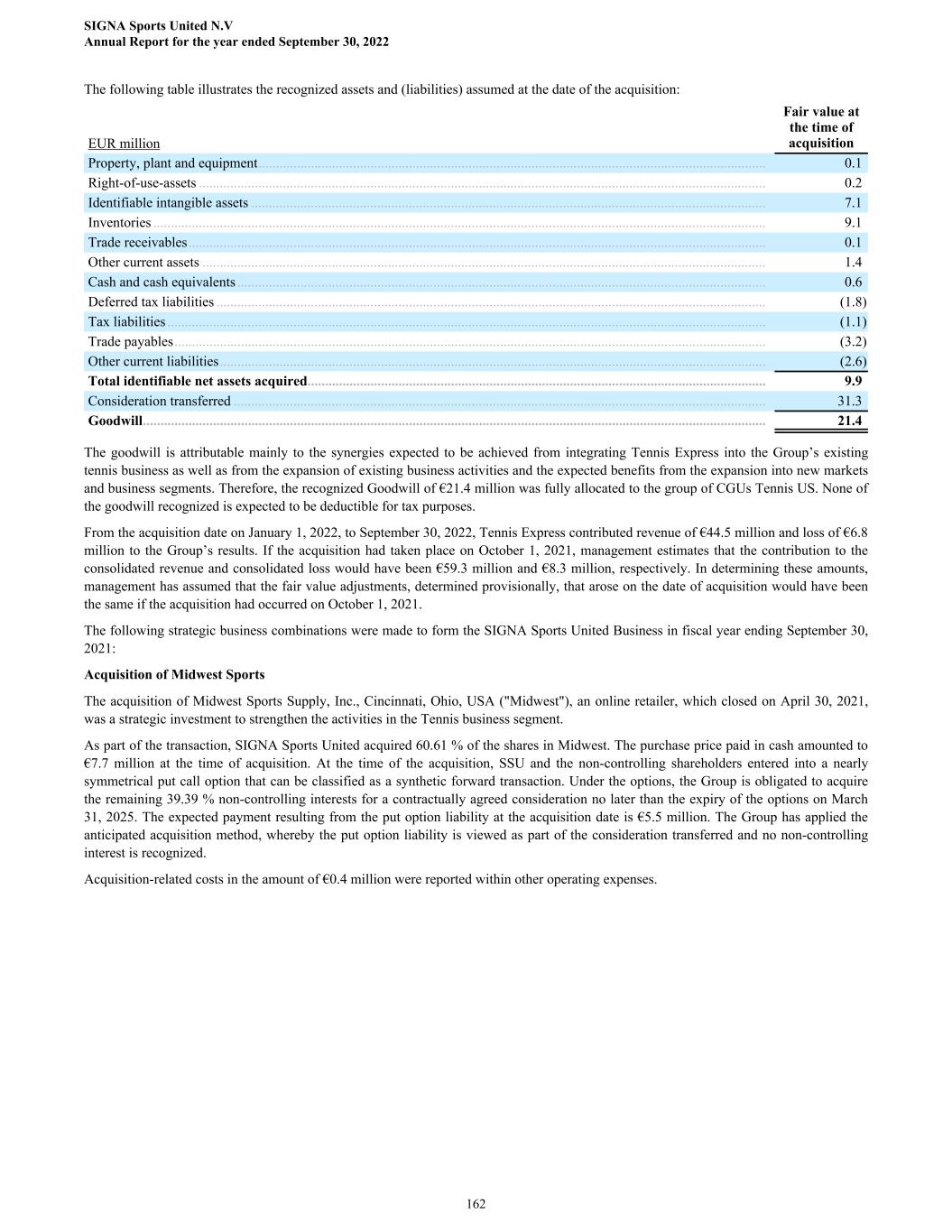
The following table illustrates the recognized assets and (liabilities) assumed at the date of the acquisition: EUR million Fair value at the time of acquisition Property, plant and equipment ................................................................................................................................................. 0.1 Right-of-use-assets .................................................................................................................................................................. 0.2 Identifiable intangible assets ................................................................................................................................................... 7.1 Inventories ............................................................................................................................................................................... 9.1 Trade receivables ..................................................................................................................................................................... 0.1 Other current assets ................................................................................................................................................................. 1.4 Cash and cash equivalents ....................................................................................................................................................... 0.6 Deferred tax liabilities ............................................................................................................................................................. (1.8) Tax liabilities ........................................................................................................................................................................... (1.1) Trade payables ......................................................................................................................................................................... (3.2) Other current liabilities ............................................................................................................................................................ (2.6) Total identifiable net assets acquired ................................................................................................................................... 9.9 Consideration transferred ........................................................................................................................................................ 31.3 Goodwill .................................................................................................................................................................................. 21.4 The goodwill is attributable mainly to the synergies expected to be achieved from integrating Tennis Express into the Group’s existing tennis business as well as from the expansion of existing business activities and the expected benefits from the expansion into new markets and business segments. Therefore, the recognized Goodwill of €21.4 million was fully allocated to the group of CGUs Tennis US. None of the goodwill recognized is expected to be deductible for tax purposes. From the acquisition date on January 1, 2022, to September 30, 2022, Tennis Express contributed revenue of €44.5 million and loss of €6.8 million to the Group’s results. If the acquisition had taken place on October 1, 2021, management estimates that the contribution to the consolidated revenue and consolidated loss would have been €59.3 million and €8.3 million, respectively. In determining these amounts, management has assumed that the fair value adjustments, determined provisionally, that arose on the date of acquisition would have been the same if the acquisition had occurred on October 1, 2021. The following strategic business combinations were made to form the SIGNA Sports United Business in fiscal year ending September 30, 2021: Acquisition of Midwest Sports The acquisition of Midwest Sports Supply, Inc., Cincinnati, Ohio, USA ("Midwest"), an online retailer, which closed on April 30, 2021, was a strategic investment to strengthen the activities in the Tennis business segment. As part of the transaction, SIGNA Sports United acquired 60.61 % of the shares in Midwest. The purchase price paid in cash amounted to €7.7 million at the time of acquisition. At the time of the acquisition, SSU and the non-controlling shareholders entered into a nearly symmetrical put call option that can be classified as a synthetic forward transaction. Under the options, the Group is obligated to acquire the remaining 39.39 % non-controlling interests for a contractually agreed consideration no later than the expiry of the options on March 31, 2025. The expected payment resulting from the put option liability at the acquisition date is €5.5 million. The Group has applied the anticipated acquisition method, whereby the put option liability is viewed as part of the consideration transferred and no non-controlling interest is recognized. Acquisition-related costs in the amount of €0.4 million were reported within other operating expenses. SIGNA Sports United N.V Annual Report for the year ended September 30, 2022 162
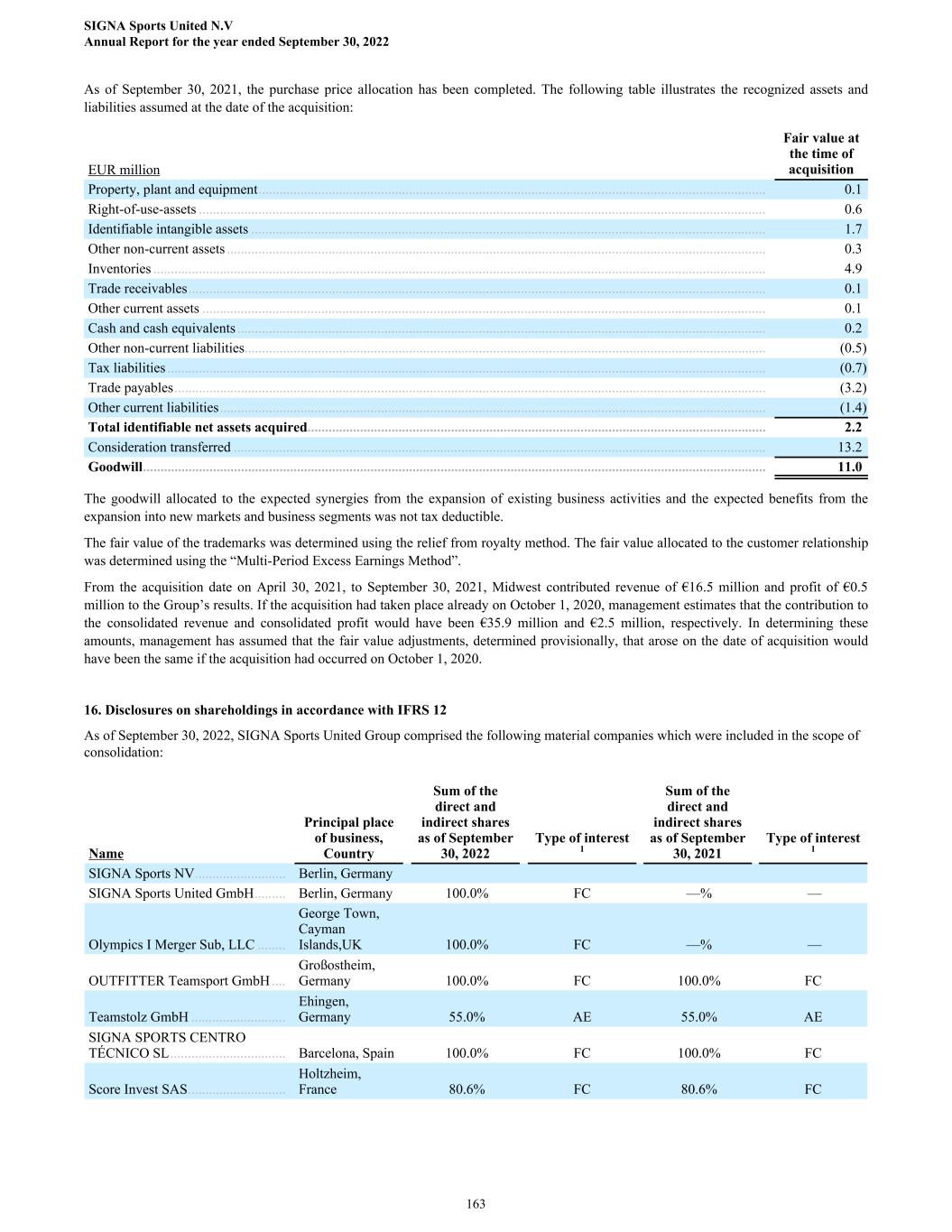
As of September 30, 2021, the purchase price allocation has been completed. The following table illustrates the recognized assets and liabilities assumed at the date of the acquisition: EUR million Fair value at the time of acquisition Property, plant and equipment ................................................................................................................................................. 0.1 Right-of-use-assets .................................................................................................................................................................. 0.6 Identifiable intangible assets ................................................................................................................................................... 1.7 Other non-current assets .......................................................................................................................................................... 0.3 Inventories ............................................................................................................................................................................... 4.9 Trade receivables ..................................................................................................................................................................... 0.1 Other current assets ................................................................................................................................................................. 0.1 Cash and cash equivalents ....................................................................................................................................................... 0.2 Other non-current liabilities ..................................................................................................................................................... (0.5) Tax liabilities ........................................................................................................................................................................... (0.7) Trade payables ......................................................................................................................................................................... (3.2) Other current liabilities ............................................................................................................................................................ (1.4) Total identifiable net assets acquired ................................................................................................................................... 2.2 Consideration transferred ........................................................................................................................................................ 13.2 Goodwill .................................................................................................................................................................................. 11.0 The goodwill allocated to the expected synergies from the expansion of existing business activities and the expected benefits from the expansion into new markets and business segments was not tax deductible. The fair value of the trademarks was determined using the relief from royalty method. The fair value allocated to the customer relationship was determined using the “Multi-Period Excess Earnings Method”. From the acquisition date on April 30, 2021, to September 30, 2021, Midwest contributed revenue of €16.5 million and profit of €0.5 million to the Group’s results. If the acquisition had taken place already on October 1, 2020, management estimates that the contribution to the consolidated revenue and consolidated profit would have been €35.9 million and €2.5 million, respectively. In determining these amounts, management has assumed that the fair value adjustments, determined provisionally, that arose on the date of acquisition would have been the same if the acquisition had occurred on October 1, 2020. 16. Disclosures on shareholdings in accordance with IFRS 12 As of September 30, 2022, SIGNA Sports United Group comprised the following material companies which were included in the scope of consolidation: Name Principal place of business, Country Sum of the direct and indirect shares as of September 30, 2022 Type of interest 1 Sum of the direct and indirect shares as of September 30, 2021 Type of interest 1 SIGNA Sports NV .......................... Berlin, Germany SIGNA Sports United GmbH ......... Berlin, Germany 100.0% FC —% — Olympics I Merger Sub, LLC ........ George Town, Cayman Islands,UK 100.0% FC —% — OUTFITTER Teamsport GmbH .... Großostheim, Germany 100.0% FC 100.0% FC Teamstolz GmbH ........................... Ehingen, Germany 55.0% AE 55.0% AE SIGNA SPORTS CENTRO TÉCNICO SL ................................. Barcelona, Spain 100.0% FC 100.0% FC Score Invest SAS ............................ Holtzheim, France 80.6% FC 80.6% FC SIGNA Sports United N.V Annual Report for the year ended September 30, 2022 163
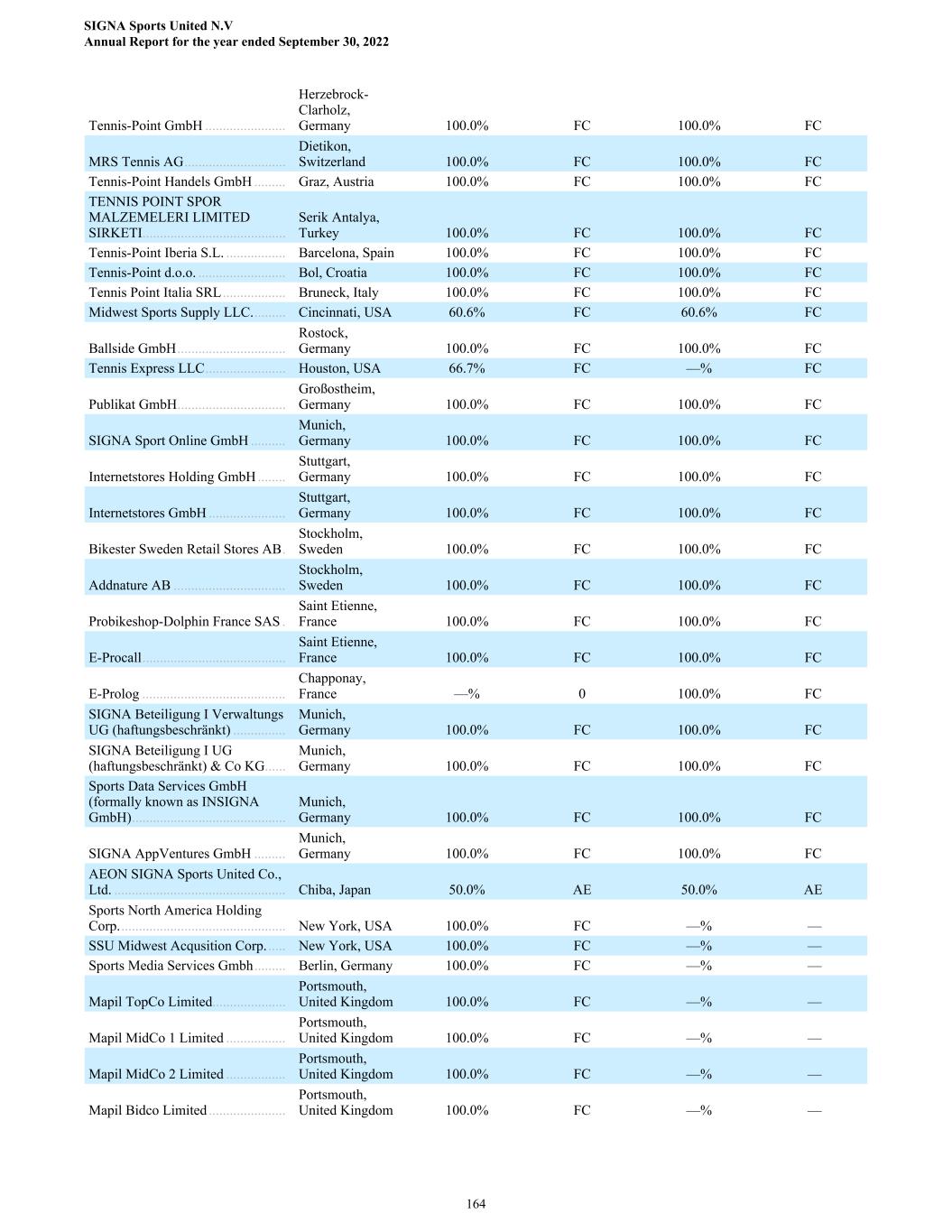
Tennis-Point GmbH ....................... Herzebrock- Clarholz, Germany 100.0% FC 100.0% FC MRS Tennis AG ............................. Dietikon, Switzerland 100.0% FC 100.0% FC Tennis-Point Handels GmbH ......... Graz, Austria 100.0% FC 100.0% FC TENNIS POINT SPOR MALZEMELERI LIMITED SIRKETI ......................................... Serik Antalya, Turkey 100.0% FC 100.0% FC Tennis-Point Iberia S.L. ................. Barcelona, Spain 100.0% FC 100.0% FC Tennis-Point d.o.o. ......................... Bol, Croatia 100.0% FC 100.0% FC Tennis Point Italia SRL .................. Bruneck, Italy 100.0% FC 100.0% FC Midwest Sports Supply LLC. ......... Cincinnati, USA 60.6% FC 60.6% FC Ballside GmbH ............................... Rostock, Germany 100.0% FC 100.0% FC Tennis Express LLC ....................... Houston, USA 66.7% FC —% FC Publikat GmbH ............................... Großostheim, Germany 100.0% FC 100.0% FC SIGNA Sport Online GmbH .......... Munich, Germany 100.0% FC 100.0% FC Internetstores Holding GmbH ........ Stuttgart, Germany 100.0% FC 100.0% FC Internetstores GmbH ...................... Stuttgart, Germany 100.0% FC 100.0% FC Bikester Sweden Retail Stores AB . Stockholm, Sweden 100.0% FC 100.0% FC Addnature AB ................................ Stockholm, Sweden 100.0% FC 100.0% FC Probikeshop-Dolphin France SAS . Saint Etienne, France 100.0% FC 100.0% FC E-Procall ......................................... Saint Etienne, France 100.0% FC 100.0% FC E-Prolog ......................................... Chapponay, France —% 0 100.0% FC SIGNA Beteiligung I Verwaltungs UG (haftungsbeschränkt) ............... Munich, Germany 100.0% FC 100.0% FC SIGNA Beteiligung I UG (haftungsbeschränkt) & Co KG ...... Munich, Germany 100.0% FC 100.0% FC Sports Data Services GmbH (formally known as INSIGNA GmbH) ............................................ Munich, Germany 100.0% FC 100.0% FC SIGNA AppVentures GmbH ......... Munich, Germany 100.0% FC 100.0% FC AEON SIGNA Sports United Co., Ltd. ................................................. Chiba, Japan 50.0% AE 50.0% AE Sports North America Holding Corp. ............................................... New York, USA 100.0% FC —% — SSU Midwest Acqusition Corp. ..... New York, USA 100.0% FC —% — Sports Media Services Gmbh ......... Berlin, Germany 100.0% FC —% — Mapil TopCo Limited ..................... Portsmouth, United Kingdom 100.0% FC —% — Mapil MidCo 1 Limited ................. Portsmouth, United Kingdom 100.0% FC —% — Mapil MidCo 2 Limited ................. Portsmouth, United Kingdom 100.0% FC —% — Mapil Bidco Limited ...................... Portsmouth, United Kingdom 100.0% FC —% — SIGNA Sports United N.V Annual Report for the year ended September 30, 2022 164

Ensco 503 Limited ......................... Portsmouth, United Kingdom 100.0% FC —% — Wiggle Limited .............................. Portsmouth, United Kingdom 100.0% FC —% — Peleton Topco Limited ................... Portsmouth, United Kingdom 100.0% FC —% — Peleton Midco 1 Limited ................ Portsmouth, United Kingdom 100.0% FC —% — Chain Reaction Cycles Limited ...... Portsmouth, United Kingdom 100.0% FC —% — Hotlines Europe Limited ................ Edinburgh, United Kingdom 100.0% FC —% — Chain Reaction Cycles Retail Limited ........................................... Belfast, United Kingdom 100.0% FC —% — Taiwan Chain Reaction Co. Ltd ..... Yuanlin, Taiwan 100.0% FC —% — Wiggle Australia Pty Limited ........ Portsmouth, United Kingdom 100.0% FC —% — WiggleCRC US LLC ..................... Portsmouth, United Kingdom 100.0% FC —% — 1 FC: Full consolidation, AE: At-equity Although, the Group has half of the voting rights of AEON SIGNA Sports United Co., Ltd. and Teamstolz GmbH, management decided that the Group has no control over these investees, AEON SIGNA Sports United Co., Ltd and Teamstolz GmbH are accounted for at- equity. 17. Segment information Basis for segmentation SIGNA Sports United Group operates a variety of e-commerce platforms and offline stores for various brands and offers a broad product portfolio in the sporting goods sector. The Group has the following divisions, which are its operating segments: Tennis EU, Tennis US, Bike & Outdoor, Wiggle Group and Teamsport. In the current financial year the Group decided to discontinue its ‘Stylefile’ business (see note 11). These divisions offer different products and services and are managed separately because they require different technology and marketing strategies. The Wiggle Group was added in the current year as an operating segment following the business combination in December 2022. Similarly, the Tennis US operating segment was added in the current year following the acquisition of Tennis Express and the shift of Midwest Sports from the Tennis EU operating segment to the Tennis US operating segment. (refer Note 15. Business combinations). Segment Operations Tennis EU Retail activities and online business with main brands Tennis-Point and TennisPro; product portfolio comprises tennis supplies which are sold mainly in Europe Tennis US Retail activities and online business with main brands Tennis-Point (Midwest Sports) and Tennis Express; product portfolio comprises tennis supplies which are sold mainly in the US Bike & Outdoor Retail activities and online business through various brands; product portfolio comprises bikes and related services as well as outdoor products Wiggle Group Retail activities and online business through various brands; product portfolio comprises bikes and related services which are sold mainly in the UK Teamsport Sale through the online shop OUTFITTER; focus is on offering and selling sports & teamsports wear as well as customizing of merchandise Operating segments are reported in a manner consistent with the internal reporting provided to the chief operating decision-maker (CODM). The CODM evaluates the financial performance of SIGNA Sports United Group, allocates resources and is involved in strategic and operational decision making on an ongoing basis. The CODM receives and reviews the internal management reporting for each SIGNA Sports United N.V Annual Report for the year ended September 30, 2022 165
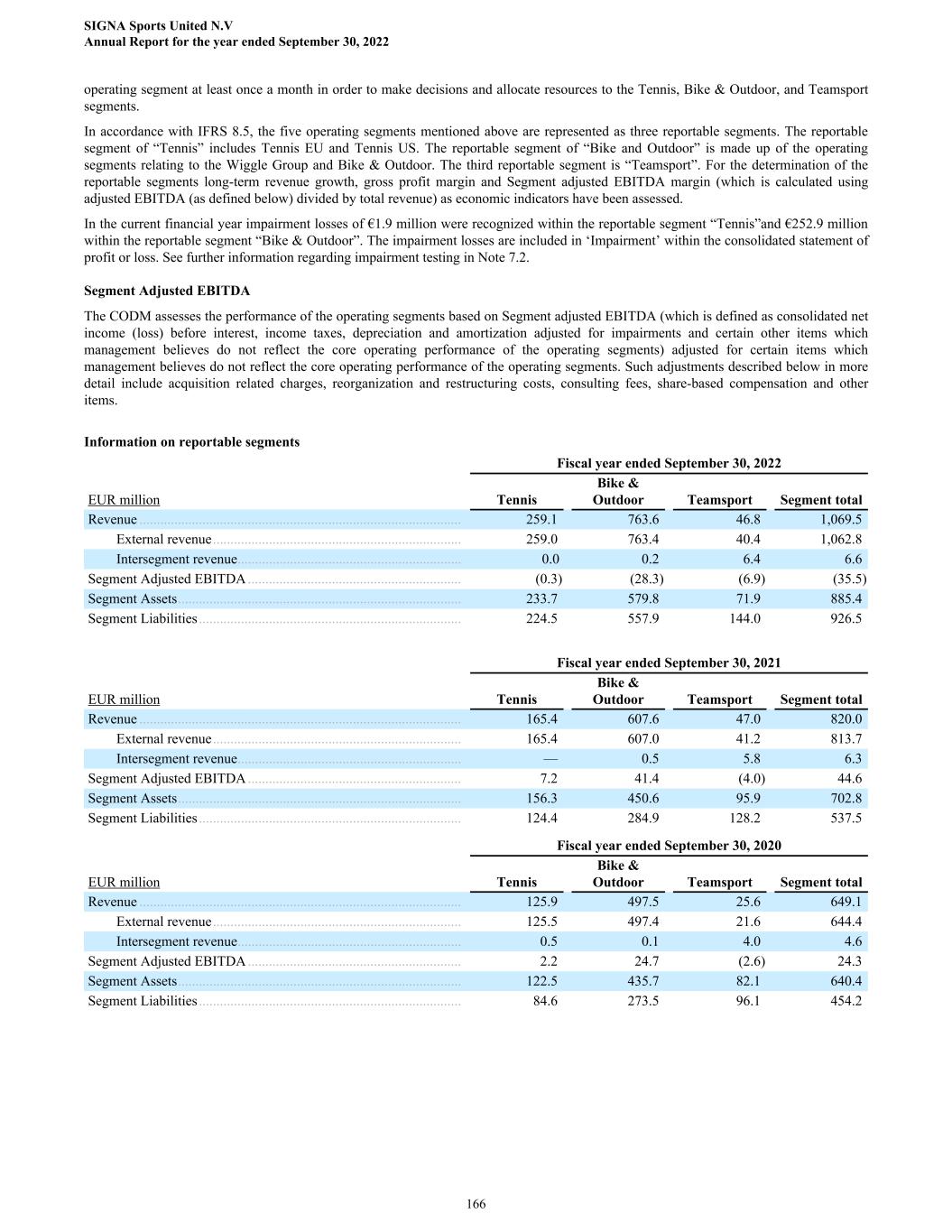
operating segment at least once a month in order to make decisions and allocate resources to the Tennis, Bike & Outdoor, and Teamsport segments. In accordance with IFRS 8.5, the five operating segments mentioned above are represented as three reportable segments. The reportable segment of “Tennis” includes Tennis EU and Tennis US. The reportable segment of “Bike and Outdoor” is made up of the operating segments relating to the Wiggle Group and Bike & Outdoor. The third reportable segment is “Teamsport”. For the determination of the reportable segments long-term revenue growth, gross profit margin and Segment adjusted EBITDA margin (which is calculated using adjusted EBITDA (as defined below) divided by total revenue) as economic indicators have been assessed. In the current financial year impairment losses of €1.9 million were recognized within the reportable segment “Tennis”and €252.9 million within the reportable segment “Bike & Outdoor”. The impairment losses are included in ‘Impairment’ within the consolidated statement of profit or loss. See further information regarding impairment testing in Note 7.2. Segment Adjusted EBITDA The CODM assesses the performance of the operating segments based on Segment adjusted EBITDA (which is defined as consolidated net income (loss) before interest, income taxes, depreciation and amortization adjusted for impairments and certain other items which management believes do not reflect the core operating performance of the operating segments) adjusted for certain items which management believes do not reflect the core operating performance of the operating segments. Such adjustments described below in more detail include acquisition related charges, reorganization and restructuring costs, consulting fees, share-based compensation and other items. Information on reportable segments Fiscal year ended September 30, 2022 EUR million Tennis Bike & Outdoor Teamsport Segment total Revenue ............................................................................................ 259.1 763.6 46.8 1,069.5 External revenue ....................................................................... 259.0 763.4 40.4 1,062.8 Intersegment revenue ................................................................ 0.0 0.2 6.4 6.6 Segment Adjusted EBITDA ............................................................. (0.3) (28.3) (6.9) (35.5) Segment Assets ................................................................................. 233.7 579.8 71.9 885.4 Segment Liabilities ........................................................................... 224.5 557.9 144.0 926.5 Fiscal year ended September 30, 2021 EUR million Tennis Bike & Outdoor Teamsport Segment total Revenue ............................................................................................ 165.4 607.6 47.0 820.0 External revenue ....................................................................... 165.4 607.0 41.2 813.7 Intersegment revenue ................................................................ — 0.5 5.8 6.3 Segment Adjusted EBITDA ............................................................. 7.2 41.4 (4.0) 44.6 Segment Assets ................................................................................. 156.3 450.6 95.9 702.8 Segment Liabilities ........................................................................... 124.4 284.9 128.2 537.5 Fiscal year ended September 30, 2020 EUR million Tennis Bike & Outdoor Teamsport Segment total Revenue ............................................................................................ 125.9 497.5 25.6 649.1 External revenue ....................................................................... 125.5 497.4 21.6 644.4 Intersegment revenue ................................................................ 0.5 0.1 4.0 4.6 Segment Adjusted EBITDA ............................................................. 2.2 24.7 (2.6) 24.3 Segment Assets ................................................................................. 122.5 435.7 82.1 640.4 Segment Liabilities ........................................................................... 84.6 273.5 96.1 454.2 SIGNA Sports United N.V Annual Report for the year ended September 30, 2022 166
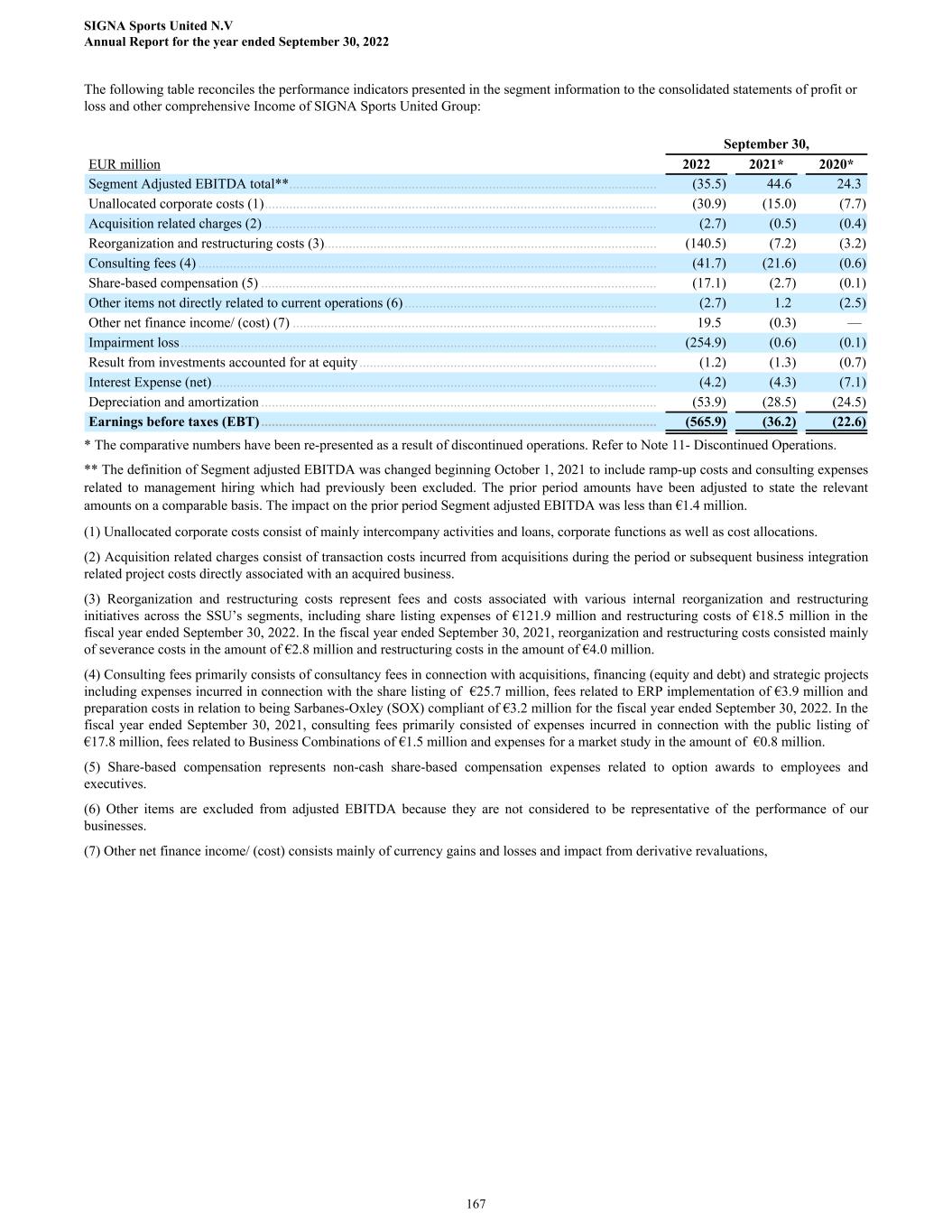
The following table reconciles the performance indicators presented in the segment information to the consolidated statements of profit or loss and other comprehensive Income of SIGNA Sports United Group: September 30, EUR million 2022 2021* 2020* Segment Adjusted EBITDA total** ......................................................................................................... (35.5) 44.6 24.3 Unallocated corporate costs (1) ................................................................................................................ (30.9) (15.0) (7.7) Acquisition related charges (2) ................................................................................................................ (2.7) (0.5) (0.4) Reorganization and restructuring costs (3) ............................................................................................... (140.5) (7.2) (3.2) Consulting fees (4) ................................................................................................................................... (41.7) (21.6) (0.6) Share-based compensation (5) ................................................................................................................. (17.1) (2.7) (0.1) Other items not directly related to current operations (6) ........................................................................ (2.7) 1.2 (2.5) Other net finance income/ (cost) (7) ........................................................................................................ 19.5 (0.3) — Impairment loss ........................................................................................................................................ (254.9) (0.6) (0.1) Result from investments accounted for at equity ..................................................................................... (1.2) (1.3) (0.7) Interest Expense (net) ............................................................................................................................... (4.2) (4.3) (7.1) Depreciation and amortization ................................................................................................................. (53.9) (28.5) (24.5) Earnings before taxes (EBT) ................................................................................................................. (565.9) (36.2) (22.6) * The comparative numbers have been re-presented as a result of discontinued operations. Refer to Note 11- Discontinued Operations. ** The definition of Segment adjusted EBITDA was changed beginning October 1, 2021 to include ramp-up costs and consulting expenses related to management hiring which had previously been excluded. The prior period amounts have been adjusted to state the relevant amounts on a comparable basis. The impact on the prior period Segment adjusted EBITDA was less than €1.4 million. (1) Unallocated corporate costs consist of mainly intercompany activities and loans, corporate functions as well as cost allocations. (2) Acquisition related charges consist of transaction costs incurred from acquisitions during the period or subsequent business integration related project costs directly associated with an acquired business. (3) Reorganization and restructuring costs represent fees and costs associated with various internal reorganization and restructuring initiatives across the SSU’s segments, including share listing expenses of €121.9 million and restructuring costs of €18.5 million in the fiscal year ended September 30, 2022. In the fiscal year ended September 30, 2021, reorganization and restructuring costs consisted mainly of severance costs in the amount of €2.8 million and restructuring costs in the amount of €4.0 million. (4) Consulting fees primarily consists of consultancy fees in connection with acquisitions, financing (equity and debt) and strategic projects including expenses incurred in connection with the share listing of €25.7 million, fees related to ERP implementation of €3.9 million and preparation costs in relation to being Sarbanes-Oxley (SOX) compliant of €3.2 million for the fiscal year ended September 30, 2022. In the fiscal year ended September 30, 2021, consulting fees primarily consisted of expenses incurred in connection with the public listing of €17.8 million, fees related to Business Combinations of €1.5 million and expenses for a market study in the amount of €0.8 million. (5) Share-based compensation represents non-cash share-based compensation expenses related to option awards to employees and executives. (6) Other items are excluded from adjusted EBITDA because they are not considered to be representative of the performance of our businesses. (7) Other net finance income/ (cost) consists mainly of currency gains and losses and impact from derivative revaluations, SIGNA Sports United N.V Annual Report for the year ended September 30, 2022 167
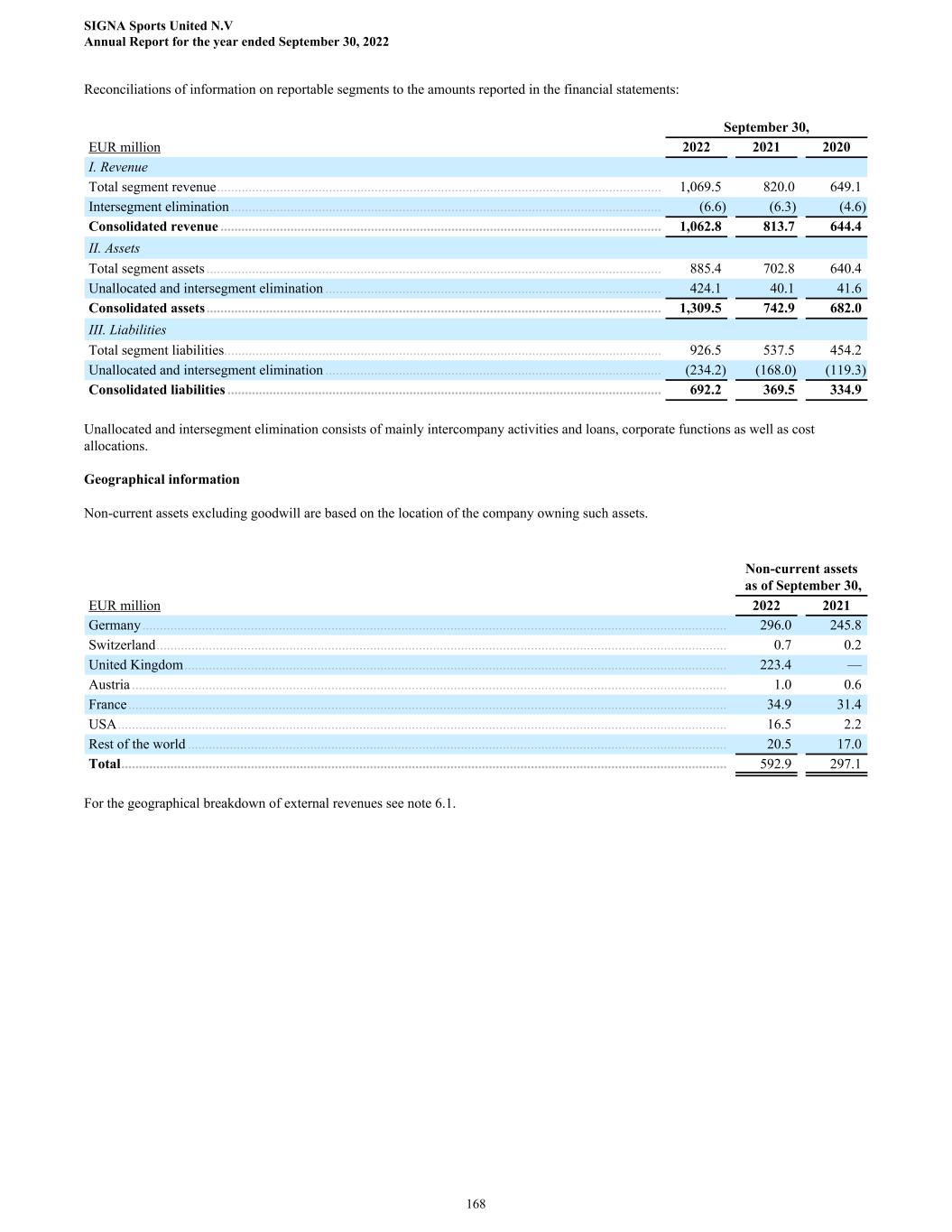
Reconciliations of information on reportable segments to the amounts reported in the financial statements: September 30, EUR million 2022 2021 2020 I. Revenue Total segment revenue ............................................................................................................................... 1,069.5 820.0 649.1 Intersegment elimination ........................................................................................................................... (6.6) (6.3) (4.6) Consolidated revenue .............................................................................................................................. 1,062.8 813.7 644.4 II. Assets Total segment assets .................................................................................................................................. 885.4 702.8 640.4 Unallocated and intersegment elimination ................................................................................................ 424.1 40.1 41.6 Consolidated assets .................................................................................................................................. 1,309.5 742.9 682.0 III. Liabilities Total segment liabilities ............................................................................................................................. 926.5 537.5 454.2 Unallocated and intersegment elimination ................................................................................................ (234.2) (168.0) (119.3) Consolidated liabilities ............................................................................................................................ 692.2 369.5 334.9 Unallocated and intersegment elimination consists of mainly intercompany activities and loans, corporate functions as well as cost allocations. Geographical information Non-current assets excluding goodwill are based on the location of the company owning such assets. Non-current assets as of September 30, EUR million 2022 2021 Germany ....................................................................................................................................................................... 296.0 245.8 Switzerland ................................................................................................................................................................... 0.7 0.2 United Kingdom ........................................................................................................................................................... 223.4 — Austria .......................................................................................................................................................................... 1.0 0.6 France ........................................................................................................................................................................... 34.9 31.4 USA .............................................................................................................................................................................. 16.5 2.2 Rest of the world .......................................................................................................................................................... 20.5 17.0 Total ............................................................................................................................................................................. 592.9 297.1 For the geographical breakdown of external revenues see note 6.1. SIGNA Sports United N.V Annual Report for the year ended September 30, 2022 168
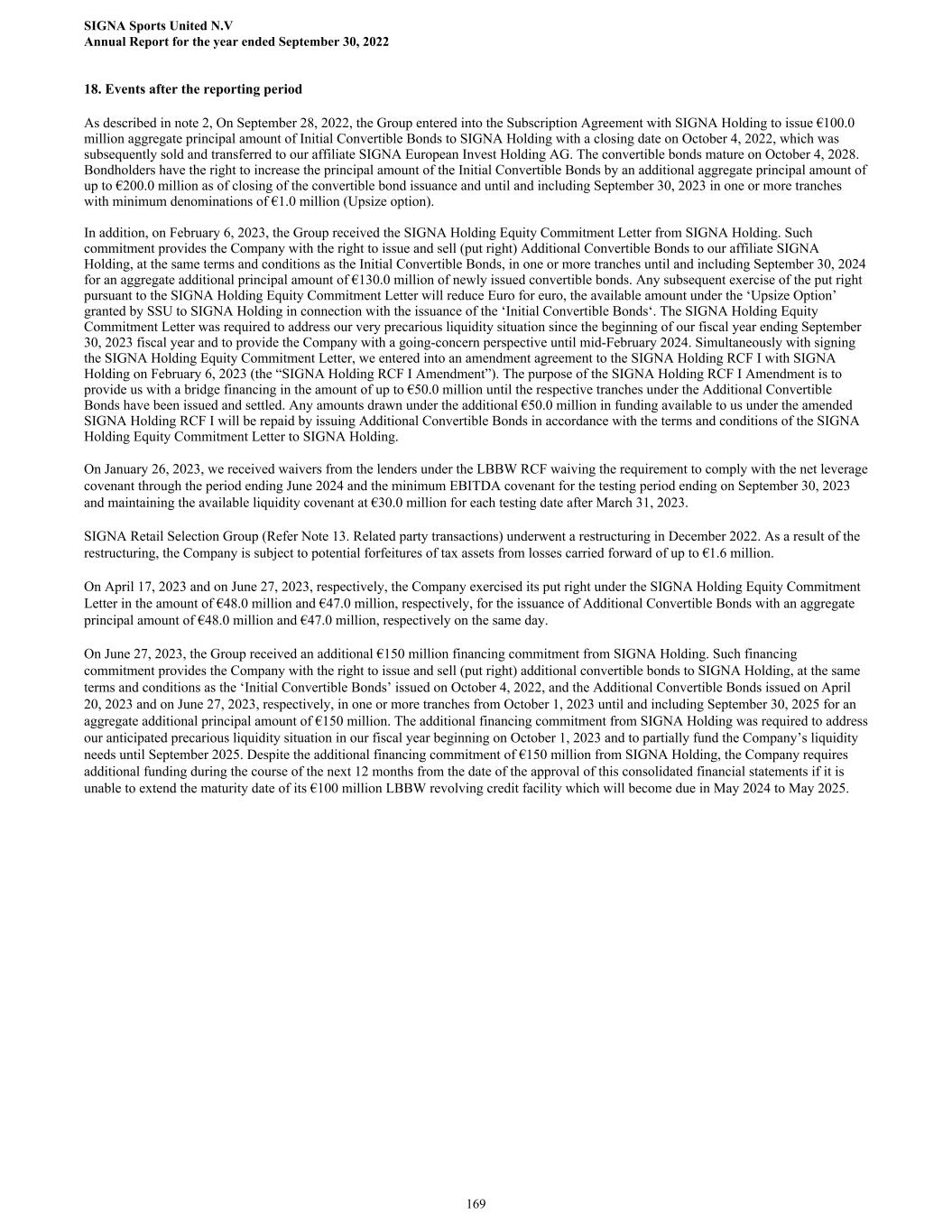
18. Events after the reporting period As described in note 2, On September 28, 2022, the Group entered into the Subscription Agreement with SIGNA Holding to issue €100.0 million aggregate principal amount of Initial Convertible Bonds to SIGNA Holding with a closing date on October 4, 2022, which was subsequently sold and transferred to our affiliate SIGNA European Invest Holding AG. The convertible bonds mature on October 4, 2028. Bondholders have the right to increase the principal amount of the Initial Convertible Bonds by an additional aggregate principal amount of up to €200.0 million as of closing of the convertible bond issuance and until and including September 30, 2023 in one or more tranches with minimum denominations of €1.0 million (Upsize option). In addition, on February 6, 2023, the Group received the SIGNA Holding Equity Commitment Letter from SIGNA Holding. Such commitment provides the Company with the right to issue and sell (put right) Additional Convertible Bonds to our affiliate SIGNA Holding, at the same terms and conditions as the Initial Convertible Bonds, in one or more tranches until and including September 30, 2024 for an aggregate additional principal amount of €130.0 million of newly issued convertible bonds. Any subsequent exercise of the put right pursuant to the SIGNA Holding Equity Commitment Letter will reduce Euro for euro, the available amount under the ‘Upsize Option’ granted by SSU to SIGNA Holding in connection with the issuance of the ‘Initial Convertible Bonds‘. The SIGNA Holding Equity Commitment Letter was required to address our very precarious liquidity situation since the beginning of our fiscal year ending September 30, 2023 fiscal year and to provide the Company with a going-concern perspective until mid-February 2024. Simultaneously with signing the SIGNA Holding Equity Commitment Letter, we entered into an amendment agreement to the SIGNA Holding RCF I with SIGNA Holding on February 6, 2023 (the “SIGNA Holding RCF I Amendment”). The purpose of the SIGNA Holding RCF I Amendment is to provide us with a bridge financing in the amount of up to €50.0 million until the respective tranches under the Additional Convertible Bonds have been issued and settled. Any amounts drawn under the additional €50.0 million in funding available to us under the amended SIGNA Holding RCF I will be repaid by issuing Additional Convertible Bonds in accordance with the terms and conditions of the SIGNA Holding Equity Commitment Letter to SIGNA Holding. On January 26, 2023, we received waivers from the lenders under the LBBW RCF waiving the requirement to comply with the net leverage covenant through the period ending June 2024 and the minimum EBITDA covenant for the testing period ending on September 30, 2023 and maintaining the available liquidity covenant at €30.0 million for each testing date after March 31, 2023. SIGNA Retail Selection Group (Refer Note 13. Related party transactions) underwent a restructuring in December 2022. As a result of the restructuring, the Company is subject to potential forfeitures of tax assets from losses carried forward of up to €1.6 million. On April 17, 2023 and on June 27, 2023, respectively, the Company exercised its put right under the SIGNA Holding Equity Commitment Letter in the amount of €48.0 million and €47.0 million, respectively, for the issuance of Additional Convertible Bonds with an aggregate principal amount of €48.0 million and €47.0 million, respectively on the same day. On June 27, 2023, the Group received an additional €150 million financing commitment from SIGNA Holding. Such financing commitment provides the Company with the right to issue and sell (put right) additional convertible bonds to SIGNA Holding, at the same terms and conditions as the ‘Initial Convertible Bonds’ issued on October 4, 2022, and the Additional Convertible Bonds issued on April 20, 2023 and on June 27, 2023, respectively, in one or more tranches from October 1, 2023 until and including September 30, 2025 for an aggregate additional principal amount of €150 million. The additional financing commitment from SIGNA Holding was required to address our anticipated precarious liquidity situation in our fiscal year beginning on October 1, 2023 and to partially fund the Company’s liquidity needs until September 2025. Despite the additional financing commitment of €150 million from SIGNA Holding, the Company requires additional funding during the course of the next 12 months from the date of the approval of this consolidated financial statements if it is unable to extend the maturity date of its €100 million LBBW revolving credit facility which will become due in May 2024 to May 2025. SIGNA Sports United N.V Annual Report for the year ended September 30, 2022 169

COMPANY FINANCIAL STATEMENTS SIGNA Sports United N.V Annual Report for the year ended September 30, 2022 170
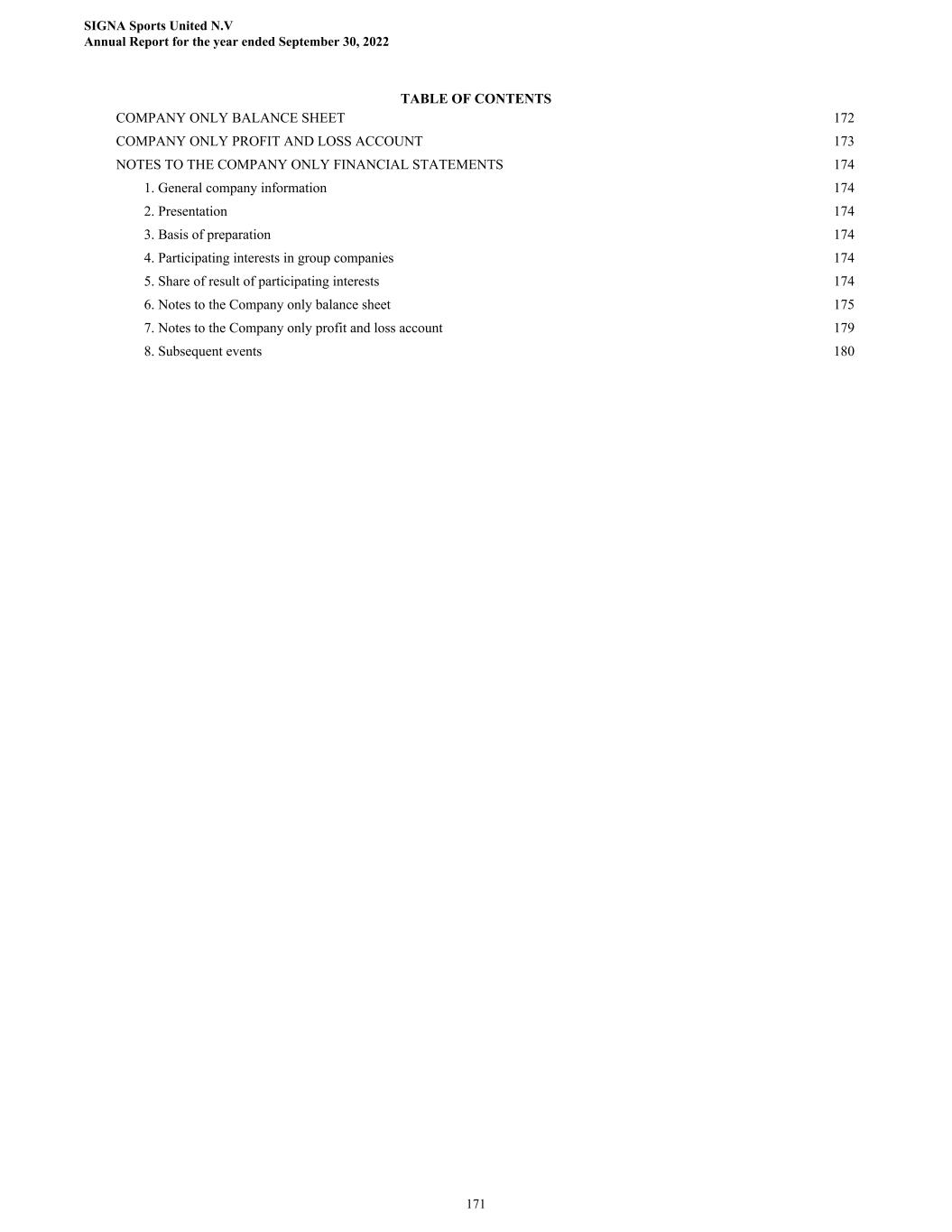
TABLE OF CONTENTS COMPANY ONLY BALANCE SHEET 172 COMPANY ONLY PROFIT AND LOSS ACCOUNT 173 NOTES TO THE COMPANY ONLY FINANCIAL STATEMENTS 174 1. General company information 174 2. Presentation 174 3. Basis of preparation 174 4. Participating interests in group companies 174 5. Share of result of participating interests 174 6. Notes to the Company only balance sheet 175 7. Notes to the Company only profit and loss account 179 8. Subsequent events 180 SIGNA Sports United N.V Annual Report for the year ended September 30, 2022 171
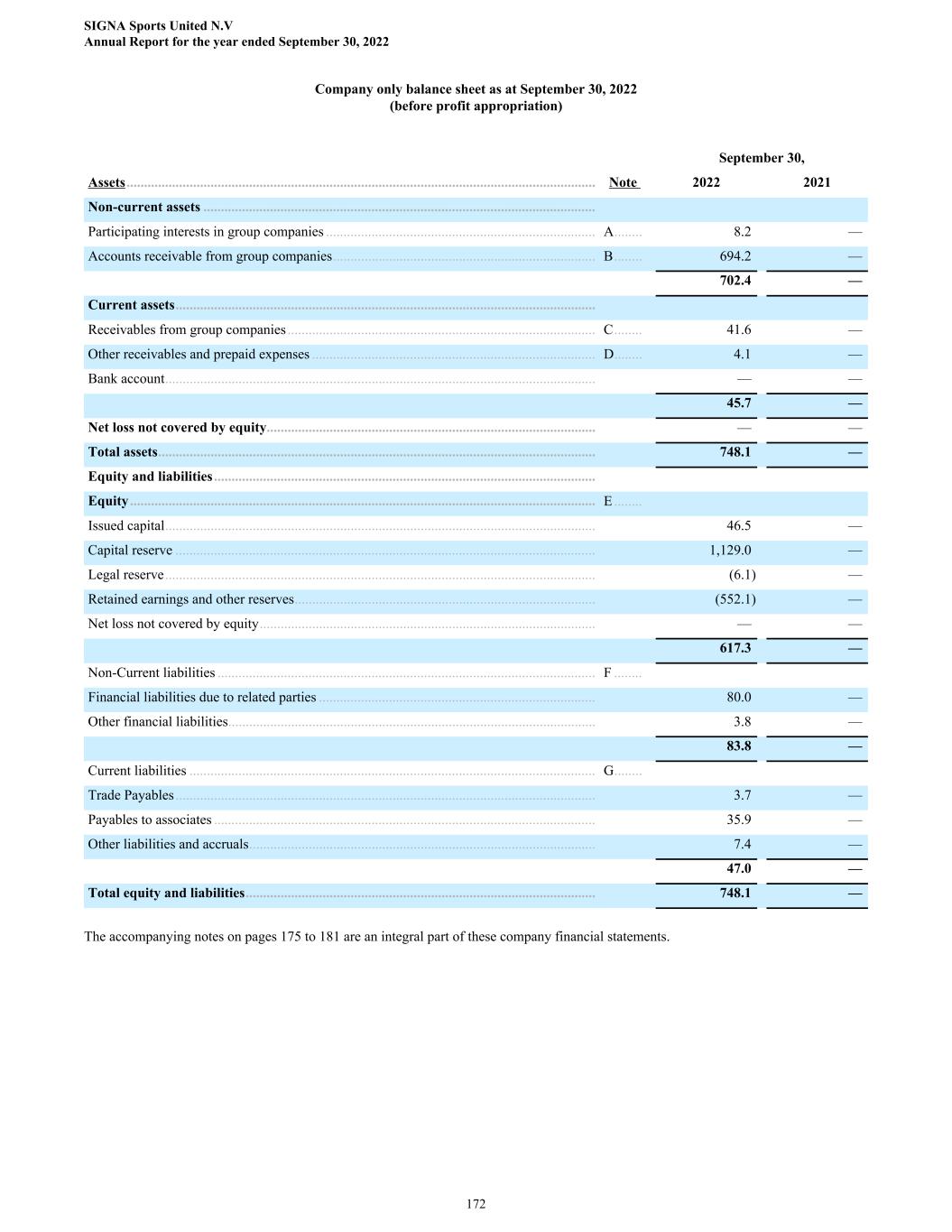
Company only balance sheet as at September 30, 2022 (before profit appropriation) September 30, Assets ...................................................................................................................................... Note 2022 2021 Non-current assets ................................................................................................................ Participating interests in group companies ............................................................................. A ........ 8.2 — Accounts receivable from group companies ........................................................................... B ........ 694.2 — 702.4 — Current assets ........................................................................................................................ Receivables from group companies ........................................................................................ C ........ 41.6 — Other receivables and prepaid expenses ................................................................................. D ........ 4.1 — Bank account ........................................................................................................................... — — 45.7 — Net loss not covered by equity .............................................................................................. — — Total assets ............................................................................................................................. 748.1 — Equity and liabilities ............................................................................................................. Equity ..................................................................................................................................... E ........ Issued capital ........................................................................................................................... 46.5 — Capital reserve ........................................................................................................................ 1,129.0 — Legal reserve ........................................................................................................................... (6.1) — Retained earnings and other reserves ...................................................................................... (552.1) — Net loss not covered by equity ................................................................................................ — — 617.3 — Non-Current liabilities ............................................................................................................ F ........ Financial liabilities due to related parties ............................................................................... 80.0 — Other financial liabilities ......................................................................................................... 3.8 — 83.8 — Current liabilities .................................................................................................................... G ........ Trade Payables ........................................................................................................................ 3.7 — Payables to associates ............................................................................................................. 35.9 — Other liabilities and accruals ................................................................................................... 7.4 — 47.0 — Total equity and liabilities .................................................................................................... 748.1 — The accompanying notes on pages 175 to 181 are an integral part of these company financial statements. SIGNA Sports United N.V Annual Report for the year ended September 30, 2022 172
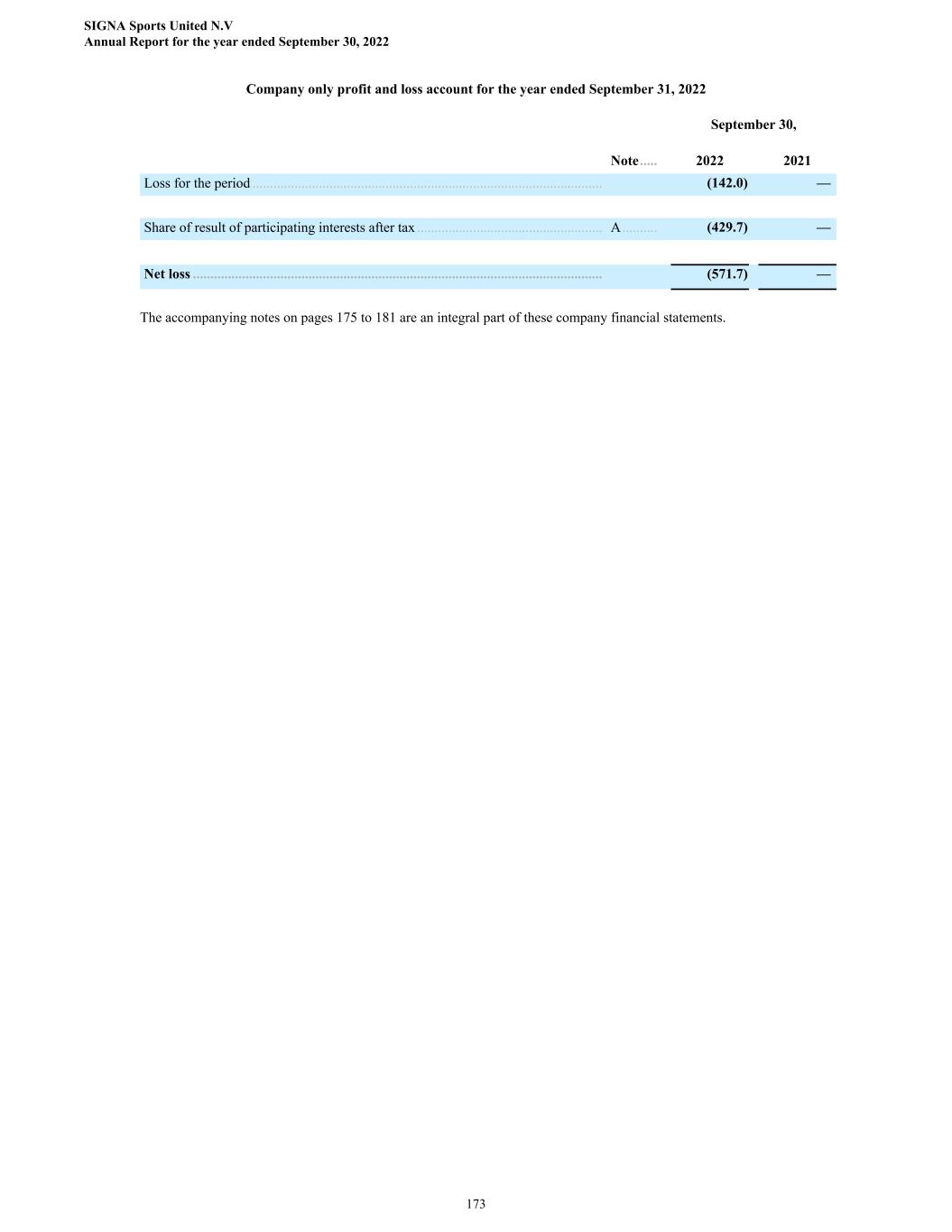
Company only profit and loss account for the year ended September 31, 2022 September 30, Note ..... 2022 2021 Loss for the period .................................................................................................... (142.0) — Share of result of participating interests after tax ..................................................... A .......... (429.7) — Net loss ..................................................................................................................... (571.7) — The accompanying notes on pages 175 to 181 are an integral part of these company financial statements. SIGNA Sports United N.V Annual Report for the year ended September 30, 2022 173
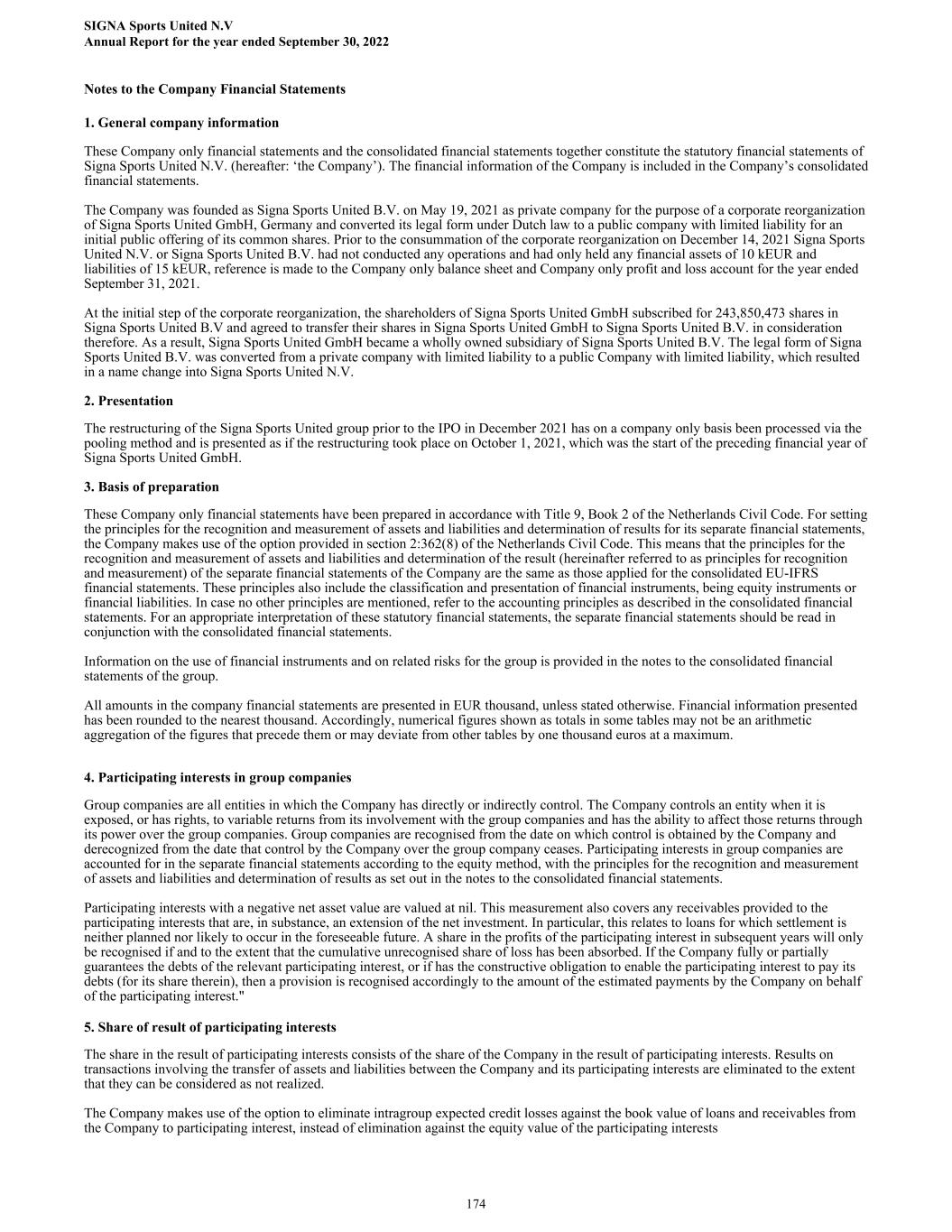
Notes to the Company Financial Statements 1. General company information These Company only financial statements and the consolidated financial statements together constitute the statutory financial statements of Signa Sports United N.V. (hereafter: ‘the Company’). The financial information of the Company is included in the Company’s consolidated financial statements. The Company was founded as Signa Sports United B.V. on May 19, 2021 as private company for the purpose of a corporate reorganization of Signa Sports United GmbH, Germany and converted its legal form under Dutch law to a public company with limited liability for an initial public offering of its common shares. Prior to the consummation of the corporate reorganization on December 14, 2021 Signa Sports United N.V. or Signa Sports United B.V. had not conducted any operations and had only held any financial assets of 10 kEUR and liabilities of 15 kEUR, reference is made to the Company only balance sheet and Company only profit and loss account for the year ended September 31, 2021. At the initial step of the corporate reorganization, the shareholders of Signa Sports United GmbH subscribed for 243,850,473 shares in Signa Sports United B.V and agreed to transfer their shares in Signa Sports United GmbH to Signa Sports United B.V. in consideration therefore. As a result, Signa Sports United GmbH became a wholly owned subsidiary of Signa Sports United B.V. The legal form of Signa Sports United B.V. was converted from a private company with limited liability to a public Company with limited liability, which resulted in a name change into Signa Sports United N.V. 2. Presentation The restructuring of the Signa Sports United group prior to the IPO in December 2021 has on a company only basis been processed via the pooling method and is presented as if the restructuring took place on October 1, 2021, which was the start of the preceding financial year of Signa Sports United GmbH. 3. Basis of preparation These Company only financial statements have been prepared in accordance with Title 9, Book 2 of the Netherlands Civil Code. For setting the principles for the recognition and measurement of assets and liabilities and determination of results for its separate financial statements, the Company makes use of the option provided in section 2:362(8) of the Netherlands Civil Code. This means that the principles for the recognition and measurement of assets and liabilities and determination of the result (hereinafter referred to as principles for recognition and measurement) of the separate financial statements of the Company are the same as those applied for the consolidated EU-IFRS financial statements. These principles also include the classification and presentation of financial instruments, being equity instruments or financial liabilities. In case no other principles are mentioned, refer to the accounting principles as described in the consolidated financial statements. For an appropriate interpretation of these statutory financial statements, the separate financial statements should be read in conjunction with the consolidated financial statements. Information on the use of financial instruments and on related risks for the group is provided in the notes to the consolidated financial statements of the group. All amounts in the company financial statements are presented in EUR thousand, unless stated otherwise. Financial information presented has been rounded to the nearest thousand. Accordingly, numerical figures shown as totals in some tables may not be an arithmetic aggregation of the figures that precede them or may deviate from other tables by one thousand euros at a maximum. 4. Participating interests in group companies Group companies are all entities in which the Company has directly or indirectly control. The Company controls an entity when it is exposed, or has rights, to variable returns from its involvement with the group companies and has the ability to affect those returns through its power over the group companies. Group companies are recognised from the date on which control is obtained by the Company and derecognized from the date that control by the Company over the group company ceases. Participating interests in group companies are accounted for in the separate financial statements according to the equity method, with the principles for the recognition and measurement of assets and liabilities and determination of results as set out in the notes to the consolidated financial statements. Participating interests with a negative net asset value are valued at nil. This measurement also covers any receivables provided to the participating interests that are, in substance, an extension of the net investment. In particular, this relates to loans for which settlement is neither planned nor likely to occur in the foreseeable future. A share in the profits of the participating interest in subsequent years will only be recognised if and to the extent that the cumulative unrecognised share of loss has been absorbed. If the Company fully or partially guarantees the debts of the relevant participating interest, or if has the constructive obligation to enable the participating interest to pay its debts (for its share therein), then a provision is recognised accordingly to the amount of the estimated payments by the Company on behalf of the participating interest." 5. Share of result of participating interests The share in the result of participating interests consists of the share of the Company in the result of participating interests. Results on transactions involving the transfer of assets and liabilities between the Company and its participating interests are eliminated to the extent that they can be considered as not realized. The Company makes use of the option to eliminate intragroup expected credit losses against the book value of loans and receivables from the Company to participating interest, instead of elimination against the equity value of the participating interests SIGNA Sports United N.V Annual Report for the year ended September 30, 2022 174
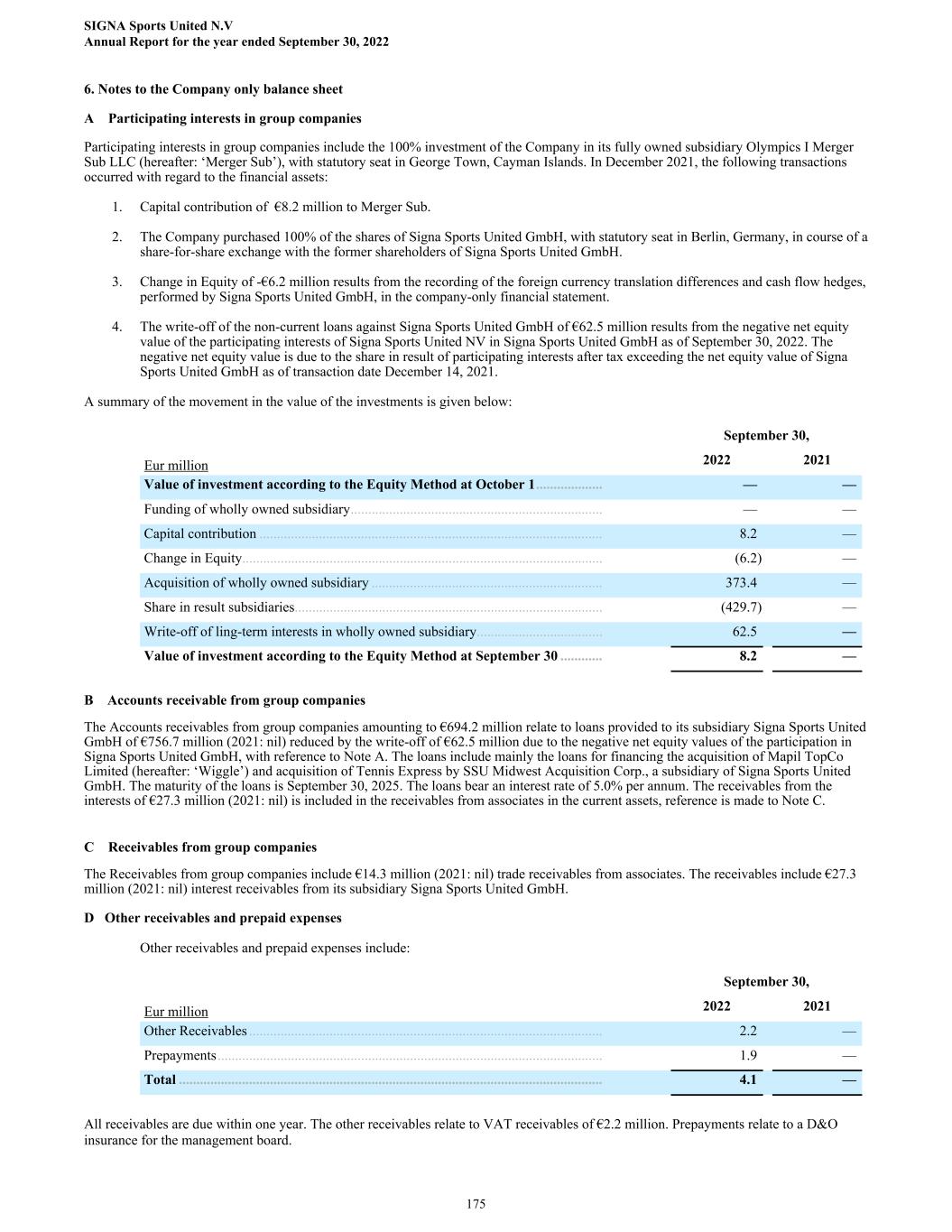
6. Notes to the Company only balance sheet A Participating interests in group companies Participating interests in group companies include the 100% investment of the Company in its fully owned subsidiary Olympics I Merger Sub LLC (hereafter: ‘Merger Sub’), with statutory seat in George Town, Cayman Islands. In December 2021, the following transactions occurred with regard to the financial assets: 1. Capital contribution of €8.2 million to Merger Sub. 2. The Company purchased 100% of the shares of Signa Sports United GmbH, with statutory seat in Berlin, Germany, in course of a share-for-share exchange with the former shareholders of Signa Sports United GmbH. 3. Change in Equity of -€6.2 million results from the recording of the foreign currency translation differences and cash flow hedges, performed by Signa Sports United GmbH, in the company-only financial statement. 4. The write-off of the non-current loans against Signa Sports United GmbH of €62.5 million results from the negative net equity value of the participating interests of Signa Sports United NV in Signa Sports United GmbH as of September 30, 2022. The negative net equity value is due to the share in result of participating interests after tax exceeding the net equity value of Signa Sports United GmbH as of transaction date December 14, 2021. A summary of the movement in the value of the investments is given below: September 30, Eur million 2022 2021 Value of investment according to the Equity Method at October 1 ................... — — Funding of wholly owned subsidiary ........................................................................ — — Capital contribution .................................................................................................. 8.2 — Change in Equity ....................................................................................................... (6.2) — Acquisition of wholly owned subsidiary .................................................................. 373.4 — Share in result subsidiaries ........................................................................................ (429.7) — Write-off of ling-term interests in wholly owned subsidiary .................................... 62.5 — Value of investment according to the Equity Method at September 30 ............ 8.2 — B Accounts receivable from group companies The Accounts receivables from group companies amounting to €694.2 million relate to loans provided to its subsidiary Signa Sports United GmbH of €756.7 million (2021: nil) reduced by the write-off of €62.5 million due to the negative net equity values of the participation in Signa Sports United GmbH, with reference to Note A. The loans include mainly the loans for financing the acquisition of Mapil TopCo Limited (hereafter: ‘Wiggle’) and acquisition of Tennis Express by SSU Midwest Acquisition Corp., a subsidiary of Signa Sports United GmbH. The maturity of the loans is September 30, 2025. The loans bear an interest rate of 5.0% per annum. The receivables from the interests of €27.3 million (2021: nil) is included in the receivables from associates in the current assets, reference is made to Note C. C Receivables from group companies The Receivables from group companies include €14.3 million (2021: nil) trade receivables from associates. The receivables include €27.3 million (2021: nil) interest receivables from its subsidiary Signa Sports United GmbH. D Other receivables and prepaid expenses Other receivables and prepaid expenses include: September 30, Eur million 2022 2021 Other Receivables ..................................................................................................... 2.2 — Prepayments .............................................................................................................. 1.9 — Total ......................................................................................................................... 4.1 — All receivables are due within one year. The other receivables relate to VAT receivables of €2.2 million. Prepayments relate to a D&O insurance for the management board. SIGNA Sports United N.V Annual Report for the year ended September 30, 2022 175
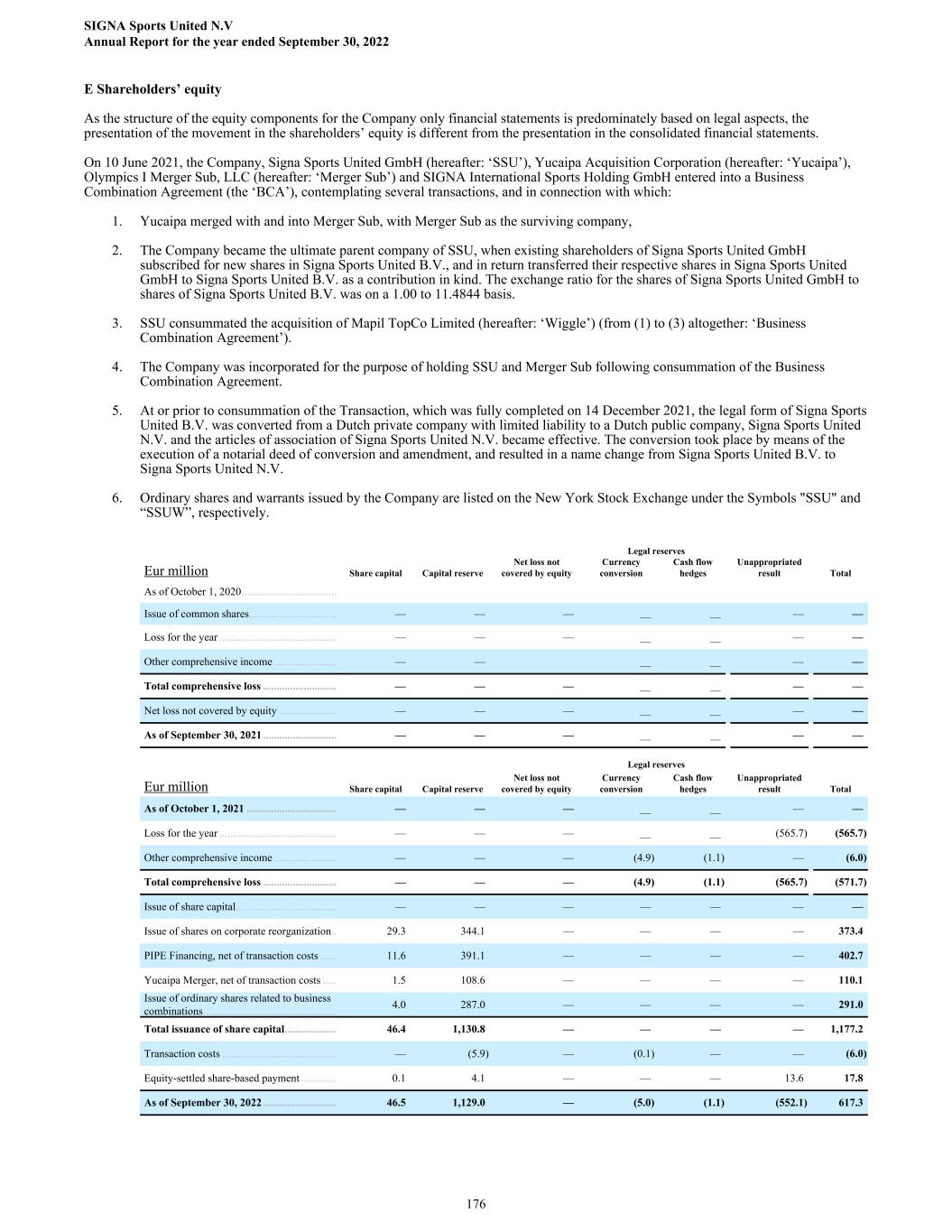
E Shareholders’ equity As the structure of the equity components for the Company only financial statements is predominately based on legal aspects, the presentation of the movement in the shareholders’ equity is different from the presentation in the consolidated financial statements. On 10 June 2021, the Company, Signa Sports United GmbH (hereafter: ‘SSU’), Yucaipa Acquisition Corporation (hereafter: ‘Yucaipa’), Olympics I Merger Sub, LLC (hereafter: ‘Merger Sub’) and SIGNA International Sports Holding GmbH entered into a Business Combination Agreement (the ‘BCA’), contemplating several transactions, and in connection with which: 1. Yucaipa merged with and into Merger Sub, with Merger Sub as the surviving company, 2. The Company became the ultimate parent company of SSU, when existing shareholders of Signa Sports United GmbH subscribed for new shares in Signa Sports United B.V., and in return transferred their respective shares in Signa Sports United GmbH to Signa Sports United B.V. as a contribution in kind. The exchange ratio for the shares of Signa Sports United GmbH to shares of Signa Sports United B.V. was on a 1.00 to 11.4844 basis. 3. SSU consummated the acquisition of Mapil TopCo Limited (hereafter: ‘Wiggle’) (from (1) to (3) altogether: ‘Business Combination Agreement’). 4. The Company was incorporated for the purpose of holding SSU and Merger Sub following consummation of the Business Combination Agreement. 5. At or prior to consummation of the Transaction, which was fully completed on 14 December 2021, the legal form of Signa Sports United B.V. was converted from a Dutch private company with limited liability to a Dutch public company, Signa Sports United N.V. and the articles of association of Signa Sports United N.V. became effective. The conversion took place by means of the execution of a notarial deed of conversion and amendment, and resulted in a name change from Signa Sports United B.V. to Signa Sports United N.V. 6. Ordinary shares and warrants issued by the Company are listed on the New York Stock Exchange under the Symbols "SSU" and “SSUW”, respectively. Legal reserves Eur million Share capital Capital reserve Net loss not covered by equity Currency conversion Cash flow hedges Unappropriated result Total As of October 1, 2020 ................................... Issue of common shares ................................ — — — — — — — Loss for the year ........................................... — — — — — — — Other comprehensive income ....................... — — — — — — Total comprehensive loss ........................... — — — — — — — Net loss not covered by equity ..................... — — — — — — — As of September 30, 2021 ........................... — — — — — — — Legal reserves Eur million Share capital Capital reserve Net loss not covered by equity Currency conversion Cash flow hedges Unappropriated result Total As of October 1, 2021 ................................. — — — — — — — Loss for the year ........................................... — — — — — (565.7) (565.7) Other comprehensive income ....................... — — — (4.9) (1.1) — (6.0) Total comprehensive loss ........................... — — — (4.9) (1.1) (565.7) (571.7) Issue of share capital ..................................... — — — — — — — Issue of shares on corporate reorganization .. 29.3 344.1 — — — — 373.4 PIPE Financing, net of transaction costs ...... 11.6 391.1 — — — — 402.7 Yucaipa Merger, net of transaction costs ..... 1.5 108.6 — — — — 110.1 Issue of ordinary shares related to business combinations ................................................. 4.0 287.0 — — — — 291.0 Total issuance of share capital ................... 46.4 1,130.8 — — — — 1,177.2 Transaction costs .......................................... — (5.9) — (0.1) — — (6.0) Equity-settled share-based payment ............. 0.1 4.1 — — — 13.6 17.8 As of September 30, 2022 ........................... 46.5 1,129.0 — (5.0) (1.1) (552.1) 617.3 SIGNA Sports United N.V Annual Report for the year ended September 30, 2022 176

Issued capital and capital reserve Common Shares As of September 30, 2021, 1 common share of the Company with a nominal value of EUR 0.12 were issued and fully paid up. On December 14, 2021, the Company issued 384,180,171 of new shares, EUR 0.12 nominal value per share, in connection with the initial public offering (IPO) and Business Combination Agreement: 1. The existing shareholders of Signa Sports United GmbH subscribed for 243,850,473 of new shares in the Company, and in return transferred 21,233,124 of their respective shares in Signa Sports United GmbH to the Company as a contribution in kind. The exchange ratio for the shares of Signa Sports United GmbH to shares of Signa Sports United B.V. was on a 1.00 to 11.4844 basis. 2. In course of the Business Combination Agreement, the former shareholders of Yucaipa, who were the existing shareholders of Merger Sub after the merger of Yucaipa with and into Merger Sub, with Merger Sub as the surviving company, subscribed for 12,584,315 of new shares in the Company, and in return transferred 11,334,315 of their respective shares in Merger Sub to the Company as a contribution in kind. The exchange ratio for the shares of Merger Sub to shares of the Company was on a 1.00 to 1.1103 basis. 3. In course of the acquisition of Wiggle by SSU, the Company transferred 31,045,383 of newly issued shares to the existing shareholders of Wiggle as part of the purchase price paid by SSU. 4. The Company offered and sold a total of 96,700,000 of new shares, EUR 0.12 nominal value per share, at a public offering price of USD 10.00 (EUR 8.81) per share, raising aggregate net offering proceeds of €397.2 million, after deduction of underwriting discounts and commissions as well as transaction costs. On March 11, 2022, in course of the acquisition of Tennis Express by SSU Midwest Acquisition Corp., the Company transferred 2,492,833 of new shares, EUR 0.12 nominal value per share, to the existing shareholders of Tennis Express as part of the purchase price paid by SSU Midwest Acquisition Corp. In the financial year 2021/2022, in course of the exercise of the stock options by the management of the Company and the subsidiaries of Signa Sports United GmbH the Company issued 876,013 of new shares, EUR 0.12 nominal value per share. As of September 30 2022, in total 387,549,017 common shares of Signa Sports United N.V. with a nominal value of EUR 0.12 were issued and fully paid up (September 30, 2021 1 common share). Reference is made to note 7.11 and 8. of the consolidated financial statements. Capital reserve As of September 30, 2022, capital reserve included a share premium of €2,912.8 million (2021: nil), being amounts contributed by shareholders at the issuance of shares in excess of the par value of the shares issued. During the year ended September 30, 2022, transaction costs related to IPO, that are directly attributable to issuing the new shares of €5.9 million were recorded against capital reserve. The capital reserve consists of the share premium account and amounts recorded in respect of share-based payments. For further details and other information with regard to share-based payments, reference is made to note 7.12 of the consolidated financial statements. Legal reserves As of September 30, 2022, legal reserves included the currency conversion reserves of €5.0 million and the cash flow hedges of €1.1 million (2021: nil). Unappropriated result Proposal for result appropriation The General Meeting will be proposed to carry forward the loss after tax for 2021/2022 and deduct €565.7 million from the other reserves.The result after tax for 2021/2022 is included in the item unappropriated result within equity. F Non-current liabilities September 30, Eur million 2022 2021 Financial liabilities due to related parties ................................................................. 80.0 — Other financial liabilities ........................................................................................... 3.8 — Total .......................................................................................................................... 83.8 — SIGNA Sports United N.V Annual Report for the year ended September 30, 2022 177
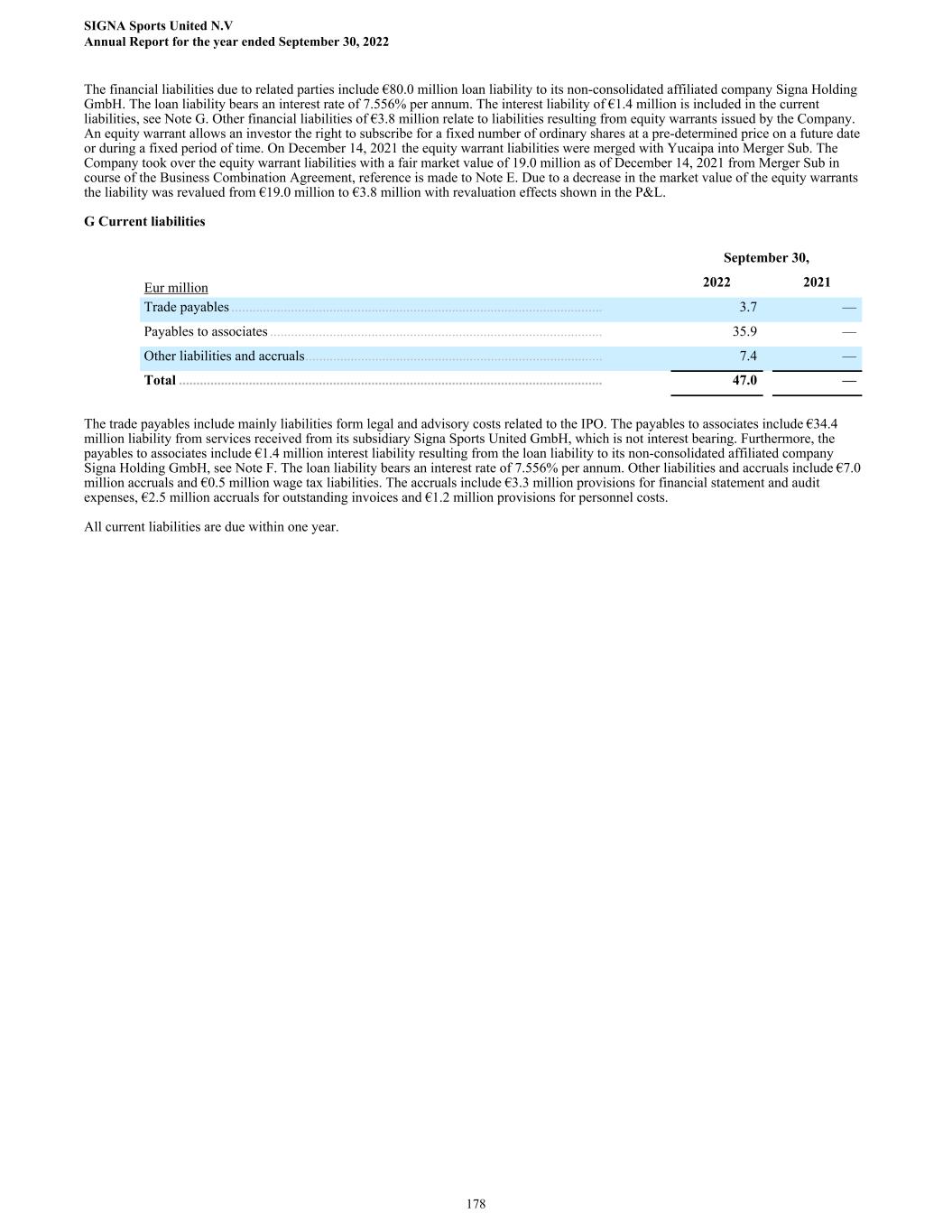
The financial liabilities due to related parties include €80.0 million loan liability to its non-consolidated affiliated company Signa Holding GmbH. The loan liability bears an interest rate of 7.556% per annum. The interest liability of €1.4 million is included in the current liabilities, see Note G. Other financial liabilities of €3.8 million relate to liabilities resulting from equity warrants issued by the Company. An equity warrant allows an investor the right to subscribe for a fixed number of ordinary shares at a pre-determined price on a future date or during a fixed period of time. On December 14, 2021 the equity warrant liabilities were merged with Yucaipa into Merger Sub. The Company took over the equity warrant liabilities with a fair market value of 19.0 million as of December 14, 2021 from Merger Sub in course of the Business Combination Agreement, reference is made to Note E. Due to a decrease in the market value of the equity warrants the liability was revalued from €19.0 million to €3.8 million with revaluation effects shown in the P&L. G Current liabilities September 30, Eur million 2022 2021 Trade payables .......................................................................................................... 3.7 — Payables to associates ............................................................................................... 35.9 — Other liabilities and accruals ..................................................................................... 7.4 — Total ......................................................................................................................... 47.0 — The trade payables include mainly liabilities form legal and advisory costs related to the IPO. The payables to associates include €34.4 million liability from services received from its subsidiary Signa Sports United GmbH, which is not interest bearing. Furthermore, the payables to associates include €1.4 million interest liability resulting from the loan liability to its non-consolidated affiliated company Signa Holding GmbH, see Note F. The loan liability bears an interest rate of 7.556% per annum. Other liabilities and accruals include €7.0 million accruals and €0.5 million wage tax liabilities. The accruals include €3.3 million provisions for financial statement and audit expenses, €2.5 million accruals for outstanding invoices and €1.2 million provisions for personnel costs. All current liabilities are due within one year. SIGNA Sports United N.V Annual Report for the year ended September 30, 2022 178
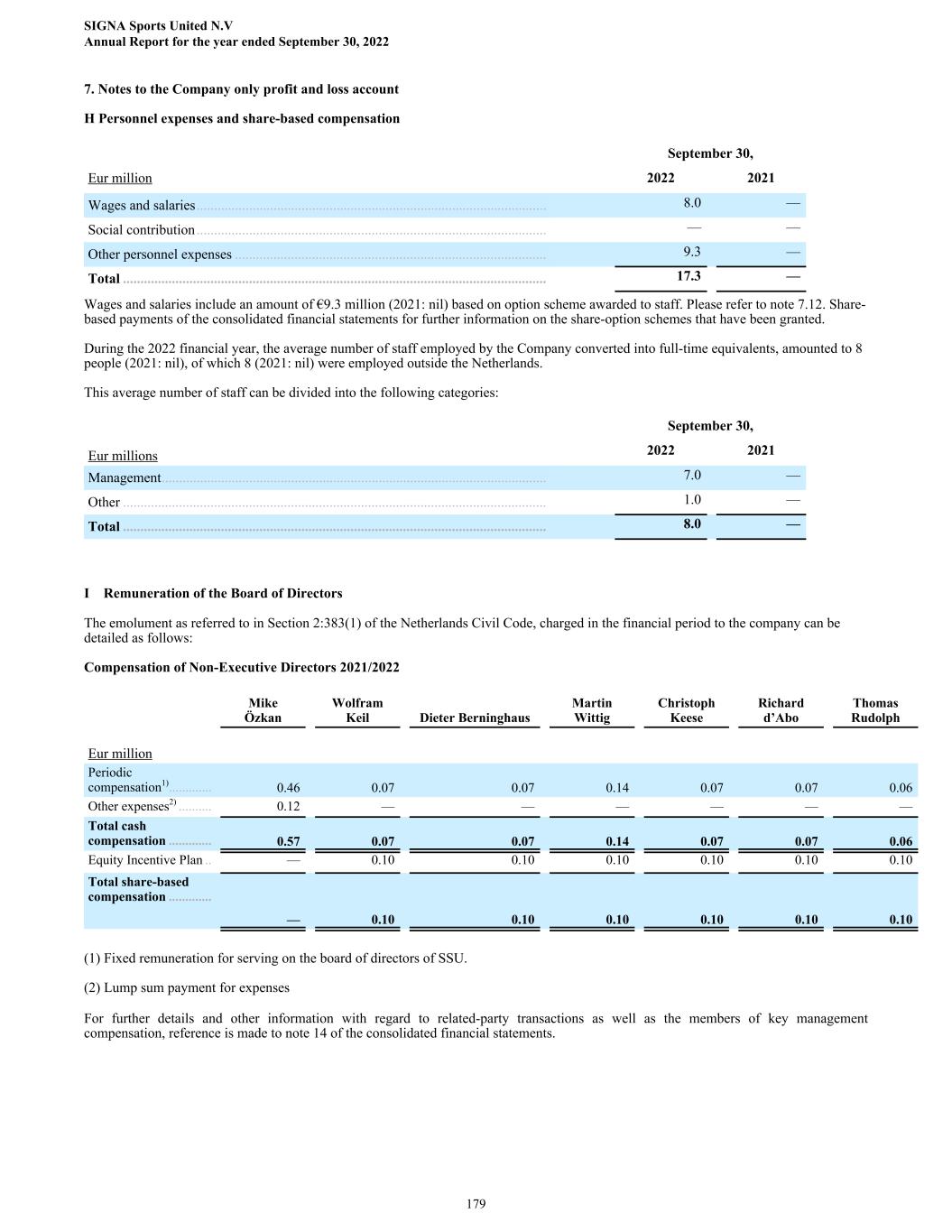
7. Notes to the Company only profit and loss account H Personnel expenses and share-based compensation September 30, Eur million 2022 2021 Wages and salaries .................................................................................................... 8.0 — Social contribution .................................................................................................... — — Other personnel expenses ......................................................................................... 9.3 — Total ......................................................................................................................... 17.3 — Wages and salaries include an amount of €9.3 million (2021: nil) based on option scheme awarded to staff. Please refer to note 7.12. Share- based payments of the consolidated financial statements for further information on the share-option schemes that have been granted. During the 2022 financial year, the average number of staff employed by the Company converted into full-time equivalents, amounted to 8 people (2021: nil), of which 8 (2021: nil) were employed outside the Netherlands. This average number of staff can be divided into the following categories: September 30, Eur millions 2022 2021 Management .............................................................................................................. 7.0 — Other ......................................................................................................................... 1.0 — Total ......................................................................................................................... 8.0 — I Remuneration of the Board of Directors The emolument as referred to in Section 2:383(1) of the Netherlands Civil Code, charged in the financial period to the company can be detailed as follows: Compensation of Non-Executive Directors 2021/2022 Mike Özkan Wolfram Keil Dieter Berninghaus Martin Wittig Christoph Keese Richard d’Abo Thomas Rudolph Eur million Periodic compensation1) ............. 0.46 0.07 0.07 0.14 0.07 0.07 0.06 Other expenses2) .......... 0.12 — — — — — — Total cash compensation ............. 0.57 0.07 0.07 0.14 0.07 0.07 0.06 Equity Incentive Plan .. — 0.10 0.10 0.10 0.10 0.10 0.10 Total share-based compensation ............. — 0.10 0.10 0.10 0.10 0.10 0.10 (1) Fixed remuneration for serving on the board of directors of SSU. (2) Lump sum payment for expenses For further details and other information with regard to related-party transactions as well as the members of key management compensation, reference is made to note 14 of the consolidated financial statements. SIGNA Sports United N.V Annual Report for the year ended September 30, 2022 179
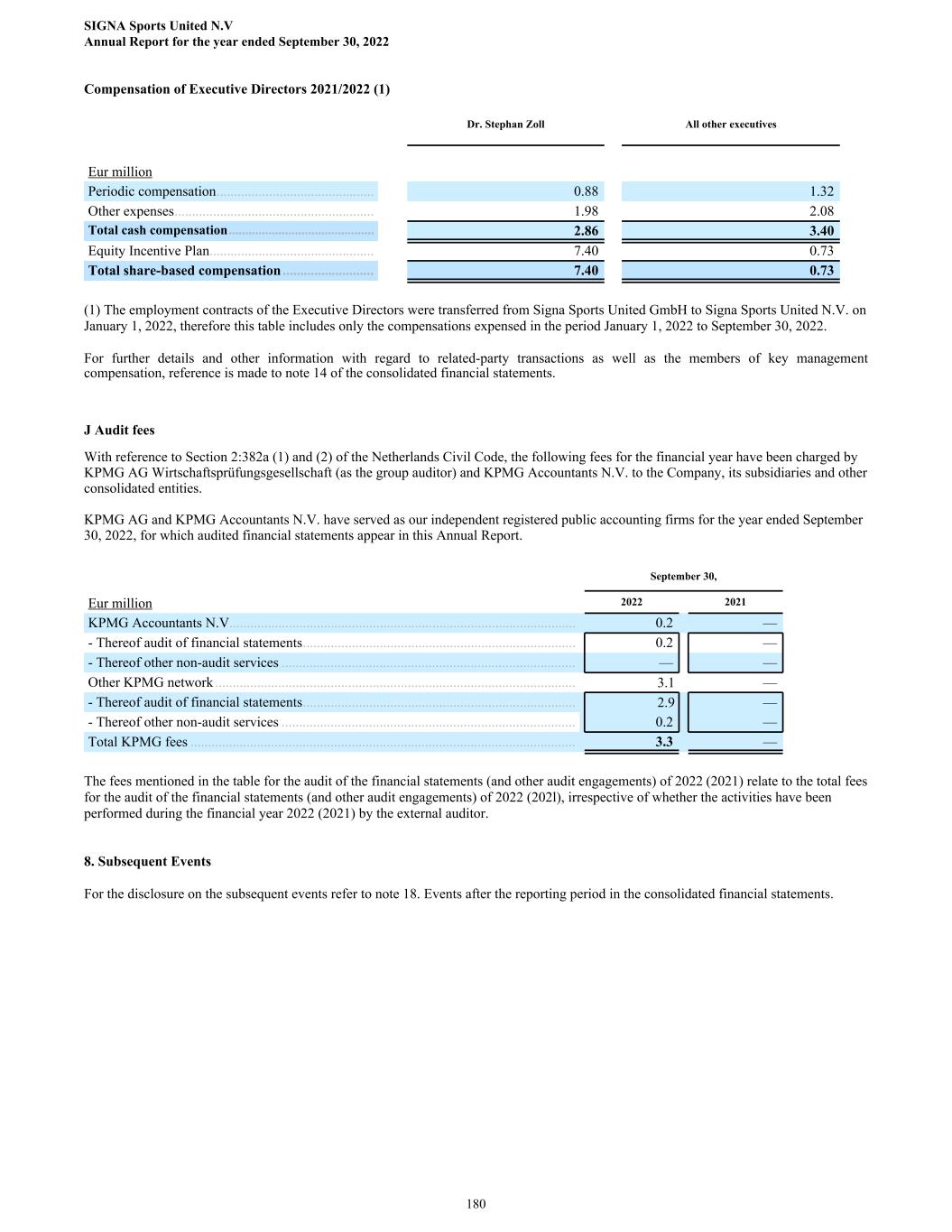
Compensation of Executive Directors 2021/2022 (1) Dr. Stephan Zoll All other executives Eur million Periodic compensation ............................................. 0.88 1.32 Other expenses ......................................................... 1.98 2.08 Total cash compensation ............................................ 2.86 3.40 Equity Incentive Plan ............................................... 7.40 0.73 Total share-based compensation .......................... 7.40 0.73 (1) The employment contracts of the Executive Directors were transferred from Signa Sports United GmbH to Signa Sports United N.V. on January 1, 2022, therefore this table includes only the compensations expensed in the period January 1, 2022 to September 30, 2022. For further details and other information with regard to related-party transactions as well as the members of key management compensation, reference is made to note 14 of the consolidated financial statements. J Audit fees With reference to Section 2:382a (1) and (2) of the Netherlands Civil Code, the following fees for the financial year have been charged by KPMG AG Wirtschaftsprüfungsgesellschaft (as the group auditor) and KPMG Accountants N.V. to the Company, its subsidiaries and other consolidated entities. KPMG AG and KPMG Accountants N.V. have served as our independent registered public accounting firms for the year ended September 30, 2022, for which audited financial statements appear in this Annual Report. September 30, Eur million 2022 2021 KPMG Accountants N.V ................................................................................................... 0.2 — - Thereof audit of financial statements .............................................................................. 0.2 — - Thereof other non-audit services .................................................................................... — — Other KPMG network ....................................................................................................... 3.1 — - Thereof audit of financial statements .............................................................................. 2.9 — - Thereof other non-audit services .................................................................................... 0.2 — Total KPMG fees .............................................................................................................. 3.3 — The fees mentioned in the table for the audit of the financial statements (and other audit engagements) of 2022 (2021) relate to the total fees for the audit of the financial statements (and other audit engagements) of 2022 (202l), irrespective of whether the activities have been performed during the financial year 2022 (2021) by the external auditor. 8. Subsequent Events For the disclosure on the subsequent events refer to note 18. Events after the reporting period in the consolidated financial statements. SIGNA Sports United N.V Annual Report for the year ended September 30, 2022 180
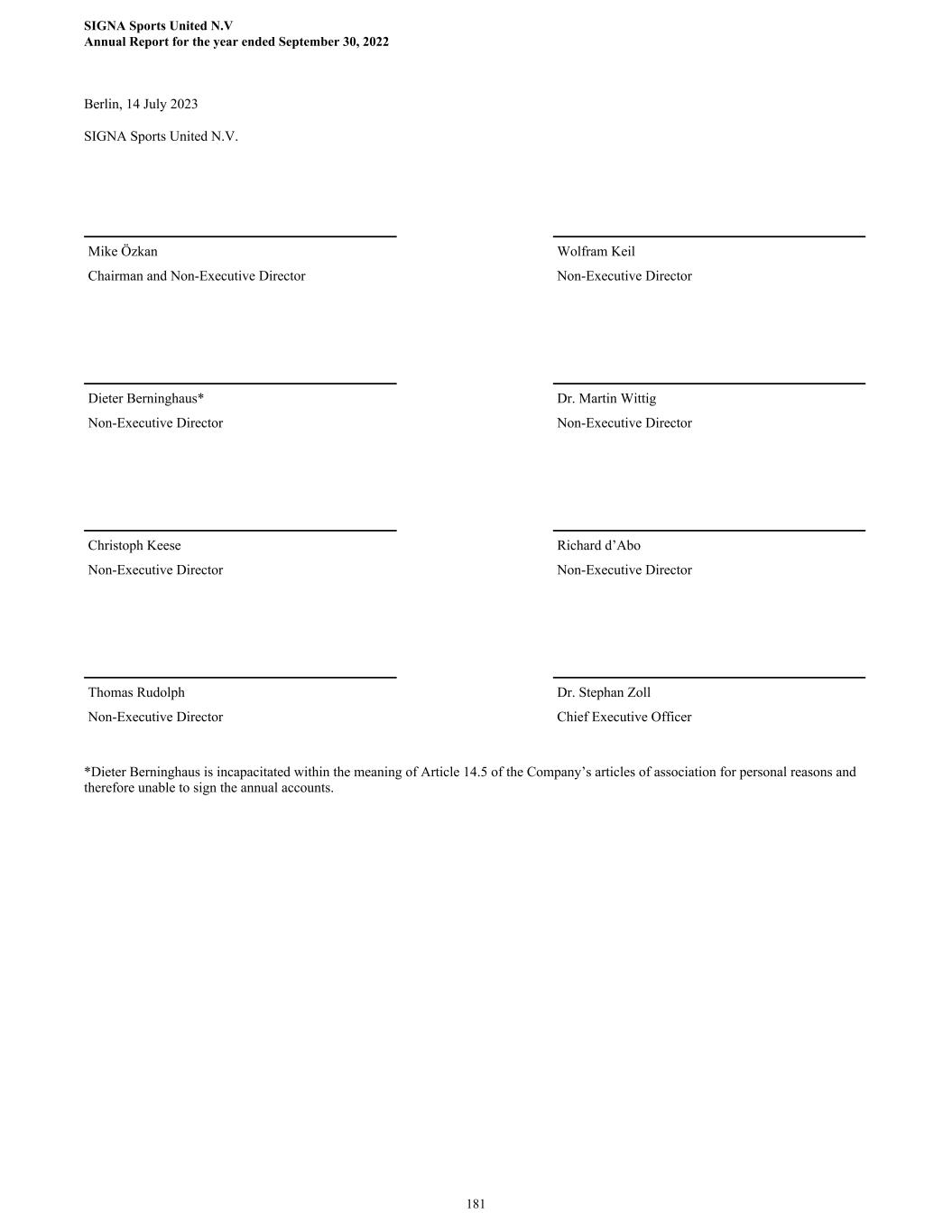
Berlin, 14 July 2023 SIGNA Sports United N.V. Mike Özkan Wolfram Keil Chairman and Non-Executive Director Non-Executive Director Dieter Berninghaus* Dr. Martin Wittig Non-Executive Director Non-Executive Director Christoph Keese Richard d’Abo Non-Executive Director Non-Executive Director Thomas Rudolph Dr. Stephan Zoll Non-Executive Director Chief Executive Officer *Dieter Berninghaus is incapacitated within the meaning of Article 14.5 of the Company’s articles of association for personal reasons and therefore unable to sign the annual accounts. SIGNA Sports United N.V Annual Report for the year ended September 30, 2022 181
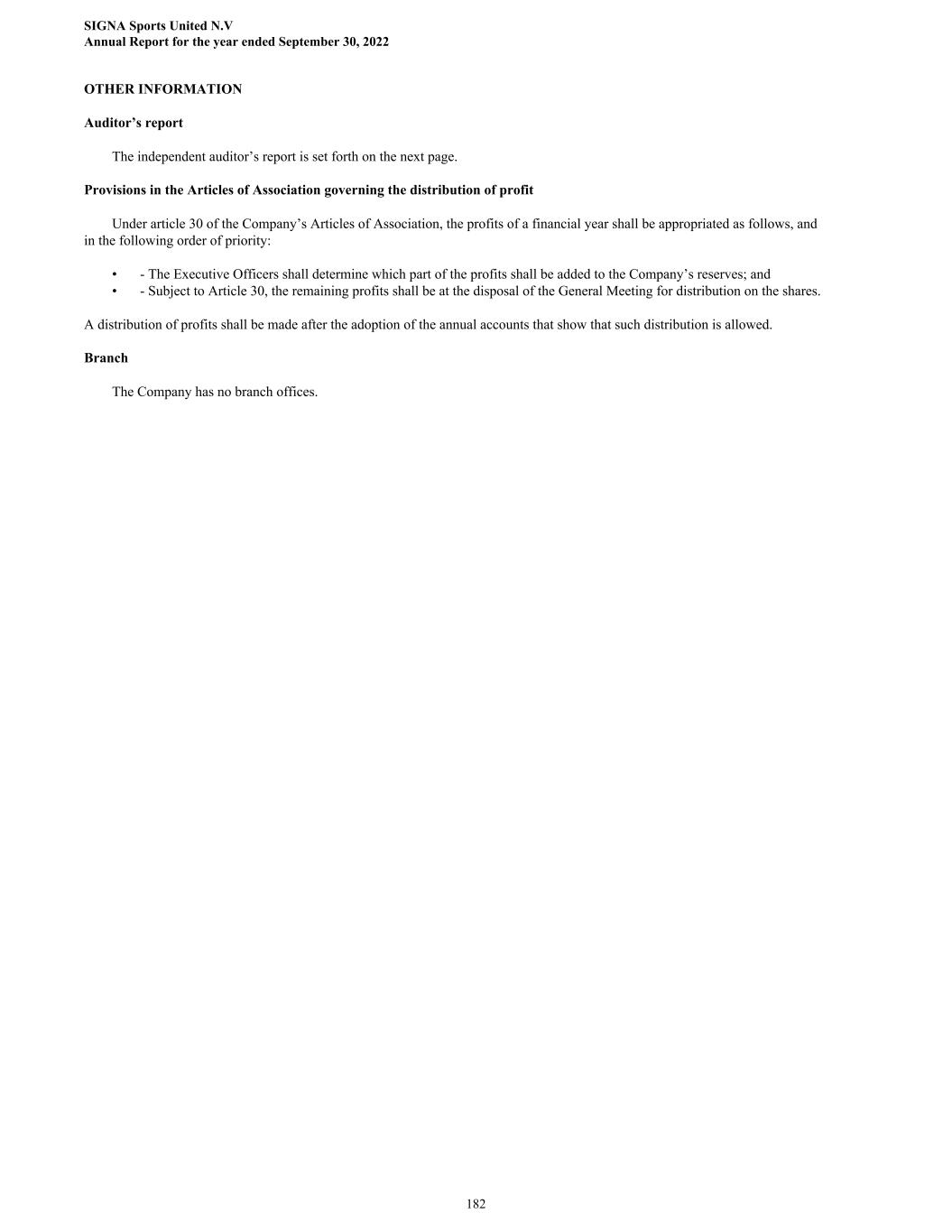
OTHER INFORMATION Auditor’s report The independent auditor’s report is set forth on the next page. Provisions in the Articles of Association governing the distribution of profit Under article 30 of the Company’s Articles of Association, the profits of a financial year shall be appropriated as follows, and in the following order of priority: • - The Executive Officers shall determine which part of the profits shall be added to the Company’s reserves; and • - Subject to Article 30, the remaining profits shall be at the disposal of the General Meeting for distribution on the shares. A distribution of profits shall be made after the adoption of the annual accounts that show that such distribution is allowed. Branch The Company has no branch offices. SIGNA Sports United N.V Annual Report for the year ended September 30, 2022 182
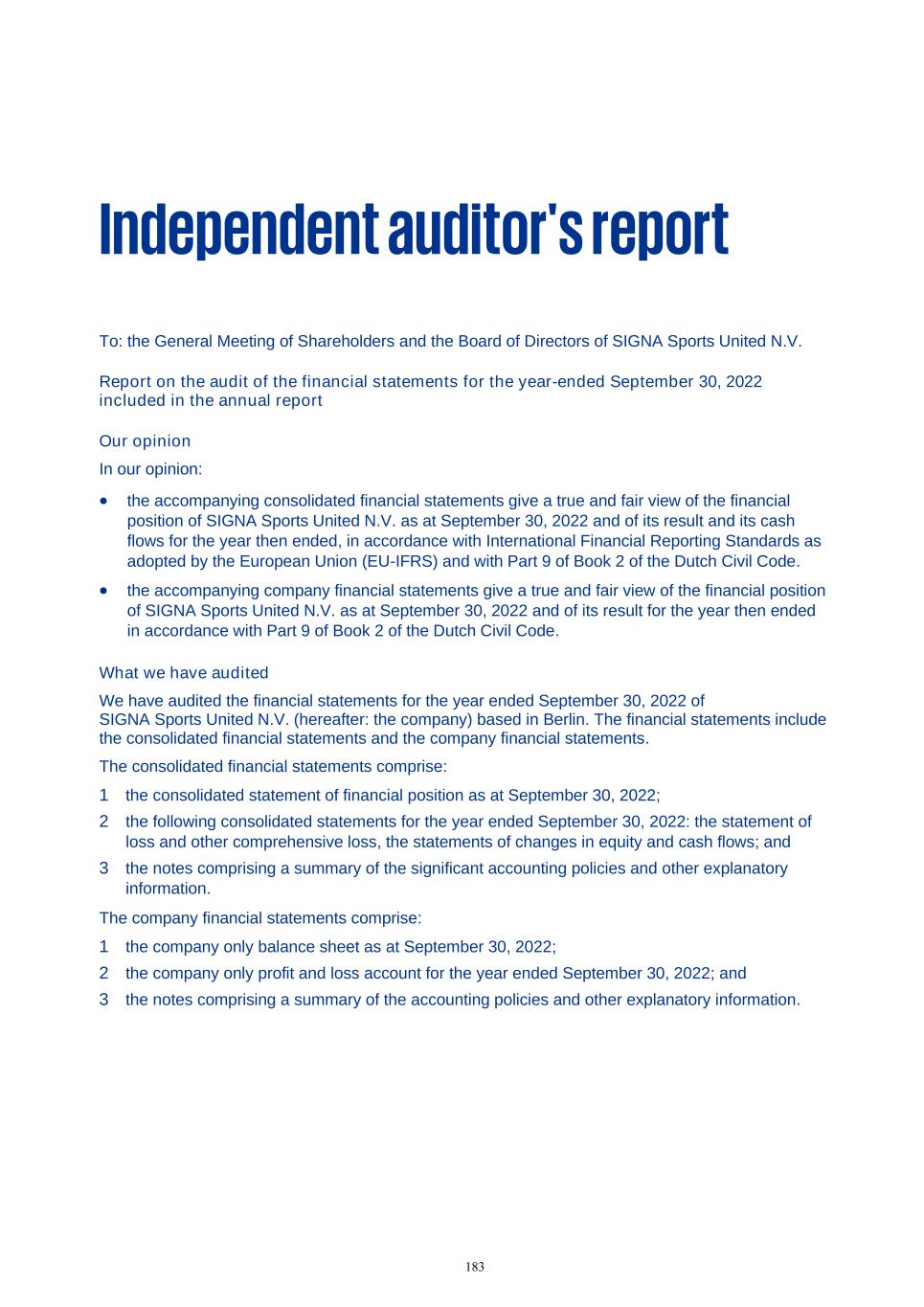
Independent auditor's report To: the General Meeting of Shareholders and the Board of Directors of SIGNA Sports United N.V. Report on the audit of the financial statements for the year-ended September 30, 2022 included in the annual report Our opinion In our opinion: • the accompanying consolidated financial statements give a true and fair view of the financial position of SIGNA Sports United N.V. as at September 30, 2022 and of its result and its cash flows for the year then ended, in accordance with International Financial Reporting Standards as adopted by the European Union (EU-IFRS) and with Part 9 of Book 2 of the Dutch Civil Code. • the accompanying company financial statements give a true and fair view of the financial position of SIGNA Sports United N.V. as at September 30, 2022 and of its result for the year then ended in accordance with Part 9 of Book 2 of the Dutch Civil Code. What we have audited We have audited the financial statements for the year ended September 30, 2022 of SIGNA Sports United N.V. (hereafter: the company) based in Berlin. The financial statements include the consolidated financial statements and the company financial statements. The consolidated financial statements comprise: 1 the consolidated statement of financial position as at September 30, 2022; 2 the following consolidated statements for the year ended September 30, 2022: the statement of loss and other comprehensive loss, the statements of changes in equity and cash flows; and 3 the notes comprising a summary of the significant accounting policies and other explanatory information. The company financial statements comprise: 1 the company only balance sheet as at September 30, 2022; 2 the company only profit and loss account for the year ended September 30, 2022; and 3 the notes comprising a summary of the accounting policies and other explanatory information. 183
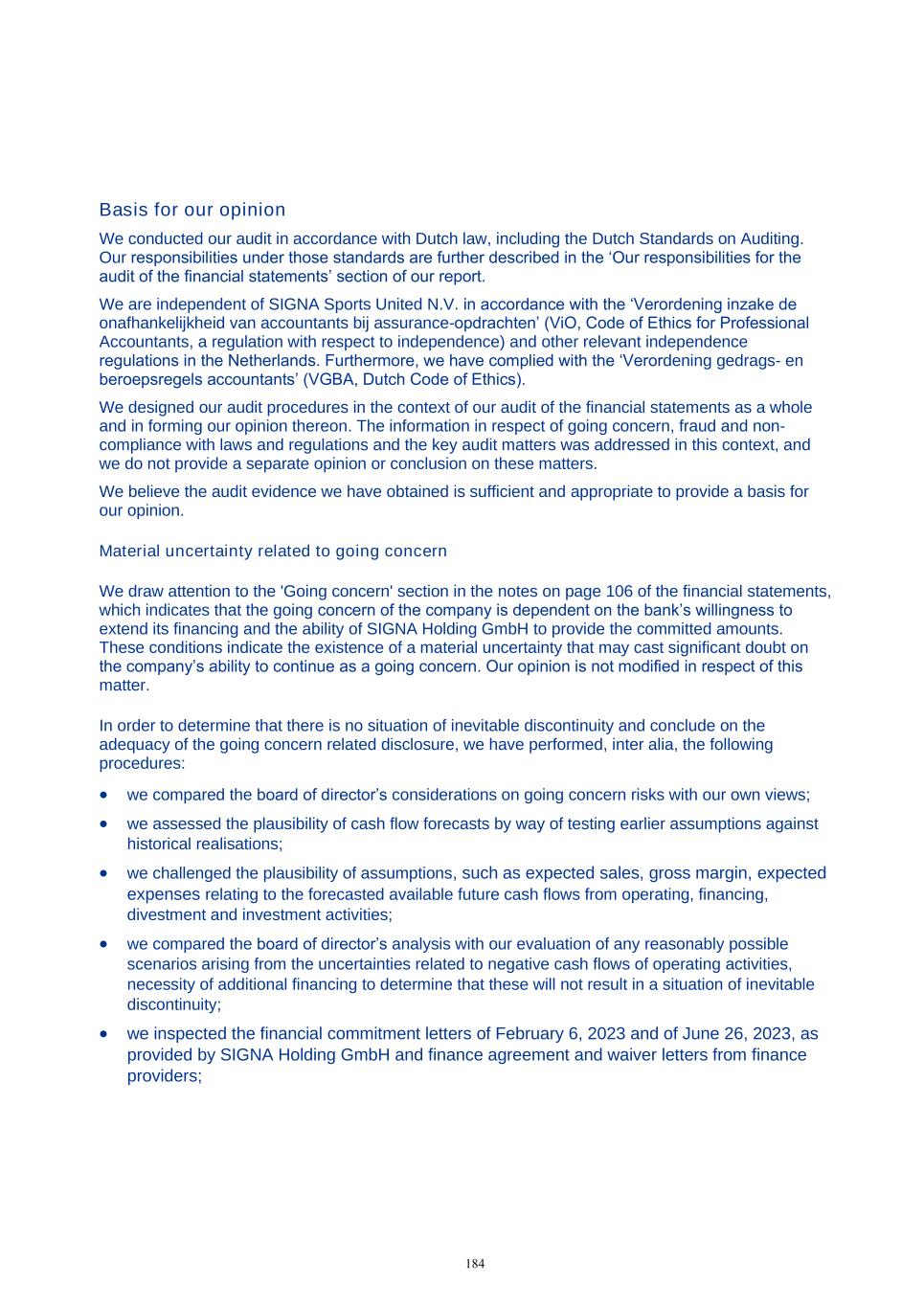
Basis for our opinion We conducted our audit in accordance with Dutch law, including the Dutch Standards on Auditing. Our responsibilities under those standards are further described in the ‘Our responsibilities for the audit of the financial statements’ section of our report. We are independent of SIGNA Sports United N.V. in accordance with the ‘Verordening inzake de onafhankelijkheid van accountants bij assurance-opdrachten’ (ViO, Code of Ethics for Professional Accountants, a regulation with respect to independence) and other relevant independence regulations in the Netherlands. Furthermore, we have complied with the ‘Verordening gedrags- en beroepsregels accountants’ (VGBA, Dutch Code of Ethics). We designed our audit procedures in the context of our audit of the financial statements as a whole and in forming our opinion thereon. The information in respect of going concern, fraud and non- compliance with laws and regulations and the key audit matters was addressed in this context, and we do not provide a separate opinion or conclusion on these matters. We believe the audit evidence we have obtained is sufficient and appropriate to provide a basis for our opinion. Material uncertainty related to going concern We draw attention to the 'Going concern' section in the notes on page 106 of the financial statements, which indicates that the going concern of the company is dependent on the bank’s willingness to extend its financing and the ability of SIGNA Holding GmbH to provide the committed amounts. These conditions indicate the existence of a material uncertainty that may cast significant doubt on the company’s ability to continue as a going concern. Our opinion is not modified in respect of this matter. In order to determine that there is no situation of inevitable discontinuity and conclude on the adequacy of the going concern related disclosure, we have performed, inter alia, the following procedures: • we compared the board of director’s considerations on going concern risks with our own views; • we assessed the plausibility of cash flow forecasts by way of testing earlier assumptions against historical realisations; • we challenged the plausibility of assumptions, such as expected sales, gross margin, expected expenses relating to the forecasted available future cash flows from operating, financing, divestment and investment activities; • we compared the board of director’s analysis with our evaluation of any reasonably possible scenarios arising from the uncertainties related to negative cash flows of operating activities, necessity of additional financing to determine that these will not result in a situation of inevitable discontinuity; • we inspected the financial commitment letters of February 6, 2023 and of June 26, 2023, as provided by SIGNA Holding GmbH and finance agreement and waiver letters from finance providers; 184

• we assessed the ability of SIGNA Holding GmbH to provide the financial commitments based on the audited financial statements, confirmations and inquiry of group management; • in making our assessment we consulted with professionals with specific knowledge and experience in auditing going concern assessments; • we tested the disclosure on page 106 of the financial statements against the findings of our procedures on the board of director’s going concern assessment and the reporting framework requirements. We find that the board’s assumptions and the abovementioned disclosure are acceptable. Information in support of our opinion Summary Materiality • Materiality of EUR 4.56 million • 0.4% of total revenues Group audit • Audit coverage of 91% of total assets • Audit coverage of 84% of total revenue Fraud/Noclar and Going concern related risks • Fraud & Non-compliance with laws and regulations (Noclar) related risks: presumed risk of management override of controls and revenue recognition identified • Going concern related risks: going concern risks identified which lead to material uncertainty Key audit matters • DE-SPAC transaction • Acquisition accounting of Wiggle Ltd and Tennis Express LLC • Goodwill Impairment Testing Opinion Unqualified with an emphasis of matter regarding material uncertainty related to going concern 185

Materiality Based on our professional judgement we determined the materiality for the financial statements as a whole at EUR 4.56 million. The materiality is determined with reference to total revenues (0.4%). The company is a profit oriented company in the growing phase. Given the loss making situation and the high volatility of profit before tax, we decided to choose a more stable metric, being total revenues as benchmark. We have also taken into account misstatements and/or possible misstatements that in our opinion are material for the users of the financial statements for qualitative reasons. We agreed with the Board that unadjusted misstatements identified during our audit in excess of EUR 228 thousand would be reported to them, as well as smaller misstatements that in our view must be reported on qualitative grounds. Scope of the group audit SIGNA Sports United N.V. is at the head of a group of components. The financial information of this group is included in the financial statements of SIGNA Sports United N.V. Our group audit mainly focused on significant components that are (i) of individual financial significance to the group, or (ii) that, due to their specific nature or circumstances, are likely to include significant risks of material misstatement to the group financial statements. We have: • made use of the work of KPMG Germany for the audit of the SIGNA Sports United N.V. consolidated and company financial statement; KPMG Germany for the audit of significant components Tennis Point GmbH and Internetstores GmbH; KPMG France for the audit of Probikeshop-Dolphin France SAS. KPMG United Kingdom for the audit of Wiggle Ltd.; • sent detailed instructions to KPMG Germany, covering significant areas including the relevant risks of material misstatement and set out the information required to be reported to the group audit team. These instructions were incorporated by KPMG Germany in their instructions to the other components; • held conference calls and physical meetings with KPMG Germany, KPMG France and KPMG United Kingdom and we performed a physical and remote review of the audit files of KPMG Germany, KPMG France and KPMG United Kingdom. For the residual population not in scope we performed analytical procedures in order to corroborate that our scoping remained appropriate throughout the audit. By performing the procedures mentioned above at group components, together with additional procedures at group level, we have been able to obtain sufficient and appropriate audit evidence about the group’s financial information to provide an opinion about the financial statements. By performing the audit as described above the audit coverage on total revenues is 84% and on total assets of 91%. 186
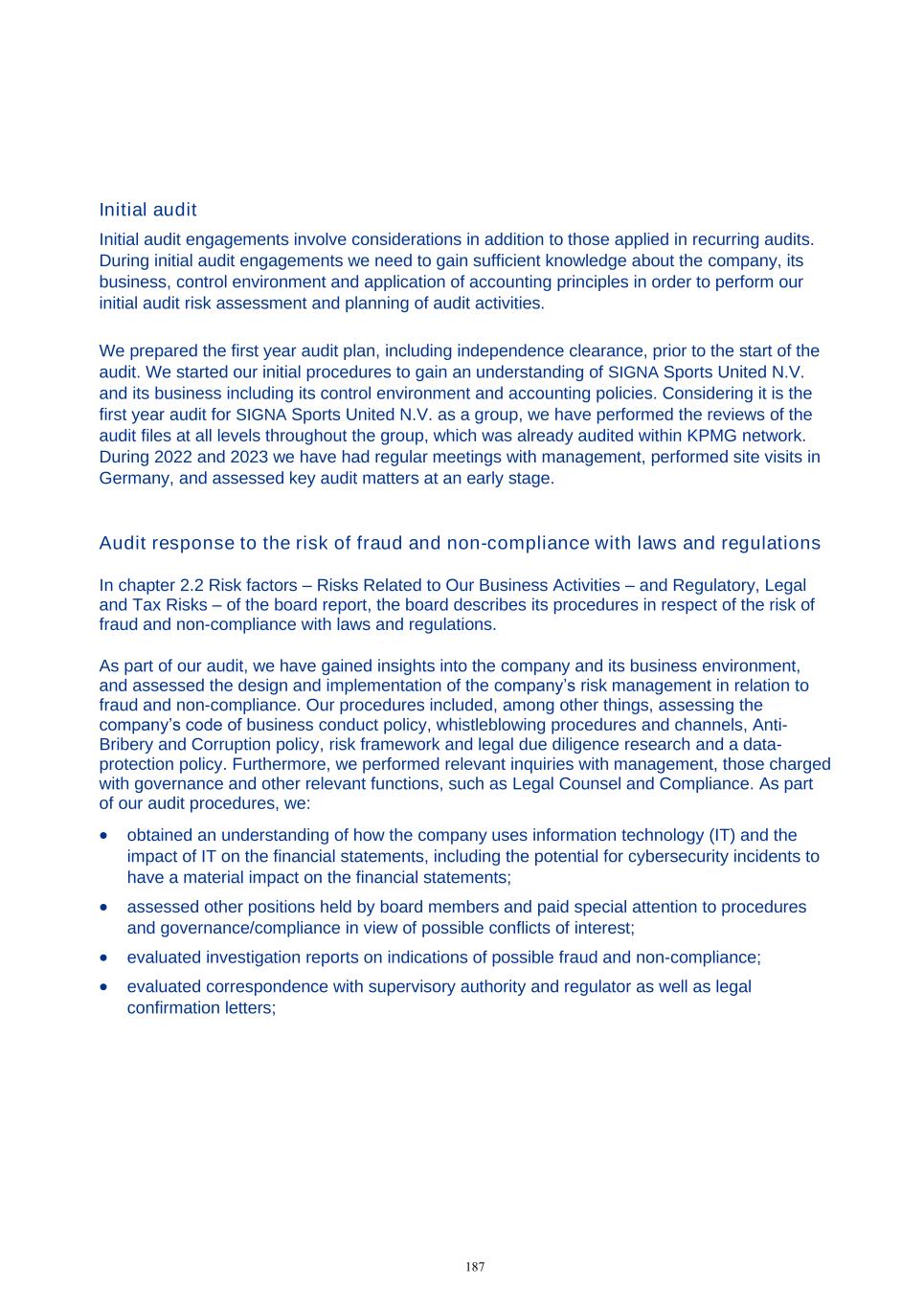
Initial audit Initial audit engagements involve considerations in addition to those applied in recurring audits. During initial audit engagements we need to gain sufficient knowledge about the company, its business, control environment and application of accounting principles in order to perform our initial audit risk assessment and planning of audit activities. We prepared the first year audit plan, including independence clearance, prior to the start of the audit. We started our initial procedures to gain an understanding of SIGNA Sports United N.V. and its business including its control environment and accounting policies. Considering it is the first year audit for SIGNA Sports United N.V. as a group, we have performed the reviews of the audit files at all levels throughout the group, which was already audited within KPMG network. During 2022 and 2023 we have had regular meetings with management, performed site visits in Germany, and assessed key audit matters at an early stage. Audit response to the risk of fraud and non-compliance with laws and regulations In chapter 2.2 Risk factors – Risks Related to Our Business Activities – and Regulatory, Legal and Tax Risks – of the board report, the board describes its procedures in respect of the risk of fraud and non-compliance with laws and regulations. As part of our audit, we have gained insights into the company and its business environment, and assessed the design and implementation of the company’s risk management in relation to fraud and non-compliance. Our procedures included, among other things, assessing the company’s code of business conduct policy, whistleblowing procedures and channels, Anti- Bribery and Corruption policy, risk framework and legal due diligence research and a data- protection policy. Furthermore, we performed relevant inquiries with management, those charged with governance and other relevant functions, such as Legal Counsel and Compliance. As part of our audit procedures, we: • obtained an understanding of how the company uses information technology (IT) and the impact of IT on the financial statements, including the potential for cybersecurity incidents to have a material impact on the financial statements; • assessed other positions held by board members and paid special attention to procedures and governance/compliance in view of possible conflicts of interest; • evaluated investigation reports on indications of possible fraud and non-compliance; • evaluated correspondence with supervisory authority and regulator as well as legal confirmation letters; 187
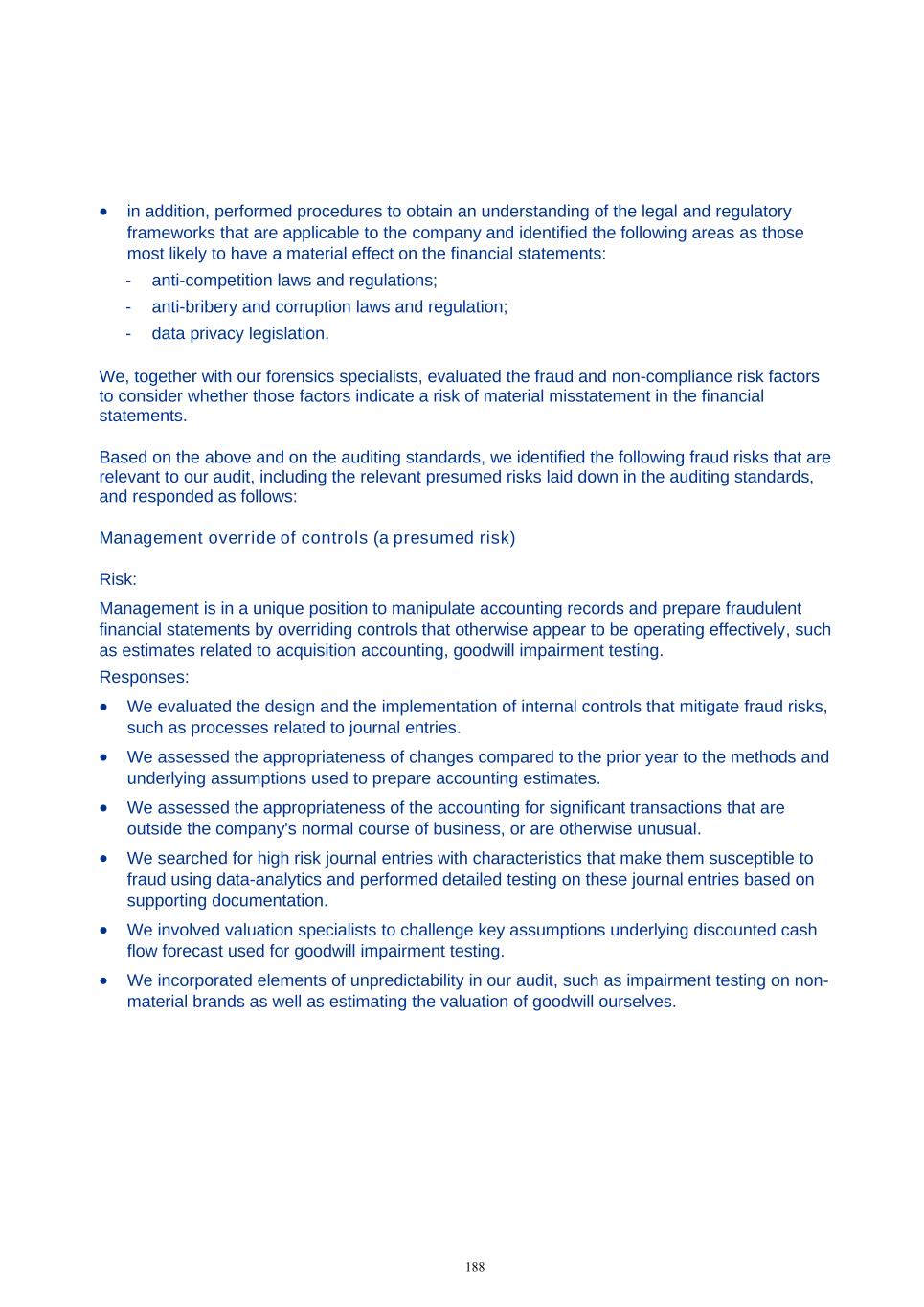
• in addition, performed procedures to obtain an understanding of the legal and regulatory frameworks that are applicable to the company and identified the following areas as those most likely to have a material effect on the financial statements: - anti-competition laws and regulations; - anti-bribery and corruption laws and regulation; - data privacy legislation. We, together with our forensics specialists, evaluated the fraud and non-compliance risk factors to consider whether those factors indicate a risk of material misstatement in the financial statements. Based on the above and on the auditing standards, we identified the following fraud risks that are relevant to our audit, including the relevant presumed risks laid down in the auditing standards, and responded as follows: Management override of controls (a presumed risk) Risk: Management is in a unique position to manipulate accounting records and prepare fraudulent financial statements by overriding controls that otherwise appear to be operating effectively, such as estimates related to acquisition accounting, goodwill impairment testing. Responses: • We evaluated the design and the implementation of internal controls that mitigate fraud risks, such as processes related to journal entries. • We assessed the appropriateness of changes compared to the prior year to the methods and underlying assumptions used to prepare accounting estimates. • We assessed the appropriateness of the accounting for significant transactions that are outside the company's normal course of business, or are otherwise unusual. • We searched for high risk journal entries with characteristics that make them susceptible to fraud using data-analytics and performed detailed testing on these journal entries based on supporting documentation. • We involved valuation specialists to challenge key assumptions underlying discounted cash flow forecast used for goodwill impairment testing. • We incorporated elements of unpredictability in our audit, such as impairment testing on non- material brands as well as estimating the valuation of goodwill ourselves. 188
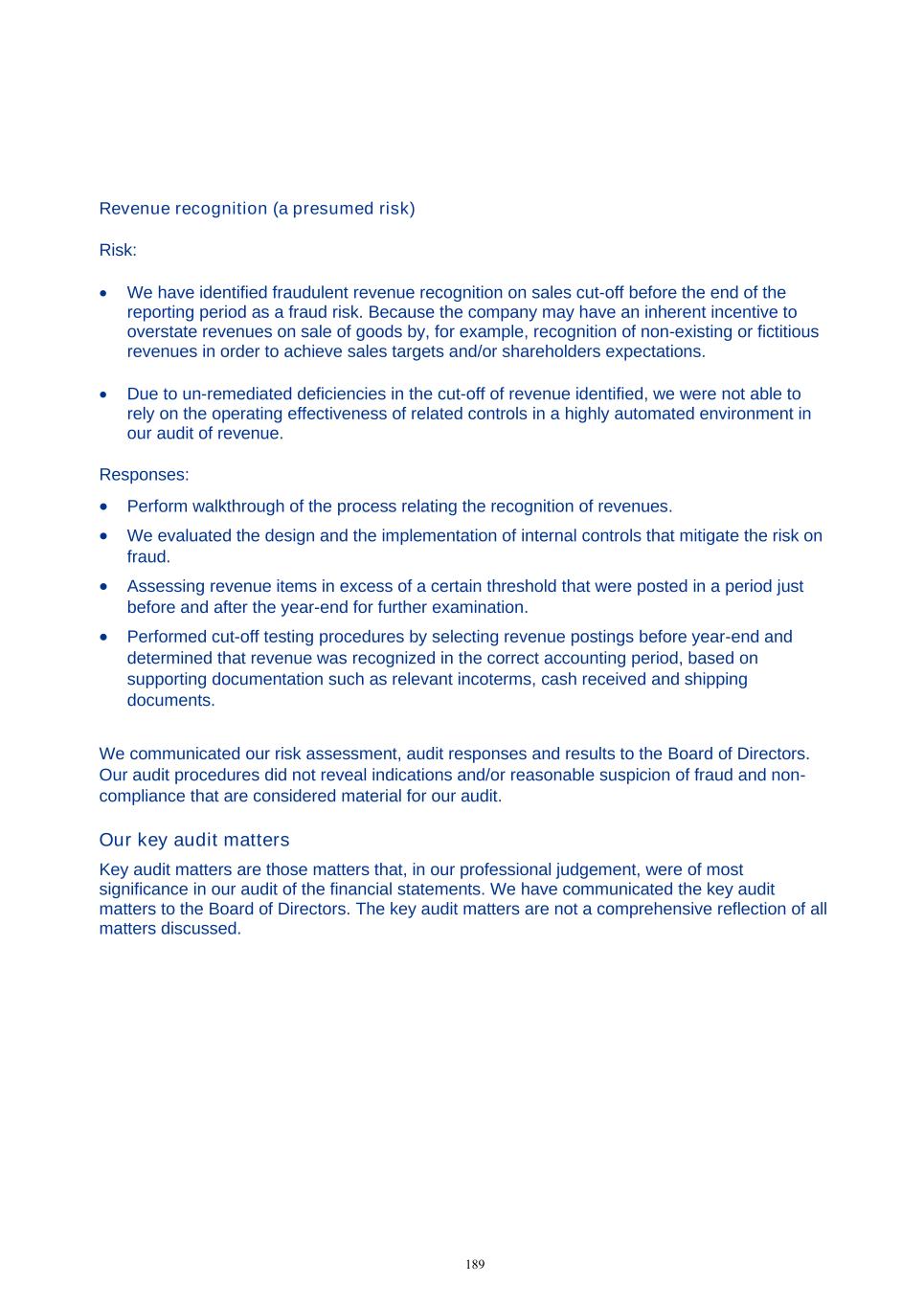
Revenue recognition (a presumed risk) Risk: • We have identified fraudulent revenue recognition on sales cut-off before the end of the reporting period as a fraud risk. Because the company may have an inherent incentive to overstate revenues on sale of goods by, for example, recognition of non-existing or fictitious revenues in order to achieve sales targets and/or shareholders expectations. • Due to un-remediated deficiencies in the cut-off of revenue identified, we were not able to rely on the operating effectiveness of related controls in a highly automated environment in our audit of revenue. Responses: • Perform walkthrough of the process relating the recognition of revenues. • We evaluated the design and the implementation of internal controls that mitigate the risk on fraud. • Assessing revenue items in excess of a certain threshold that were posted in a period just before and after the year-end for further examination. • Performed cut-off testing procedures by selecting revenue postings before year-end and determined that revenue was recognized in the correct accounting period, based on supporting documentation such as relevant incoterms, cash received and shipping documents. We communicated our risk assessment, audit responses and results to the Board of Directors. Our audit procedures did not reveal indications and/or reasonable suspicion of fraud and non- compliance that are considered material for our audit. Our key audit matters Key audit matters are those matters that, in our professional judgement, were of most significance in our audit of the financial statements. We have communicated the key audit matters to the Board of Directors. The key audit matters are not a comprehensive reflection of all matters discussed. 189
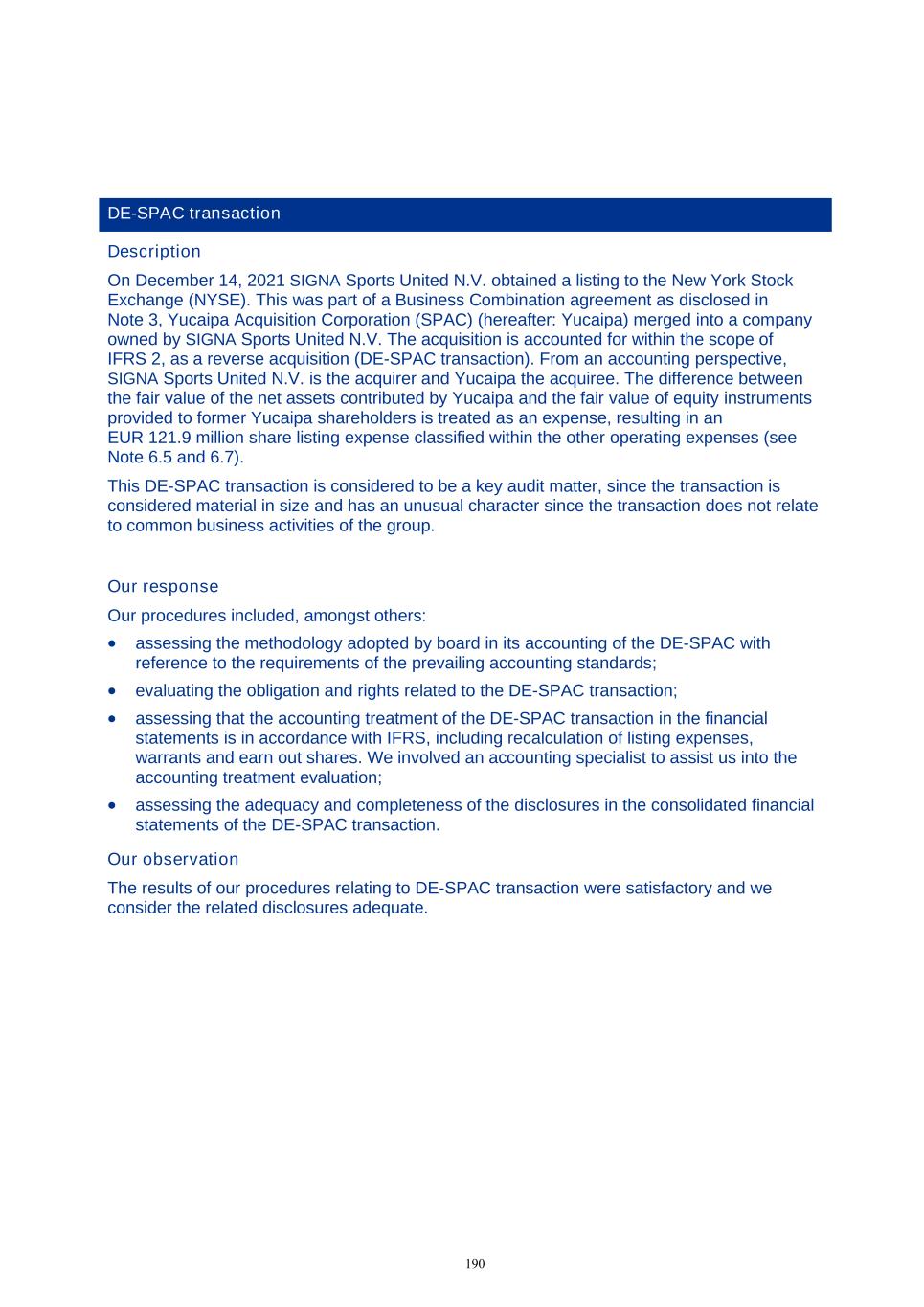
DE-SPAC transaction Description On December 14, 2021 SIGNA Sports United N.V. obtained a listing to the New York Stock Exchange (NYSE). This was part of a Business Combination agreement as disclosed in Note 3, Yucaipa Acquisition Corporation (SPAC) (hereafter: Yucaipa) merged into a company owned by SIGNA Sports United N.V. The acquisition is accounted for within the scope of IFRS 2, as a reverse acquisition (DE-SPAC transaction). From an accounting perspective, SIGNA Sports United N.V. is the acquirer and Yucaipa the acquiree. The difference between the fair value of the net assets contributed by Yucaipa and the fair value of equity instruments provided to former Yucaipa shareholders is treated as an expense, resulting in an EUR 121.9 million share listing expense classified within the other operating expenses (see Note 6.5 and 6.7). This DE-SPAC transaction is considered to be a key audit matter, since the transaction is considered material in size and has an unusual character since the transaction does not relate to common business activities of the group. Our response Our procedures included, amongst others: • assessing the methodology adopted by board in its accounting of the DE-SPAC with reference to the requirements of the prevailing accounting standards; • evaluating the obligation and rights related to the DE-SPAC transaction; • assessing that the accounting treatment of the DE-SPAC transaction in the financial statements is in accordance with IFRS, including recalculation of listing expenses, warrants and earn out shares. We involved an accounting specialist to assist us into the accounting treatment evaluation; • assessing the adequacy and completeness of the disclosures in the consolidated financial statements of the DE-SPAC transaction. Our observation The results of our procedures relating to DE-SPAC transaction were satisfactory and we consider the related disclosures adequate. 190
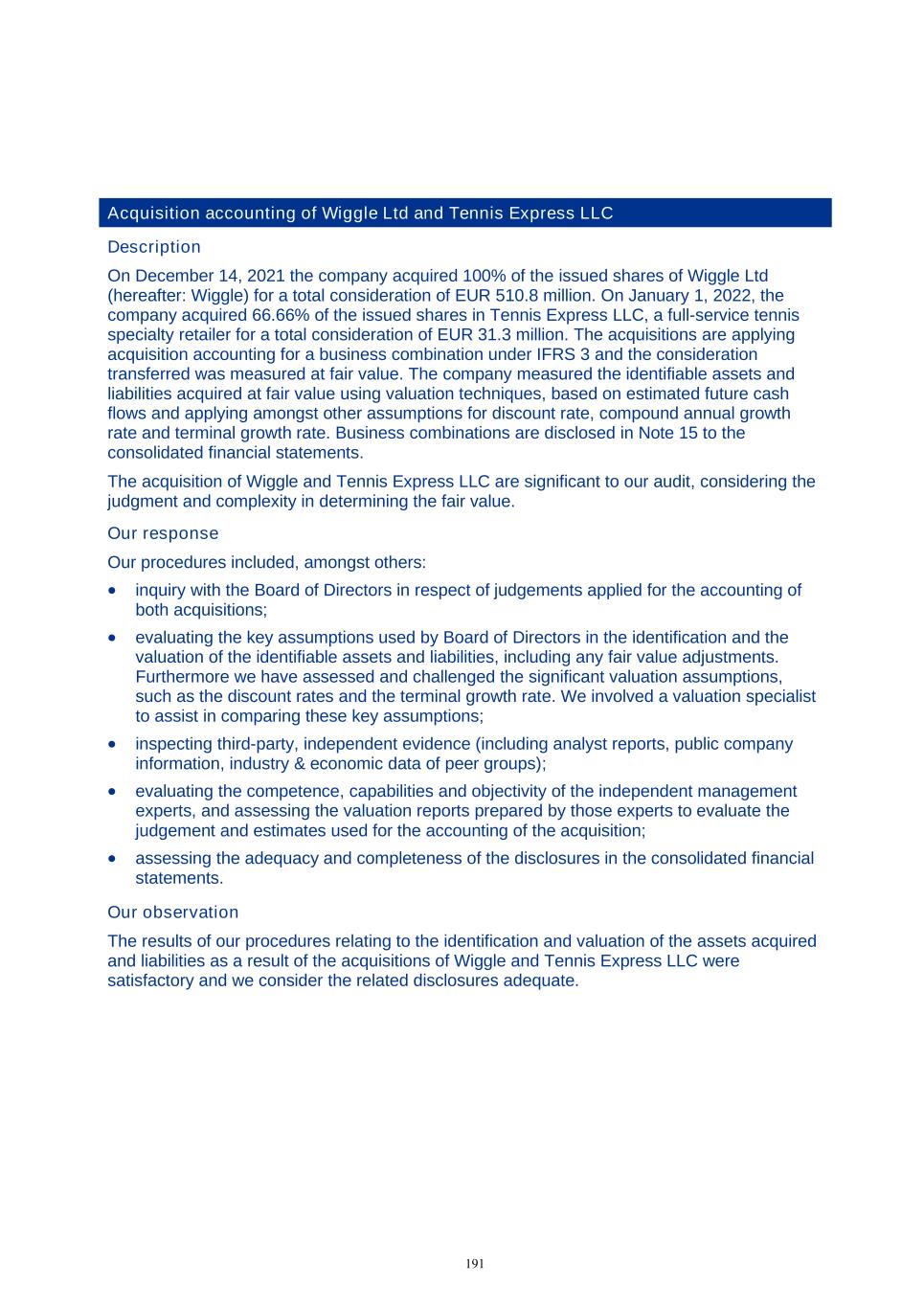
Acquisition accounting of Wiggle Ltd and Tennis Express LLC Description On December 14, 2021 the company acquired 100% of the issued shares of Wiggle Ltd (hereafter: Wiggle) for a total consideration of EUR 510.8 million. On January 1, 2022, the company acquired 66.66% of the issued shares in Tennis Express LLC, a full-service tennis specialty retailer for a total consideration of EUR 31.3 million. The acquisitions are applying acquisition accounting for a business combination under IFRS 3 and the consideration transferred was measured at fair value. The company measured the identifiable assets and liabilities acquired at fair value using valuation techniques, based on estimated future cash flows and applying amongst other assumptions for discount rate, compound annual growth rate and terminal growth rate. Business combinations are disclosed in Note 15 to the consolidated financial statements. The acquisition of Wiggle and Tennis Express LLC are significant to our audit, considering the judgment and complexity in determining the fair value. Our response Our procedures included, amongst others: • inquiry with the Board of Directors in respect of judgements applied for the accounting of both acquisitions; • evaluating the key assumptions used by Board of Directors in the identification and the valuation of the identifiable assets and liabilities, including any fair value adjustments. Furthermore we have assessed and challenged the significant valuation assumptions, such as the discount rates and the terminal growth rate. We involved a valuation specialist to assist in comparing these key assumptions; • inspecting third-party, independent evidence (including analyst reports, public company information, industry & economic data of peer groups); • evaluating the competence, capabilities and objectivity of the independent management experts, and assessing the valuation reports prepared by those experts to evaluate the judgement and estimates used for the accounting of the acquisition; • assessing the adequacy and completeness of the disclosures in the consolidated financial statements. Our observation The results of our procedures relating to the identification and valuation of the assets acquired and liabilities as a result of the acquisitions of Wiggle and Tennis Express LLC were satisfactory and we consider the related disclosures adequate. 191

Goodwill Impairment testing Description In accordance with IAS 36 ‘Impairment of Assets’, the company is required to annually test the amount of goodwill for impairment. This annual impairment test was significant to our audit because the financial position of EUR 524.4 million as of September 30, 2022 is material to the financial statements. As outcome of the impairment test performed an impairment loss was recognized of EUR 243.7 million for the goodwill related to the Wiggle cash generating unit, as disclosed in note 7.2 of the financial statements. Moreover, management’s assessment process is complex and judgmental and is based on assumptions, specifically, discount rate, compound annual growth rate and the long term growth rate, which are affected by expected future market or economic conditions. In addition the company did not design and implement effective controls to ensure the appropriateness of the methodology, assumptions and data, used in the estimate of the recoverable amount of goodwill. Our response Our procedures included, amongst others: • we identified and tested the design over controls relates to the impairment testing process for goodwill and did not test the operating effectiveness; • retrospective review of the assumptions applied in the impairment test; • assessed the methodology adopted by management in its impairment trigger analysis and impairment assessment with reference to the requirements of the prevailing accounting standards; • evaluated the mathematical accuracy of the model used for the impairment assessment; • evaluating the key assumptions used by management in the discounted cash flow forecasts, such as discount rates, compound annual grow rate, future sales, gross margin. We involved a valuation specialist to assist in comparing the key assumptions and estimates; • building up our independent valuation of the Goodwill based analyst reports, public company information, industry & economic data of peer groups to challenge management estimations; • inspecting third-party, independent evidence (including analyst reports, public company information, industry & economic data of peer groups); • evaluating the competence, capabilities and objectivity of the independent management experts, and assessing the valuation reports prepared by those experts to evaluate the judgement and estimates used for the impairment test; 192
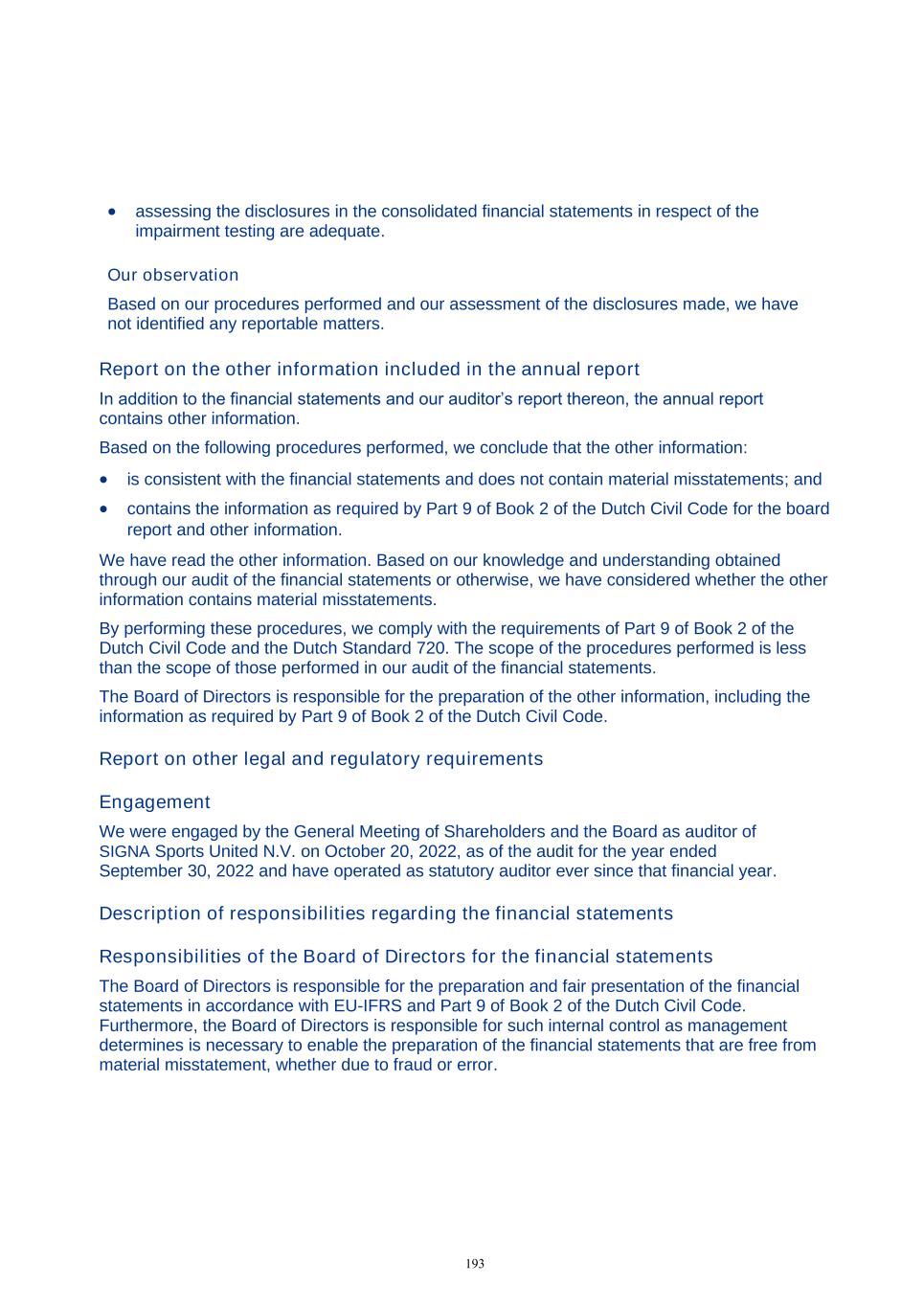
• assessing the disclosures in the consolidated financial statements in respect of the impairment testing are adequate. Our observation Based on our procedures performed and our assessment of the disclosures made, we have not identified any reportable matters. Report on the other information included in the annual report In addition to the financial statements and our auditor’s report thereon, the annual report contains other information. Based on the following procedures performed, we conclude that the other information: • is consistent with the financial statements and does not contain material misstatements; and • contains the information as required by Part 9 of Book 2 of the Dutch Civil Code for the board report and other information. We have read the other information. Based on our knowledge and understanding obtained through our audit of the financial statements or otherwise, we have considered whether the other information contains material misstatements. By performing these procedures, we comply with the requirements of Part 9 of Book 2 of the Dutch Civil Code and the Dutch Standard 720. The scope of the procedures performed is less than the scope of those performed in our audit of the financial statements. The Board of Directors is responsible for the preparation of the other information, including the information as required by Part 9 of Book 2 of the Dutch Civil Code. Report on other legal and regulatory requirements Engagement We were engaged by the General Meeting of Shareholders and the Board as auditor of SIGNA Sports United N.V. on October 20, 2022, as of the audit for the year ended September 30, 2022 and have operated as statutory auditor ever since that financial year. Description of responsibilities regarding the financial statements Responsibilities of the Board of Directors for the financial statements The Board of Directors is responsible for the preparation and fair presentation of the financial statements in accordance with EU-IFRS and Part 9 of Book 2 of the Dutch Civil Code. Furthermore, the Board of Directors is responsible for such internal control as management determines is necessary to enable the preparation of the financial statements that are free from material misstatement, whether due to fraud or error. 193
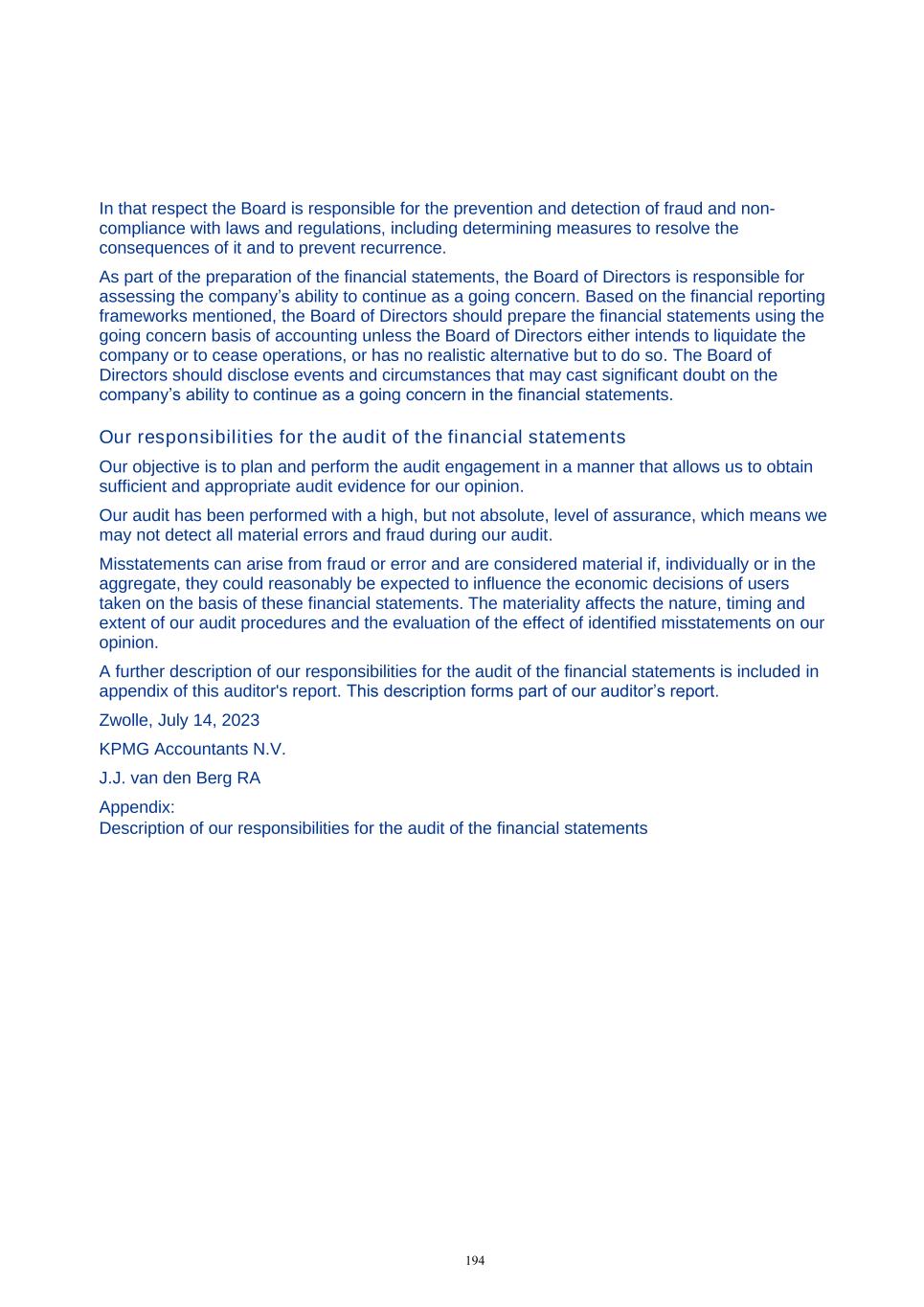
In that respect the Board is responsible for the prevention and detection of fraud and non- compliance with laws and regulations, including determining measures to resolve the consequences of it and to prevent recurrence. As part of the preparation of the financial statements, the Board of Directors is responsible for assessing the company’s ability to continue as a going concern. Based on the financial reporting frameworks mentioned, the Board of Directors should prepare the financial statements using the going concern basis of accounting unless the Board of Directors either intends to liquidate the company or to cease operations, or has no realistic alternative but to do so. The Board of Directors should disclose events and circumstances that may cast significant doubt on the company’s ability to continue as a going concern in the financial statements. Our responsibilities for the audit of the financial statements Our objective is to plan and perform the audit engagement in a manner that allows us to obtain sufficient and appropriate audit evidence for our opinion. Our audit has been performed with a high, but not absolute, level of assurance, which means we may not detect all material errors and fraud during our audit. Misstatements can arise from fraud or error and are considered material if, individually or in the aggregate, they could reasonably be expected to influence the economic decisions of users taken on the basis of these financial statements. The materiality affects the nature, timing and extent of our audit procedures and the evaluation of the effect of identified misstatements on our opinion. A further description of our responsibilities for the audit of the financial statements is included in appendix of this auditor's report. This description forms part of our auditor’s report. Zwolle, July 14, 2023 KPMG Accountants N.V. J.J. van den Berg RA Appendix: Description of our responsibilities for the audit of the financial statements 194

Appendix Description of our responsibilities for the audit of the financial statements We have exercised professional judgement and have maintained professional scepticism throughout the audit, in accordance with Dutch Standards on Auditing, ethical requirements and independence requirements. Our audit included among others: • identifying and assessing the risks of material misstatement of the financial statements, whether due to fraud or error, designing and performing audit procedures responsive to those risks, and obtaining audit evidence that is sufficient and appropriate to provide a basis for our opinion. The risk of not detecting a material misstatement resulting from fraud is higher than the risk resulting from error, as fraud may involve collusion, forgery, intentional omissions, misrepresentations, or the override of internal control; • obtaining an understanding of internal control relevant to the audit in order to design audit procedures that are appropriate in the circumstances, but not for the purpose of expressing an opinion on the effectiveness of the company’s internal control; • evaluating the appropriateness of accounting policies used and the reasonableness of accounting estimates and related disclosures made by the Board; • concluding on the appropriateness of the Board’s use of the going concern basis of accounting, and based on the audit evidence obtained, whether a material uncertainty exists related to events or conditions that may cast significant doubt on SIGNA Sports United N.V. ability to continue as a going concern. If we conclude that a material uncertainty exists, we are required to draw attention in our auditor’s report to the related disclosures in the financial statements or, if such disclosures are inadequate, to modify our opinion. Our conclusions are based on the audit evidence obtained up to the date of our auditor’s report. However, future events or conditions may cause a company to cease to continue as a going concern; • evaluating the overall presentation, structure and content of the financial statements, including the disclosures; and • evaluating whether the financial statements represent the underlying transactions and events in a manner that achieves fair presentation. We are solely responsible for the opinion and therefore responsible to obtain sufficient appropriate audit evidence regarding the financial information of the entities or business activities within the group to express an opinion on the financial statements. In this respect we are also responsible for directing, supervising and performing the group audit. We communicate with the Board regarding, among other matters, the planned scope and timing of the audit and significant audit findings, including any significant findings in internal control that we identify during our audit. 195
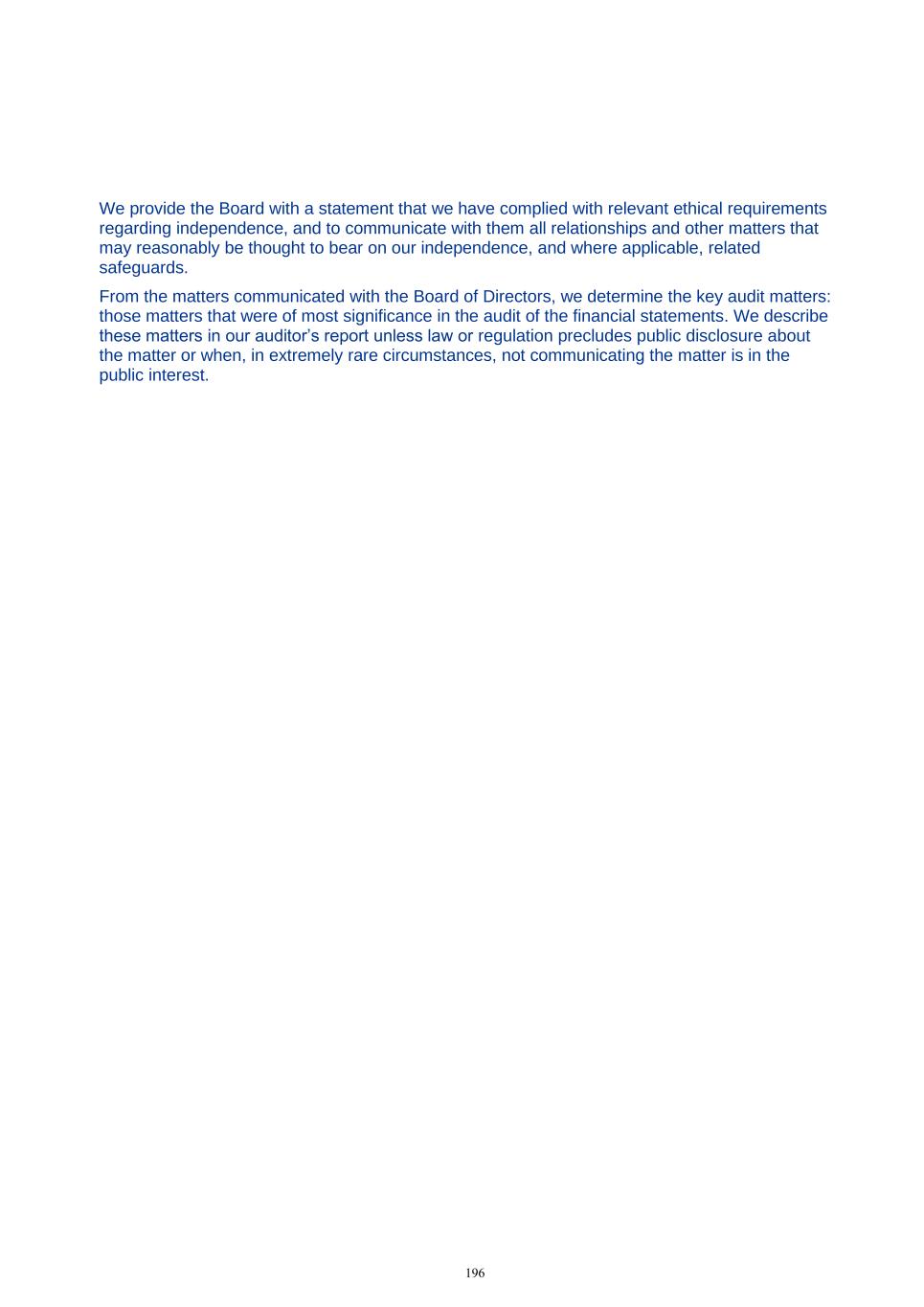
We provide the Board with a statement that we have complied with relevant ethical requirements regarding independence, and to communicate with them all relationships and other matters that may reasonably be thought to bear on our independence, and where applicable, related safeguards. From the matters communicated with the Board of Directors, we determine the key audit matters: those matters that were of most significance in the audit of the financial statements. We describe these matters in our auditor’s report unless law or regulation precludes public disclosure about the matter or when, in extremely rare circumstances, not communicating the matter is in the public interest. 196